Early Los Angeles Street Lights
Historical Street Lights of Los Angeles |
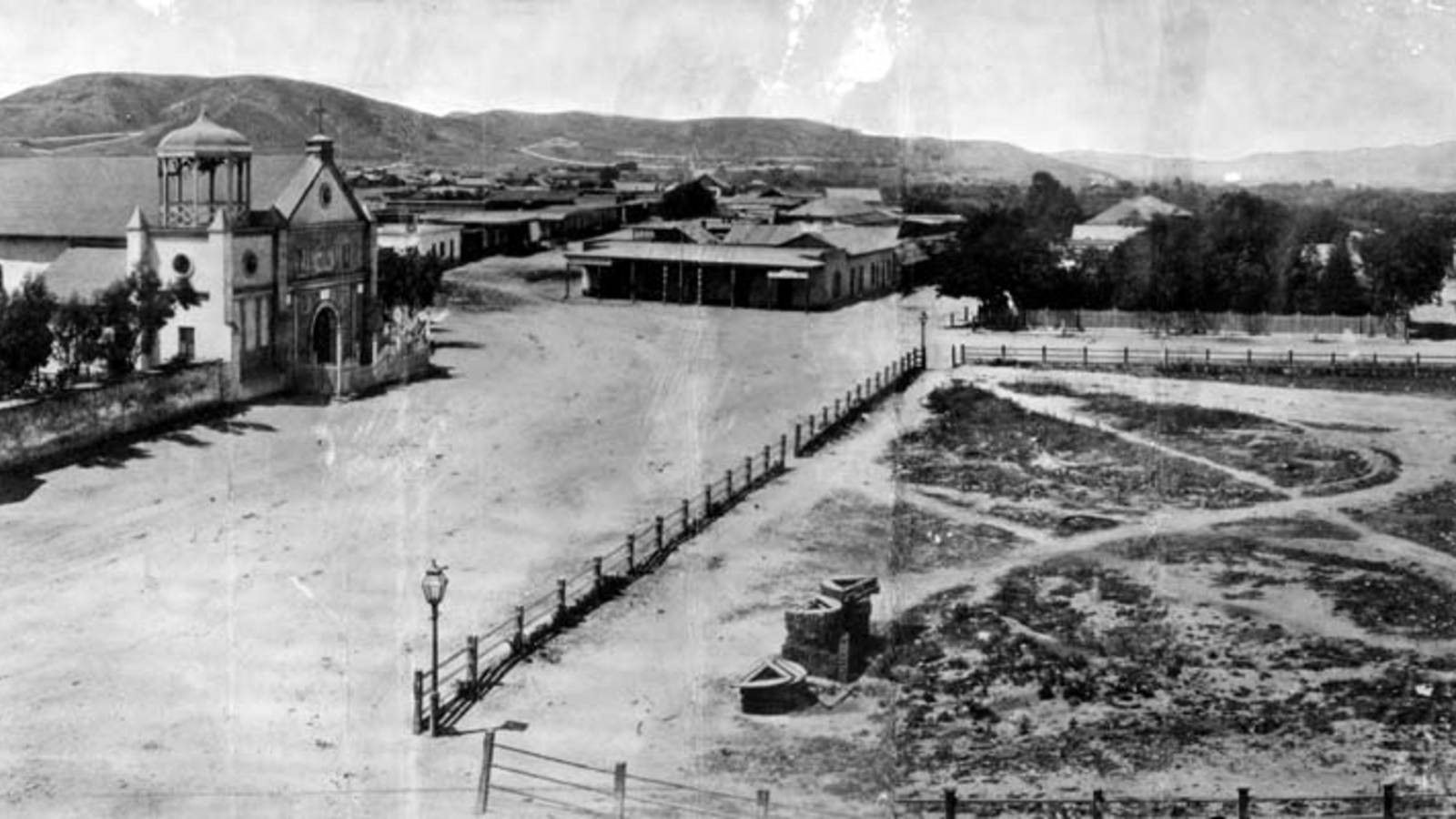 |
|
| (1869)* - View of Calle Principal (now Main Street) looking north with the Old Plaza Church seen on the left. To the right is the Los Angeles Plaza (square at the time) with two gas lamps, one on each of its corners. These were the first gas lamps installed in the City of Los Angeles. |
Historical Notes In 1867, Los Angeles Gas Company, the forerunner of today's Southern California Gas Company, installed 43 new gas lamps along Main Street, making the city safer at night. The gas lighting business was run by five entrepreneurs who manufactured the gas from asphalt, a tar-like substance, and later from oil. |
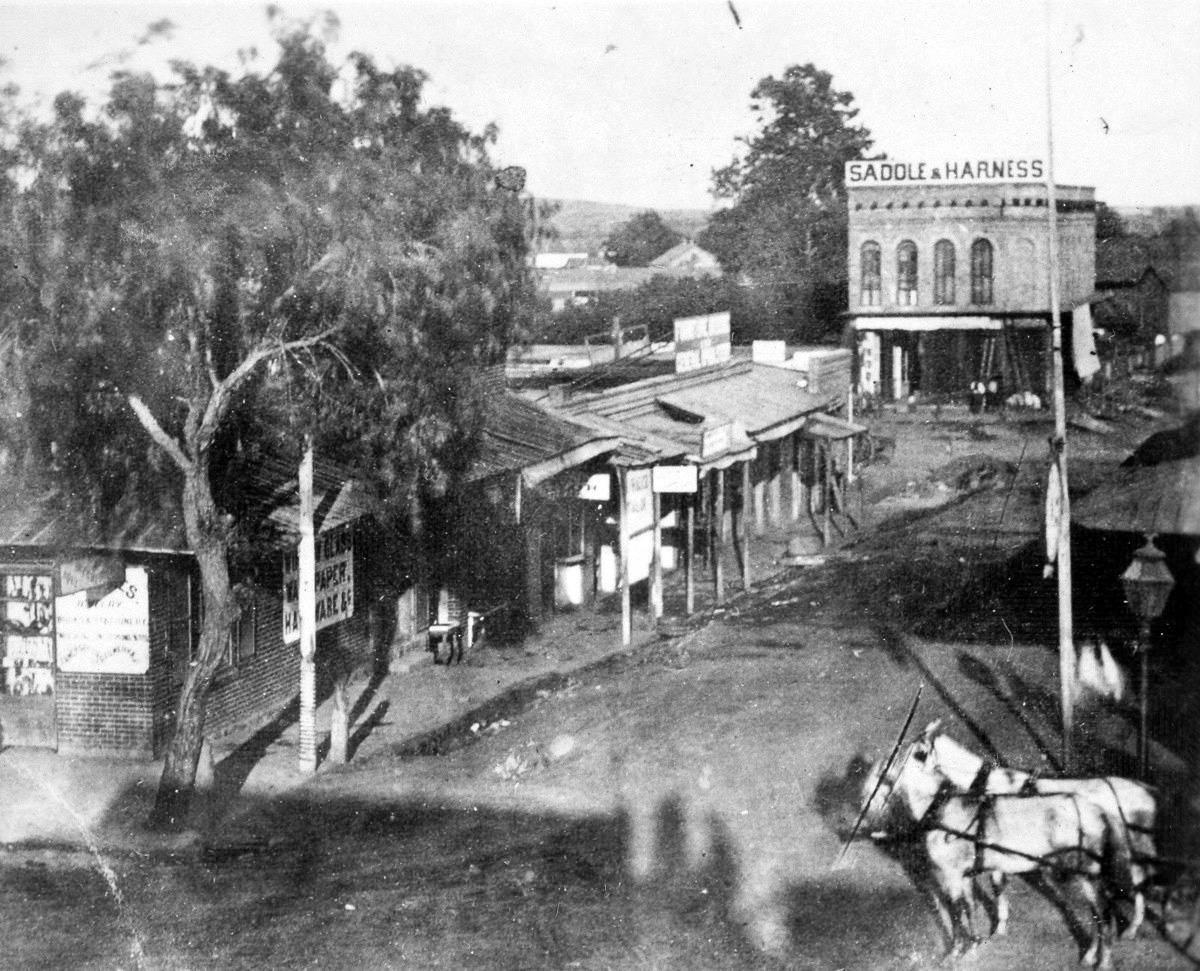 |
|
| (1869)* - Looking east on Commercial Street from Main Street in early Downtown Los Angeles. Note one of Los Angeles’ first gas streetlights at the lower right, behind the two horses. Unsurprisingly, Commercial Street has changed significantly over nearly 155 years. The stretch shown in this photo no longer exists, as the section from Main to Alameda is now occupied by commercial and government buildings. |
Historical Notes The introduction of gas lighting was a significant development for Los Angeles, which at the time had fewer than 10,000 residents. However, gas lighting was expensive, with the city paying $415 (equivalent to about $9,300 today) for a month's supply of gas in January 1870. |
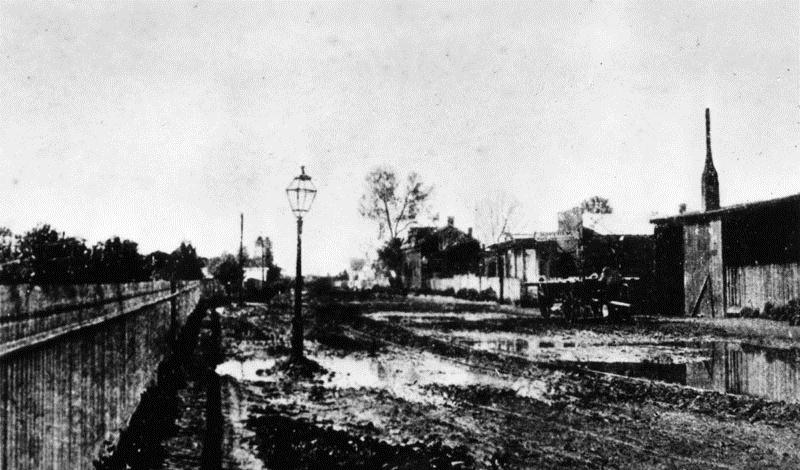 |
|
| (Early 1870s)^ - San Pedro Street, a muddy dirt street, near 2nd Street in the early 1870s. A gas lamp post can be seen standing in a pool of water. |
Historical Notes A lamplighter on horseback rode down the street at dusk to light the streetlights. By 1873, about 136 gas lamps provided the outdoor night lighting for the City. |
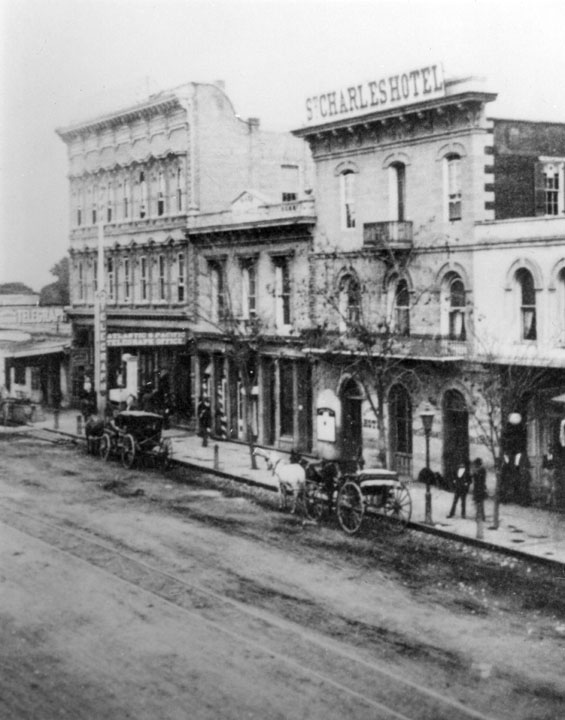 |
|
| (1880)* - View looking northeast on Main Street showing one of the City’s first gas street lamps standing in front of the St. Charles Hotel, originally the Bella Union Hotel^. |
Historical Notes The gas company was enjoying modest success until Thomas Edison introduced his electric light in 1879. In 1882 electricity was introduced to Los Angeles. That year 3,000-candle power arc lamps were lifted atop seven 150-foot poles. The state of the art at that time encouraged the use of a few tall standards with high illumination.** ^The Bella Union Hotel was considered the first hotel in Los Angeles. It became the Clarenden in 1873 and the St. Charles in 1875. |
* * * * * |
LA's First Electric Street Light
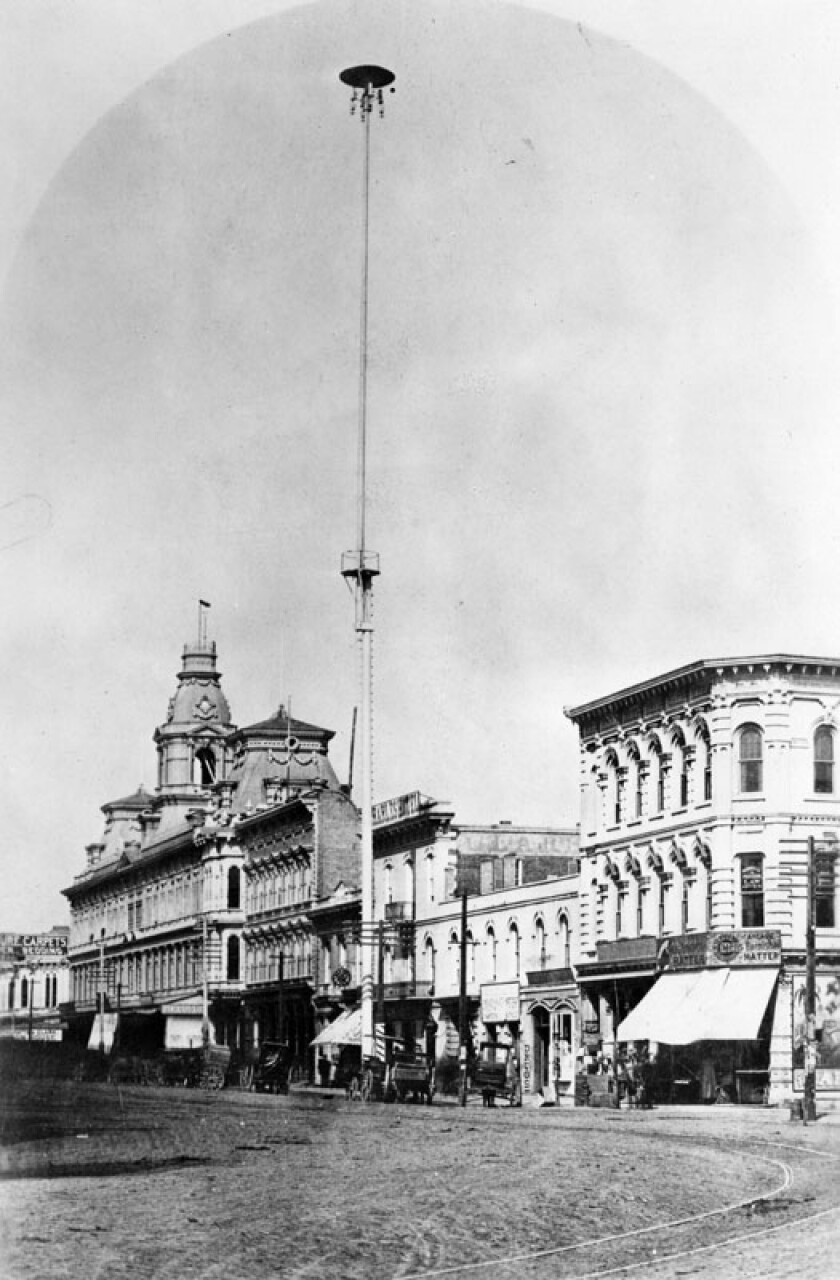 |
|
| (ca. 1882)* - One of the first of seven electric street lights installed in the City of Los Angeles, located on the east side of Main Street, just north of Commercial Street (300 block of Main St.) The street light stood 150 feet tall and was situated in front of the St. Charles Hotel where one of the city's first gas lamps once stood (see previous photo). |
Historical Notes In 1882, C. L. Howland installed seven 150-foot tall streetlight masts, each carrying three carbon-arc lamps of three thousand candle-power. He also installed a small power plant to provide the electricity for his new street light system. The following year Howland and other investors would go on to form the Los Angeles Electric Company. It was the first electric utilty in Los Angeles. Click HERE to see more in First Electricity in Los Angeles. |
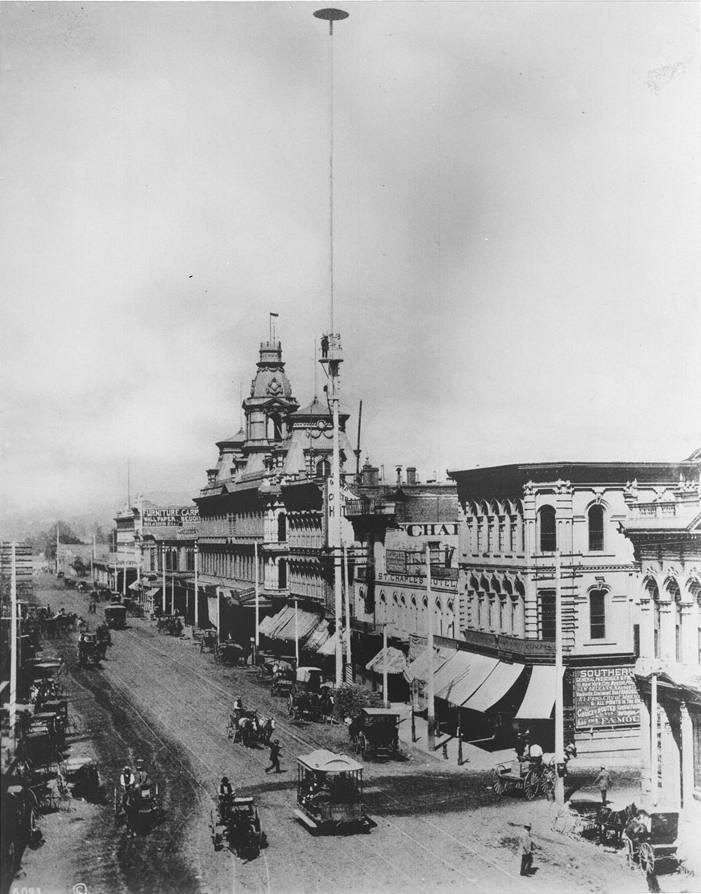 |
|
| (ca. 1882)* - Another look at one of LA's first electric light poles. View is of the buildings on the east side of North Main Street at Commercial Street at near right, looking toward the Baker Block. A man can be seen standing on a platform half way up the street light mast. |
Historical Notes Approximately 30, 150-foot tall poles with carbon-arc lamps were installed in Downtown Los Angeles between 1882 and about 1885. These were reported to provide illumination equal to the level of a full moon. |
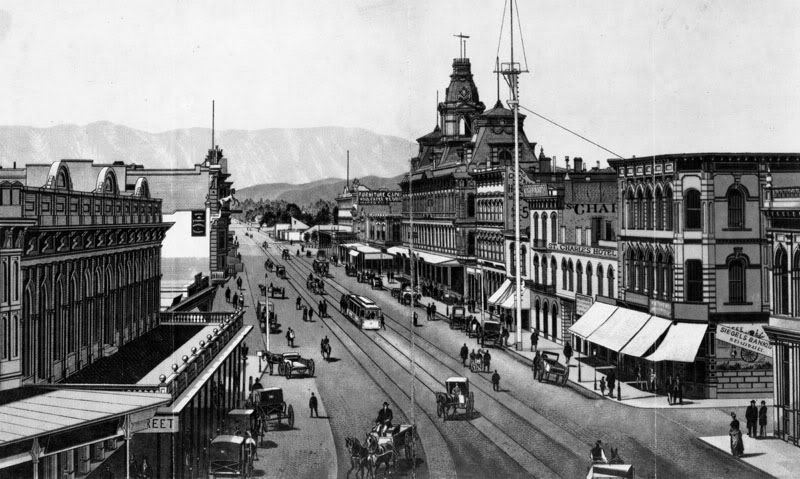 |
|
| (1880s)^ - Photo of a drawing showing Main Street looking north from atop the Temple Block. Baker Block is just right of center. This vantage point is now occupied by City Hall. This gives a good view of where one of the first 150-ft. tall street light poles stood. |
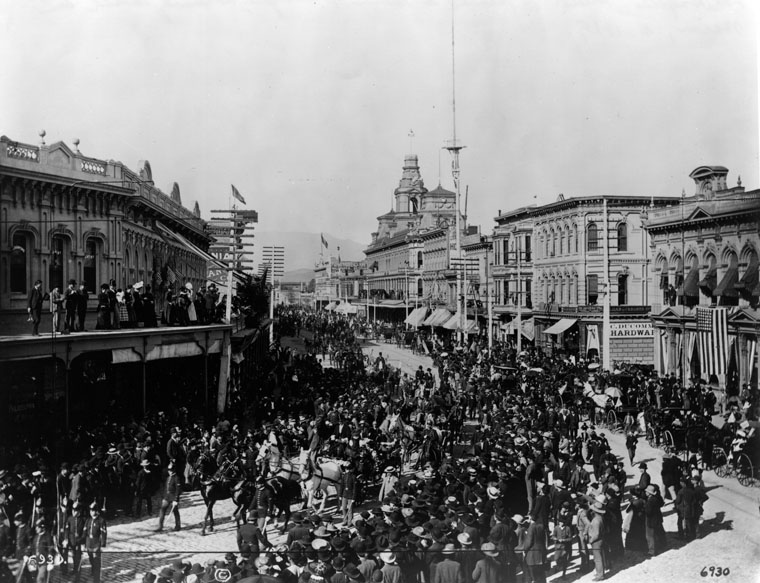 |
|
| (ca. 1889)^ - A parade on Main and Temple streets, looking north. The City's new 150-foot tall electric light pole can be seen in the center of the photo. |
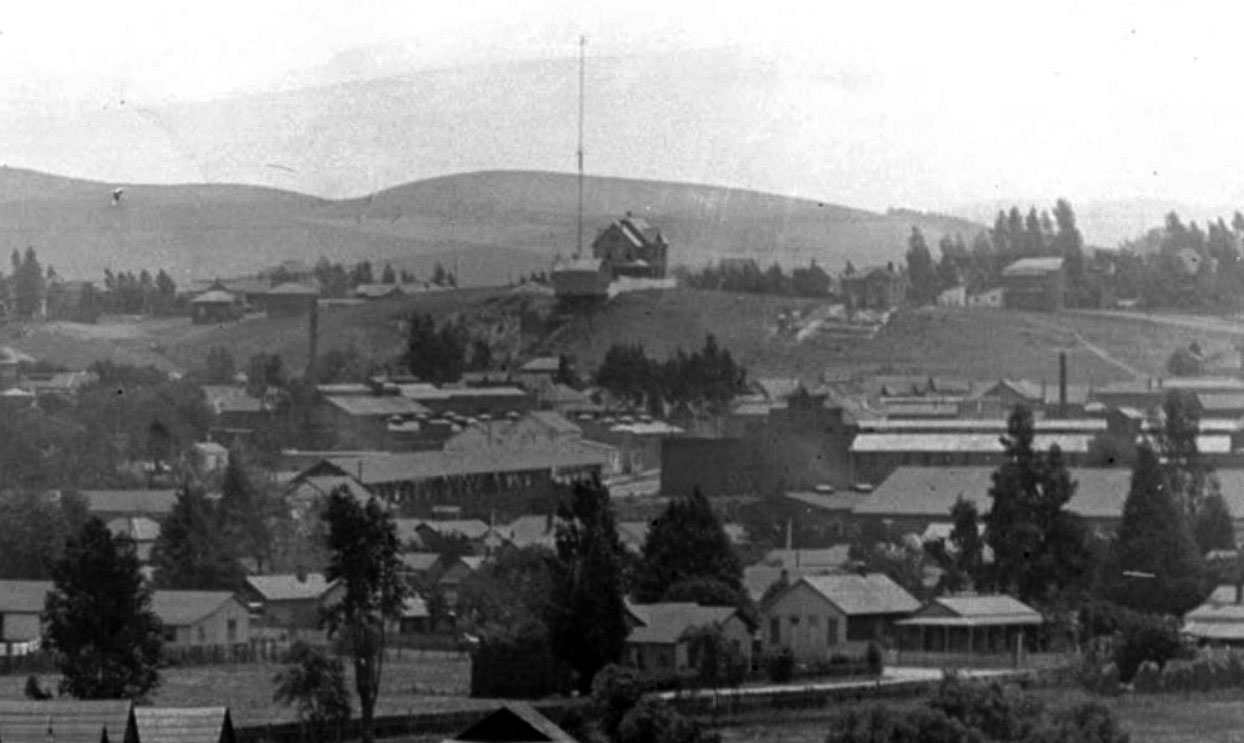 |
|
| (ca. 1890)* – Close-up detail view showing a 150-ft tall streetlight in Boyle Heights. |
Historical Notes On New Year's Eve of 1882, with much less reportage and ceremony, and only twenty-four hours after electric lights were introduced to Los Angeles, the electric light mast at First Street and Boyle Avenue was switched on. There were four other locations in Boyle Heights and East LA. (Using present-day street names) they were Avenue 22 and North Broadway in Lincoln Heights (the area was then called East Los Angeles), First Street and Central Avenue, Fourth Street and Grand Avenue, and Sixth and Main streets. |
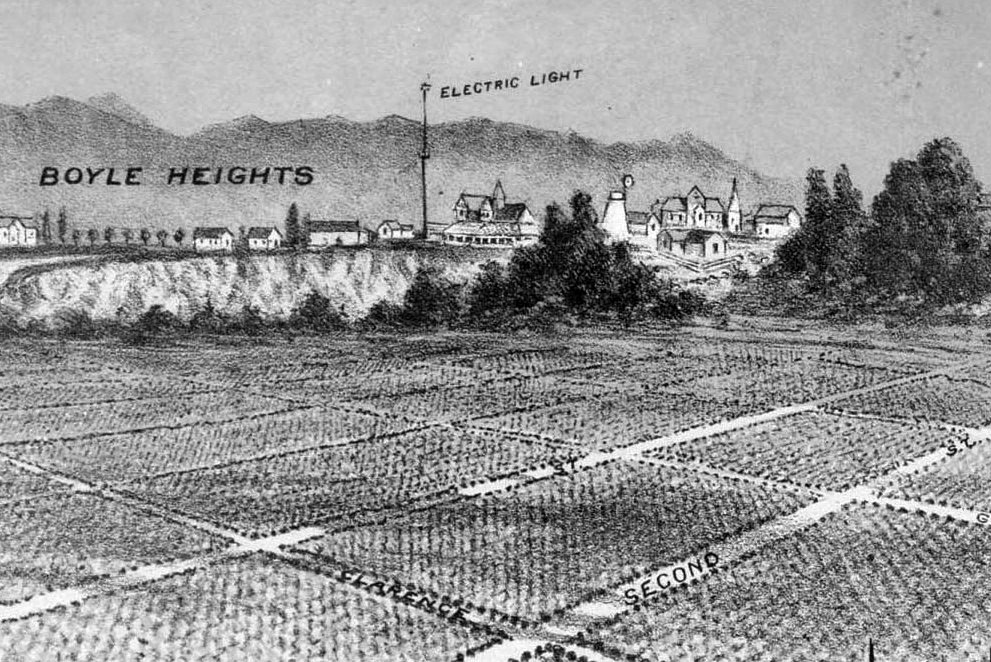 |
|
| (1889)* – Sketch found on a map published in 1889 of the William Workman property and vineyards in Boyle Heights. The “Electric Light” mast is plainly seen and identified on the upper left. |
Historical Notes These maps were generally produced to promote a subdivision, neighborhood or city and prominent features, like the light mast, were given attention as part of selling a well-planned and suitably outfitted area for potential buyers of property and structures. |
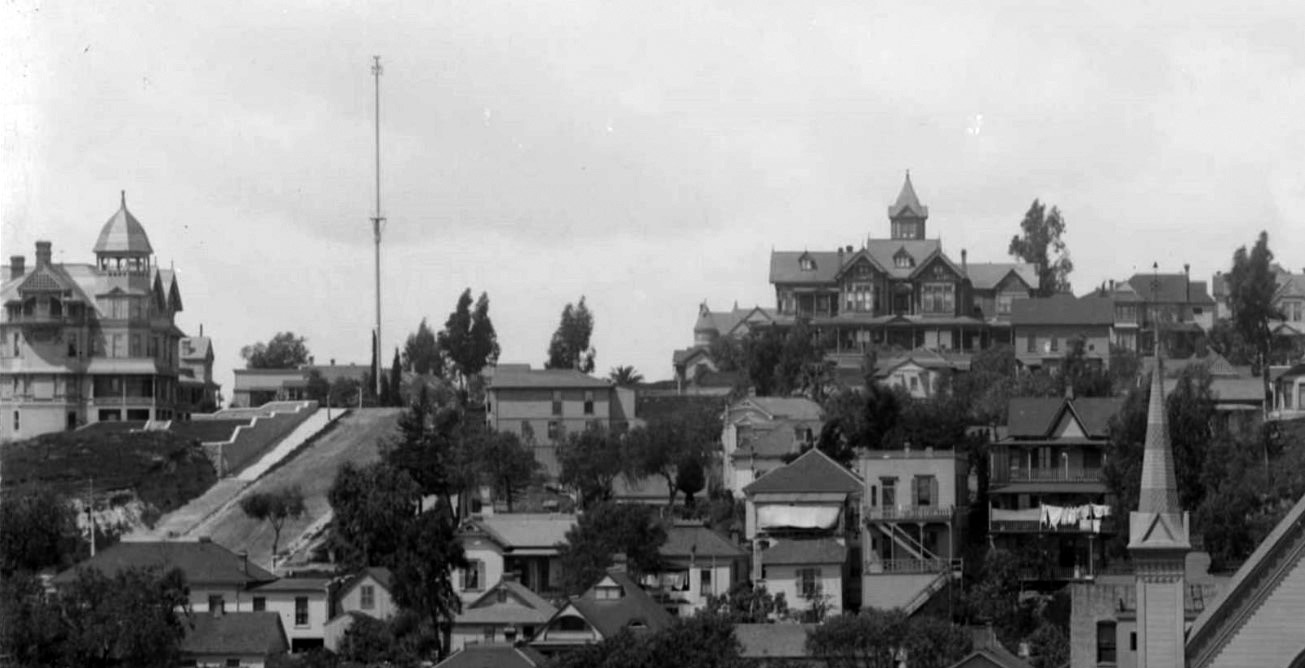 |
|
| (ca. 1890)* – View looking west toward Bunker Hill showing the impressive Brunson Mansion at center-right with the Rose Mansion at far left. Note the 150-ft tall streetlight at center-left. |
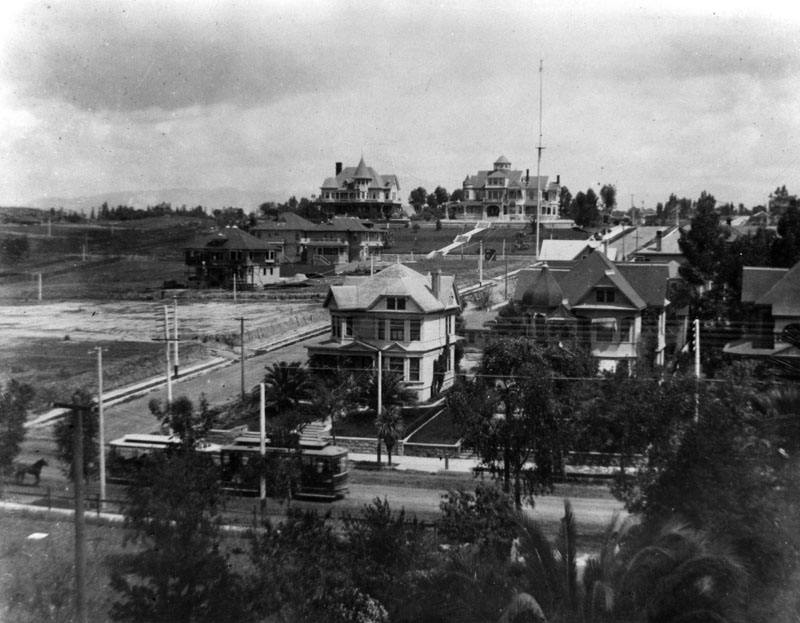 |
|
| (ca. 1892)^ - View showing one of the City's 150-ft tall streetlights in the residential area of Orange Street (later Wilshire Boulevard) at Lucas Avenue. |
Historical Notes By the mid-1880’s there were over 240 of the new electriic 150-ft tall streetlights throughout the city. |
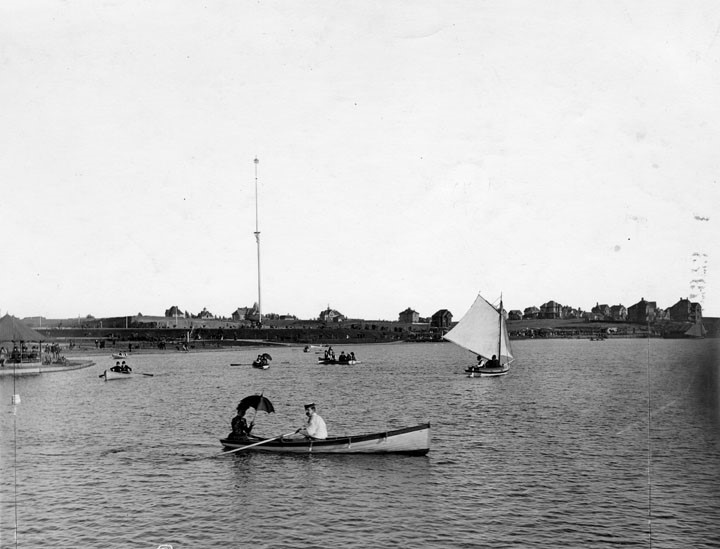 |
|
| (1890s)^ - A sailboat and several row boats are seen on the lake at the City's new park, Westlake Park (now MacArthur Park). The hillside is beginning to be filled with new homes. The very tall pole in the background is one of the City’s new streetlights (150-ft tall). |
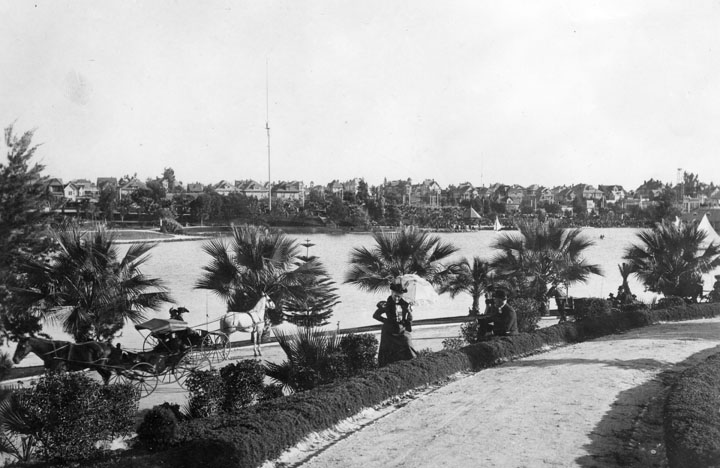 |
|
| (ca. 1895)^ - View of Westlake Park (now MacArthur Park) circa 1895. Transportation was still by horse and carriage (lower left of picture) and ladies carried parasols to shade themselves from the sun. The tall pole seen on the other side of the lake is one of the City's first 150-ft tall electric light poles. |
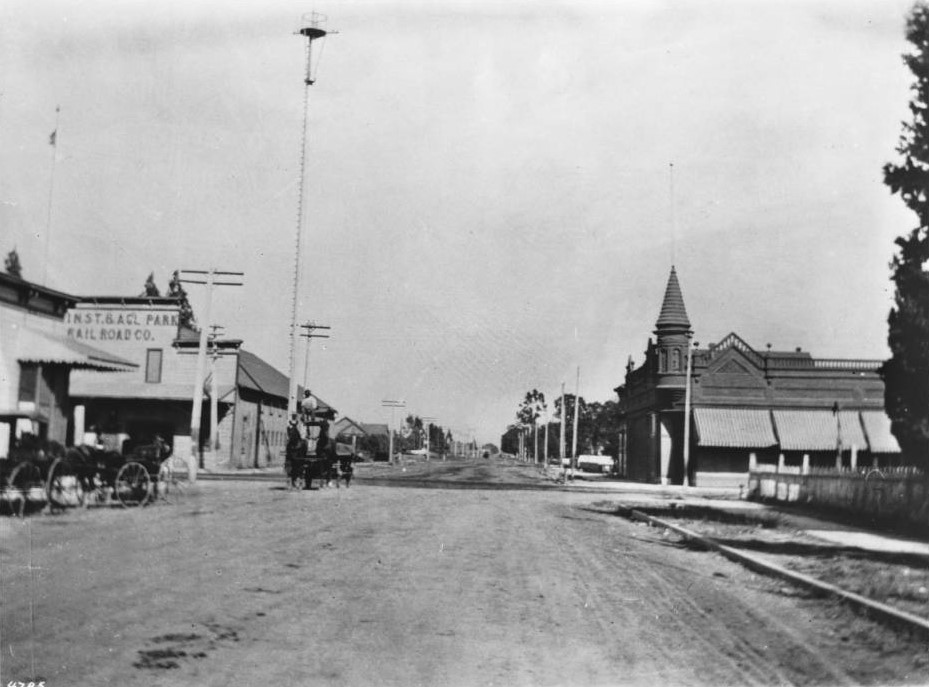 |
|
| (1896)* - View is looking east at Washington Boulevard from Main Street. There are storefronts on both sides of the wide dirt road. Horse-drawn carriages can be seen on the left as well as a very tall white streetlight with a small platform at the top. The platform is actually in the middle of the pole. |
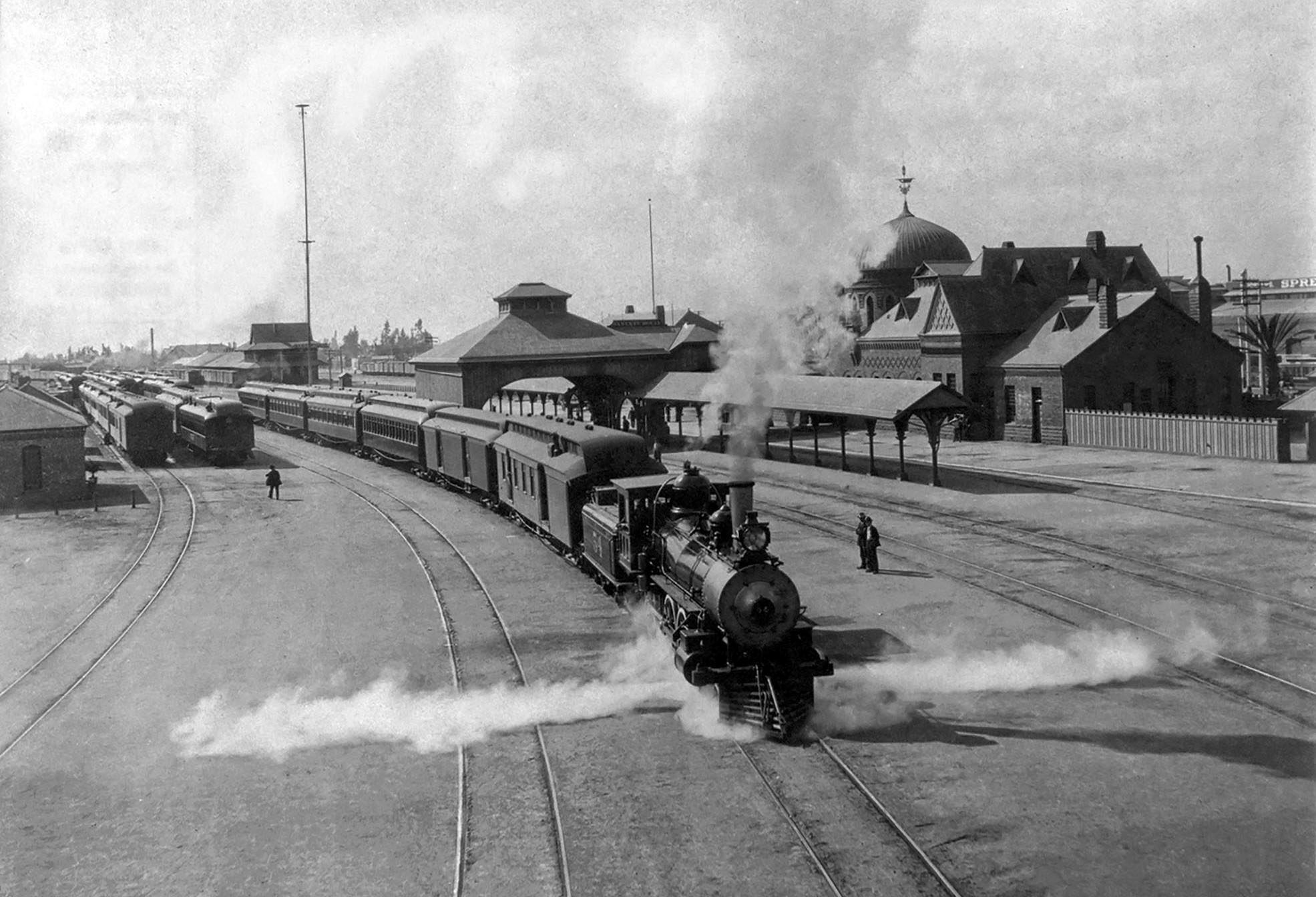 |
|
| (1899)* – Panoramic view showing a train leaving the La Grande Santa Fe Station. Standing tall In the background (center-left) is one Los Angeles’ first 150 ft. streetlights, installed to illuminate the railroad yard. |
Historical Notes Over time, difficulty with maintenance and the undependability with lamps on 150-foot “masts” encouraged engineers to improve lighting technology so more pole locations could be used economically with shorter poles and less energy requirements. |
Then and Now
 |
|
| (1882 vs. 2000)* – A ‘Then and Now’ comparison of Los Angeles' first electric streetlight, installed on the 300 block of North Main Street in early downtown Los Angeles, juxtaposed with a contemporary streetlight at the northeast corner of Valley Circle Boulevard and Avenue San Luis in Woodland Hills. In a way, we've come full circle with these towering lights—though the original stood at 150 feet, today's version reaches only 100 feet, 27 miles away. Photo comparison by Jack Feldman |
* * * * * |
LA's First Electric Light Power Plant
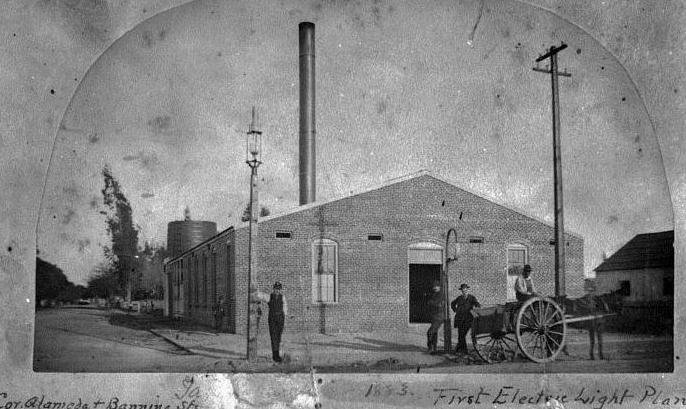 |
|
| (1883)* - The first electric light plant in Los Angeles was built in 1882 by C. L. Howland (Los Angeles Electric Company) on the corner of Alameda and Banning Streets. |
Article from LADWP's Historic Archives “Los Angeles City is famed not only for its climate and for its oranges, but its electric light comes in as its crowning glory . . . "
|
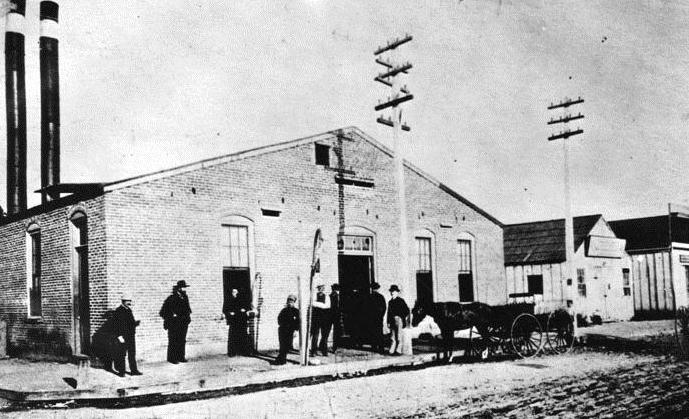 |
|
| (1888)* - Banning Street Electrical Plant now showing two smokestacks. It appears that the building as been enlarged from its original footprint as seen in the previous 1883 photo. Click HERE to see more in Early Power Generation in Los Angeles. |
* * * * * |
Early Utilitarian Streetlights
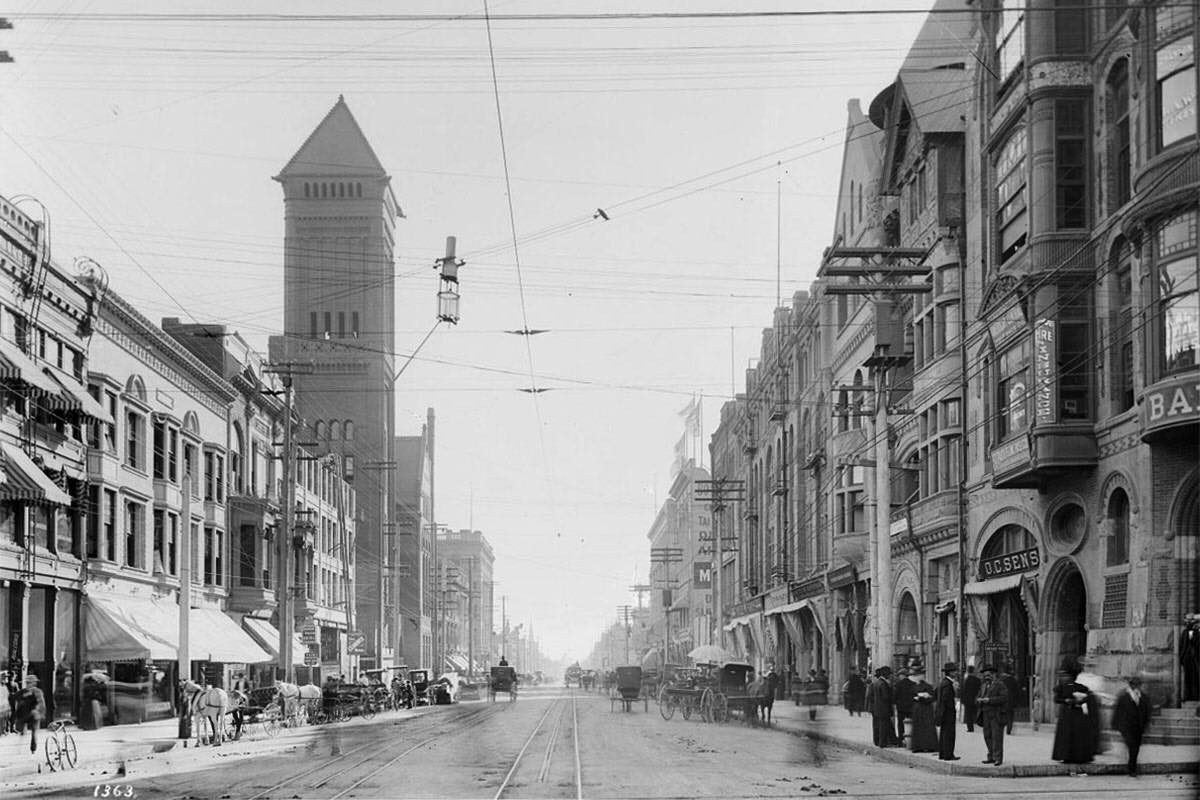 |
|
| (ca. 1904)* - Broadway looking south from Second Street. A double carbon arc lamp utilitarian streetlight is hanging from wire in the center of the intersection. The tall tower in the distance is the 1888-built City Hall. It would stand there until today's City Hall was built in 1928. |
Historical Notes "Utilitarian" Streetlights are lamps attached to an overhead wire or to a power pole. |
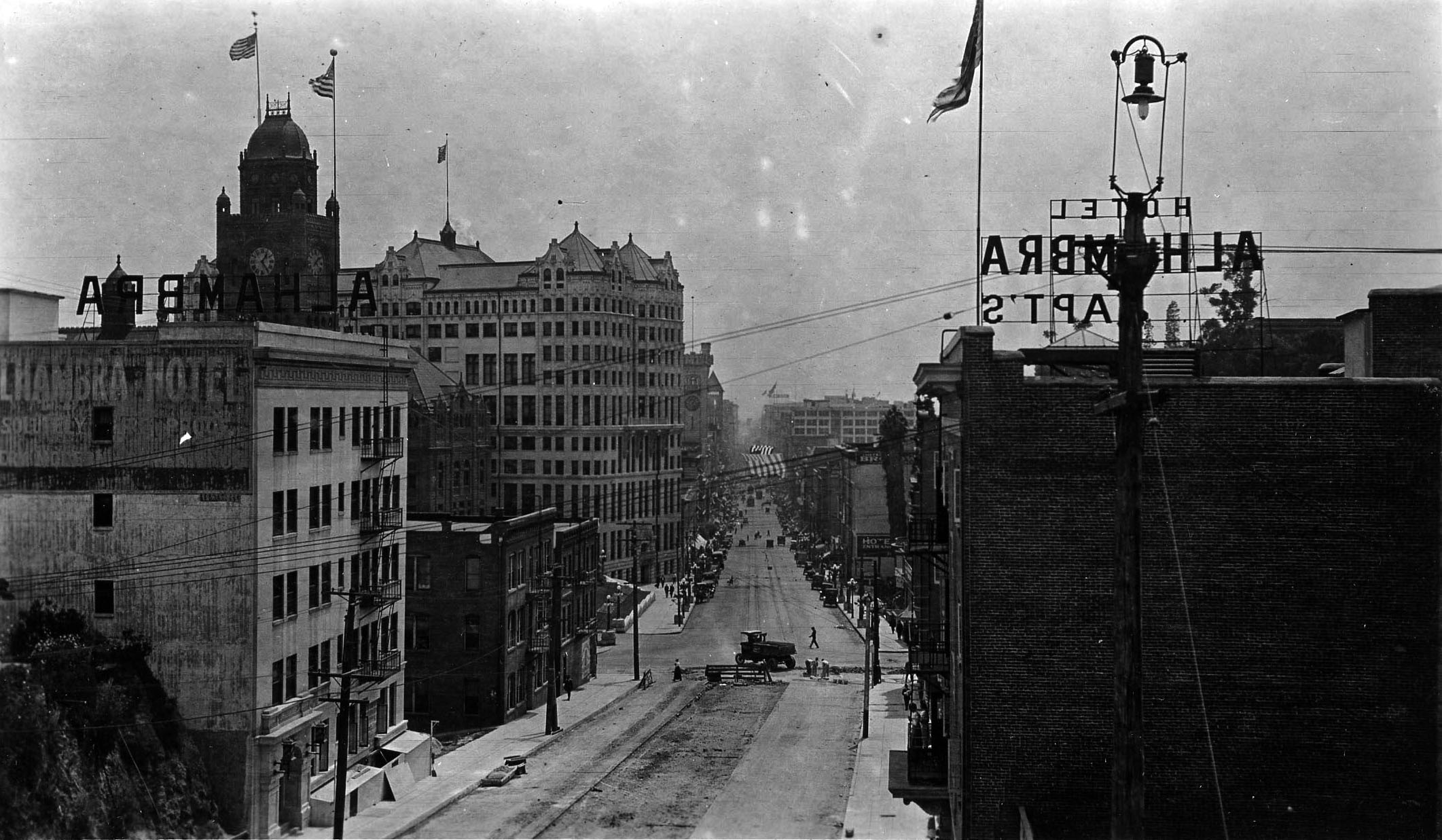 |
|
| (1920s)* – View looking south on Broadway from the top of the Broadway Tunnel toward Temple Street. The LA County Courthouse, Hall of Records, LA Times Building, and City Hall (built in 1888) can all be seen in the background on the east side Broadway. The Alhambra Hotel is in the left foreground and the Hotel Alhambra & Apartments Annex is across the street on the right. In front of the Annex can be seen a very tall power pole with a utilitarian streetlight mounted on top of it. |
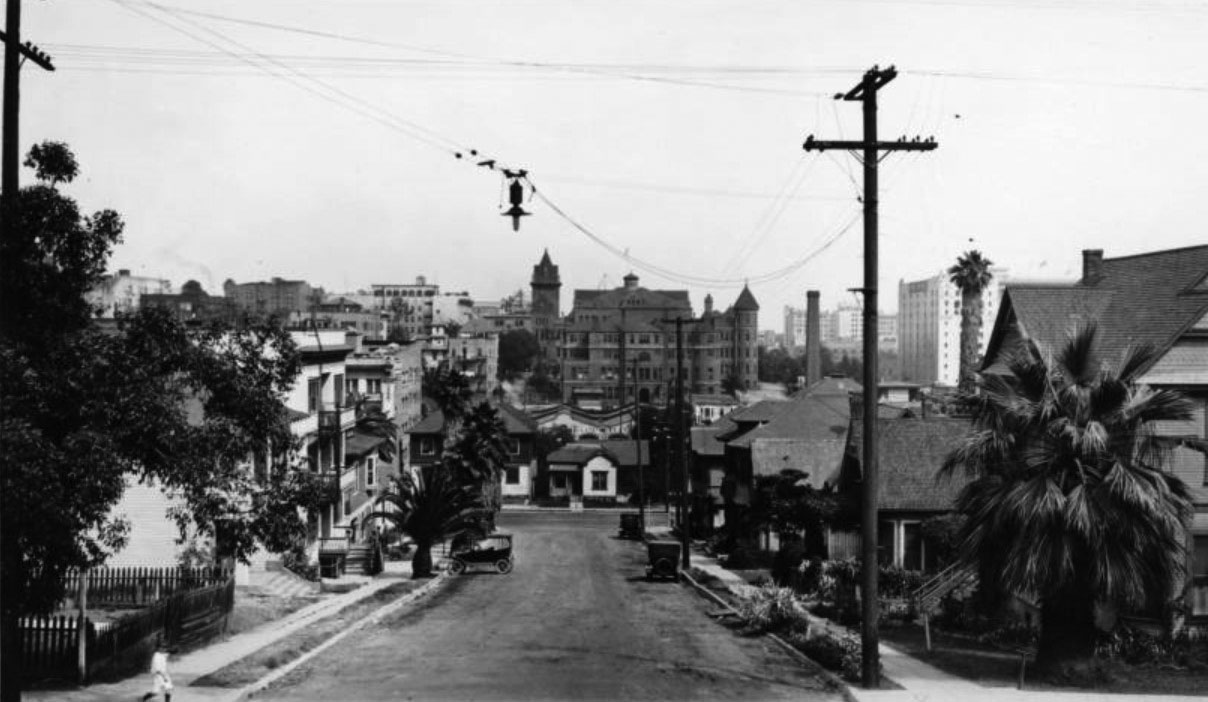 |
|
| (1922)* - Utilitarian streetlight hanging from wire that straddles 5th Street. View is looking east on 5th Street toward Figueroa Street. |
Historical Notes Top photo shows the State Normal School sitting atop the last knoll of Bunker Hill, aptly dubbed "Normal Hill." In the mid-1920s the school would be demolished, Normal Hill would be leveled, 5th street would be extented through to Grand Avenue, and the LA Central Library would be constructed where the old school once stood. |
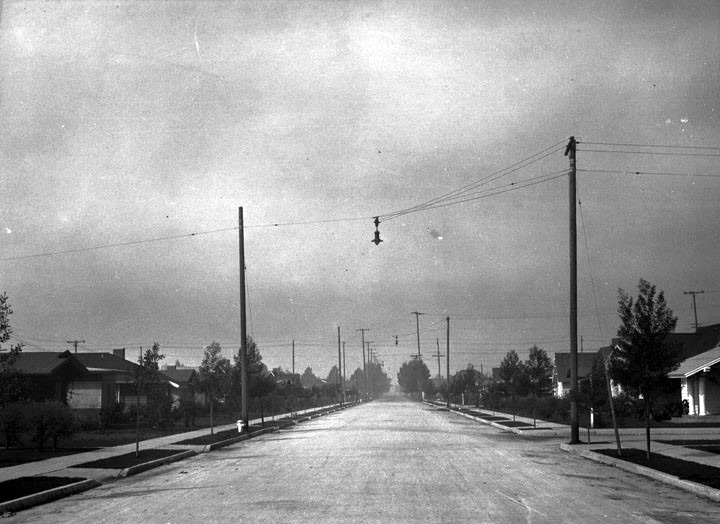 |
|
| (ca. 1920s)* - Early LA residential street light installation. Note the Utilitarian streetlights. |
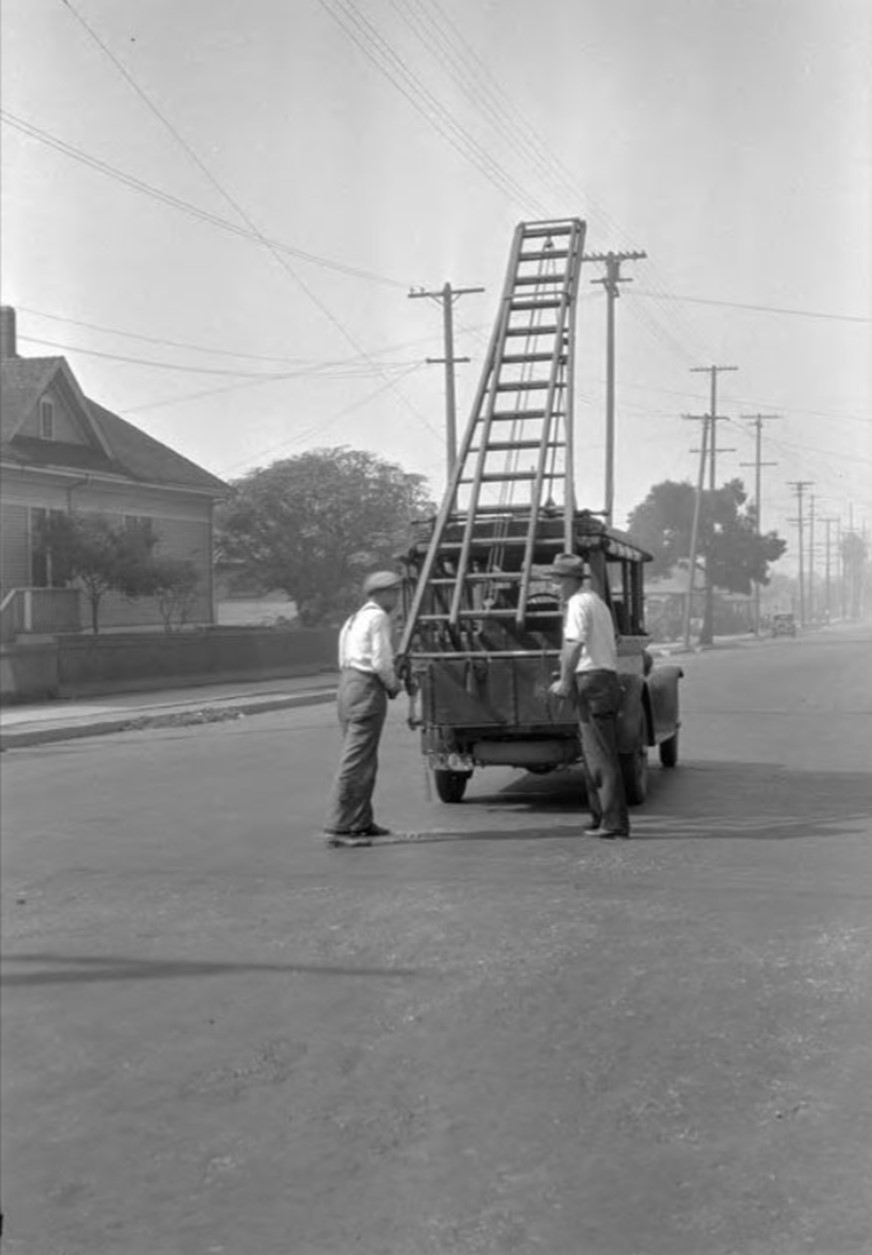 |
|
| (1920)* – A Buarau of Power and Light crew preparing to replace an overhead streetlight lamp (‘Utilitarian’ streetlight). |
Historical Notes "Utilitarian" Streetlights are lamps attached to an overhead wire or to a power pole. |
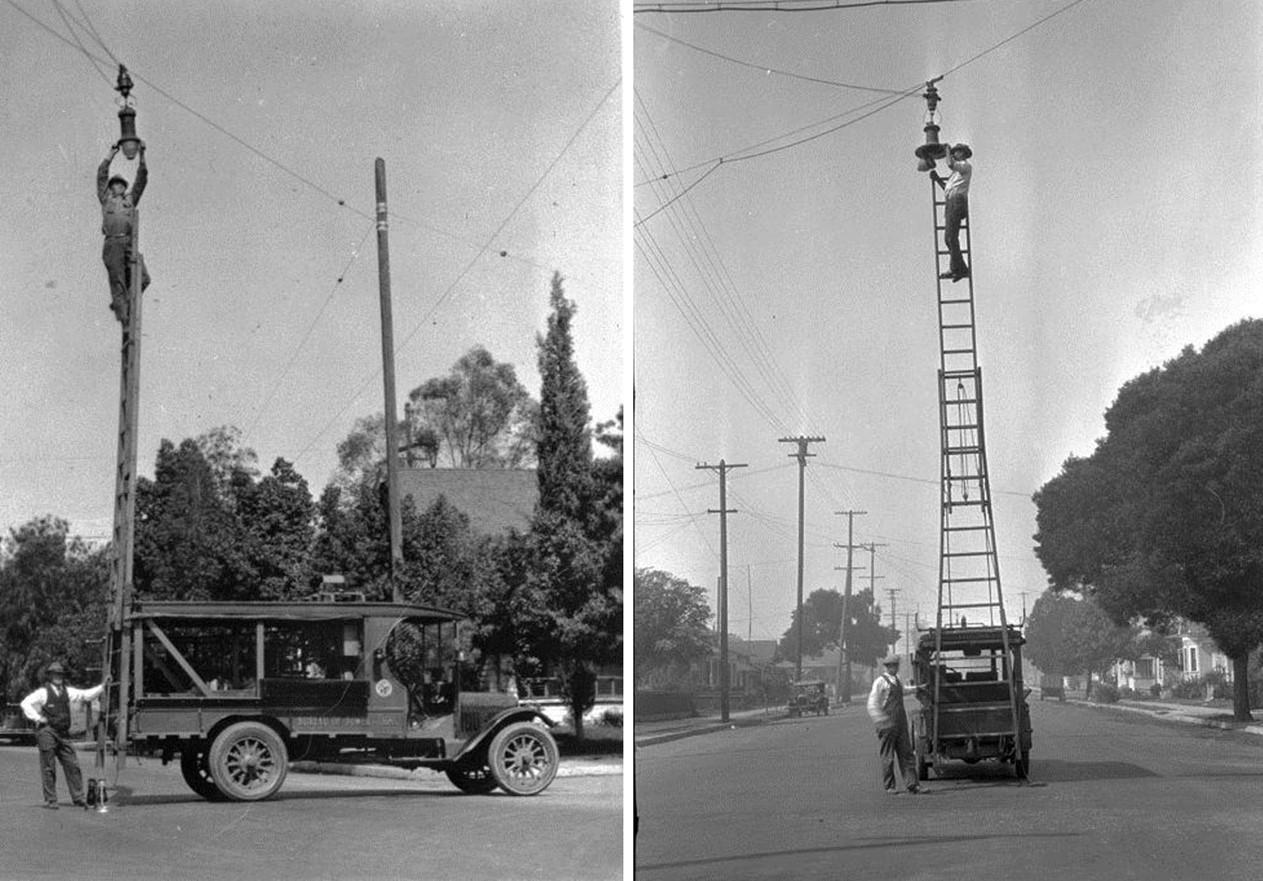 |
|
| (1920s)* - A Bureau of Power and Light worker changing out a hanging lamp in the middle of an intersection. |
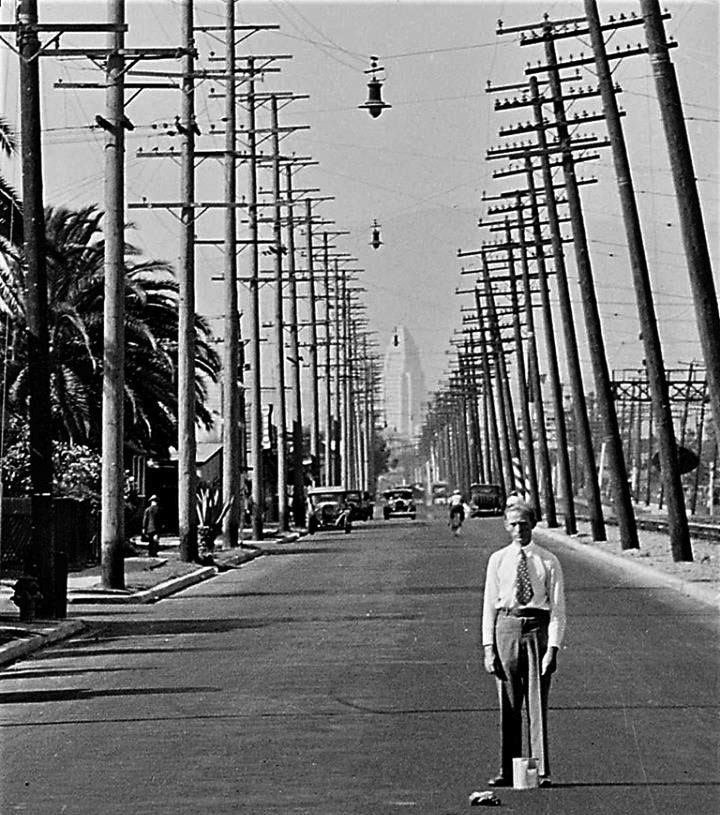 |
|
| (1929)* – View looking north on Long Beach Ave at 42nd Street, showing a very serious looking man standing in the middle of the road. Overhead lines run up and down both sides of the street (power lines on the left and telephone lines on the right). Overhead utilitarian streetlights straddle the street between the lines. Railroad tracks are on the right and City Hall (built in 1928) can be seen in the distance. Click HERE to see contemporary view. |
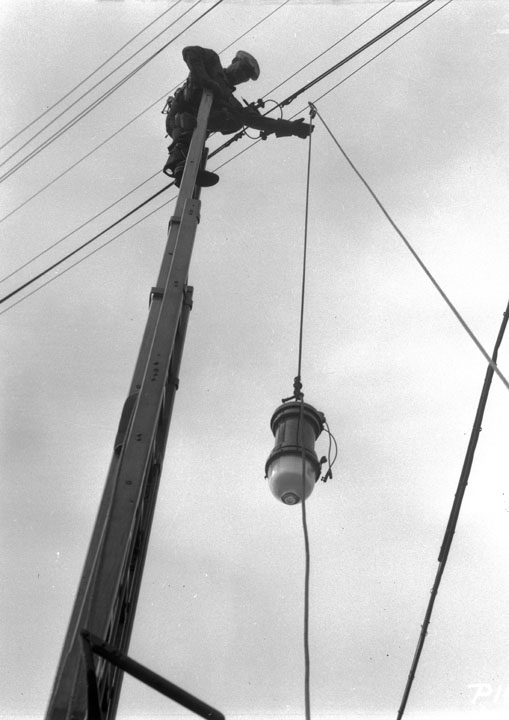 |
(Early 1930s)* - New street light being pulled up for installation.
|
|
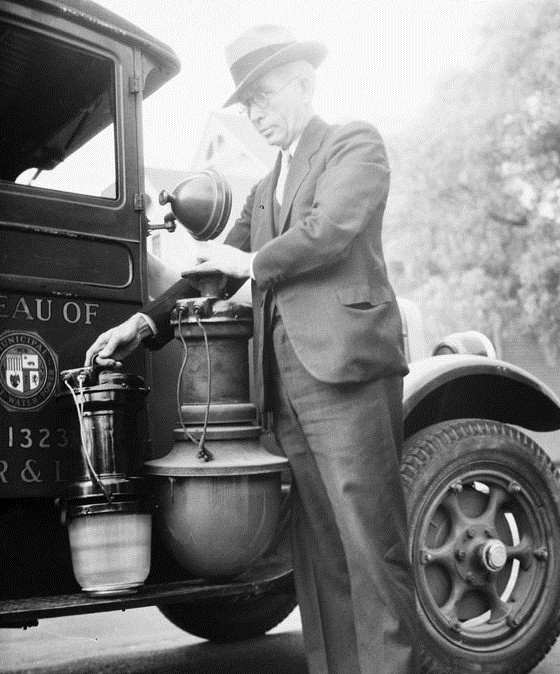 |
(1933)* - L. G. Gould with a new and an old incandescent lamp at 30th and Trinity Streets.
|
Historical Notes This marked the close of another era in the development of Los Angeles. The last arc light in the City was removed November, 1933 by L. G. Gould's street lighting section and replaced with a modern incandescent lamp.* |
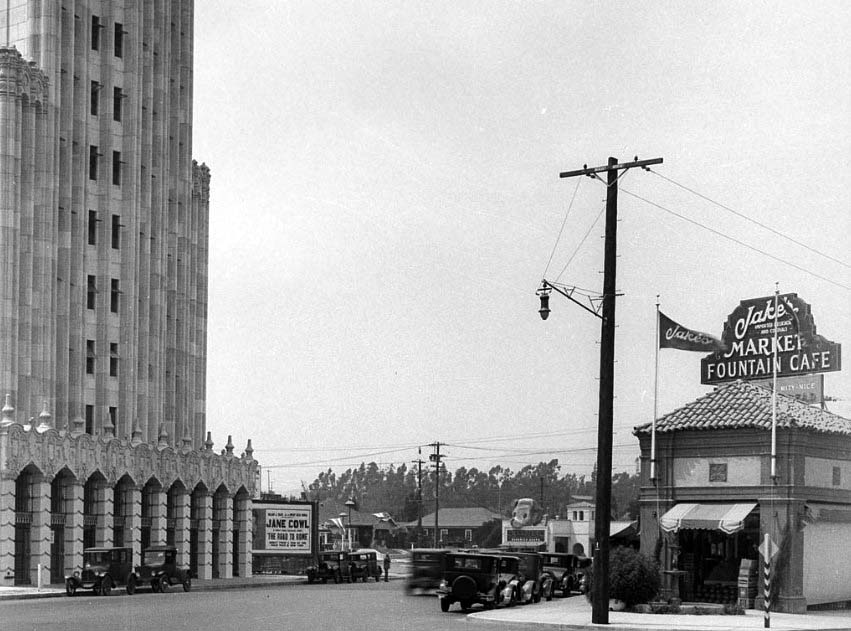 |
|
| (1928)* – View showing a "Utilitarian" Streetlight attached to a wooden pole located at the apex of the intersection of Beverly Boulevard and N. Virgil Avenue. On the right is Jake's Market Fountain Cafe. Across Beverly on the left is the American Storage Building . Barkies Sandwich Shop can be seen in the background where Beverly intersects with Temple Street. |
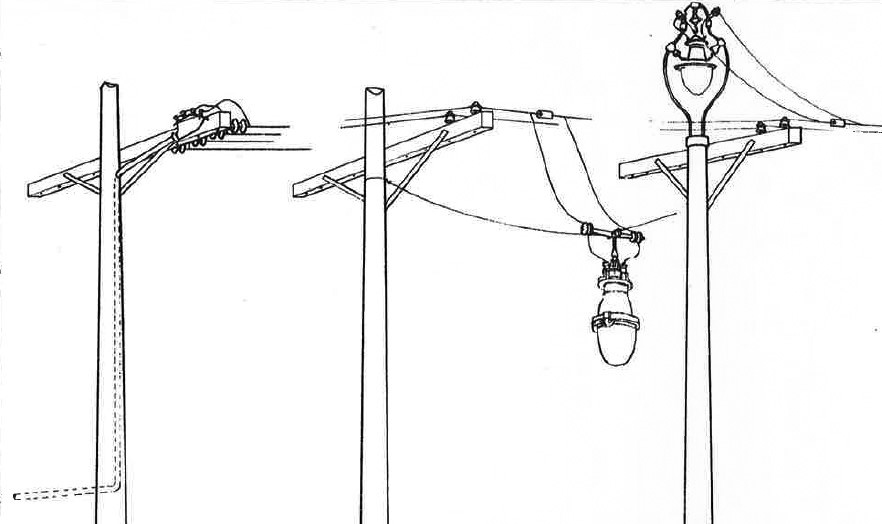 |
|
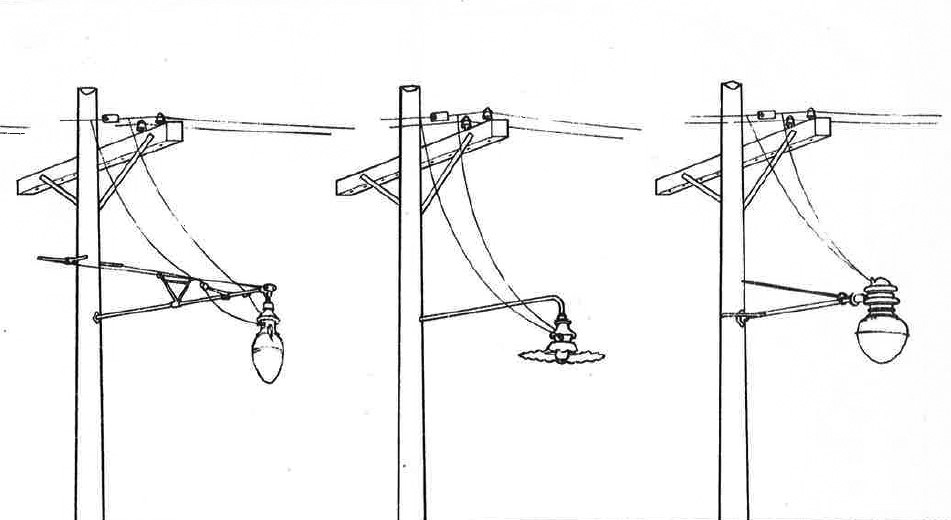 |
|
| (1947)* - Sketch showing a variety of Utilitarian Streetlights as seen in a DWP Streetlight Manual issued in 1947. |
Historical Notes Early Utilitarian Streetlights were served through two types of circuits - multiple and series. The multiple circuits are the same as ordinarily used in house lighting and employ a constant voltage of 120 volts, two wire or 120/240 volts, three wire. In the series circuits, the lamps were connected in series and the same current passed through all lamps. The current was maintained at a constant value and each circuit was individually regulated by a constant current regulating transformer. The voltage of the circuit at the supply point was equal to the sum of the voltages across each lamp pluse the line drop. Utiltarian Lights still exist today, however, they are all served by 120/240 volts wire. Click HERE to see the 1947 DWP Streetlight Manual. |
* * * * * |
Early Streetlight Electroliers
Streetlight "Electroliers" are defined as free-standing streetlights generally on their own posts. The second period of street lighting in Los Angeles took off in the early 1900 and lasted until just before the Second World War. During this period street lighting used vertically mounted incandescent lamps (electroliers) which were relatively low in height, placed close together, and often highly ornamental. |
Broadway - 7-Globe Electrolier
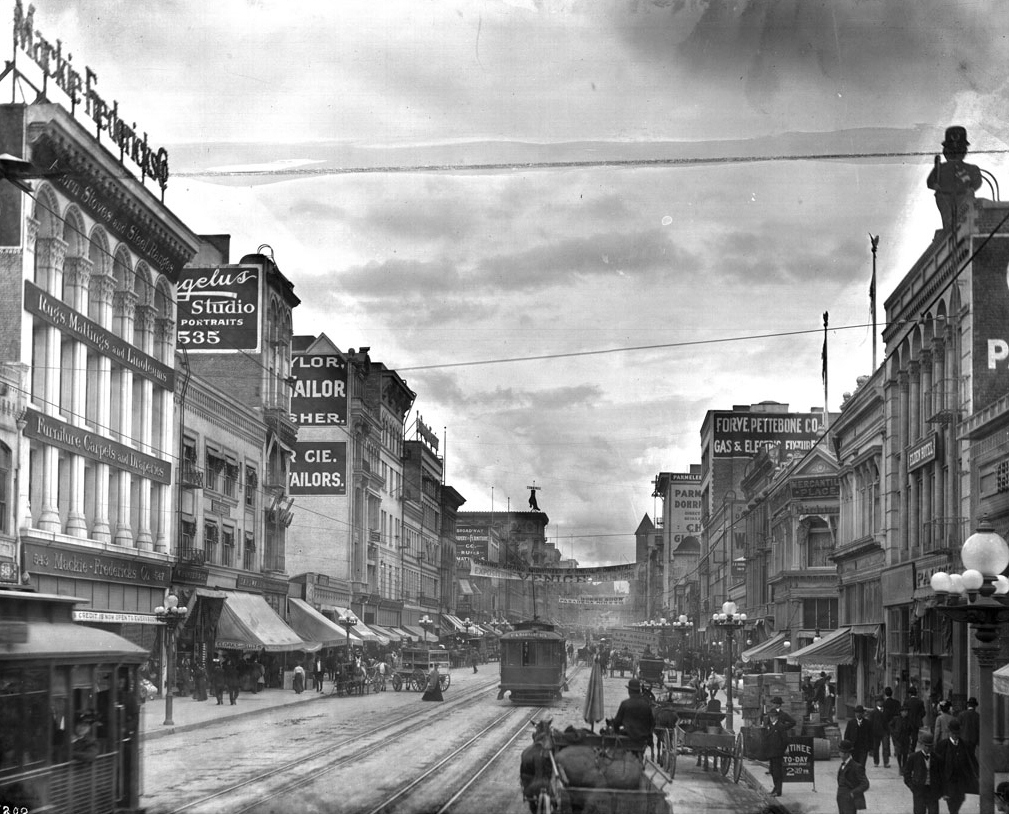 |
|
| (ca. 1905)* - View of Broadway looking north from Sixth Street. The 7-lamp ornate streetlights that ran along the sidewalk curb consisted of a large round bulb surrounded by six smaller ones. |
Historical Notes In May 1905, the first ornamental post system in the city was introduced on Broadway between First and Main Streets. This installation consisted of 135 posts each equipped with six small glass globes, enclosing 16 candle-power amp, and one large glass globe, enclosing a 32 candle-power lamp. This system operated until 1919 when it was demolished to make way for a more modern system. |
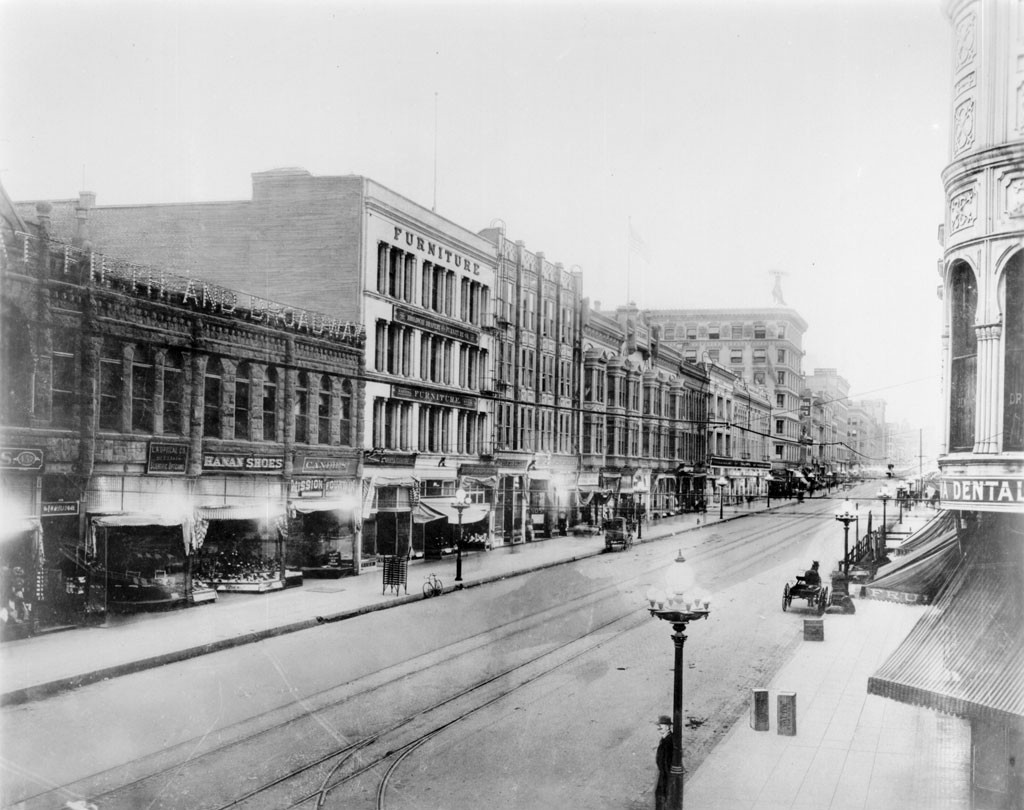 |
|
| (1907)* - View looking north on Broadway near 5th Street at dusk or dawn. Beautiful 7-lamp streetlights are illuminating the nearly vacant street. |
Historical Notes Even with multiple lamps, the light given off from these new Electroliers was not great. Most had a single large globe that gave off 32‐candle power, and two to six smaller globes that each produced 16 candlepower. This was in contrast to the 3000 candle power of the Brush arc lights. Therefore, electroliers had to be placed relatively close together. Nor could they be tall.* |
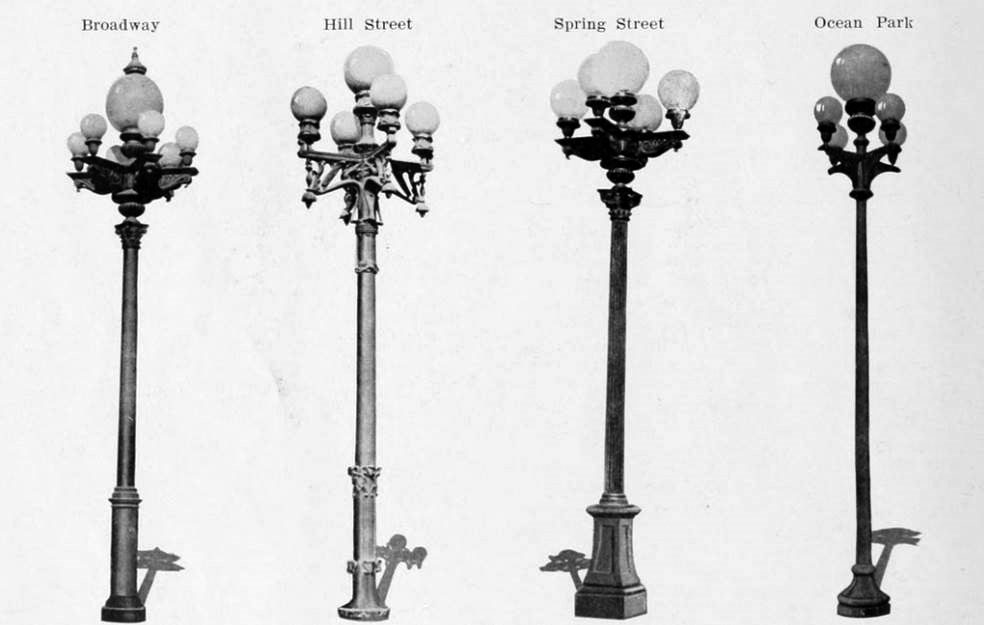 |
|
 |
|
| (1909)* - Source: The City Beautiful aka Report of the Municipal Art Commission for the City of Los Angeles. |
Historical Notes Supplying these lamps to Los Angeles was the Llewellyn Iron Works. The company fabricated a variety of electrolier configurations featuring a single large globe and two to six smaller globes. All followed the classical treatment of a heavier base and a more slender shaft. All the globes were spherical, but the seven‐lamp form could be provided with a finial atop the large globe. |
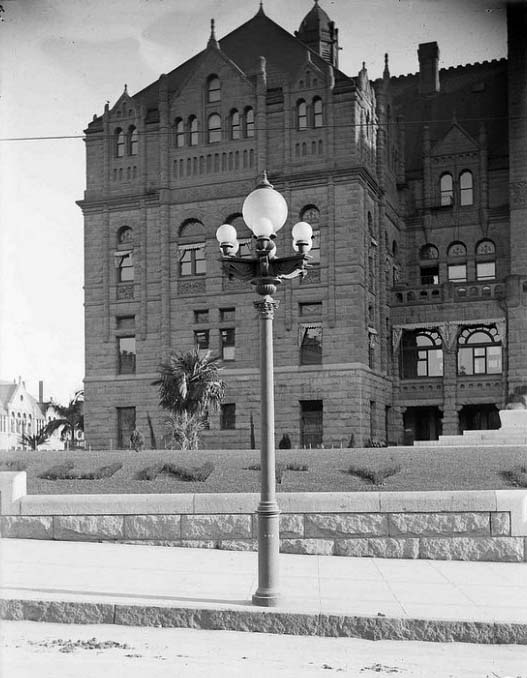 |
|
| (1910)* - A 7-bulb decorative streetlight with finial atop the large globe stands in front of the LA County Courthouse located at Broadway at Temple Street. |
Historical Notes The popularity of the electrolier soon spread to other Downtown streets. Within a year Hill, Main and Spring Streets had installed Llewellyn fixtures. They were typically five‐globe rather than seven, allowing Broadway to maintain its image as the brightest of the Great White Ways. Eventually other Downtown and neighborhood commercial districts gained Llewellyns. |
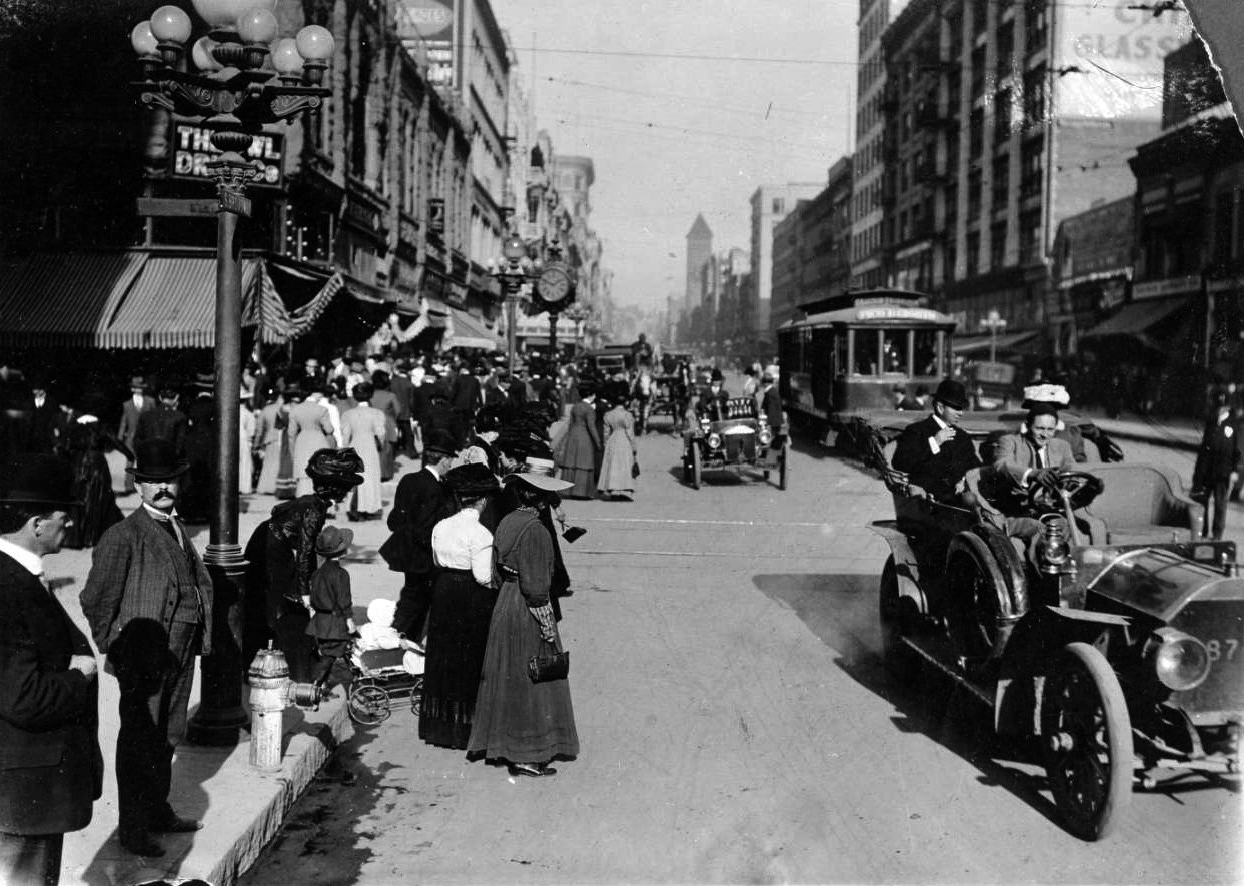 |
|
| (ca. 1908)* – Looking north on Broadway at 5th Street, the busy street is shared by cars, streetcars, and even a horse-drawn wagon, while pedestrians fill the sidewalks. There's a lot to take in here: the beautiful 7-bulb decorative streetlights lining both sides of the street helped maintain Broadway as the brightest thoroughfare in downtown. The tall tower in the distance was L.A.’s City Hall from 1888 to 1928. Also note the steering wheel on the car in the foreground is on the right-hand side—typical of early automobiles before Ford’s Model T popularized left-hand drive. |
Historical Notes Financed by the Broadway Boulevard Improvement Association, 135 cast-iron electroliers were installed from First Street to Main Street in 1905. Each featured a cluster of six smaller globes topped by a larger one, creating a distinctive design that earned Broadway the nickname "the Great White Way". The Llewellyn Iron Works fabricated these ornate fixtures, which became a hallmark of early 20th-century Los Angeles. |
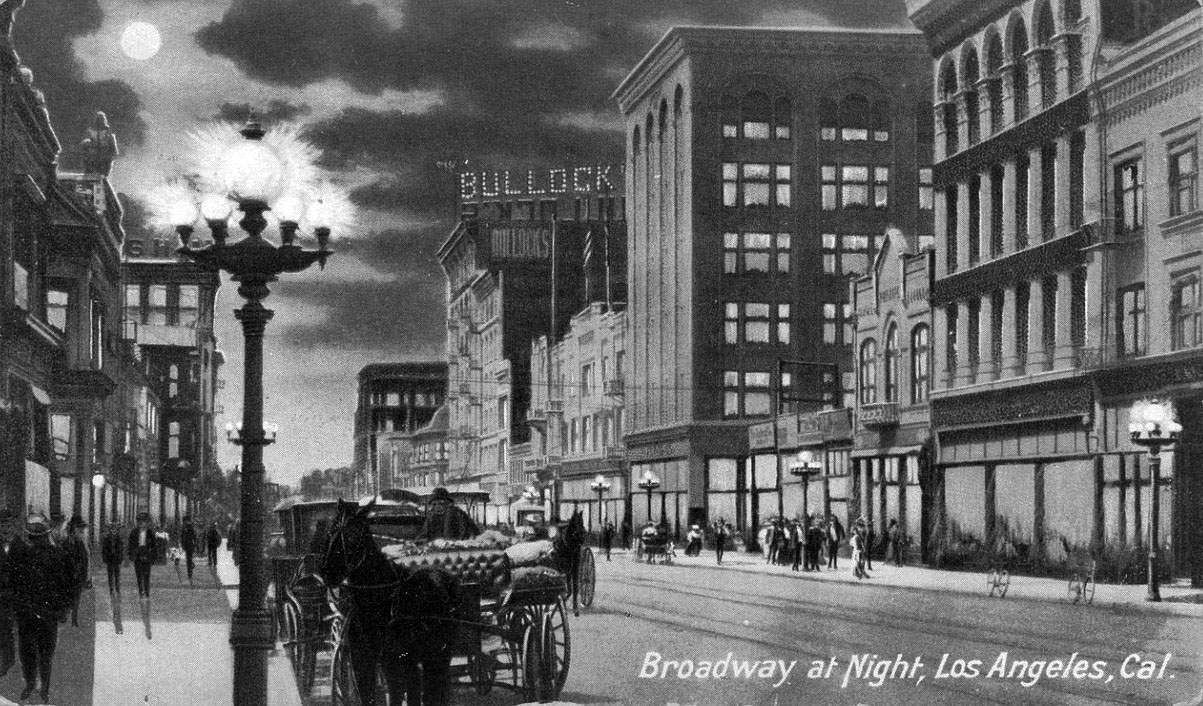 |
|
| (ca. 1908)*– Postcard view looking south on Broadway at night with the Bullock's Department Store building in the background. An ornate 7-bulb lamp stands tall in the foreground adjacent to a horse-drawn wagon. |
Historical Notes The seven-globe electroliers were notably brighter than residential three-globe variants, solidifying Broadway as the city's most illuminated street. Their design influenced later installations on Hill, Main, and Spring Streets, though these used five-globe clusters to maintain Broadway's prominence. The lights were initially powered by private business associations, with municipal power not arriving until 1916. |
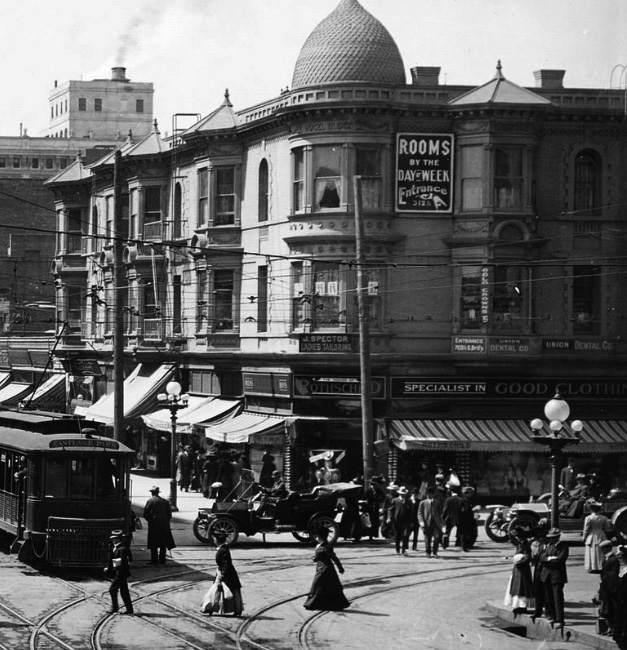 |
|
| (1910)* - View looking at the southwest corner of Broadway and 7th Street showing two ornate 7-bulb lamps on the corners with the Vogel Building and its onion-shaped tower in the background. |
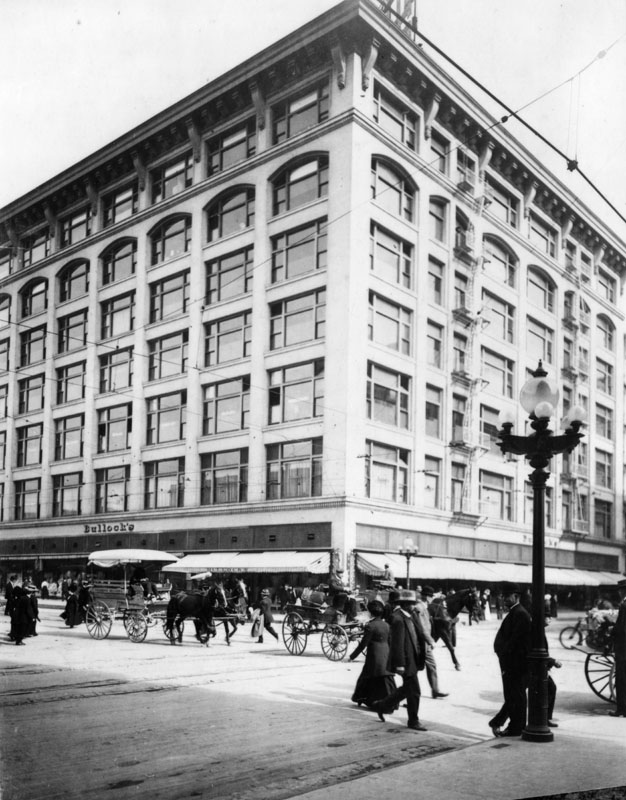 |
|
| (1910)^ - At right, a man stands under a multi-bulb electrolier located on the southeast corner of Broadway and 7th Street. Horse-drawn carriages and pedestrians share the road at the intersection and Bullock's Department Store can be seen across the street. |
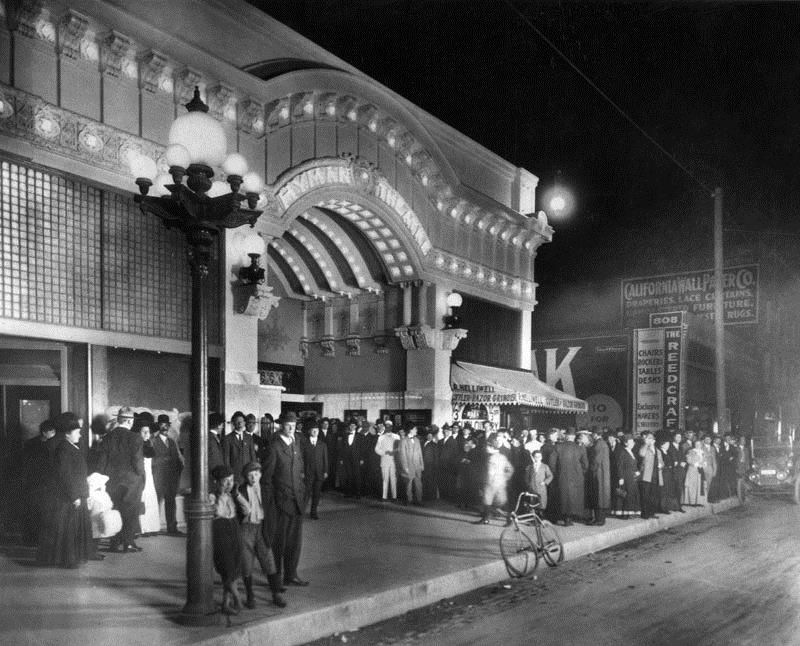 |
|
| (1910)^ - An evening crowd gathers under the marquee of the Hyman Theatre at 802 S. Broadway, on the southwest corner of 8th and Broadway. Two boys stand under an ornate 7-bulb streetlight, one leaning on it. |
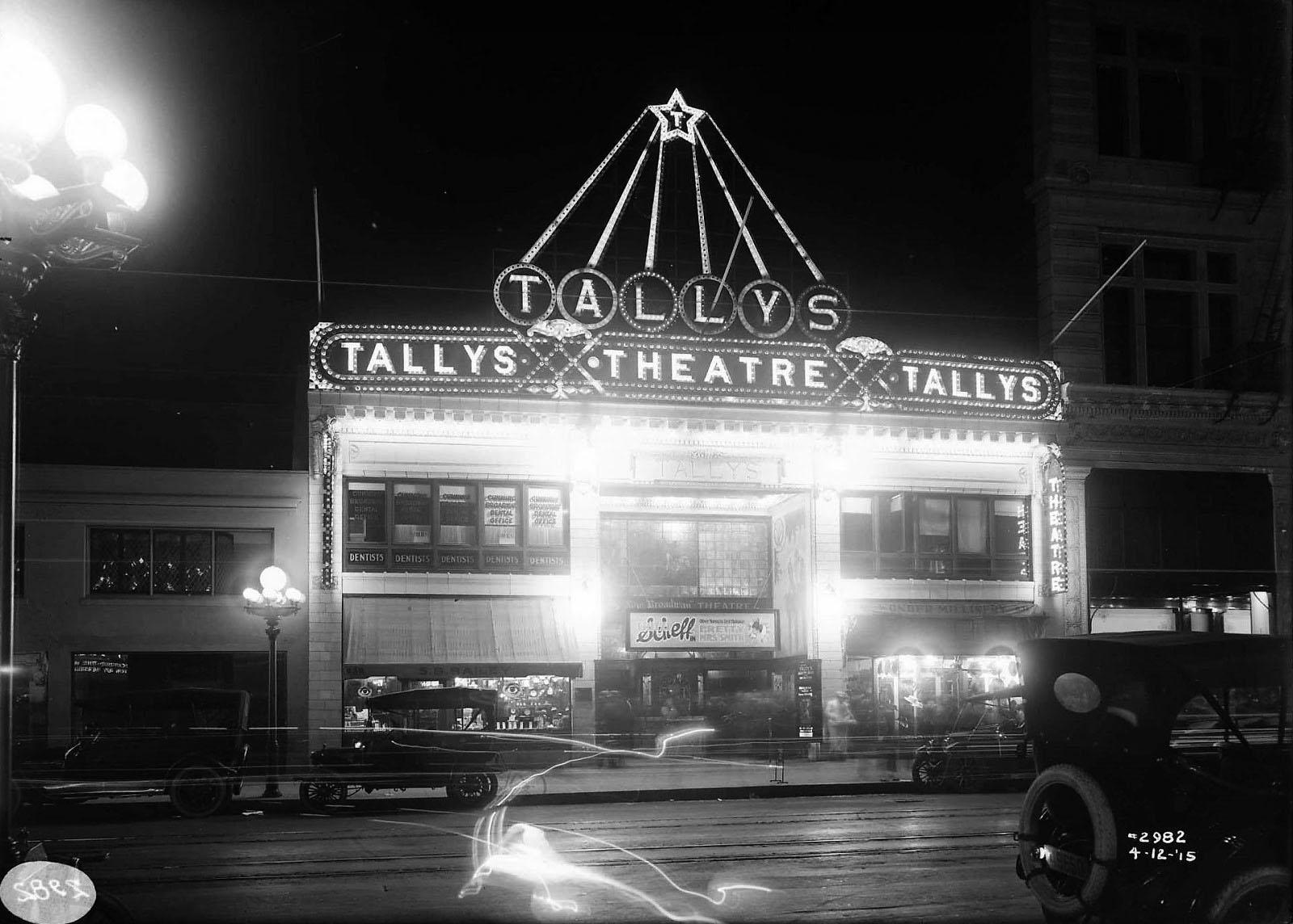 |
|
| (1915)*– 7-bulb electroliers light up both sides of the 800 block of Broadway in front of Tally's Theatre. |
* * * * * |
Five-Globe 'Winslow' Llewellyn Electrolier
 |
|
| (ca. 1910)* - Looking west from 5th and Hill streets. Ornate 5-bulb Llewellyn 'Winslow' Electroliers appear as far as the eye can see. The trees of Pershing Square are visible on the left, and the State Normal School, on the present site of the L.A. Public Library, Central Branch shows prominently in the background. The building to the right is the California Club. |
Historical Notes Five-globe streetlights (called Llewellyn Electroliers) were originally installed on most streets in Downtown Los Angeles in the early 1900s, (except for Broadway which had the seven-globe lights). This particularly ornate model ("Winslow") seemed to be limited to Hill Street and the streets adjacent to Pershing Square: the one block segments of 5th, Olive, and 6th. Today, the last of these poles are still being used as architectural features in the gardens and malls adjacent to City Hall. |
.jpg) |
|
| (1908)* - Close-up view of the northwest corner of Hill and 5th (same as previous photos), showing the ornate 5-globe corner streetlight in greater detail. This particular Llewellyn streetlight was called the 'Winslow'. |
 |
|
| (ca. 1910)* – A 5-globe 'Winslow' Llewellyn electrolier stands in front of Los Angeles Fire Department's Engine Co. No. 3 on the west side of Hill Street, just south of 2nd Street. A three-horse-drawn steam pumper stands in front of the station. In the background, the Victorian-style Locke Hotel & Annex sits atop the hill at the northwest corner of 2nd and Hill Streets. |
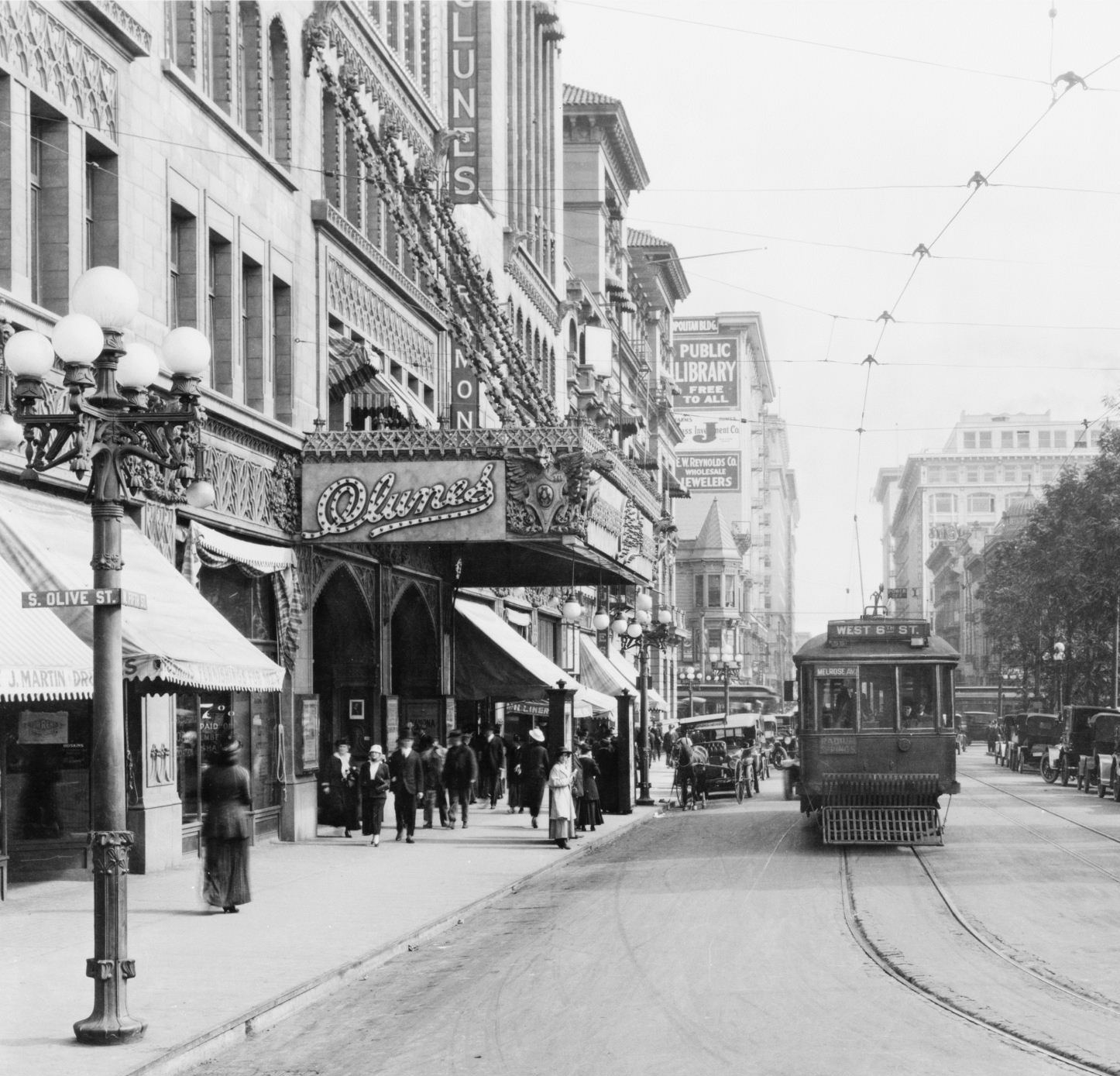 |
|
| (1914)* - A beautiful Llewellyn 'Winslow' 5-bulb electrolier stands on the corner of 5th and Olive streets. The Clune's Auditorium is seen on the north side of 5th Street across from Pershing Square. A horse-drawn carriage is seen parked by the curb while a streetcar is in the middle of the road. |
Historical Notes Click HERE to see more 5-globe Llewellyn 'Winslow' Electroliers |
* * * * * |
Five-Globe Standard Llewellyn Electroliers
.jpg) |
|
| (1905)* – View looking North on Main Street from Fifth Street showing Five Globe Standard Llewellyn streetlights lining both sides of the street. The building with the turret on the right is the Main Street Savings Building, NE corner of Main and Winston streets. In the left foreground is an electric streetcar heading toward the Arcade Depot. |
Historical Notes The most common of the incandescent multiple globe electroliers of the early 1900s were those manufactured by the Llewellyn Iron Works of Los Angeles. The firm became so identified with this style of street light that any multiple globe electrolier became commonly known as a Llewellyn. The Llewellyn Iron Works, founded in 1889‐1890, was one of the largest metal working facilities in Los Angeles. |
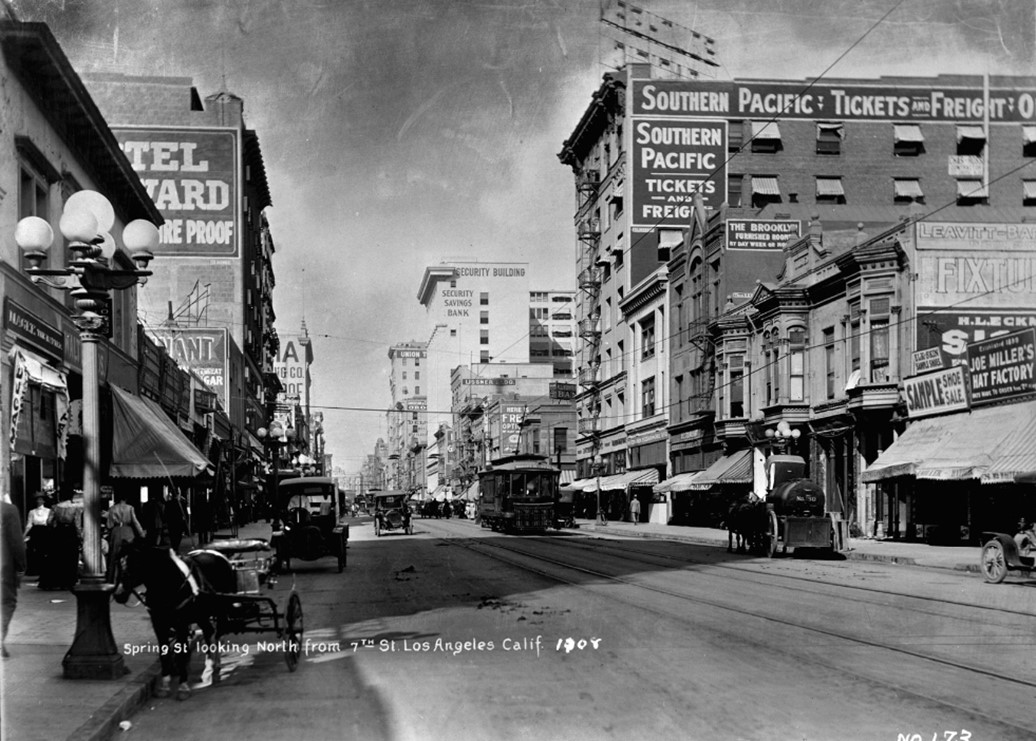 |
|
| (1908)* - Spring Street looking north from 7th Street. Note the horse-drawn wagon parked at the curb under the ornate 5-bulb streetlight. |
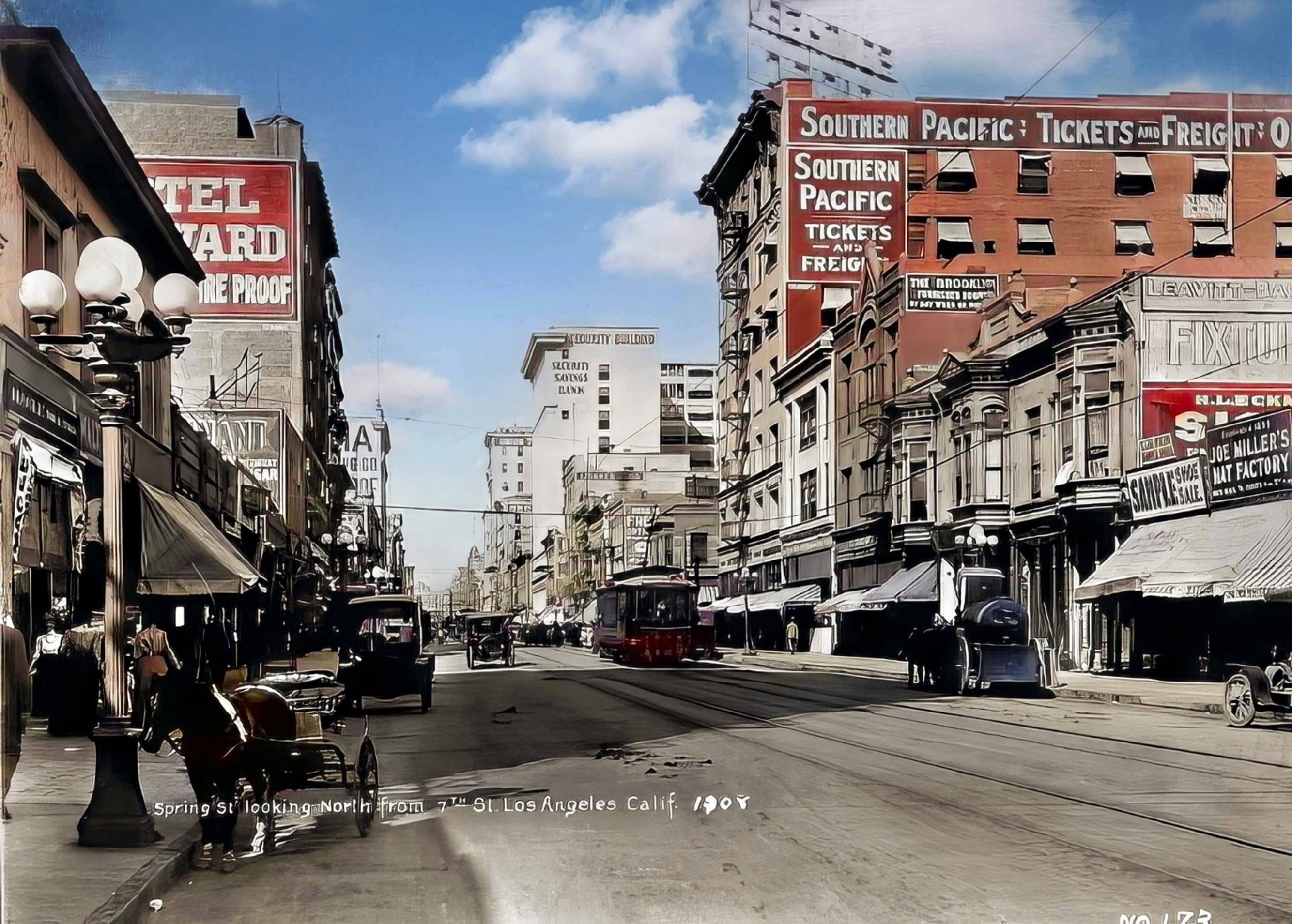 |
|
| (1908)* - Spring Street looking north from 7th Street. Note the horse-drawn wagon parked at the curb under an ornate 5-globe streetlight. Image enhancement and colorization by Richard Holoff. |
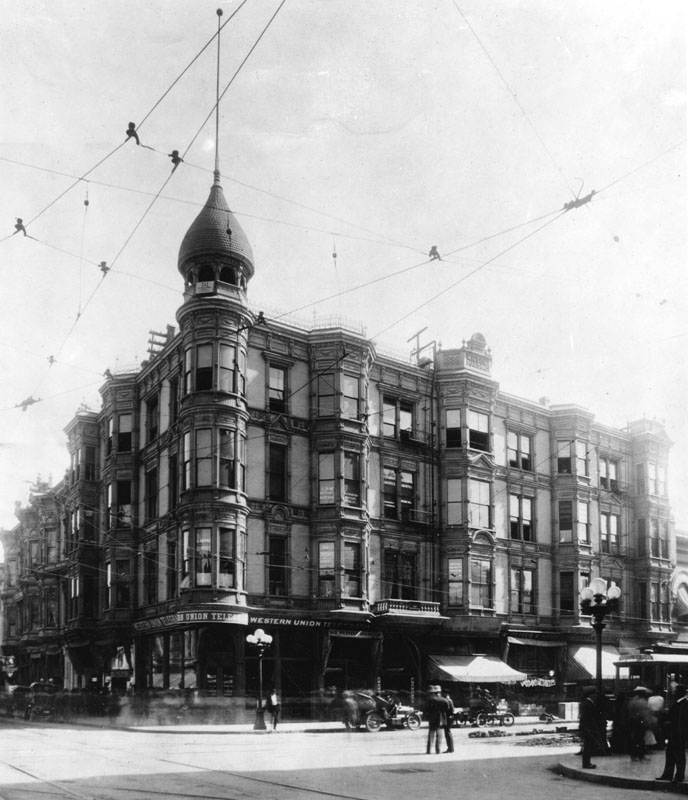 |
|
| (ca. 1910)^ - View showing two ornate 5-bulb streetlamps standing on the corners at the intersection of First and Spring streets. The Wilson Building with its copula is seen on the southeast corner. |
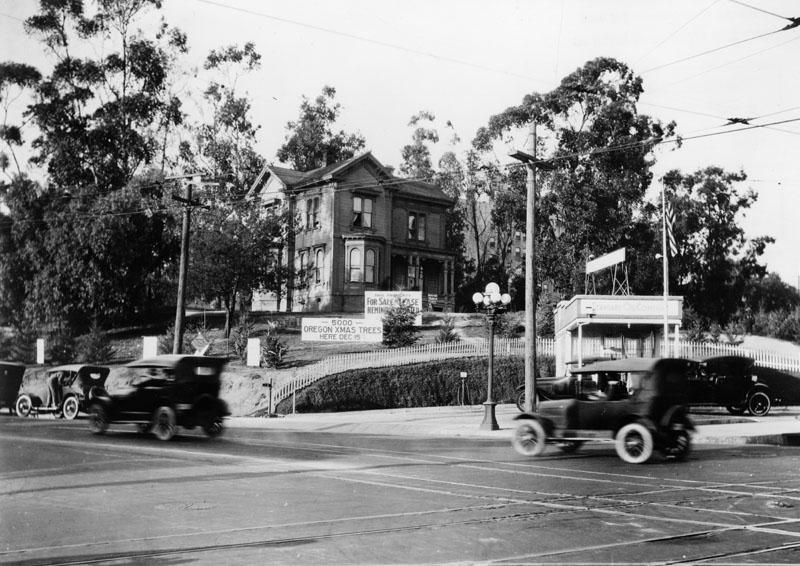 |
|
| (1919)^ - View showing a multi-globe street light on the corner of 7th Street and Figueroa Street. A small Standard Oil Company gas station is on the corner and behind it is the home of Samuel Calvert Foy, businessman and one-time LA Chief of Police, and also Foy's daughter, Mary E. Foy, the first woman to hold the position of City Librarian in 1880. |
Historical Notes Carrol Avenue in Los Angeles, a two block long street, now has an international reputation for restored Victorian homes, c.1880 - 1910. Three, four and five globe authentic fixtures taken from various locations in the City and which date from that era now grace both sides of Carrol Avenue. Click HERE to see more. |
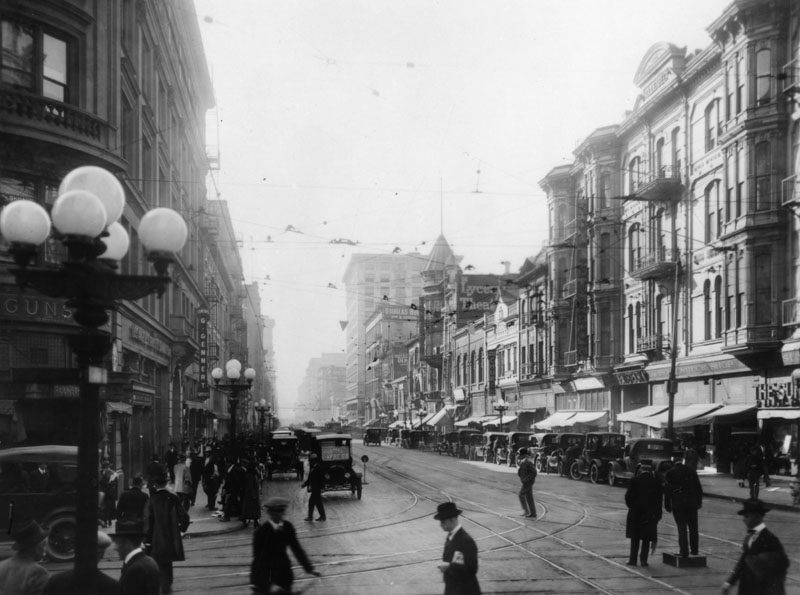 |
|
| (ca. 1920)^ - View of Spring Street looking south from 2nd Street. The 5-globe Llewellyn Electroliers can be seen on both sides of the street. |
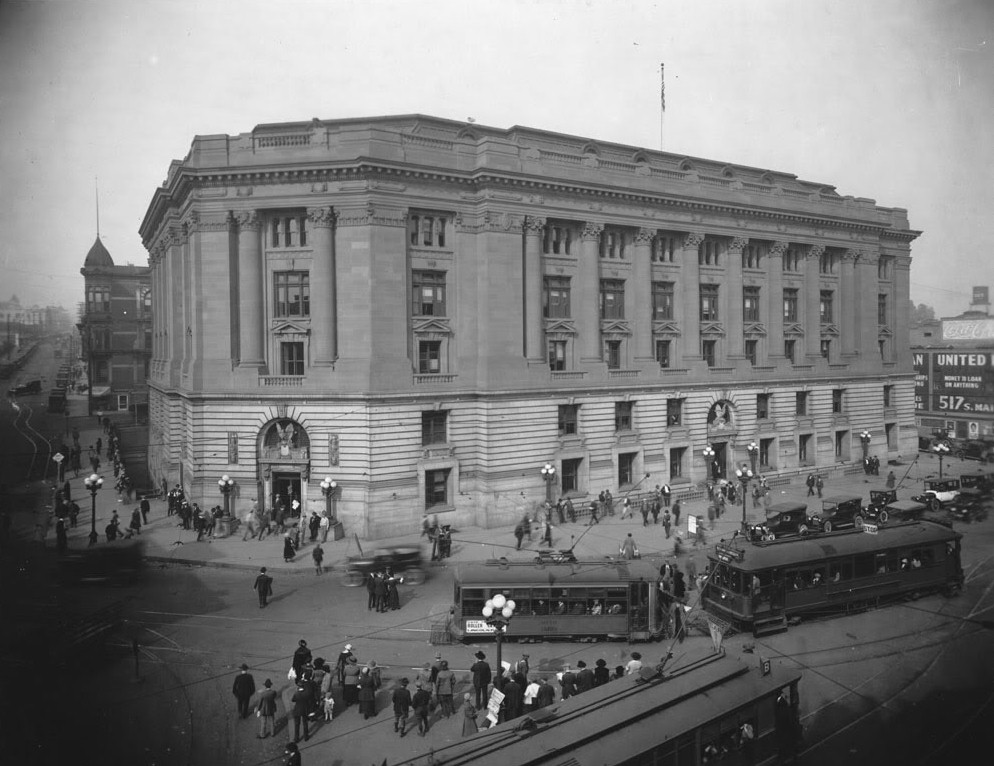 |
|
| (ca. 1920)*^ - A multitude of five-lamp ornate streetlights surround the old Federal Building and Post Office on the corner of Temple Street and Main Street. |
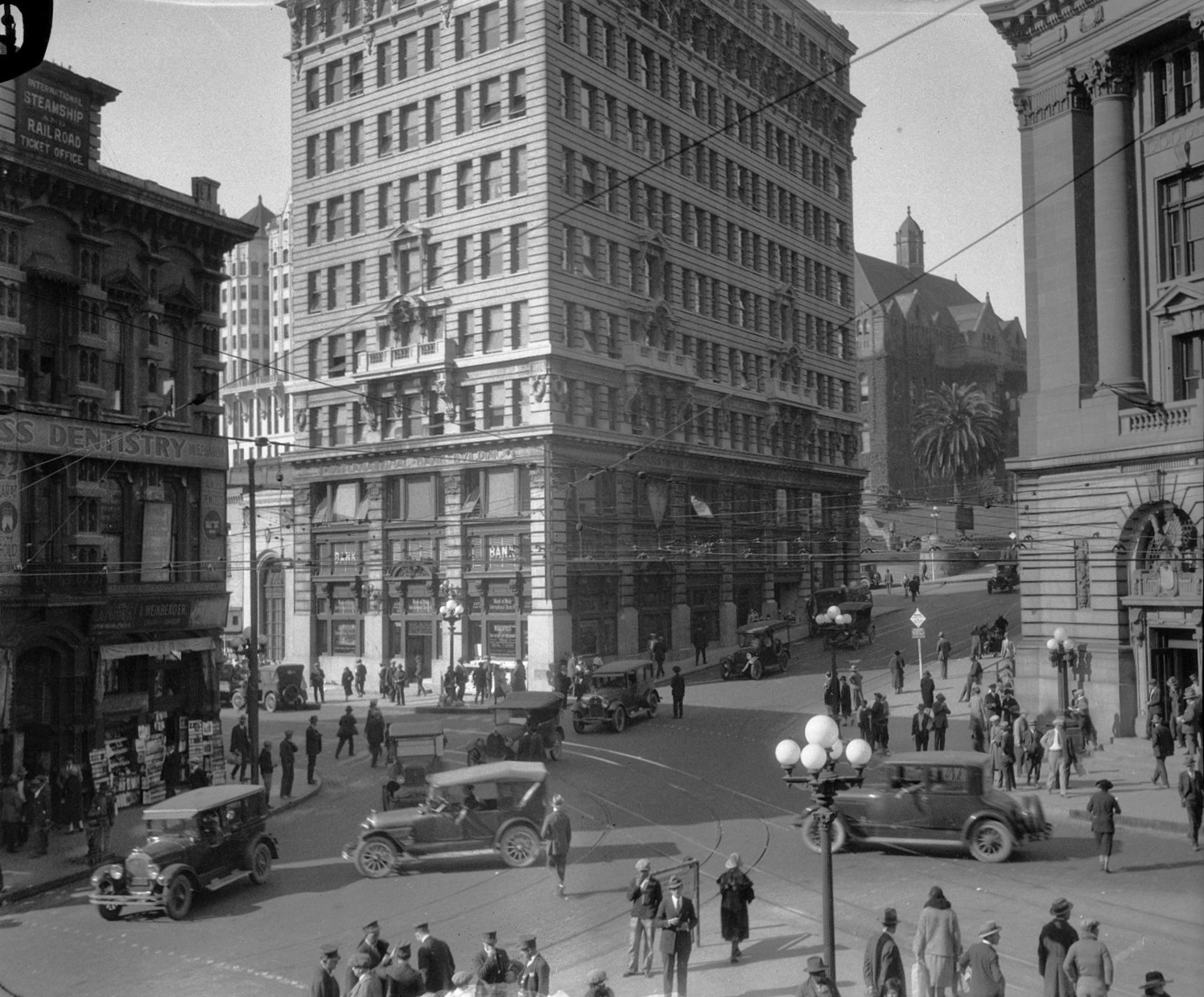 |
|
| (ca. 1924)* - The Temple Block area in Downtown with the International Bank Building at center. Note the beautiful 5-lamp ornate streetlights throughout the area. |
Historical Notes Not a single building in the above photograph survived. The building on the left is the Temple Block, the old Hall of Records is background left, then the International Bank Building, the Sandstone Courthouse on the back right, and finally the Federal Post Office on the far right. |
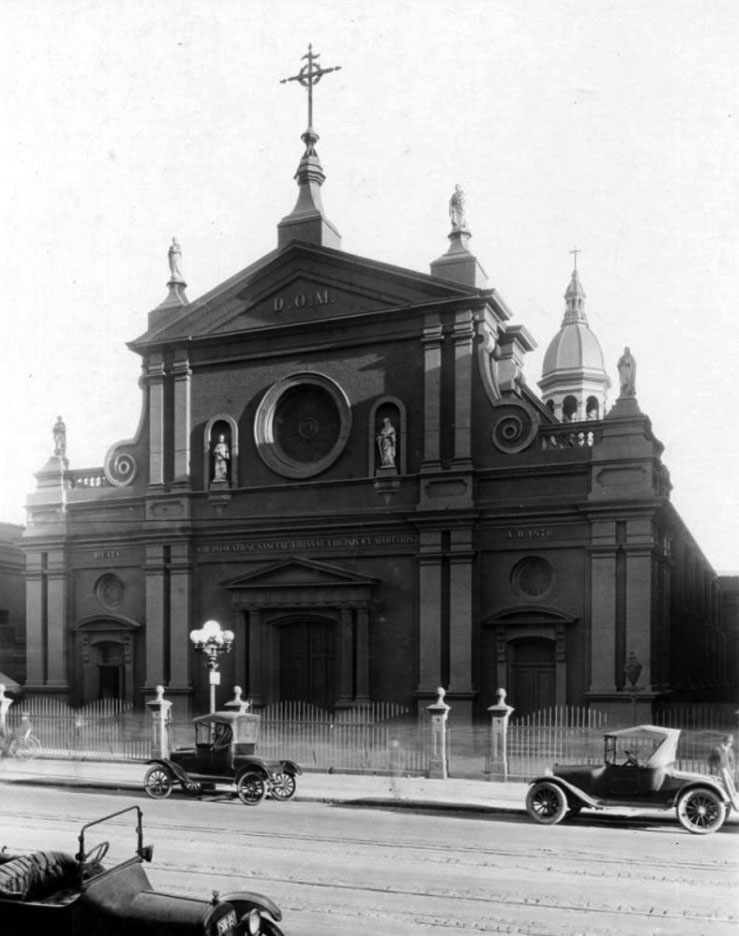 |
|
| (ca. 1920)* - The 5-globe Llewellyn Electrolier stands in front of the beautiful St. Viviana’s Cathedral near the SE corner of 2nd and Main streets. |
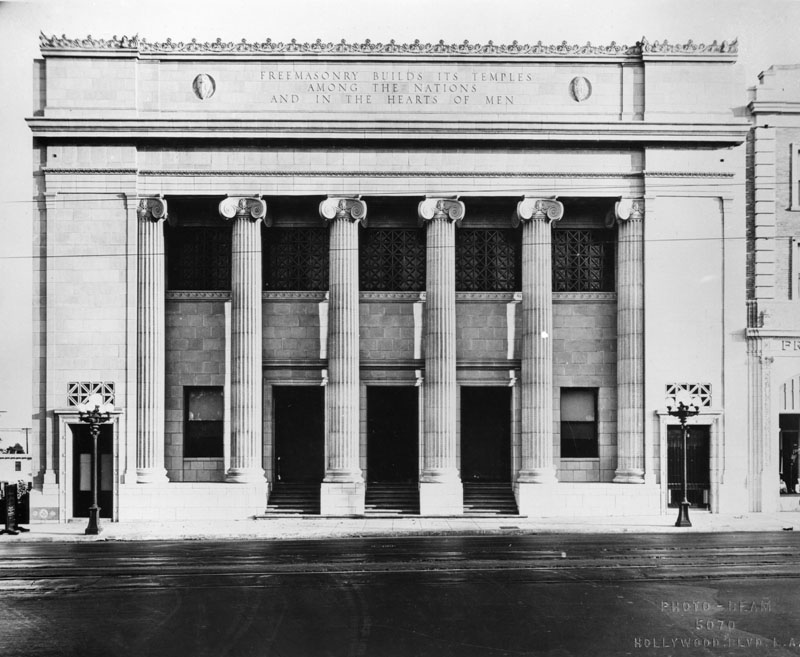 |
|
| (1922)^ - Two ornate 5-globe Llewellyn Electroliers stand guard in front of the Hollywood Masonic Temple located on the south side of Hollywood Boulevard between Highland and La Brea. |
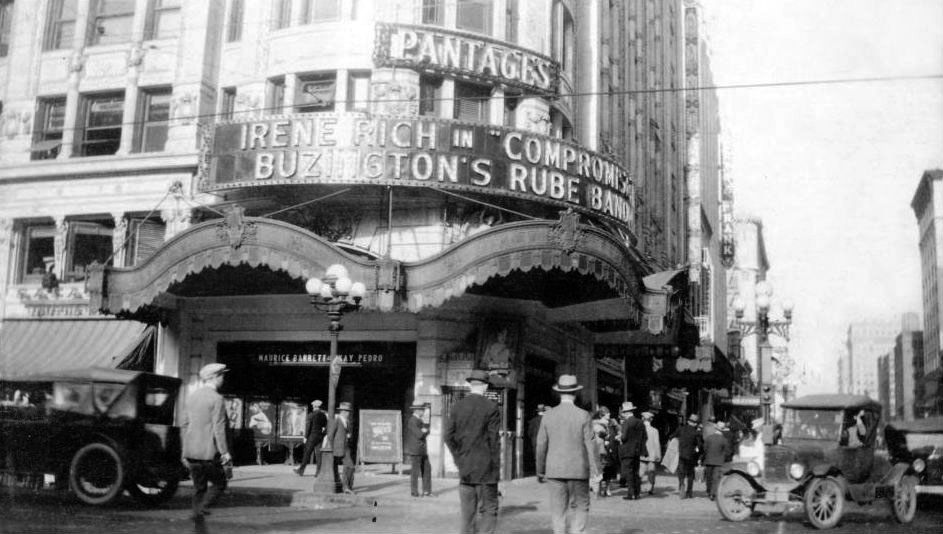 |
|
| (1925)^#* - Ornate 5-lamp streelight posts stand in front of entrance to the Pantages Theatre, NW corner of 7th and Hill streets. The curved marquee reads: Irene Rich in "Compromise" and Buzington's Rube Band. Note the more ornate 5-lamp Winslow streelight on HillStreet to the right. |
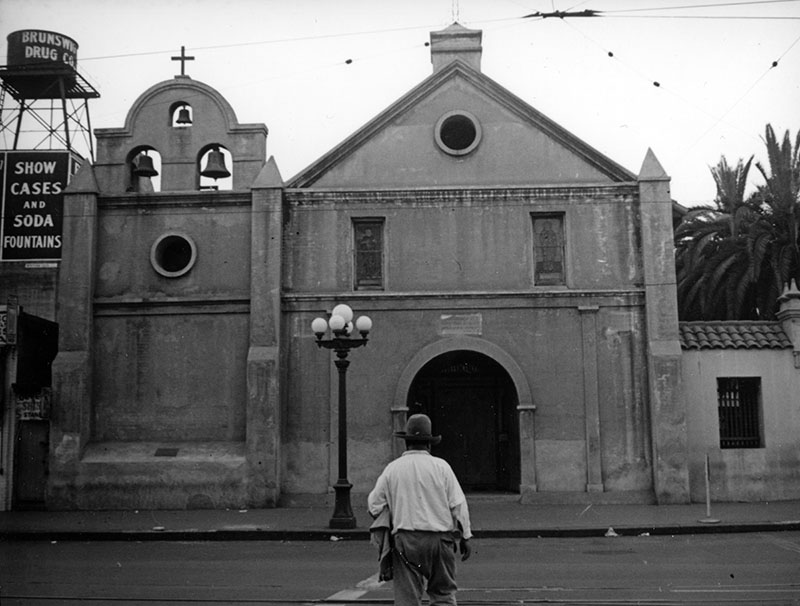 |
|
| (1930s)* - A man crosses Main Street heading toward the Old Plaza Church where a 5-lamp streelight post stands in front of the entrance. |
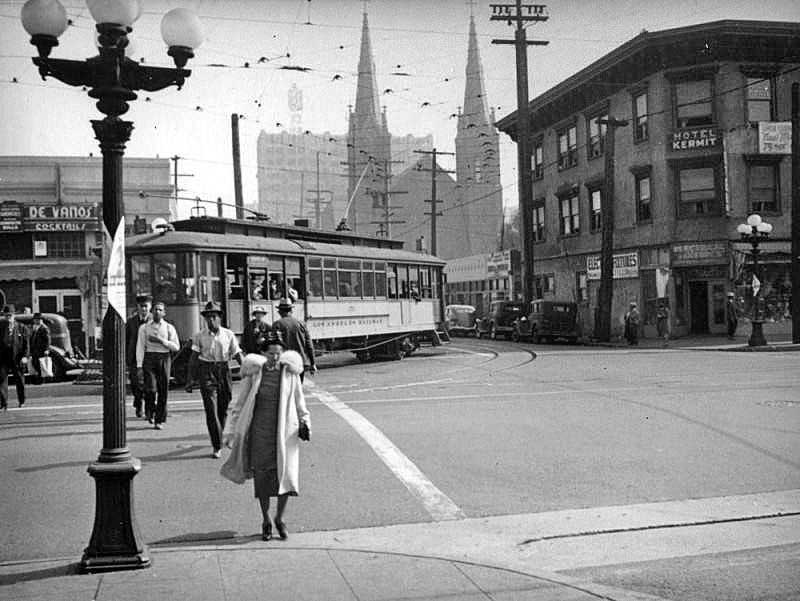 |
|
| (ca. 1937)* - A Five-Globe Standard Llewellyn Electrolier stands tall on the NW corner of Main and 12th streets. View is looking east on 12th Street showing pedestrians crossing Main with a streetcar turning north behind them. Also seen here is the Hotel Kermit (1206 1/2 South Main) and the Streamline Moderne De Vanos restaurant and cocktail on the corners. Further back in the distance can be seen the Gothic Revival St. Joseph Catholic Church and, further back, the Bendix Building with its iconic sign. |
* * * * * |
Streetlights of the San Fernando Valley
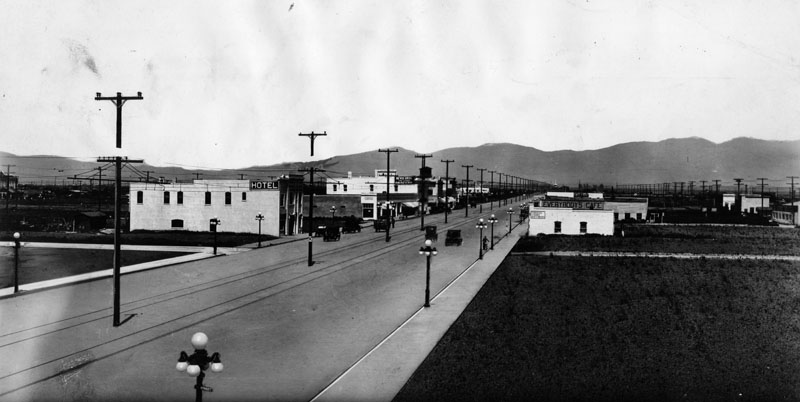 |
|
| (ca. 1912)^ - Early view of Van Nuys Boulevard (at the time known as Sherman Way), looking north. Note the ornate 5-lamp light posts along the sidewalks. These lamps were also installed in front of most of the old mansions in Downtown LA. |
Historical Notes The Van Nuys Highway Lighting District was organized August 10, 1912, under the California act providing for the highway lighting of unincorporated towns and villages and country sections. The Van Nuys District, which is 16 miles long and 8 miles wide, embraces about 52,000 acres in the southwestern part of the San Fernando Valley (at the time). The votes creating the district came from the new settlers. Sixty votes were recorded for and eighteen against. The small vote was due to the fact that the majority of people living in the tract came from other states and were not eligible to vote on account of not having been in California the required year. The first lighting undertaken by the district was along Sherman Way, the 16 mile boulevard extending thru the tract. A sum of $75,000 was recommended for this purpose, which was included in the 1912 taxes of the district, and the entire amount was raised in that year.* |
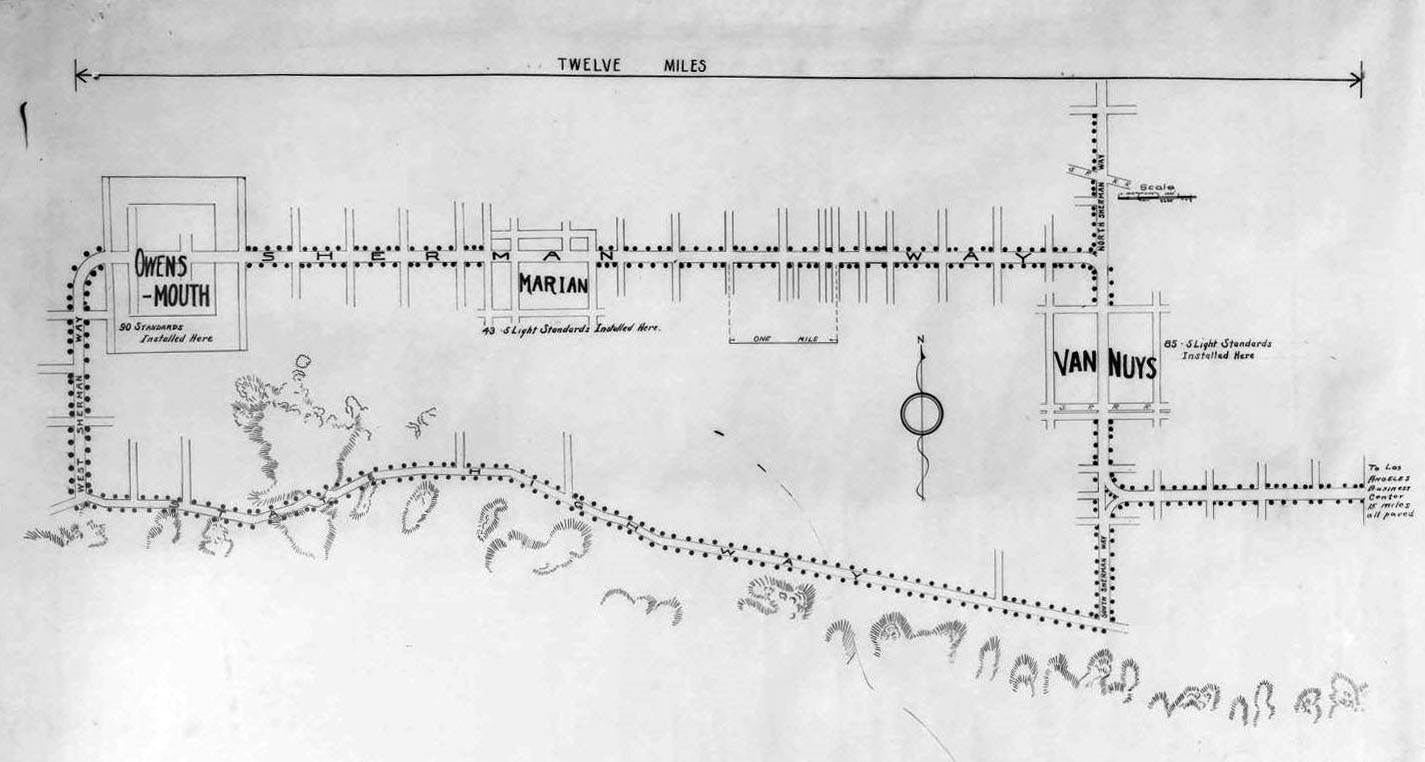 |
|
| (1913)* - Map showing the proposed streetlights for the Van Nuys/Marian/Owensmouth Lighting District. Photo courtesy of Dean Fields. |
Historical Notes This was the first Lighting District the County of Los Angeles created. When completed the lighting system had 484 three-light posts (electroliers) and 129 five-light posts (electroliers). Streetlight "Electroliers" are defined as free-standing streetlights generally on their own posts. The town of Marian became Reseda and Owensmouth is now Canoga Park. The above map shows the original route of Sherman Way, which today is west on Chandler, north on Van Nuys Blvd, and west on Sherman Way. The other sections of today's Van Nuys Blvd were known as South Sherman Way and North Sherman Way. |
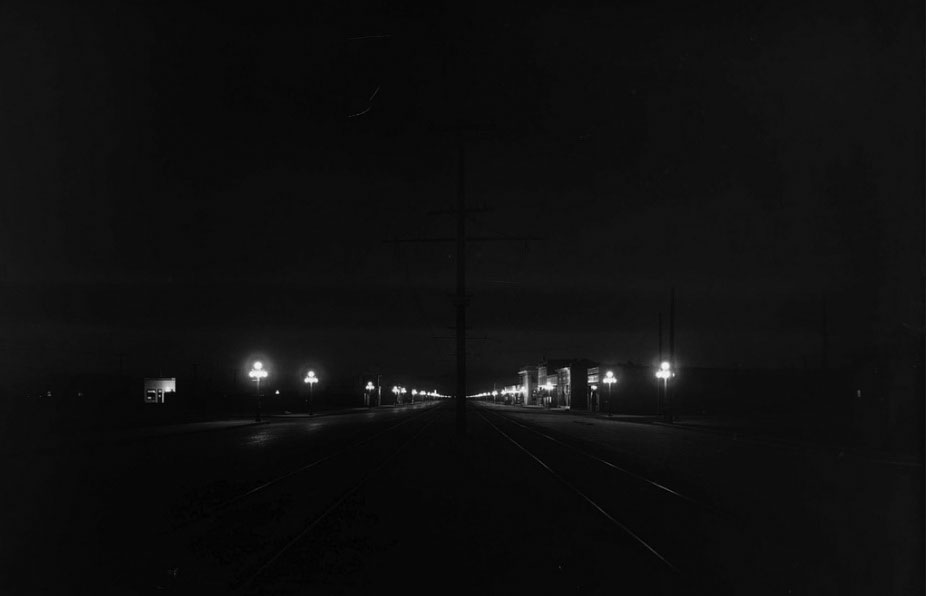 |
|
| (1913)* – Night view looking south on Sherman Way (later Van Nuys Boulevard). Two rows of 5-lamp electroliers illuminate the area showing two sets of tracks and an electrical pole line running down the commercial center of town. |
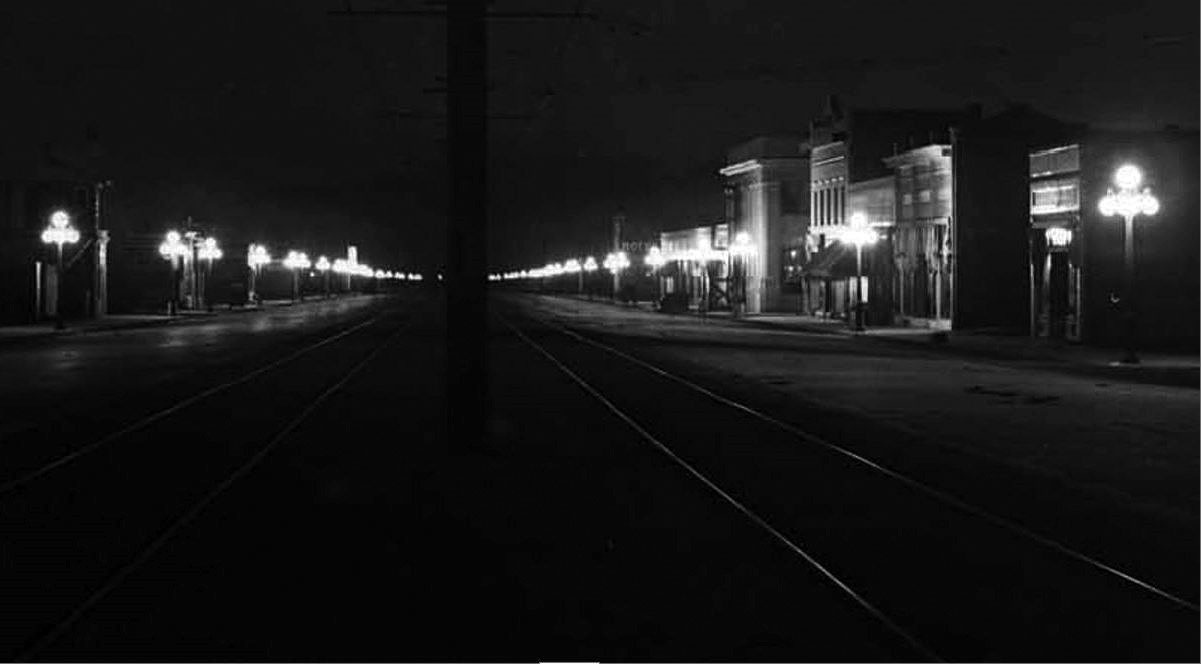 |
|
| (1913)* – Closer view of Sherman Way (later Van Nuys Boulevard) showing the multitude of 5-lamp streetlights lining both sides of the street. Also seen are streetcar tracks and and an electrical pole line running down the center of the Boulevard. This is a blow-up of the previous photo. |
.jpg) |
|
| (1913)* – Close-up detailed view showing a five light ornamental lamp. Street sign on lamp post reads: SHERMAN WAY. Sign on left reads: “Electroliers Wired & Installed by Llewellyn Iron Works”. Sign at right reads: “Private Road – Exclusively for Autos”. |
Historical Notes In the three townsites of Van Nuys, Marian, and Owensmouth, five-light clusters were used thru the main parts, four electroliers to every street intersection. On these five-light posts, one 60-watt lamp was upright and four 40-watt lamps pendant, and they were placed through the main parts of the towns, four electroliers to every street intersection.* The most common of the incandescent multiple globe electroliers of the early 1900s were those manufactured by the Llewellyn Iron Works of Los Angeles. The firm became so identified with this style of street light that any multiple globe electrolier became commonly known as a Llewellyn. The Llewellyn Iron Works, founded in 1889‐1890, was one of the largest metal working facilities in Los Angeles. It manufactured structural steel – including that for the Bradbury Building.^ |
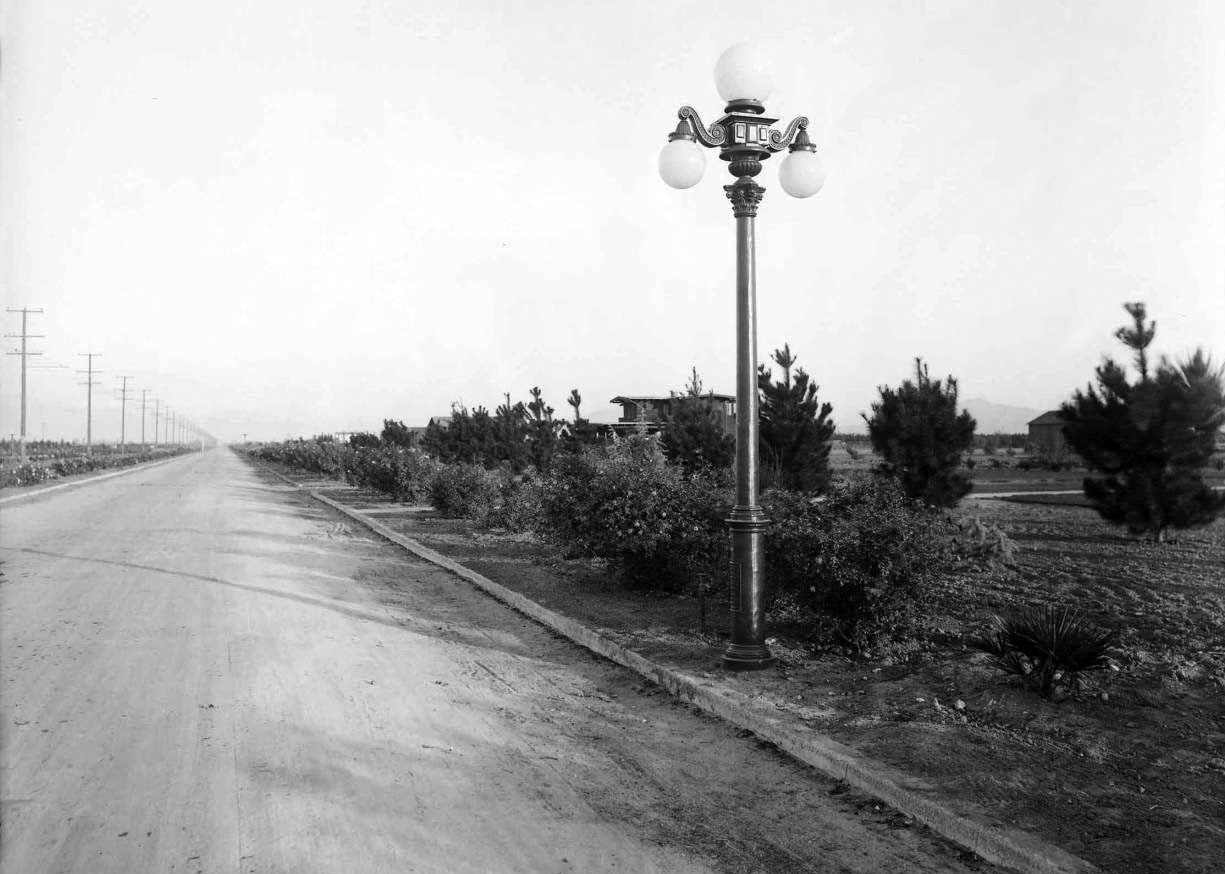 |
|
| (ca. 1913)* – View looking down on an unpaved Sherman Way showing an ornate Llewellyn Iron Works 3-lamp electrolier. |
Historical Notes Cast-iron electroliers (made by Llewellyn Iron Works of Los Angeles) were used with three-light clusters for use along the boulevard outside the townsites, one 60-watt lamp upright and two 40-watt lamps pendant. The electroliers were located 330 feet apart staggered, or 660 feet apart on each side of the boulevard, which is about 100 feet wide.* These same type of streetlight electroliers can be found today on Carroll Avenue. |
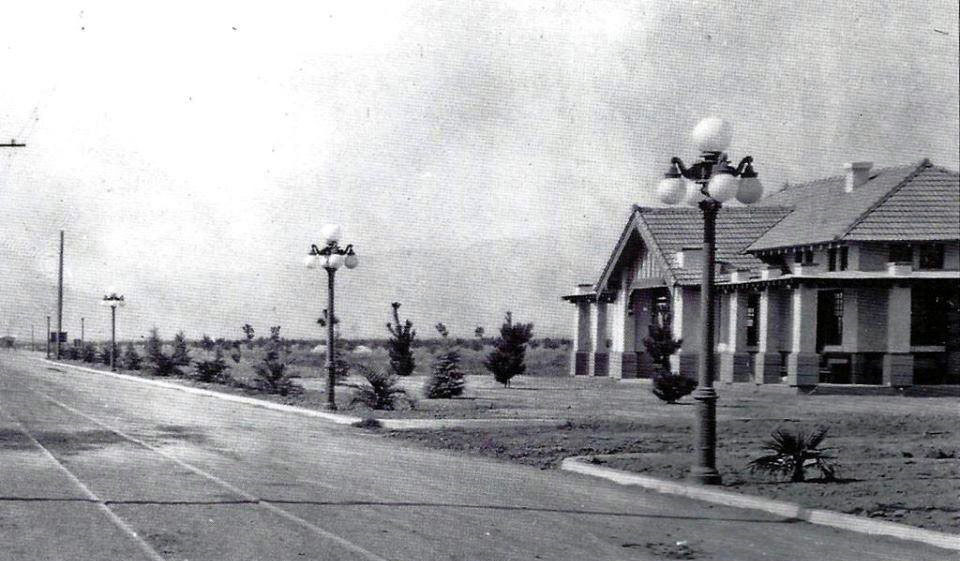 |
|
| (ca. 1913)* - View showing the Owensmouth PE station looking west along Sherman Way. Park Ave [now Vassar Ave] enters at right; behind the Simi Hills can be dimly seen. Note the five-lamp ornamental streetlights along Sherman Way. |
Historical Notes Sherman Way became the first paved boulevard across the valley. Following this was the paving of the state highway aka the Ventura Road, from the Cahuenga Pass to Newbury Park. Eventually, the road ran all the way to Ventura, and was renamed Ventura Boulevard. |
* * * * * |
Windsor Square
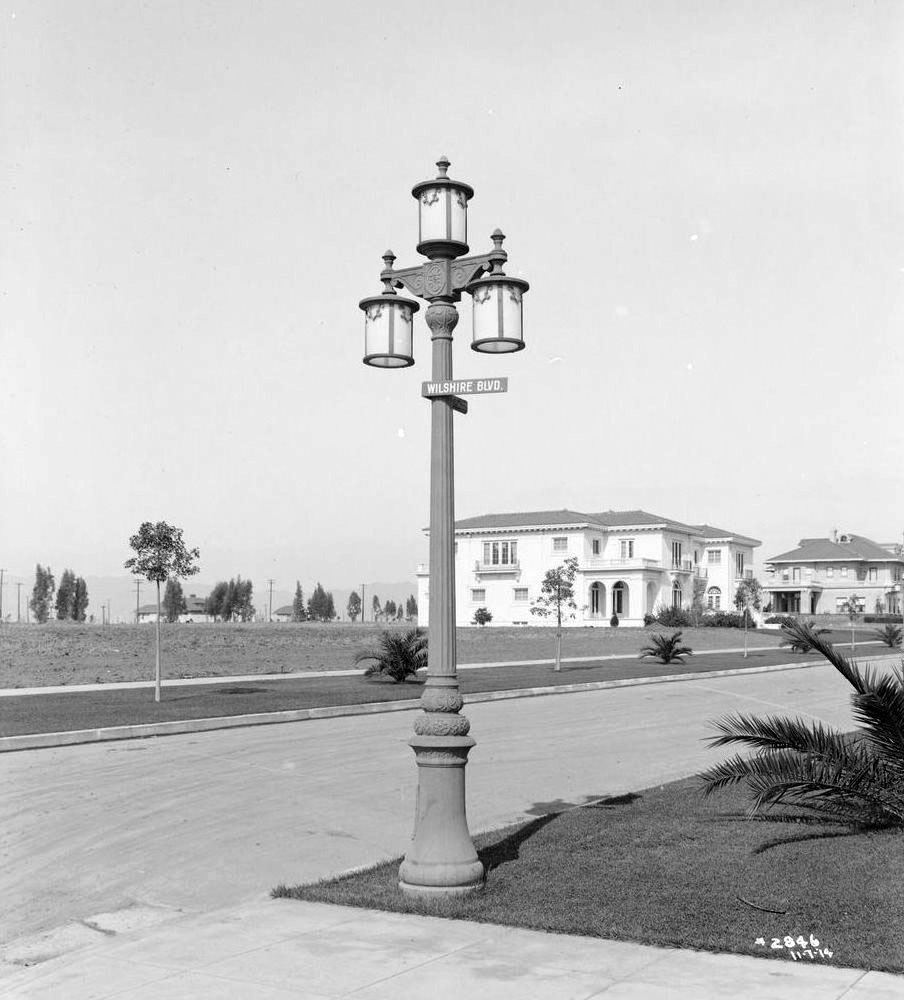 |
|
| (1914)* - View of a 3-lamp electrolier on the corner of Wilshire and Windsor boulevards. This is the west side of the 600 south block of Windsor Blvd. in Windsor Square. Both houses in the photo amazingly resemble some of the homes built today. However, the house on the left was built in 1911 and the house on the right in 1914. |
* * * * * |
Llewellyn "Chester" Lamps
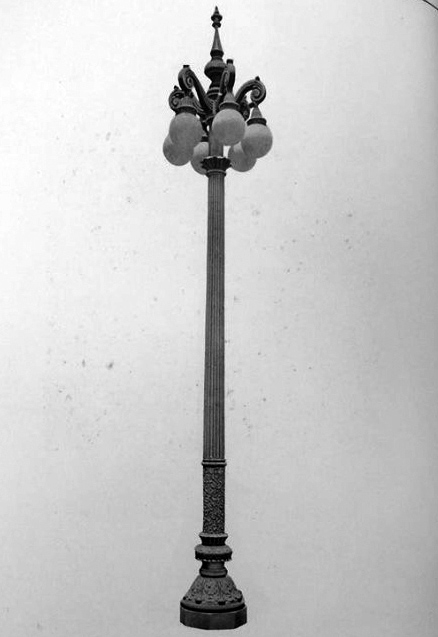 |
|
| (1928)^.^ - The "Chester" electrolier shown here in the 1928 Llewellyn Iron Works Catalog. Height: 14’ 3½”; Size of base: 18”; Largest dimension of column: 7½”. These were installed in the West Adams district. |
Historical Notes The most common of the incandescent multiple globe electroliers of the early 1900s were those manufactured by the Llewellyn Iron Works of Los Angeles. The firm became so identified with this style of street light that any multiple globe electrolier became commonly known as a Llewellyn. The Llewellyn Iron Works, founded in 1889‐1890, was one of the largest metal working facilities in Los Angeles. It manufactured structural steel – including that for the Bradbury Building.^ |
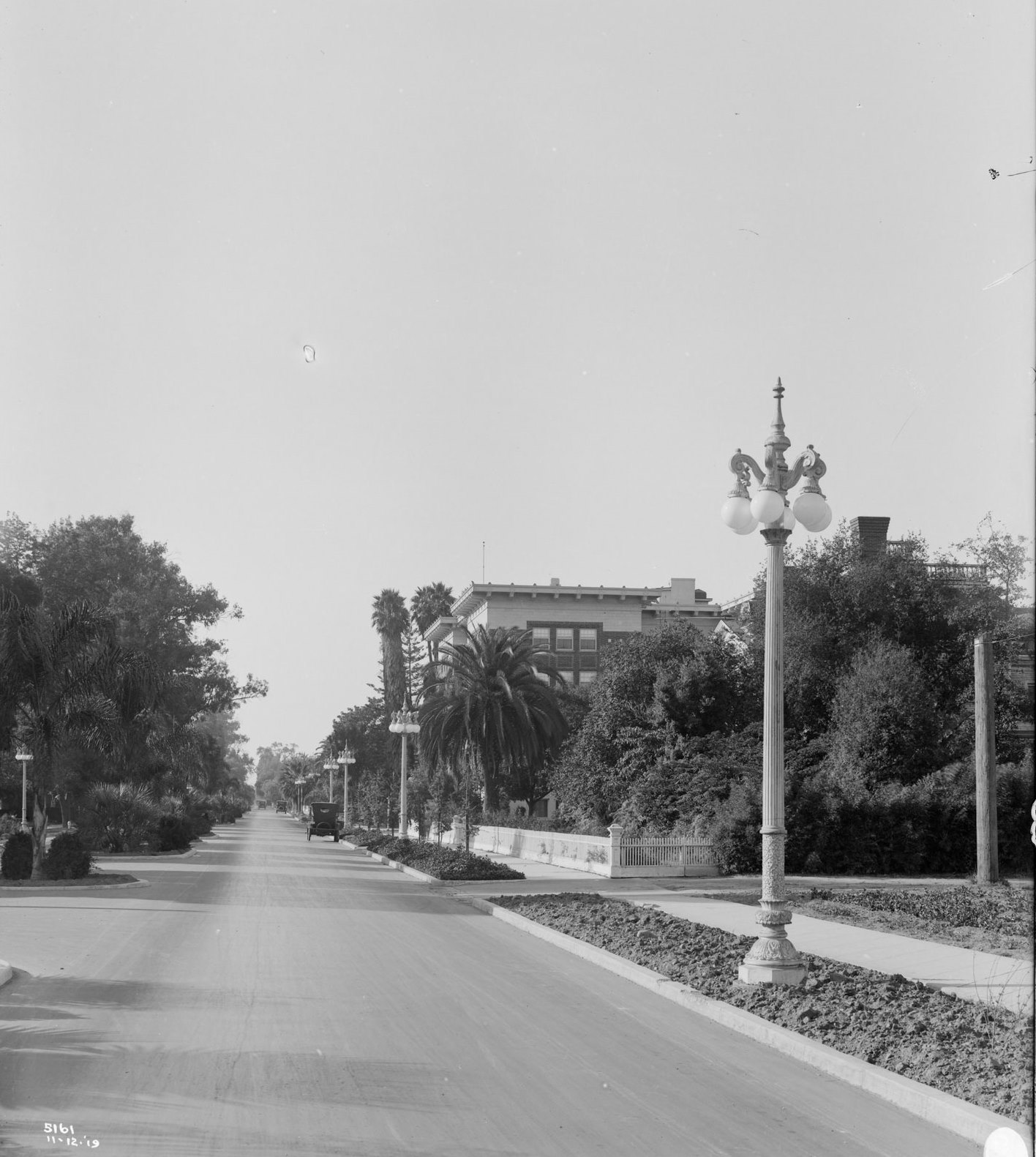 |
|
| (1919)^^* - View of Adams Street in 1919 showing inverted six-globe 'Chester' lighting posts along the parkway. |
Historical Notes Called Llewellyn “Chester” lamps, these six-globe streetlights were installed in the West Adams district beginning in 1903 (Named for Chester Place, one of the first gated communities in Los Angeles). |
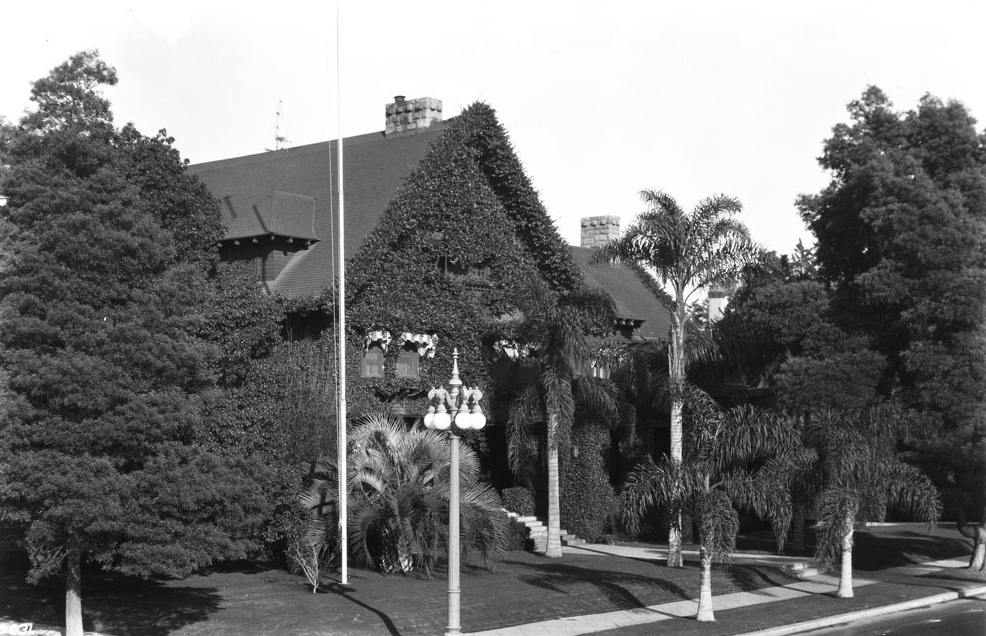 |
|
| (ca. 1924)*^ - A close-up view showing one of the six-globe 'Chester' electroliers in front of a Craftsman three story home on Adams Street, west of Figueroa Street. |
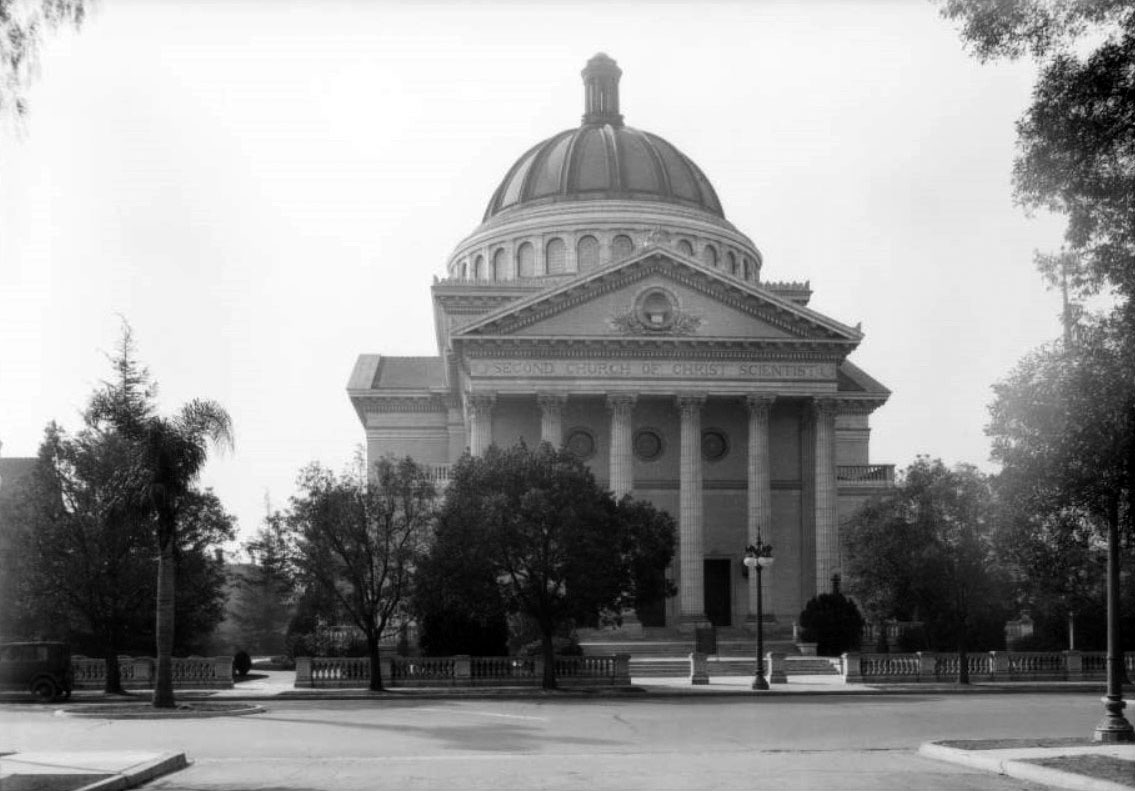 |
|
| (ca. 1928)*^ - View looking south on Portland Street toward Adams Boulevard. A six-globe streetlight stands in front of The Second Church of Christ Scientist (today the Art of Living Foundation) at 946 W. Adams Blvd. |
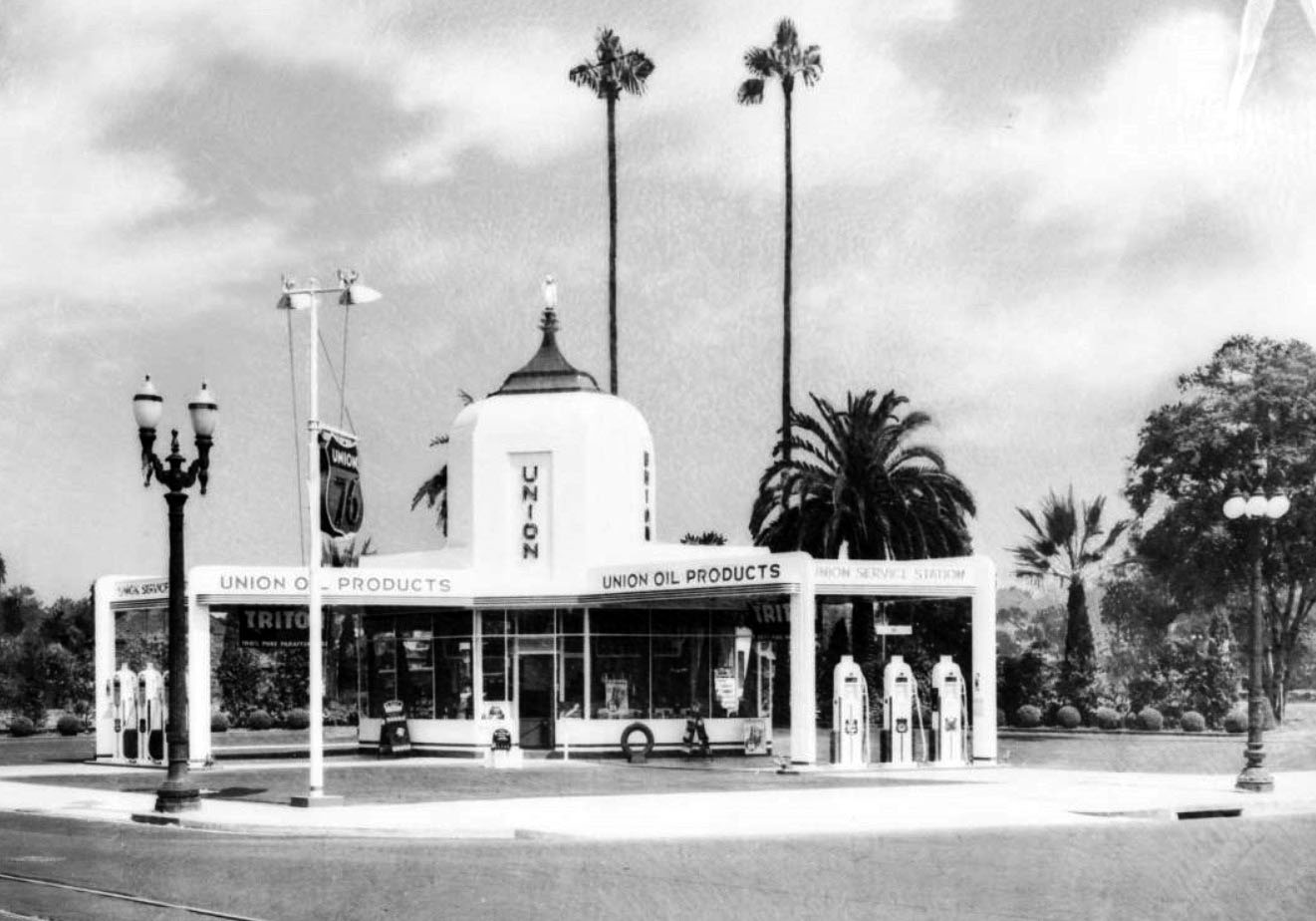 |
|
| (1935)*^ - Two different style streetlights stand at the corner of West Adams Boulevard and Hoover Street, with an Art-Deco Union 76 station in the background. Click HERE to see more Early LA Gas Stations. |
Historical Notes The "Chesters" can still be found along Chester Place, now a private street bisecting the campus of Mount St. Mary's College. But only the tops of the survivors match the catalog image seen in previous photo. The shafts and bases are different. |
* * * * * |
Early Street Lights - Bureau of Power and Light
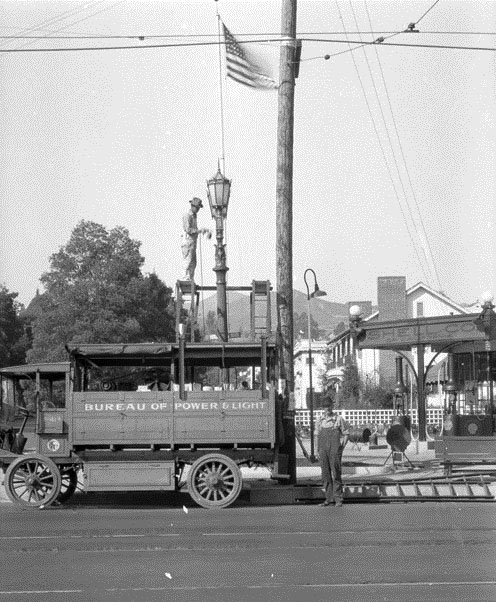 |
|
| (Early 1920s)* - Bureau of Power and Light crew working on an ornamental street light. |
LADWP Historical Archive (1973) Despite the variety of designs, street lights are known as either electrolier or utilitarian types, according to Harvard Johnson, engineer in charge of Street Light Design. Customers own the electroliers --- lamps affixed to concrete or metal posts. The customer-owners of these are most likely the Department of Public Works or residents who form a private street lighting district. |
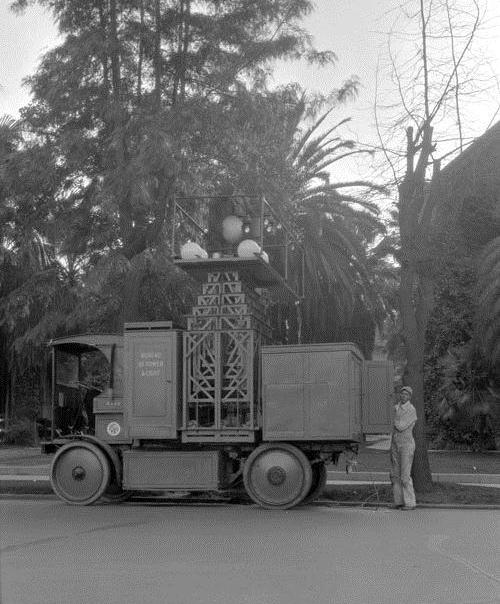 |
|
| (Early 1920s)* - An electric powered street light truck used by the Bureau of Power and Light in the 1920s. |
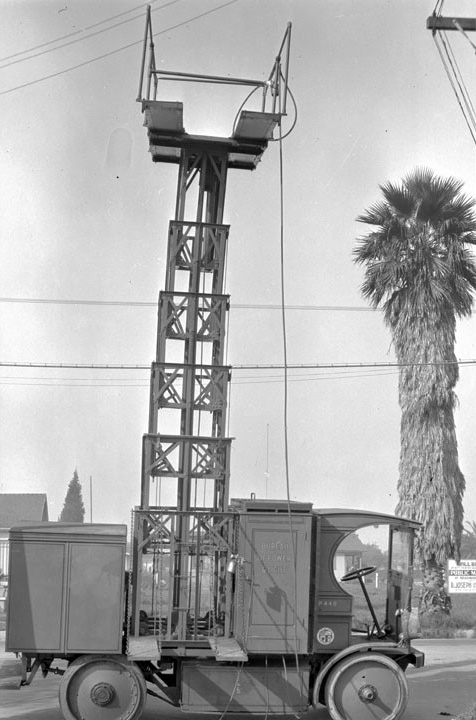 |
(Early 1920s)* - Electric-powered street light truck with platform fully extended.
|
Dual-lamp UM (Union Metal) 1906 Electroliers
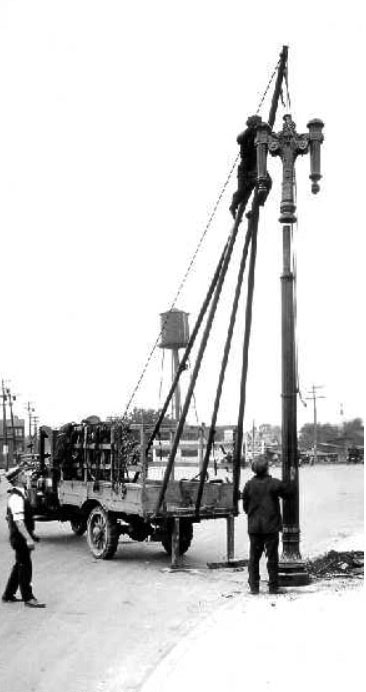 |
(1920s)^^ - A worker is perched at the end of a crane while installing a new two-lamp UM (Union Metal) 1906 streetlight assembly as two men watch below. |
Historical Notes Replacing the five-globe Llewellyn in Downtown Los Angeles and extending outward along several major streets, hundreds of dual-lamp electroliers (UM 1906's) were installed in the mid 1920's. The UM-1906 was manufactured by the Union Metal Company of Canton, Ohio. The company was founded in 1906 to produce ornamental porch columns and pergolas. By 1909 it began marketing ornamental street lighting, with its first major catalog of electroliers issued in 1915. Union Metal eventually supplied more than 4400 towns and cities with street lights. The UM-1906 is currently offered by the Bureau of Street Lighting as an option for roadway street lighting.* One of the most significant variations of the UM-1906 dual-lamp streetlight was the UM-2502, which contained an extended center pole from which trolley wires could be suspended. Click HERE to see more. |
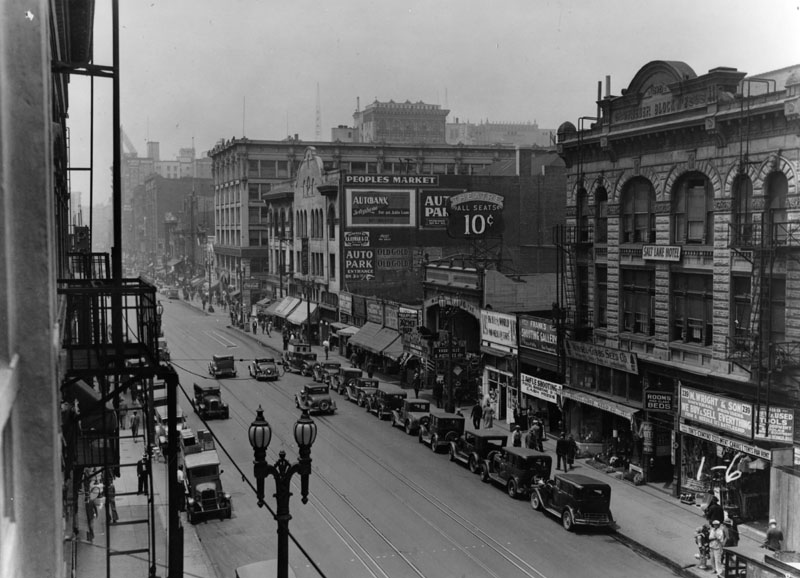 |
|
| (ca. 1920s)* - A dual-lamp UM-1906 electrolier is seen in the foreground on Spring St. between 2nd and 3rd Streets. |
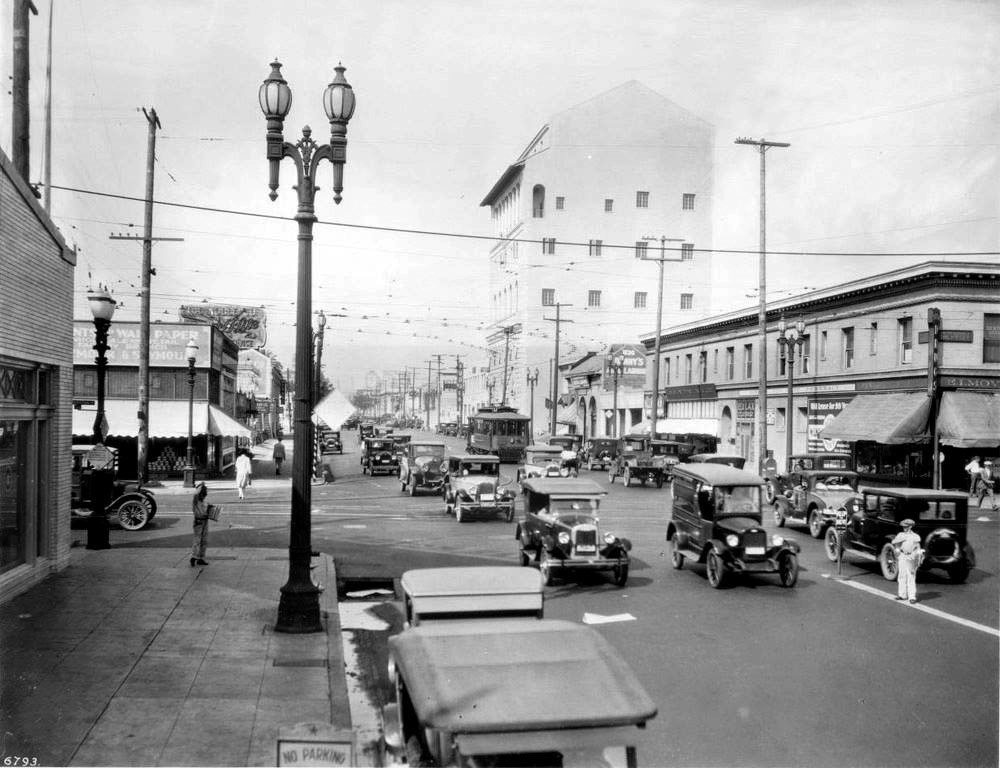 |
|
| (ca. 1927)*^ - View looking north on Figueroa from just south of Washington Boulevard. A paperboy dressed in light-colored clothing stands at the center of the street to the right hawking papers while cars pass him on either side. A dual-lamp UM-1906 electrolier stands in the foreground. The tall building in the background is the Patriotic Hall. |
Historical Notes Many of these dual-lamp UM-1906's still exist today in select areas of Downtown L.A., although most are refurbished. Click HERE to see contemporary views of dual-lamp 1906's. |
Broadway Special
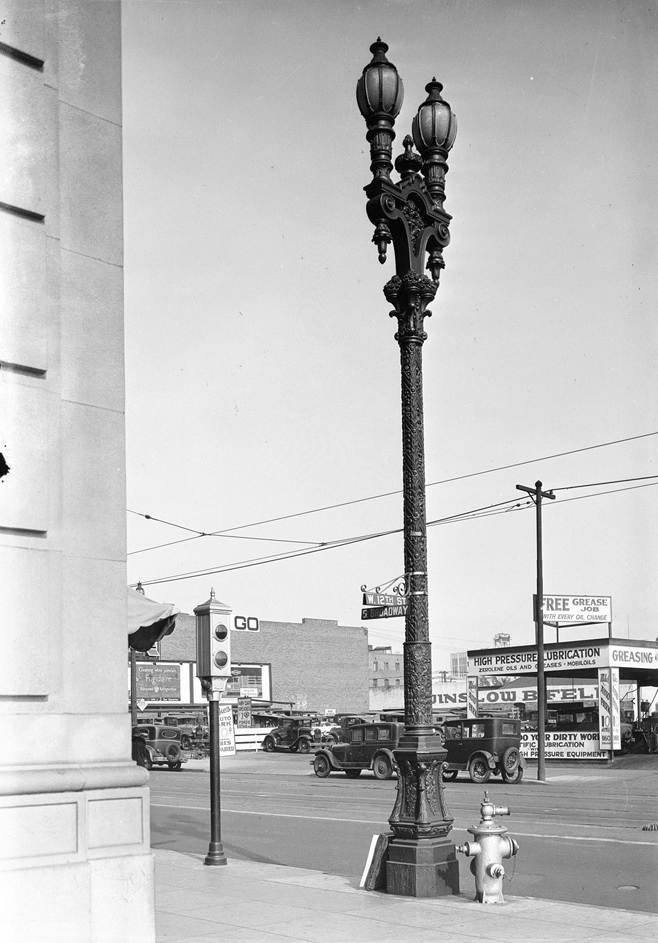 |
|
| (ca. 1920s)*^ - A two-lamp Keystone electrolier ('Broadway Special') stands on the corner of West 12th Street and South Broadway with an early traffic signal (Acme Semaphore), with sign reading "Go", to its left. Adjacent to the ornate streetlight base stands a fire hydrant. |
Historical Notes To get cars and commerce moving through the downtown business district, Los Angeles installed its first automated traffic signals in October 1920 at five locations on Broadway. These early signals, manufactured by the Acme Traffic Signal Co., paired “Stop” and “Go” semaphore arms with small red and green lights. Bells played the role of today’s amber or yellow lights, ringing when the flags changed—a process that took five seconds. By 1923 the city had installed 31 Acme traffic control devices.* |
Broadway Rose and Broadway Special
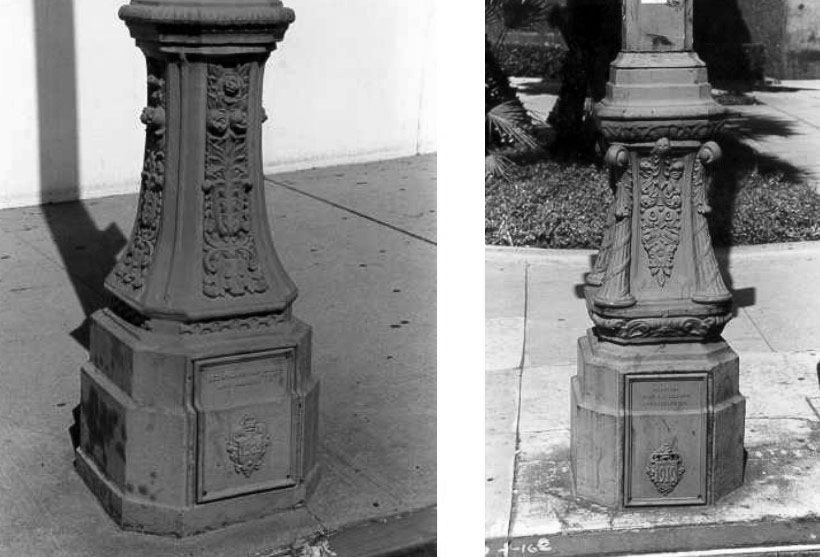 |
|
| (n.d.)^^ - There were two distinctive pole bases used on Broadway in 1920 through 1930, one ornamental with rosebuds known as the 'Rose' (left photo) another adorned with a cypress leaf and other known filigree known as the 'Broadway Special' (right photo). |
Historical Notes Manufactured by Keystone Iron & Steel Works of Los Angeles, the "Roses" were found mid-block, and the "Specials" were at the intersections. When the shafts and luminaires were changed in 1948, the bases of both designs were left in place. But, because the "Specials" were at the intersections, they were the most vulnerable to updates to the traffic light and intersection improvements. So, all the "Special" bases eventually vanished, while the "Rose" bases are still quite plentiful. |
Broadway Roses
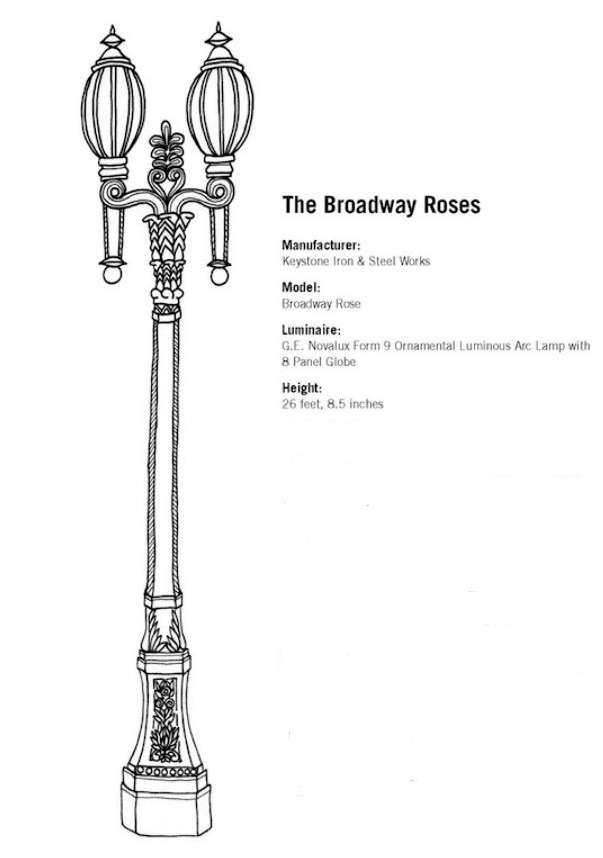 |
|
| (n.d.)^.^ - Sketch showing the Broadway Rose with specifications. Drawing by Didi Beck |
Historical Notes Marked by three ornate ribbons of roses climbing up their safts, the eponymous Broadway Roses, designed by a General Electric engineer and originally installed in 1919, used to extend from Aliso Street to Pico Boulevard. Given that Broadway was the first L.A. street to have ornamental lights, hailed in the papers as “the radiant way,” this lamp’s lavish design should come as no surprise. (In fact, the Roses originally shared Broadway with an even grander, more filigreed type of post—the Spanish Renaissance-inspired Broadway Special, designed by the same engineer.) The response was overwhelming: “This is one of the most elaborate jobs of ornamental electroliers ever made on the coast,” the Los Angeles Times observed, “and is a 100 percent home product.” Unfortunately, the excitement didn’t last. During the 1950s, the shafts and luminaires of the Broadway Roses were replaced with more functional, higher intensity, yet decidedly more somber CD-913 overheads, leaving only the original bases intact. Today there are only a handful of complete models remaining in Los Angeles, which can be found running down Sixth Street between Olvie and Flower Streets. The Broadway Specials, incidentally, have vanished altogether.* |
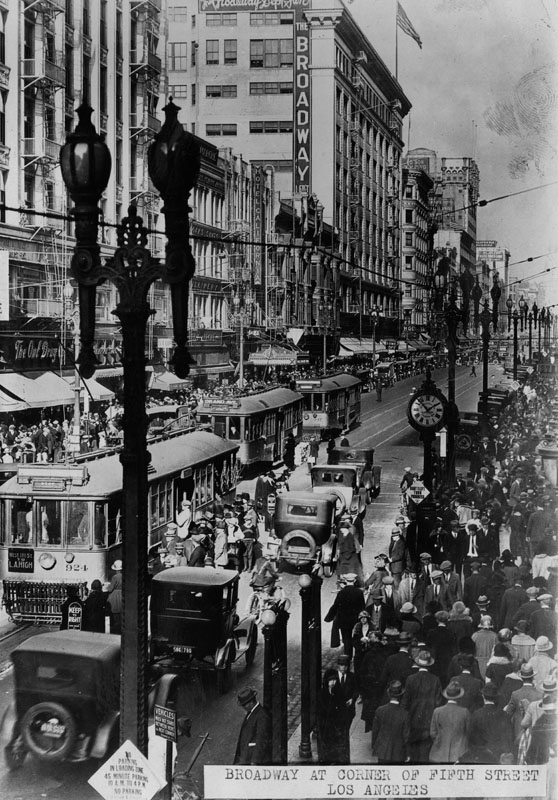 |
|
| (ca. 1920s)* - A busy scene with pedestrians and city traffic in this view of Broadway and 5th looking north, showing, as far as the eye can see, the new two-lamp electroliers nicknamed "Broadway Roses"(left) and "Broadway Specials". The "Roses" were found mid-block, and the "Specials" were at the intersections. |
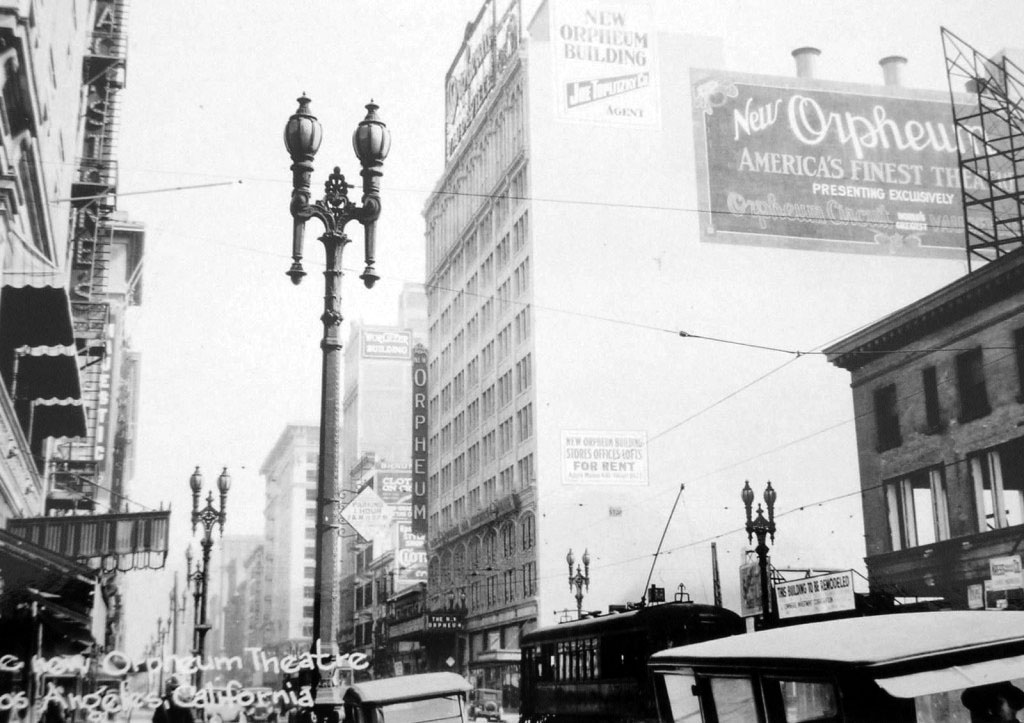 |
|
| (ca. 1926)^^* – View looking north on Broadway showing dual-lamp Broadway Roses lining both sides of the street. The Orpheum Building is seen on the east side of Boradway with a sign on its side that reads: ‘New Orpheum – America’s Finest Theatre – Presenting Exclusively – Orpheum Circuit Vaudeville’ |
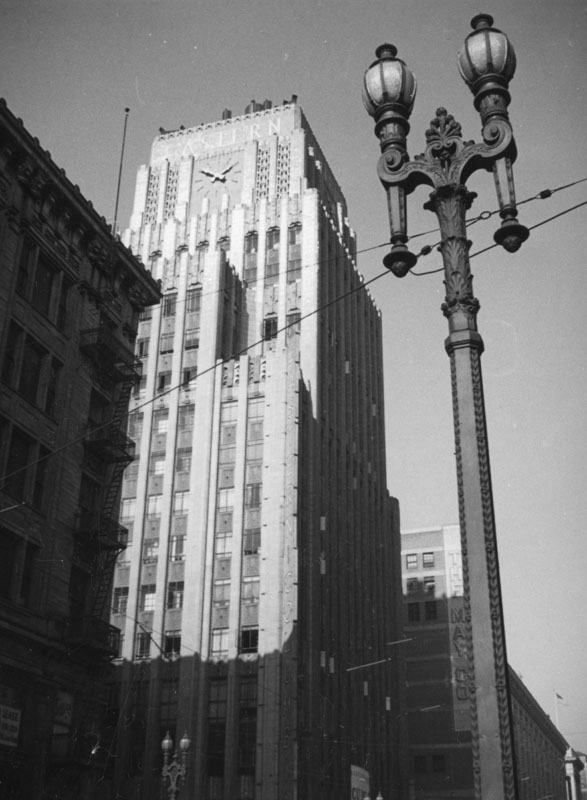 |
|
| (1937)^ - Detailed close-up view of a dual lamp Broadway Rose located near 9th and Broadway. In the background is the sunlit Eastern Columbia Building (849 South Broadway) and further down the block the May Company (800 South Hill Street). |
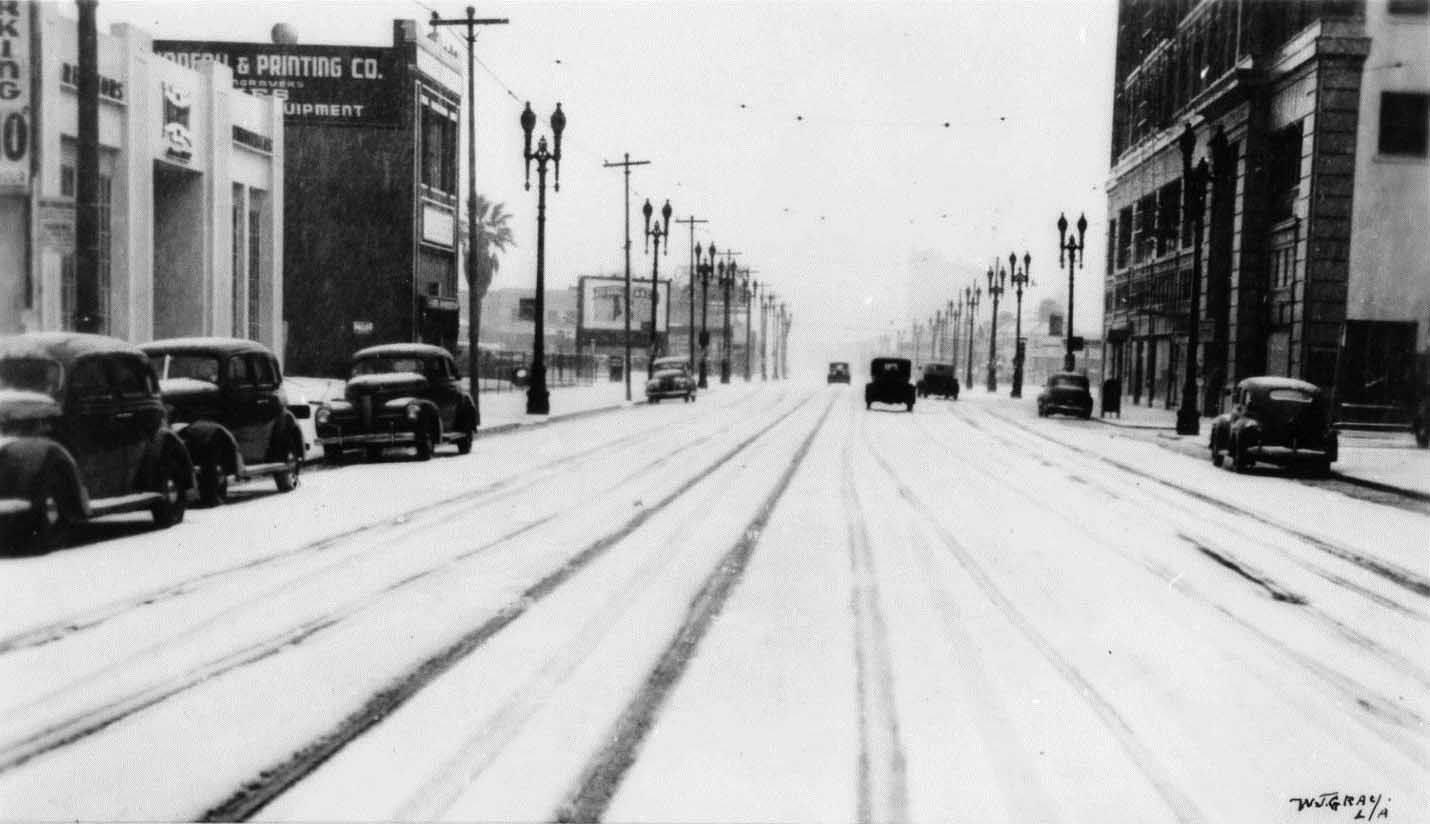 |
|
| (1944)* - Snow in DTLA! Looking south on Broadway from 12th Street after a snow storm. The Chamber of Commerce Building is seen on the right (demolished in 1968, today Public Works building). Note the beautiful dual-lamp Broadway Roses running up and down both sides of Broadway. |
Broadway Specials
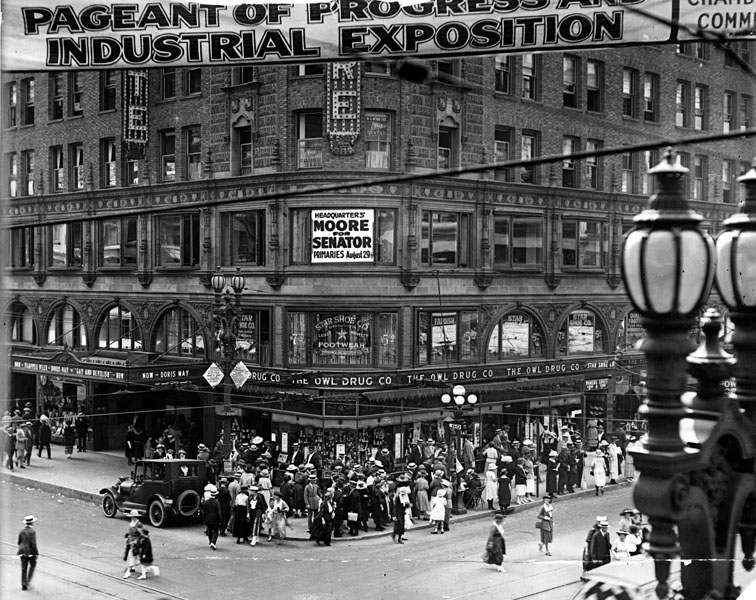 |
|
| 1922)* - View of the Loew's State Theatre building located at the intersection of Broadway and 7th Streets. On the right is a close-up view of the dual-lamp Broadway Special that was so prevalent on Broadway in downtown LA starting in the 1920s. |
Historical Notes The 'Specials' were placed at the intersections of Broadway, while the 'Roses' were located at mid-block. |
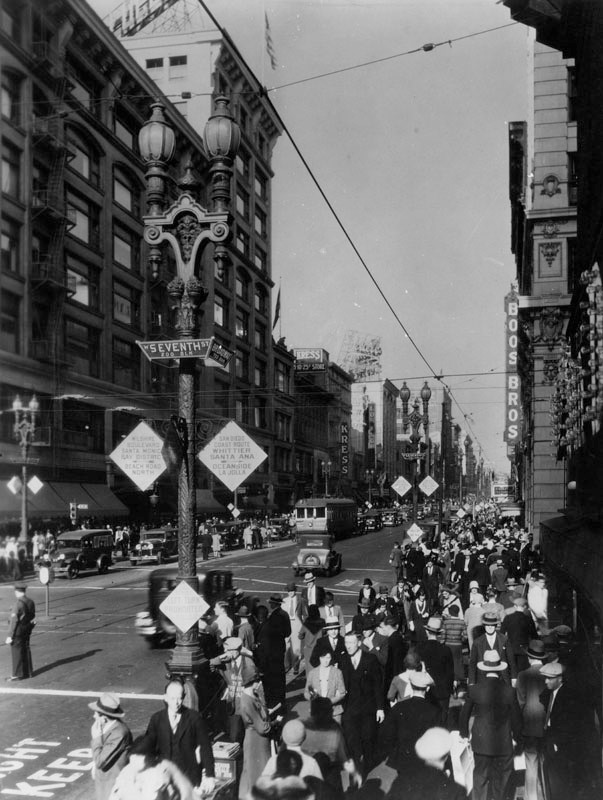 |
|
| (1926)* - View showing a 'Broadway Special' standing tall (26.5 feet) on the SE corner of 7th and Broadway, with hundreds of people walk by. |
Historical Notes The new Spanish Renaissance-inspired “Broadway Specials” and their efflorescent siblings, the “Broadway Roses,” were praised by the Journal of Electricity as “a new note in street lighting.” The Los Angeles Times hailed the installation as “one of the most elaborate jobs of ornamental electroliers ever made on the coast.” The Broadway Specials no longer exist, but the Broadway Roses still light up West Sixth Street between Olive and Flower Streets.* |
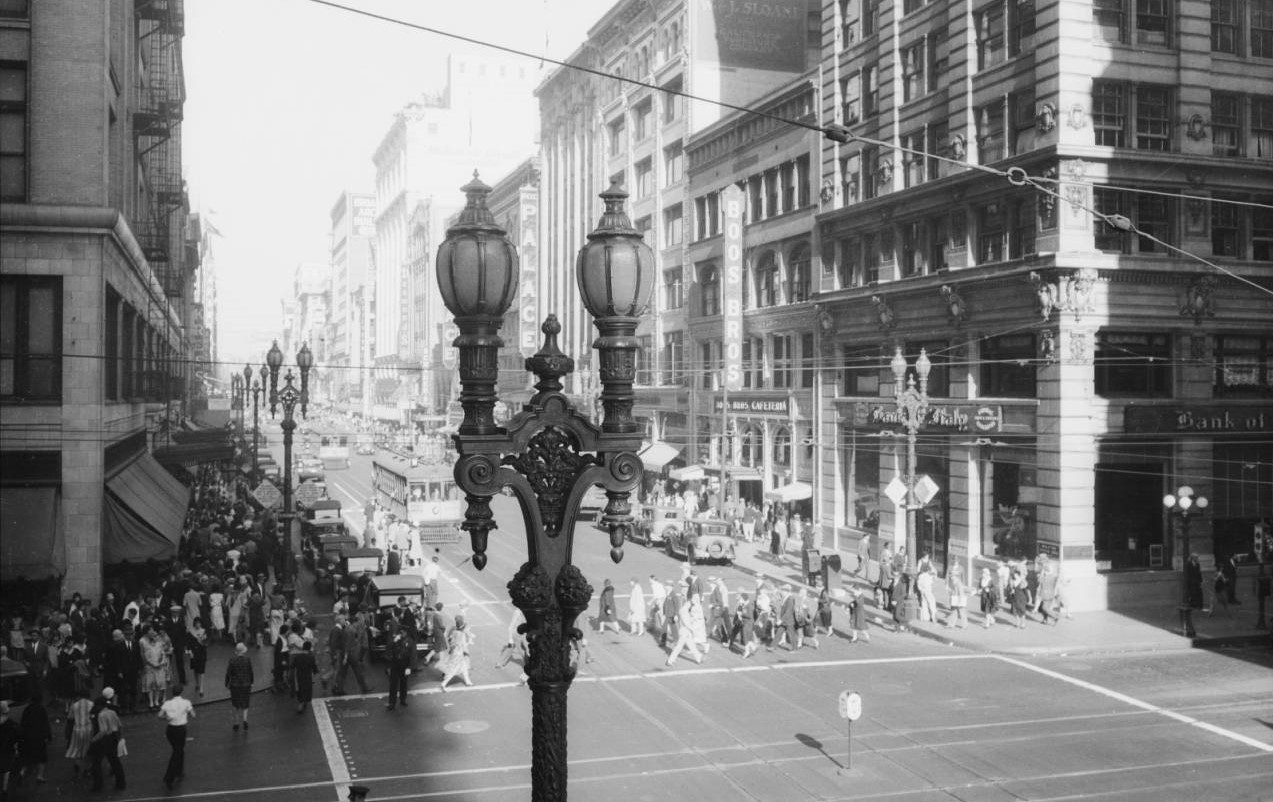 |
|
| (1930)*^ – Close-up view of a dual-lamp 'Broadway Special' on the southwest corner of Broadway and 7th Street. These electroliers are seen running up and down both sides of Broadway, with the 'Specials' at the intersections and the 'Roses' in mid-block. |
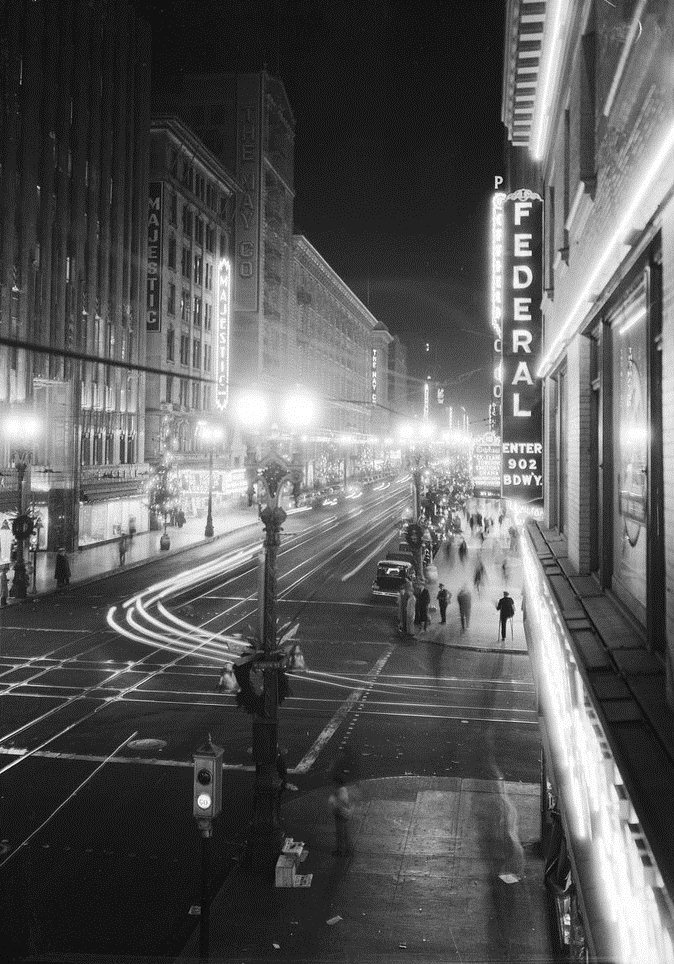 |
|
| (ca. 1938)*^ - Nightime view of Ninth Street and Broadway showing Cristmas decorations hanging from the dual-lamp Broadway Specials and Broadway Roses. Note the Semaphore Traffic Signal in the foreground. |
Historical Notes Los Angeles installed its first automated traffic signals in October 1920 at five locations on Broadway. These early signals, manufactured by the Acme Traffic Signal Co., paired "Stop" and "Go" semaphore arms with small red and green lights. Bells played the role of today's amber or yellow lights, ringing when the flags changed—a process that took five seconds. By 1923 the city had installed 31 Acme traffic control devices. ^* |
* * * * * |
Llewellyn 'Broadway' Dual-lamp Electrolier
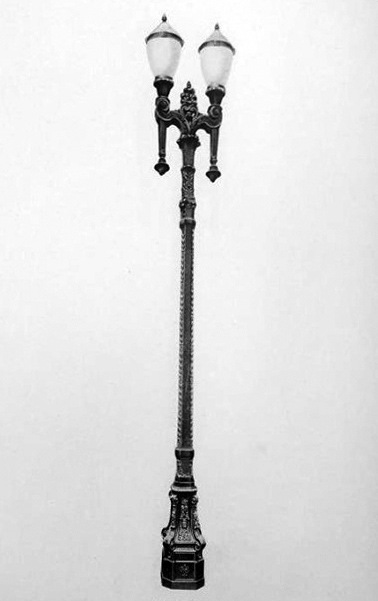 |
|
| (1928)^.^ – The “Broadway” two-lamp streetlight as seen in the Llewellyn Catalog. Similar to the dual-lamp streelight manufactured by Keystone Iron & Steel Works. It had the top of a "Broadway Rose" with a base similar to "Broadway Special." |
Historical Notes Llewellyn's 'Broadway' dual-lamp streetlight was last seen on 5th Street in downtown Los Angeles (see next photo). |
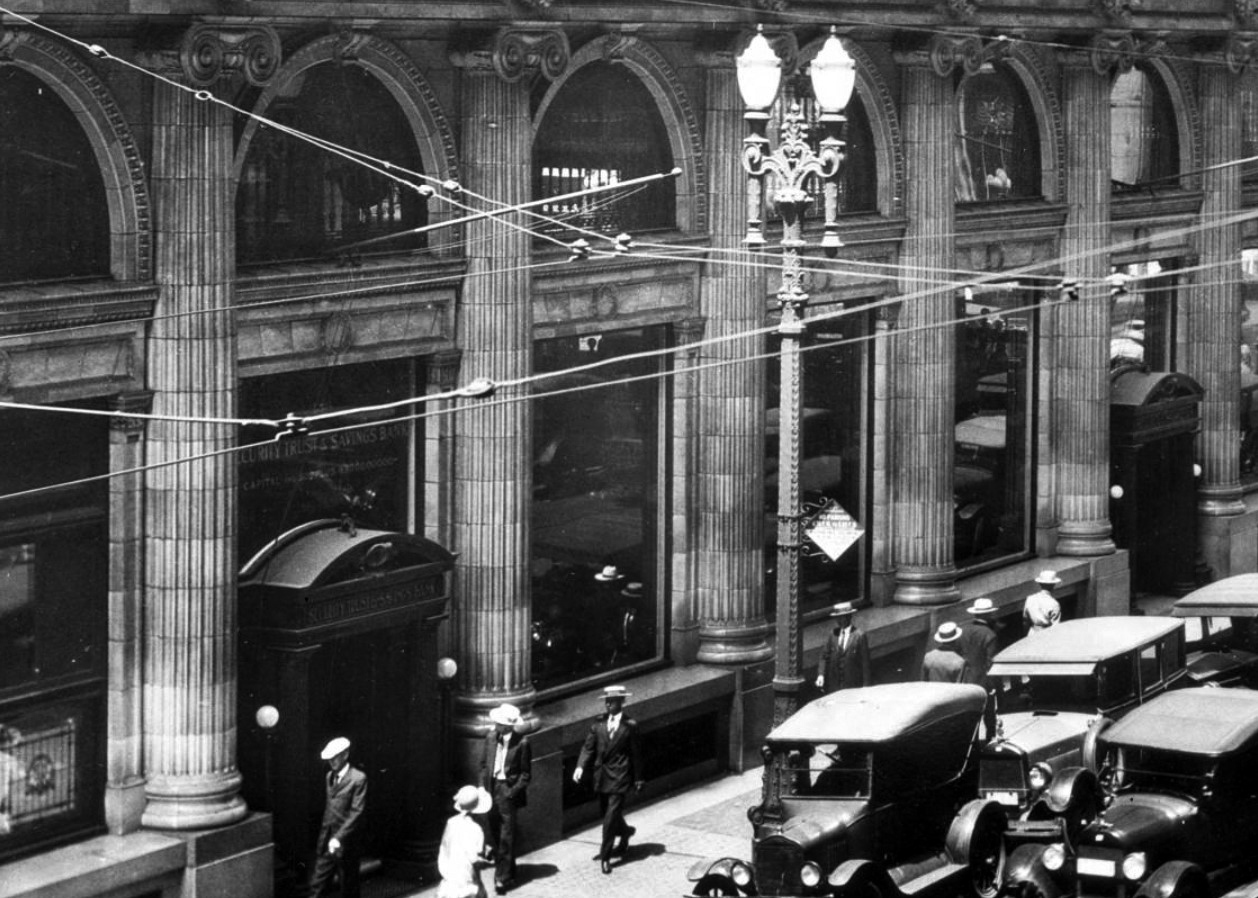 |
|
| (1924)^^ – An ornate two-lamp Llewellyn 'Broadway' streetlight stands near the front entrance to the Security Building located on the SE corner of Spring and 5th streets in Downtown LA. This electrolier resembled the 'Broadway Rose' except for two things: 1) the lamp design was different and 2) it wasn’t located on Broadway. |
* * * * * |
Bridge Lighting
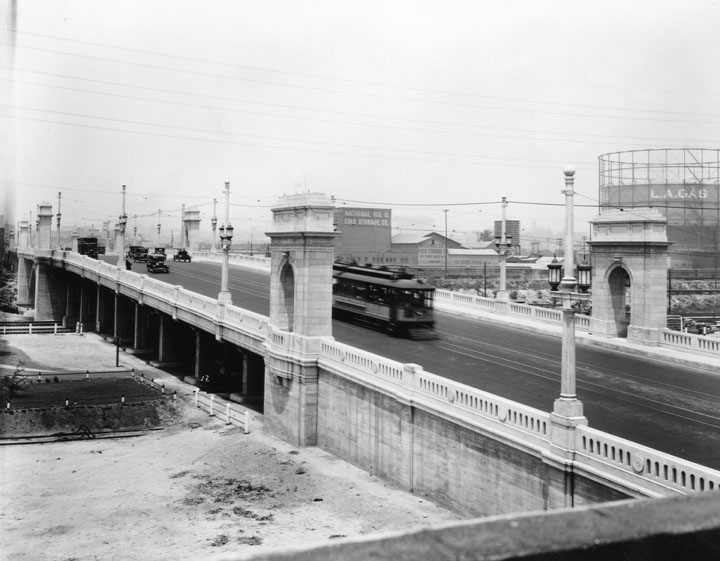 |
|
| (1920s)* - The 1st St. Bridge as viewed from across the street. A trolley and several cars can be seen driving across the bridge. Note the ornate streetlight design that consists of a three-prong configuration with the center bulb taking on a different shape than that of other two. |
Historical Notes Special ornamentation was common on bridges constructed between 1900 - 1928. These poles serve two purposes: 1) to hold the decorative streetlight lanterns and 2) to support the overhead for the Los Angeles Railway (LARy) streetcars that used the bridge. |
.jpg) |
|
| (1930s)^ - Looking up at the 1st Street Bridge showing the hybrid type streetlights along its siding. Note the trolley wire connected to the post just below the top lamp. |
Historical Notes See More Bridge Lighting (College Street Bridge; First Street Bridge; Fourth Street Viaduct; Fourth and Lorena Streets Bridge; Glendale-Hyperion Bridge; Macy Street Bridge; Mulholland Bridge; Sixth Street Bridge; Washington Blvd Bridge) |
* * * * * |
Downtown
.jpg) |
|
| (ca. 1923)*^ – View looking at the northeast corner of Hill and 12th streets showing the back side of the Examiner Building. An ornate 5-bulb streetlight stands on the corner with a line of billboards behind it. |
Historical Notes This five-globe streetlights were originally installed on all streets in Downtown Los Angeles in the early 1900s, (except for Broadway which had the seven-globe lights). Today, the last of these poles are still being used as architectural features in the gardens and malls adjacent to City Hall. |
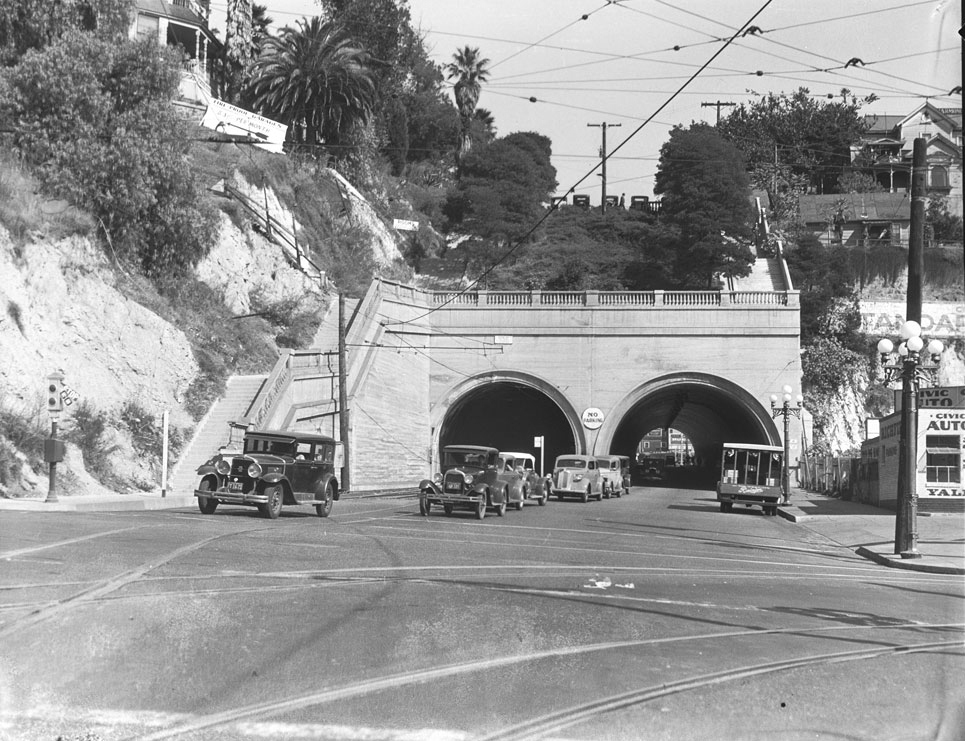 |
|
| (ca. 1923)*^ - Hill Street and 1st looking north toward the Hill Street Tunnel. Ornate 5-lamp electroliers appear on the east side of the Hill Street. |
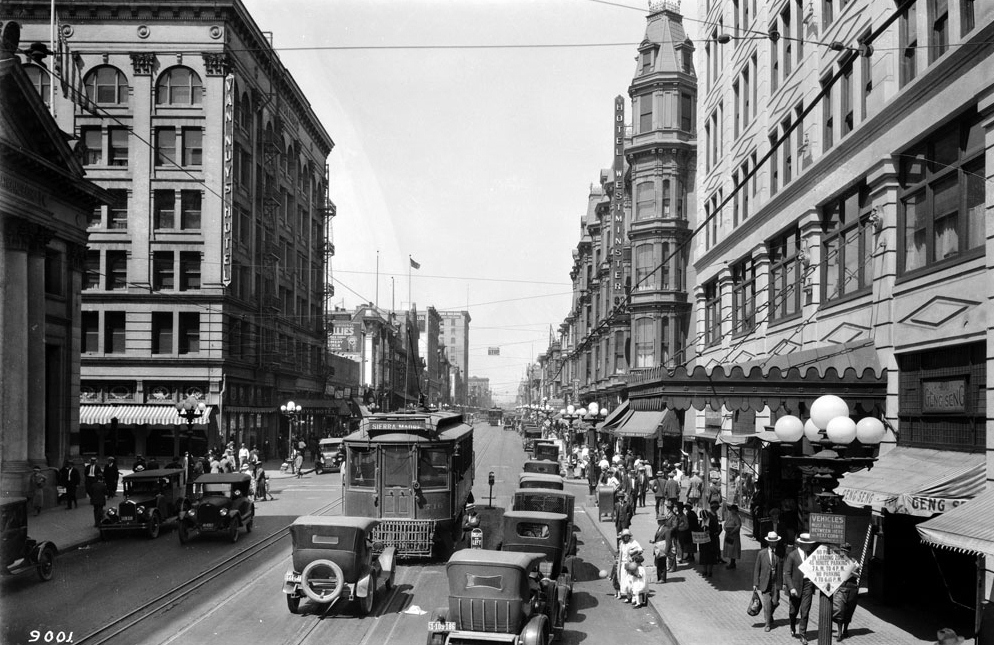 |
|
| (ca. 1924)*^ - Decorative 5-bulb streetlight lamps can be seen running down both sides of Main Street near 4th. |
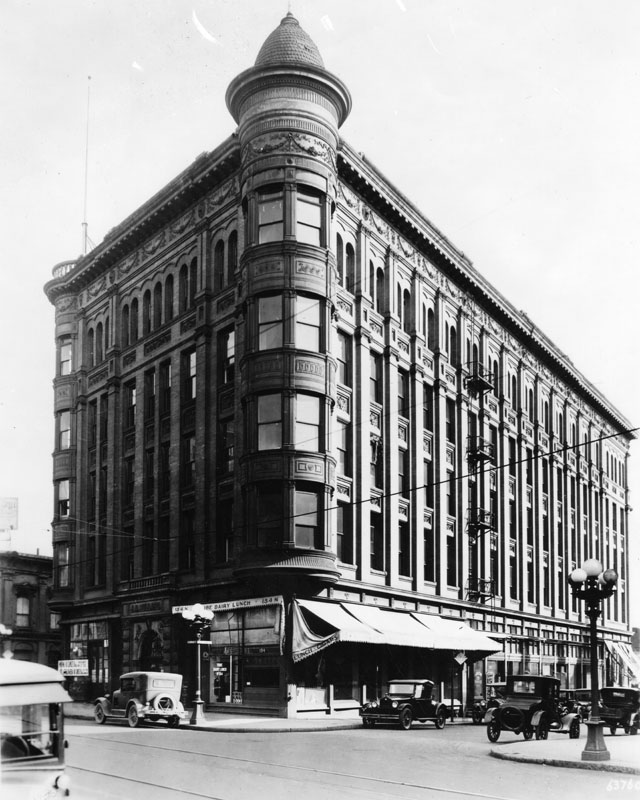 |
|
| (ca. 1925)^ - Exterior view of the Bullard Block located on the northeast corner of Spring and Court streets. At one time the building housed the courthouse. Note the ornate 5-bulb lamps on the corners. This will be the location of the current 1928-built City Hall. |
* * * * * |
Residential Lighting
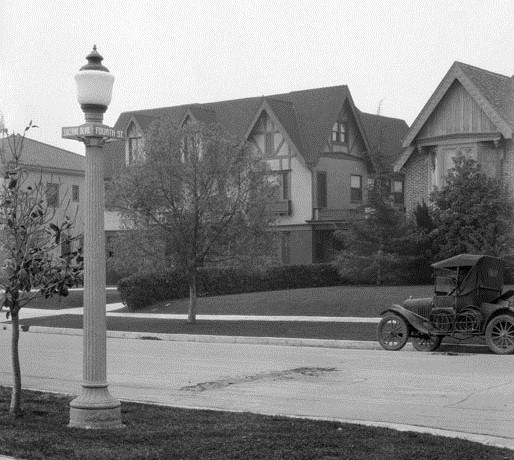 |
|
| (ca. 1920s)* - Residential streetlight lamp on Fourth Street. Note that the street sign is attached directly to the streetlight concrete post. |
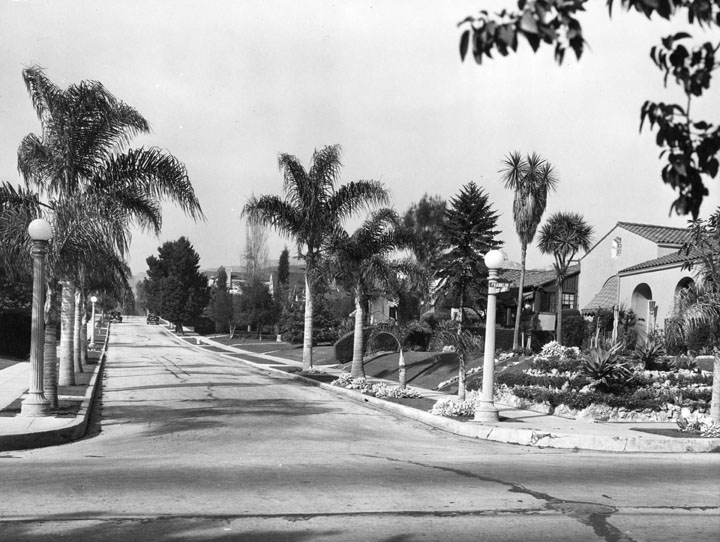 |
|
| (ca. 1925)* - Single-lamp streetlights in a residential area. View is south on Serrano Ave. from the corner of Franklin showing a tree-lined street with well-kept lawns in the Los Feliz district, built in the early 1920s. |
 |
|
| (ca. 1926)^ - View of the HOLLYWOODLAND* sign with homes seen in the foothills. Note the single-bulb streetlight on the right. This was the type of lamp used in Hollywood's residential neighborhoods during this time period. |
Historical Notes The story behind the White Dot located under the Hollywoodland Sign: In 1920-21, the US Chamber of Commerce produced maps illustrating business conditions in areas of the country. Those shaded black were poor, white with black stripes (grey) were fair and white was good. Los Angeles was a “white spot” in a sea of black and grey on the map in the early 1920s. Los Angeles Times publisher, Harry Chandler adopted the catchprase, “White Spot Of America” as being a city free of crime, corruption and communism. Chandler, who was vehemently anti-union, was an influential proponent of developing a strong economic base in Los Angeles. It wasn’t long before the phrase “keep the white spot white” was being commonly used. The term “white spot” typically referred to LA”s relative prosperity and low unemployment, and was not intended to have racial overtones. So, for Los Angeles, the term, “keep the white spot white” meant keep L.A. prosperous. In late 1924, in order to demonstrate support for the “keep the white spot white”, campaign, Hollywoodland erected a 35 foot diameter “white dot” on the hillside, several feet below the Hollywoodland sign. The cost to erect the dot was $936.16. Contrary to popular belief, the white dot was not illuminated.* Click HERE to see more Early Views of 'Hollywoodland'. |
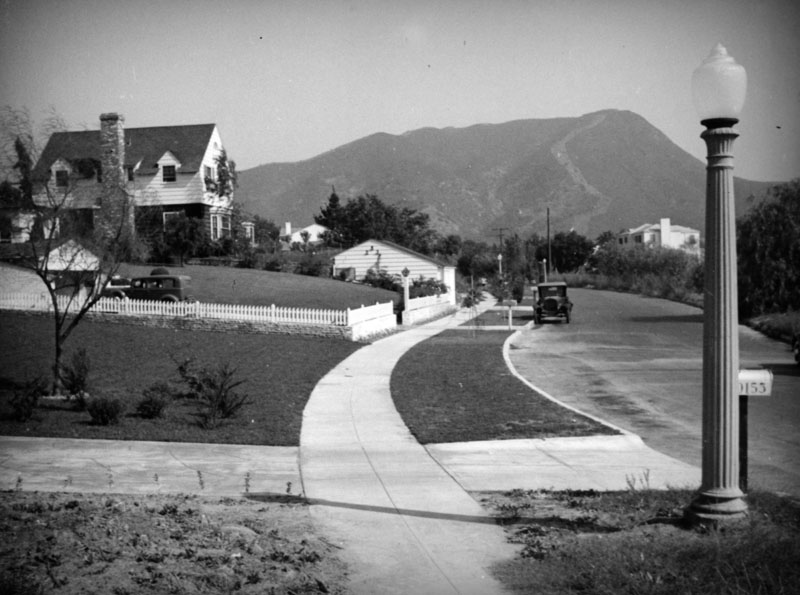 |
|
| (ca. 1936)^ - Single-post street lamp in Toluca Lake. This type of lamp was commonly installed in residential areas throughout the 1930s and 1940s. |
* * * * * |
'Western' Dual-Lamp Llewellyn Electrolier
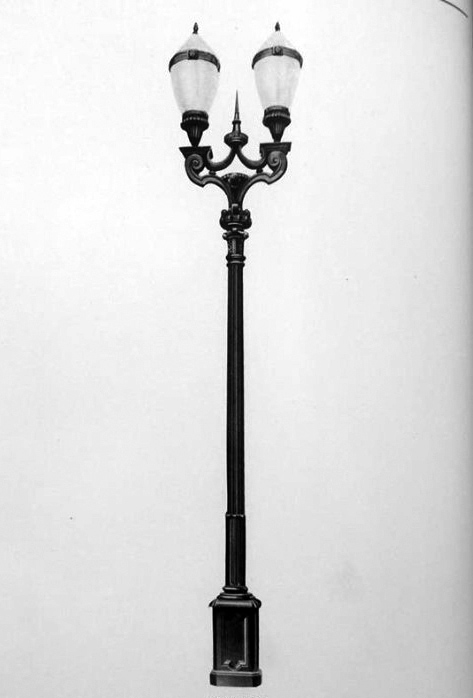 |
|
| (1928)^.^ - The ‘Western’ dual-lamp streetlight as seen in the Llewellyn Iron Works Catalog. |
Historical Notes The "Western" was once found on Western Avenue as well as Santa Monica Boulevard in Hollywood. There were also a few outliers along Sunset Boulevard. None of the ‘Western’ posts survived. Its look-alike cousin, the Llewellyn “Washington”, can still be found in Downtown LA. |
.jpg) |
|
| (1924)*^ – View looking south on Western Ave at Maplewood Ave showing “Western” dual-lamp Llewellyn electroliers standing at the corners of the intersection. |
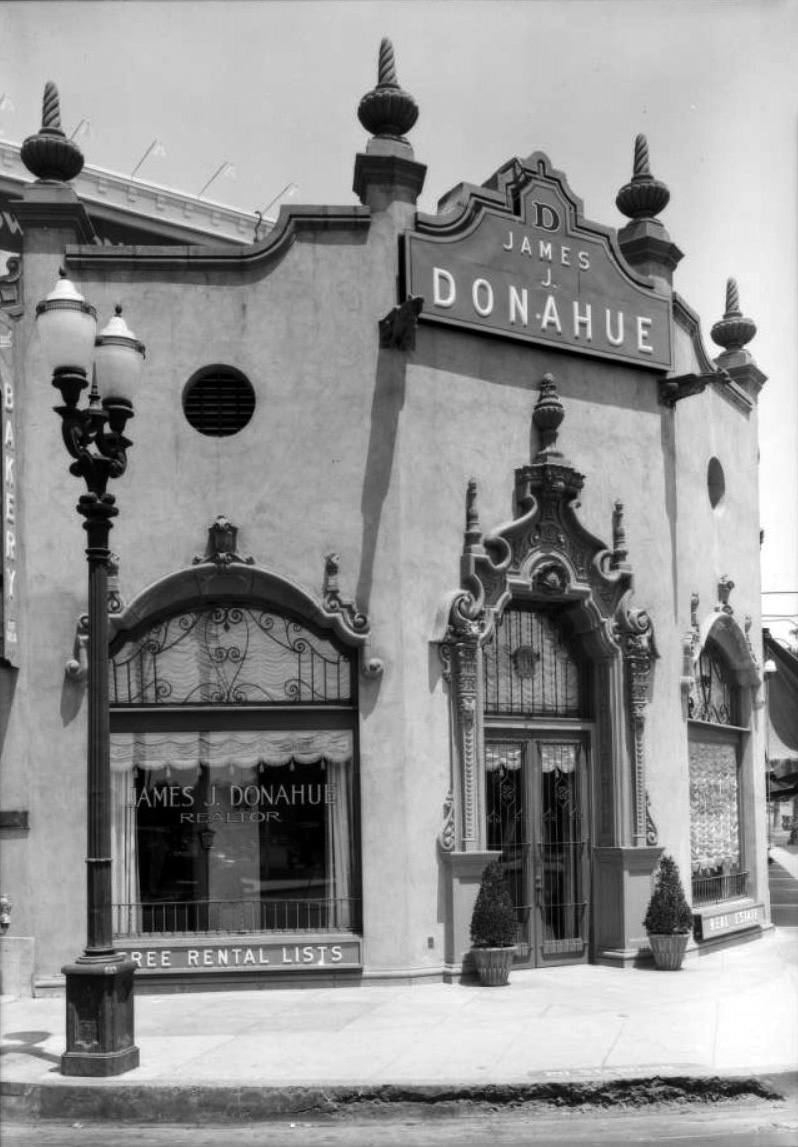 |
|
| (1925)*^ – View showing a ‘Western’ dual-lamp electrolier standing in front of the James J. Donahue Real Estate office on the corner of Wilshire Boulevard & South Western Avenue. |
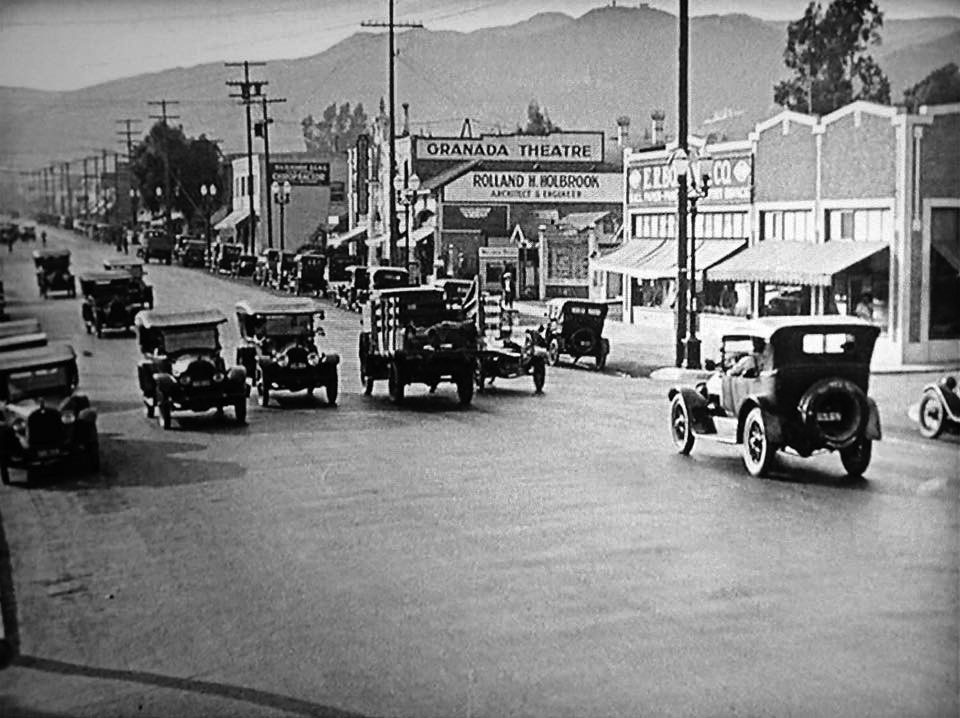 |
|
| (ca. 1921)^.^ – View looking west on Sunset Boulevard at Vista Street showing dual-lamp Western electroliers on the north side of the street, with the Granada Theatre (later Oriental Theatre seen at center of photo. |
.jpg) |
|
| (ca. 1932)*# - View of the north side of Sunset Boulevard showing a 'Western' dual-lamp electrolier in front of the Oriental Theatre (originally Granada Theatre). |
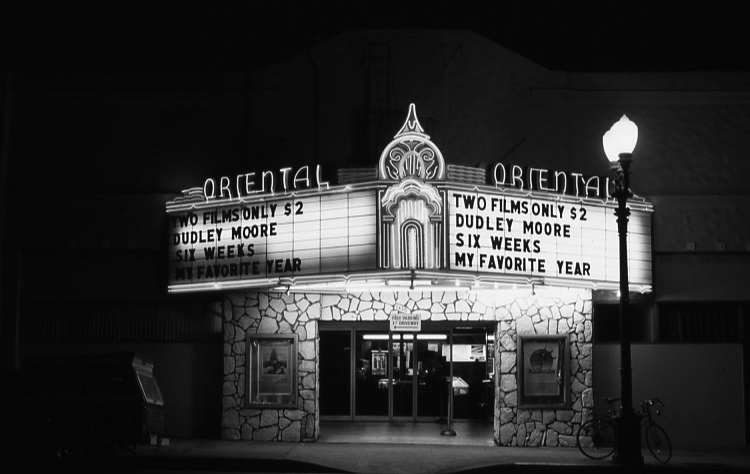 |
|
| (1983)^^ – A ‘Western’ dual-lamp lights up the street in front of the Oriental Theatre. |
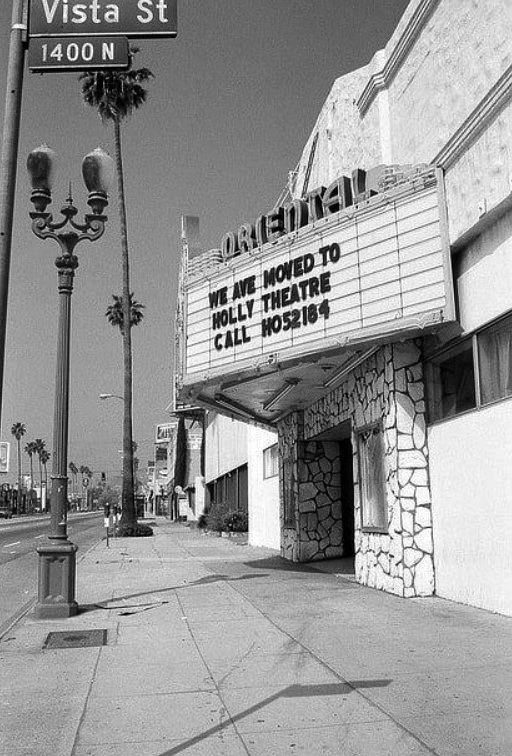 |
|
| (1985)^^ - "Western" Electrolier with painted-out globes located in front of the Oriental Theatre at 7425 Sunset Boulevard near Vista Street, Hollywood. |
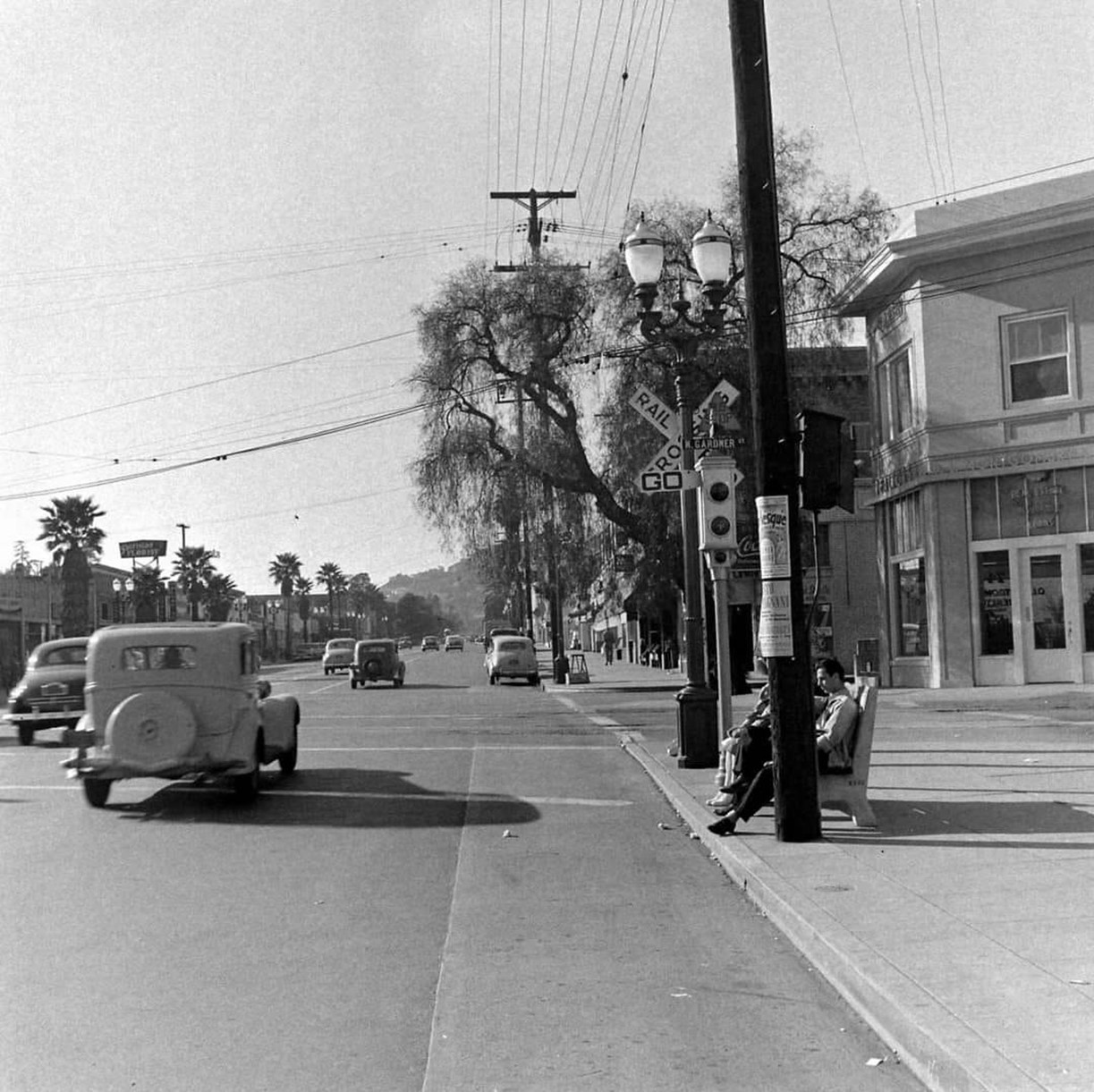 |
|
| (1948)* - Looking west on Sunset Boulevard at Gardner Street showing a 'Western' dual-lamp electrolier standing in between a rail crossing sign and a Semaphore traffic signal. This is at the Pacific Electric Red Car crossing known as Gardner Junction. |
* * * * * |
'Pico' Five-Globe Llewellyn Electrolier
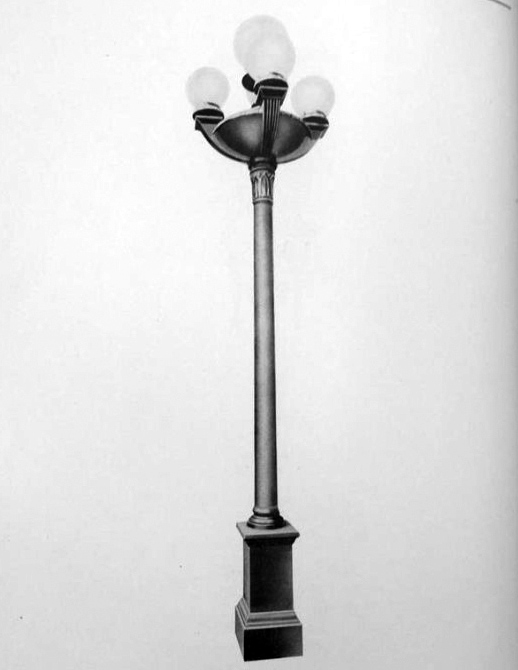 |
|
| (1928)^.^ - The "Pico" electrolier as seen in the 1928 Llewellyn Iron Works Catalog. |
Historical Notes This ornate 5-globe streetlight was found on Pico Boulevard from Main Street on the East to Vermont Avenue on the West. |
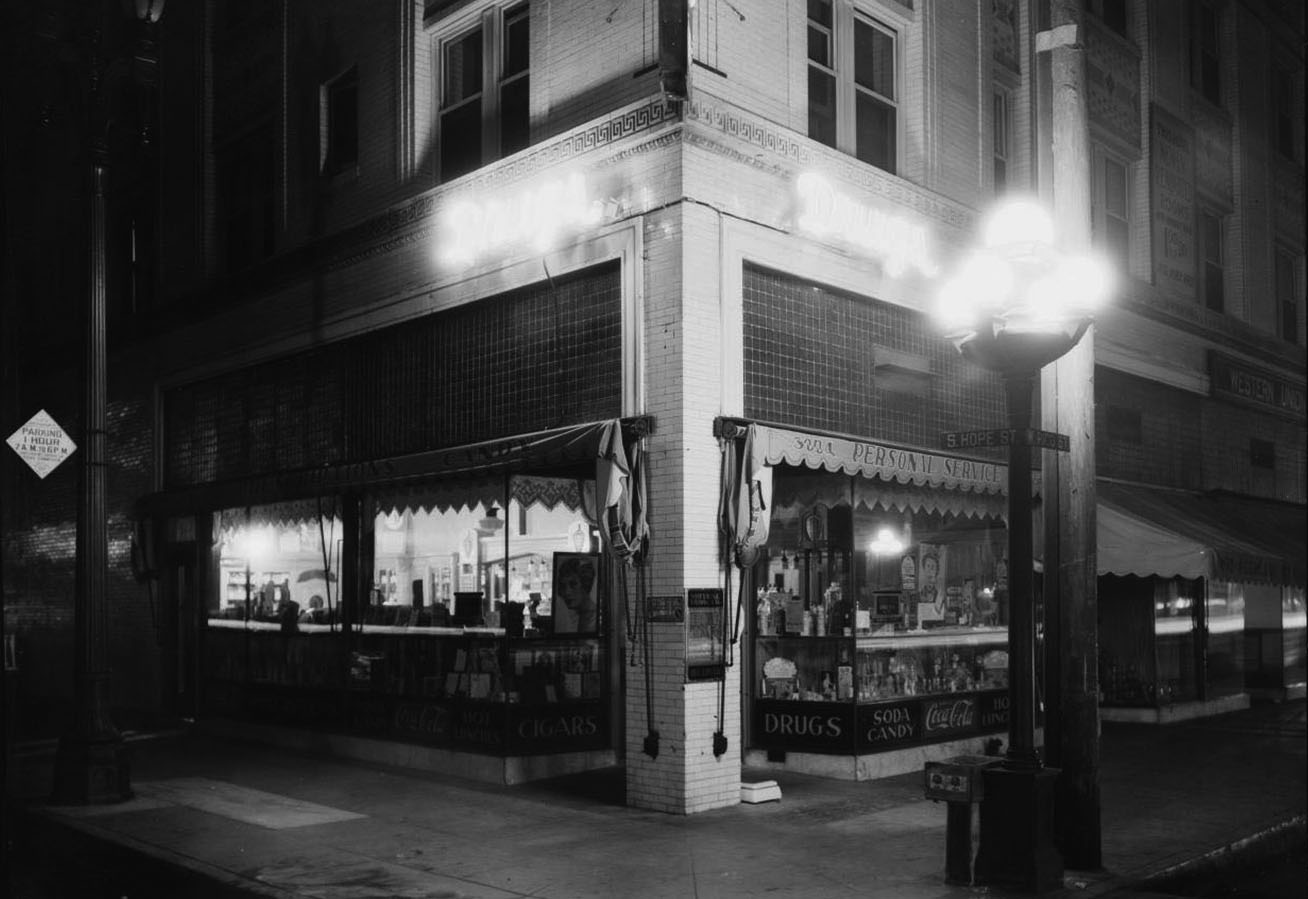 |
|
| (1926)* - A 5-globe Llewellyn "Pico" streetlight illuminates the sidewalk in front of a drug store located on the corner of Hope Street and West Pico Boulevard. |
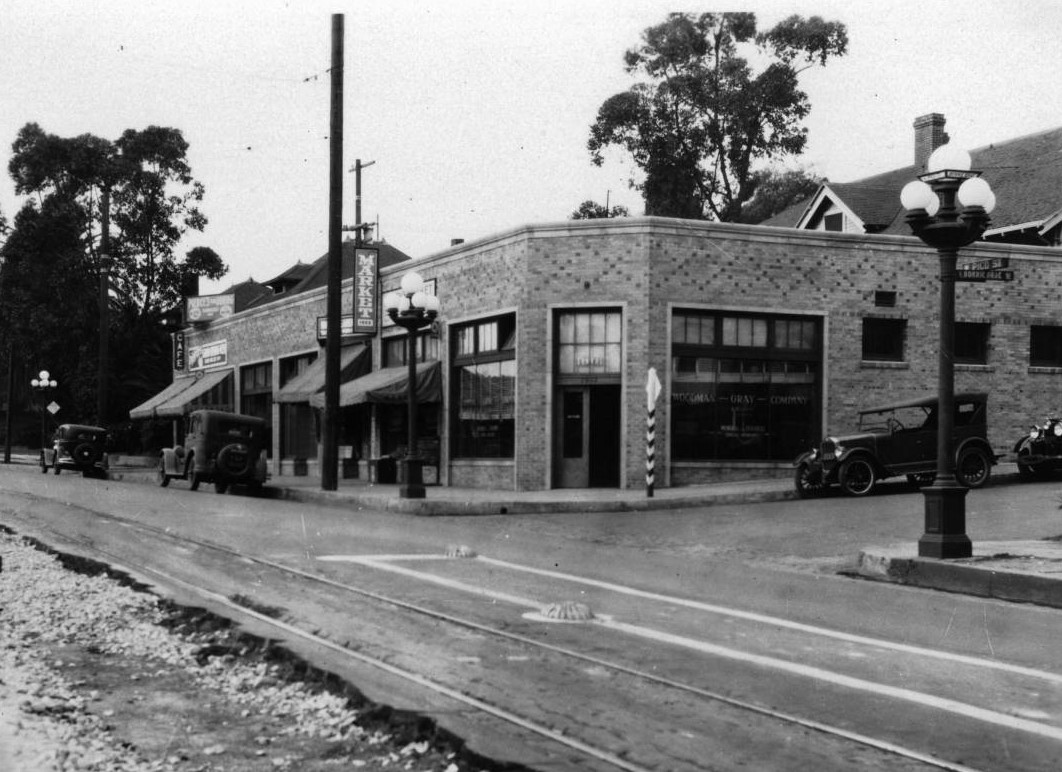 |
|
| (1928)*^ – View looking west on Pico Boulevard at Bonnie Brae Street with Pico Llewellyn Electroliers seen on the corners. The above building located on the NW corner (1901 W. Pico) still stands today. Click HERE for contemporary view. |
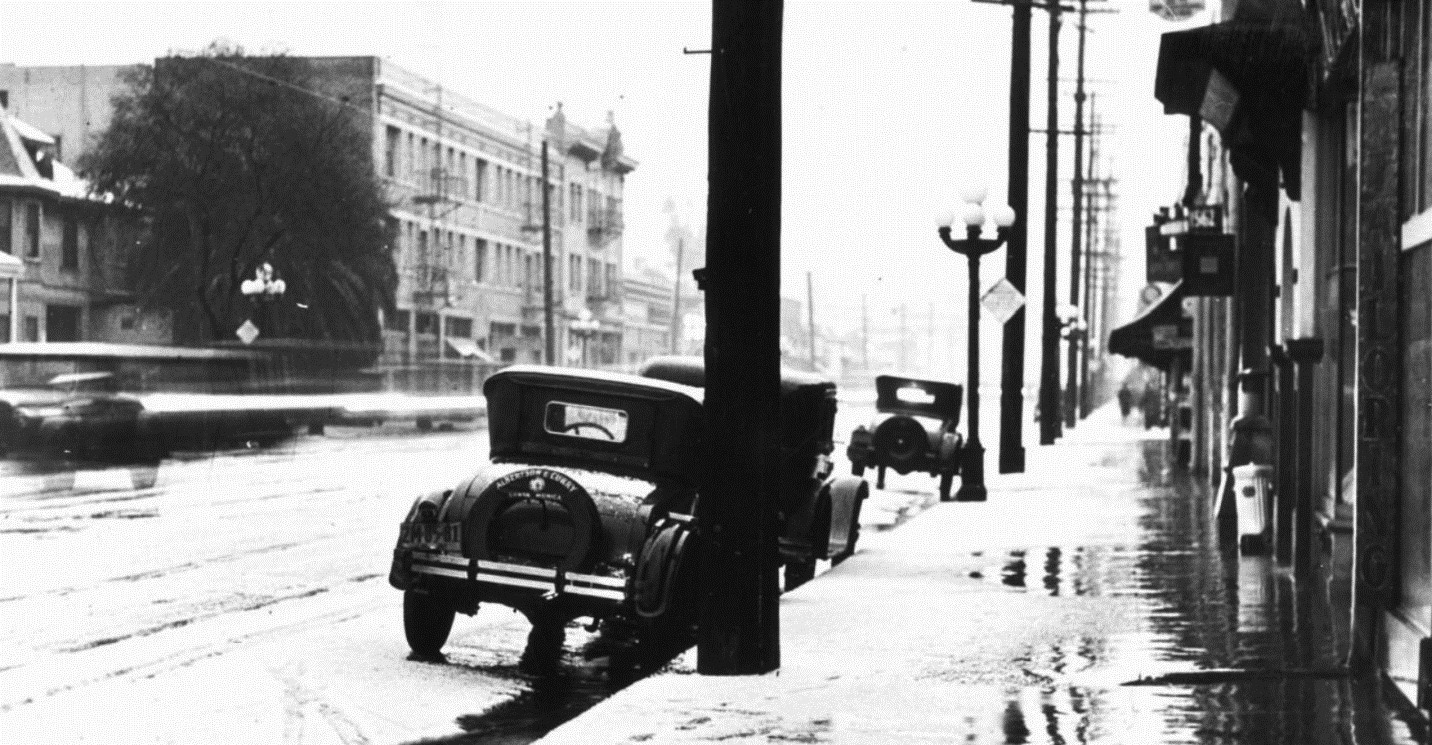 |
|
| (1930)*^ - Ornate 5-bulb Llewellyn Electroliers line both sides of the street in this view of Pico Boulevard east from Union Avenue. |
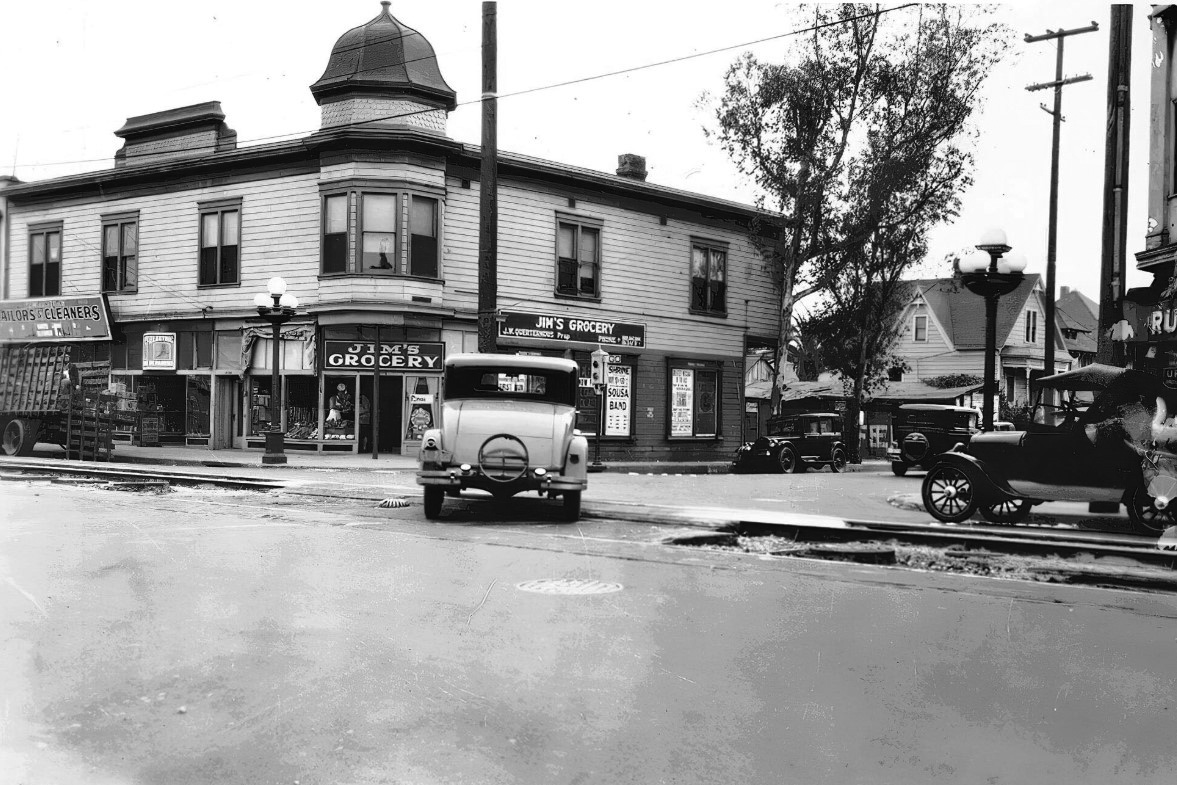 |
|
| (ca. 1932)^.^ – View showing two 5-bulb Pico Llewellyn Electroliers on the south side of Pico Boulevard at Union Avenue. |
* * * * * |
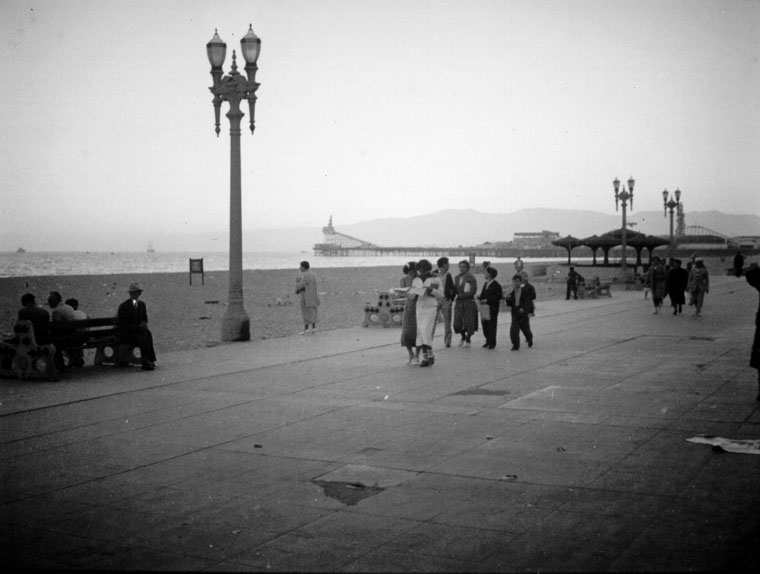 |
|
| (ca. 1926)^ - Two-lamp electroliers are seen along the side of the walkway at Venice Beach. |
 |
(1931)^x^ - View looking west on 8th Street toward Western Avenue showing dual-lamp electroliers running down both sides of the street. Also seen are power lines and streetcar wire attached to the top of the streetlight posts above the lamps. |
|
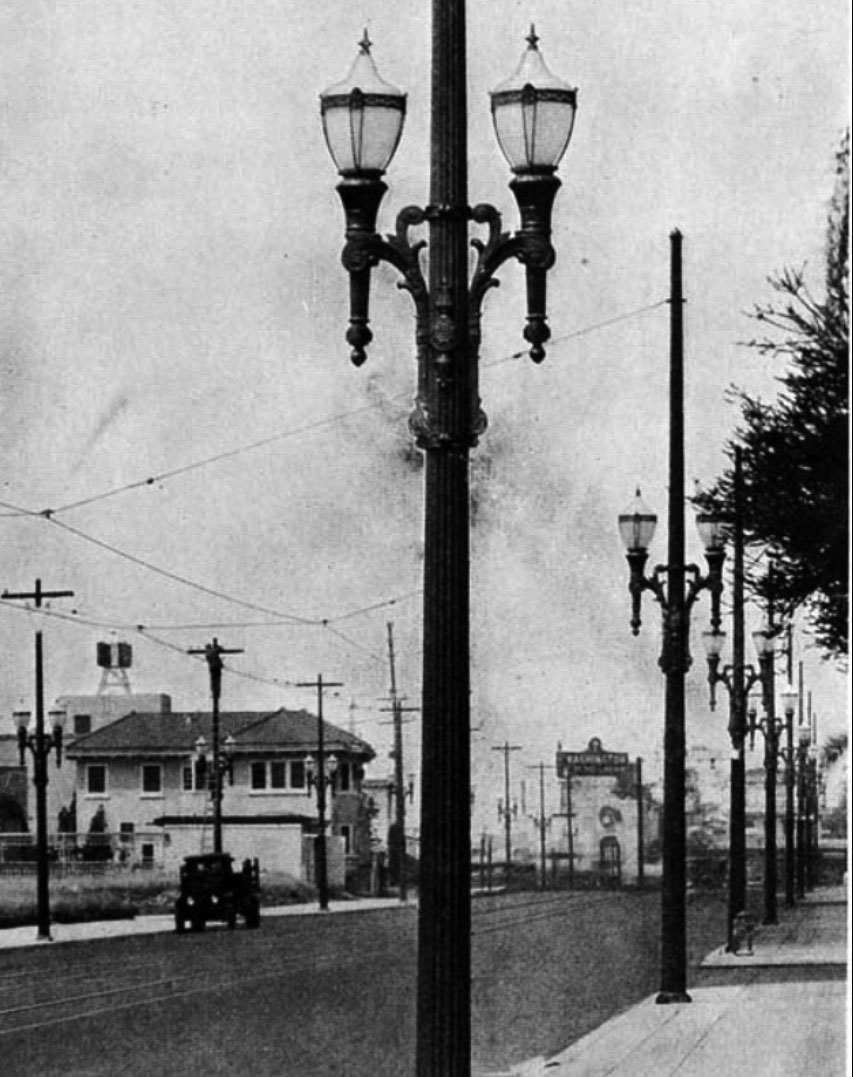 |
|
| (1931)^x^ – Close-up detailed view showing the ornate design of the dual-lamp electrolier. Note the utility worker high up on the streetlight post across the street, probably working on the streetcar cable. |
Wilshire Special
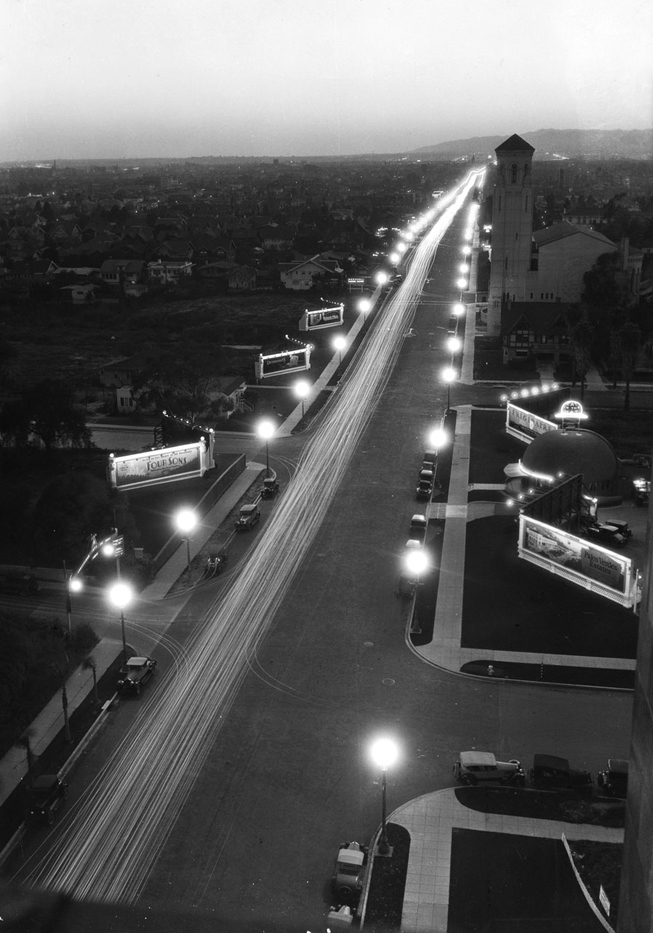 |
|
| (1928)*^ - Aerial evening view of a well lit Wilshire Boulevard. The original Brown Derby restaurant is visible on the right. Note how many signboards on both sides of Wilshire. This photo was taken just after the new "Wilshire Special" streetlights were installed on both sides of Wilshire between Park View and Fairfax Ave. The tallest building in view is the Wilshire Christian Church (today Oasis Church). |
Historical Notes Wilshire Boulevard was designated by The Octagon Museum of the American Architectural Foundation as one of the 'Grand American Avenues'. For nearly a half a century it was decorated with the Wilshire Special pole and lantern along nearly six miles of its length. |
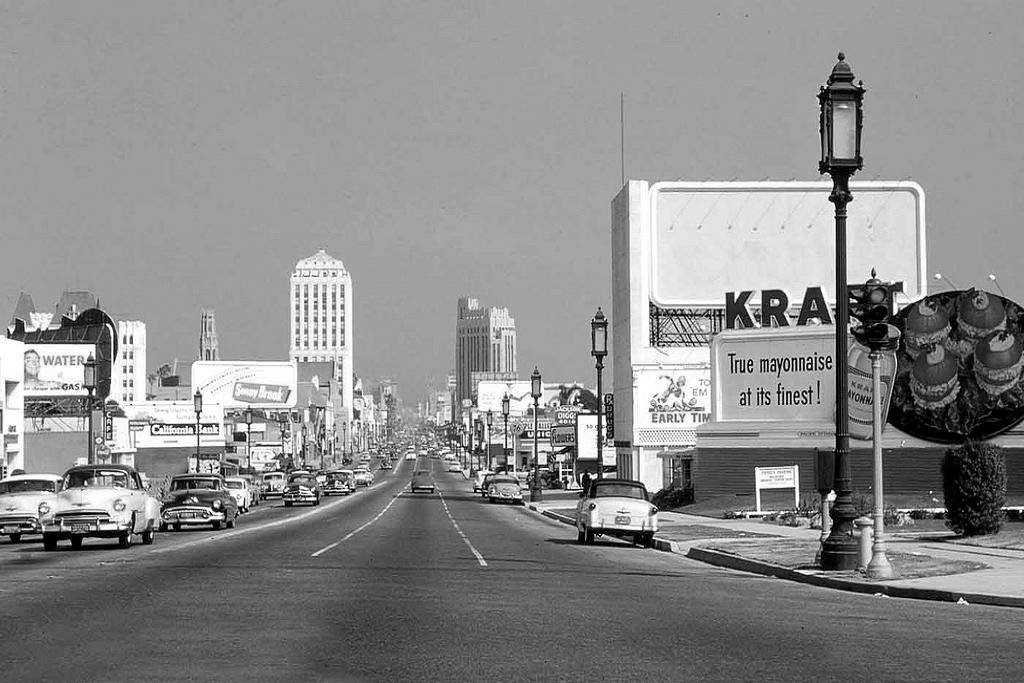 |
|
| (ca. 1952)^.^ – View looking east on Wilshire Boulevard from S. Wilton Place showing “Wilshire Special” streetlights lining both sides of the street. Three tall buildings can be in the distance (l to r): St. James' Episcopal Church, Wilshire Professional Building (N/E corner of Wilshire and St. Andrews) and the Pellissier Building (S/E corner of Wilshire and Western). |
Wilshire Special
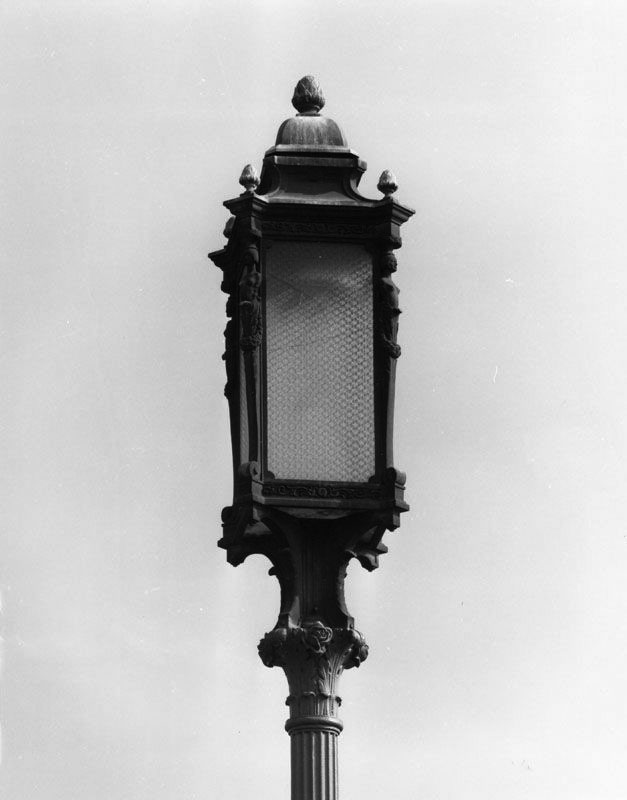 |
(n.d.)* - Close-up view showing a ‘Wilshire Special’ streetlight. Each lantern is guarded by four silent, Thumbelina-sized, bare-breasted women. |
|
Historical Notes The idea of a specialized electrolier for a business district was particularly popular in the late 1920s. The best known was the Wilshire Special, installed in 1928 along Wilshire Boulevard from Park View to Fairfax. In the 1930s these ornate electroliers were also installed on the remaining sections of Wilshire all the way to downtown. Other upscale commercial districts, such as Westwood Village, followed suit with their own special types. |
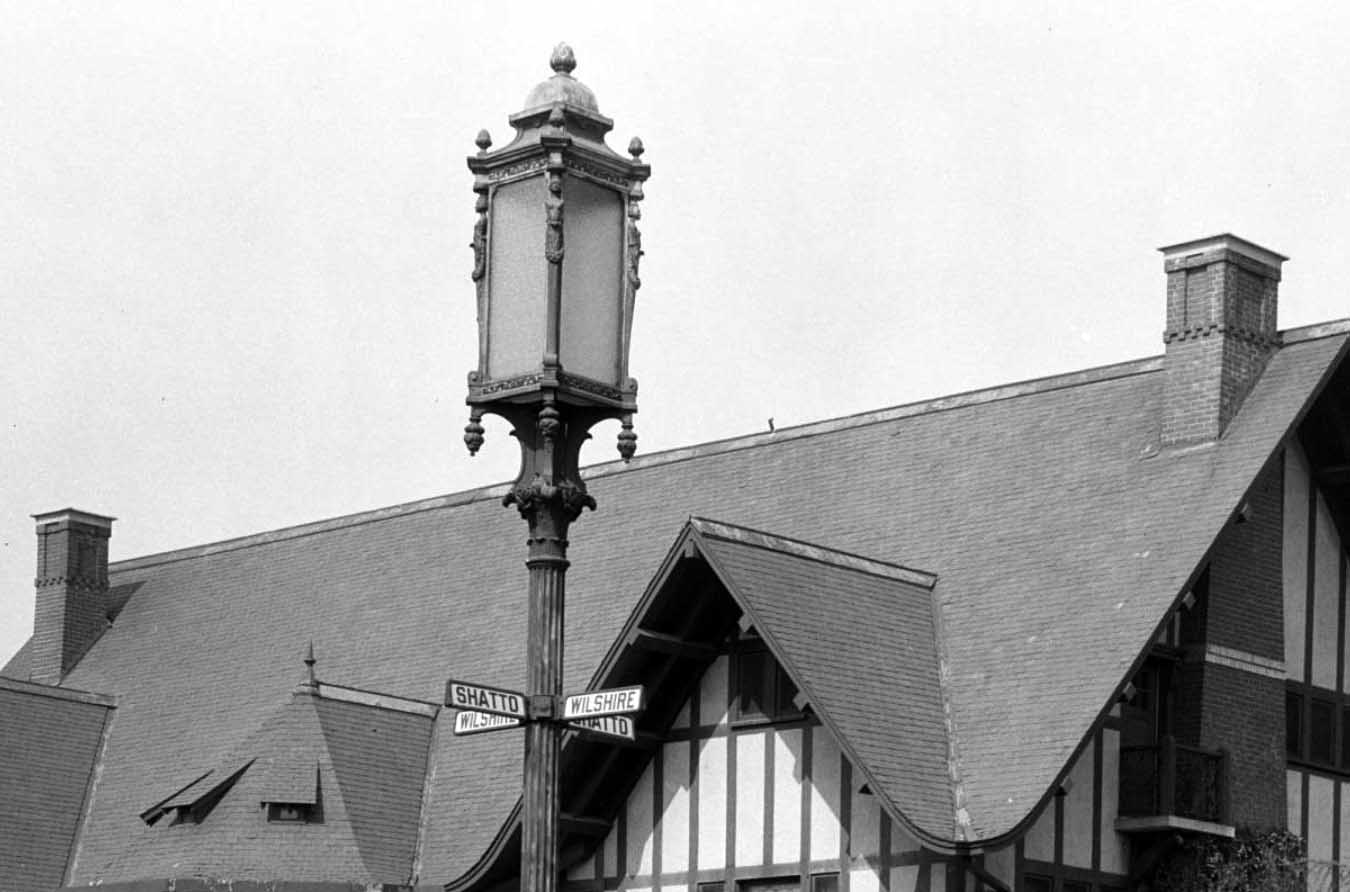 |
|
| (1931)^ – Close up view of a Wilshire Special located on the NW corner of Wilshire Blvd and Shatto Pl. Note how the street signs were attached to the post of the the streetlight. Today a 7-story mixed-use housing building stands at this corner. |
Historical Notes Each lantern is guarded by four silent, Thumbelina-sized, bare-breasted women. |
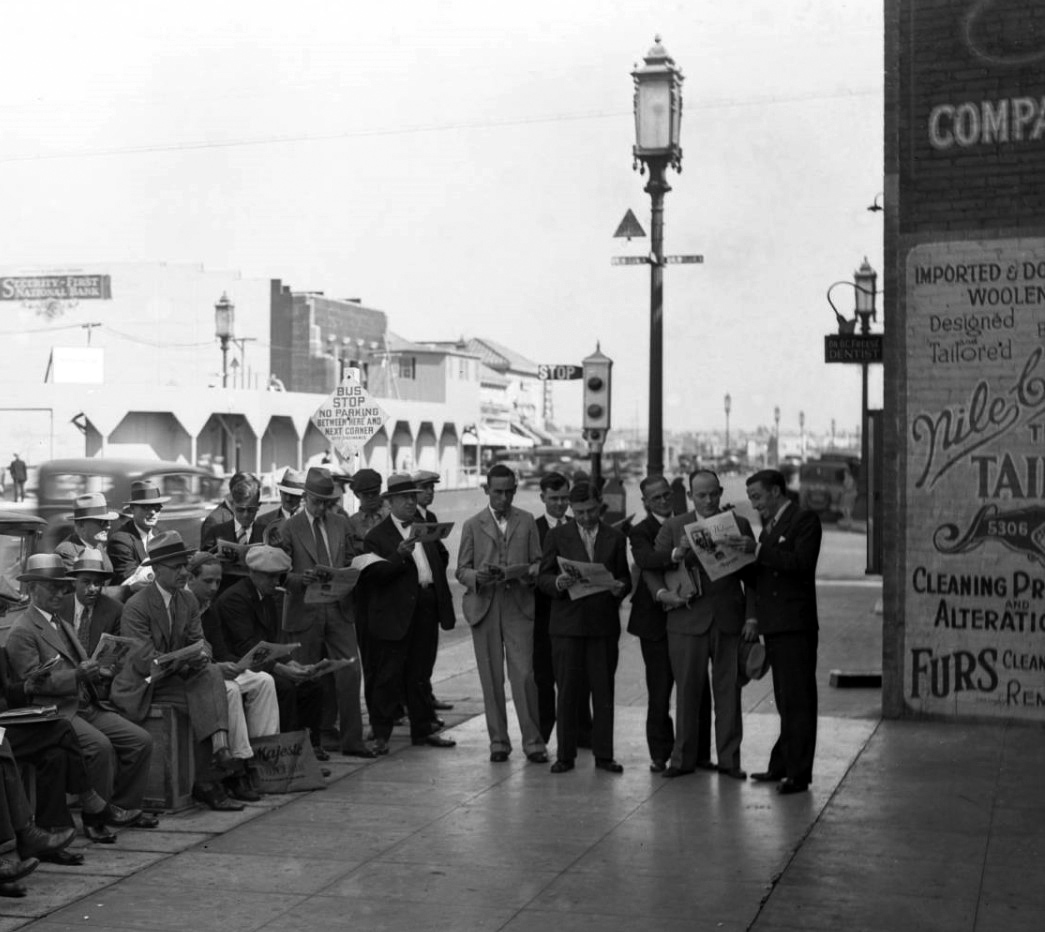 |
|
| (1929)*# - A large group of men, most of whom are reading newspapers, are seen sitting and standing near the SW corner of Wilshire and La Brea. It turns out they are also listening to a live radio broadcast of the World Series in front of Sturgis Radio Store located to the right (out of view). Across the street on the NE corner can be seen the construction site for the new E. Clem Wilson Building where the Gilmore Gas Station once stood. The Art-Deco Security-First National Bank Building sits just to the east of there. Note the "Wilshire Special" streetlights and the Semaphore traffic signal on the corner. |
Historical Notes The above location, SW corner of Wilshire and La Brea, is where the new Purple Line station is being constructed today (2019). Click HERE for contemporary view. |
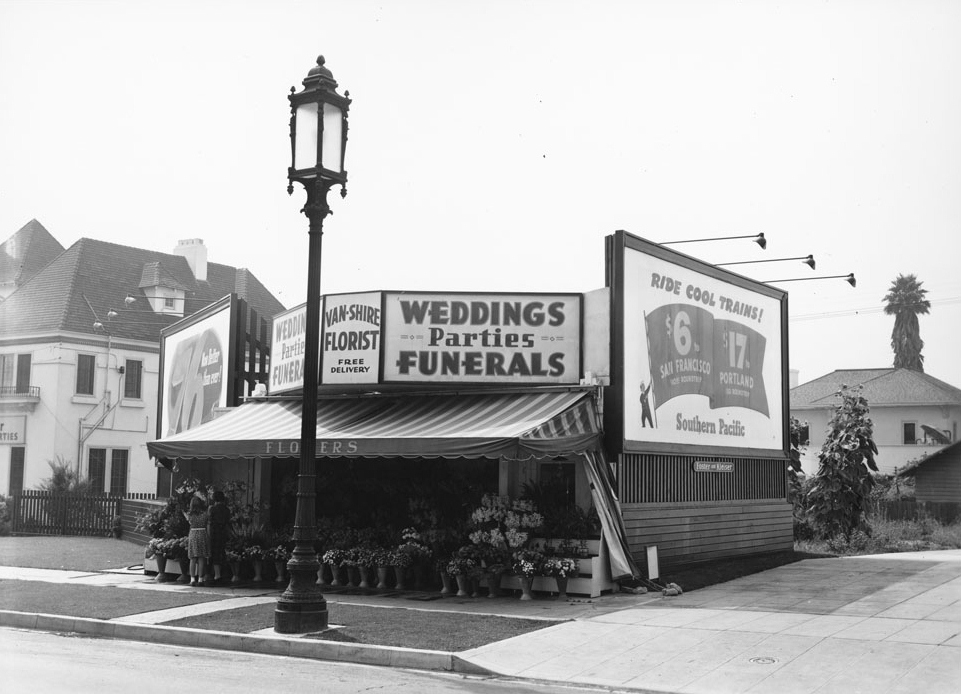 |
|
| (ca. 1928)*# - Close-up of one of the many "Wilshire Special" streetlights that were prevalent along Wilshire Boulevard during the late 1920s and 1930s. The lamp post sits in front of the Van-Shire Florist open-air shop. To the left of the entrance, a young girl and woman look at the arrangements. Bilboards on either side of the shop advertise Union 76 gasoline and Southern Pacific railroad. The sign reads "Ride cool trains! $6 to San Francisco. $17 to Portland". |
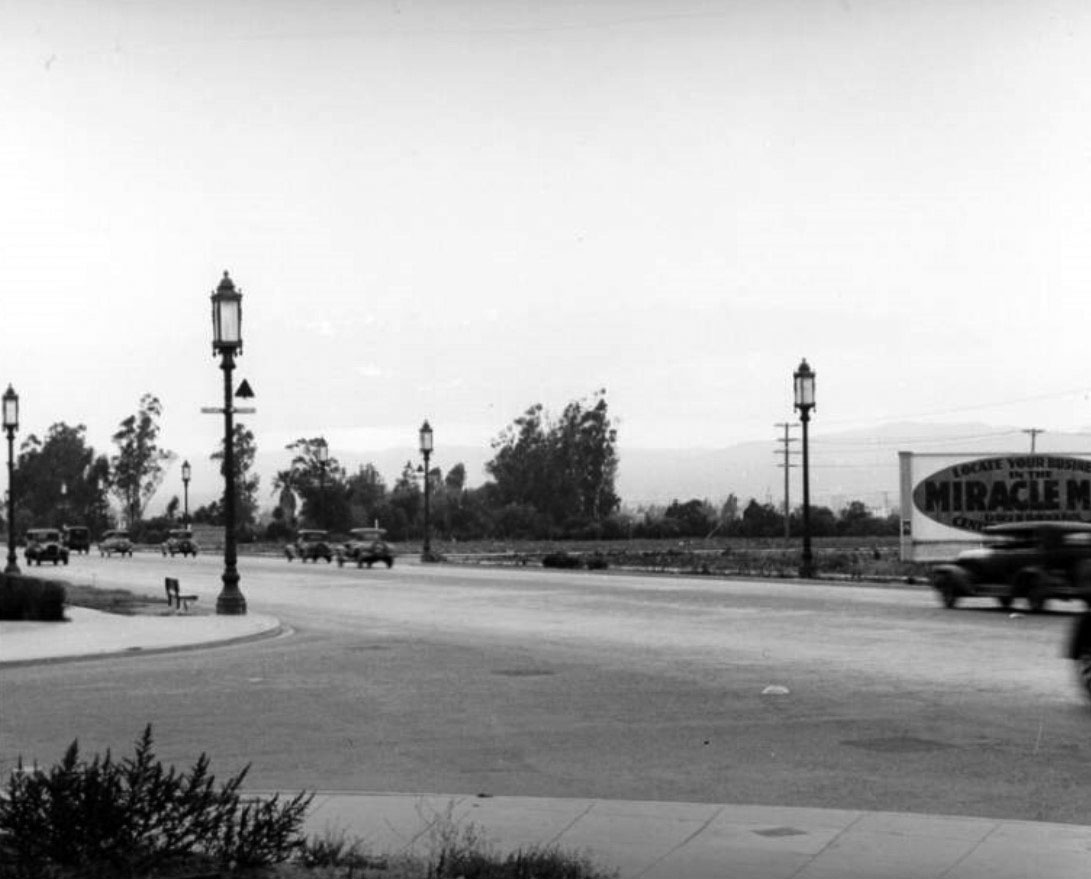 |
|
| (1930s)^ - View of Wilshire Boulevard looking northwest across Masselin Avenue with "Wilshire Specials" lining both sides of the street.. A sign just barely in the picture on the right advertises for businesses to locate in the "Miracle Mile" on Wilshire Blvd. The La Brea Tar Pits can be seen in the distance. |
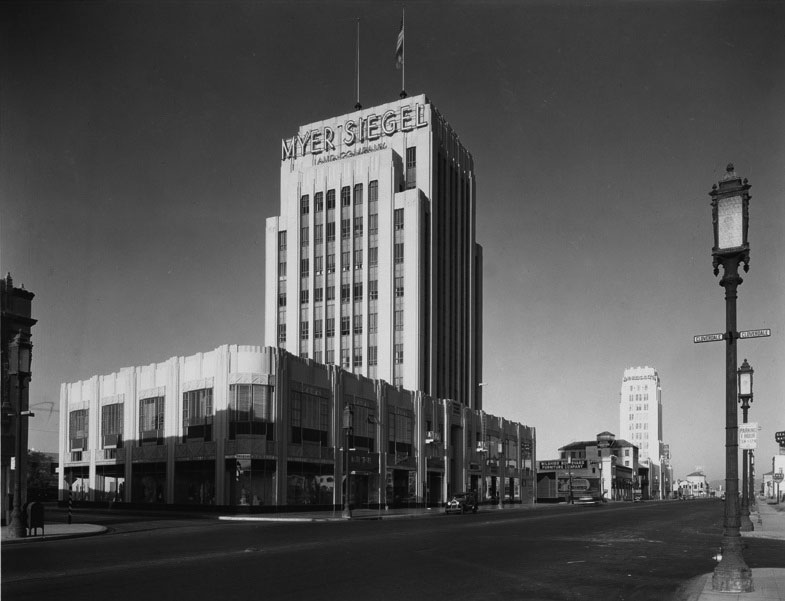 |
|
| (1931)^*# - View is looking west on Wilshire in the Miracle Mile showing Wilshire Special streetlights lining both sides of the Boulevard. On the left is the Dominguez- Wilshire Building (aka Myer Siegel Building) with the Wilshire Tower Building seen in the distance. |
.jpg) |
|
| (1930s)** - A "Wilshire Special" stands tall in front of a men's clothing store, Phelps-Terkel, 5550 Wilshire at Burnside Avenue. |
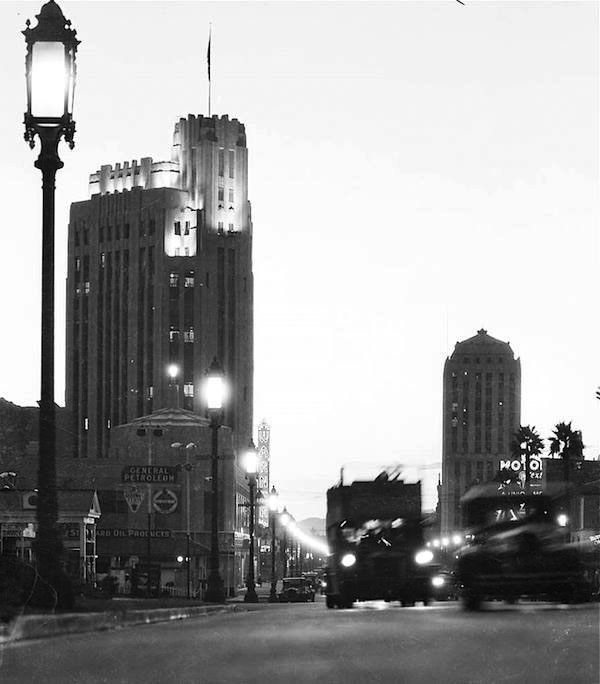 |
|
| (1931)*^ – "Wilshire Specials" light up the street during rush hour traffic. The view is looking west on Wilshire Boulevard with double-decker bus seen heading towards the camera. The Pellissier Building and Warner Theatre (now Wiltern Theatre) are seen lit up on the left. The Wilshire Professional Building is on the right and further back. |
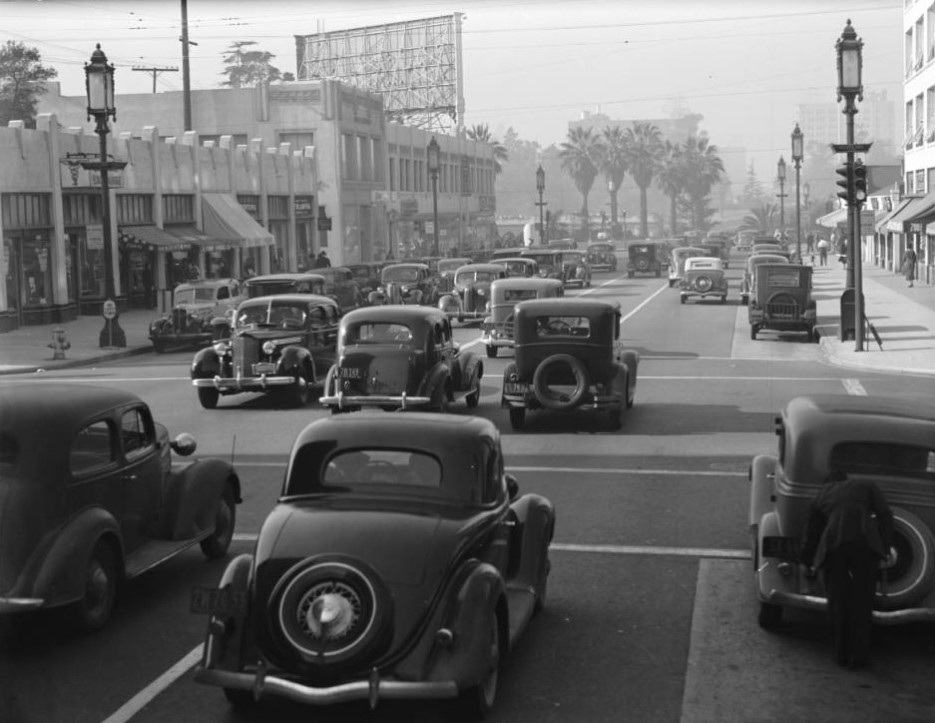 |
|
| (1937)*^- View of Wilshire Boulevard at Bonnie Brae Street looking west toward Westlake Park showing Wilshire Specials lining both sides of the street. These Wilshire Specials were installed in the early 1930s after the street was widened and name changed from Orange Street to Wilshire Boulevard. |
Historical Notes As of 2008, approximately 100 "Wilshire Specials" still remain over the distance of about one-and-a-half miles along Wilshire Boulevard. The original lanterns are solid bronze and stand 7½ feet tall from the base of the lantern to the top of the finial.^^ Click HERE to see contemporary views. |
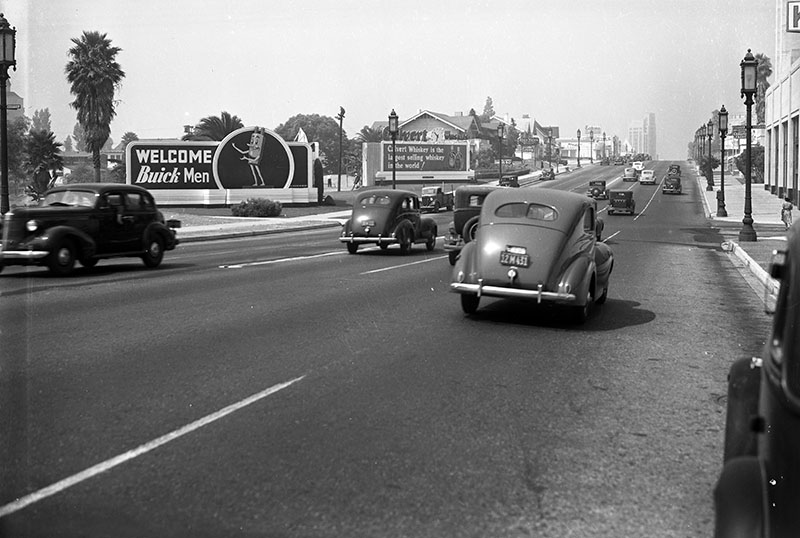 |
|
| (1939)^ - Looking west on Wilshire Boulevard toward Alexandria Avenue with Wilshire Specials lining both sides of the street. Visible are billboards advertising Buick automobiles and Calvert Whiskey, as well as a few homes and commercial buildings; in the distance (upper right) is the Wiltern Theatre. |
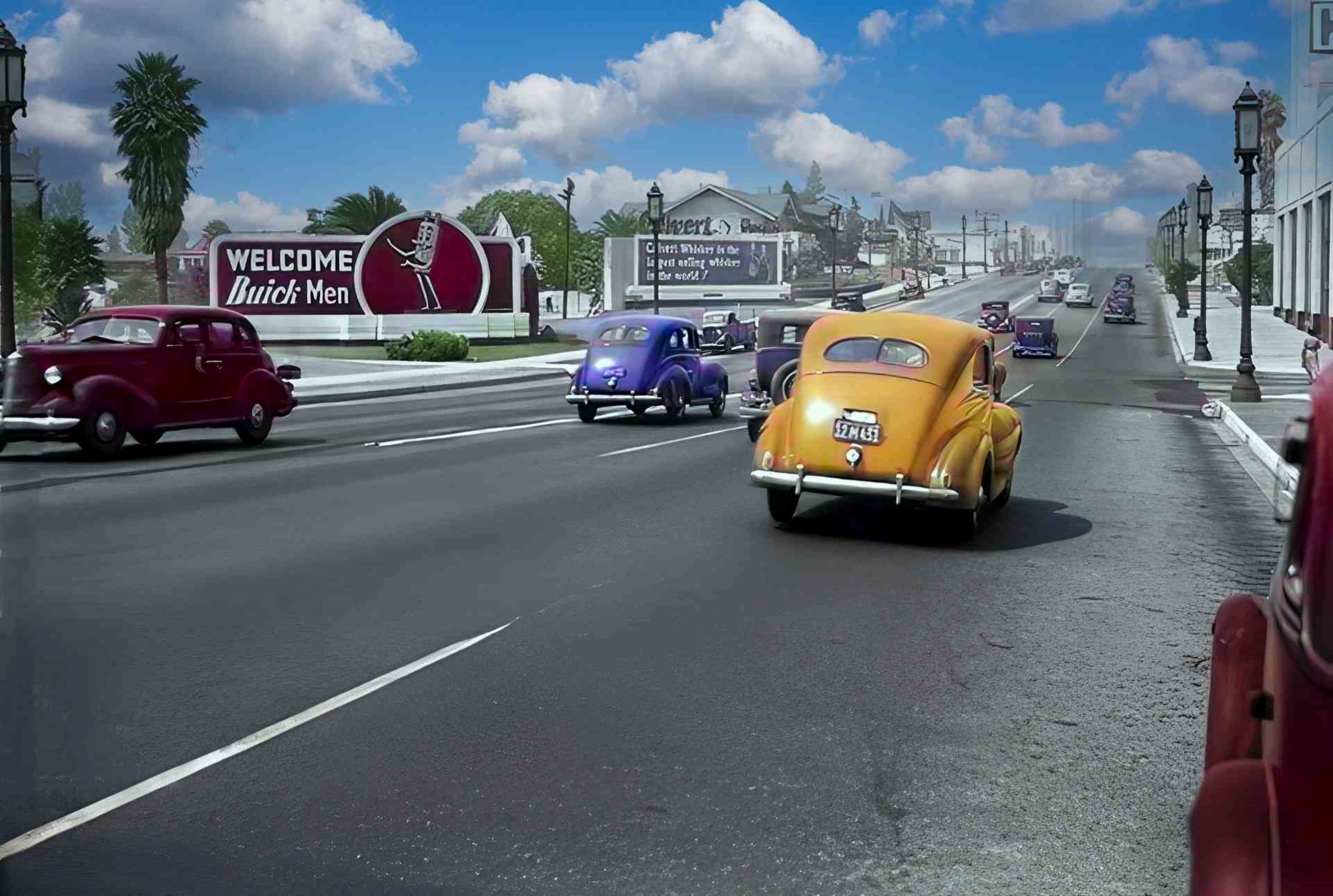 |
|
| (1939)^ - Looking west on Wilshire Boulevard toward Alexandria Avenue with Wilshire Specials lining both sides of the street. Visible are billboards advertising Buick automobiles and Calvert Whiskey, as well as a few homes and commercial buildings; in the distance (upper right) is the Wiltern Theatre. Image enhancement and colorization by Richard Holoff. |
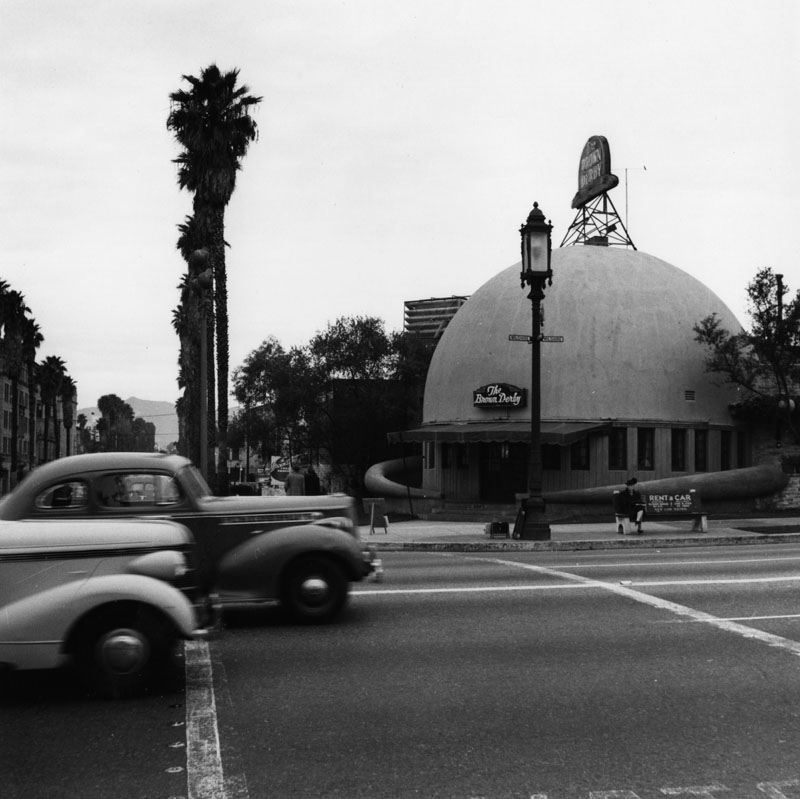 |
|
| (ca. 1940)^ - Cars travel east down Wilshire Boulevard, where it crosses S. Alexandria Avenue (left), right outside the Brown Derby Restaurant. An original "Wilshire Lantern" street light is seen on the corner. |
Historical Notes After being sold in 1975 and renovated, the Brown Derby Restaurant was finally replaced in 1980 by a shopping center known as the Brown Derby Plaza. The domed structure was incorporated into the third floor of the building and accommodates a cafe. A Korean mini-mall occupies the site today. The Brown Derby chain included restaurants in Hollywood, Beverly Hills, and the Los Feliz area. The Los Feliz Brown Derby at 4500 Los Feliz Blvd is the last remaining branch of the chain still extant and in operation.^* |
* * * * * |
Bridge Lighting
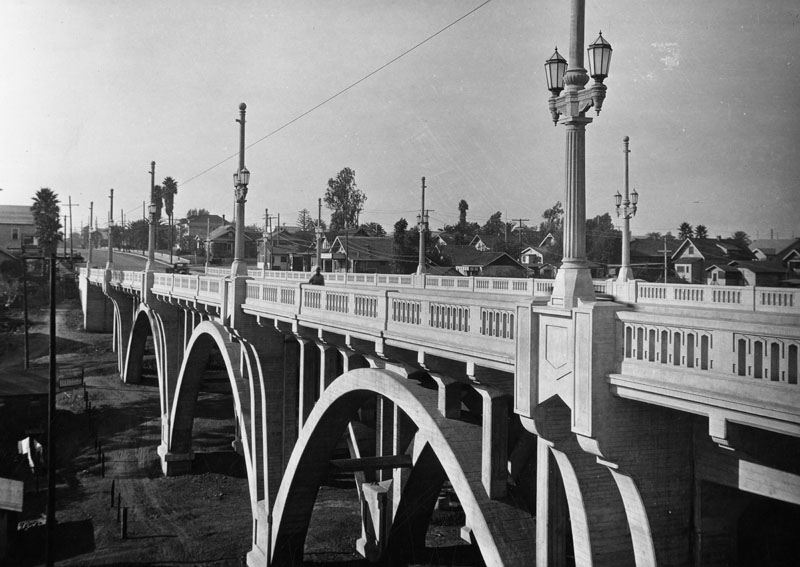 |
|
| (1928)^ - View of the ornate two-lamp electroliers on the arch bridge located at Fourth and Lorena Streets in Boyle Heights, not long after in was built in 1928. The bridge, a declared city of Los Angeles historic monument, No. 265 (Click HERE to see the LA Historic-Cultural Monuments List), is located in a residential neighborhood, as indicated by the various homes present in the background. The electroliers shown here are the same design as those used on the 1st Street Birdge seen in previous photo. |
Historical Notes Special ornamentation was common on bridges constructed between 1900 - 1925. These poles serve two purposes: 1) to hold the decorative streetlight lantern and 2) to support the overhead wire for the Los Angeles Railway (LARy) streetcars that used this viaduct.^^ |
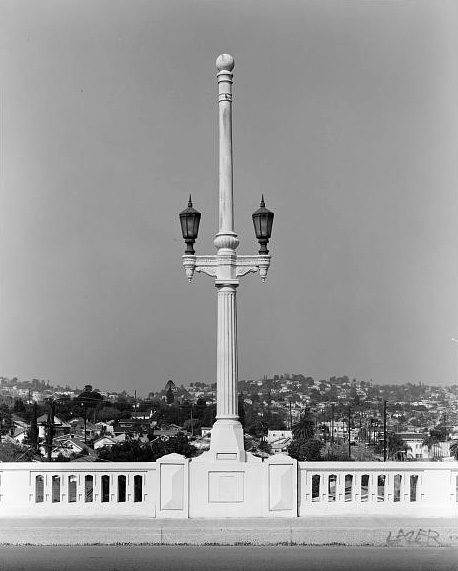 |
|
| (2001)#* - View looking north/northeast showing the ornamental lamp detail on the Fourth and Lorena Street Bridge. |
Historical Notes See More Bridge Lighting (College Street Bridge; First Street Bridge; Fourth Street Viaduct; Fourth and Lorena Streets Bridge; Glendale-Hyperion Bridge; Macy Street Bridge; Mulholland Bridge; Sixth Street Bridge; Washington Blvd Bridge) |
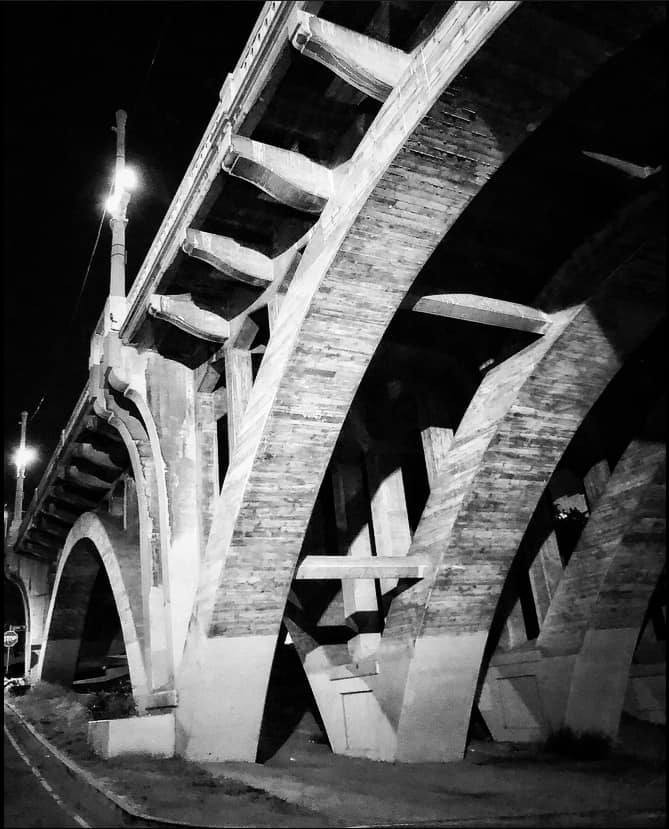 |
|
| (2022)* - Looking up toward the ornamental dual-lamp streetlights on top of the Fourth and Lorena Street Bridge from underpass. Photo by Carlos G. Lucero |
* * * * * |
Downtown
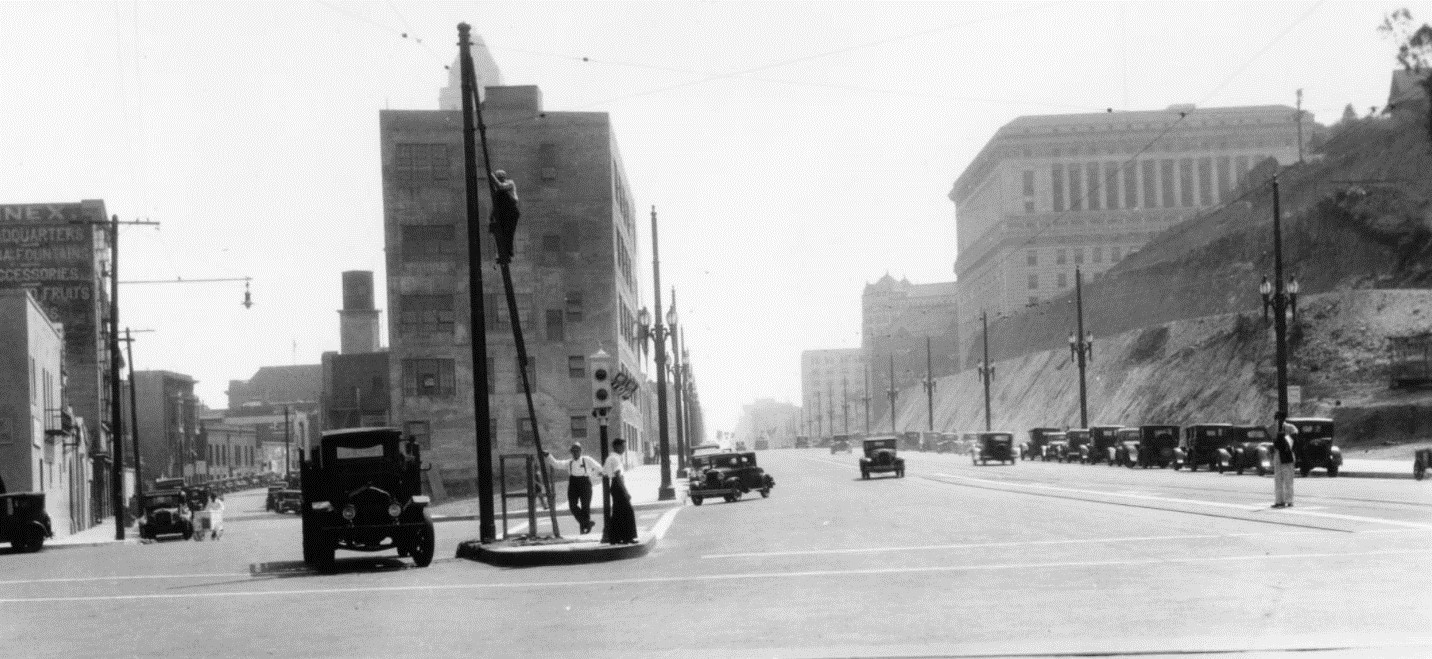 |
|
| (ca. 1928)*^ – View looking south on Spring Street from Sunset Boulevard. Two-lamp streetlights hanging almost at mid-post extend down both sides of Spring Street. The posts are also used to support the streetcar wire. A man is seen climbing a pole without streetlights that supports streetcar cables. |
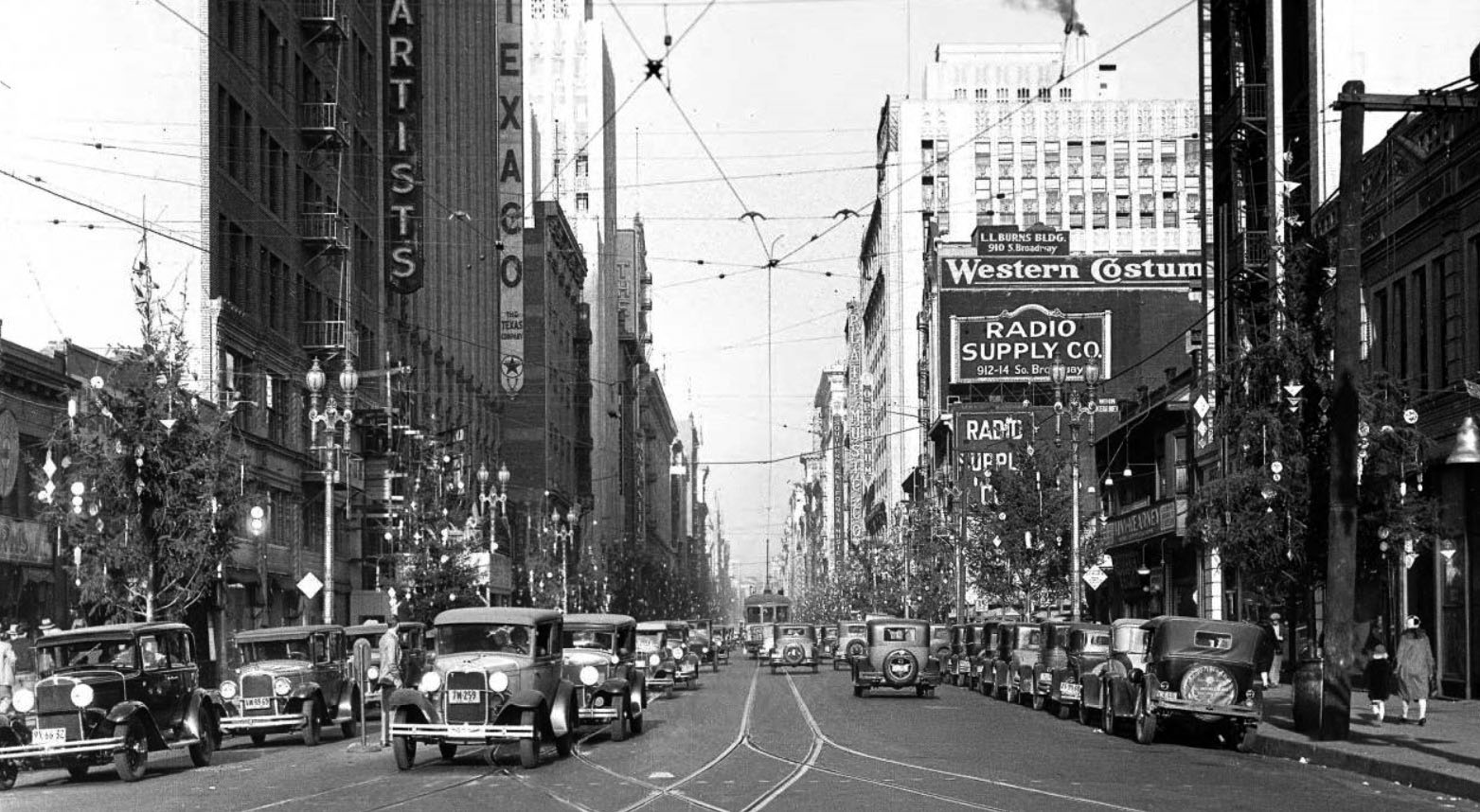 |
|
| (ca. 1930)*^ – View looking north on Broadway from just north of 10th Street (later Olympic Boulevard*). The United Artists Theater Building is at left along with the Texaco Building. The streets are aligned with dual-lamp streetlights and Christmas trees. |
Historical Notes *In 1932, the entire length of the 10th Street, from East L.A. to Santa Monica, was renamed Olympic Boulevard for the Summer Olympics being held in Los Angeles that year.^* |
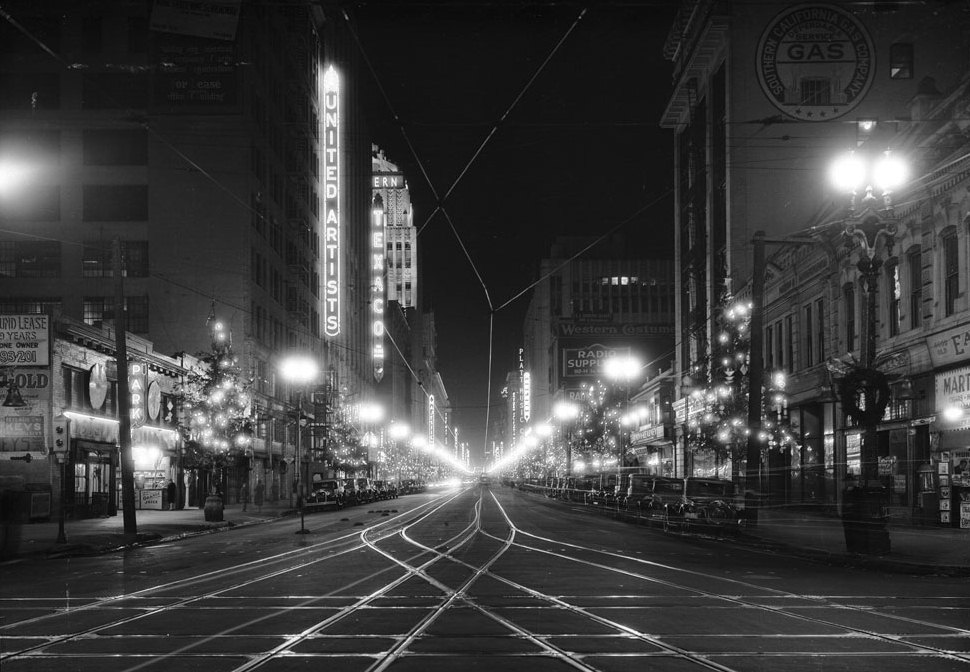 |
|
| (1930)*^ – View looking north on Broadway from 10th Street (now, Olympic Boulevard). The street is illuminated by streetlights, electric signs, and lights on the Christmas trees. |
* * * * * |
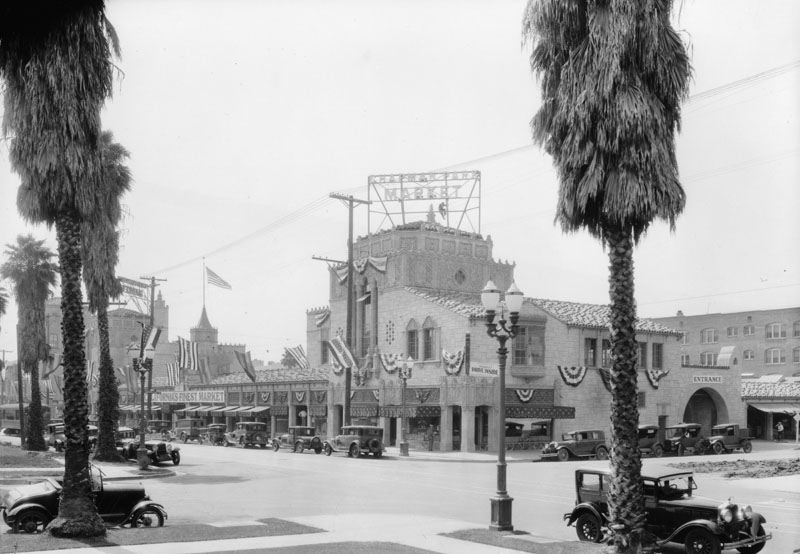 |
|
| (ca. 1929)^ - Double-lamp electroliers stand on the corner of West 6th Street and Alexandria Avenue. Chapman Park Market can be seen across the street. |
Metropolitan Streetlight Standard (Hollywood)
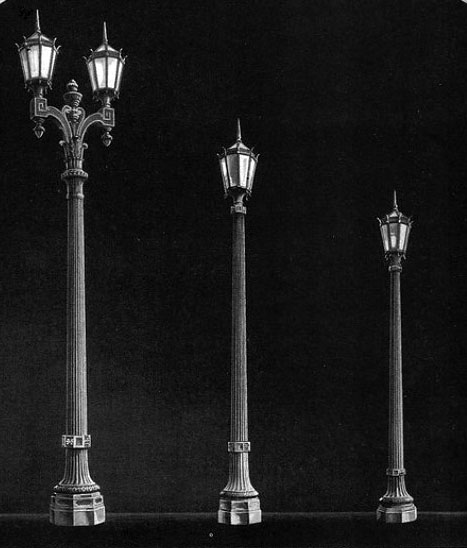 |
|
| (1925)^ - From a page in their 1925 Union Metal Manufacturing Co. Catalog: "The Metropolitan Family”. From left to right: Two Light Business District Standard, Business or Semi-Business District type of Standard, and Residential and Parkway Standard. |
Historical Notes The "Metropolitan" models were developed especially for Hollywood, but ultimately found their way onto the "best" streets of surrounding communities. |
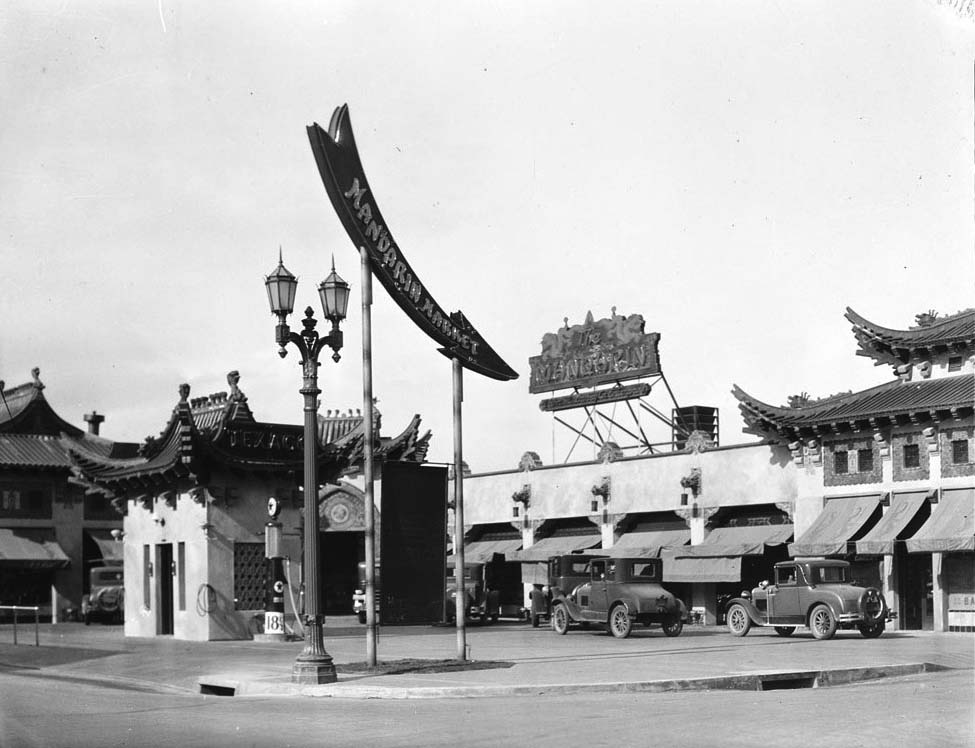 |
|
| (ca. 1929)* - View of the ornate two-lamp 'Metropolitan' electrolier in front of the Mandarin Market located on the northeast corner of La Mirada Avenue and Vine Street. |
Historical Notes In the late 1920s and 1930s, many of this type of streetlight were installed in various parts of the City, but none more than in the Hollywood area. |
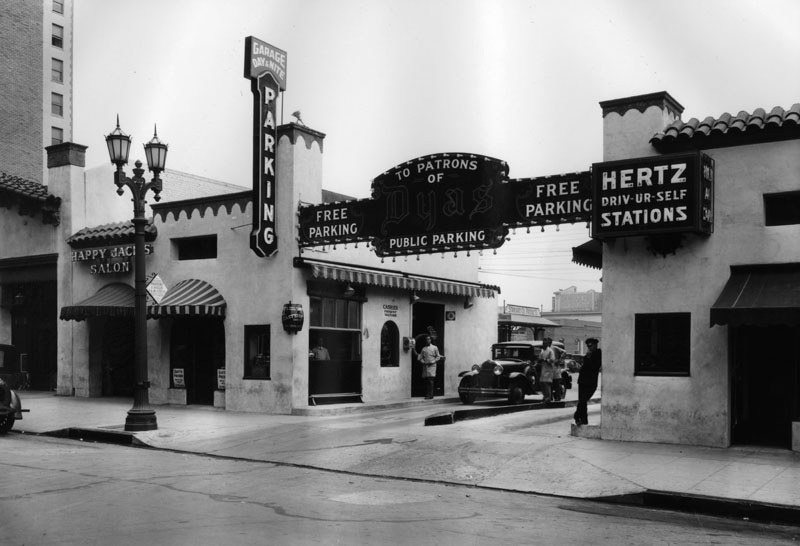 |
|
| (1930)* - A two-lamp Metropolitan streetlight in front of th Hollywood-Vine service station and parking garage. |
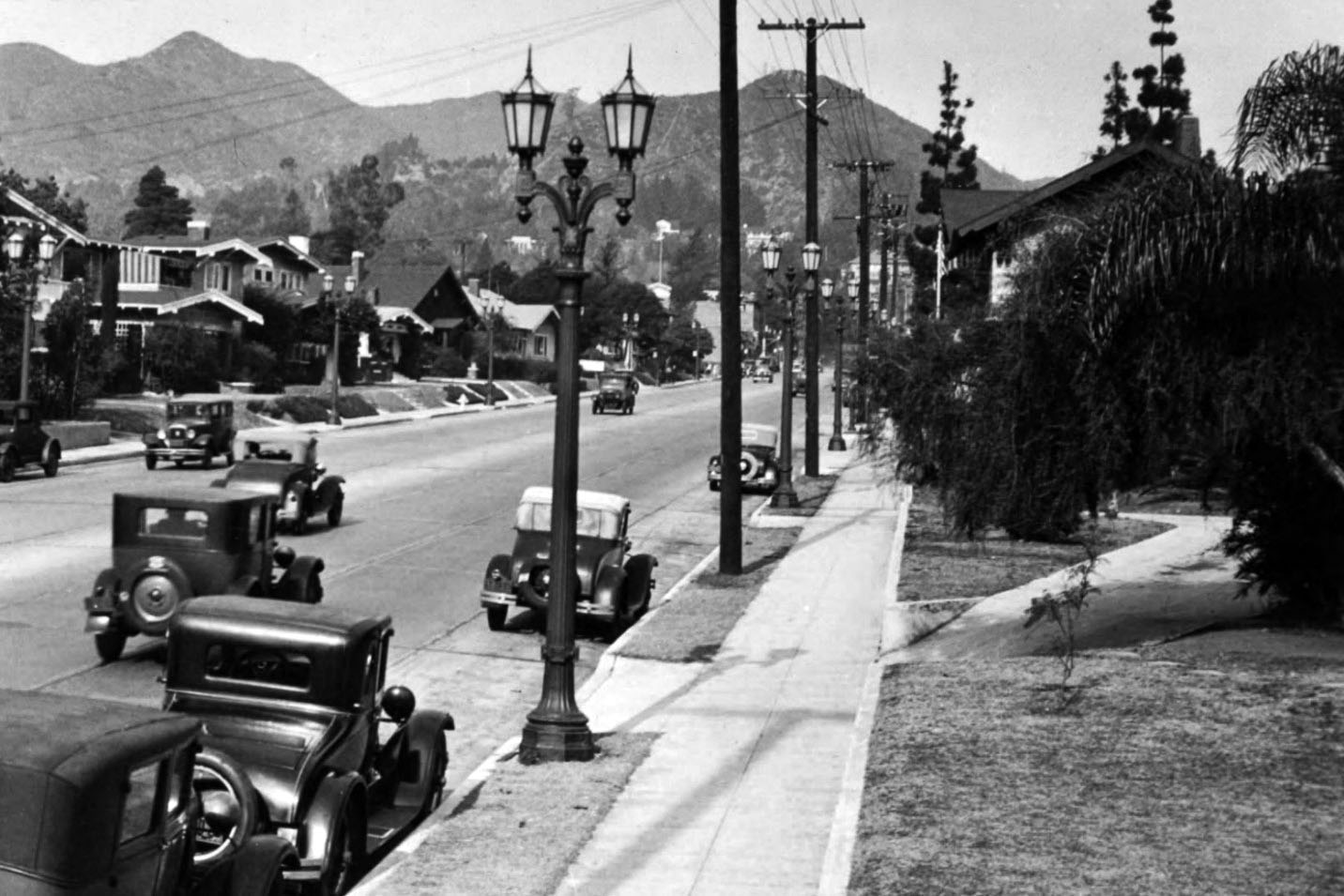 |
|
| (1932)* – View looking north on La Brea Ave from Sunset Boulevard showing Metropolitan Streetlights lining both sides of the street. Click HERE for contemporary view. |
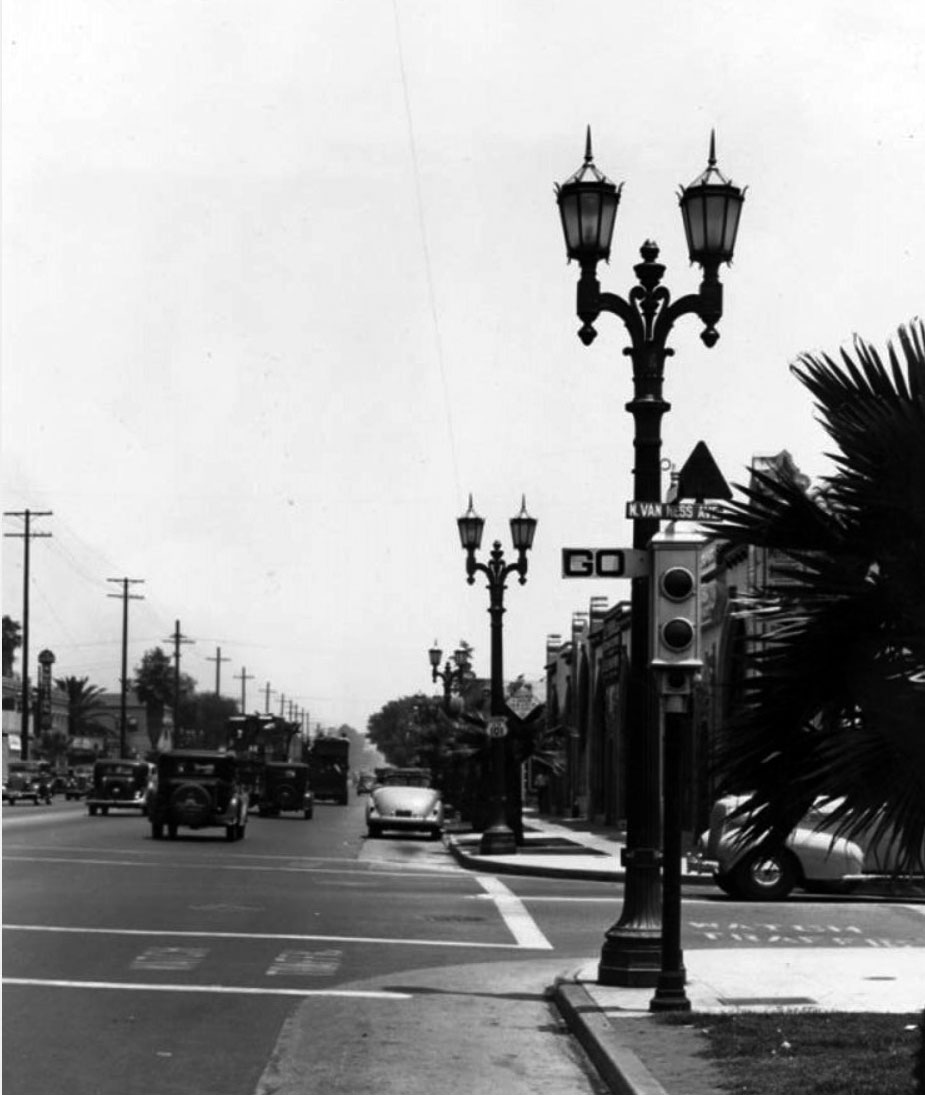 |
|
| (ca. 1937)* – View looking east on Sunset Boulevard at Van Ness Avenue showing early traffic signal and dual-lamp Metropolitan street lights that was common in the Hollywood area since the late 1920s. |
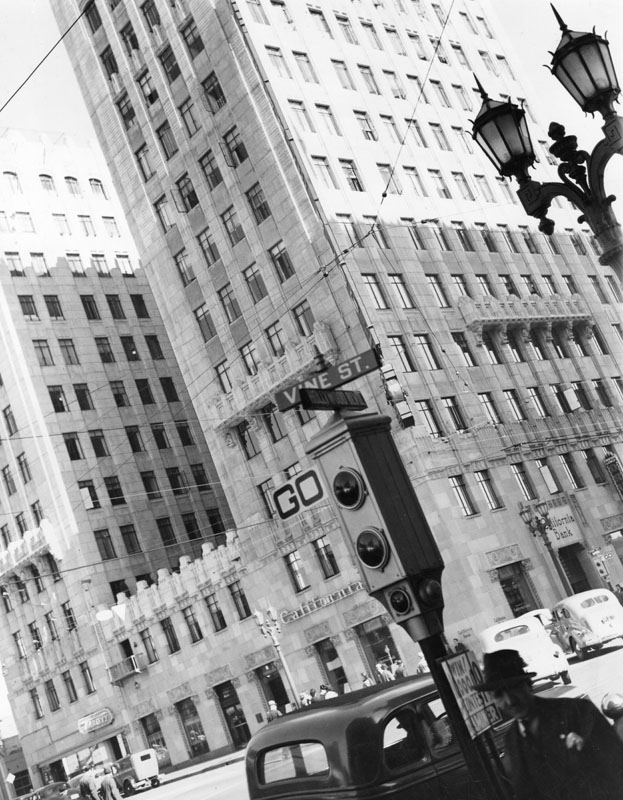 |
|
| (1938)^ - Traffic signal and Metropolitan Streetlight at Hollywood and Vine, looking northeast, with the Equitable Building in the background. |
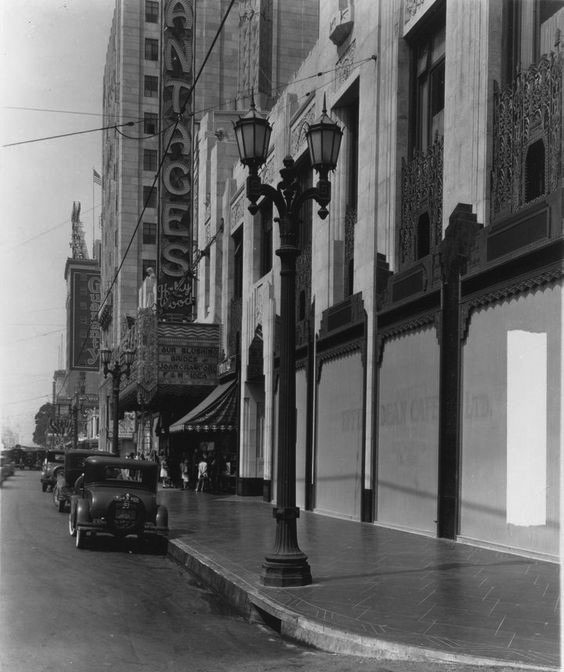 |
|
| (1930s)^ - Street view looking west on Hollywood Boulevard from Argyle Avenue showing Metropolitan Electroliers lining the street in front of the Pantages Theatre. The intersection of Hollywood and Vine is in the distance. |
 |
|
| (ca. 1945)* - Looking south on Vine Street at Sunset Boulevard showing a Metropolitan Streetlight standing on the NW corner in front of Wallichs Music City. |
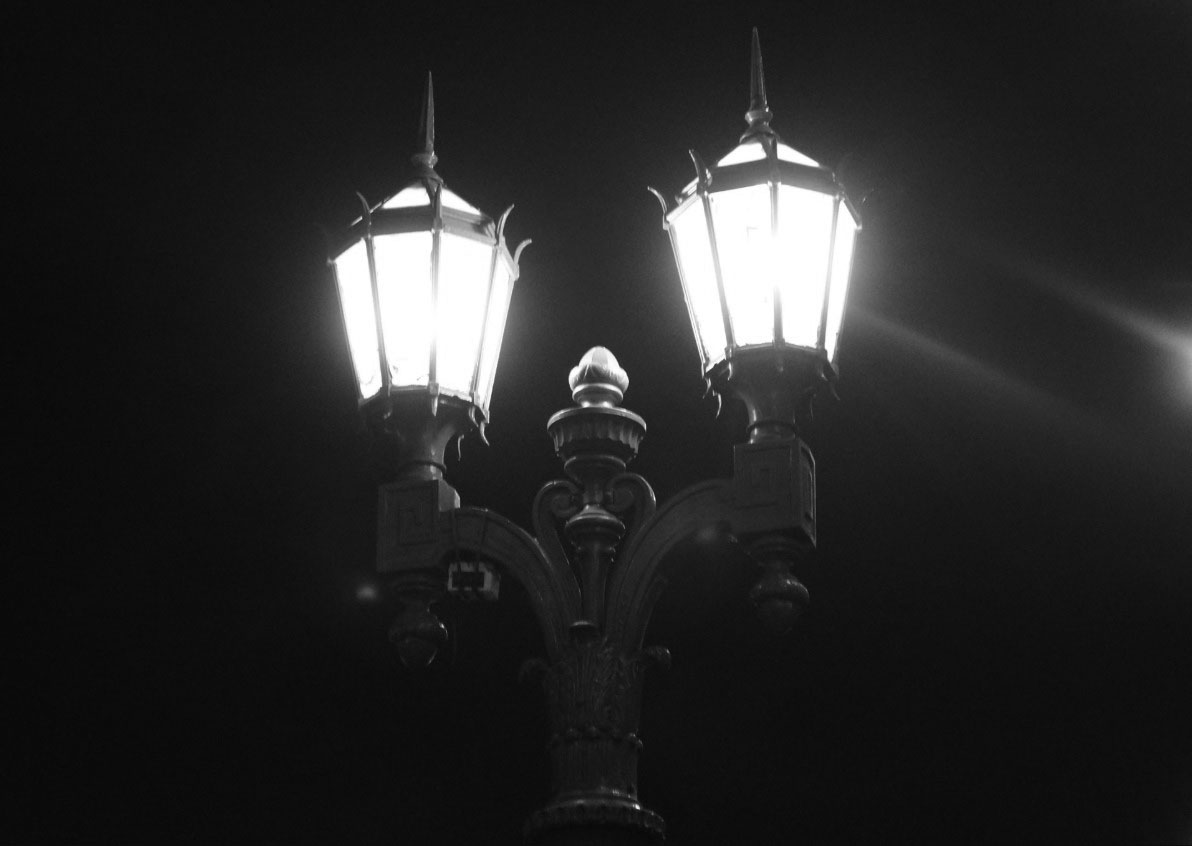 |
|
| (2017)^ – Close-up view showing a two-lamp ‘Metropolitan’ streetlight located on Ivar Street, just south of Hollywood Blvd. Photo courtesy of Glen Norman |
Historical Notes The ‘Metropolitan’ is still quite common in Hollywood. They started to appear around 1924 and are celebrating their 95th Anniversary this year (2019). |
'Pacific' Dual Lamp Streetlight (UM-1747)
 |
|
| (2019)^ - View showing a UM 1747 'Pacific' dual-lamp Electrolier located on Pico Boulevard west of Downtown L.A. This is from Union Metal's Pacific Line. It's a replica of the original UM's installed in the 1920s (see next photo). The 'Pacific' looks similar to the 'Metropolitan' seen in previous photo. |
Historical Notes This street light was installed around 2014. Manufactured by Union Metal (‘Pacific’ line), the same company that manufactured the circa 1920s originals (which can still be found West of Robertson). |
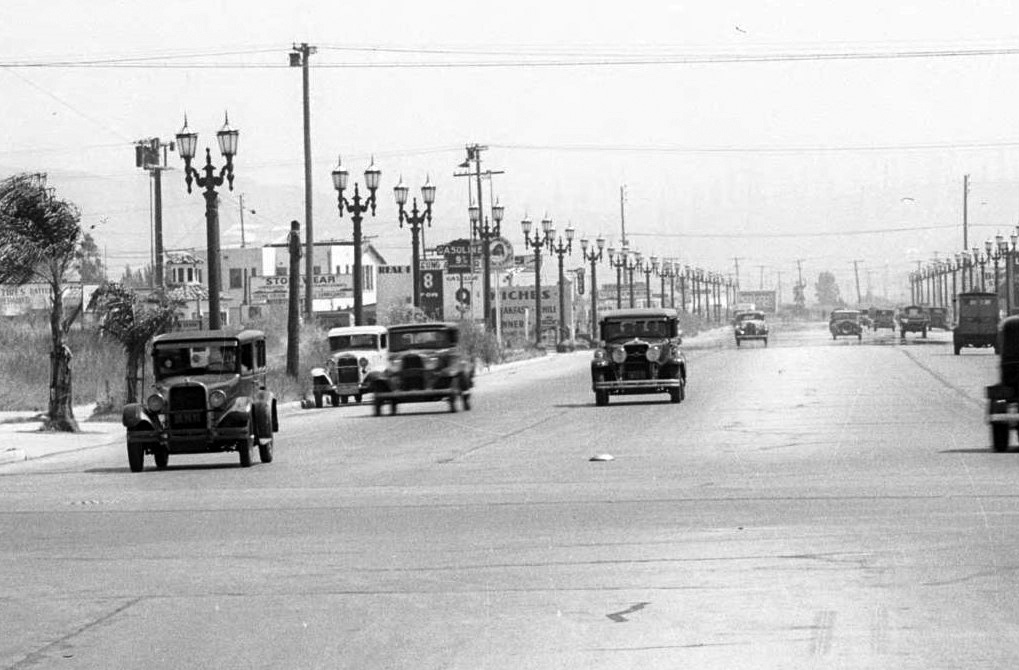 |
|
| (1935)* - View looking south on La Cienega at Pico Boulevard showing a dual-lamp Union Metal "Pacific' streetlights lining both sides of the street. |
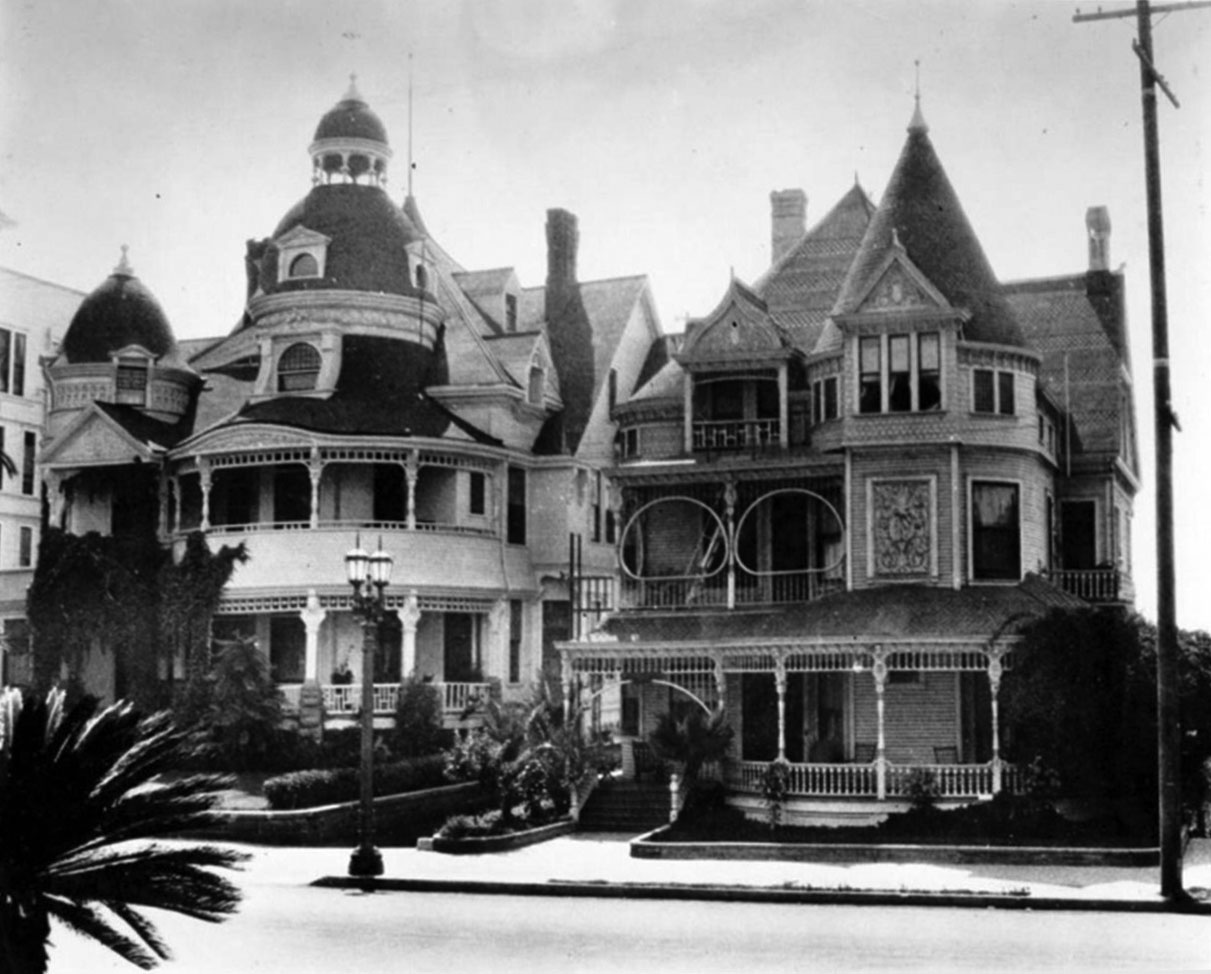 |
|
| (ca. 1930s)^ - View from across the street on Bunker Hill of two Victorian style hotels on the 100 block of S. Grand Ave., the Richelieu (at 142) on the right and the Hotel Melrose (at 130) on the left. A dual-lamp 'Pacific' stands in front of the buildings. |
Historical Notes If still standing today, the view from the porch of these buildings would be that of Disney Hall, located directly across the street, on the other side of Grand Ave. Click HERE to see more in Early LA Historic Buildings (1800s). |
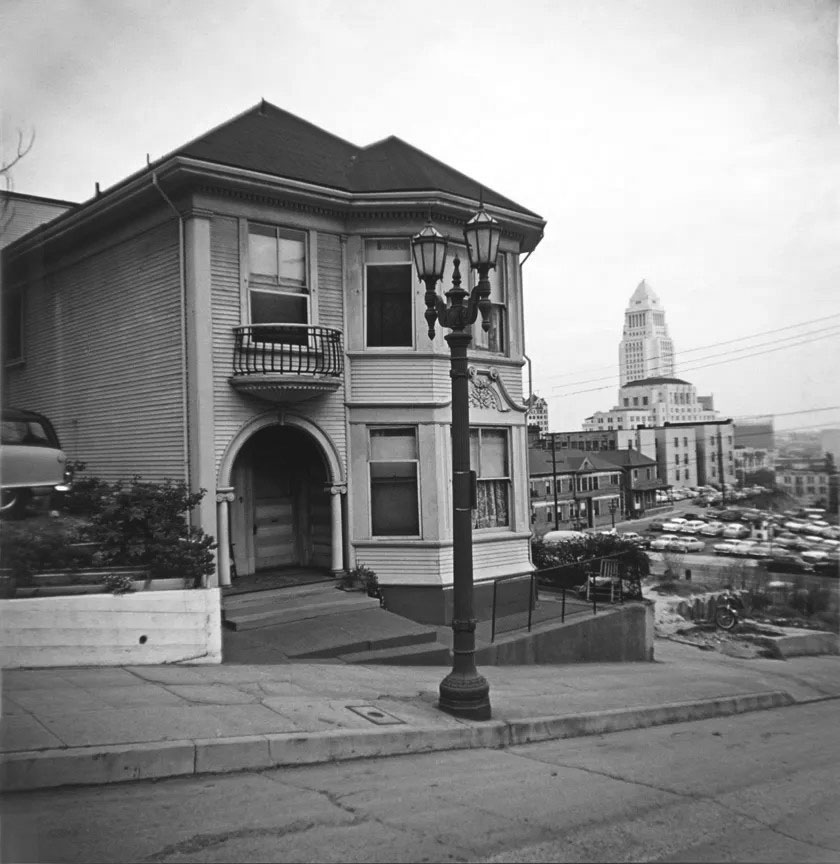 |
|
| (ca. 1965)* – A decorative dual-lamp ‘Pacific’ (UM-1747) stands in front of the Koster House, a Queen Anne style residence at 507 W. Second Street on Bunker Hill. The Los Angeles Times Building, and City Hall are seen in the distance on the right. |
Historical Notes The above street light is a Union Metal UM-1747 "Pacific" model with GE Form 18-B lanterns. They were found all over Bunker Hill until the neighborhood was bulldozed into oblivion. Only one Bunker Hill example survives as of 2021. It's on the East side of Olive Street, just South of 4th Street. Click HERE to see more 'Pacific' UM 1747 dual-lamp streetlights (Contemporary Views) |
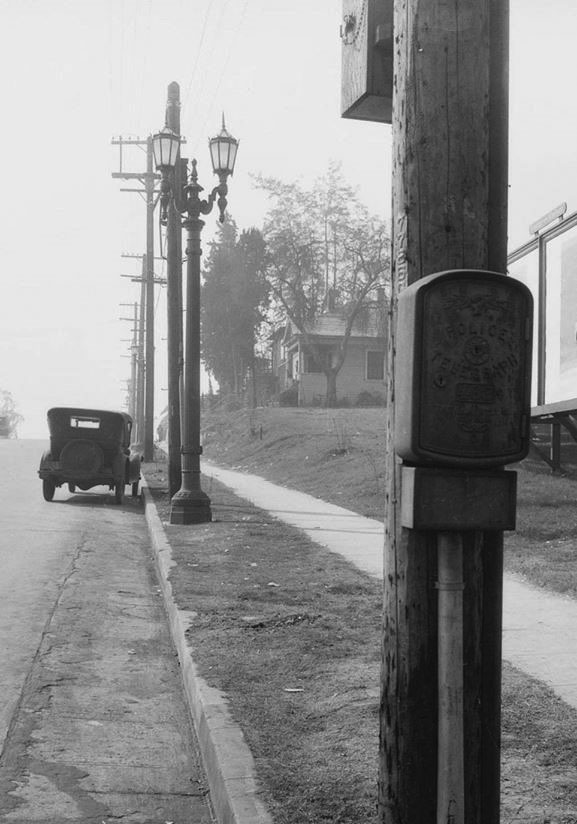 |
|
| (1930)^ – View looking south on Alvarado Street at Temple Street showing a Police Call Box mounted on a power pole in the foreground with an ornate two-lamp 'Pacific' (UM 1747) streetlight seen in the background. |
Historical Notes The LAPD installed call boxes in 1903. Before that, officers had to go to headquarters on foot with a message, or headquarters had to send a runner to find them. Call boxes let officers check in at intervals, using a key to unlock the box. Later—probably in the Thirties—dial telephones replaced the direct lines. And much later, walkie-talkies made call boxes obsolete.* |
* * * * * |
Streetlight Time Switches
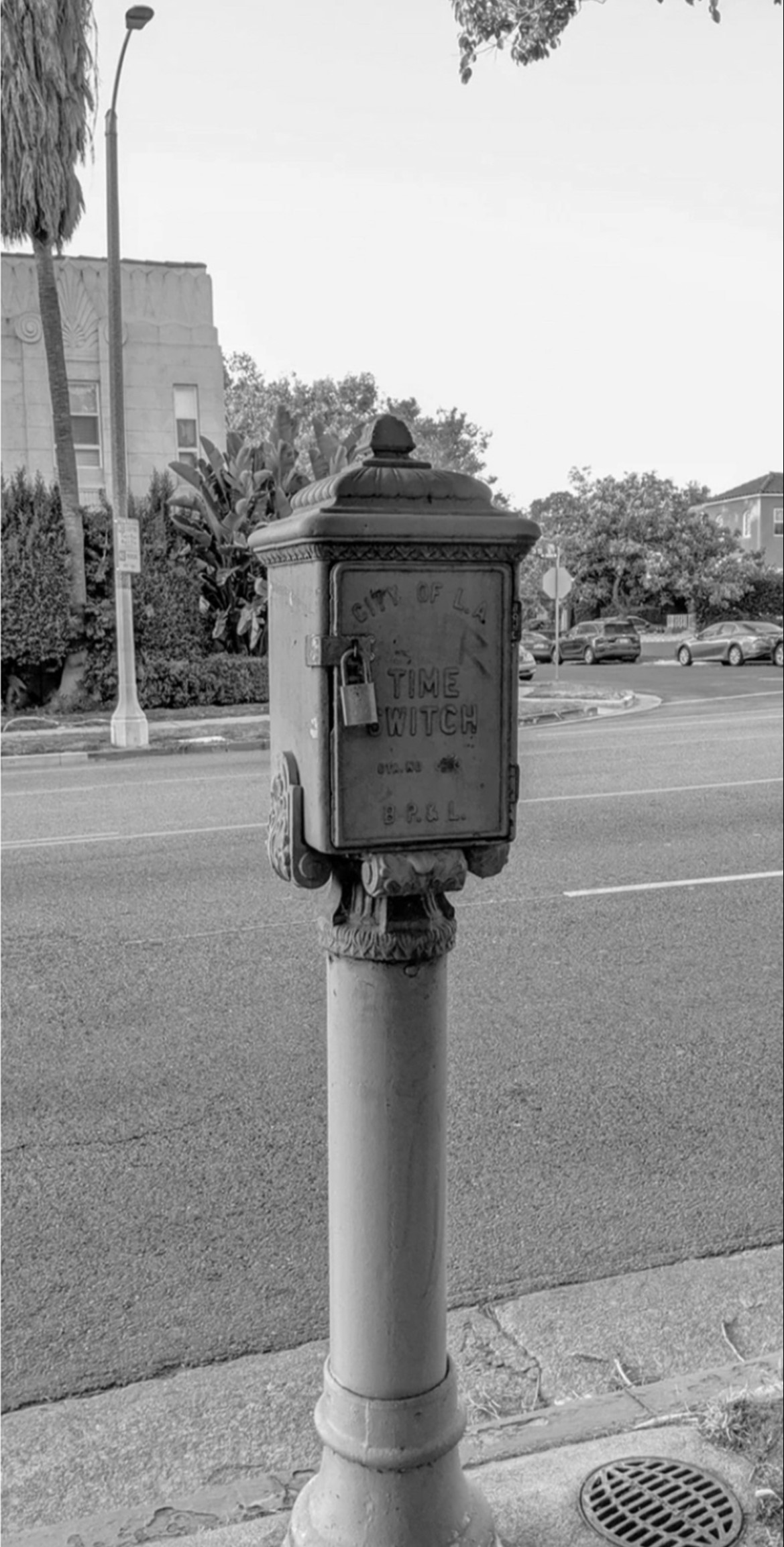 |
|
| (ca. 2010s) - An old LA Bureau of Power and Light streetlight time switch is seen here at 3rd Street and Mansfield Avenue. Photo courtesy of Michael Navarro |
Historical Notes Both high voltage and low voltage time switches were installed in the early part of the 1900s by the Bureau of Power and Light. These were used to control streetlight electrolier circuits through the city. Some of these still exist today. |
 |
|
| (ca. 2010s) - Close-up view of a streetlight time switch installed by the L.A. Bureau of Power and Light in the early 1900s. Photo courtesy of Michael Navarro |
Historical Notes The keystone Iron Steelwork Company from Los Angeles (1917-1928) made fire alarm/police call boxes, streetlight time switches, and fire hydrants. Some streetlight time switches are still in service while others are not but remain for historical value throughout the city. More detailed information can be found on these time switches in a 1947 DWP Streetlight Manual (Page 24). |
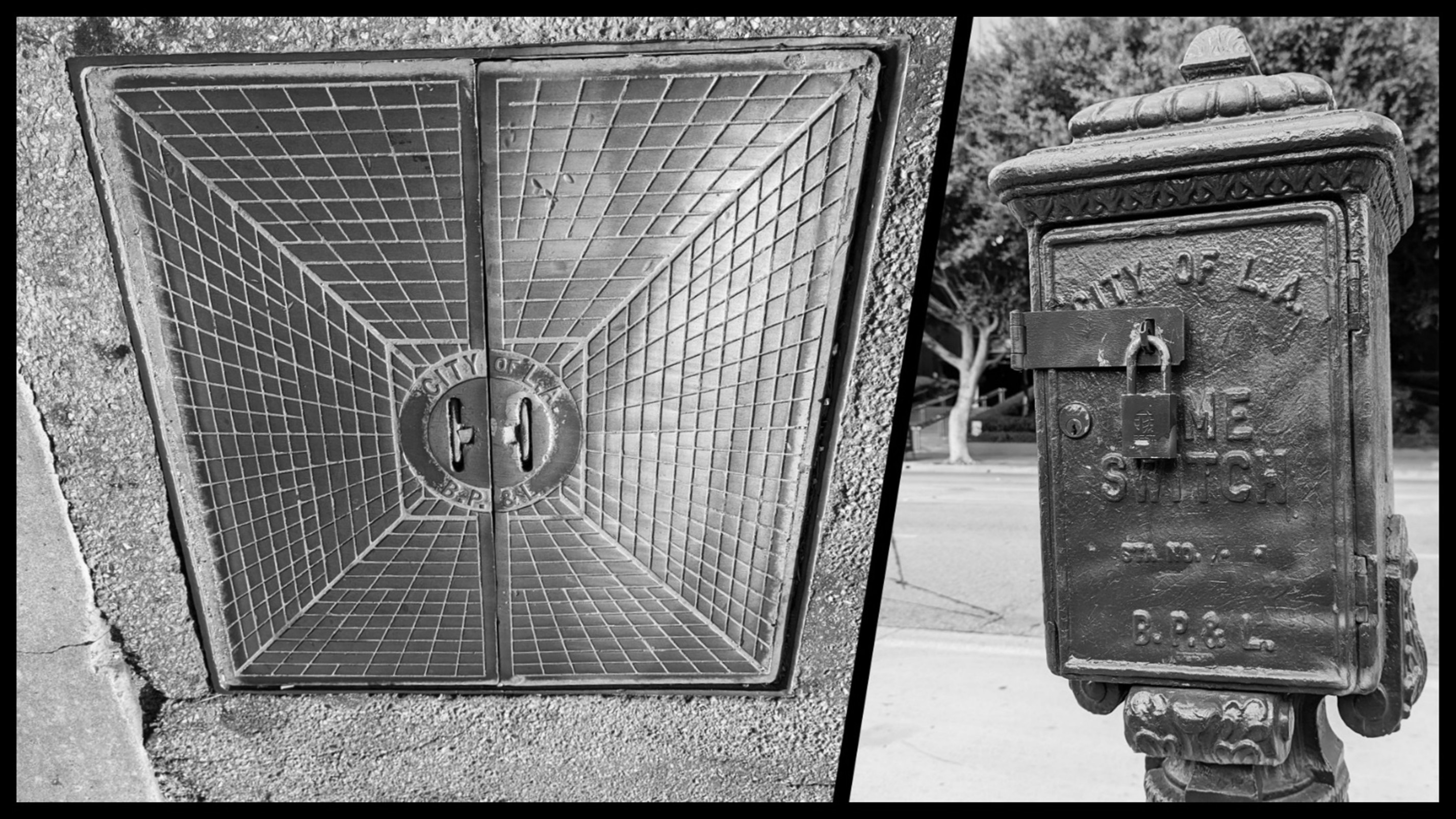 |
|
| (2023)* - An old LA Bureau of Power and Light manhole cover (left) and time switch pedestal (right) located on Wilshire Boulevard. Photo Courtesy of Esotouric's Secret Los Angeles |
* * * * * |
The Winslow (Five-Globe Llewellyn Electrolier)
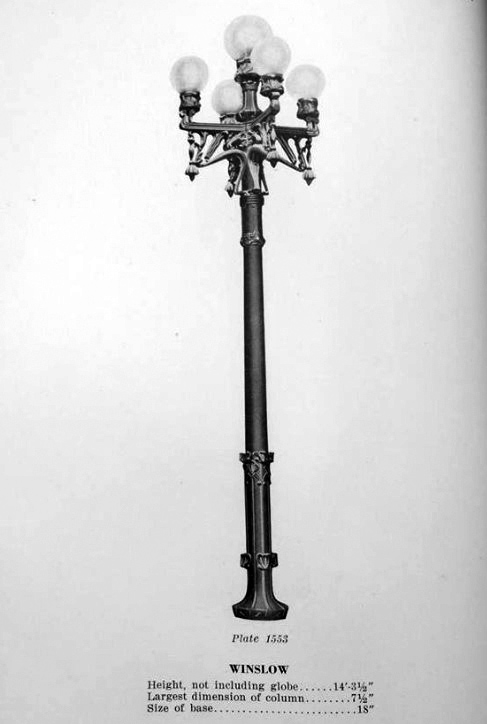 |
|
| (1928)* - The "Winslow" electrolier shown here in the 1928 Llewellyn Iron Works Catalog. This streetlight was found on Hill Street in downtown Los Angeles. |
Historical Notes The most common of the incandescent multiple globe electroliers of the early 1900s were those manufactured by the Llewellyn Iron Works of Los Angeles. The firm became so identified with this style of street light that any multiple globe electrolier became commonly known as a Llewellyn. The Llewellyn Iron Works, founded in 1889‐1890, was one of the largest metal working facilities in Los Angeles. It manufactured structural steel – including that for the Bradbury Building. |
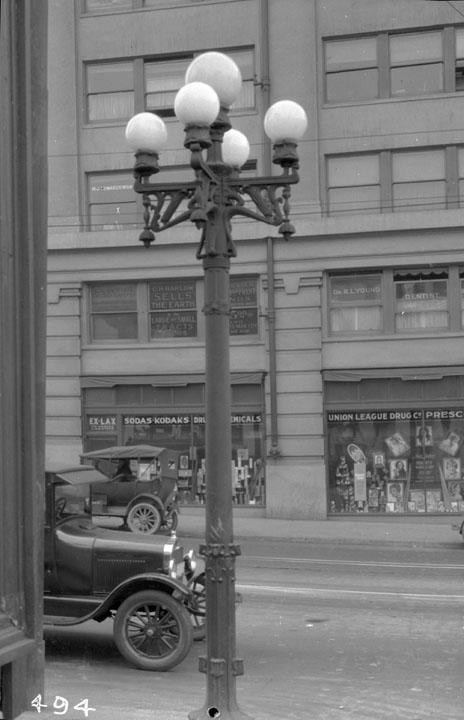 |
|
| (ca. 1931)^ - Close-up view of an early 5-globe street light ('Winslow') on the corner of Second and Hill streets |
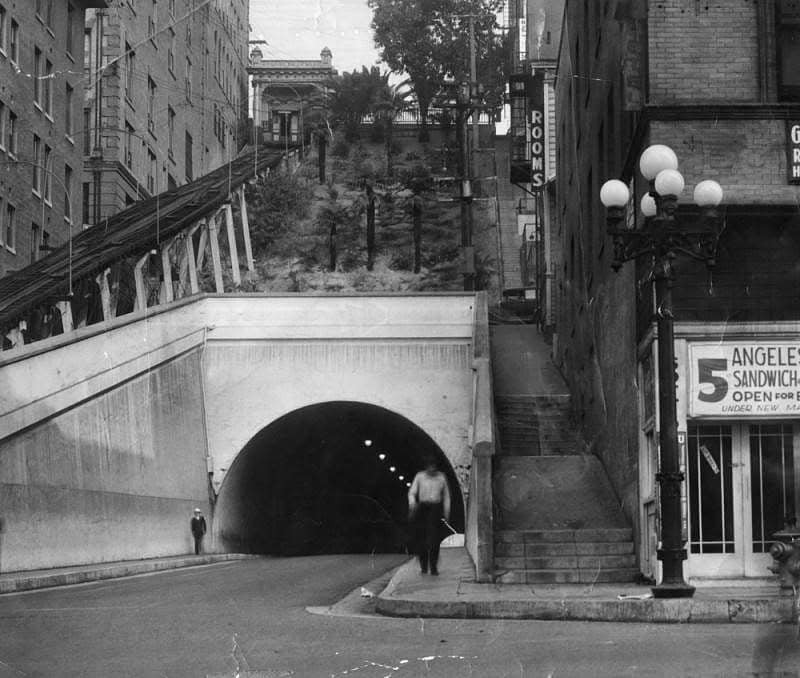 |
|
| (1934)* - A Five-Globe Winslow streetlight stands on the northwest corner of Hill and Third Streets, with the Third Street Tunnel and Angels Flight visible to the left. |
Historical Notes Angels Flight and the Third Street Tunnel were significant landmarks in 1930s Los Angeles, representing the city's early efforts to overcome geographical challenges and facilitate urban growth. Angels Flight, a funicular railway inaugurated in 1901, provided a crucial transportation link between the downtown area and Bunker Hill. By the 1930s, it had become an integral part of daily life for many Angelenos, particularly workers commuting between the Downtown Historic Core and Bunker Hill. The railway's efficiency was remarkable, with estimates suggesting it had carried more passengers per mile than any other railway in the world during its first fifty years of operation. |
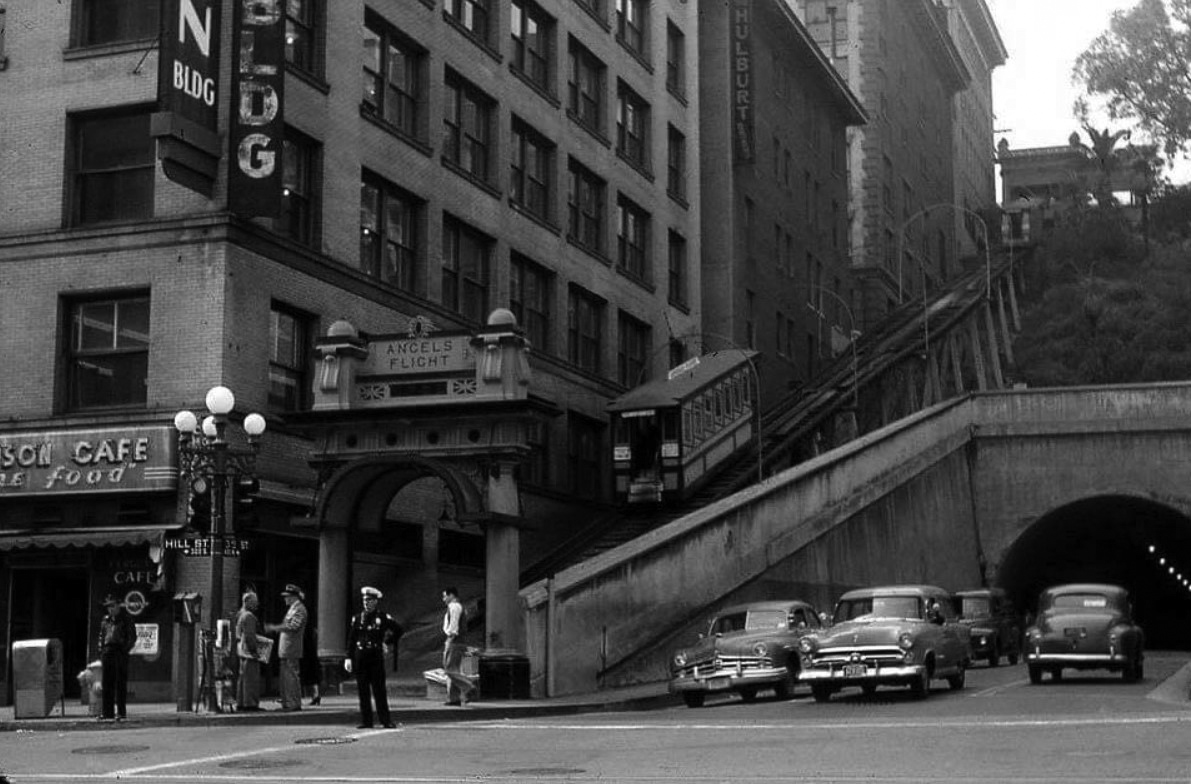 |
|
| (1950s)* - View looking at the SW corner of 3rd and Hill streets showing a “Winslow” 5-bulb electrolier in front of Angels Flight with the Third Street Tunnel seen on the right. Note that the Llewellyn has lost one of its arms to accommodate the new R-Y-G traffic signal. |
 |
|
| (1953)* - The #11 Temple Street bus enters the north portal of the Hill Street tunnel heading south. Note the ornate “Winslow” 5-bulb electroliers on the left. |
Historical Notes Within two years of the above photo, the entire hill, including the tunnels, would be leveled as part of the Bunker Hill Redevelopment Project. There are no 5-bulb Winslow Eletroliers left today. The model is extinct. |
* * * * * |
Five-Globe Electroliers
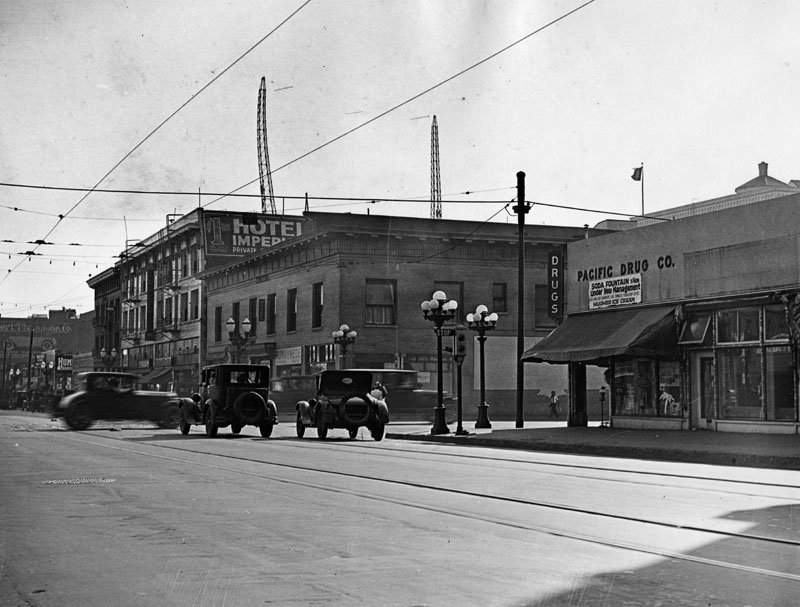 |
|
| (1931)^ - Street lights at the corner of Grand Avenue and 9th Street. |
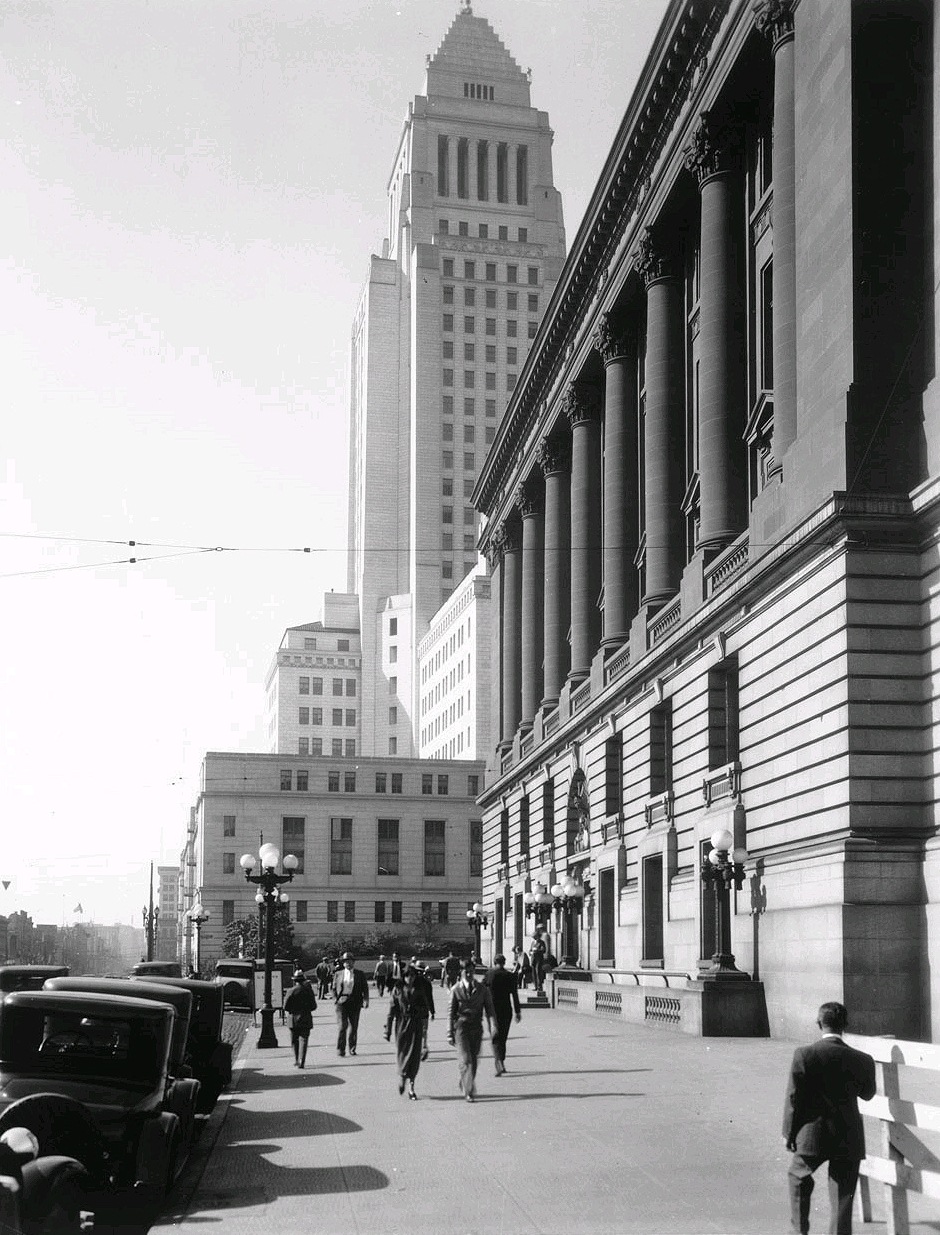 |
|
| (1931)^^* - Looking south on Main Street at least seven 5-bulb decorative lamps can be seen in front of the old Federal Building/Post Office adjacent to City Hall. |
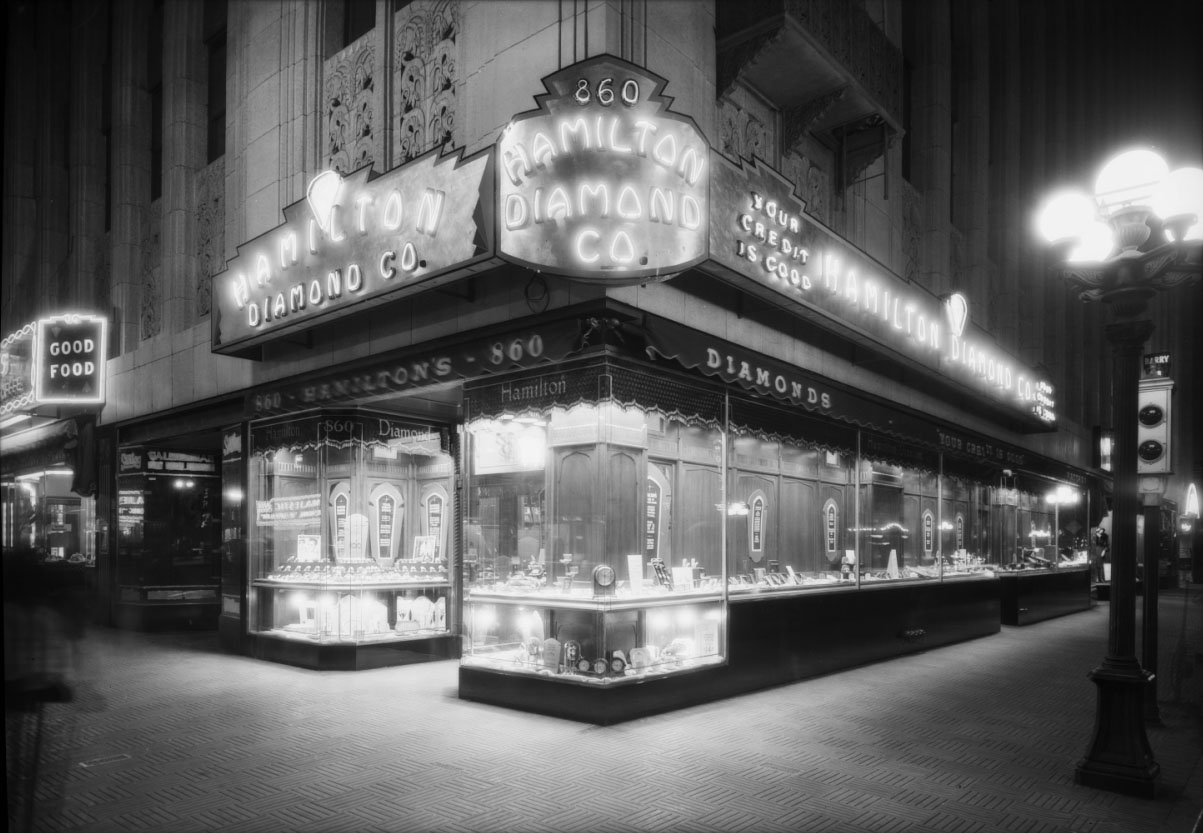 |
|
| (1930)*^^ - A 5-lamp ornate electolier helps light up the northeast corner of Broadway and 9th Street with the Hamilton Diamond Company store in the background. |
Click HERE to see more 5-globe Llewellyn Electroliers (1900+) |
* * * * * |
Dual Lamp Marbelite 1900s
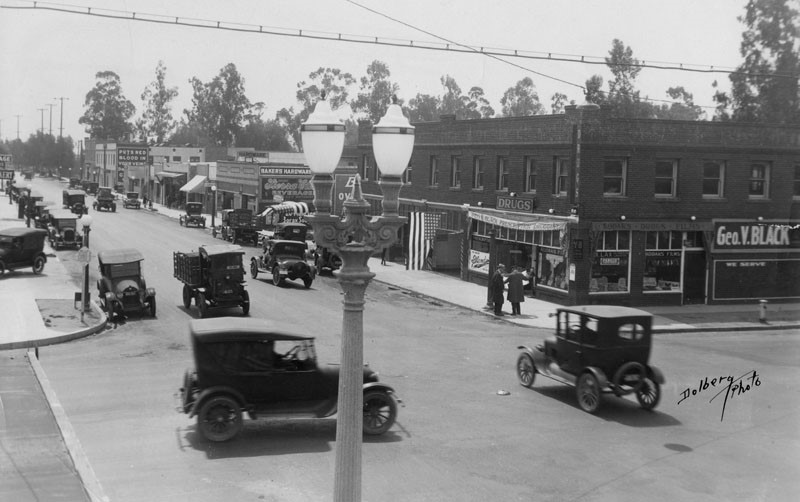 |
|
| (1920s)^ - An ornate dual-lamp Marbelite 1900 streetlamp stands tall on the SE corner of Los Feliz Boulevard and San Fernando Road. |
Historical Notes The dual-lamp Marbelite 1900 streetlight was a distinctive ornamental street lighting fixture used in Los Angeles in the early 20th century. Here are the key details about this streetlight model: Manufactured by the Marbelite Corporation Distinctive squarish base Dual lamps mounted on a single pole Concrete or cast iron construction Often had a fluted, tapering column Plain glass globes covering the lamps |
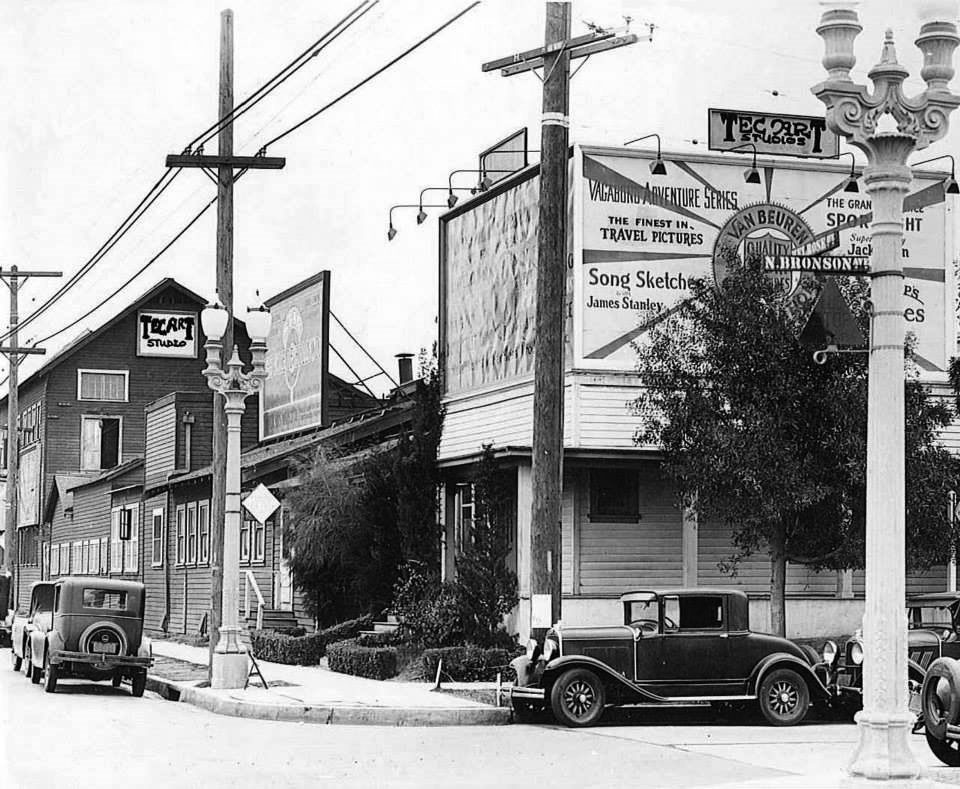 |
|
| (1927)^^* - View looking southeast at the intersection of Melrose and Bronson avenues showing two ornate dual-lamp electroliers. Today, Raleigh Studios is located at this corner. |
Historical Notes The twin street lights along Melrose were the Marbelite 1900 model, distinguished by its squarish base. The Melrose lights were removed around 1950, but there are a few survivors fairly close by. Wilshire Boulevard on the west side also had similar streetlights in the 1930s. |
Then and Now
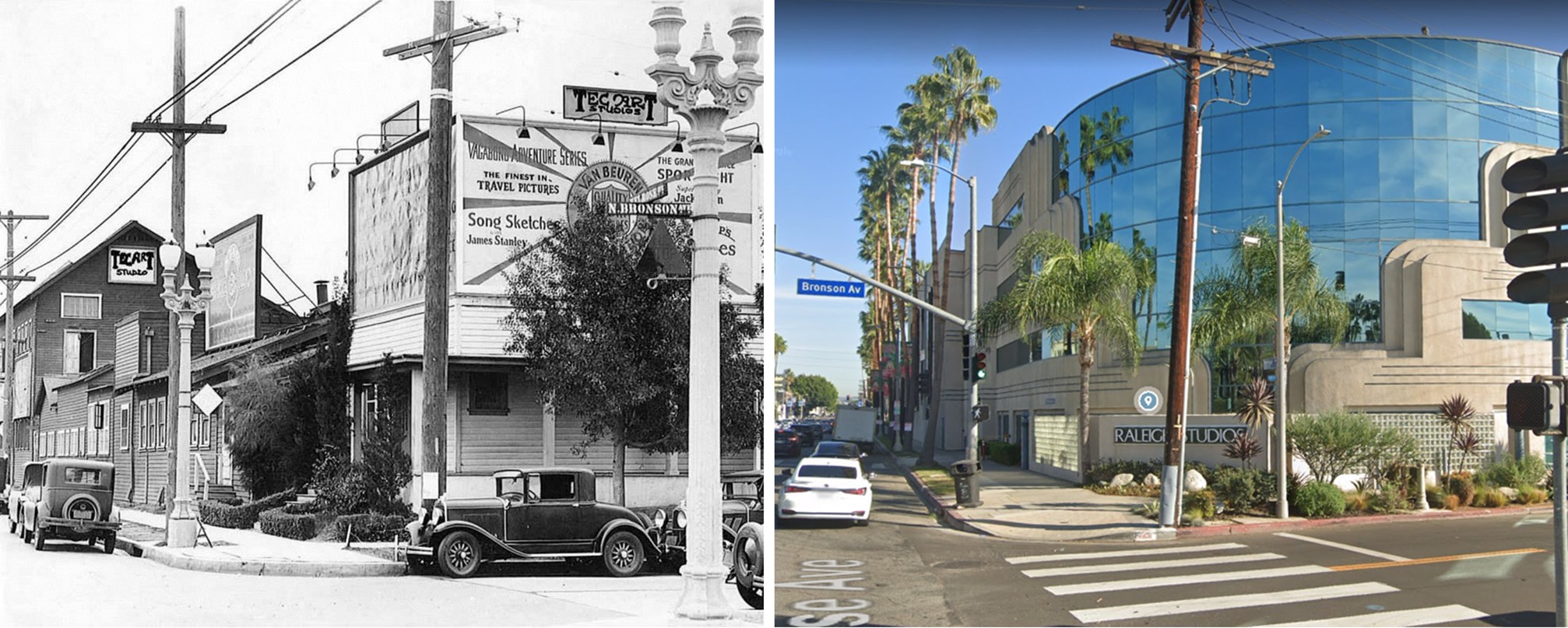 |
|
| (1927 vs 2021) - SE Corner of Melrose and Bronson. |
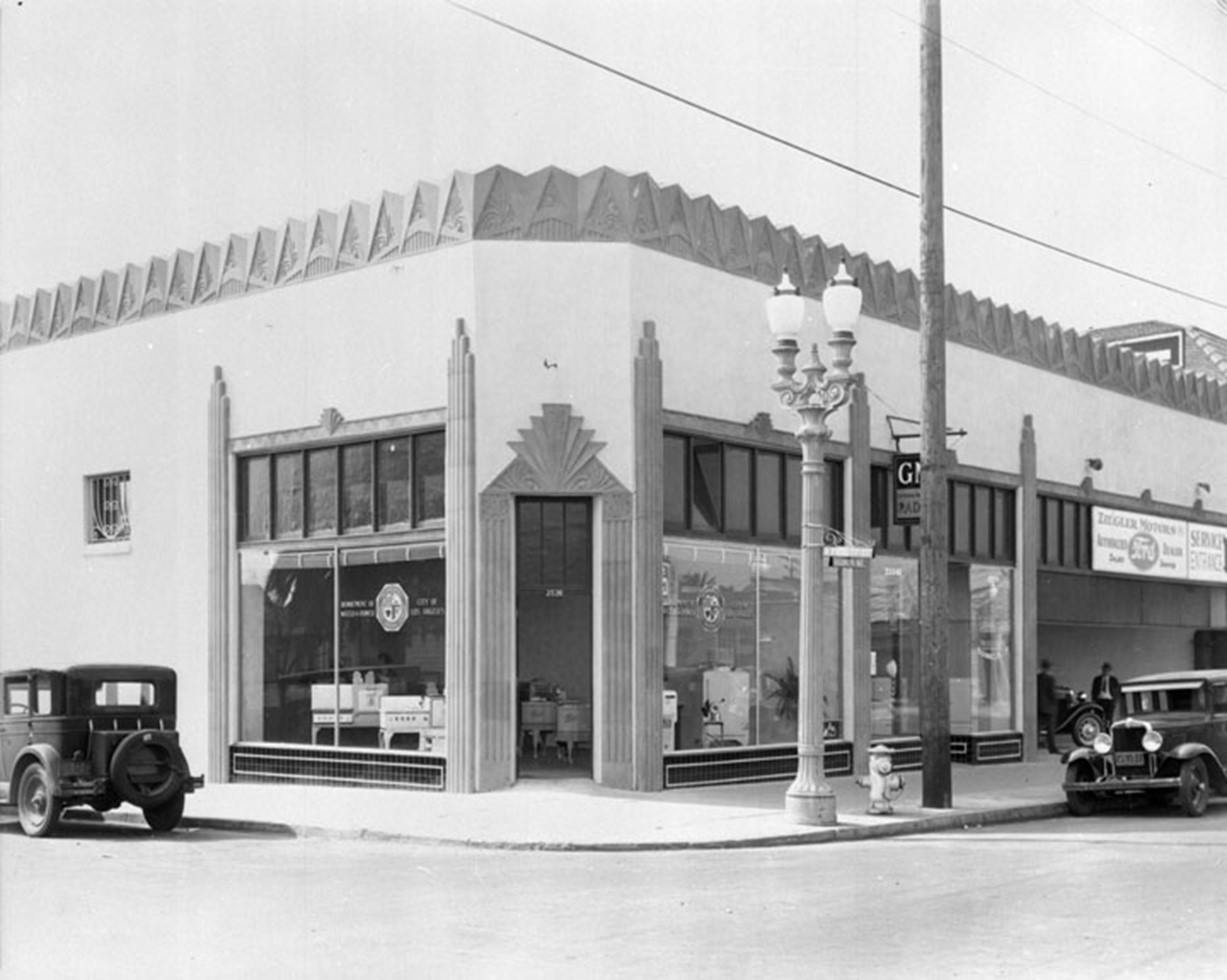 |
|
| (1933)* - View of a dual-lamp electrolier in front of the Art Deco-Style DWP commercial branch office on Brooklyn Avenue. |
Historical Notes Click HERE to see more Early DWP Commercial Branch Offices. |
 |
|
| (1933)* – Ornate two-lamp Marbelite 1900 streetlight in front fo the Art Deco-style Bell and Howell Building at 716 N. La Brea Ave. |
Historical Notes The Bell & Howell Building, located at 716 N. La Brea Ave in Los Angeles, is a distinguished example of Art Deco architecture. Constructed in 1928 to serve as the West Coast operations center for the Bell & Howell camera equipment company, it was designed by the architectural firm Edelman & Barnett. The building features classic Art Deco elements, including terra cotta ornamentation, geometric patterns, and vertical emphasis. The main structure is four stories tall, crafted from reinforced concrete, with a tall tower at the center, whose exact height remains unspecified, adding an element of intrigue to its architectural profile. Click HERE to see more on the Bell & Howell Building. |
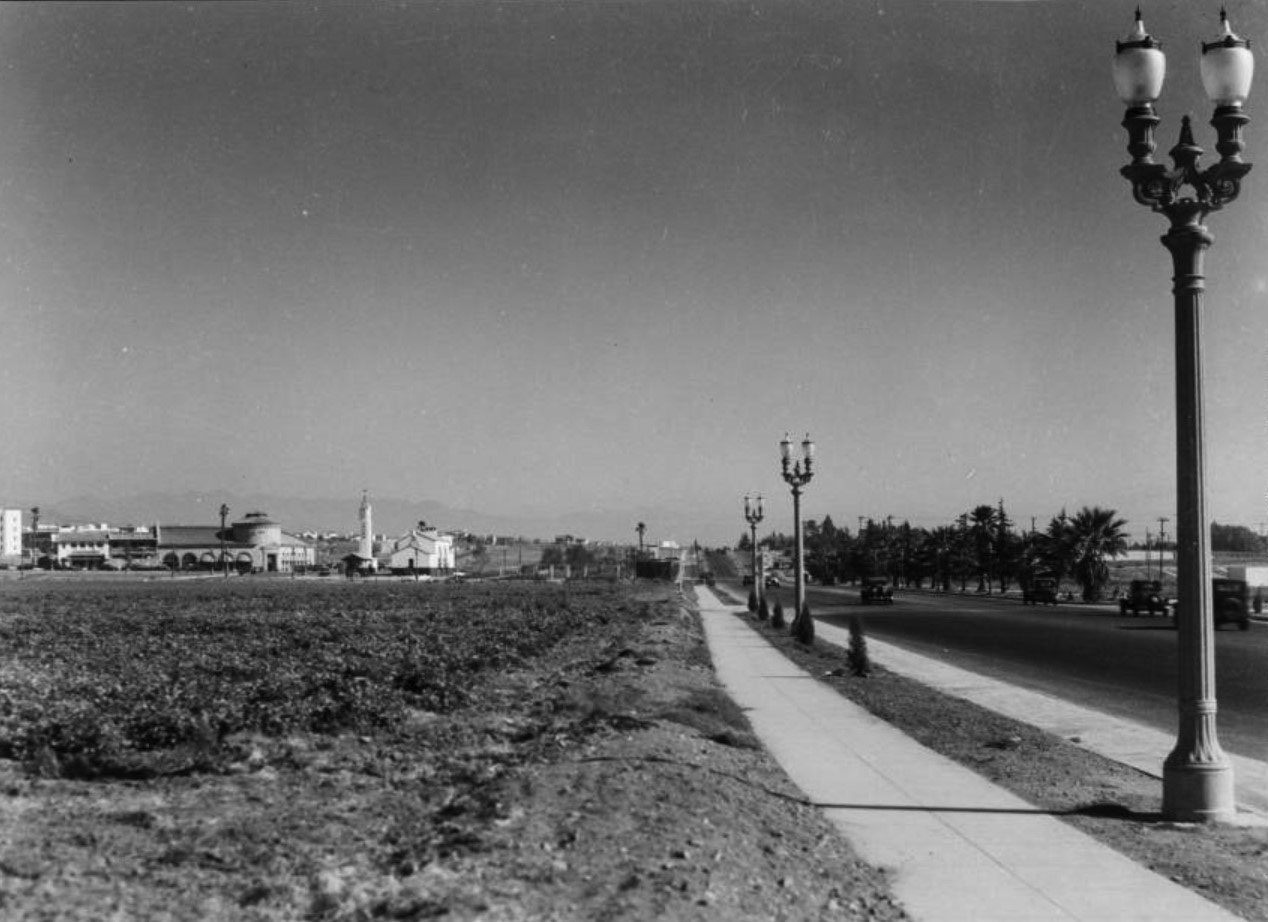 |
|
| (ca. 1930)* - View looking east showing dual-lamp Marbelite 1900 electroliers on Wilshire Boulevard with the new Westwood Village development seen in the background on the left. |
.jpg) |
|
| (ca. 1931)^ - Early dual-lamp Marbelite 1900 streetlights running along Wilshire Boulevard. Note the dirt road. |
.jpg) |
|
| (1931)* – Close-up view showing an ornate dual-lamp Marbelite 1900 streetlight near the NW corner of Fairfax and Drexel avenues with two women followed by two girls walking on the sidewalk nearby. The Richfield Gas Station on the corner is selling regular gas for 8½ cents/gal, with Ethyl going for 11½ cents. Note the beautiful two-lamp streetlight on the corner. |
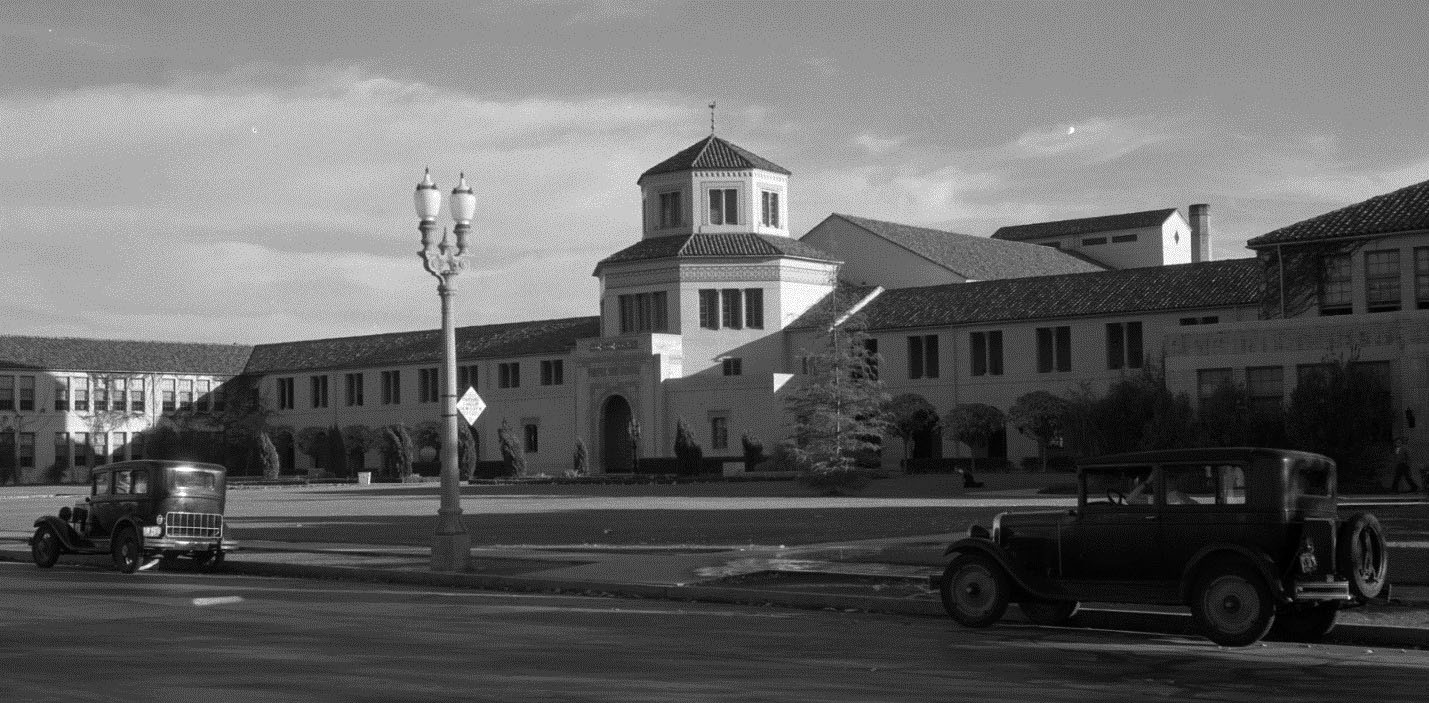 |
|
| (1931)* – View showing a dual-lamp Marbelite 1900 streetlight in front of Fairfax High School located on the south side of Melrose Avenue east of Fairfax Avenue. |
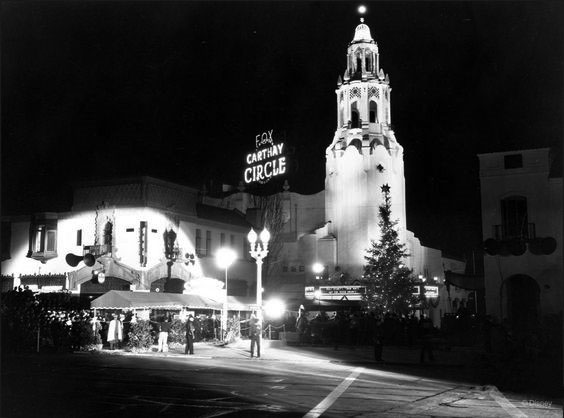 |
|
| (1937)* – Dual-lamp Marbelite 1900 electrolier tries to compete with a spotlight during a premiere at the Carthay Circle Theatre, 6316 San Vicente Boulevard. |
* * * * * |
.jpg) |
|
| (ca. 1930s)* - Ornate dual-lamp street lights in a residential neighborhood.* |
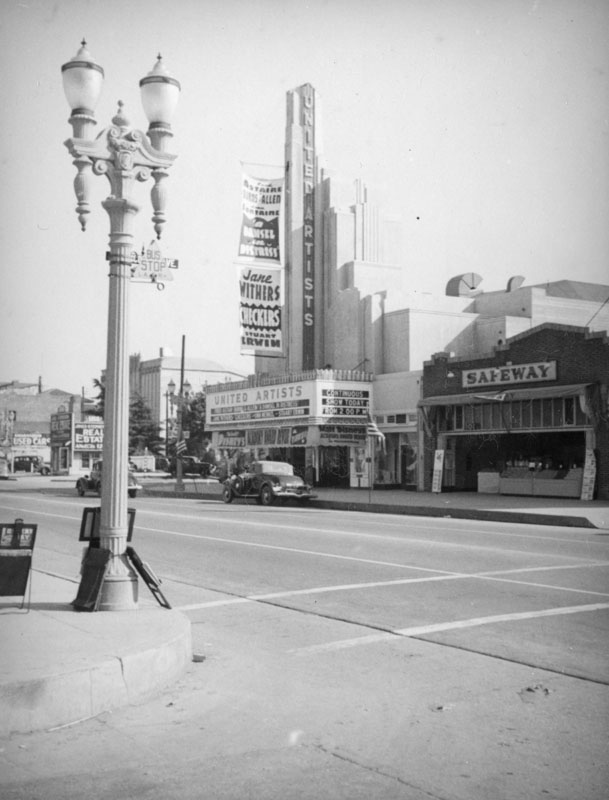 |
|
| (ca. 1938)* - The same type of dual-lamp streetlight as previious photo but in a commercial area. This view looking west on Whittier and Vancouver in East Los Angeles includes from right to left: a Safeway market (5128 Whittier Boulevard), the United Artists Theater, and the Vega Building shops. |
Westinghouse--Llewellyn "California Special"
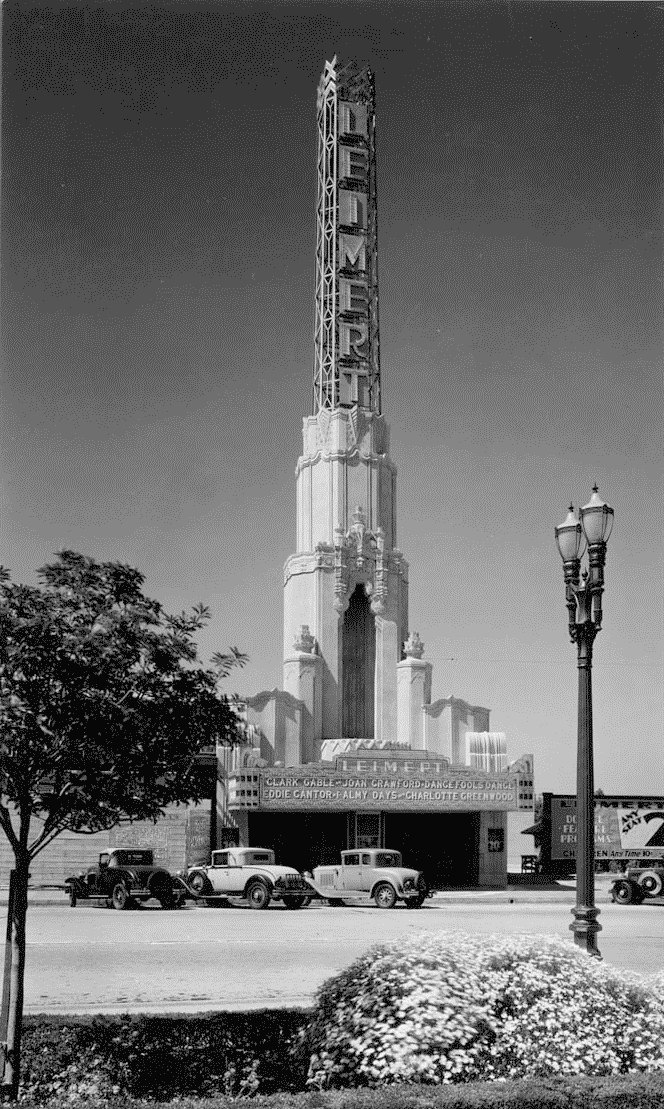 |
|
| (1933)^*# - A dual-lamp "California Special" streetlight stands across the street from the Leimert Theatre at 3341 W. 43rd Pl. in Los Angeles. The theater still stands today in Leimert Park as the Vision Theater. |
Historical Notes The “California Special” was designed by Westinghouse, but produced locally by Llewellyn Iron Works. Chris Burden dubbed these "The Magnolia Double" for his Urban Light sculpture down on Wilshire Blvd. Today, there are still plenty of these to be found on the Magnolia Boulevard between Lankershim and Cahuenga. They were previously found in Leimert Park. Single lamp versions use to line Burbank and Magnolia Blvds. in Burbank, but those are all gone, too. There are eight "California Specials" found around the El Portal Theatre in North Hollywood, four on Lankershim and the other four around the corner on Weddington. These are 21st Century transplants. The California Special was never found on either of those two thoroughfares. |
Sixth Street Bridge
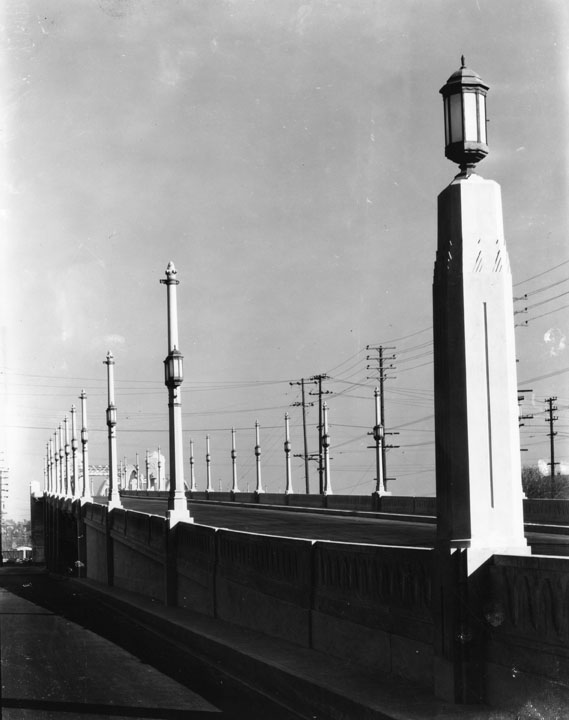 |
|
| (1933)* - Standing on the street beside the bridge, you can see across part of the roadway of the Sixth St. Bridge. The bridge lighting, with its unique design, is placed every few feet. |
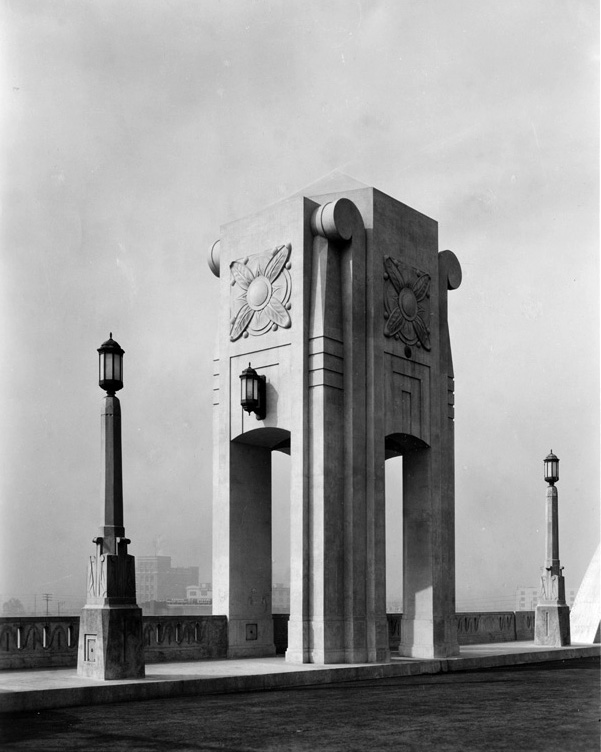 |
|
| (ca. 1933)^*# - View near the center of the Sixth Street Bridge. |
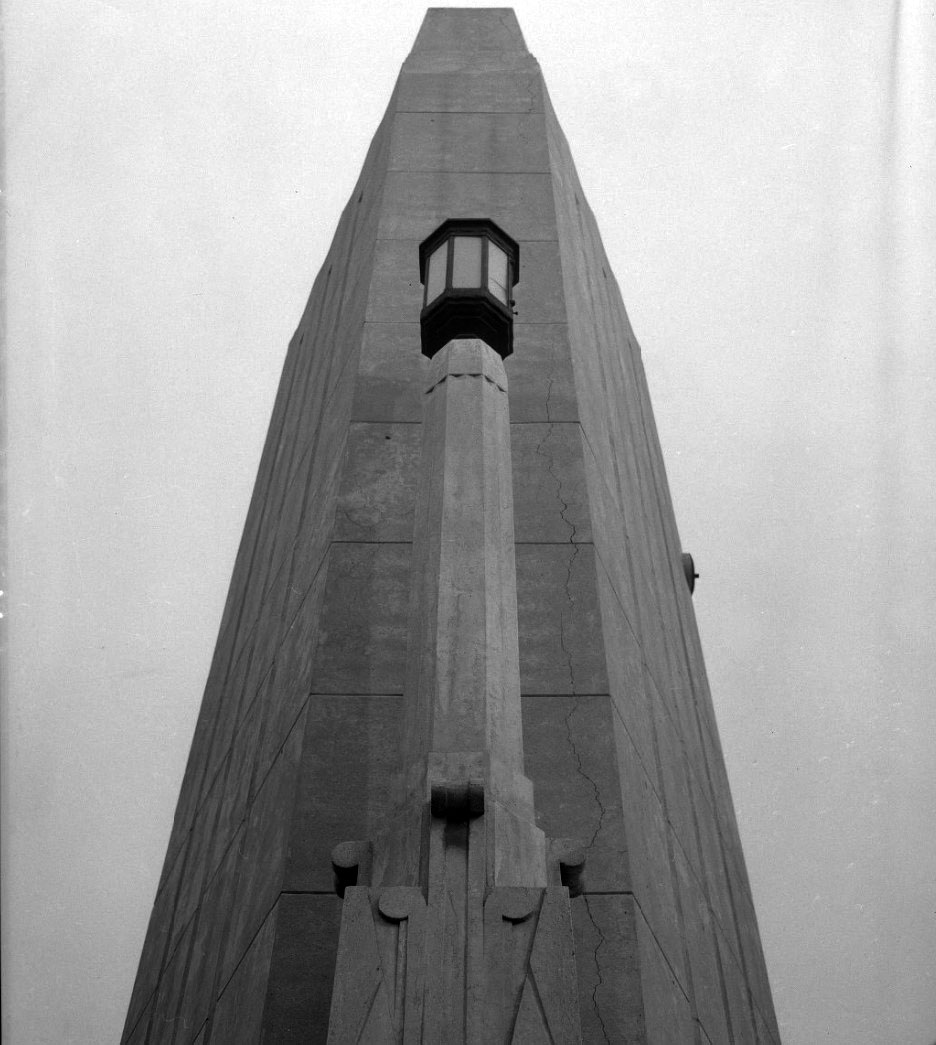 |
|
| (ca. 1930s)* – Close-up view showing an ornate concrete streetlight in front of a pylon-tower on the Sixth Street Bridge. |
Macy Street Bridge
 |
|
| (1933)* - Looking up at the Macy Street Bridge from the ground below. The bridge has dual-lamp electroliers with trolley cable connected to top of the posts. There are also four large pillars (two at each end) with ionic and doric columns and ornate streetlights. |
Historical Notes Originally called the Macy Street Viaduct/Bridge, the Cesar E. Chavez Avenue Viaduct is the second bridge built during large bridge-building program in Los Angeles during the 1920s. The first bridge located on this spot was a wooden, kerosene lamp-lit covered bridge, built in 1870. It was later replaced with a small metal truss bridge. |
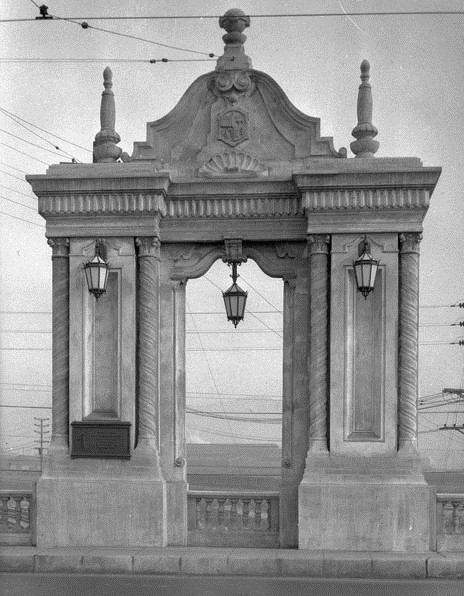 |
|
| (ca. 1933)* - One of four identical decorations on the Macy Street Viaduct, a bridge over the Los Angeles River that is now Cesar Chavez Avenue. The viaduct is in Spanish Colonial Revival style with ionic and doric columns and ornate streetlights. |
Washington Boulevard Bridge
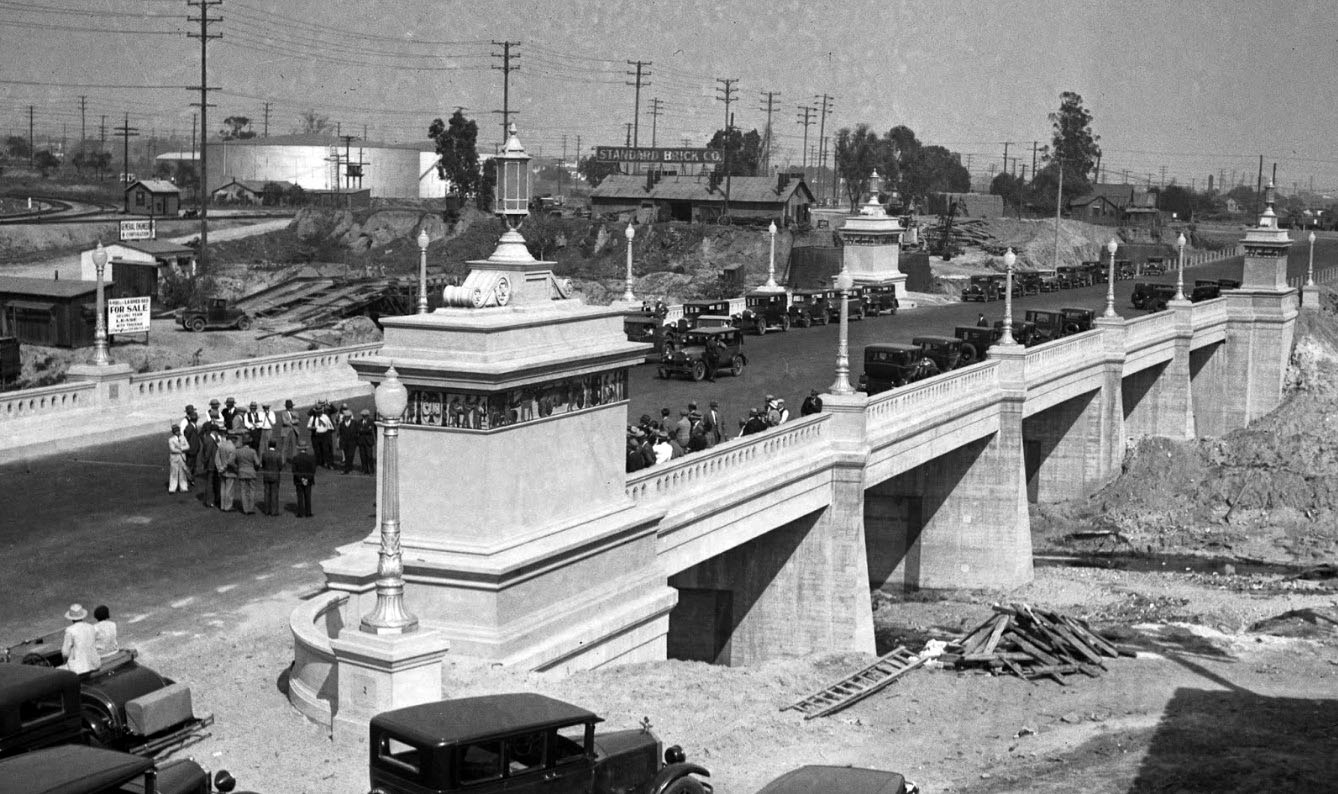 |
|
| (1931)* – View showing opening day ceremonies at the East Washington Boulevard Bridge over the Los Angeles River. The five-span T-girder bridge sits on wide pier walls. Note the two different styles of streetlights running along both sides of the bridge. Photo date: March 31, 1931 |
 |
|
| (ca. 1930s)* - View showing one of four ornamental streetlight posts lcoated on the ends of East Washington Boulevard Bridge. Each base supports a large lamp and also has figures in relief that depicts the various industries located in the area. |
Historical Notes See More Bridge Lighting (College Street Bridge; First Street Bridge; Fourth Street Viaduct; Fourth and Lorena Streets Bridge; Glendale-Hyperion Bridge; Macy Street Bridge; Mulholland Bridge; Sixth Street Bridge; Washington Blvd Bridge) |
General Hospital
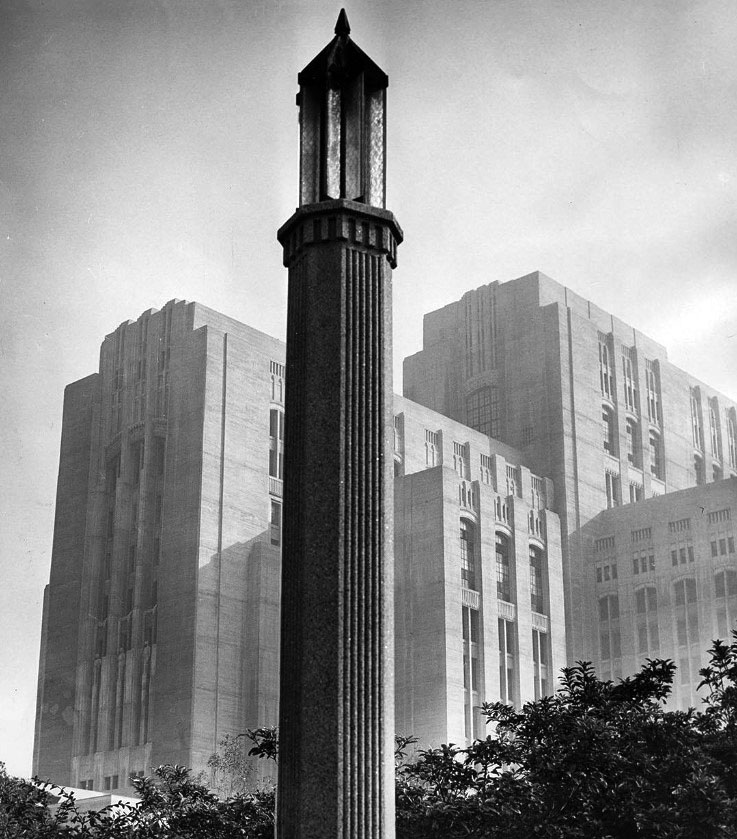 |
|
| (n.d.)^x^ - Looking up at a streetlight that resembles a light house in front of the Art Deco style Los Angeles County General Hosiptial, built 1930 to 1933. LA Times Archives |
Historical Notes The site of numerous significant events in the history of public health, the Los Angeles County + USC Medical Center contains one of the city's most recognizable Art Deco buildings. The facility is located in Los Angeles' Lincoln Heights neighborhood and has previously been known as County/USC and Los Angeles County General Hospital. Click HERE to see more Early Views of the LA County General Hospital. |
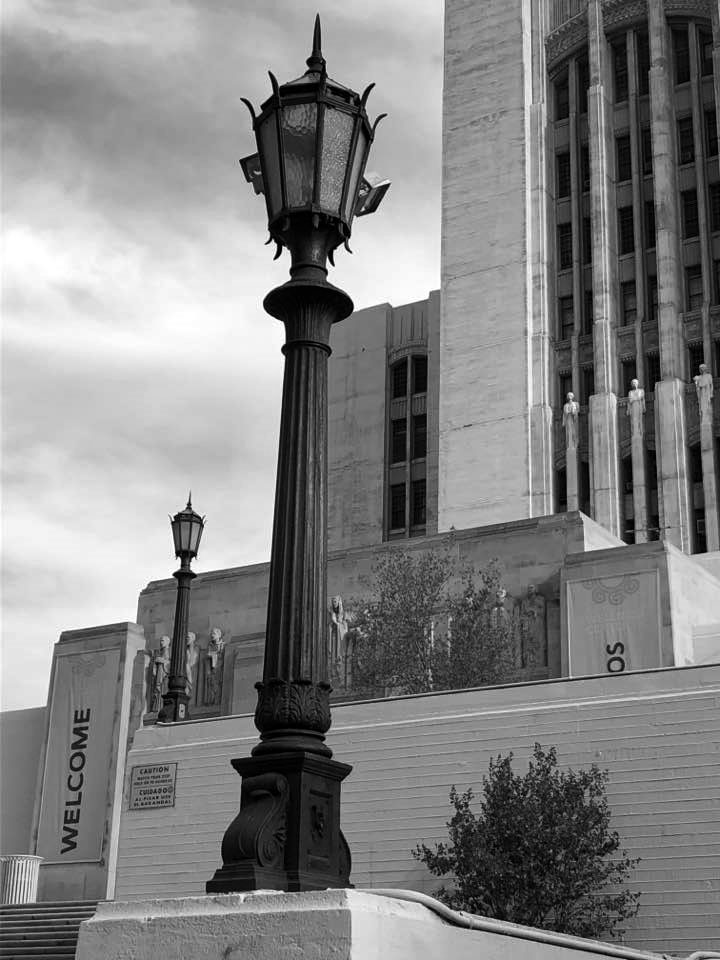 |
|
| (n.d.)^x^ – Ornate street lamps in front of L.A. General Hospital Hospital. Note the high relief scultpures on the front face of the building. Photo courtesy of Edward Grad |
Wilshire Specials
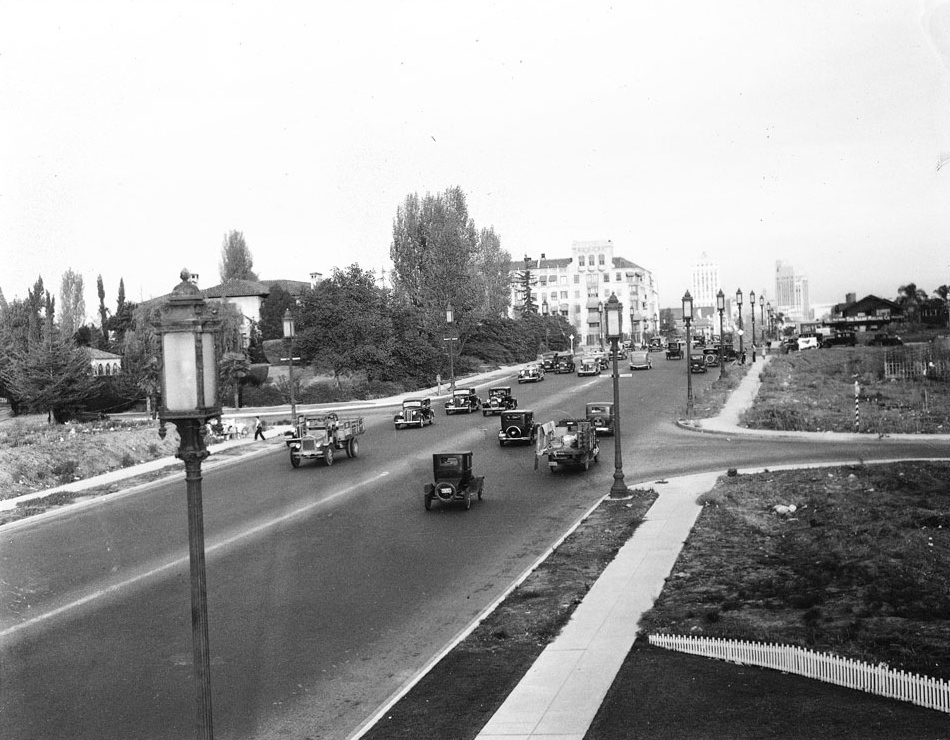 |
|
| (1934)*^ - Photograph of a view of the intersection of Wilshire Boulevard and Crenshaw Boulevard, 1934. At center, a wide, two lane boulevard can be seen extending into the distance where highrise buildings can be seen while at center, a narrower road intersects the wide boulevard. To the left of the center foreground, a street lamp can be seen, beginning a procession that extends down the right side of the road. |
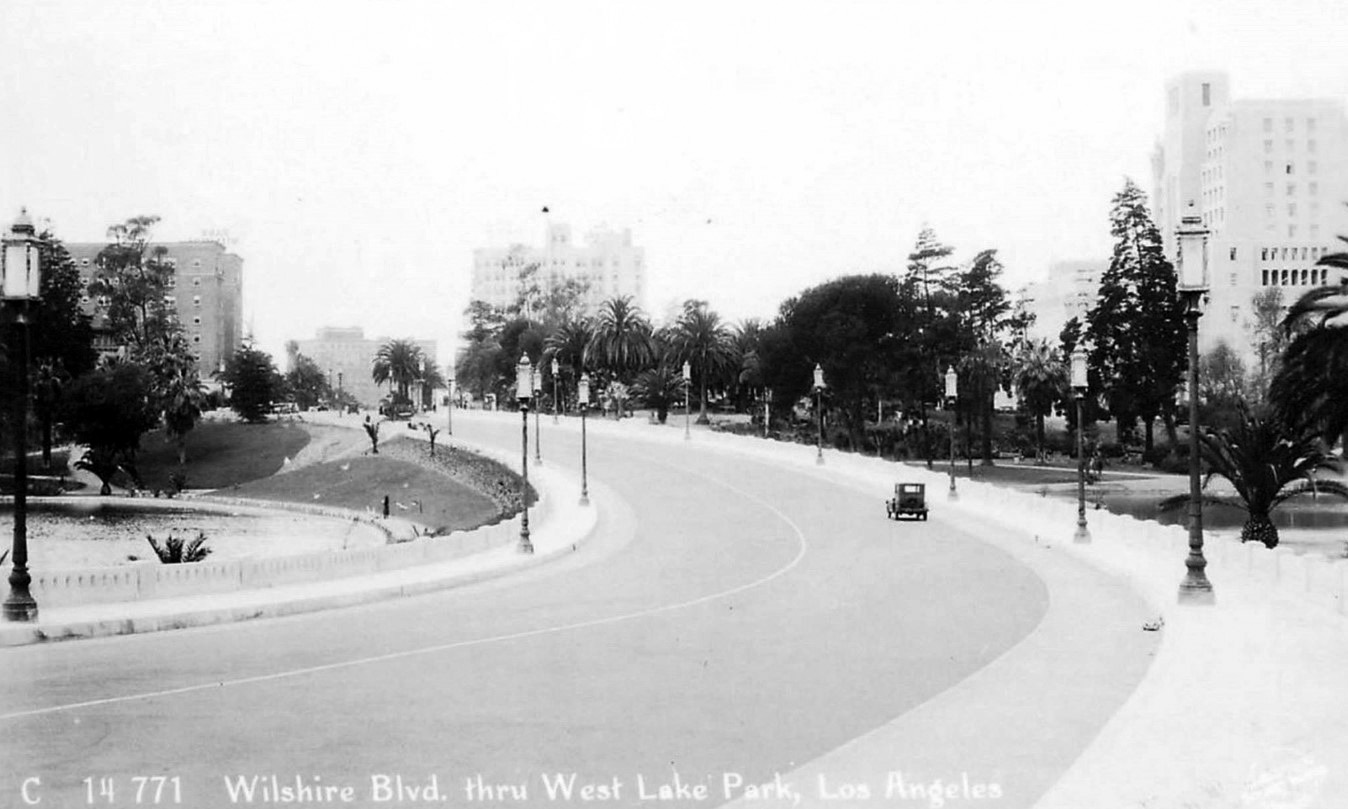 |
|
| (ca. 1934)^^* – Street view looking northwest showing "Wilshire Blvd. thru West Lake Park" (later MacArthur Park) with the "Wilshire Special" streetlights on both sides of the street. |
Historical Notes On May 7, 1942, the Los Angeles Park Commission renamed Westlake Park in honor of Gen. Douglas MacArthur. The decision to rename the park, which had been known as Westlake Park for more than 50 years, was made in preparation for an observance of MacArthur Day on June 13th.*^ Refurbished Wilshire Specials can still be found in downtown LA. (Click HERE). |
Olympic Boulevard
 |
|
| (1934)* - Caption reads: Close-up of new standard in Olympic Boulevard ornamental lighting system, serviced by the Power Bureau – with officials representing State, County and City governments in attendance, the Olympic Boulevard street lighting system was placed in service May 16, 1934, adding another brilliantly lighted thoroughfare to the many already served by the Bureau of Power and Light. |
UCLA
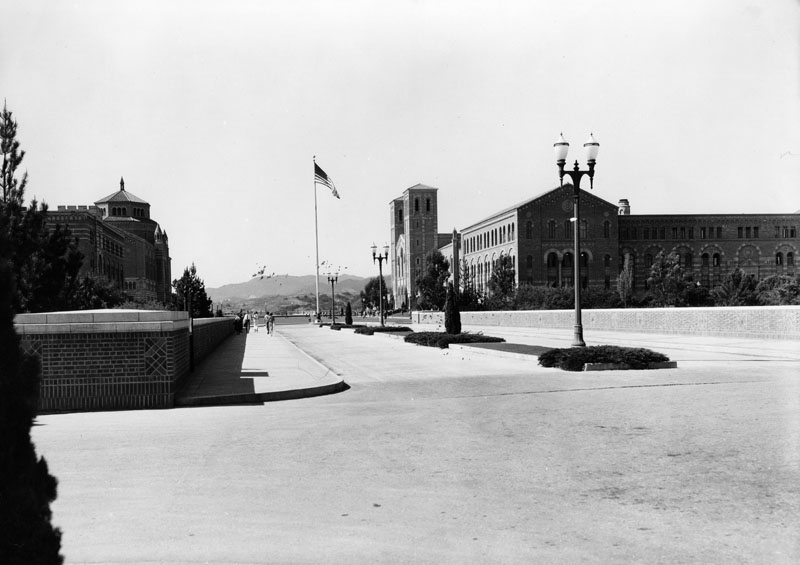 |
|
| (ca. 1935)^ - View looking west at the bridge which connects Hilgard Avenue to the main campus quadrangle at the U.C.L.A. Westwood campus. Decorative two-lamp streetlights can be seen along the center median. |
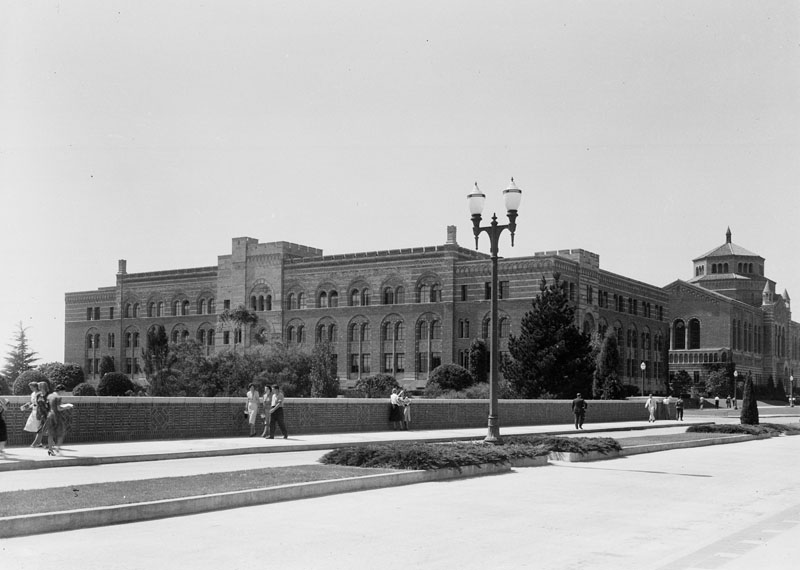 |
|
| (ca. 1935)* - A decorative two-lamp streetlight stands tall in the center median of the road that cross the bridge road connecting Hilgard Avenue to the main campus quadrangle at UCLA. Click HERE to see more in Early Views of UCLA. |
Beverly Boulevard
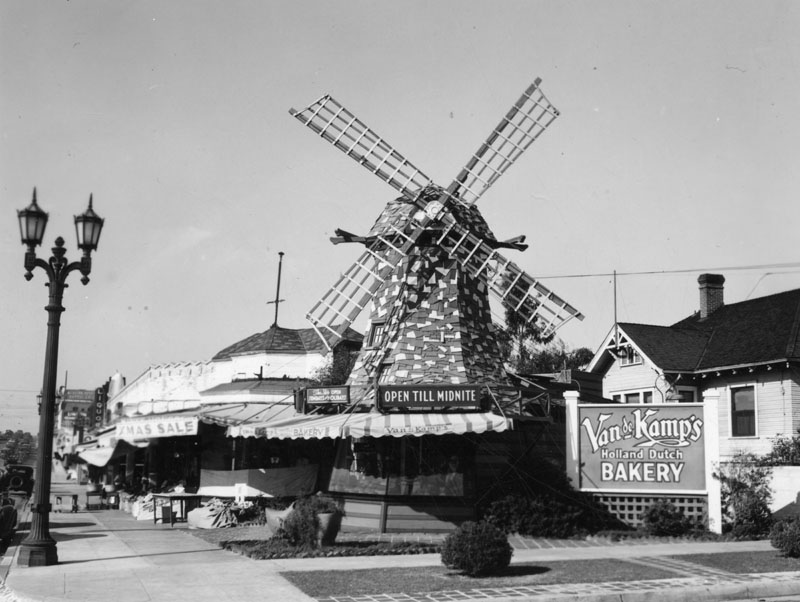 |
|
| (1935)^ - An ornamental two-lamp electrolier standing in front of Van de Kamp's Bakery on Beverly Boulevard and Westmoreland Street, looking west. |
* * * * * |
Hollywood (Metropolitan Standards)
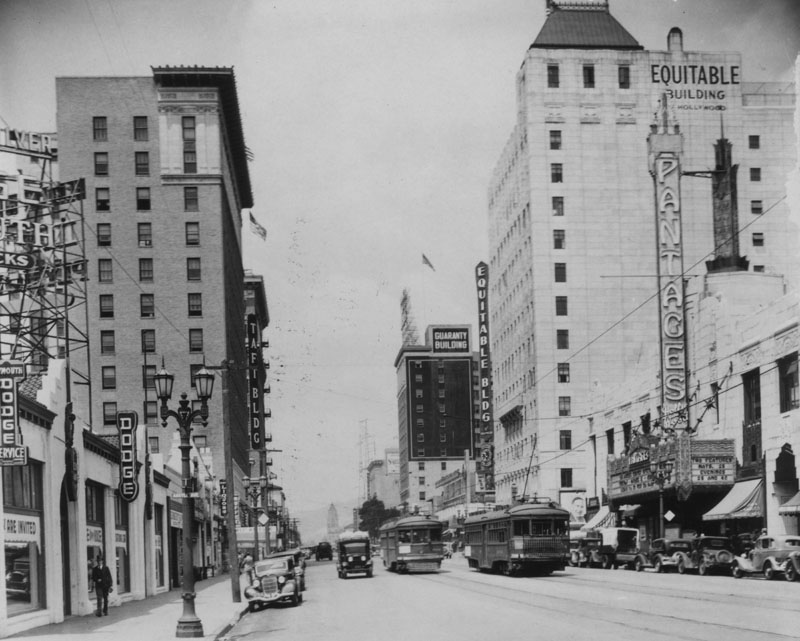 |
|
| (1936)^ - View looking west down Hollywood Boulevard from the intersection with Argyle Avenue. Note the decorative electroliers on the left side of the photo. These type of lamps, called Metropolitans, were found throughout Hollywood as early as the late 1920s and many still exist today. |
 |
|
| (1930s)^v^ - Close-up view showing a Metropolitan-style two lamp electrolier at the northwest corner of Hollywood Boulevard and Argyle Avenue with the Pantages Theatre seen in the background. |
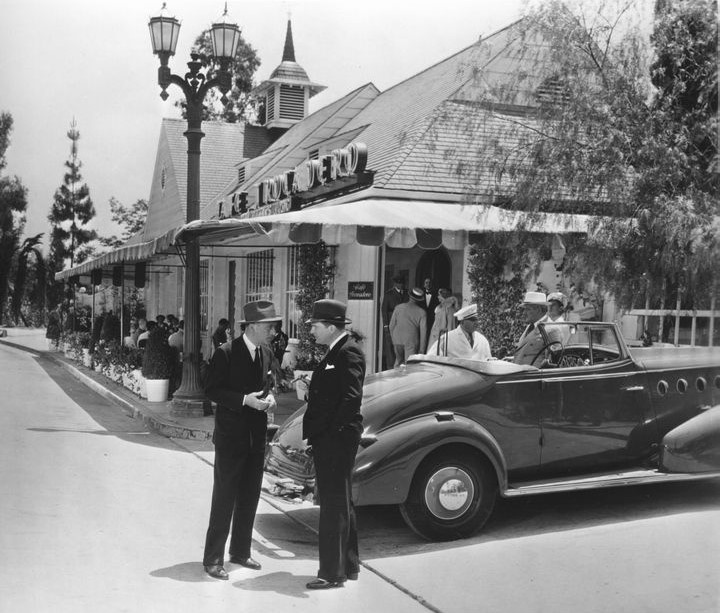 |
|
| (1936)^** - View of patrons at the Cafe Trocadero on the Sunset Strip in what is now West Hollywood. Note how the the awnings drape around the ornate dual-lamp Metropolitan streetlight. |
Historical Notes Among the celebrities who frequented the Trocadero were Fred Astaire, Bing Crosby, Cary Grant, Myrna Loy, Jackie Gleason, Henry Fonda, Judy Garland, Lucille Ball, Desi Arnaz, Jean Harlow, and Norma Shearer. The Trocadero was featured in the 1937 movie A Star is Born starring Janet Gaynor and Fredric March.*^ |
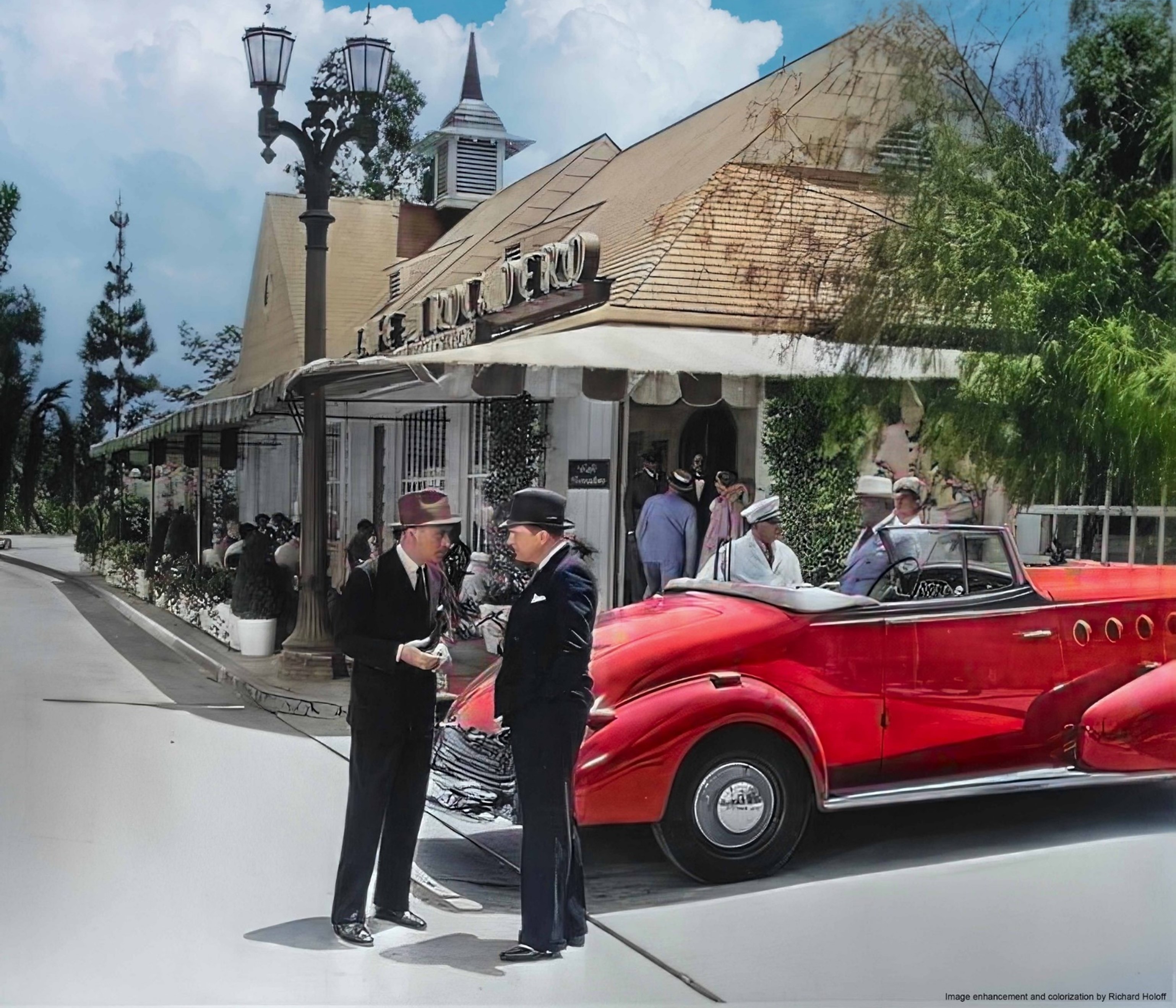 |
|
| (1936)* - Patrons at the Cafe Trocadero before the nightclub was remodeled. Note how the awnings drape around the post of the ornate dual-lamp streetlight. Image enhancement and colorization by Richard Holoff. |
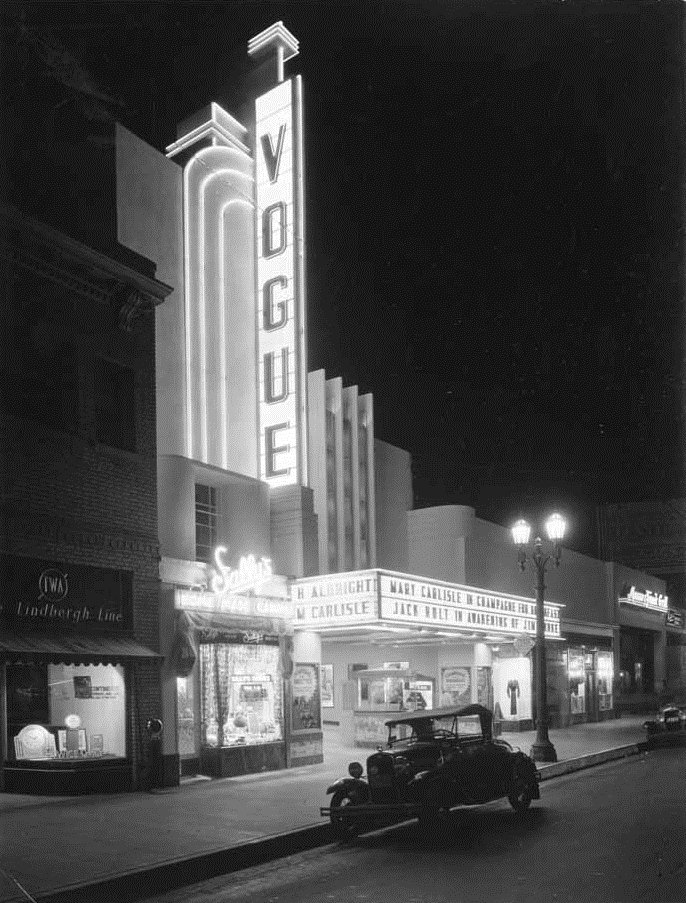 |
|
| (1935)*^^- View of an illuminated two-lamp Metropolitan electrolier in front of the Vogue Theater located at 6675 Hollywood Boulevard. Click HERE to see more in Early Views of Hollywood. |
* * * * * |
Downtown
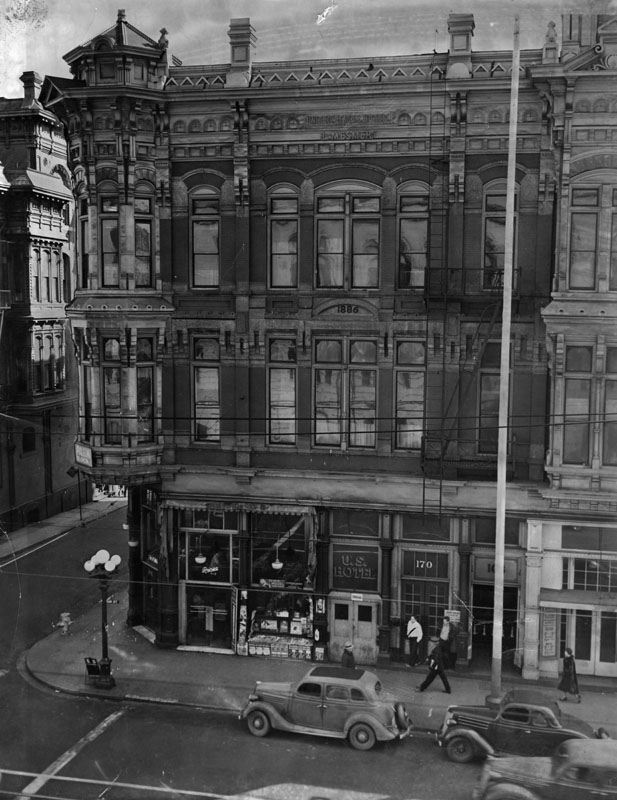 |
|
| (1935)^ - View of a singular 5-bulb streetlight standing guard in front of the U.S. Hotel on the corner of Market and North Main Street. The hotel was built in 1862 and demolished in 1939. |
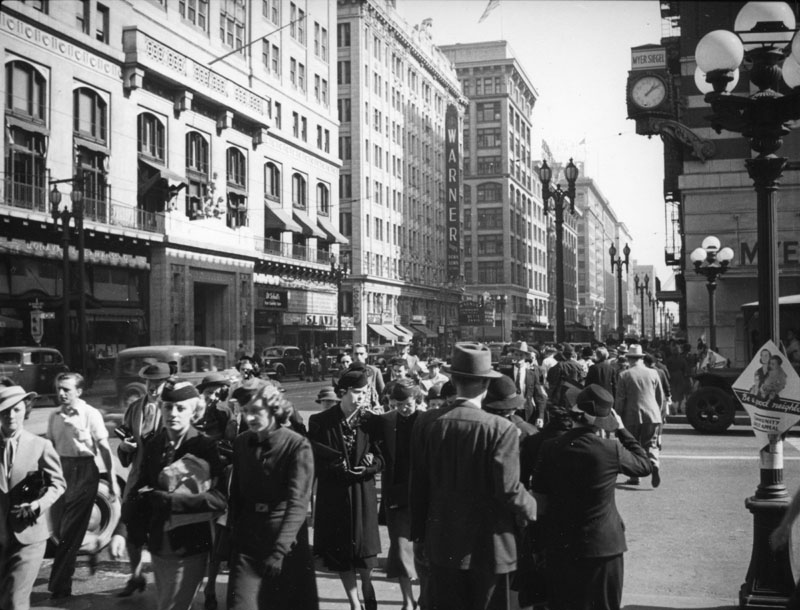 |
|
| (1937)^ - View of busy Broadway and 7th Street. Two different styles of streetlights are seen merging at this intersection. The two-lamp electroliers run up and down Broadway while the 5-lamp electrolier reside on 7th Street. |
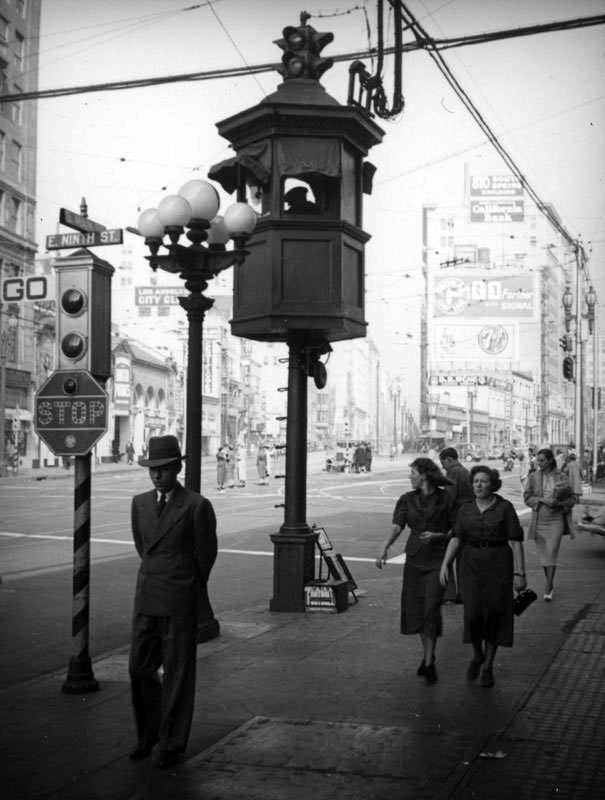 |
|
| (ca. 1937)* - Ornate five-lamp electrolier stands between a traffic signal and a switchman’s tower used to control the flow and path of streetcars through the intersection. This is a view of Main looking north from Ninth St. to where Spring and Main streets converge. |
* * * * * |
Combination Streetlight-Trolley Poles (UM-2502)
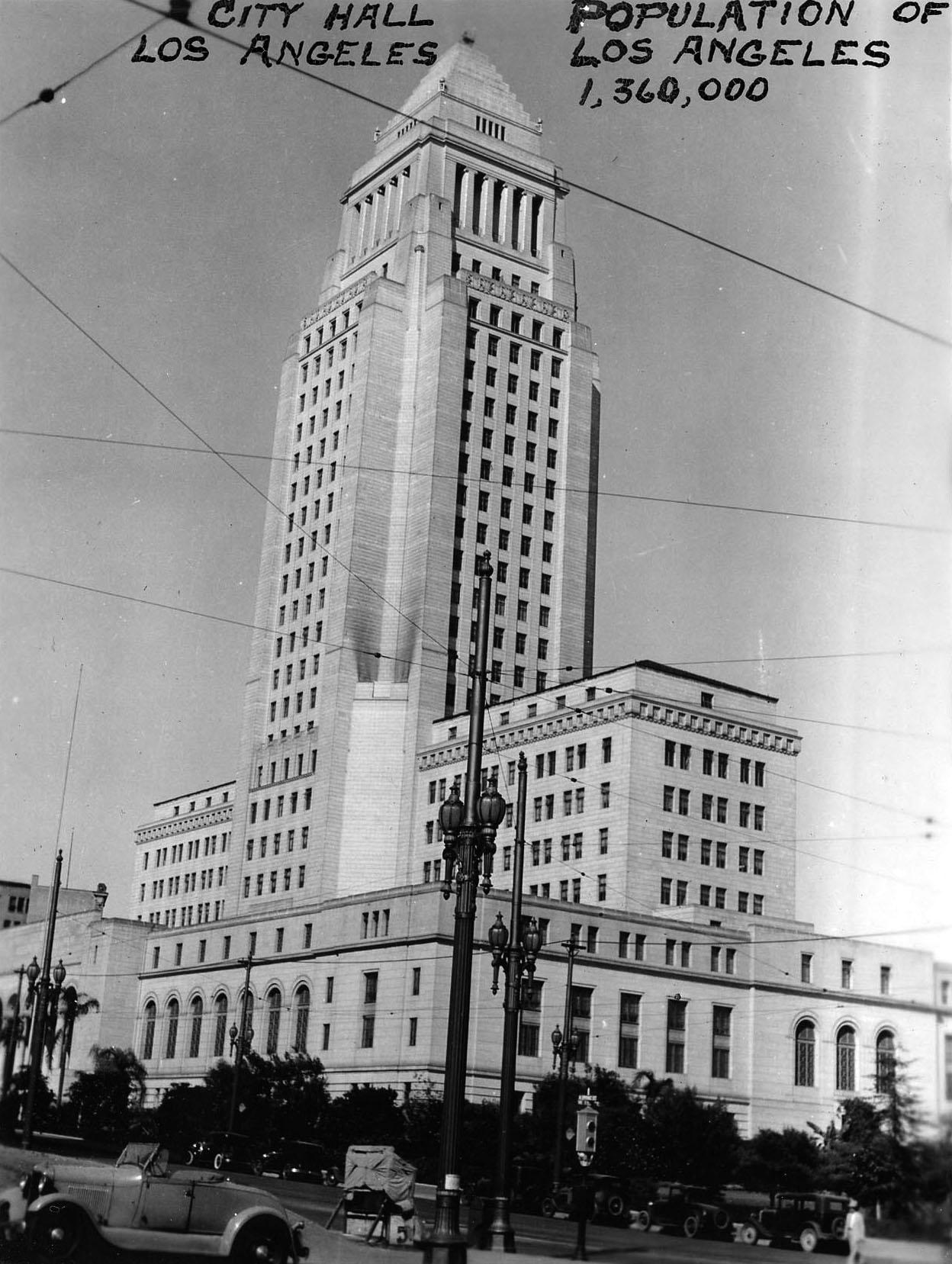 |
|
| (1934)* – View looking northeast toward City Hall showing two-lamp combination streetlight trolley poles at the intersection of Spring and 1st Street. |
Historical Notes Southern California was once home to the world's largest interurban electric railway system, the Pacific Electric Railway. Los Angeles also boasted the Nation's fifth largest urban trolley system, the Los Angeles Railway. This combination streetlight trolley pole on North Main Street is representative of many different styles of steel and concrete decorative poles used to support the 600-volt DC wires which supplied power to the streetcars and interurbans of the two companies. |
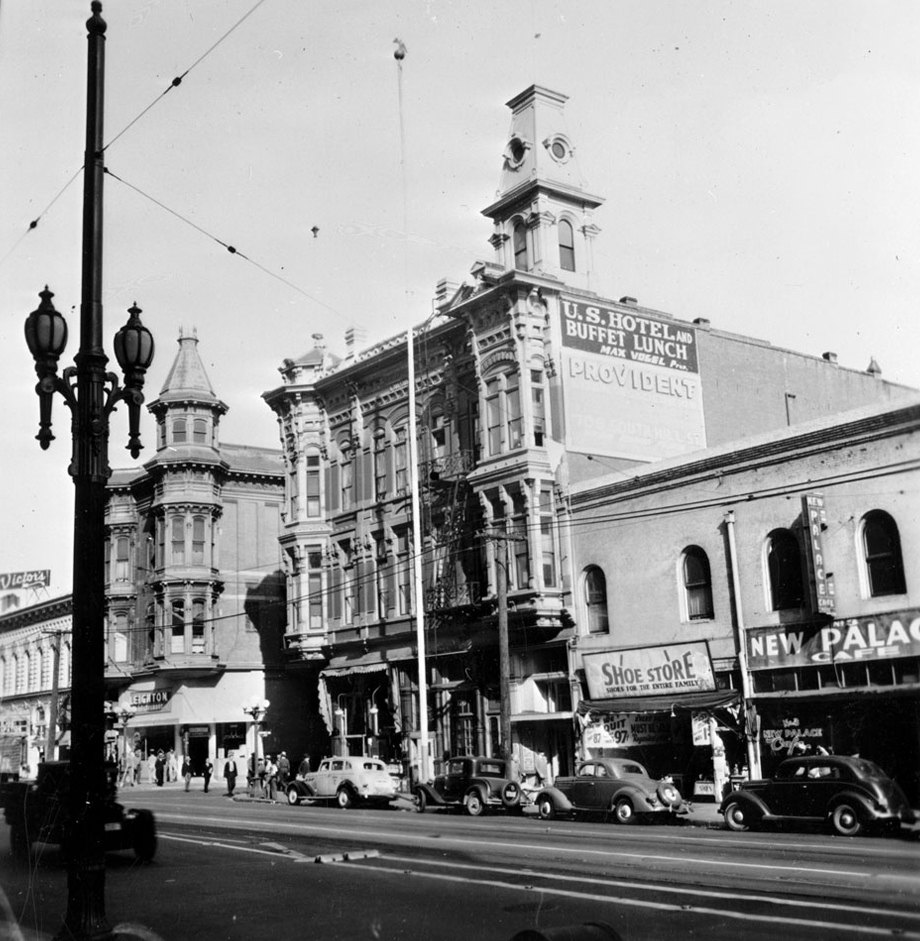 |
|
| (1935)* -- View showing a two-lamp combination streetlight trolley pole opposite the U.S. Hotel at 170 North Main Street, across the street from City Hall. |
Historical Notes One of the most significant variations of the UM (United Metal)-1906 dual-lamp streetlight was the UM-2502, which contained an extended center pole from which trolley wires could be suspended. Extant examples remain along Spring Street, between Cesar E. Chavez Avenue and First Street. |
 |
|
| (2020)* – These streetlights still exist today in front of City Hall. Despite the fact that there are no longer any electric streetcars running up and down Spring Street, several of these streetlights have been preserved, but of course, without the streetcar wires. Photo by Carlos G. Lucero |
Historical Notes Variations of the UM-1906, the UM-2502, and similar dual uprights by other manufacturers also still exist in a number of outlying areas, generally neighborhood commercial in nature. They include the south side of Magnolia Avenue from Lankershim to Vineland and north side of Magnolia from Cleon to Cartwright in North Hollywood-Valley Village; 3400-3700 Slauson Avenue in Hyde Park; Seventh Street between Union and Garland Avenues in Westlake; La Cienega Boulevard between Airdrome Street and Olympic Boulevard, and Seventh Street between Catalina and Hoover Streets In the Wilshire area. |
 |
|
| (2018)* - Detail of the dual-lamp street lights on N. Spring Street adjacent to City Hall. They were produced by Union Metal of Canton, OH and identified as the UM-2502. Copper shafts were offered by the manufacturer as an option--a detail restored to the Spring Street lights when City Hall was renovated circa 2000. Photo by Glen Norman. |
* * * * * |
Hill and 7th Street
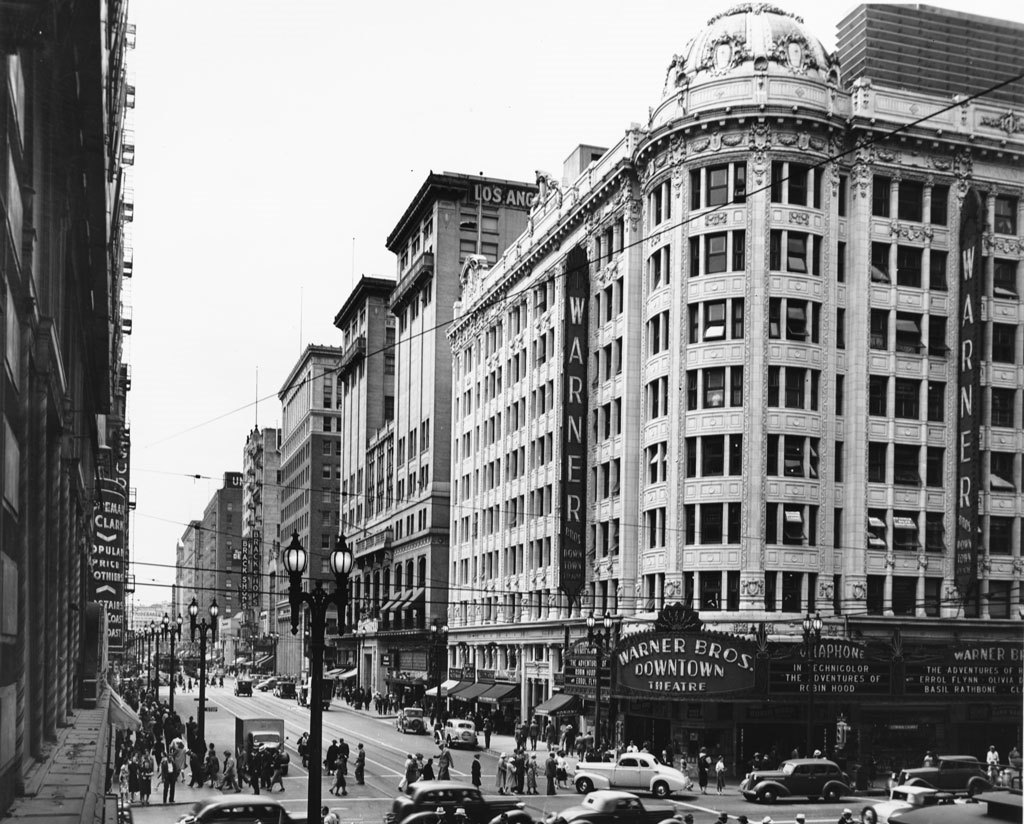 |
|
| (ca. 1938)*^ - View looking west on 7th Street at Hill. Two-lamp electroliers run up and down both 7th and Hill. The Warner Bros. Downtown Building is seen on the northwest corner. The Los Angeles Athletic Club sits just to the west of Warner Bros. on 7th Street. |
* * * * * |
Westwood Specials
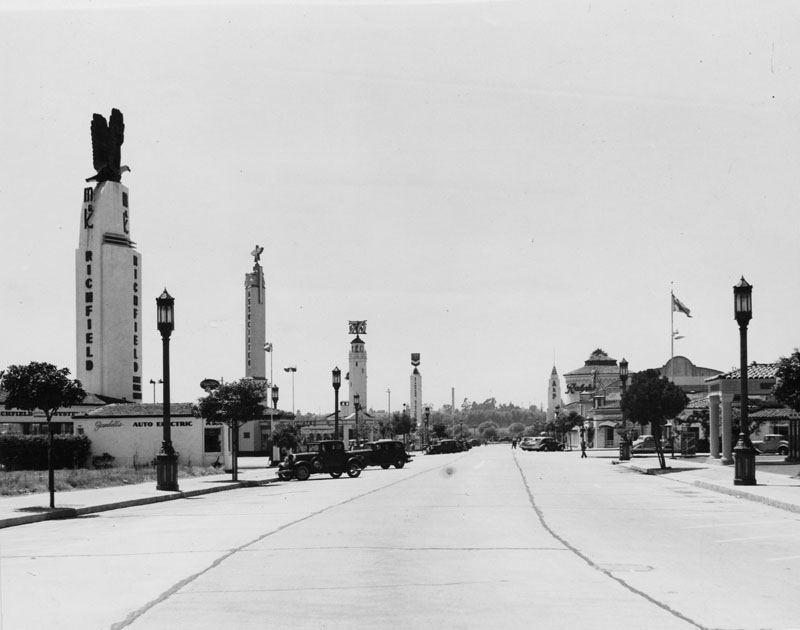 |
|
| (ca. 1937)^ - View of Westwood Boulevard in 1937. The ornate streetlights stand in front of a multitude of gas stations and retail stores. These streetlight electroliers are similar to those seen on Wilshire Blvd. except for the base of the posts, which have a different design. These lamps were called 'Westwood Specials'. |
Historical Notes Westwood Village adjacent to the University of California at Los Angeles (UCLA) was decorated in the early part of the century with the Westwood Special, notable for the blue and gold ceramic tile around its base. These were replaced with modern lights in the early 1960's when Westwood Village determined to become the brightest lighted commercial area in the world using 1,000-watt mercury vapor lamps. |
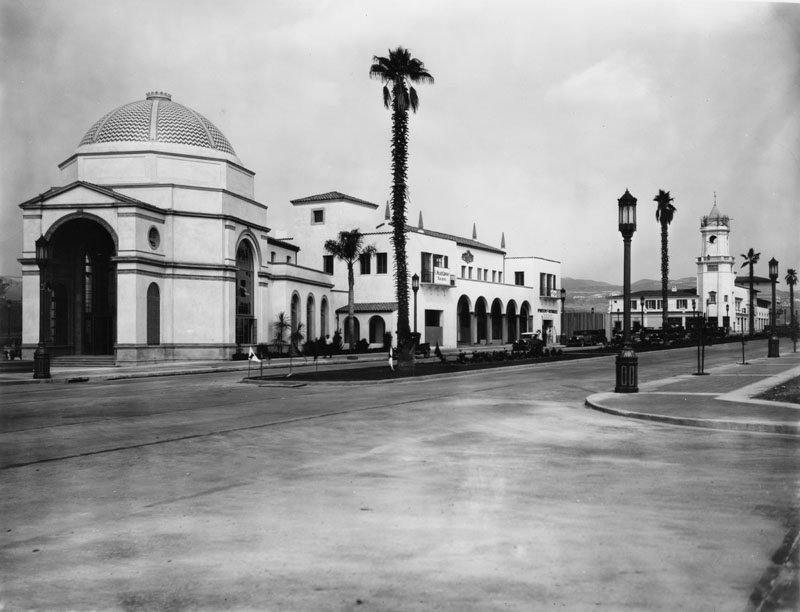 |
|
| (ca. 1930)^ - A view of Westwood Boulevard's Bank of America building, P. J. Walker Company and Phelps Terkel. This northwest corner of Westwood Boulevard and Broxton Avenue is called "The Dome," and it served as offices for the Janss Investment Company when built. The 'Westwood Special' streetlights can be seen on both sides of the street. |
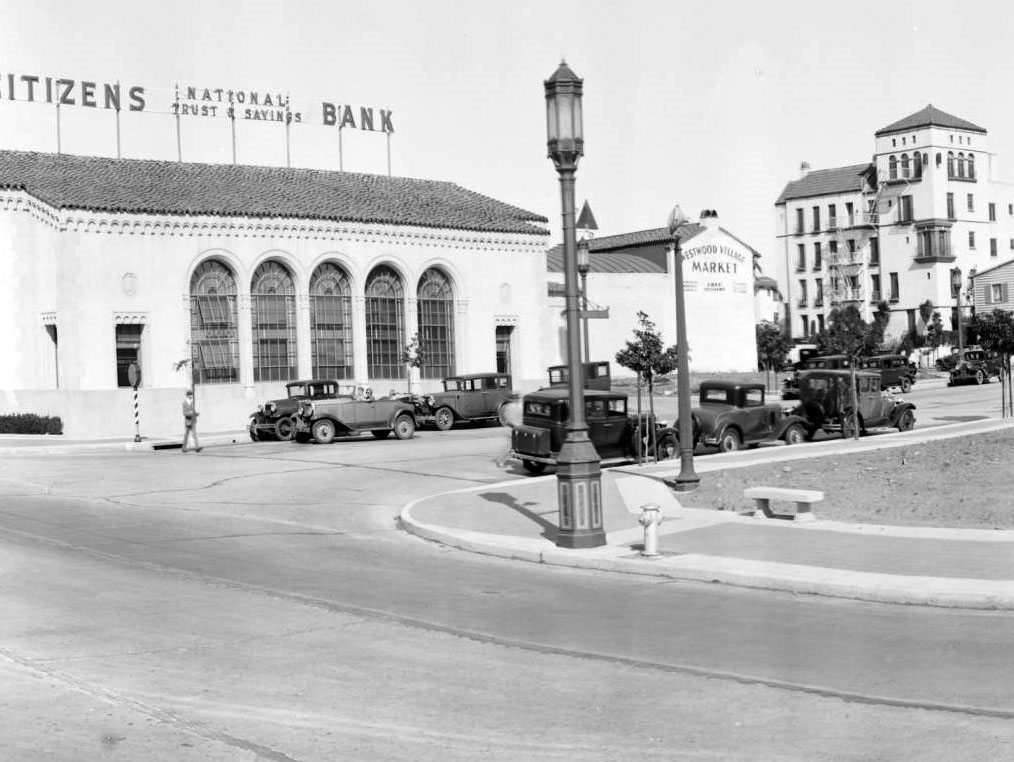 |
|
| (1932)* – View looking northeast at the intersection of Westwood Boulevard and Kinross Avenue where a “Westwood Special” streetlamp stands on the S/E corner. |
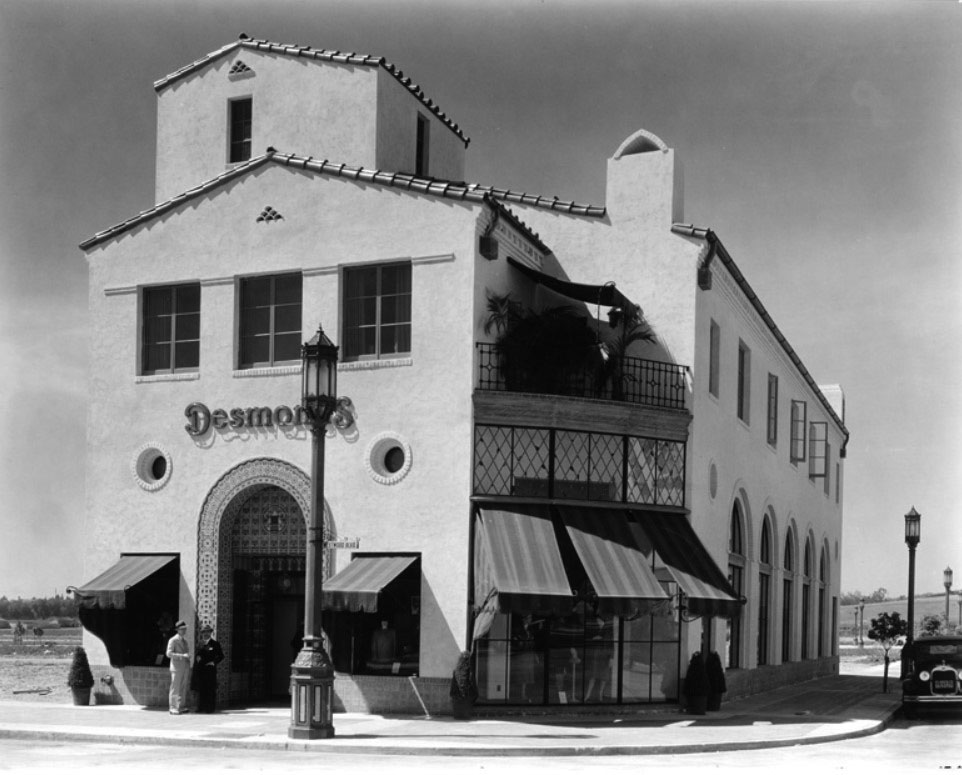 |
|
| (1929)* – A Westwood Special stands in front of the Desmond’s Building located at 1001 Westwood Blvd. |
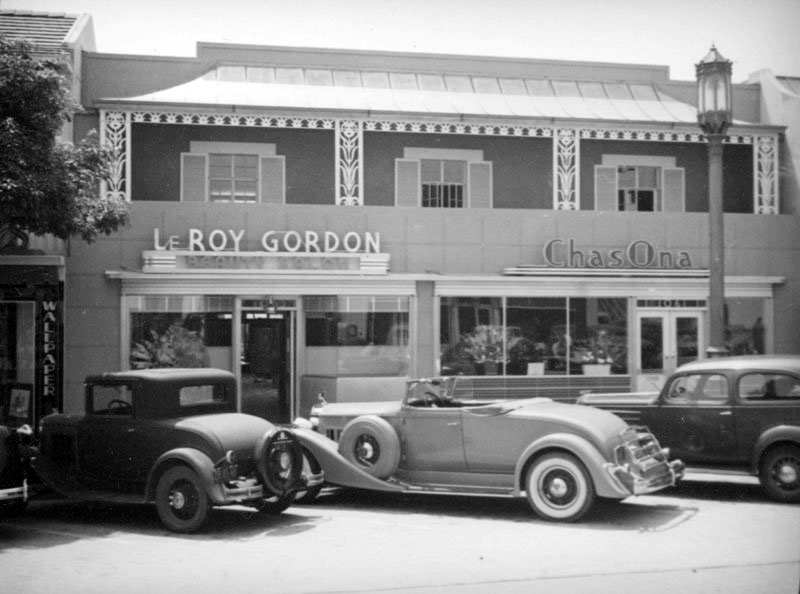 |
|
| (ca. 1937)* - A "Westwood Special" stands in front of two shops in Westwood Village: LeRoy Gordon and Chas. Ona, with cars parked diagonally in front. |
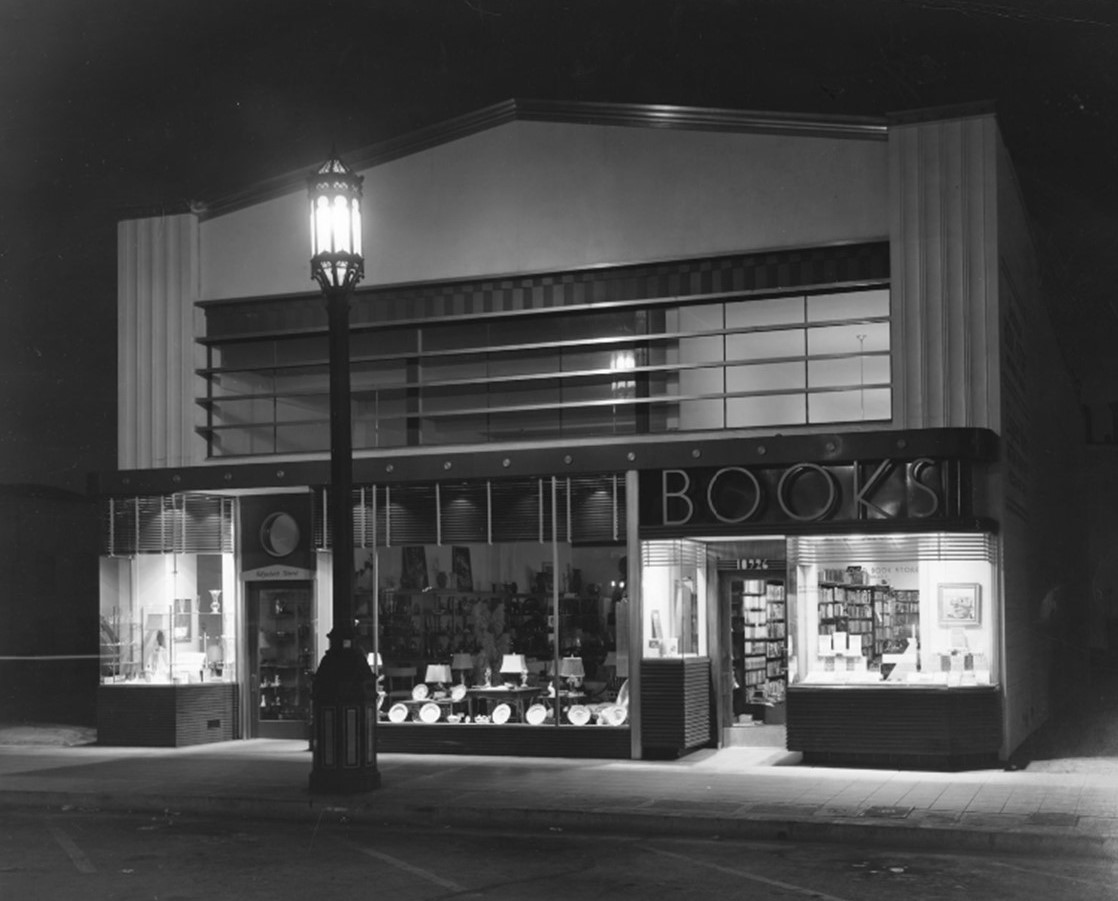 |
|
| (1938)^ – View showing an art deco style building located at 10926 Weyburn Avenue in Westwood Village. On the left is a lamp shop with plates and lamps in the display window. Next door, on the right, is the Westwood Bookstore which is still open late at night. A "Westwood Special" streetlight illuminates the building. |
* * * * * |
Wilshire Specials
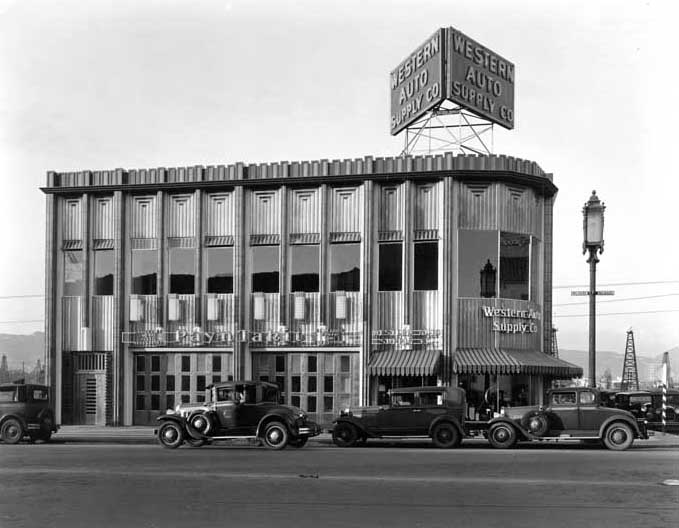 |
|
| (ca. 1933)^^^ - View looking north of the Western Auto Supply Co. Building located at 5655 Wilshire Boulevard. A tall "Wilshire Special" streetlight stands on the corner (Wilshire and Hauser). In the distance also stands an oil derrick. |
Historical Notes The Wilshire Special was predominantly seen on Wilshire Boulevared between the late 1920s thru the 1940s |
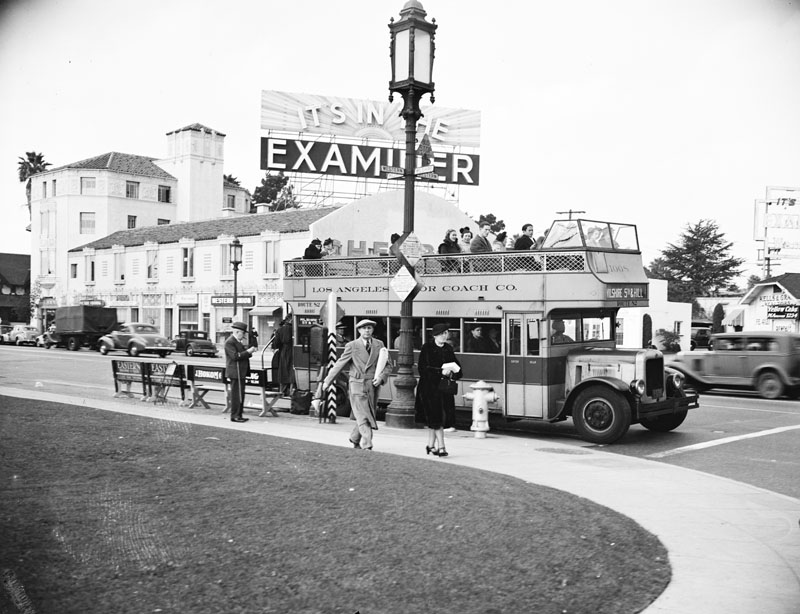 |
|
| (1937)^ - View showing a Wilshire Special standing on the corner of Wilshire and Western. Note the double-decker bus fill with passengers. This was the Route 82 motor coach that traveled from Wilshire to 5th and Hill. A very large marquee atop a building behind the coach reads: "It's in the Examiner", possibly making reference to the Herald Examiner newspaper. |
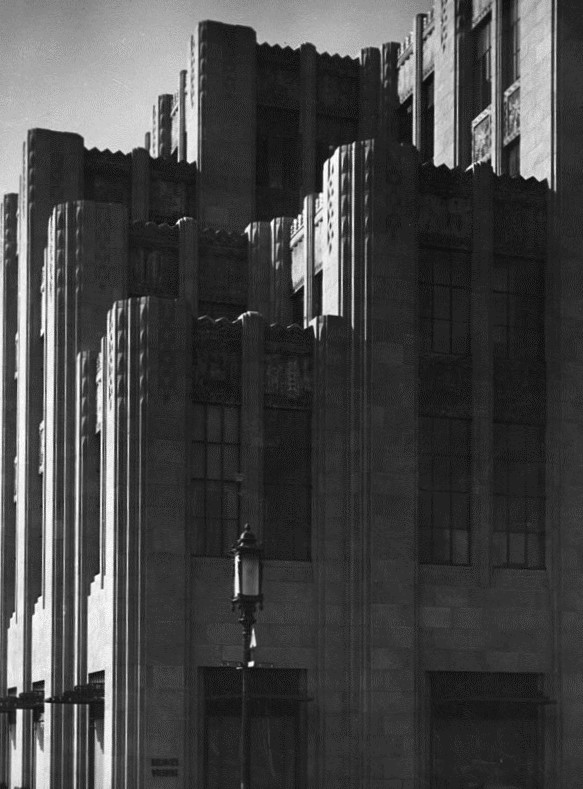 |
|
| (1938)^ - Close-up view of a portion of the western side of Bullock's Wilshire. An ornate “Wilshire Special” streetlight stands in front of the beautiful art deco building located at 3050 Wilshire Blvd. |
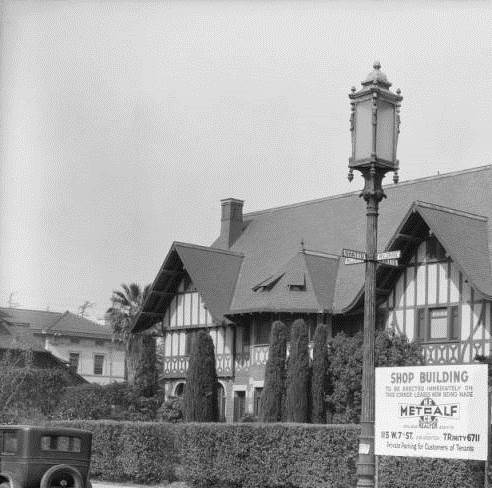 |
|
| (1931)*^ - Close-up view of another "Wilshire Special" on the corner of Wilshire and Shatto. Note how the street signs are attached to the post. |
Historical Notes Refurbished Wilshire Specials can still be found in downtown LA. (Click HERE). |
* * * * * |
Hollywood
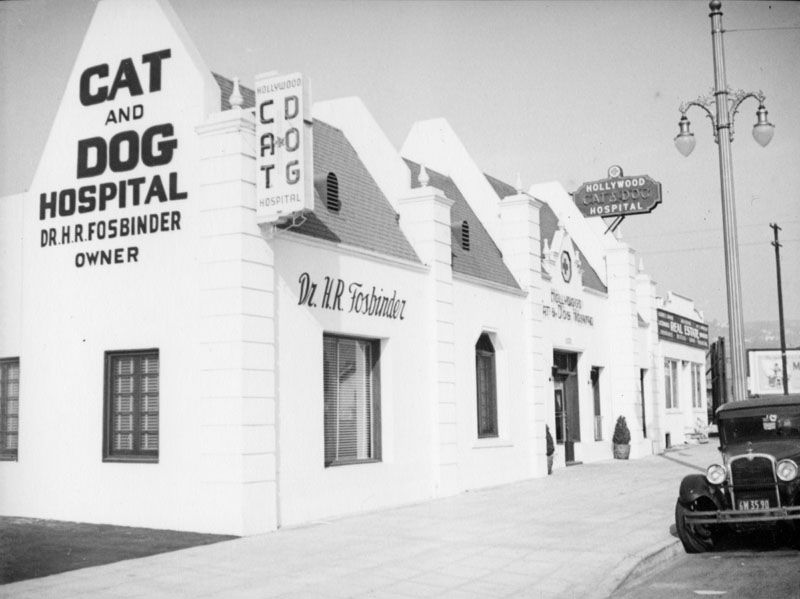 |
|
| (ca. 1937)^ - Dual-lamp electrolier with trolley cable connected to top of post in front of the Hollywood Cat and Dog Hospital located at 1151 North Highland Avenue. This building is still standing. |
Combination Streetlight, Trolley, and Power Poles
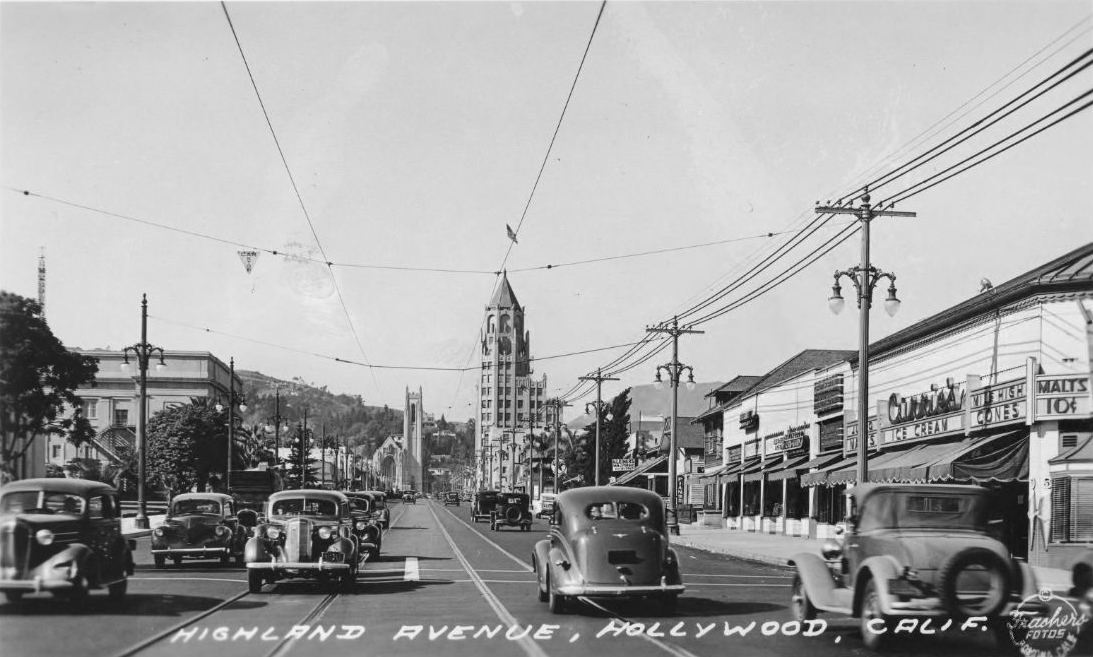 |
|
| (1937)^*# - Looking north on Highland Avenue from Sunset Boulevard showing dual-lamp streetlights sharing space with power lines and streetcar cables. Hollywood High School can be seen at far left. In the center distance are the Hollywood United Methodist Church and the Hollywood First National Bank Building. To the right, on the NE corner, is Currie's Ice Cream parlor. |
Historical Notes The dual-lamp electroliers shown above were utilized in a most unique way. Cross-arms were installed on top of the electrolier post and power lines layed upon the arm. Also, streetcar wire ran across the street and was attached at both ends to the electroliers. |
 |
|
| (ca. 1936)* – Closer view showing the combination streetlight-power poles runing north and south on Highland Avenue. This view is looking north on Highland Avenue toward Sunset Boulevard with Currie's Ice Cream parlor seen on the northeast corner. |
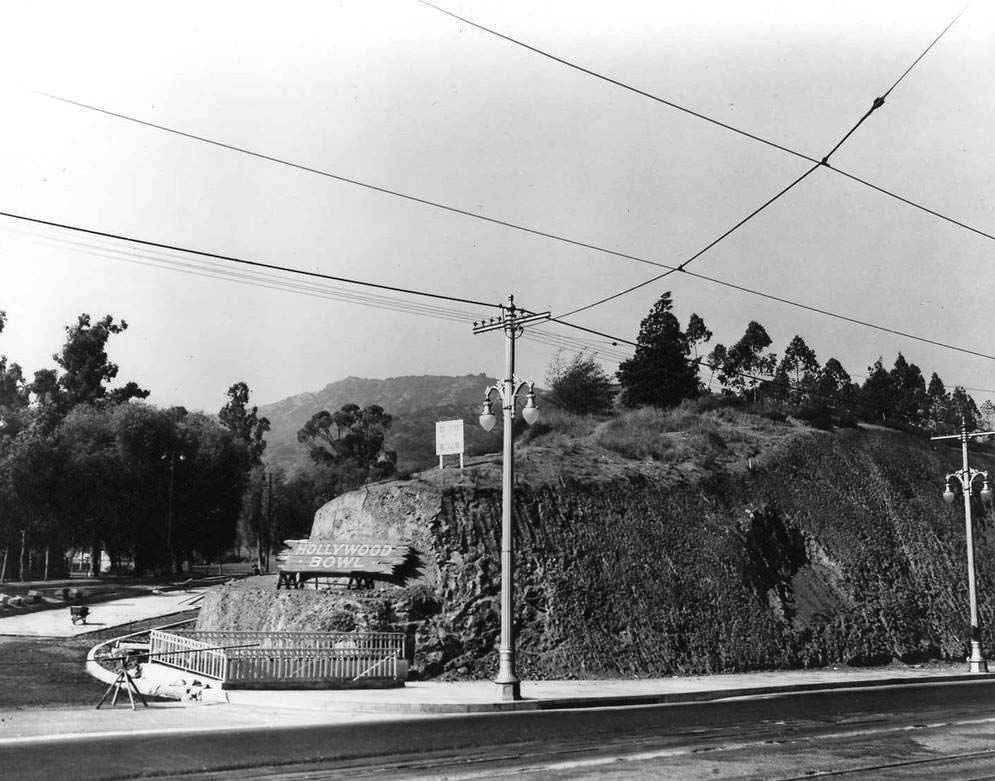 |
|
| (ca. 1930s)* – View showing combination streetlight, trolley, and power poles near the entrance to the Hollywood Bowl located at 2301 N. Highland Avenue. |
* * * * * |
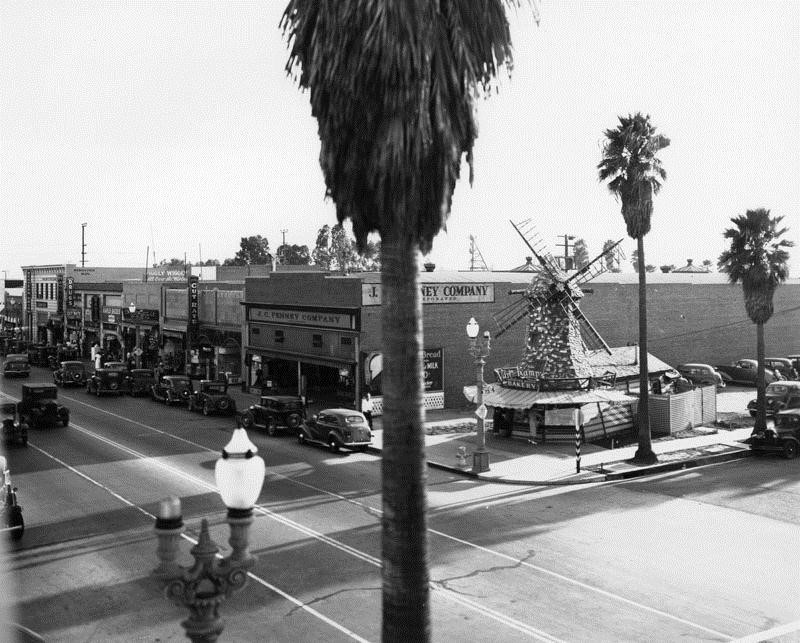 |
|
| (1937)* - View of dual-lamp style electroliers at the corner of Avalon Boulevard and West I Street in Wilmington. One side of the electrolier is capped off either for energy conservation or for keeping illumination levels to a minimum. |
| (ca. 1942)#*^ - View looking east from 6th and Beacon streets in San Pedro, with the Municipal Ferry building in the background. Note the ornate streetlights on both sides of the street. |
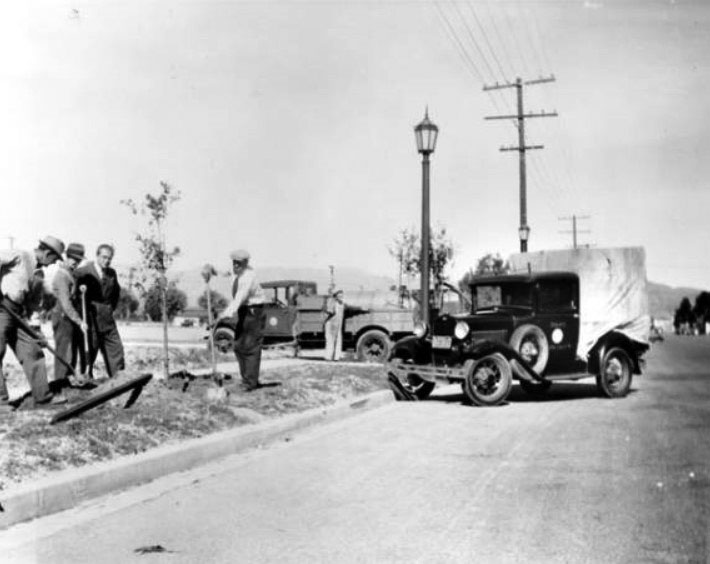 |
|
| (1938)#^ - Single-lamp Metropolitan electroliers stand on Reseda Boulevard between Parthenia Street and Roscoe Boulevard. Several men are seen planting trees. Carl S. Dentzel, a community leader, is visible at the center, wearing a suit. The other people in the photograph are from the Parks Department and Department of Forestry, City of Los Angeles. |
* * * * * |
UM-1906's - Westlake Area
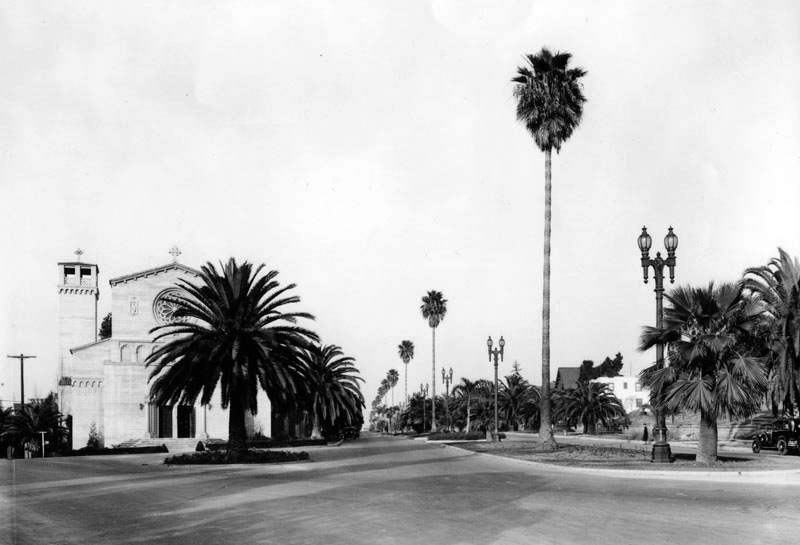 |
|
| (1931)^ – View looking north from 5th Street on Occidental Boulevard in the Westlake area. A row of 2-lamp UM-1906 streetlights stand in the center median in line with another row of palm trees. |
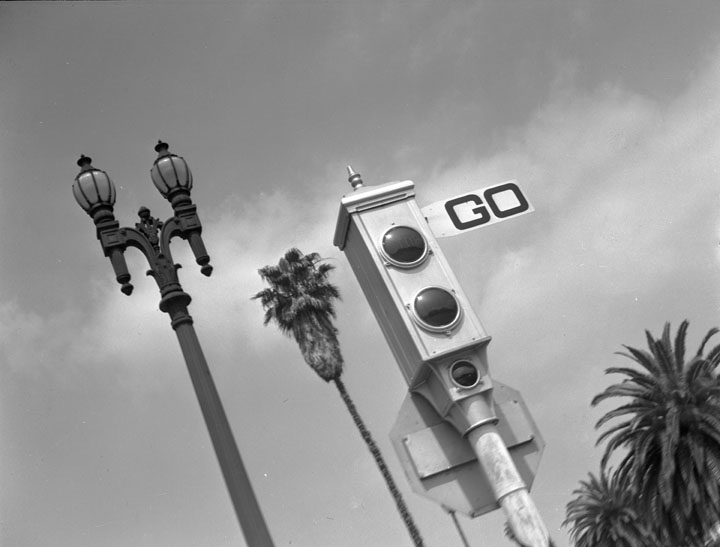 |
|
| (1937)* - Electrically operated Los Angeles traffic signal, with dual-lamp UM-1906 street light in background. |
* * * * * |
Dual Lamp UM-1906 - Downtown
.jpg) |
|
| (1940s)*^# – Postcard view showing a two-lamp 'Union Metal' electrolier (UM-1906) standing across the street from the Bullock’s Department Store at 650 S. Hill Street. |
Historical Notes Replacing the five-globe Llewellyn in Downtown Los Angeles and extending outward along several major streets, hundreds of dual-lamp electroliers (UM 1906's) were installed in the mid 1920's. |
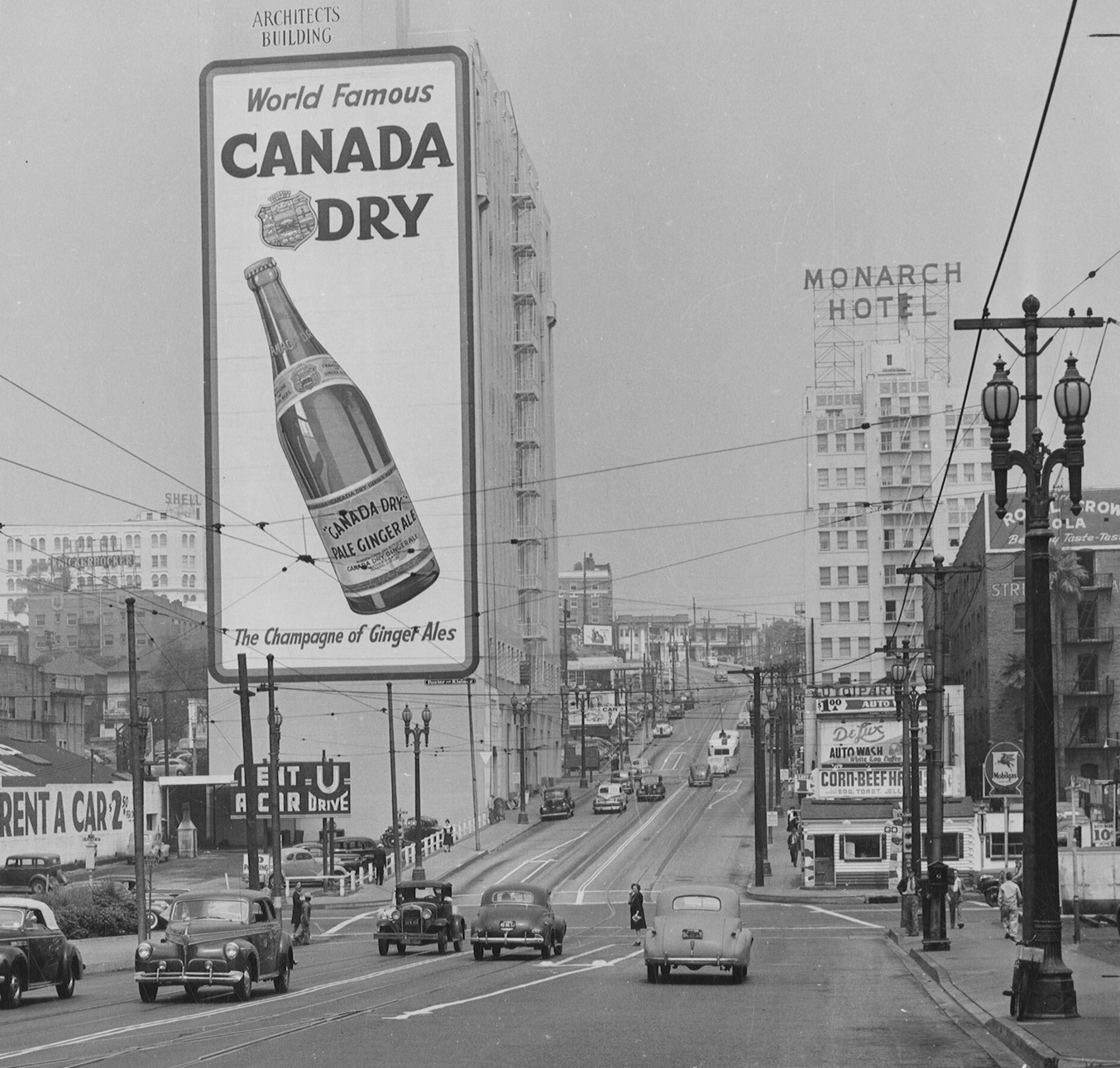 |
|
| (ca. 1944)* – Looking west on 5th Street toward Flower Street showing Dual-lamp UM-1906's lining both sides of the street. A larger than life for 'CANADA DRY GINGER ALE' advertising fills up the east face of the Architects Building, SE corner of 5th & Figueroa. Also seen here is the Monorach Hotel located on the NW corner of 5th and Figueroa. |
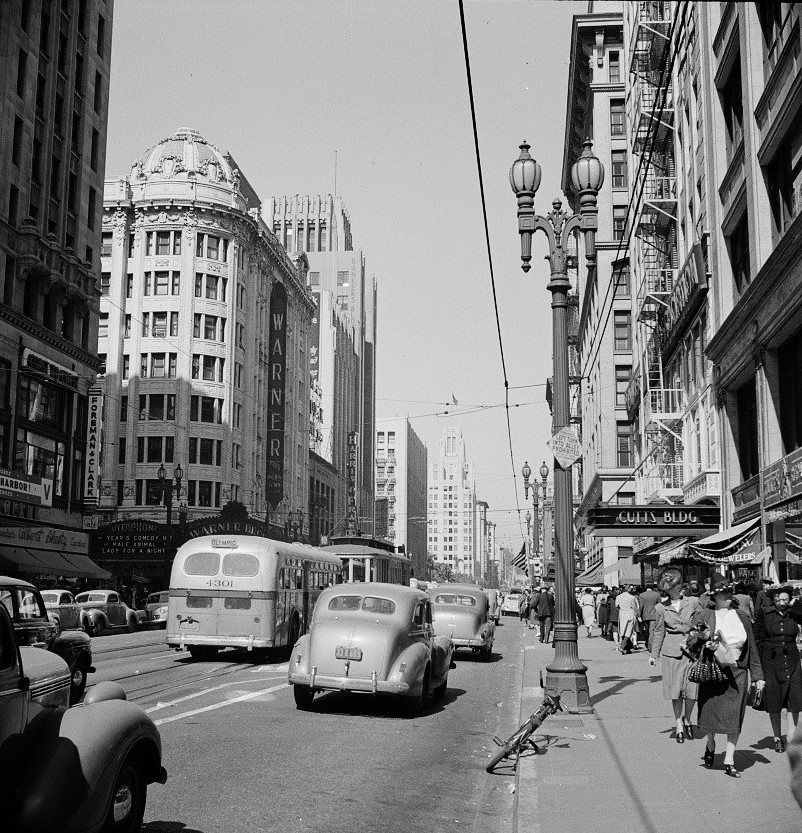 |
|
| (1941)* - View looking north on Hill Street toward 7th Street with the Warner Theatre on the NW corner. Dual lamp UM-1906s run up and down Hill Street. |
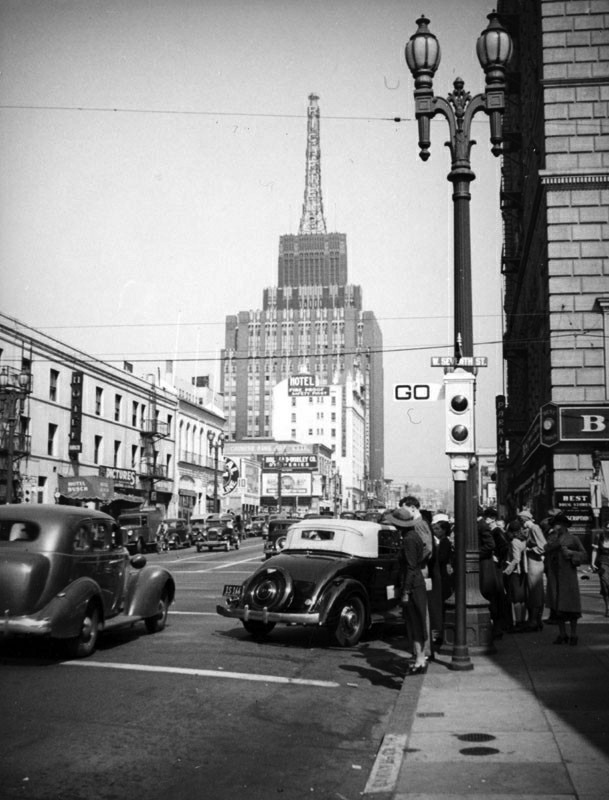 |
|
| (ca. 1940)^ – View looking north on Flower at 7th Street with the Richfield Oil Company Building (555 S. Flower St.) standing tall in the background. A dual-lamp streetlight (UM-1906) stands behind an old-style traffic signal (Semaphore). |
Historical Notes Los Angeles installed its first automated traffic signals in October 1920 at five locations on Broadway. These early signals, manufactured by the Acme Traffic Signal Co., paired "Stop" and "Go" semaphore arms with small red and green lights. Bells played the role of today's amber or yellow lights, ringing when the flags changed—a process that took five seconds. By 1923 the city had installed 31 Acme traffic control devices. |
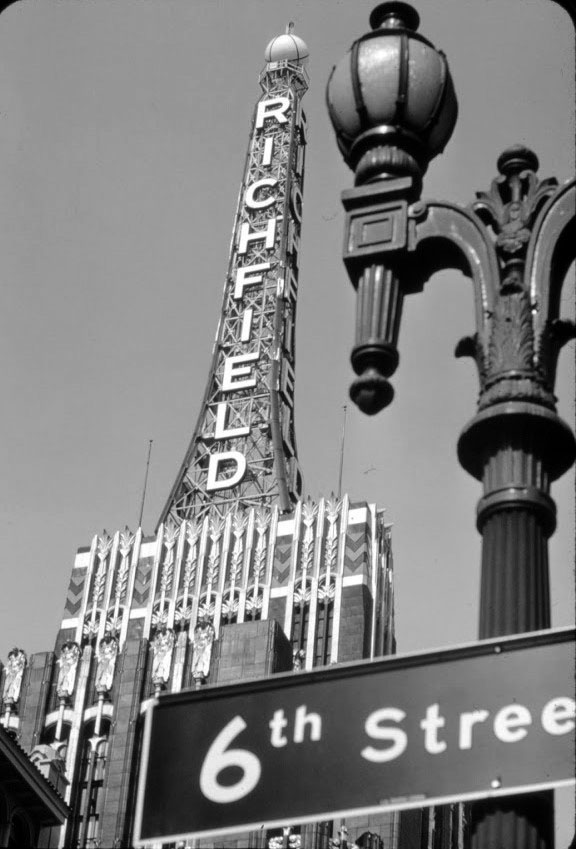 |
|
| (ca. 1960s)* – View looking up at the Richfield Oil Company Building tower from 6th Street showing a close-up of the two-lamp ornate streetlight (UM-1906). |
Historical Notes The Richfield Oil Company Building was demolished in 1969 to make way for the present ARCO Plaza skyscraper complex. |
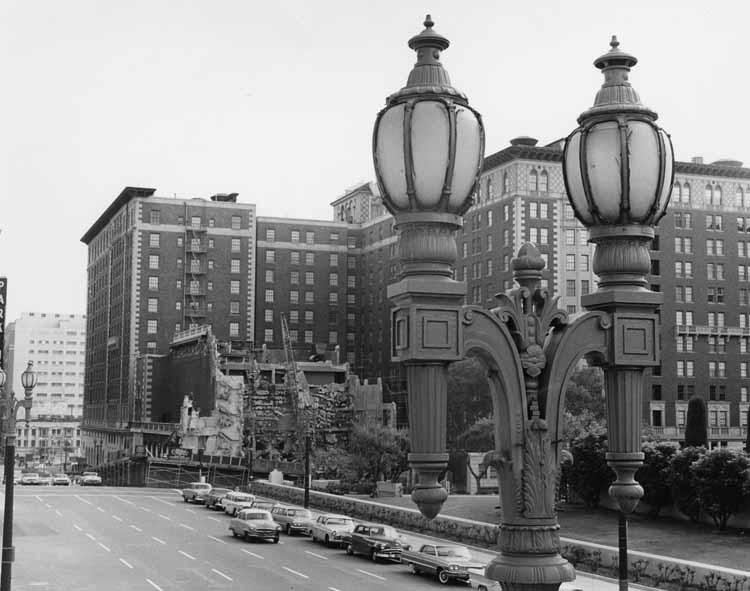 |
|
| (1964)^ – Close-up detailed view of a dual-lamp (UM-1906) electrolier in downtown Los Angeles. View is looking east on 5th street toward Grand Ave. Photo by William Reagh |
Historical Notes In the photo above, the large building in the distance is the Biltmore Hotel and the building being demolished is the Biltmore Theatre, built in 1924. Also, the LA Central Library is to the right (out of view). |
 |
|
| (1970)* - View showing Jack and Hy's fast food stand on the corner of Olive and 8th streets in Downtown. Ornate UM-1906’s line both sides of 8th Street. Photo by William Reagh |
Historical Notes Some of these UM-1906 streetlights still exist today, although most are refurbished. Click HERE to see more contemporary views. |
* * * * * |
USC
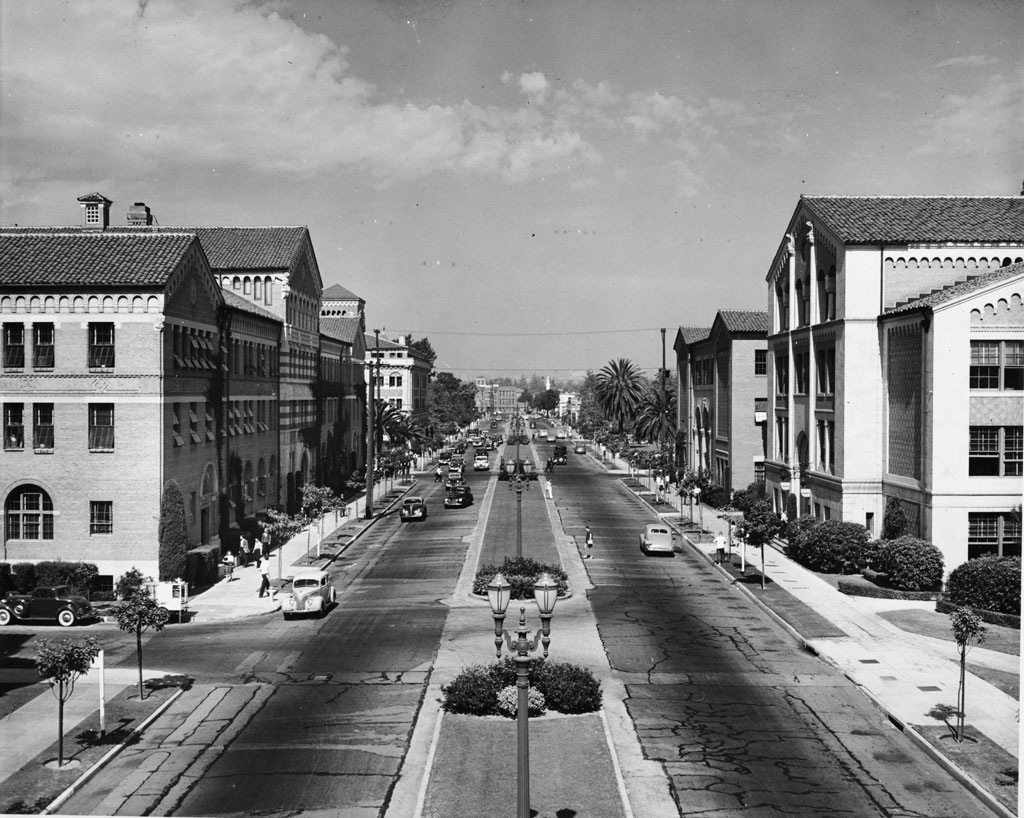 |
|
| (1940)^^ - Dual-lamp electroliers situated in the center median of Trousdale Parkway on the USC campus in 1940, when it was still a public street. The view looks northeast up Trousdale (then named University Avenue) from Exposition Boulevard. Click HERE to see more in Early Views of USC. |
Wilshire Special
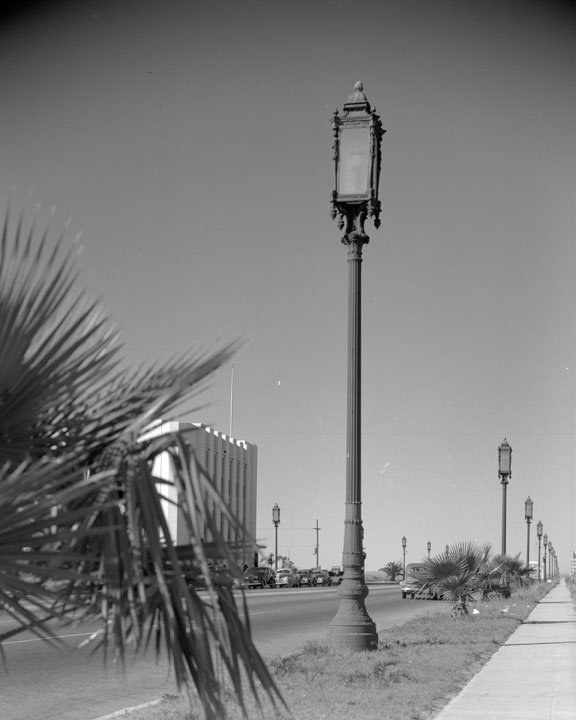 |
|
| (1940)* - Ornamental streetlight electroliers (Wilshire Special) on Wilshire Boulevard west of Rossmore. |
Contemporary Streetlight Maintenance
 |
|
| (2013)^^* – View showing two maintenance workers replacing a broken glass panel on a 'Wilshire Special', located in front of the Wilshire Grand Hotel. Photo by Gary Leonard |
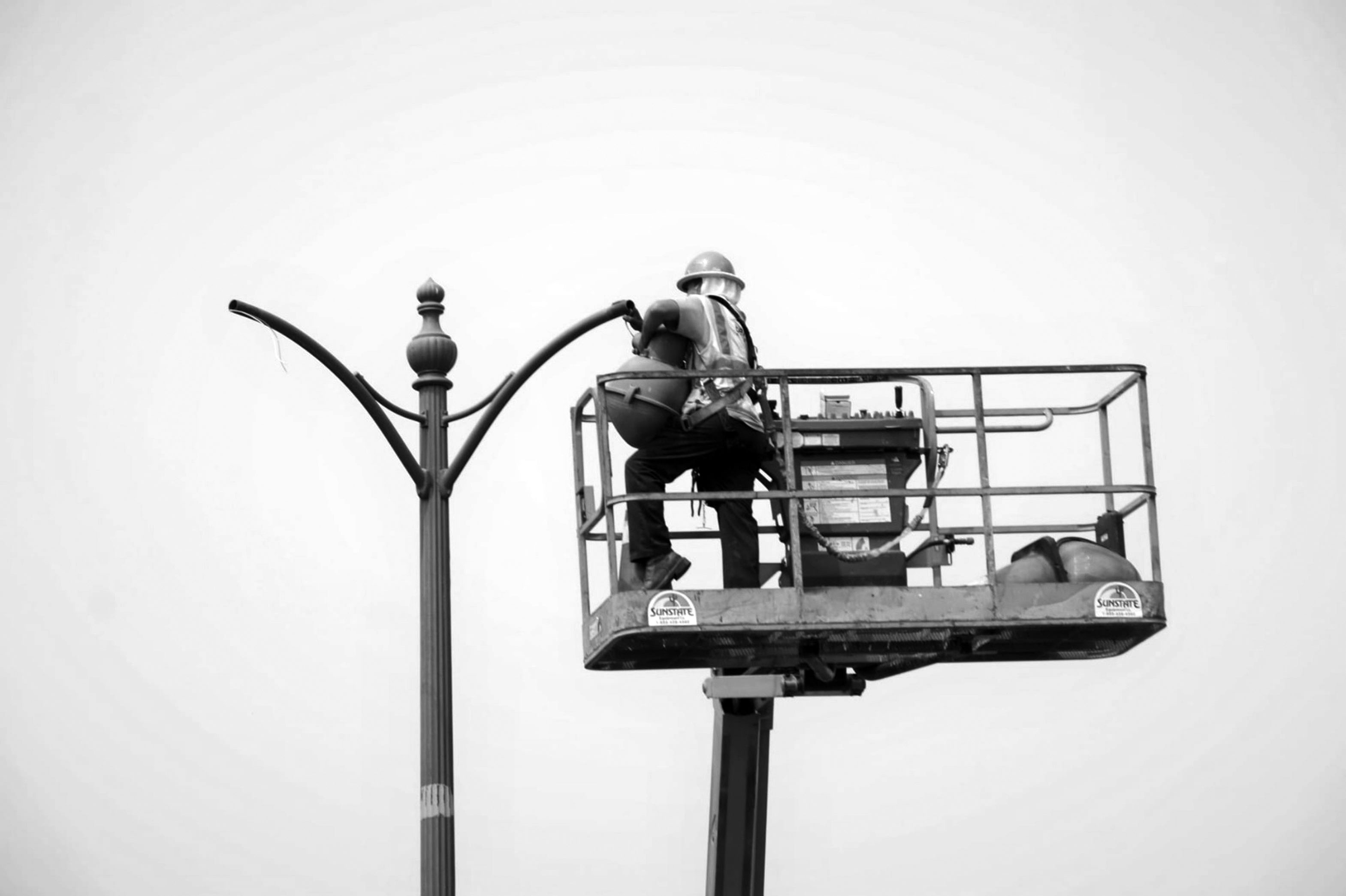 |
|
| (2020)* - Bureau of Streetlight Maintenance worker changes lamps of a Wilshire Double located on the South side of Wilshire Boulevard between Dunsmuir and Cochran Avenues. Photo by Glen Norman |
Historical Streetlight Maintenance
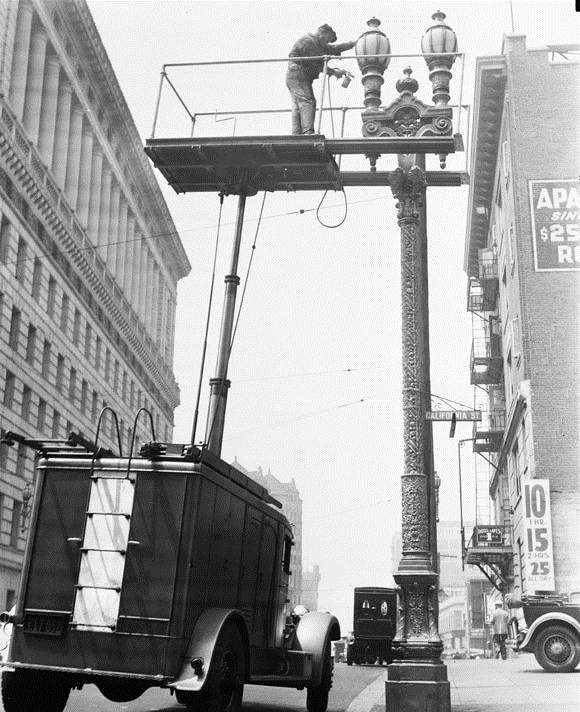 |
|
| (1935)* – Greatly facilitating the maintenance work on street light standards, a new five-ton tower truck was placed in service June 6th by the Power Bureau’s Street Lighting section. The first painting job assigned to the truck’s crew was to a dual-lamp electrolier called a Broadway Special, located on Broadway between California and Temple Streets. |
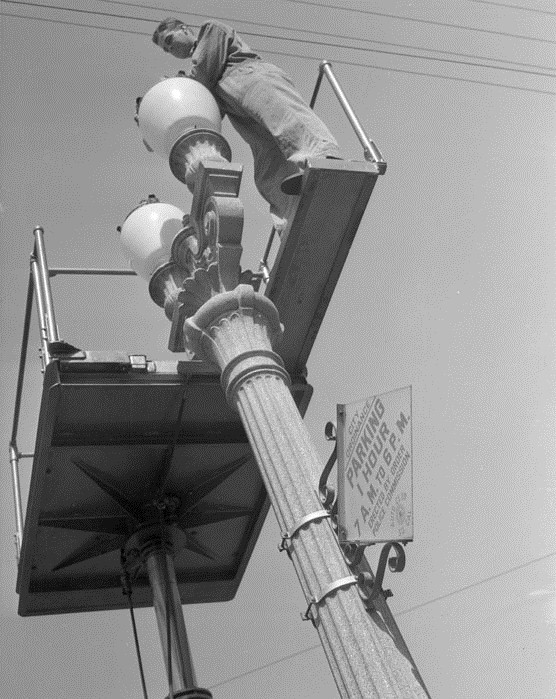 |
|
| (ca. 1940)* - Early DWP Streetlight Maintenance worker repairs an electrolier. |
* * * * * |
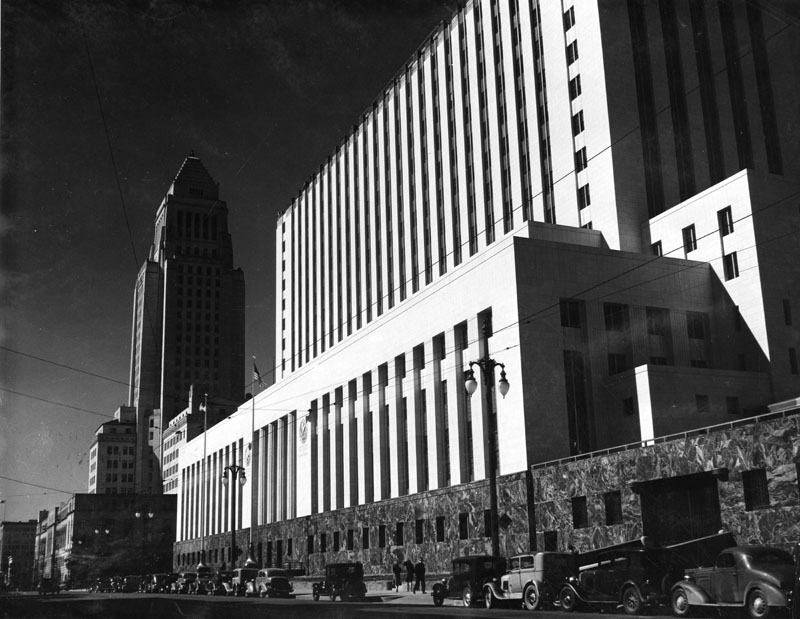 |
|
| (ca. 1940)^ - View of dual-lamp electroliers standing in front of the newly constructed Federal Courthouse. City Hall can be seen in the background. |
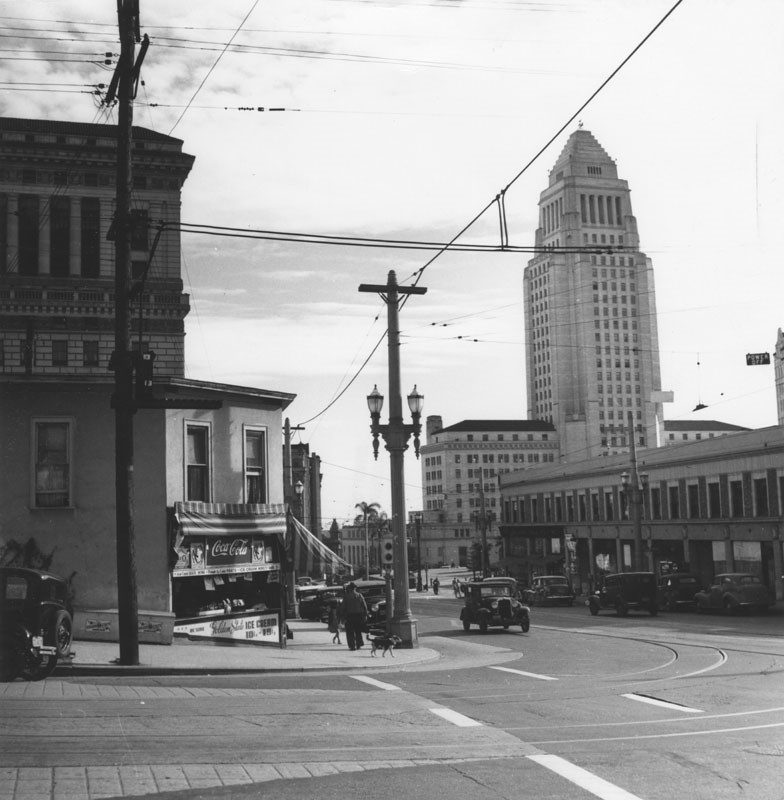 |
|
| (ca. 1940)^ - A dual-lamp electrolier is being utilized as a streetlight and a utility pole on the corner of Temple and Hill streets. In the background stands City Hall. Photo by Ansel Adams |
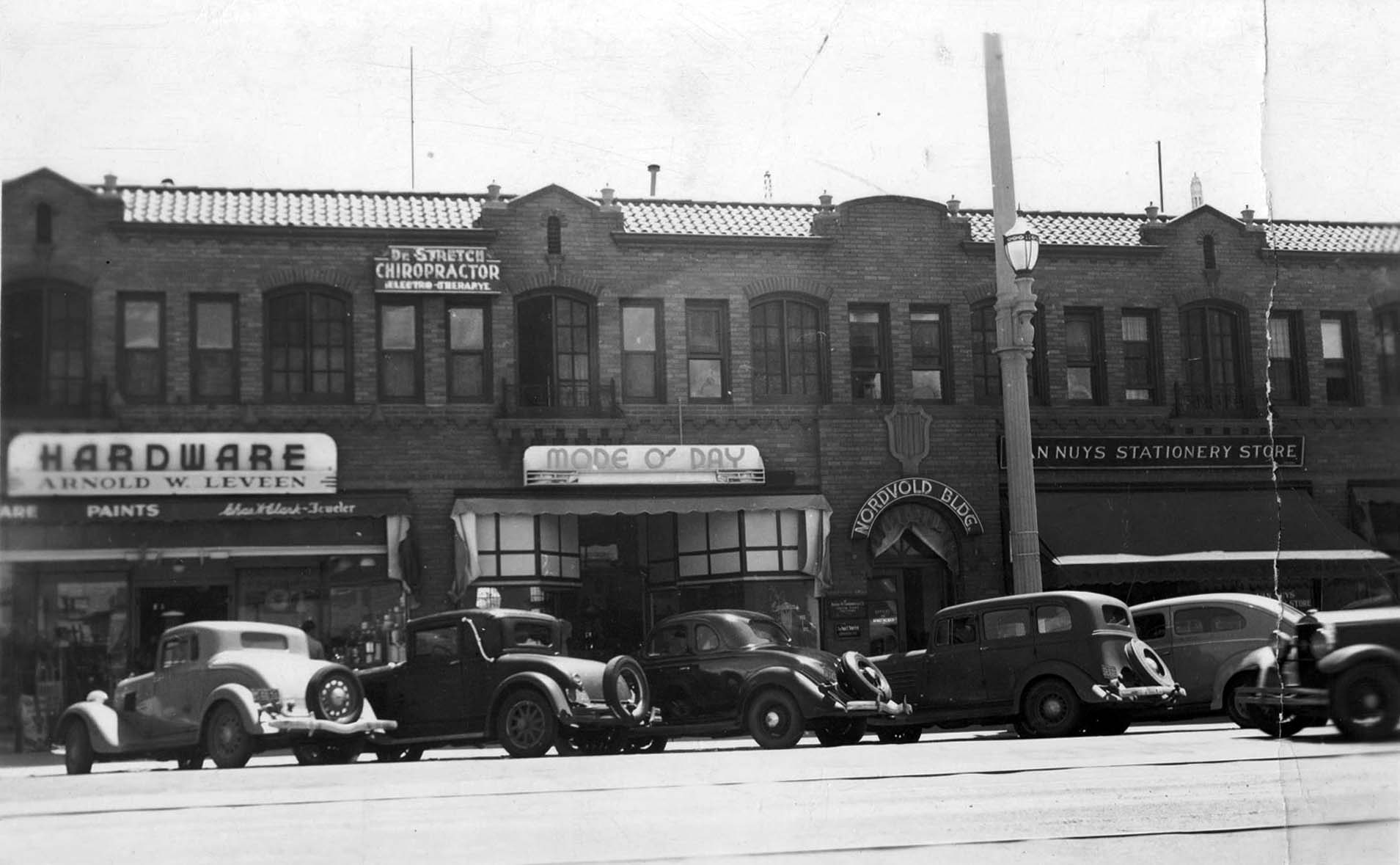 |
|
| (ca. 1940)**# - A single-arm streetlight post sits in front of the Nordvord Building located at 6420 Van Nuys Blvd., just north of Victory Blvd. This is the same type electrolier as seen in previous photo but with only a one arm extension. |
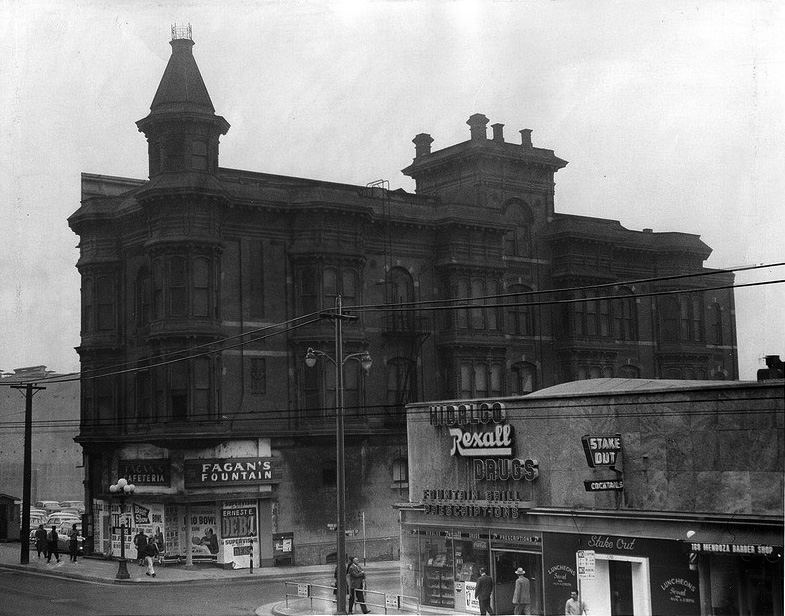 |
|
| (1955)^#^ - View of another dual-lamp electrolier that is being utilized both as a streetlight and a utility pole. It is located on the southeast corner of Market and Main streets across from City Hall. Today, Market Street no longer exists and City Hall East stands at this location. |
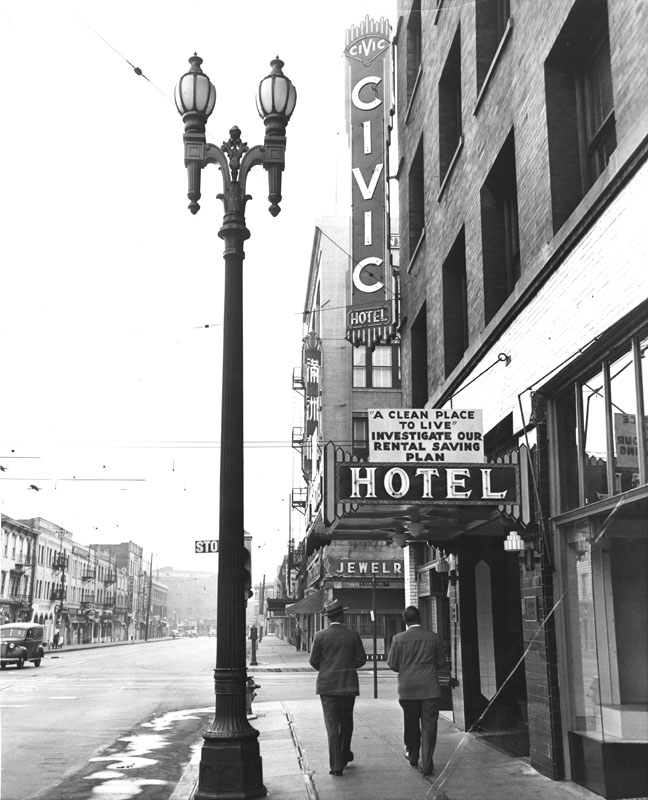 |
|
| (1942)^ - A dual-lamp electrolier (UM-1906) towers above the sidewalk as two men walk by near the corner of 1st and San Pedro streets on June 17, 1942. The streets look deserted. |
WWII Modified Streeltights
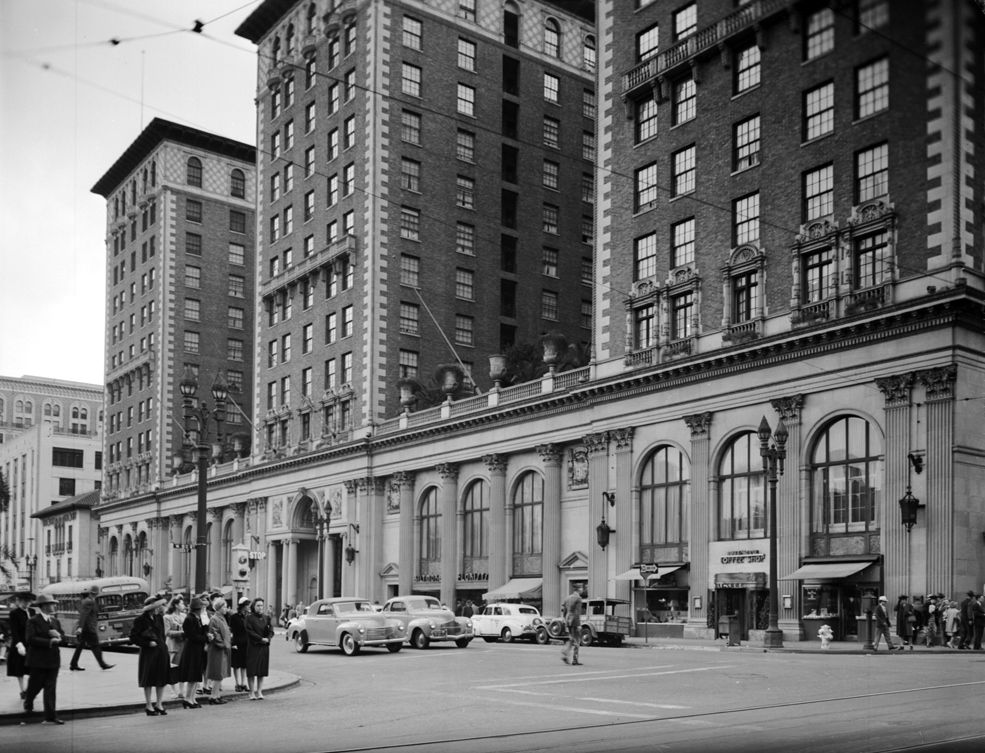 |
|
| (1943)*# - Two-lamp ornate electroliers in front of the Biltmore Hotel as seen from the corner of Olive and 5th Streets. Notice that the top of the streetlights are blacked-out (during WWII). |
Historical Notes During the War many streetlights throughout the City were blacked-out on top as a preventative measure. |
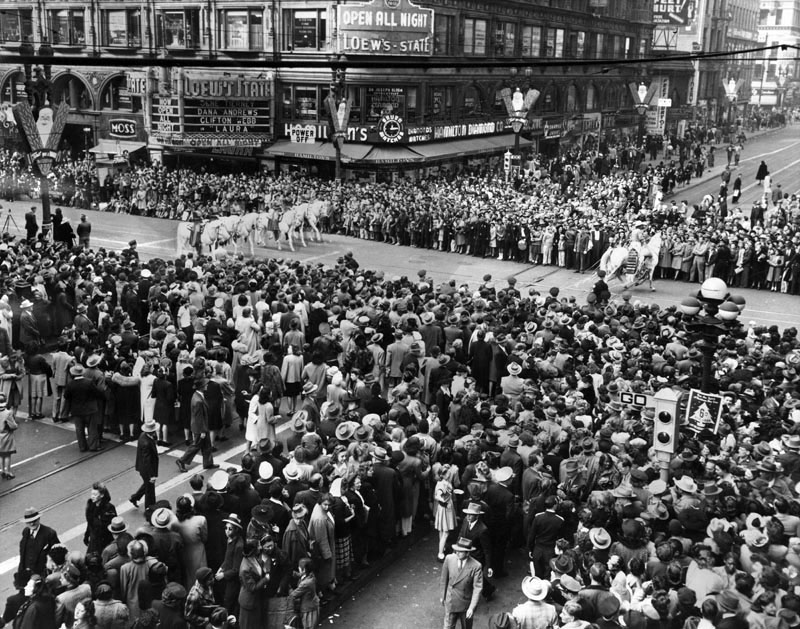 |
|
| (1944)^ - View of the War Loan Drive Parade at the busy intersection of Seventh and Broadway. In the lower right stands a 5-lamp electrolier with 4 of the 5 bulbs blacked-out on top. |
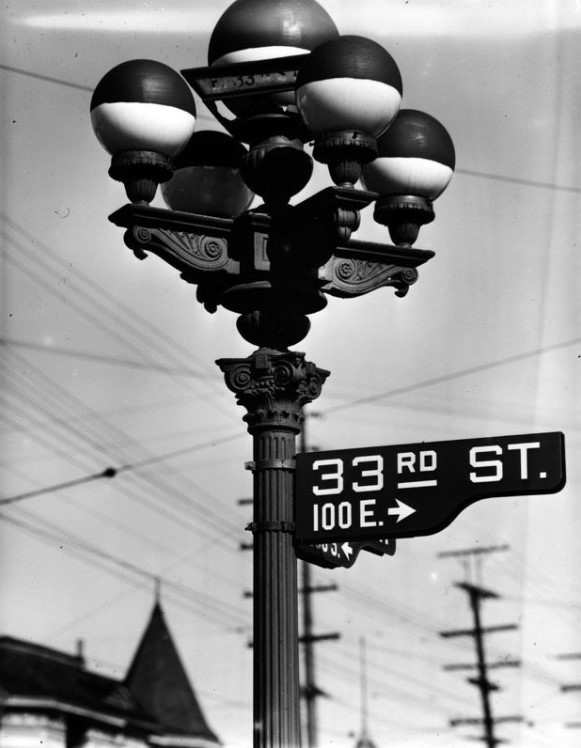 |
(ca. 1943)* - Close-up view of a five-globe Llewellyn streetlight located on the corner of Main and 33rd streets with all five bulbs blacked-out on top (during WWII). Note the old trapezoidal street sign imbedded just below the topmost globe.^^#
|
North Hollywood (UM-1931)
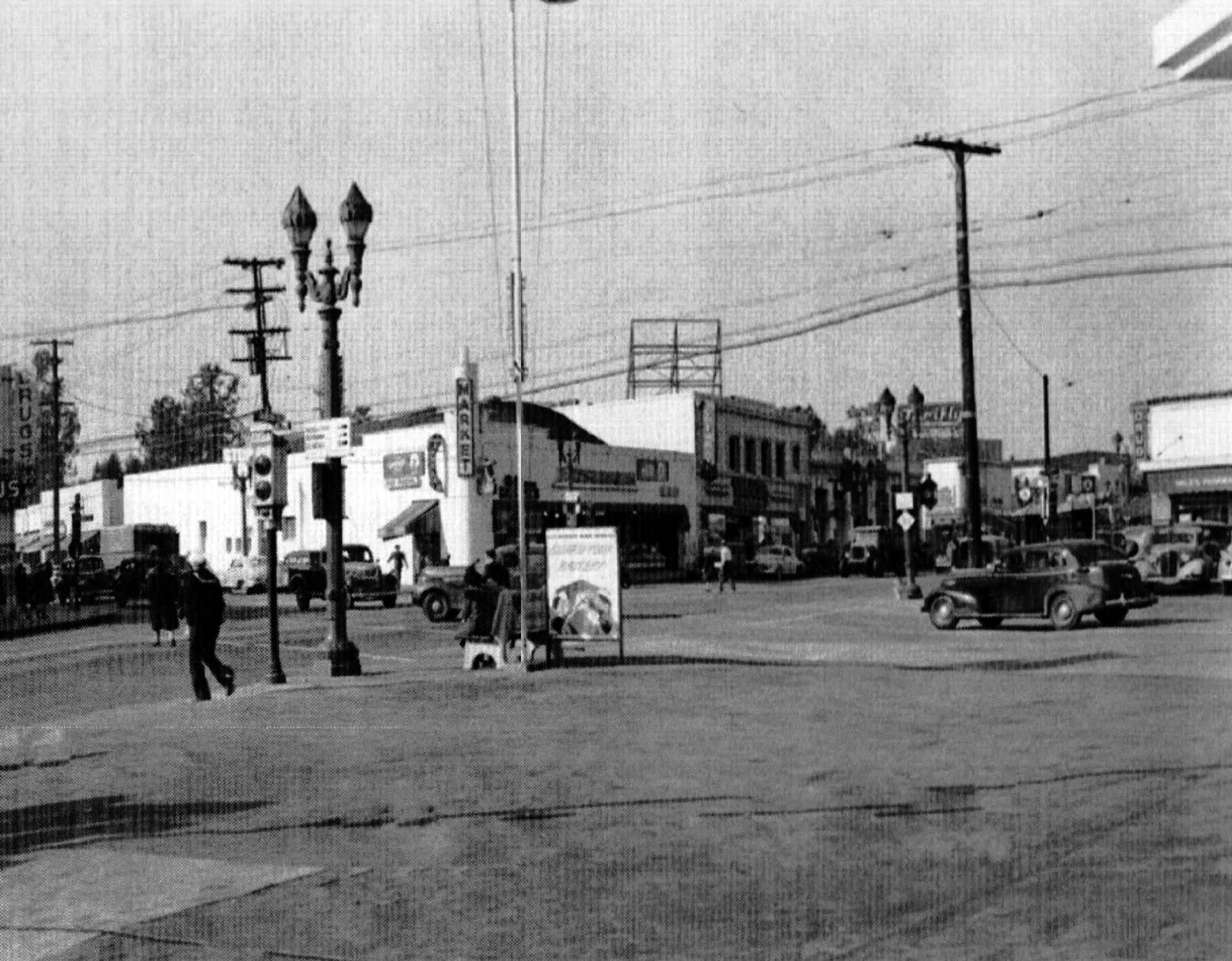 |
|
| (ca. 1945)^.^ – Ornate two-lamp electroliers (UM-1931) with tops blacked-out (WWII), located at the intersection of Lankershim and Magnolia in North Hollywood. The view is looking northwest with Fitzsimmons Market seen on the NW corner. |
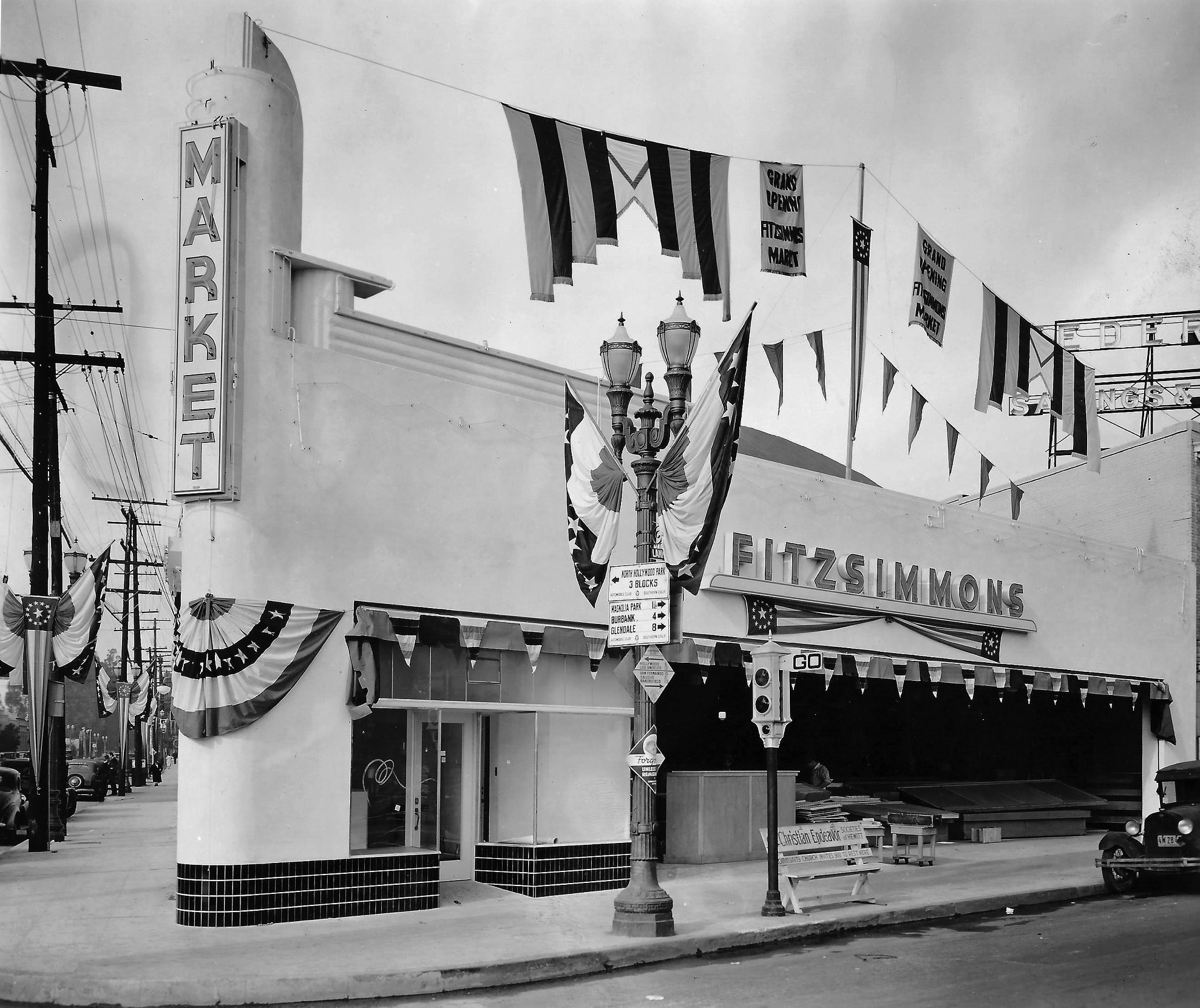 |
|
| (ca. 1940)^.^ - View looking at the NW corner of Lankershim and Magnolia showing Fitzsimmons Market being prepared for its Grand Opening. Note the Semaphore traffic signal* standing by the beautiful UM-1931 dual-lamp streetlight (without black-out tops; pre-WWII)). Sign on streetlight reads: North Hollywood Park – 3 blocks with arrow pointing to the West. Lower part of sign points to the East and reads: Magnolia Park – 1½ Miles; Burbank – 4 Miles; Glendale – 8 Miles |
Historical Notes *These early signals, manufactured by the Acme Traffic Signal Co., paired “Stop” and “Go” semaphore arms with small red and green lights. Bells played the role of today’s amber or yellow lights, ringing when the flags changed—a process that took five seconds. |
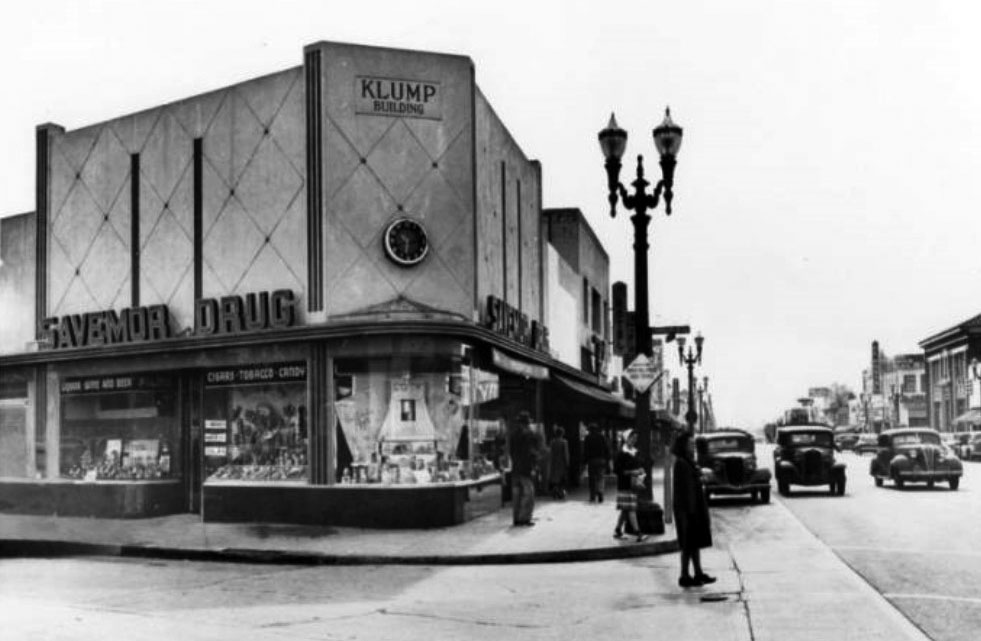 |
|
| (ca. 1946)* - View looking south on Lankershim Boulevard at Chandler Boulevard. Ornate two-lamp UM-1931 electroliers (without the black-out tops; post WWII) line both sides of Lankershim. |
Historical Notes 704 of the UM-1931s were shipped to Los Angeles by Union Metal between 1906 and 1930. They were installed in the North Hollywood, Boyle Heights and the Mid-City. |
Mid-City (UM-1931)
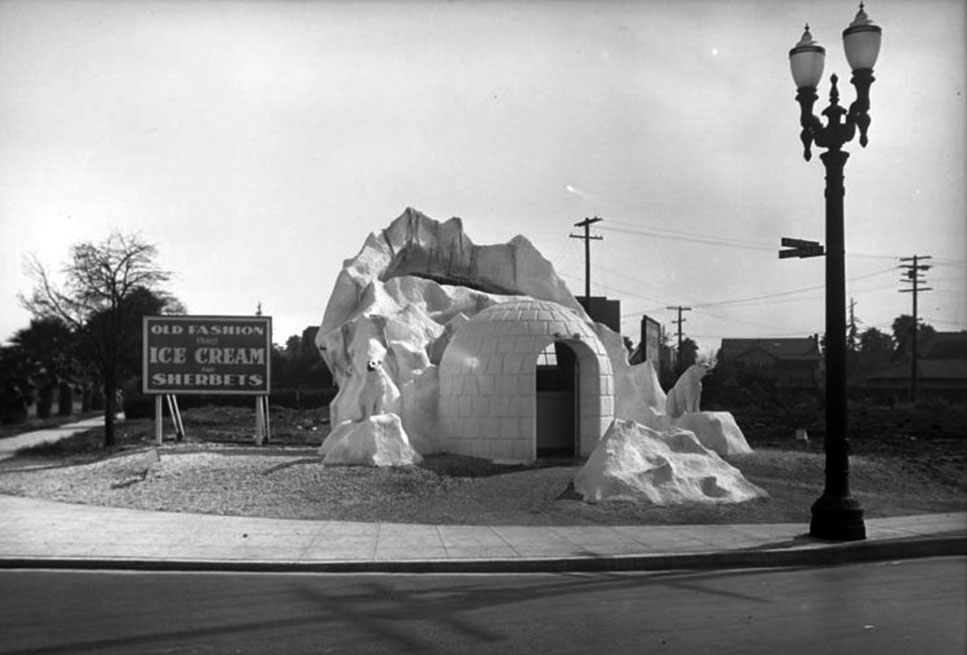 |
|
| (ca. 1930)* - View showing a dual-lamp Union Metal streetlight (UM-1931) located on the SW corner of Pico Blvd and Victoria Ave. |
Historical Notes In the above photo is an odd looking structure in the form of an Igloo. It was an Ice Cream parlor with the name of, you guessed it, “The Igloo”. Click HERE to see more. |
Bolyle Heights (UM-1931)
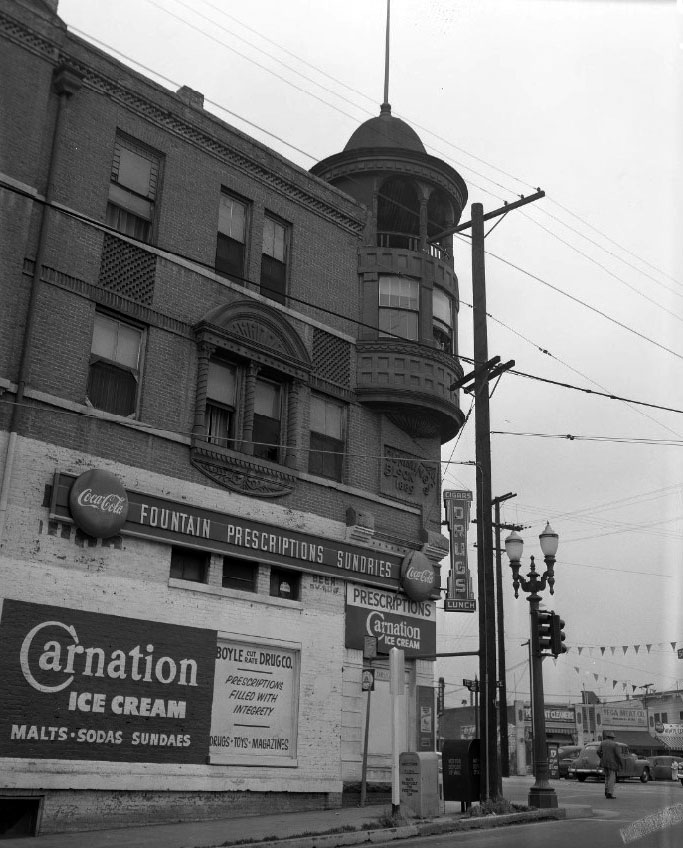 |
|
| (ca. 1950)* - View looking at northwest corner of E 1st St. and Boyle Ave showing an ornate two-lamp UM-1931 electrolier similar to the one seen in previous photo. The building at the corner is the 1889-built Boyle Hotel which still stands today. |
* * * * * |
Ventura Specials
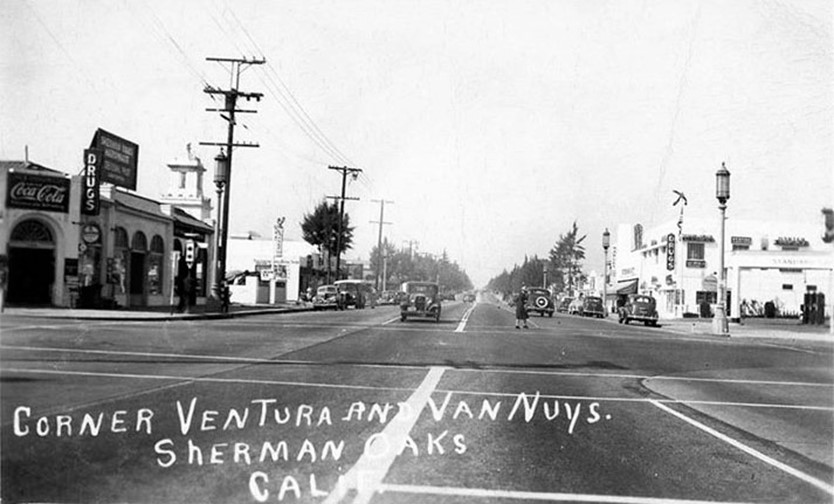 |
|
| (1940s)* - Looking west on Ventura Boulevard at Van Nuys Blvd in Sherman Oaks. “Ventura Specials” streetlights line both sides of the boulevard. |
Historical Notes The “Ventura Special" lined Ventura Boulevard from Sepulveda Eastward to Lankershim, and then Cahuenga Boulevard West from Lankershim to Hollywood Bowl. Although none of the full street lights survive, a few of the lanterns can be found on the Fletcher Drive Bridge over the L. A. River in Atwater Village. |
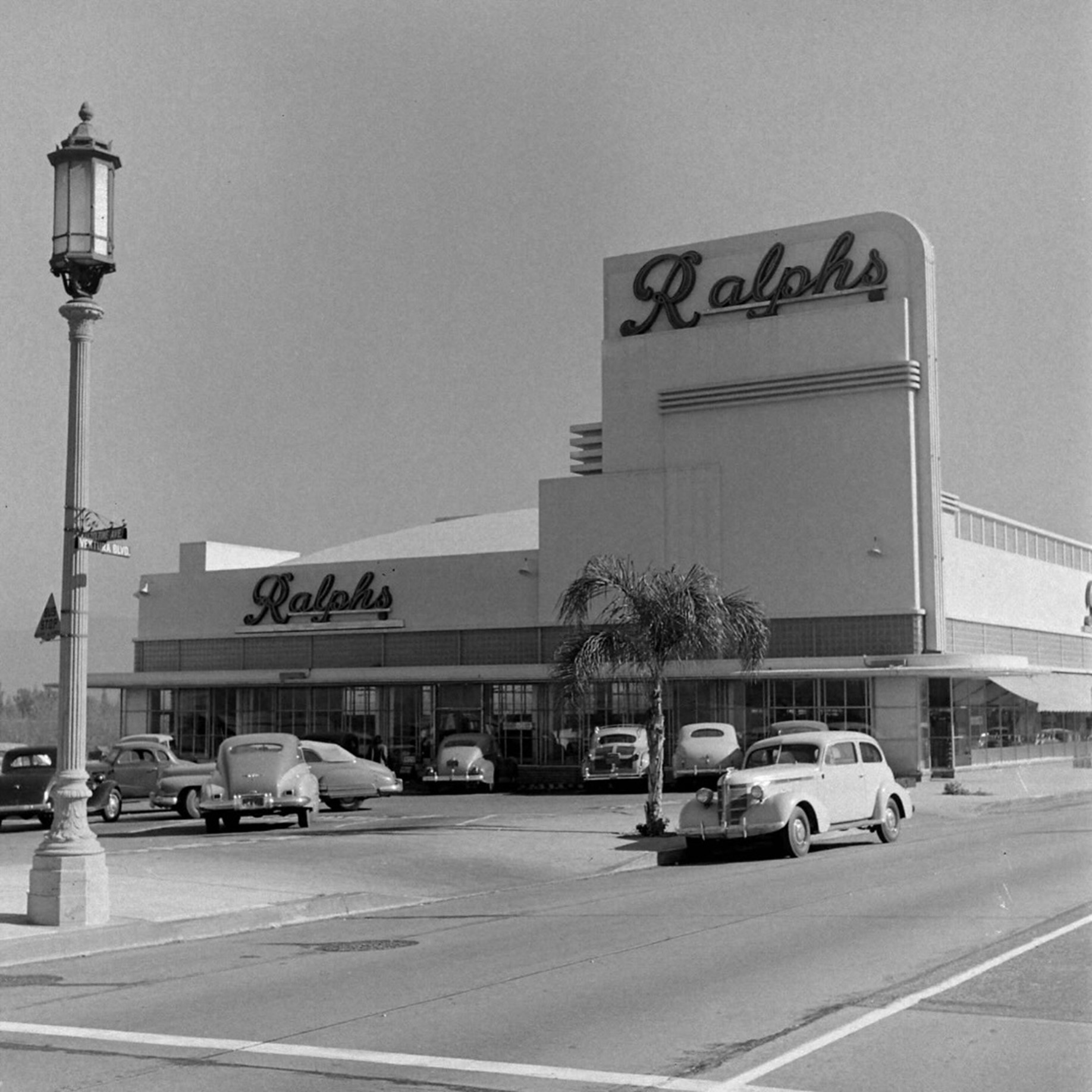 |
|
| (1948)* – A “Ventura Special” stands on the NE corner of Ventura and Hazeltine in Sherman Oaks in front of the Ralphs Market parking lot. |
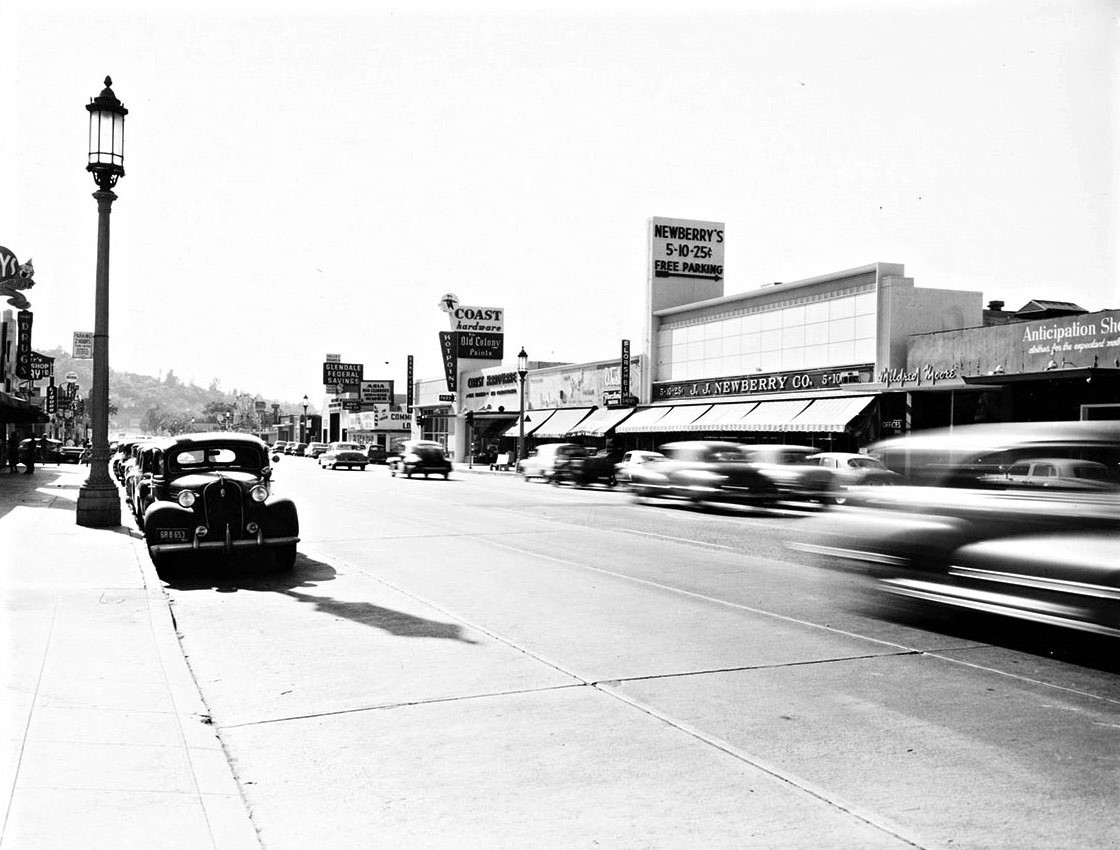 |
|
| (ca. 1950)* – Looking west on Ventura Boulevard in Studio City showing ‘Ventura Specials’ on both sides of the street. |
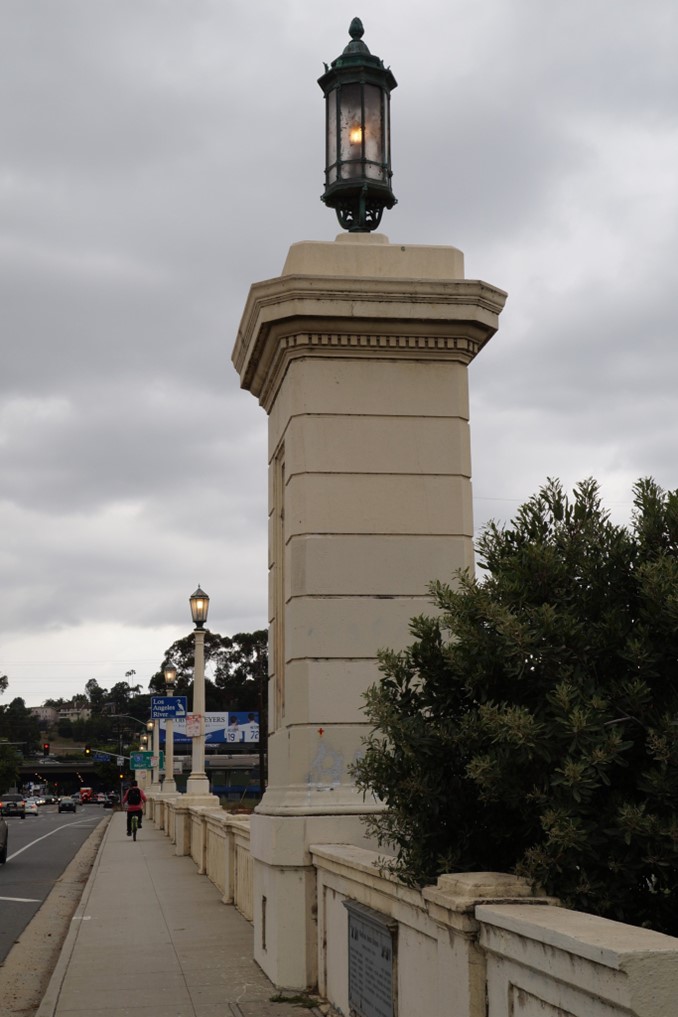 |
|
| (2023)* - One of four 'Ventura Specials' located here on the Fletcher Drive Bridge. Photo by Glen Norman |
Historical Notes There also used to be several Ventura Specials in more recent times. Here’s the census: Four on the Washington Boulevard Bridge over the L.A. River. According to Google Street View, two survive and two were stolen sometime between January 2023 and May 2024. Eight were located on the 7th Street Bridge over the Los Angeles River. All have been stolen sometime between February 2023 and May 2024, per Google Street View. That’s the sad part of life. But…life goes on. |
* * * * * |
Combination Streetlight Trolley Pole
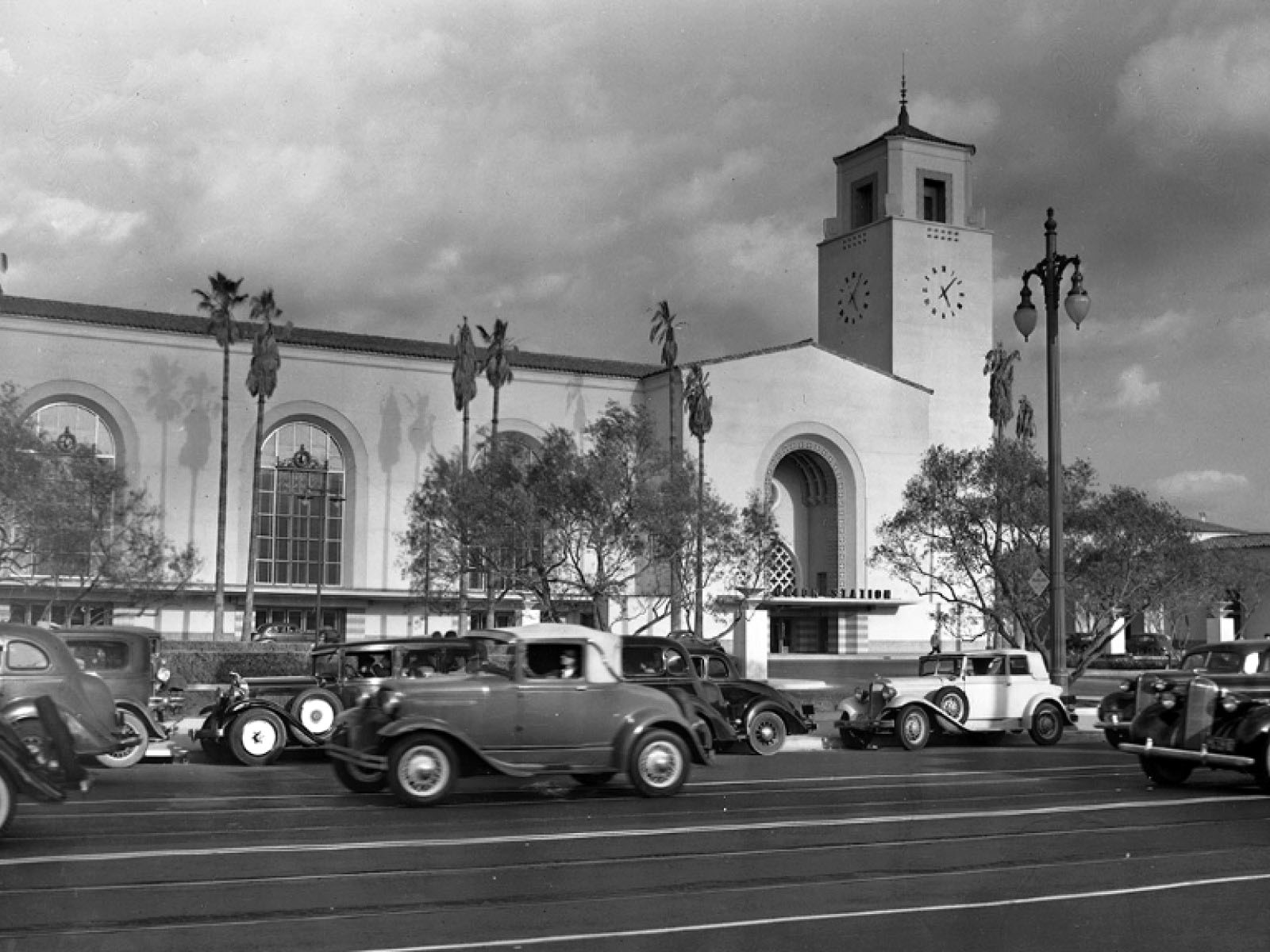 |
|
| (ca. 1939)^ – View looking across a busy Alameda Street with the new Union Station in the background. A combination streetlight trolley pole with dual-pendant style lamps is seen at right. |
Historical Notes Southern California was once home to the world's largest interurban electric railway system, the Pacific Electric Railway. Los Angeles also boasted the Nation's fifth largest urban trolley system, the Los Angeles Railway. This combination streetlight trolley pole on North Alameda Street is representative of many different styles of steel and concrete decorative poles used to support the 600-volt DC wires which supplied power to the streetcars and interurbans of the two companies. |
.jpg) |
|
| (ca. 1945)* - A decorative combination streetlight trolley pole is seen above. The dual-pendant style electrolier is still operating in front of Union Station (to the right and out of view). The United States Post Office Terminal Annex Building is seen across Cesar Chavez (formerly Macy Street). |
Historical Notes The Post Office Terminal Annex, a three-story building with two towers, was designed by Gilbert Stanley Underwood and built by Sarver & Zoss between 1939 and 1940. The building was known to open 24 hours a day and responsible for processing 2,000,000 mails per day including all incoming and outgoing mails in Los Angeles. It is located between Alameda Street and Cesar E. Chavez Avenue, across from the Los Angeles Union Station.^ |
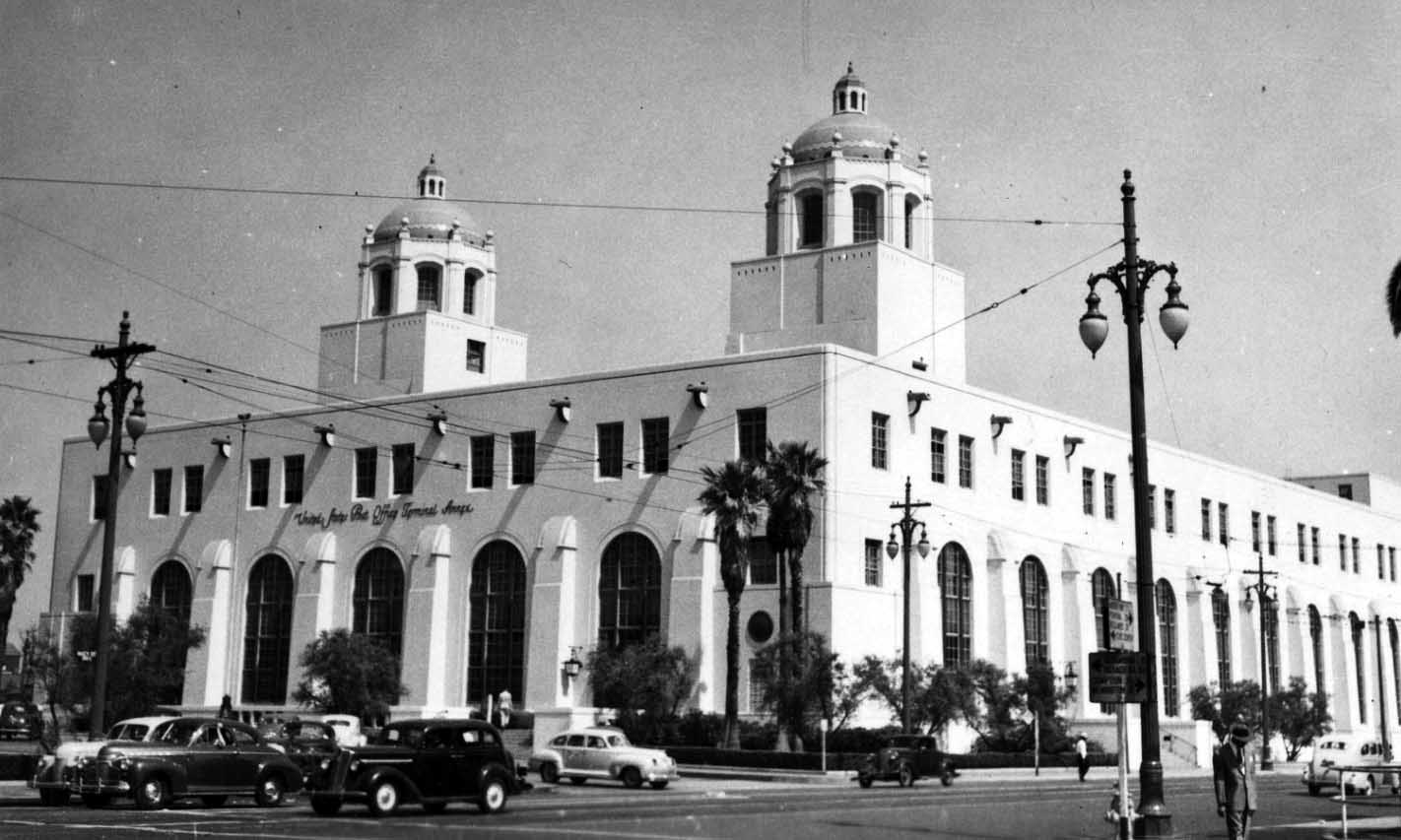 |
|
| (1940s)* - Cars pull out of the parking lot of the United States Post Office Terminal Building. Note the ornate dual-lamp tear drop decorative combination streetlight trolley pole. |
* * * * * |
Miracle Mile
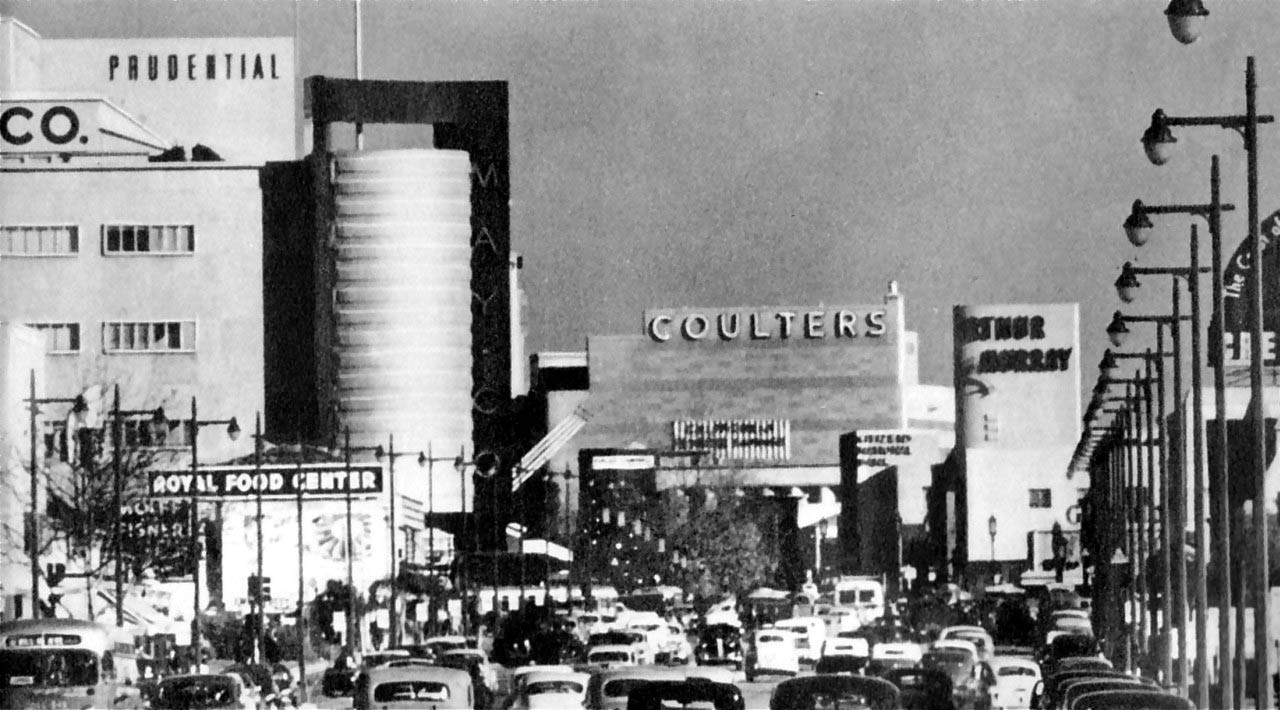 |
|
| (1940s)+## – Panoramic view looking east on Wilshire Boulevard through the Fairfax Avenue intersection. One arm streetlights line both sides of Wilshire. They appear to be spaced closer than they really are due to the telophoto shot. We can see the May Company department store (now part of LACMA and future home of the Hollywood museum of the Academy of Motion Picture Arts and Sciences), Prudential Building, Coulters department store, and the Arthur Murray dance studio. This “Miracle Mile” stretch of Wilshire Blvd is busy now but back then it looks positively jam-packed! |
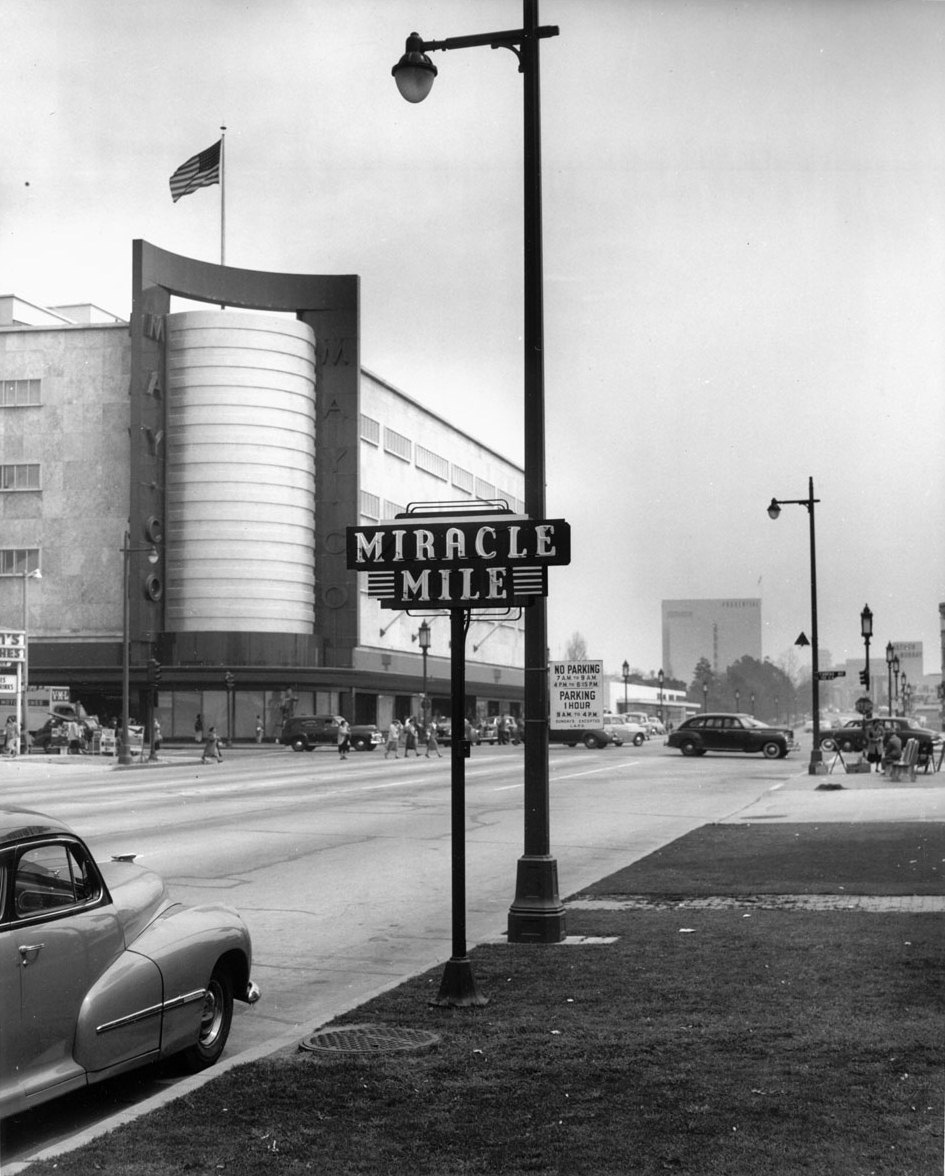 |
|
| (1948)*^ - View of the Miracle Mile and the May Company Building, looking east down Wilshire Boulevard at Fairfax Ave. Note how the design of the electroliers change from the east side of Fairfax to the west side. Click HERE to see more in Early Views of Wilshire and Fairfax. |
* * * * * |
'Metropolitan' Streetlights (Hollywood)
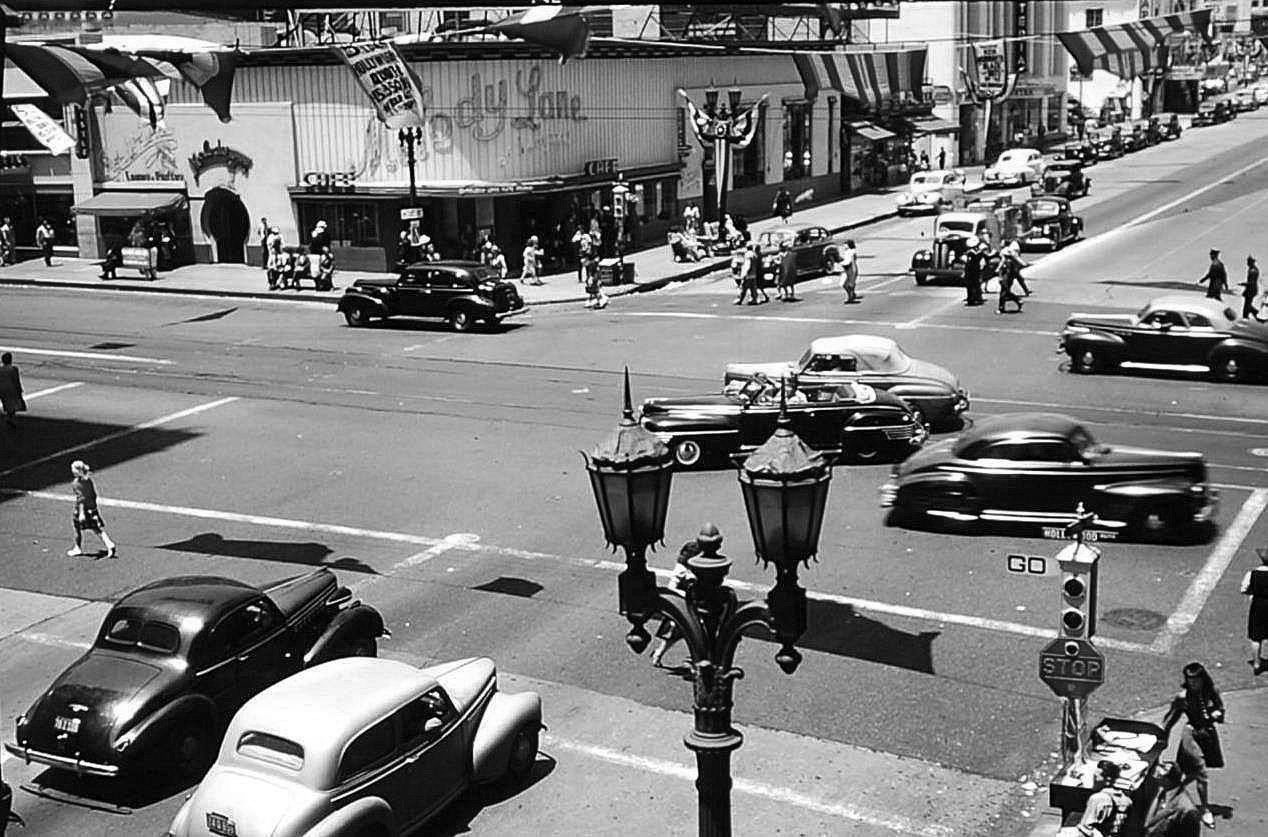 |
|
| (1947)^** - View toward the northwest corner of Hollywood and Vine, looking over an ornate two-lamp 'Metropolitan' streetlight. The traffic signal at lower right shows "GO" even though the intersection is full of cross-traffic. The famous Melody Lane Cafe can be seen on the NW corner. |
* * * * * |
'Genie Lamp' Streetlights (Hollywood)
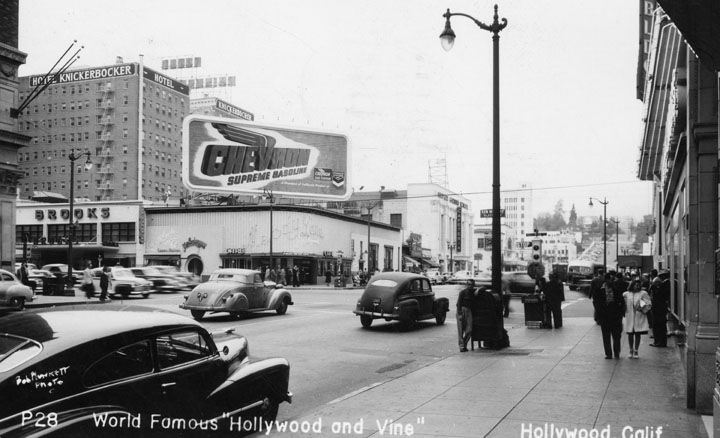 |
|
| (1949)^ - Curved one-arm electroliers on the corner of Hollywood and Vine in 1949. The view is north on Vine Street. Note that the streetlights at this intersection have been changed to single-arm pendant electroliers from two-lamp posts (see previous photo). |
Historical Notes The scroll arms (genie lamps) are in the style that began to appear just before WW2, but really took off post-war. Vine Street scroll arms first appeared in 1947. The Hollywood Blvd. group between Sycamore & Gower was particularly short-lived: 1947 & 1948, before being replaced with another design in the summer of 1948. |
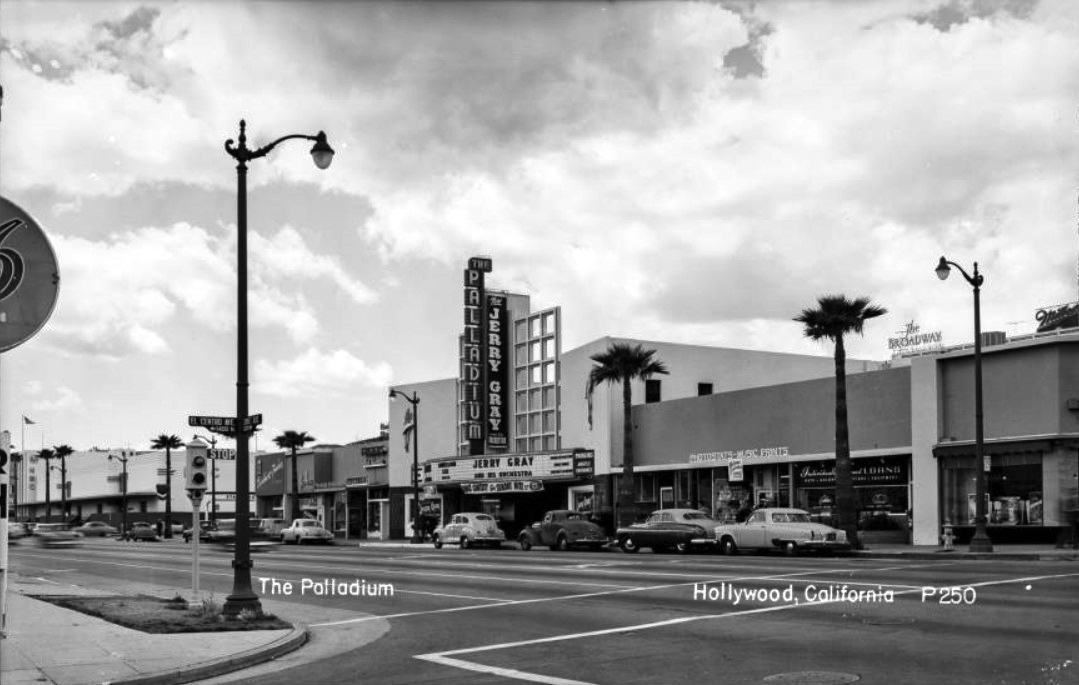 |
|
| (ca. 1950)* – View showing electroliers with curved one-arm pendants connected to assemblies resembling a 'genie lamp' running down both sides of Sunset Boulevard in Hollywood. The view is looking NW from El Centro Avenue, with the Hollywood Palladium at center, Radio City NBC Studios at far left and the Broadway Building Sign in the distance at right. The Palladium marquee reads "Jerry Gray and his Orchestra" next to a storefront with a sign for Photostats - Music Prints". |
Historical Notes Several of these street lights can still be found on Sunset West of Vine Street with updated LED luminaires. The scroll arms and shafts date from about 1948; the bases are from a circa 1924 installation of Union Metal 'Metropolitan' street lights throughout Hollywood. |
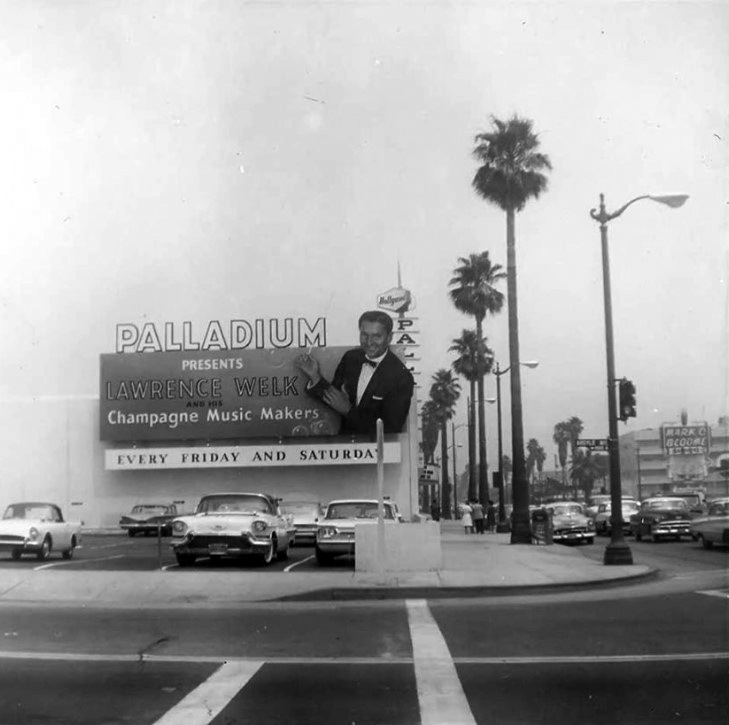 |
|
| (ca. 1959)* – View looking east from Argyle Avenue showing electroliers running in line with palm trees along Sunset Boulevard. Note how the streetlight lamp design has changed when compared to previous photo. A large bilboard sign reading Palladium Presents Lawrence Welk and his Champagne Music Makers is seen on the west face ofthe Palladium building. Mark C. Bloome can be seen across the street (south side of Sunset). Click HERE to see contemporary view. |
.jpg) |
|
| (ca. 1952)* - View looking west on Sunset at Vine as seen from in front of NBC Radio City. Wallach’s Music City is seen on the NW corner. |
 |
|
| (1947)* – Postcard view looking north on Vine Street from in front of NBC Radio City at Sunset Boulevard showing a single-arem Genie Streetlight on the right. Photo: Bob Plunkett. |
Historical Notes In 1947, Vine Street between Sunset Boulevard and Hollywood Boulevard was a bustling hub of Hollywood’s entertainment industry, heavily influenced by radio and television production. Landmark buildings like NBC’s Hollywood Radio City at Sunset and Vine and the newly constructed Mutual-Don Lee Studios at 1313 Vine Street solidified the area’s reputation as a center for media innovation. Tom Breneman’s Restaurant, famous for hosting live broadcasts of Breakfast in Hollywood, drew crowds eager to experience the glamour of live radio. Nearby businesses, such as Coffee Dan’s and local tailors and stationers, added to the vibrant commercial atmosphere. |
 |
|
| (2024)* – Looking north on Vine Street from the sidewalk in front of the Chase Bank parking lot near Sunset Boulevard. Note that where there was once a single-arm streetlight, a two-arm Genie-style streetlight now stands. |
Historical Notes Vine Street between Sunset and Hollywood boulevards has changed dramatically since 1947. Once the vibrant heart of Hollywood’s entertainment scene—lined with radio studios, Art Deco landmarks, neon-lit nightclubs, and spots like the Pantages Theatre and Owl-Rexall Drug Store—it buzzed with celebrities, tourists, and a sense of glamour. Today, while a few historic icons remain, Vine Street has shifted toward tourism, luxury development, and digital media, with high-rises, Netflix offices, and improved streetscapes that include wider sidewalks and bike lanes. Though still a popular destination thanks to the Hollywood Walk of Fame, the area now faces challenges such as homelessness and the loss of some historic venues. Vine Street continues to evolve as a modern, mixed-use corridor, blending echoes of its golden past with ongoing revitalization. |
 |
|
| (1947 vs. 2024)* – Looking north on Vine Street from in front of NBC Radio City, which once stood at the northeast corner of Sunset and Vine—now the site of Home Savings & Loan and its parking lot, just to the right of the contemporary image. Photo comparison by Jack Feldman. |
* * * * * |
Hollywood Single-Arm Pendant
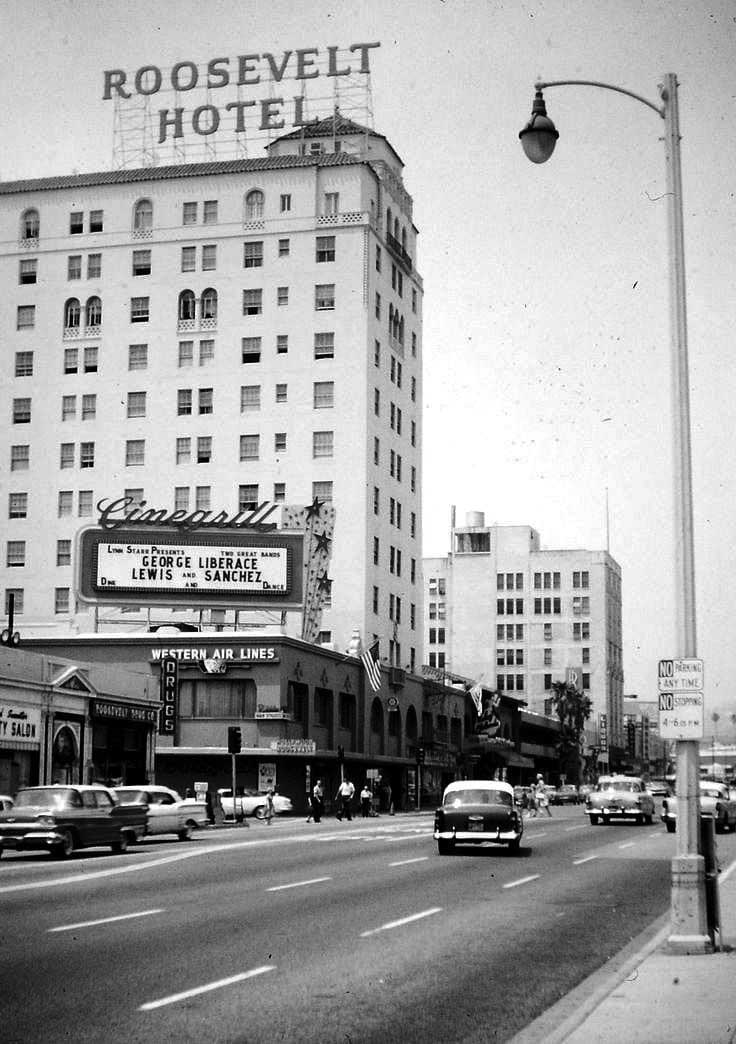 |
|
| (ca. 1958)* - A single-arm pendant electrolier stands tall on the north side of Hollywood Boulevard with the 1927-built Roosevelt Hotel seen in the background. |
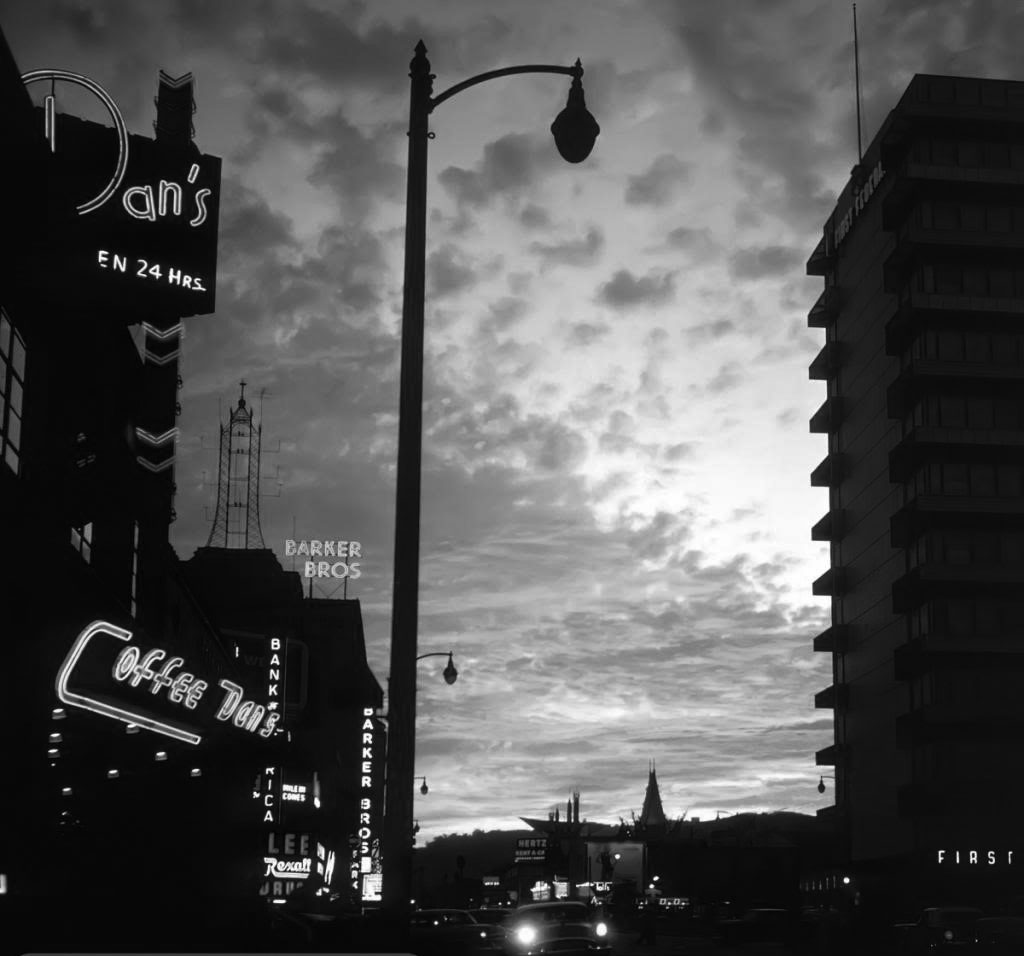 |
|
| (1959)*++– View looking west on Hollywood Boulevard at Highland Avenue showing single-arm pendant electroliers running down both sides of the Boulevard. The First Federal Savings and Loan Building can be seen at right (N/W corner), future site of the Hollywood and Highland Center, the current home of the Academy Awards. The Grauman's Chinese Theatre is seen in the distance. Coffee Dan's, on the left, was a familiar landmark in Hollywood for decades. |
Hollywood Metropolitan
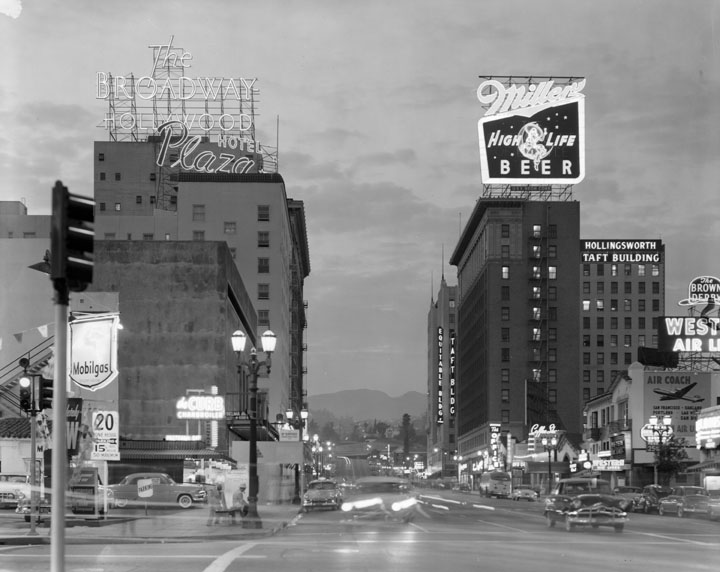 |
|
| (ca. 1950s)^ - View at dusk on Vine Street from Selma Ave. Two-lamp ornate 'Metropolitan' streetlights illuminate Vine St. along with the neon signs atop the buildings. |
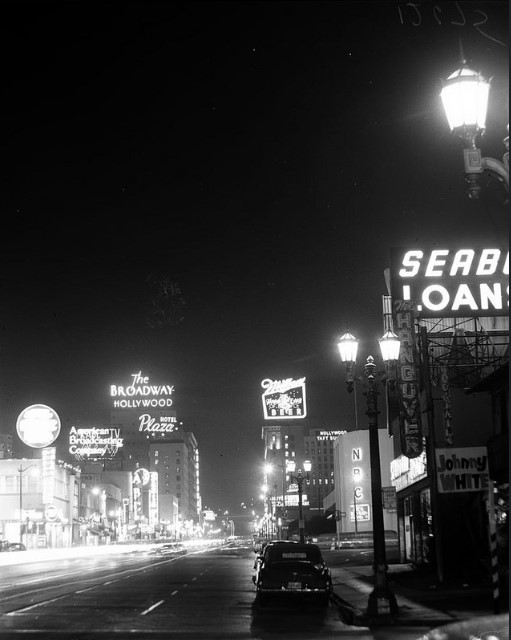 |
|
| (1950s)^^# - View of Vine Street looking north, ilumminated by both 'Metropolitan' streetlights and neon signs. |
GE Form 81 Teardrop Electroliers (Downtown)
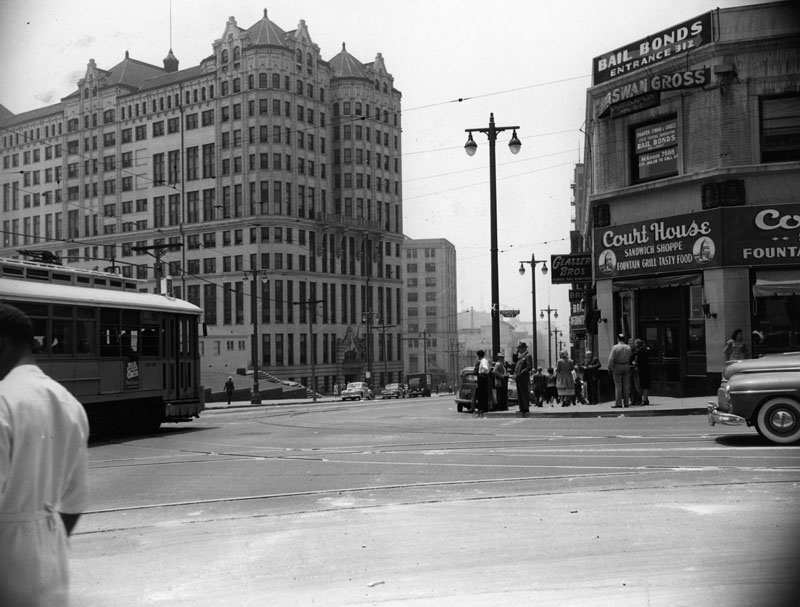 |
|
| (1945)* - Dual-lamp teardrop streetlights at Broadway and Temple in downtwon L.A. The Hall of Records Building is seen across the street. |
.jpg) |
|
| (ca. 1949)* - View showing a DWP streelight maintenance worker changing out a GE Form 81 teardrop lamp. In the background can be seen the Municipal Water and Power office building (aka Merchants Trust Building) located at 207 S. Broadway. |
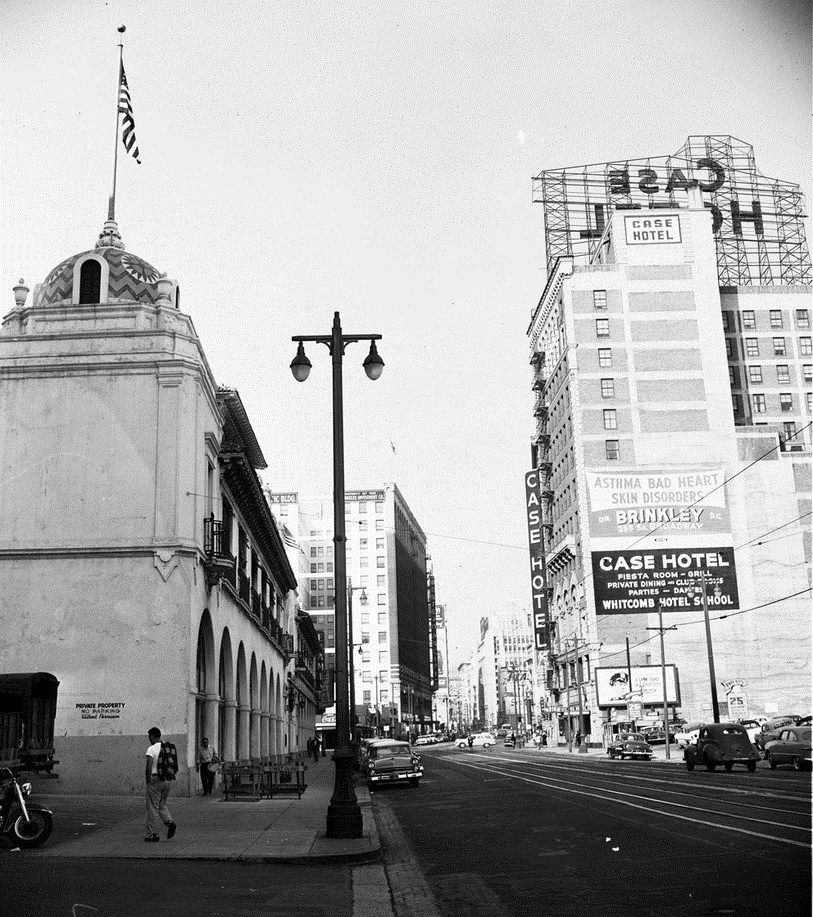 |
|
| (ca. 1950s)*^ - View looking north on Broadway toward 11th Street. A dual-lamp streetlight stands on the corner next to the Herald Examiner Building. The Case Hotel is seen on the southeast corner of Broadway and 11th. |
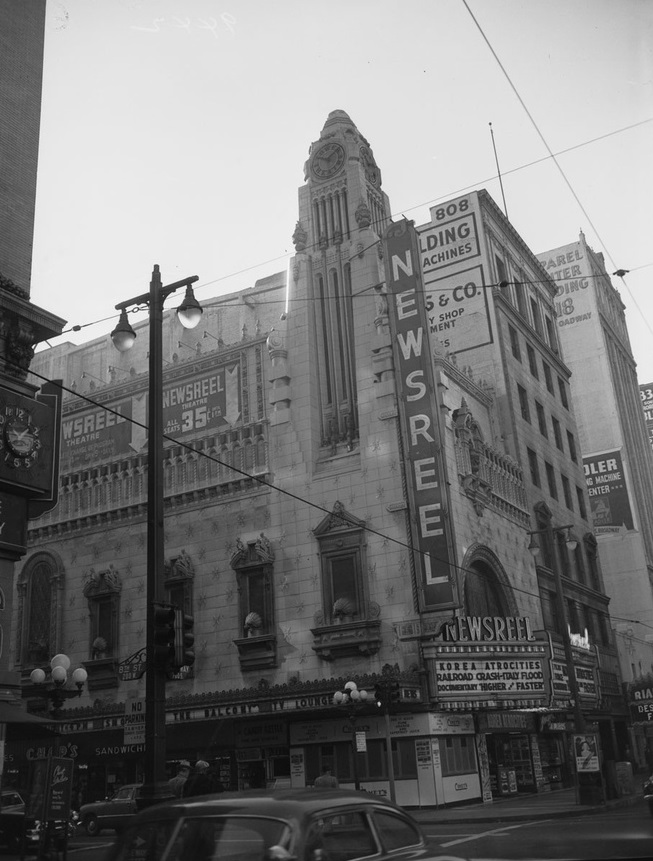 |
|
| (1951)*^ - View of the Newsreel Theater (aka Tower Theatre) on the corner of Broadway and 8th Street. Here we see the confluence of two types of streetlights: the ornate five-bulb lamps runing east-west on 8th Street and the newer GE Form 81 teardrop dual-lamp streetlights runing along Broadway. |
 |
|
| (1950s)^ - View showing one of downtown's busiest intersections, Broadway and 7th Street, during mid-day. The State Theatre on the corner is showing "The Brothers Karamazov." Again, here we have the confluence of two different types of streetlights, one running up and down Broadway and the other down 7th Street. |
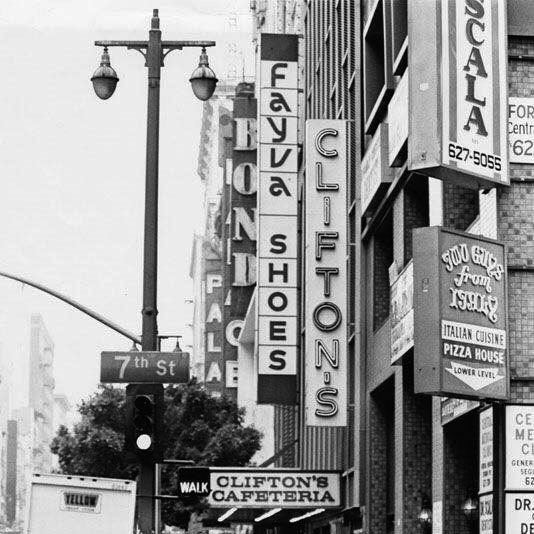 |
|
| (ca. 1980)^.^ – View looking north on Broadway from 7th Street showing a GE Form 81 teardrop dual-lamp streetlight in front of Clifton's Cafeteria. |
* * * * * |
.jpg) |
|
| (1952)*^ – Sometimes even streetlights get in the way. View shows Officer H.L. Chapman holding a license plate at the scene of a traffic accident (corner of 8th and Bonnie Brae streets) with a downed electrolier lying on the ground. |
* * * * * |
1st Street Dual-lamp Tear Drop Combination Streetlight Trolley Poles
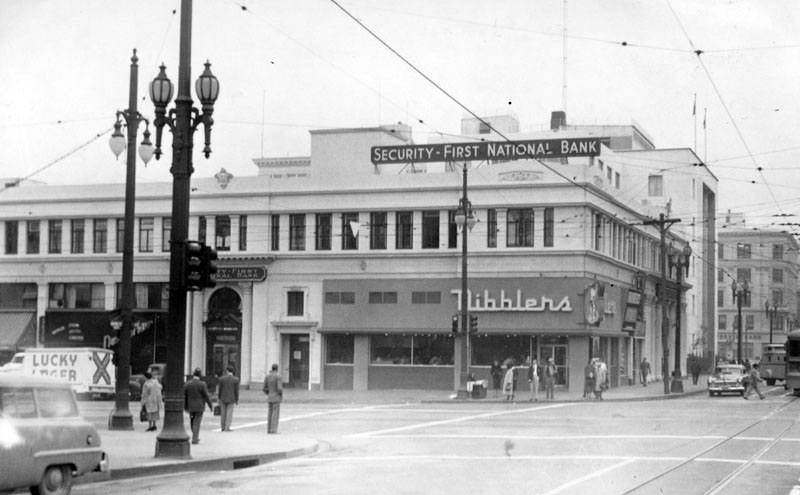 |
|
| (ca. 1953)^ - View is looking southeast toward the corner of First and Spring streets. The Nibblers Restaurant stands at that corner. Note how two different styles of streetlights come together at this intersection. Both are combination streetlight-trolley poles. |
 |
|
| (1958)* – Looking west from 1st and Hill streets showing the Los Angeles County Courthouse with dual-lamp tear drop decorative combination streetlight trolley pole running along 1st Street. |
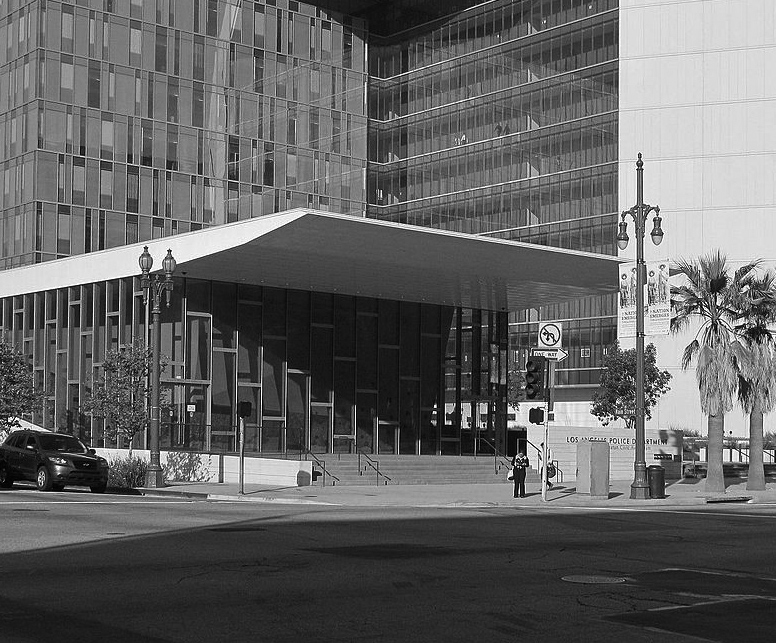 |
|
| (2012)*^ - Two different styles of streetlights front the new LAPD Headquarters Building, at the SW corner of First and Main streets. |
Freeway Lighting
 |
|
| (1951)^ – View showing new lights being installed on the Hollywood Freeway (101 Freeway), still under construction, with the Federal Courthouse, Hall of Justice, and City Hall seen in the background. Click HERE to see more on the construction of the Hollywood Freeway through the Civic Center. |
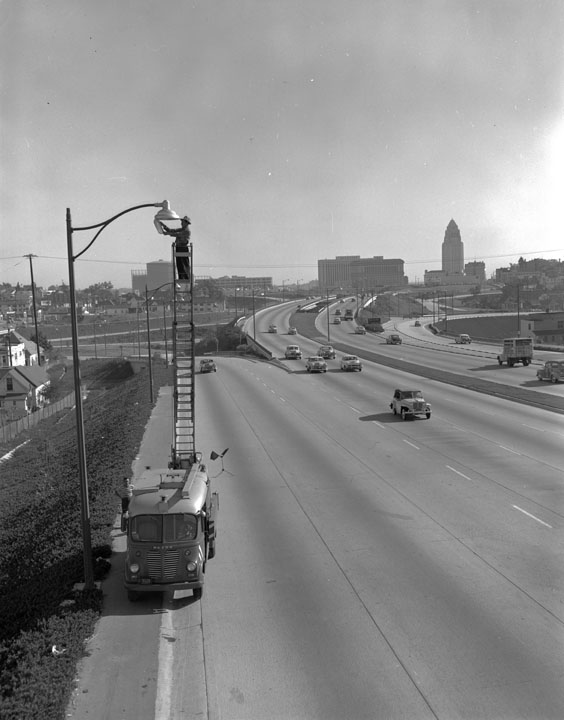 |
|
| (1952)* - View looking toward the Four Level Interchange on the Hollywood Freeway showing a Street Lighting Maintenance unit. Caption reads: Modern-day lamplighter seen against Los Angeles' downtown skyline is James Salazar of the Street Light Maintenance section. These lights on the Hollywood Freeway don't have to be lit by hand, of course, but they do require washing and globe replacement. On ground is Joe J. Restivo. Truck with electrically operated ladder is one of four used by the Street Light section. |
Historical Notes The Four Level Interchange was the first stack interchange in the world. Completed in 1949 and fully opened in 1953 at the northern edge of Downtown Los Angeles, it connects U.S. Route 101 (Hollywood Freeway and Santa Ana Freeway) to State Route 110 (Harbor Freeway and Arroyo Seco Parkway).^* |
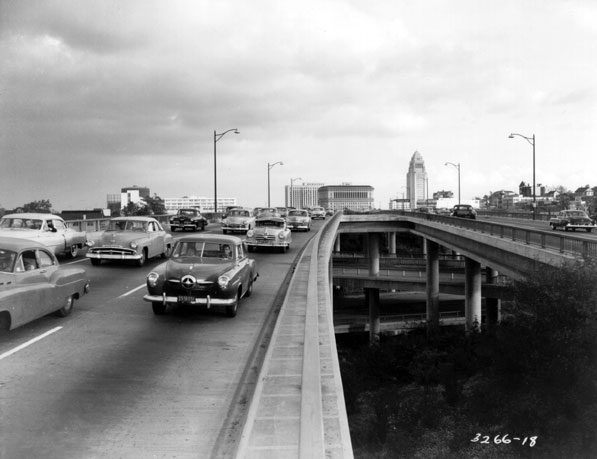 |
|
| (1953)^^ - View showing streetlights running along the outer sides of the Four Level Interchange, looking east toward City Hall. |
Historical Notes The interchange was constructed as a stack interchange because surrounding buildings and terrain made construction of a cloverleaf interchange impractical. The mainline traffic of US 101 is at the top of the interchange, above the ramps, a rarity in stack interchanges. Its distinctive architecture has long made it a symbol of Los Angeles' post-World War II development, and it appears on numerous postcards of the 1950s and 1960s.^* |
 |
|
| (1954)^ - Streetlights are positioned to illuminated the lower sections of the Four Level Interchange. |
Historical Notes The Four Level, also known as the Stack, gets its name from its multi-tiered structure that separates traffic heading in each direction into dedicated lanes. On the bottom level are curved ramps for those changing from the 110 freeway to the 101. One level above is the main trunk of the 110 freeway, named the Arroyo Seco Parkway north of the interchange and the Harbor Freeway south of it. On the third level are the arcing flyover ramps carrying traffic from the 101 freeway to the 110. Finally, on the fourth and top level is the main trunk of the 101 freeway, named the Hollywood Freeway to the west and the Santa Ana Freeway to the east.^ |
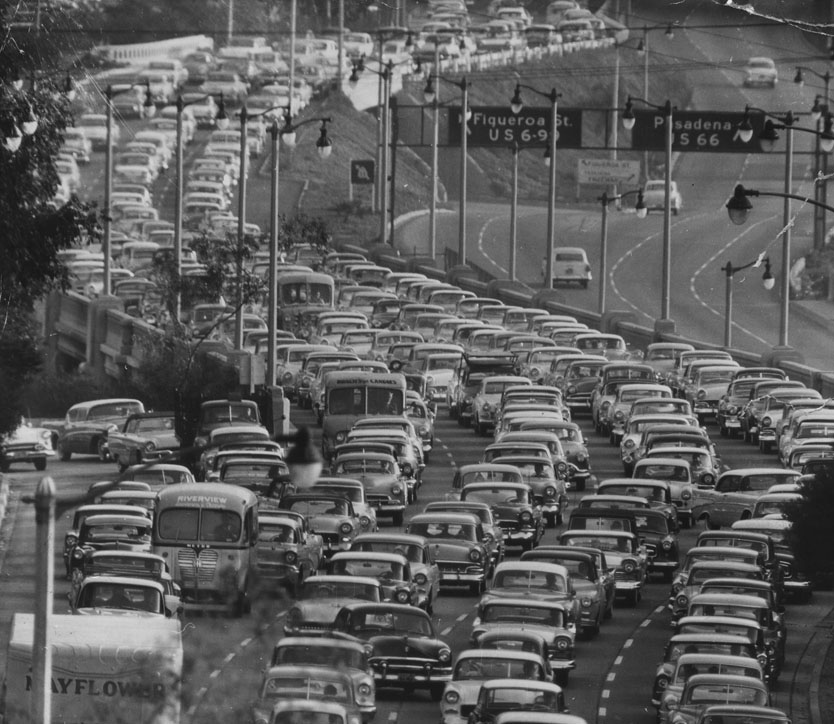 |
|
| (1956)^ – View showing single-arm pendant electroliers on the Pasadena Freeway with densely packed traffic travelling southbound as seen from Park Row Drive overlooking the Freeway near Civic Center. |
Historical Notes Between 1954 and 2010, Arroyo Seco Parkway was officially designated the Pasadena Freeway. In 2010, as part of plans to revitalize its scenic value and improve safety, Caltrans renamed the roadway back to its original name. All the bridges built during parkway construction remain, as do four older bridges that crossed the Arroyo Seco before the 1930s.*^ |
 |
|
| (1955)*^ - A singular electrolier stands tall on top of College St. Bridge over the Arroyo Seco Parkway. The view is looking north. In the distance can be seen the San Gabriel Mountains partly covered with snow. |
Historical Notes See More Bridge Lighting (College Street Bridge; First Street Bridge; Fourth Street Viaduct; Fourth and Lorena Streets Bridge; Glendale-Hyperion Bridge; Macy Street Bridge; Mulholland Bridge; Sixth Street Bridge; Washington Blvd Bridge) |
* * * * * |
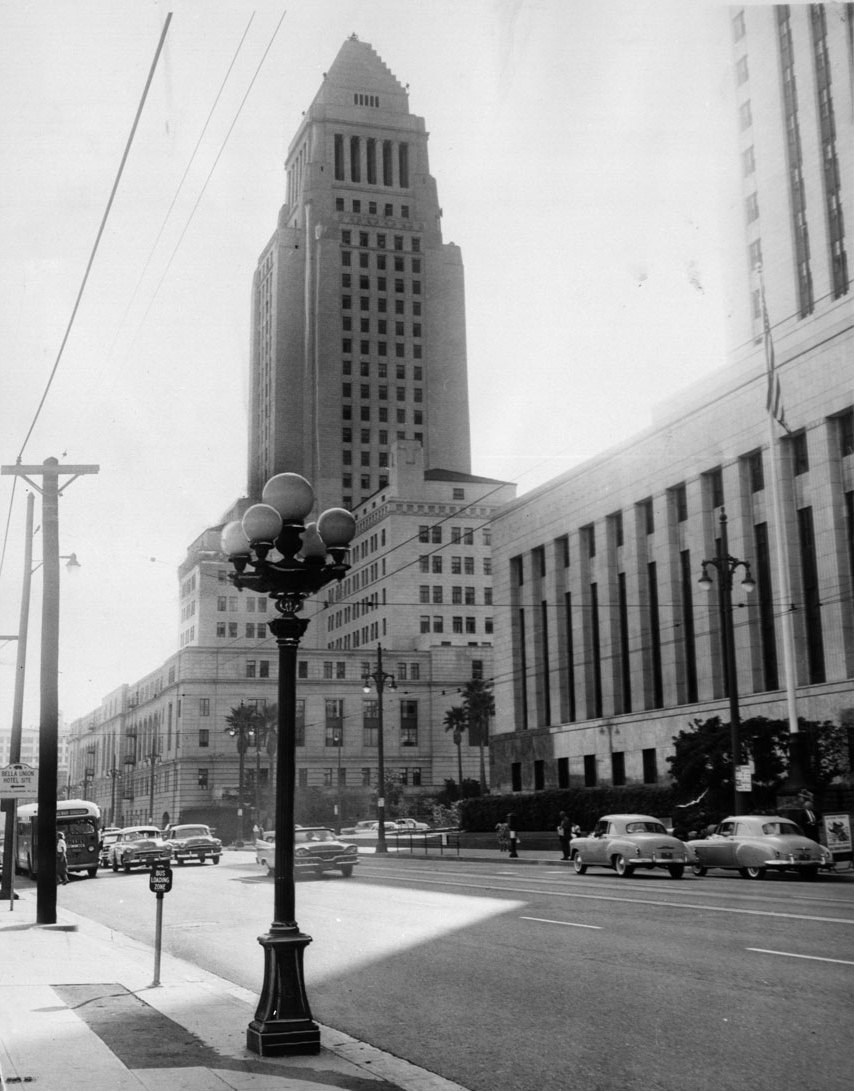 |
|
| (1959)*^ - A five-globe lamp post with City Hall in the background. Today, the last remaining of these ornate street lights can still be found in the gardens and malls adjacent to City Hall. |
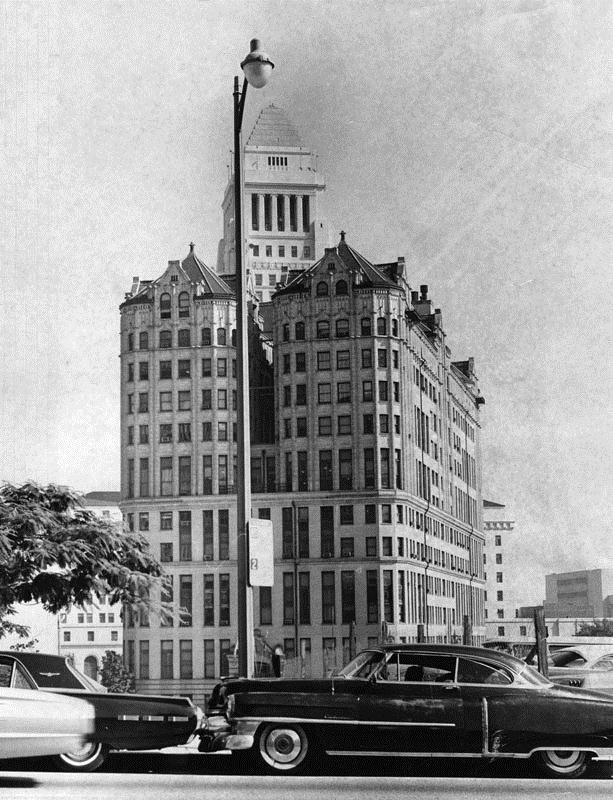 |
|
| (1965)^ - View of a single-post arm electrolier in front of the Hall of Records with City Hall in the background. |
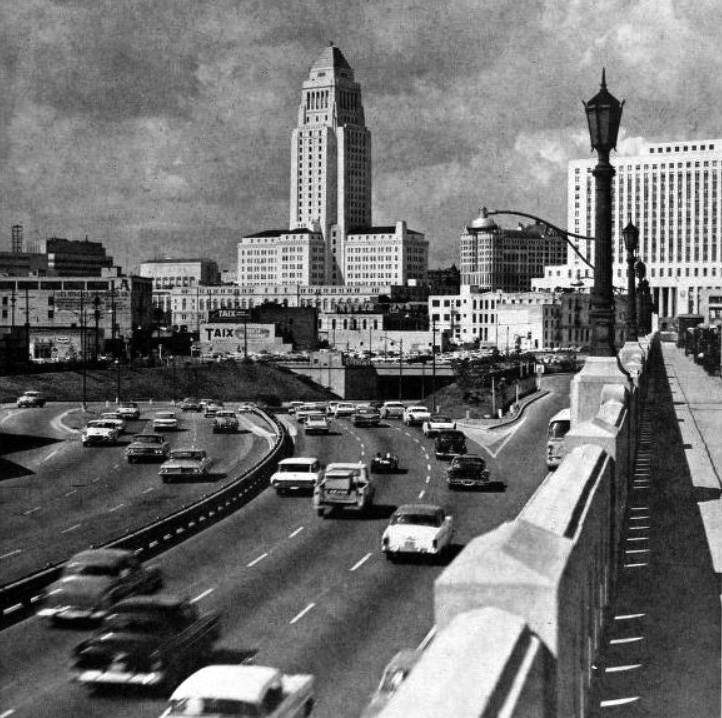 |
|
| (1962)^.^ - Santa Ana Fwy (US-101) at Union Station near Alameda St -- view looking southwest. ‘Metropolitan’-style electroliers line the concrete railing on the right. |
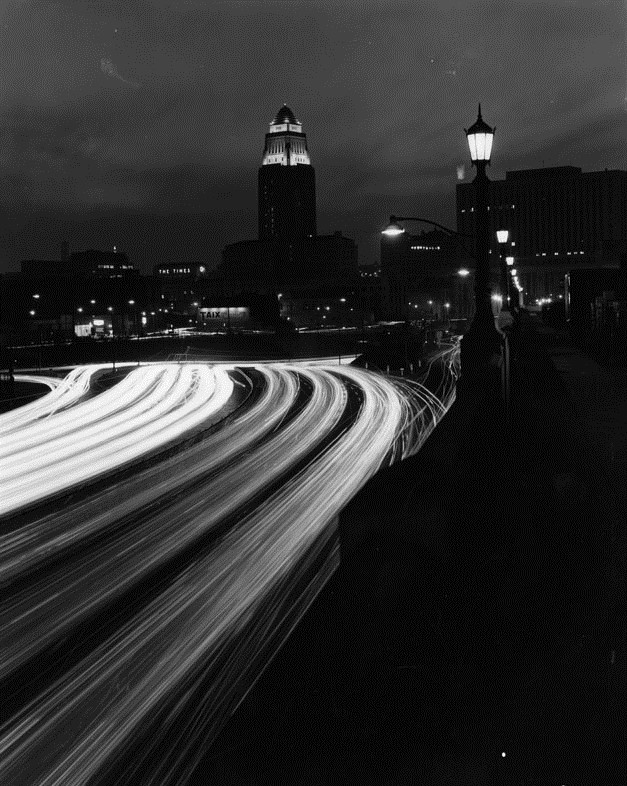 |
|
| (1962)^ - Nighttime view of Los Angeles and City Hall, looking southwest from the Union Station at the Santa Ana Freeway (same view as previous photo). A billboard for the French restaurant "Taix" and "The TIMES" up in lights on the top of a building appear in the background. |
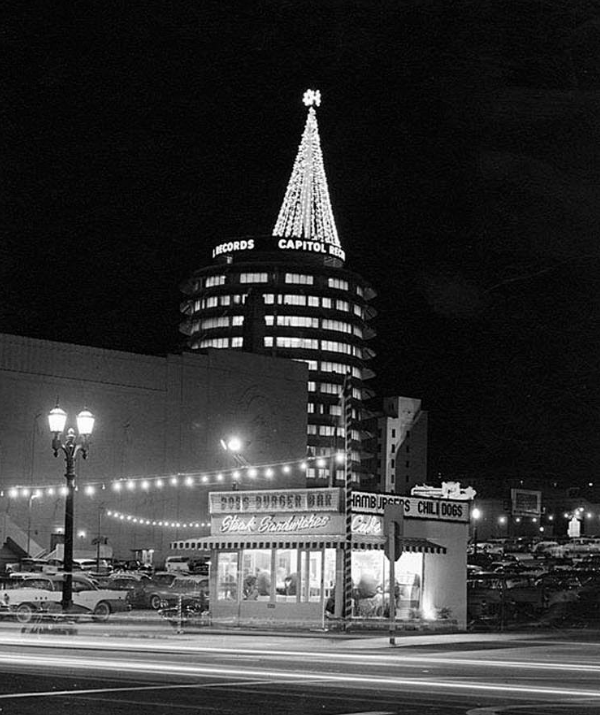 |
|
| (1962)#^* – View showing an ornate two-lamp 'Metropolitan' electrolier standing near the northwest corner of Hollywood Boulevard and Argyle Avenue. The Pantages Theatre is to the left and in the foreground stands a small hamburger stand. The Capitol Records Building, with Christmas Tree on top, is seen in the background. |
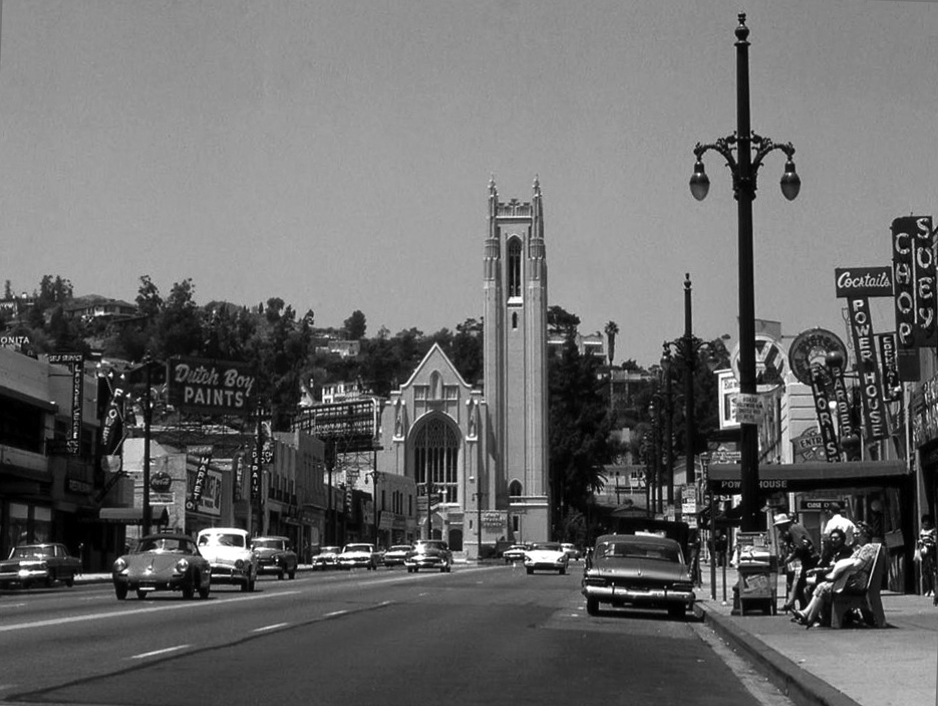 |
|
| (1960s)#** – An incandescent electrolier with dual-lamps, curved cross-arms, and extended post stands on the east side of Highland Avenue just north of Hollywood Boulevard. The Hollywood United Methodist Church can be seen in the background on the corner of Highland and Franklin. |
* * * * * |
The Davit Streetlight (aka Cobra Streetlight: 1950-1980)
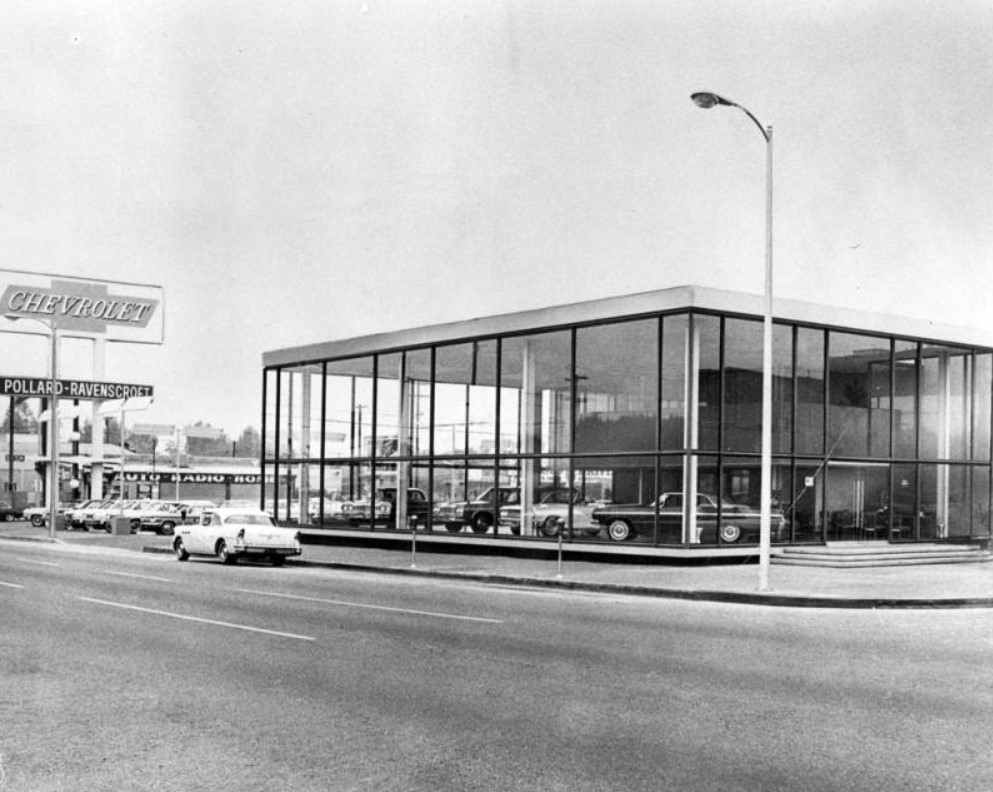 |
|
| (1964)* – View showing a Davit or Cobra-head street lamp in front of the Pollard-Ravenscroft Chevrolet dealership at 6001 Van Nuys Boulevard. |
Historical Notes The extended-arm electrolier that dominated the postwar period was called the Davit Streetlight. It was so named because of its resemblance to the arm hoist used for raising and lowering boats and anchors. Unlike earlier streetlights Its design was typically unornamented. |
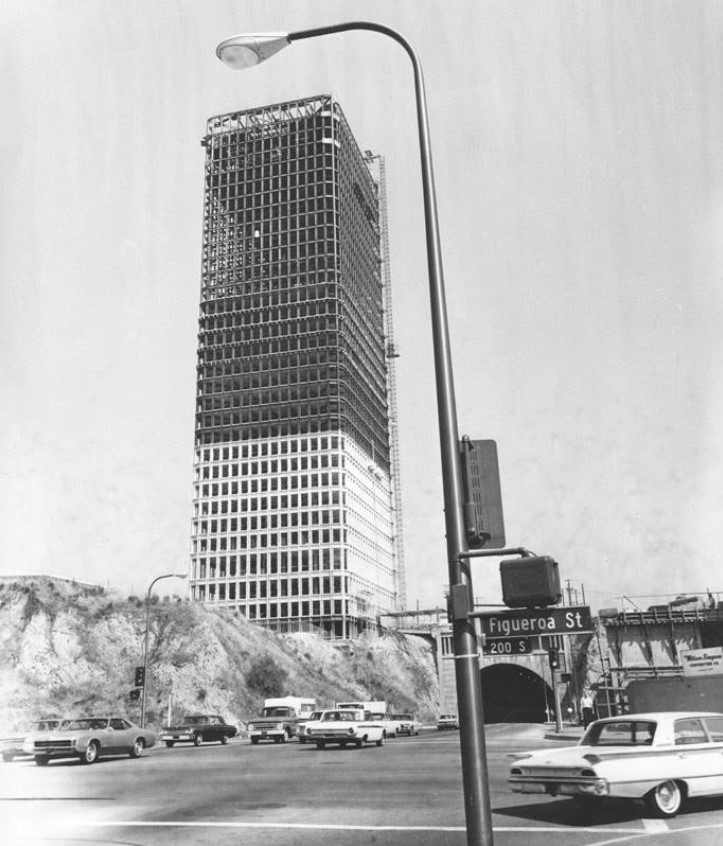 |
|
| (1968)#+ – View looking east toward the west end of 2nd Street Tunnel as seen from the southwest corner of 2nd and Figueroa where a davit-style sreetlgiht stands. In the background can be seen Bunker Hill Tower, still under construction. |
Historical Notes The Davit Streetlight used a different type of lamp, based on improvements in HID lighting technology. Lamps were horizontally-mounted, rather than vertically as with the earlier pendants. This permitted a larger lamp in a housing, or optical assembly, which included reflector and prisms to direct the light. Along with this change in the lamp size and orientation came improvements in the gasses used. |
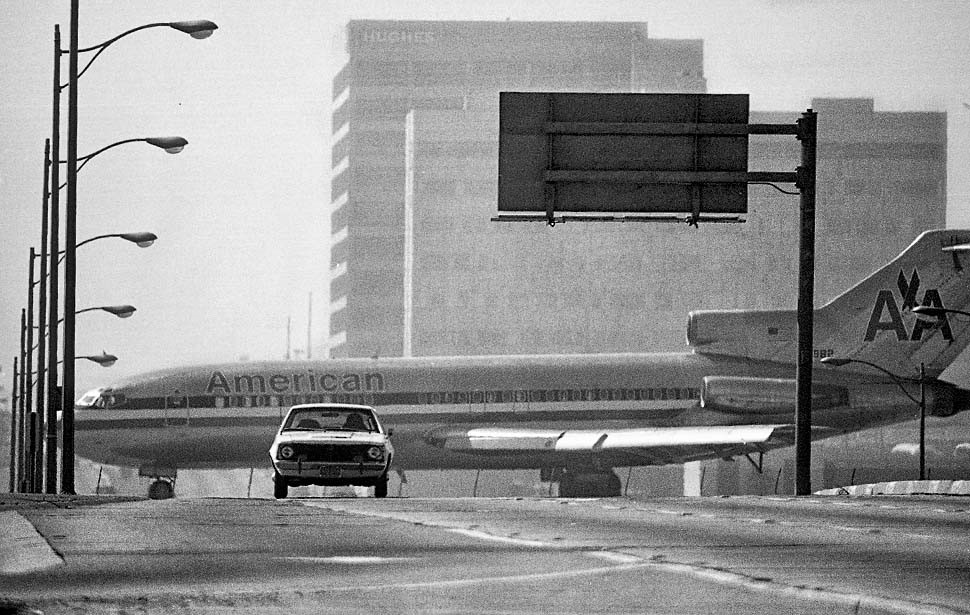 |
|
| (1976)^^# - View through a telephoto lens looking north on Sepulveda Boulevard showing an American Airlines jet crossing over the Sepulveda Tunnel - making for a good optical illusion. Davit-style streetlighs are sees on the west side of the street. Photo by Rick Meyer |
Historical Notes By the late 1970s, sodium had replaced mercury as the most common form of lamp. The result was a significant change in the height and spacing of street lights. The improvement in lighting power allowed the electroliers to be taller and placed further apart. Longer arms extended the lamp over the street, and the reflectors and prisms threw the light toward the center of the roadway. The horizontal orientation of the optical assembly, attached to a curved arm, inevitably gave this type of street light the popular name of cobra-head.^ |
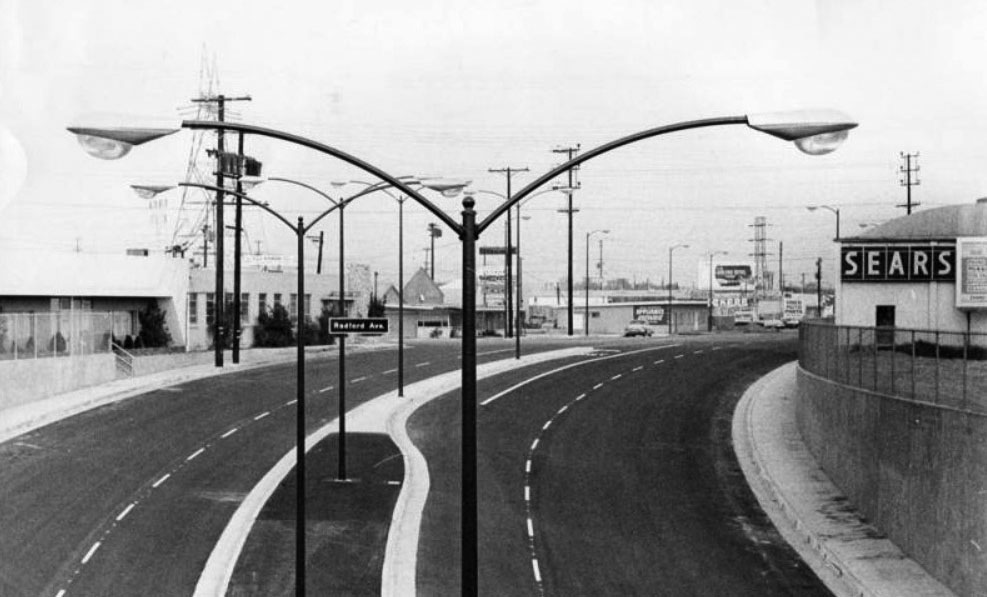 |
|
| (1963)* - View showing dual-lamp mercury vapor electroliers on Sherman Way between Lankershim Blvd. and Laurel Canyon Blvd. View is looking east on Sherman Way as seen from top of RR crossing. |
Historical Notes Mercury vapor lamps are more energy efficient than incandescent and most fluorescent lights, with luminous efficacies of 35 to 65 lumens/watt. Their other advantages are a long bulb lifetime in the range of 24,000 hours and a high intensity, clear white light output. For these reasons, they were used for large area overhead lighting, such as in factories, warehouses, and sports arenas as well as for streetlights.^ High pressure sodium lamps would replace the Mercury vapor lamps by the late 1970s. |
Montecito Heights, Los Angeles
 |
|
| (2019)^.^ – Beautiful nighttime telephoto view looking south on Monterey Road from Pullman Street showing dual-lamp electroliers lighting up the road below. Photo by Tony Valdez |
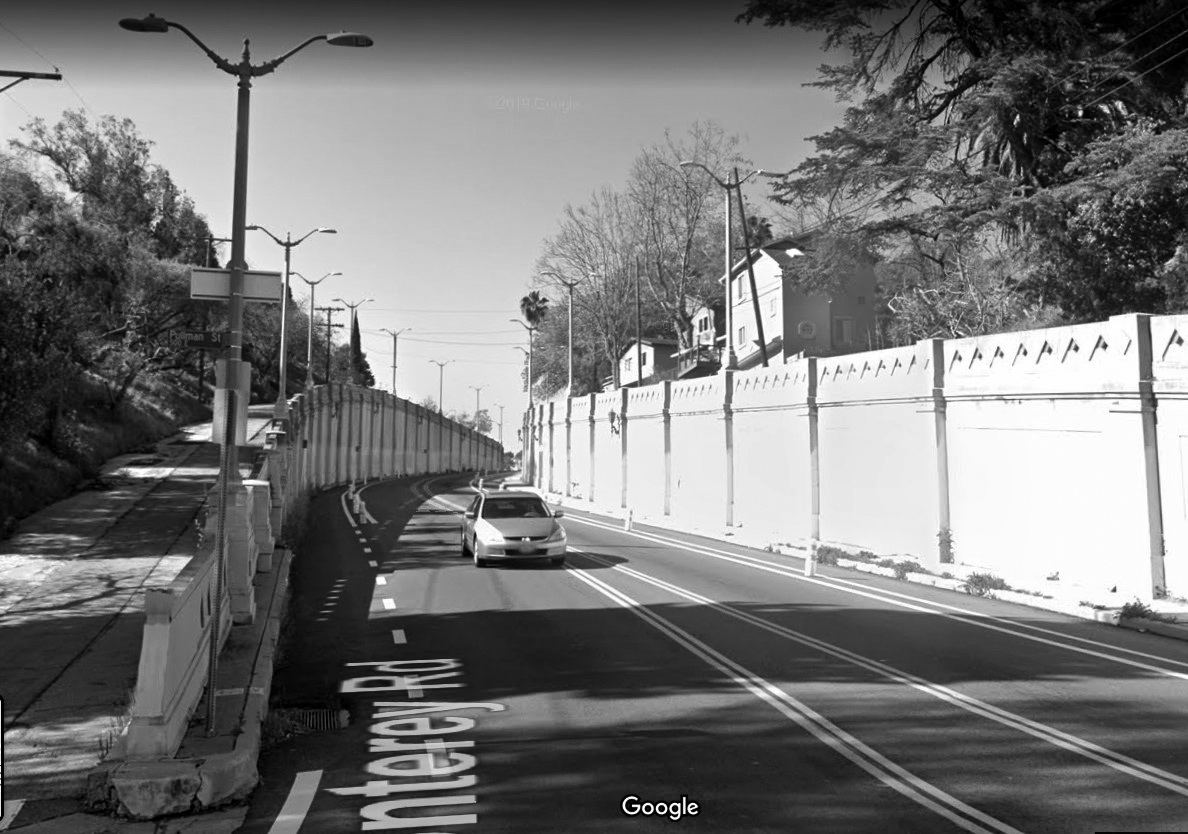 |
|
| (2019)**– Google street view showing the same intersection in daylight. Dual-lamp electroliers run along top of decorative concrete walls on both sides of Monterey Road at Pullman Street in Monecito Heights. |
Van Nuys Blvd Streetlights
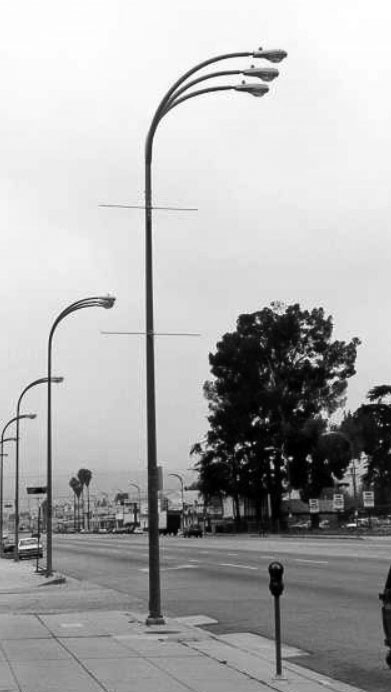 |
(1970s)^^ - View looking south on Van Nuys Boulevard showing the unique three-arm sltreetlights running down both sides of the street. |
Historical Notes These forked three-arm streetlights were chosen in the early 1970's by representatives of the Van Nuys business community to light Van Nuys Boulevard and Magnolia Boulevard. Originally, 1,000 watt mercury vapor lamps were used to provide on average five foot-candles. This turned out to be too bright and too costly from an energy level. Today, these three-pronged electroliers can still can be seen on and around Van Nuys Boulevard. However, the luminaires today are 250 watt high-pressure sodium. |
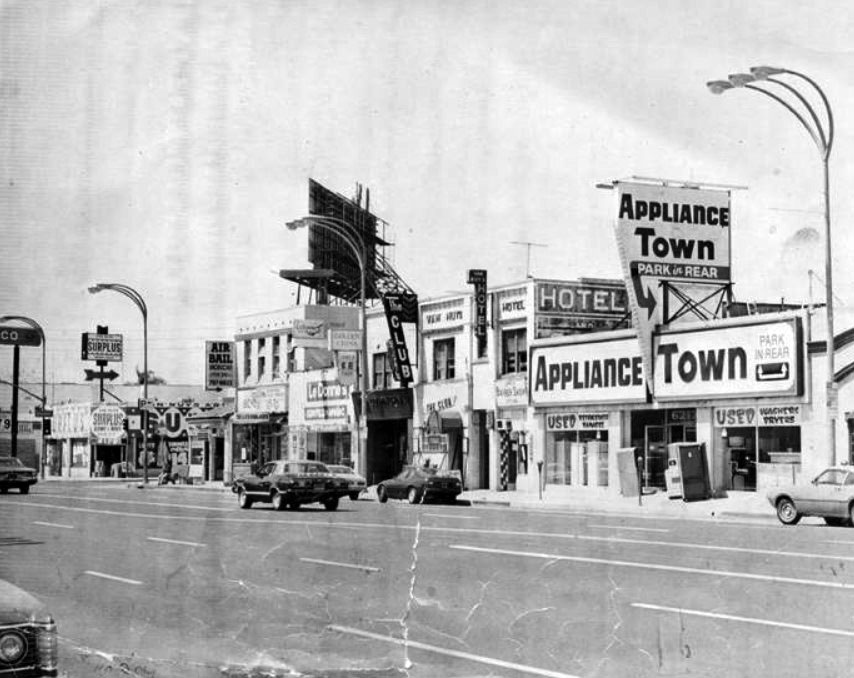 |
|
| (1970s)#^ – View looking southwest on Van Nuys Boulevard. Visible at center is 6211 Van Nuys Boulevard, known at that time as the Van Nuys Hotel. Note the forked three-arm streetlights running up and down Van Nuys Boulevard. Click HERE to see contemporary view. |
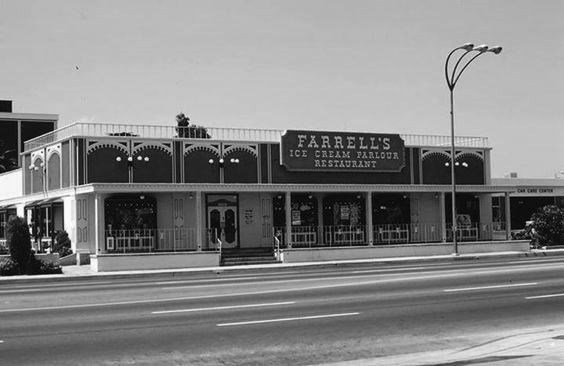 |
|
| (1978)* – 3-headed streetlight in front of Farrell's Ice Cream Parlour on Van Nuys Boulevard. At nighttime, this stretch of Van Nuys Boulevard was perfect for 'Cruising'. |
Hollywood Specials
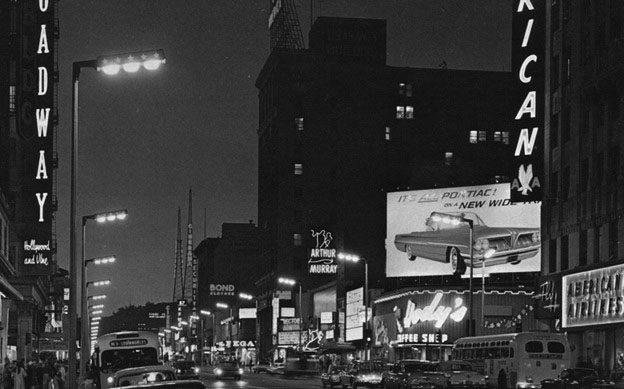 |
|
| (ca. 1964)* – View looking west on Hollywood Boulevard at Vine Street. The new 3-bulb ‘Hollywood Specials’ streetlights line both sides of the boulevard. The billboard above Hody’s Coffee Shop (NW corner of Hollywood and Vine) is advertising the new 1964 Pontiac convertibles. |
Historical Notes The most colorful of the postwar lights is the Hollywood Boulevard Special. Beginning around 1960 the existing electroliers on Hollywood Boulevard were reconstructed. The original pole bases and shafts were retained, but the lamps were replaced by luminaires on short arms. The Hollywood Special is a rectangular housing, over seven feet in length, in which three lamps are housed. The face of each side of the housing is adorned by red stars. |
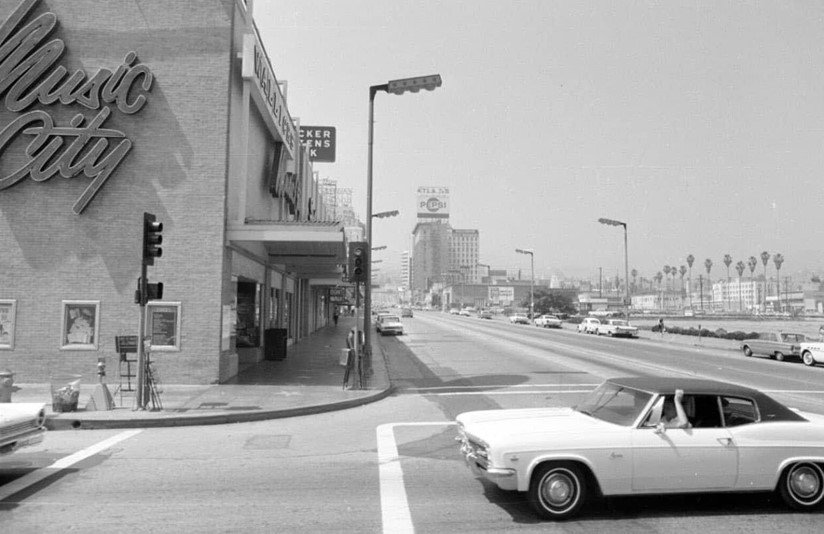 |
|
| (1965)* - Looking north on Vine Sreet at Sunset Blvd showing ‘Hollywood Special’ streetlights running on both sides of Vine as far as the eye can see. Also seen here is Wallichs Music City on the NW corner. Photo by Ed Ruscha. |
Historical Notes The "Hollywood Specials" streetlights, known for their distinctive three-bulb design and red stars, were installed along Hollywood Boulevard and Vine Street in the 1960s. These streetlights remained the predominant style in the area for over three decades, indicating they lasted at least until the late 1990s. They were a notable feature of Hollywood's streetscape during this period, contributing to the area's iconic visual identity. |
 |
|
| (1975)* – View looking north on Vine at Sunset, showing the Home Savings and Loan building on the northeast corner. Note the distinctive streetlights along Vine, known as 'Hollywood Specials,' which were a notable feature of the Hollywood streetscape from the 1960s through the 1990s. Photo by Roy Hankey. |
Historical Notes In the 1970s, the intersection of Sunset and Vine in Hollywood was still a vibrant cultural hub with deep ties to the entertainment industry. The area, once home to NBC Radio City, was transformed with the construction of the Home Savings and Loan building, designed by Millard Sheets and completed in 1968. This building became an artistic landmark, featuring mosaics and sculptures that celebrated Hollywood's history. The surrounding streets, including "Guitar Row," were lively with nightlife and music-related businesses. |
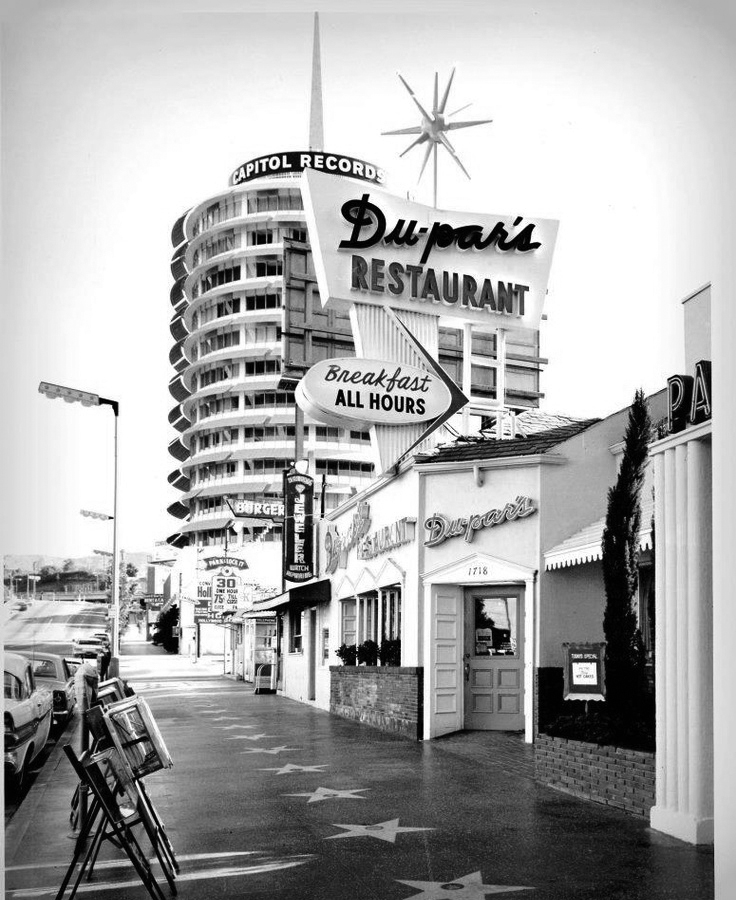 |
|
| (1960s)^ - Hollywood Specials with their 3-bulb design run along Vine Street in Hollywood. This view is looking north on Vine St. just north of Hollywood Blvd. Du-par's Restaurant is open for business: Breakfast ALL HOURS. In the background stands the iconic Capitol Records Building. |
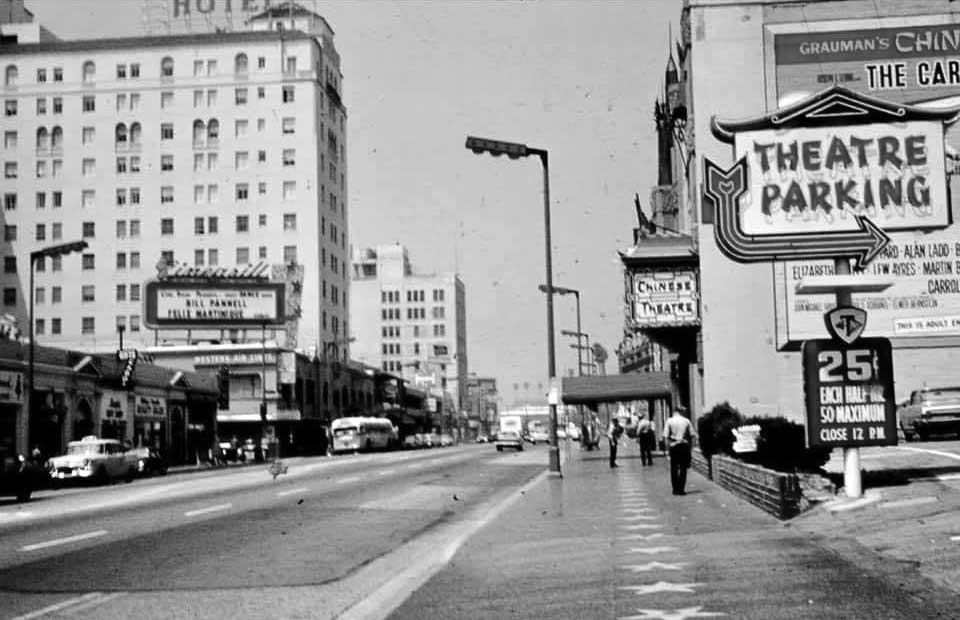 |
|
| (1964)^ – View looking west on Hollywood Boulevard from in front of Chinese Theatre parking lot showing Hollywood Specials streetlights as far as the eyes can see. The Roosevelt Hotel can be seen at upper-left. |
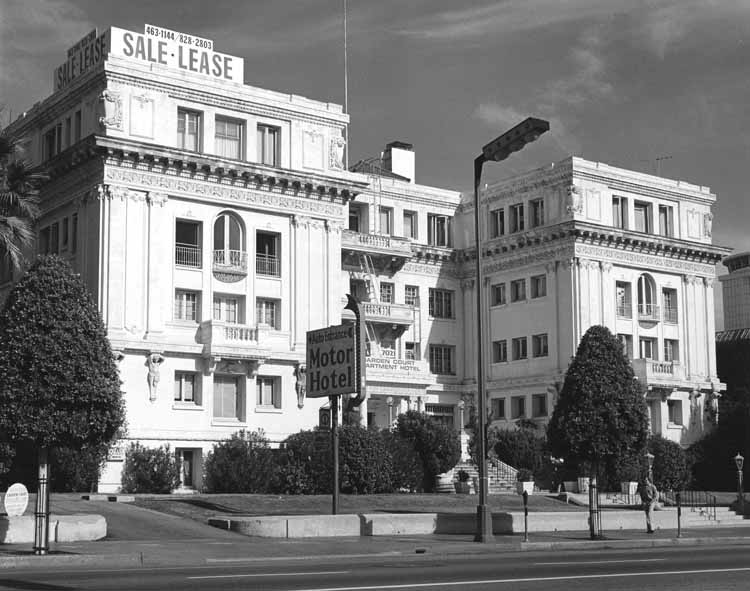 |
|
| (1976)* - View of a 3-lamp streetlight in front of the Garden Court Apartments (Hotel) on Hollywood Blvd. This unique electrolier (Hollywood Special) remained the predominant streetlight along Hollywood Boulevard for over three decades. |
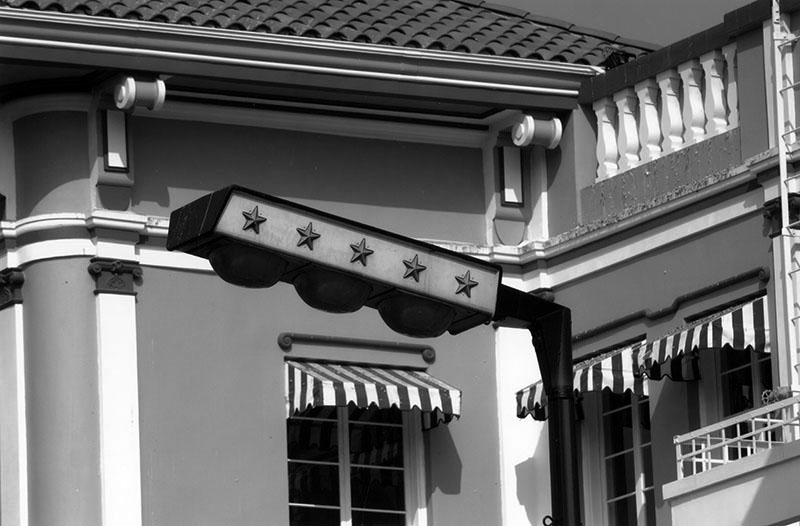 |
|
| (2005)^ - Close-up view of a Hollywood Special streetlight embellished with five stars along the side of its lamp housing. The building behind the streetlight is the Hudson Apartments (formerly The Historic Hillview Apartments), a 54-unit apartment complex located at 6533 Hollywood Blvd. |
 |
|
| (2005)^^*- Close-up view showing a Hollywood Special 3-lamp streetlight head being replaced in front of the Roosevelt Hotel. |
* * * * * |
Wilshire Double
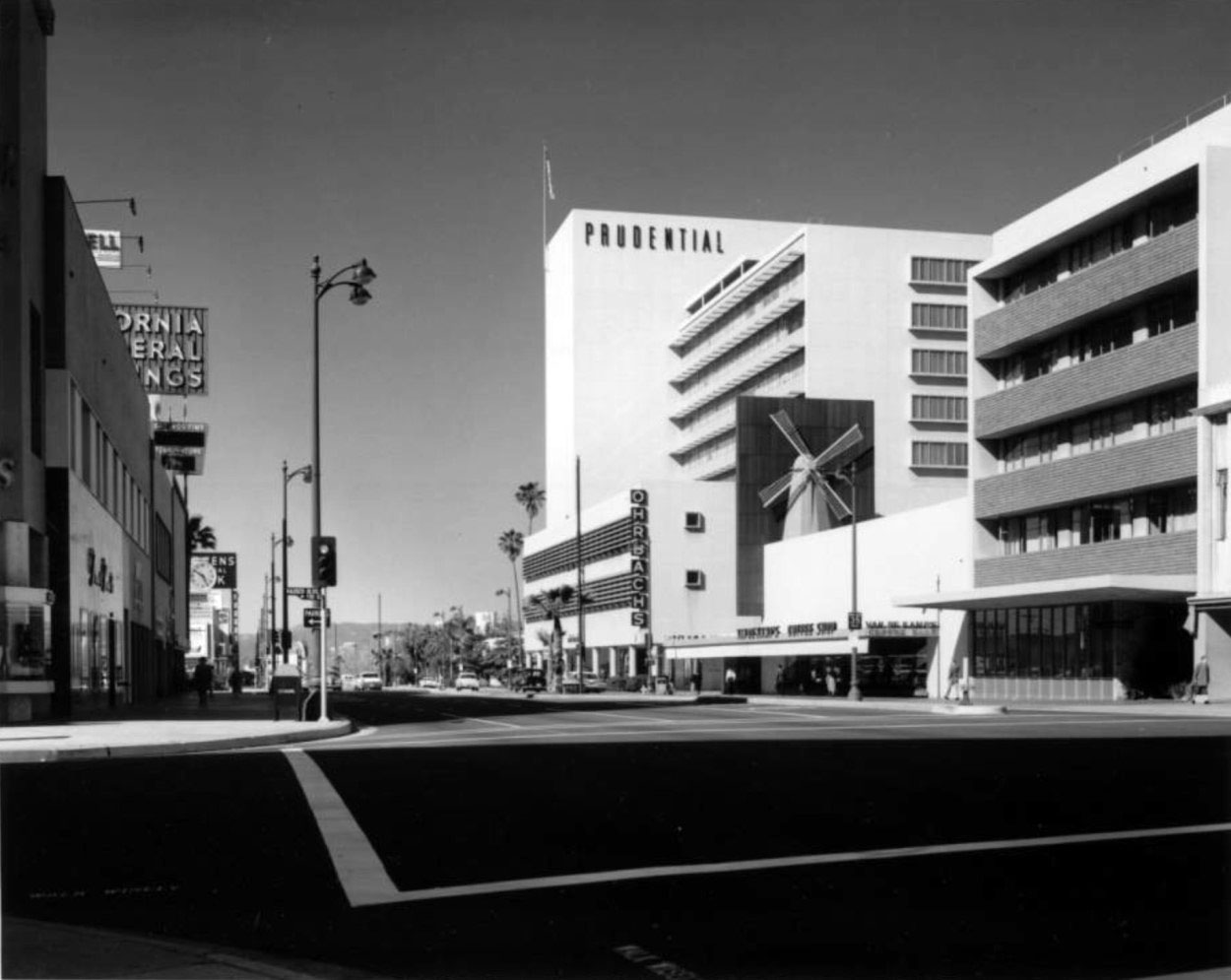 |
|
| (1959)^^ – View looking west on Wilshire Boulevard from Hauser Boulevard. A two-headed specialty light (Wilshire Double) lines both sides of the Boulevard. The windmill of the Van de Kamp's restaurant can be seen on the north side of the street with the Prudential Building behind it. |
Historical Notes An example of the transition from the pendant to the davit is the two headed specialty light (CD-950), dating from the mid-1950s, which can be found along Wilshire Boulevard, from Fairfax Avenue to beyond Wilton Place. It is significant for its use as an updated specialty electrolier to continue the tradition of the Wilshire Special of the late 1920s. While in form close to the pre-war pendants, the luminaires are not teardrop in shape, indicating the use of early optical assemblies. Also new is the side-by-side mounting, rather than the front-and back position as found in the Broadway pendants of the late 1940s.^ |
 |
|
| (ca. 1962)^.^ – View looking at the southwest corner of Wilshire and Mansfield Ave showing the Four Star Theatre. Coincidentally, the theater is showing “The Four Days of Naples”. A Wilshire Double Streetlight stands in front of the Art Deco building. |
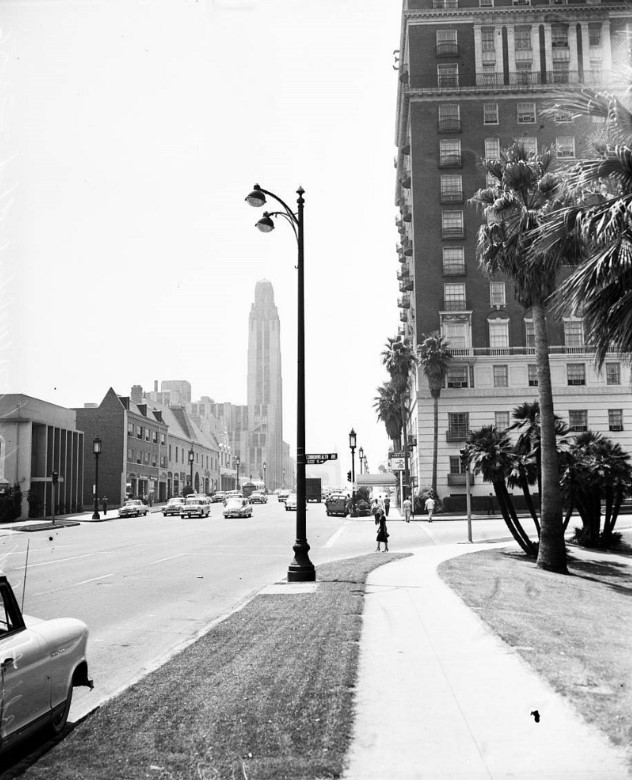 |
|
| (1956)*^ - View looking west showing a "Wilshire Double" electrolier on the NE corner of Wilshire Boulevard and Commonwealth Avenue. The old “Wilshire Special” streetlights are seen in the background. The Bullock's Wilshire Building tower stands in the distance while the historic Town House Building is seen across the street on the NW corner. |
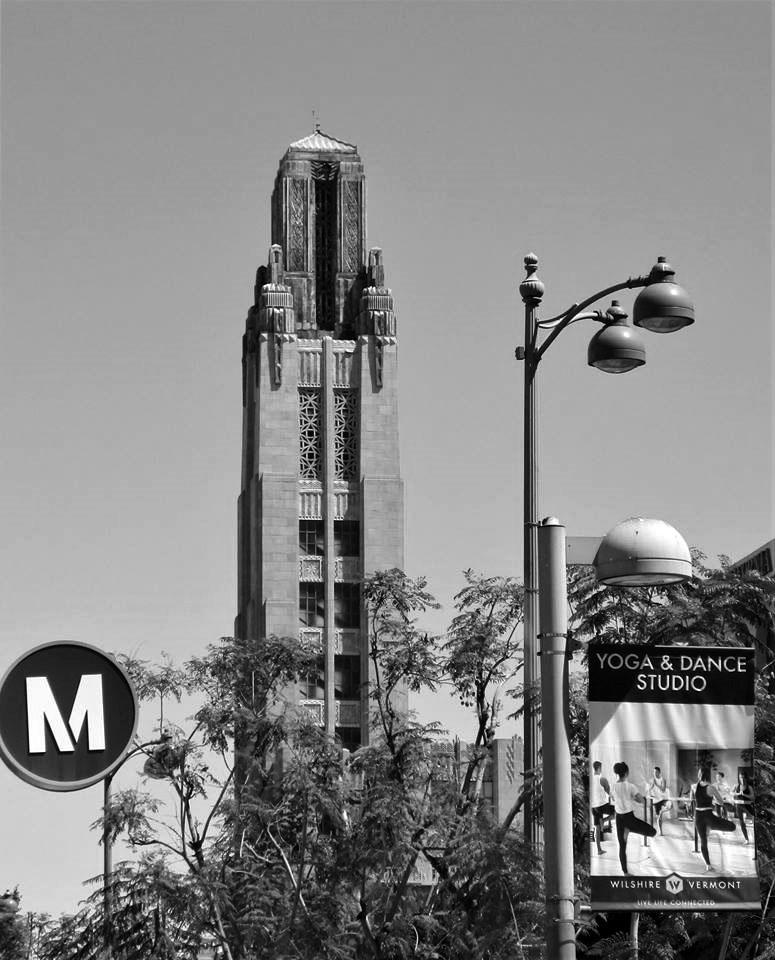 |
|
| (2019)^.^ - A Wilshire Double stands next to a lower profile electrolier in front of the Metro yard at Wilshire Blvd and Westmoreland Ave with the iconic Bullock's Wilshire Building in the background. Photo by Howard Gray |
Vine Double
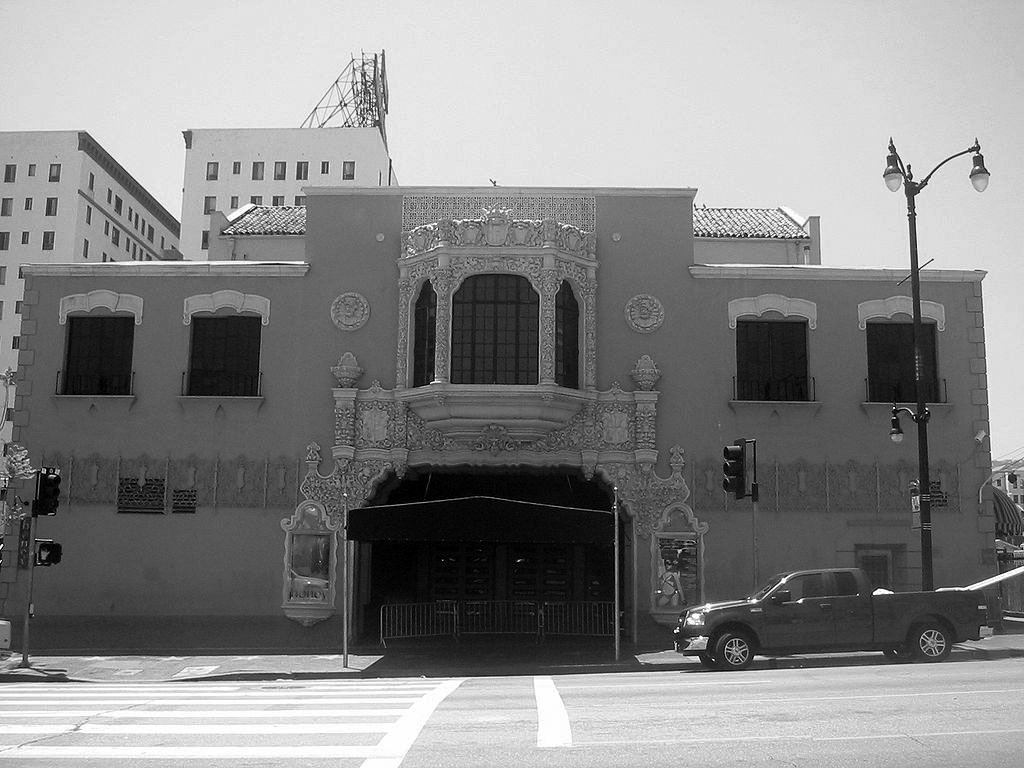 |
|
| (2007)^* - An double-headed electrolier stands near the front of the Avalon (formerly the Hollywood Playhouse) at 1735 N. Vine Street near Hollywood and Vine. The streetlight actually consists of three lamps. At the top, a dual-arm configuration has two lamps hanging over the street area. At the post's mid-span, another lamp extends out over the sidewalk. |
Historical Notes The double heads date from 2005, reminiscent of the scroll-arm teardrops that started populating the area around 1946. The shafts and bases on Hollywood Blvd. (dubbed the CD 920 by the LABSL) date from 1948. Vine Street didn't get its CD 920s until around 1960, when the famous 5-Star street lights were installed as part of the Hollywood Walk of Fame project. |
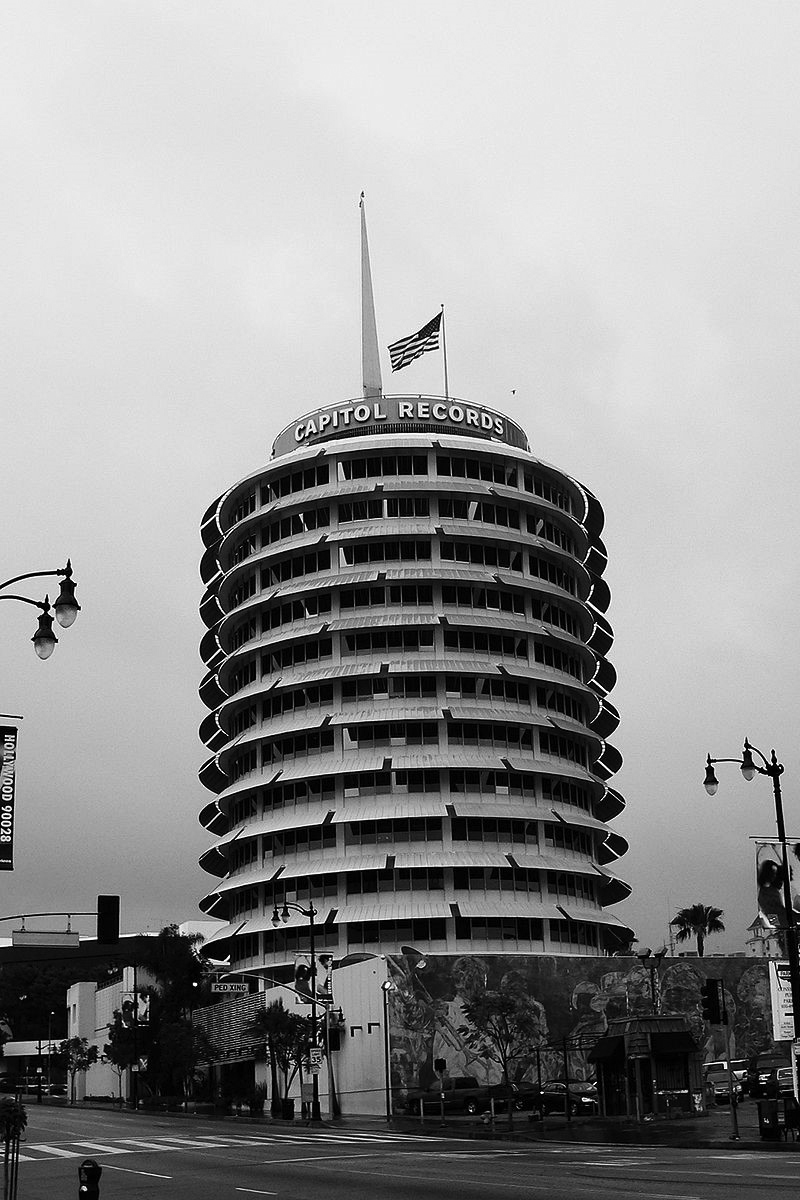 |
|
| (2006)*^ - View looking northeast showing "Vine Double" streetlights running down both sides of the street with the Capitol Records Building seen in the background at 1750 N. Vine Street. |
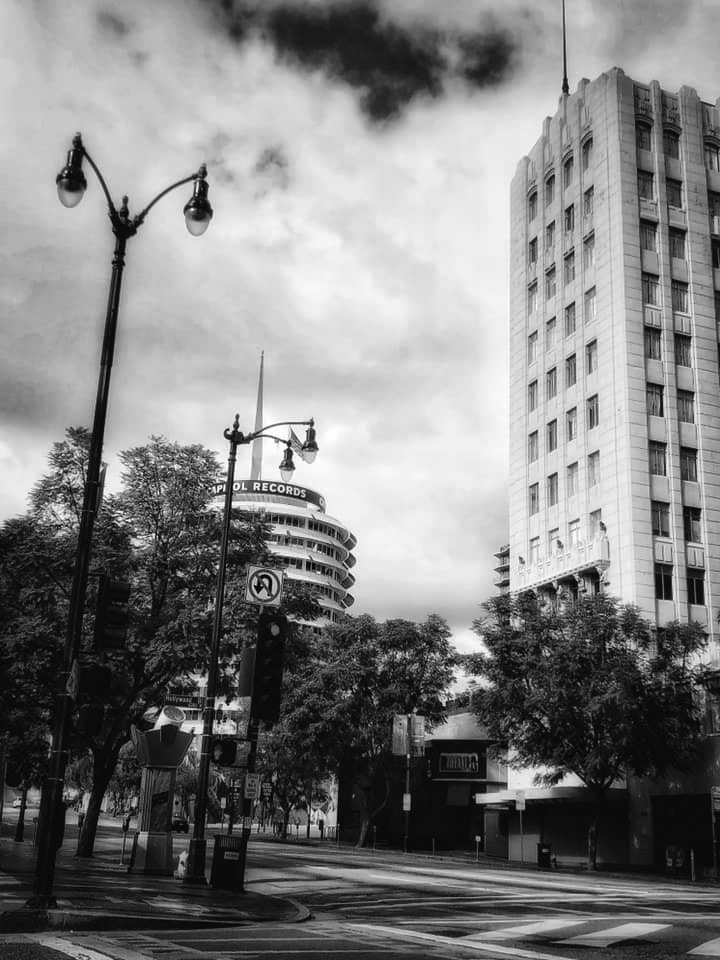 |
|
| (2020)^.^ - View showing a couple of “Vine Double” streetlights on the NW corner of Hollywood and Vine with the Capitol Records Building and the Equitable Building in the background. Photo by Carlos G. Lucero |
Historical Notes The curved two-arm pendants are connected to assemblies resembling a 'genie lamp'. |
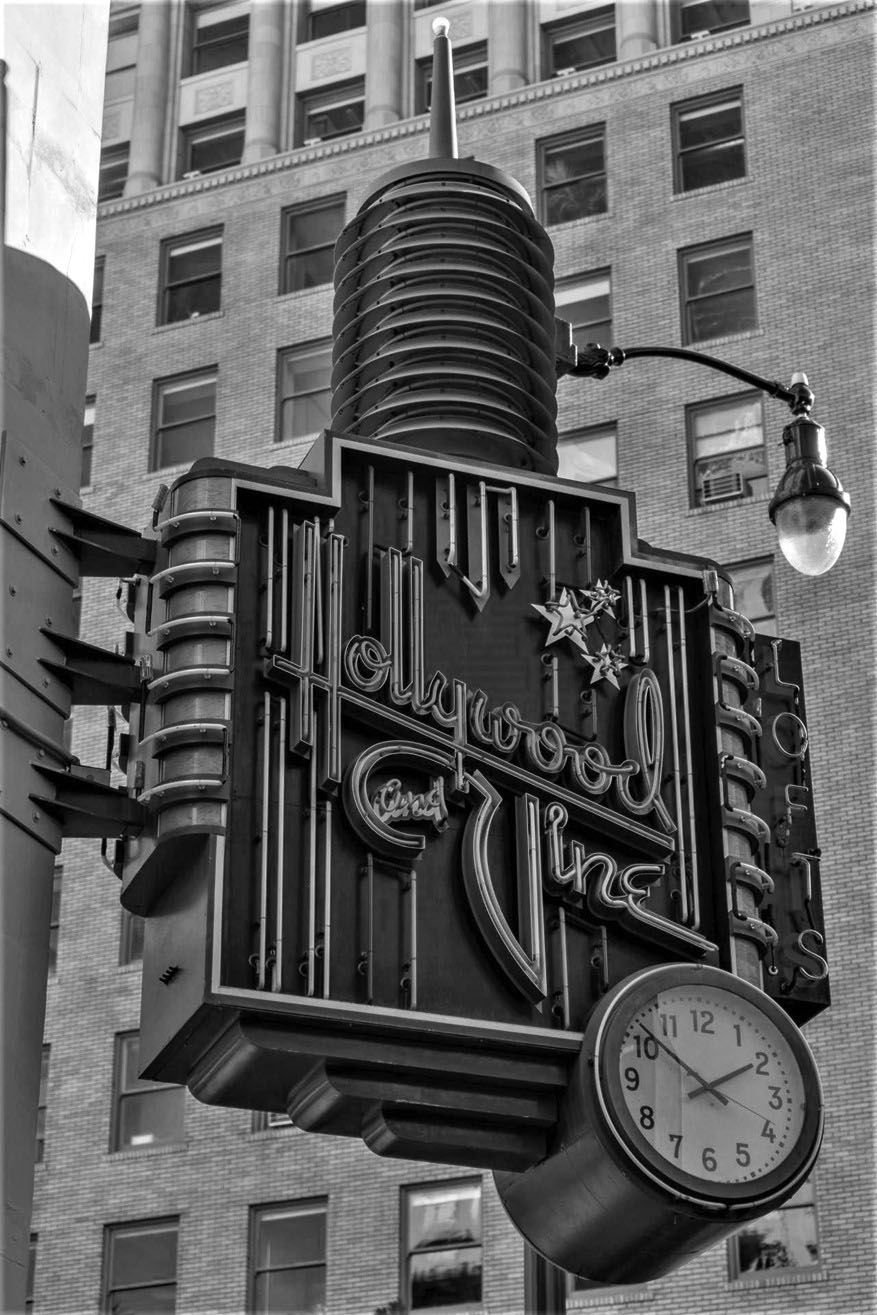 |
|
| (2022)^ - Clock and Lofts at Hollywood and Vine sign extends from the corner of the Equitable Building (NE corner of Hollywood and Vine). A “Vine Double” streetlight stands behind the sign. |
Historical Notes Hollywood’s historic Equitable Building has been transformed into condominium units with views of the Capitol Records tower and the iconic Hollywood sign. The original building was completed in 1930 and was home to the powerful Hollywood agent Myron Selznick. |
* * * * * |
Chinatown
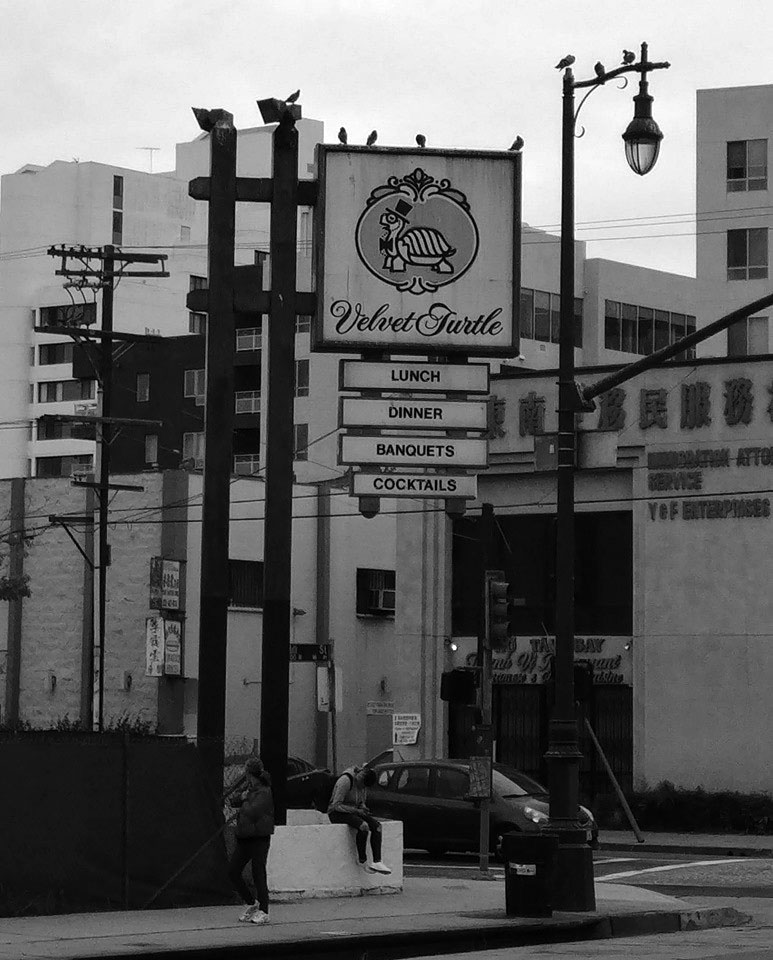 |
|
| (2019)^.^ – View looking at a combination streetlight-traffic signal on the NE corner of Hill and Ord streets in Chinatown. The ornate single pendant teardrop-shaped lamp is adjacent to a large Velvet Turtle Restaurant sign with pigeons on top of both. |
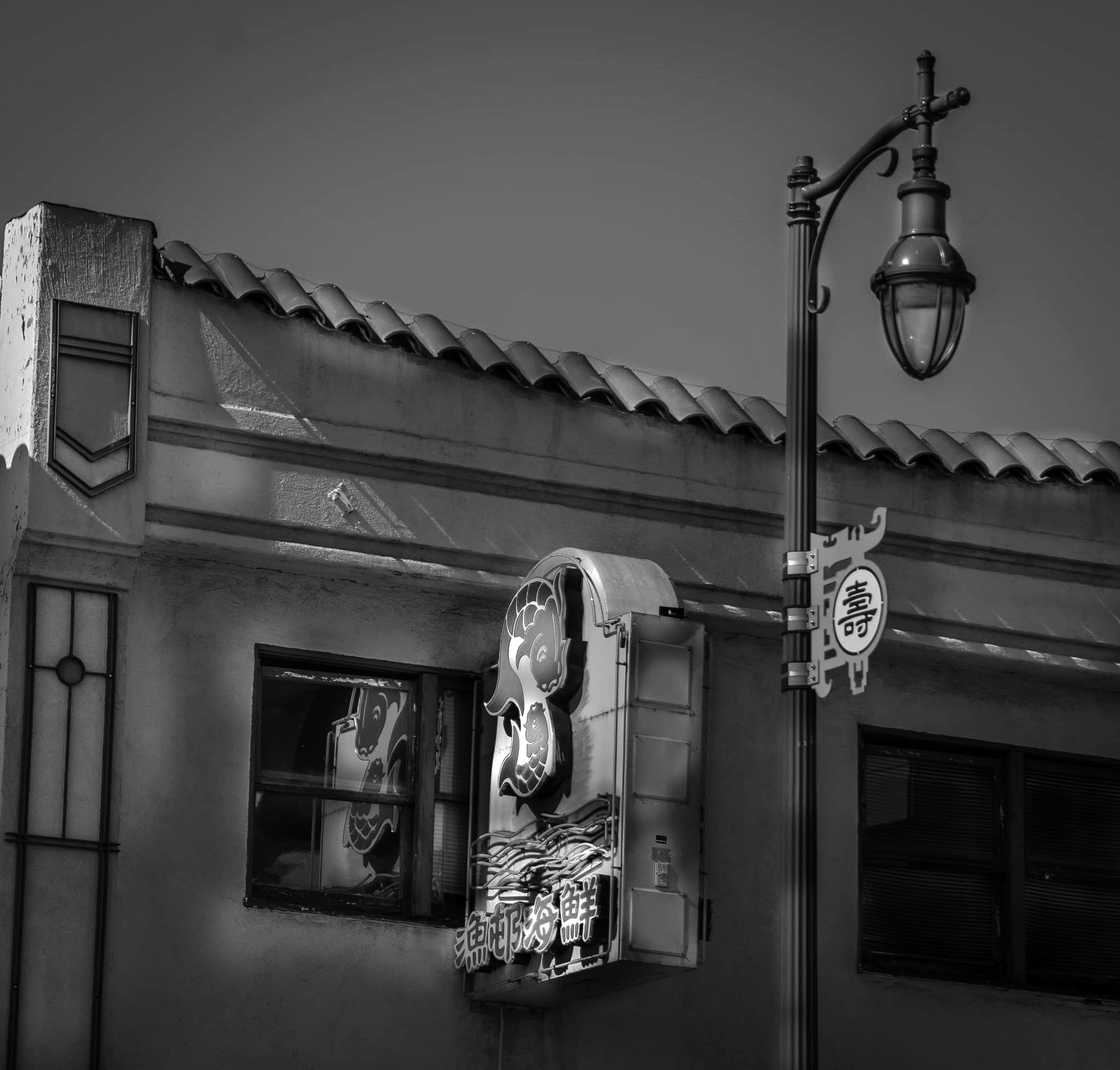 |
|
| (2021)* - Single pendant teardrop streetlight in Chinatown. Photo by Yevgeniy Durets |
* * * * * |
Mulholland Bridge Lighting
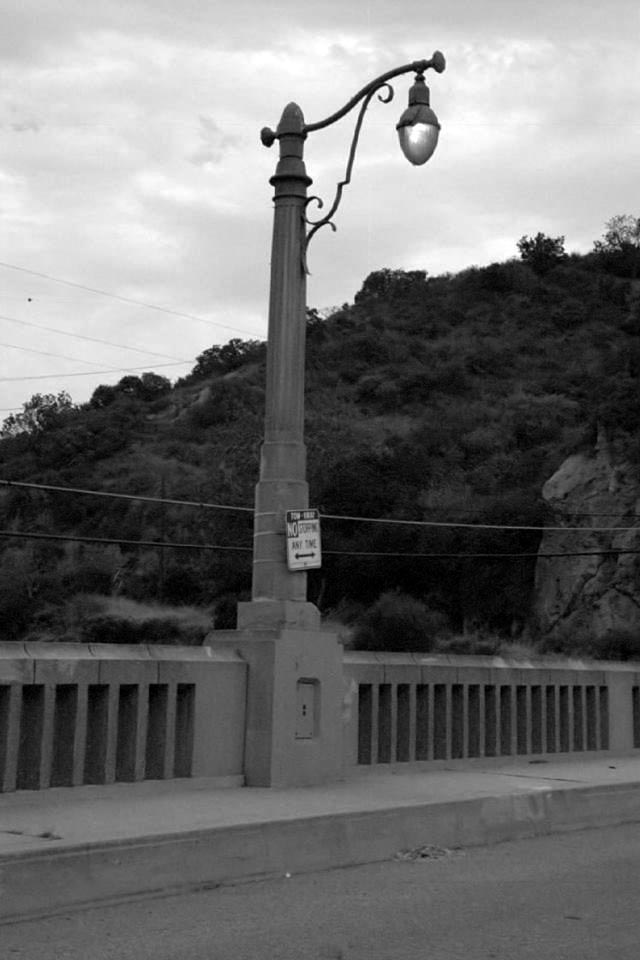 |
|
| (ca. 2003)^ – Streetlight on the Mulholland Bridge over the Hollywood Freeway in Cahuenga Pass. The pendant form teardrop-shaped lamp is facing downward and suspended from a short arm. |
Historical Notes The pendant could make good use of the early High Intensity Discharge (HID) lamps becoming increasingly common by the late 1930s. In place of a filament, the HID lamp ignited a gas. The most common in the early years of the HID was mercury vapor. It was a practical lamp by 1938, providing 400 watts of power. It had a life of almost four years, compared to the incandescent which could last six to eight months.^ |
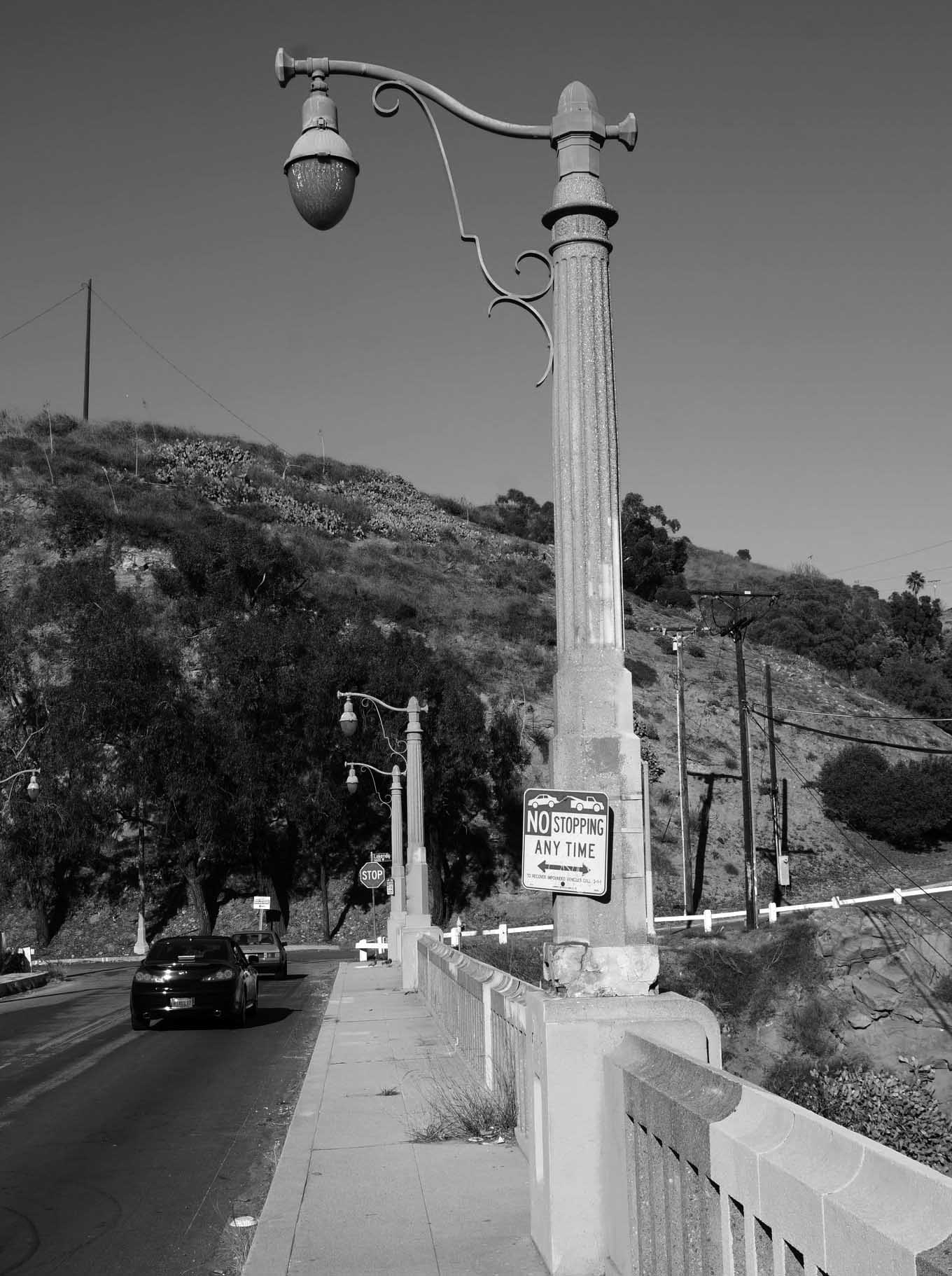 |
|
| (ca. 2010s)^ – Mulholland Bridge streetlights. Photo by Glen Norman |
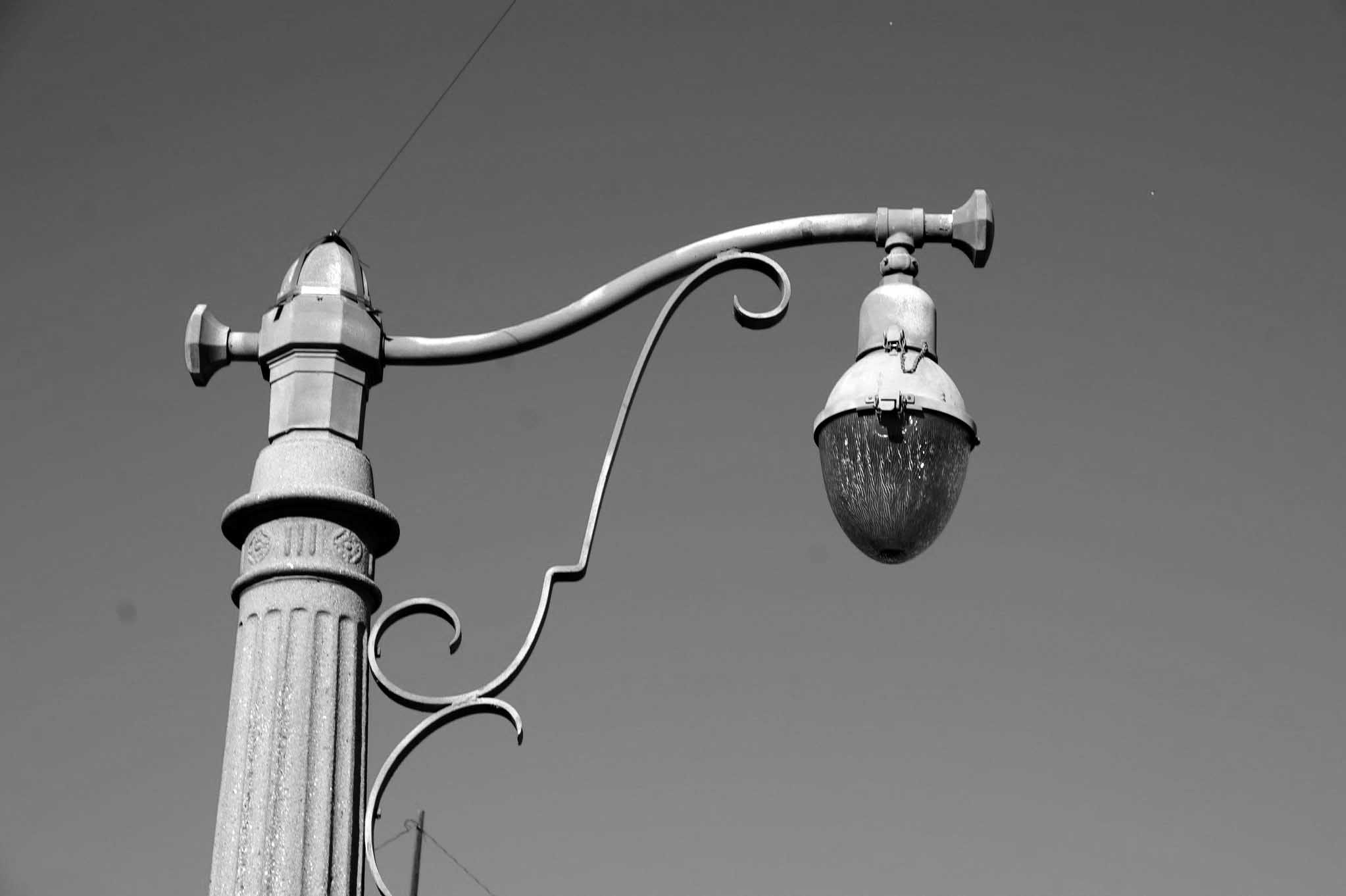 |
|
| (ca. 2010s)^ – Close-up view showing streetlight on Mulholland Bridge at Chauenga Pass. Simple but beautiful! Photo by Glen Norman |
Fourth Street Viaduct
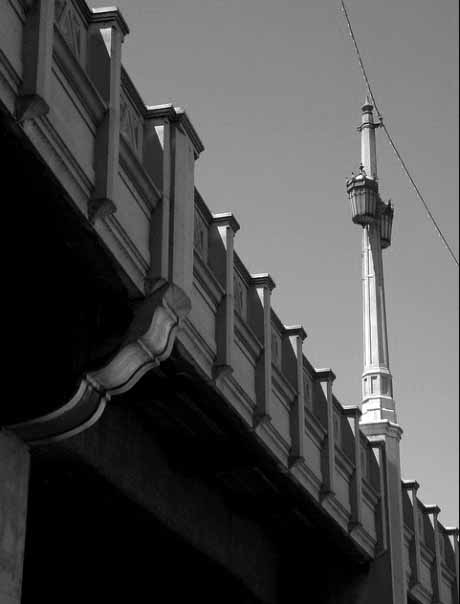 |
|
| (2008)*#*- View of the ornate dual-lamp streetlight on the 4th Street Viaduct near downtown Los Angeles. |
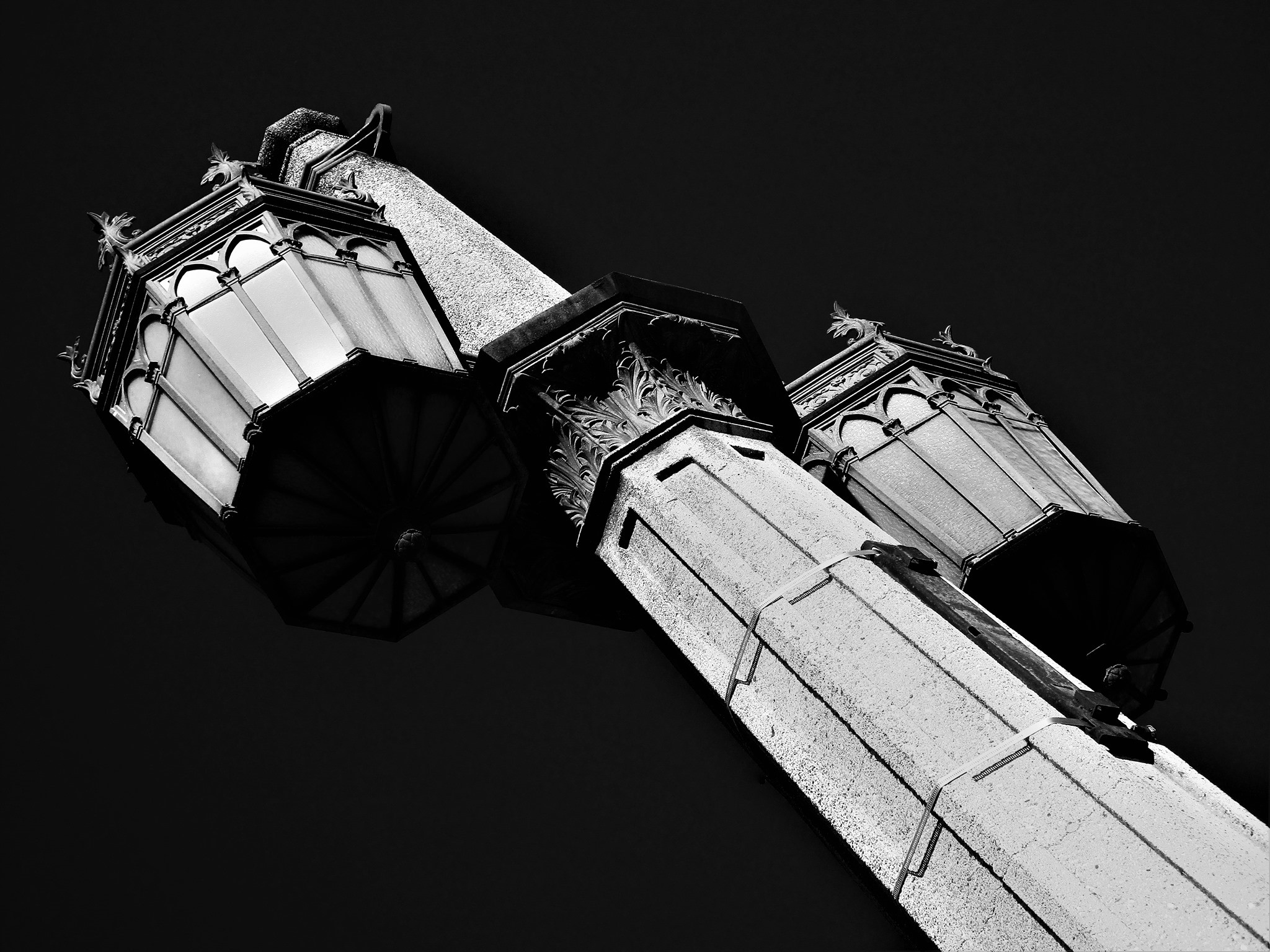 |
|
| (2020)^.^ - Looking up to the top of the ornate dual-lamp streetlight on the 4th Street Bridge. Photo by Howard Gray |
.jpg) |
|
| (2008)* - Detailed view of one of the beautiful sets of dual-lamp fixtures on the 1931 built 4th Street Viaduct (Bridge). Photo courtesy of Steve and Michelle Gerdes |
Historical Notes See More Bridge Lighting College Street Bridge; First Street Bridge; Fourth Street Viaduct; Fourth and Lorena Streets Bridge; Glendale-Hyperion Bridge; Macy Street Bridge; Mulholland Bridge; Sixth Street Bridge; Washington Blvd Bridge) |
* * * * * |
Downtown
.jpg) |
|
| (2005)^* - View showing a dual-lamp teardrop electrolier on 1st Street near Spring Street, in front of the LA Times Building. Photo by Jim Winstead |
Historical Notes The street light seen above is dubbed the "CD 913"; the shaft and arms dating from 1948. Not seen here is the base, reused from the Keystone "Broadway Rose" of late 1919. The "Roses" were dedicated in January, 1920. The luminaires are an early 21st Century modification, bringing back the look of the GE Form 81 teardrops that were part of the 1948 installation. This is the Los Angeles Times's fourth building since it started publishing in 1881. Click HERE to see views of the earlier LA Times buildings. |
Dual-Lamp Teardrop CD-913 Electroliers (Contemporary Views)
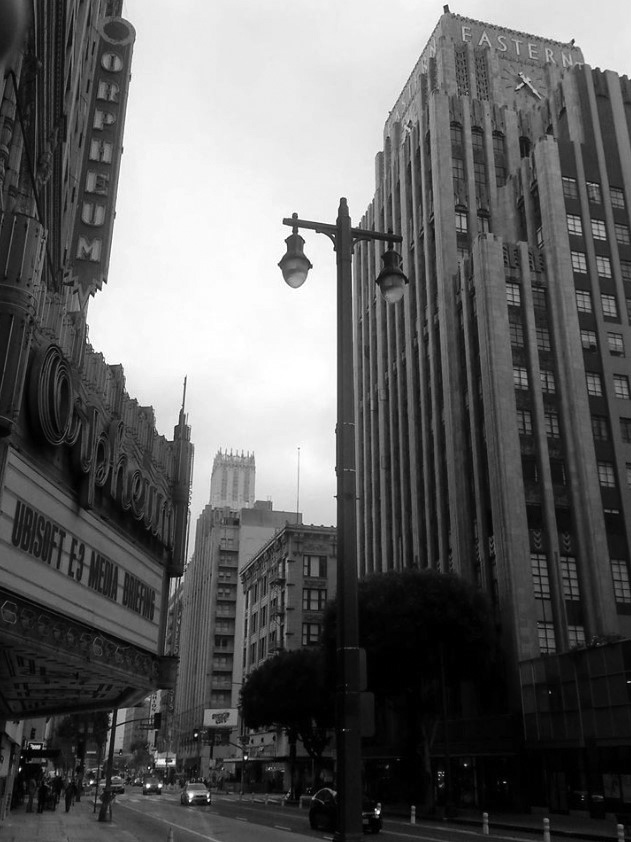 |
|
| (2019)^.^ - View looking south on Broadway showing three iconic buildings: The Orpheum, The Eastern, and The Ace, with a beautiful dual-lamp teardrop streetlight (CD-913) seen in the foreground. Photo courtesy of Michael Rotman |
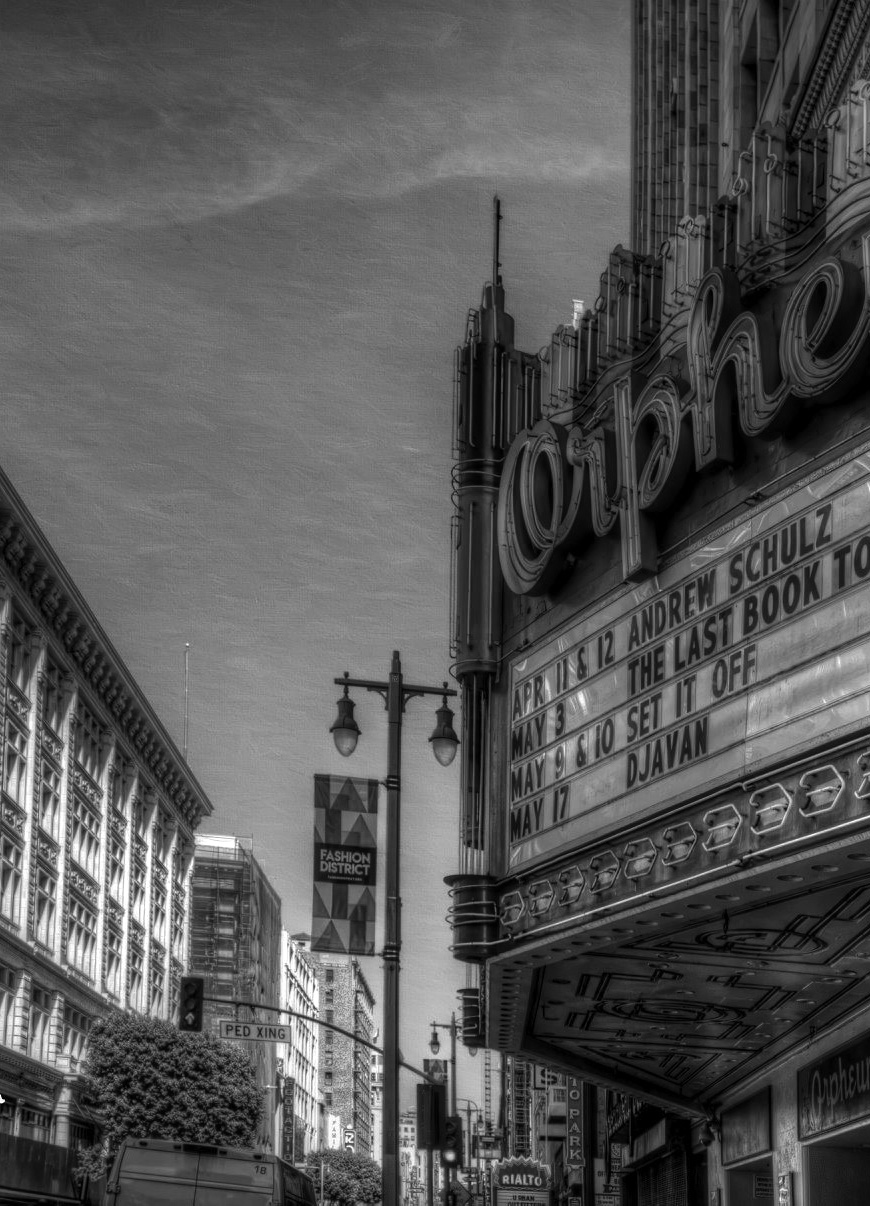 |
|
| (2020)^.^ - View looking north on Broadway toward 8th Street showing a two lamp teardrop streetlight standing near the Orpheum Theatre. Photo by Jill Feldman McMahon |
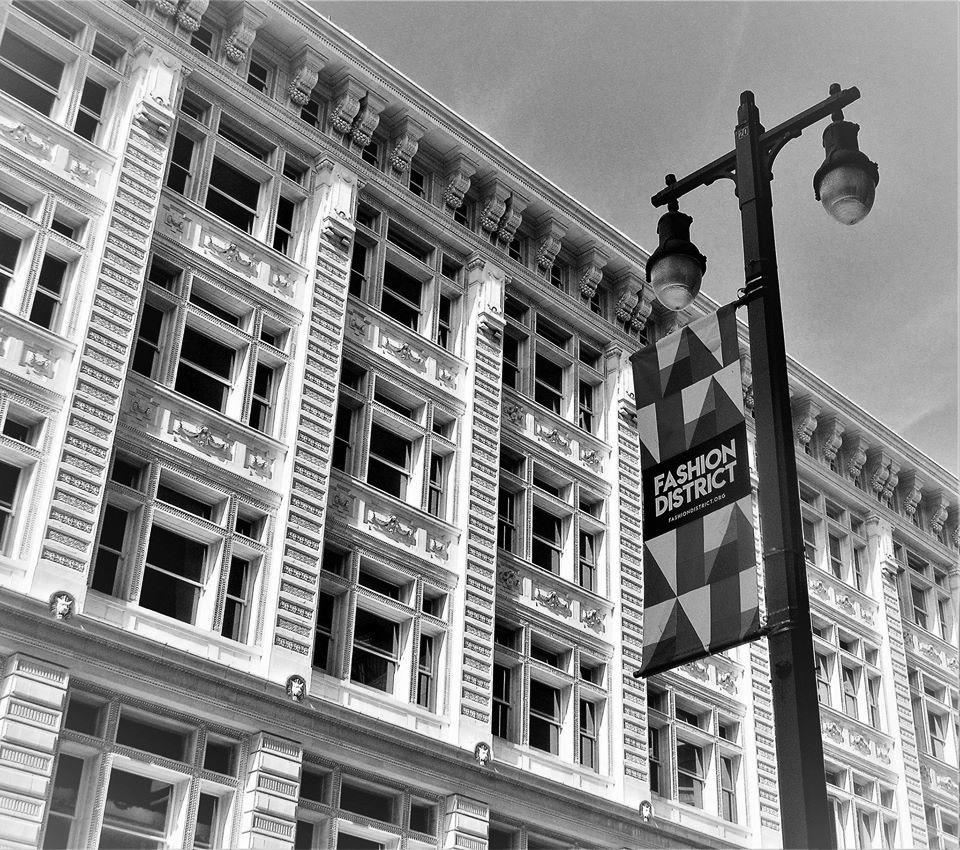 |
|
| (2020)^.^ – View looking up at the newly renovated California Broadway Trade Center (801 S. Broadway) with an ornate dual-pendant teardrop-shaped streetlight (CD-913) seen in the foreground. Photo by Howard Gray |
Historical Notes The 1908-built Beaux Arts building seen above was built in 1908. It was originally home to Hamburger’s Department Store which evolved into May Company and later Macy's. Click HERE to see more. |
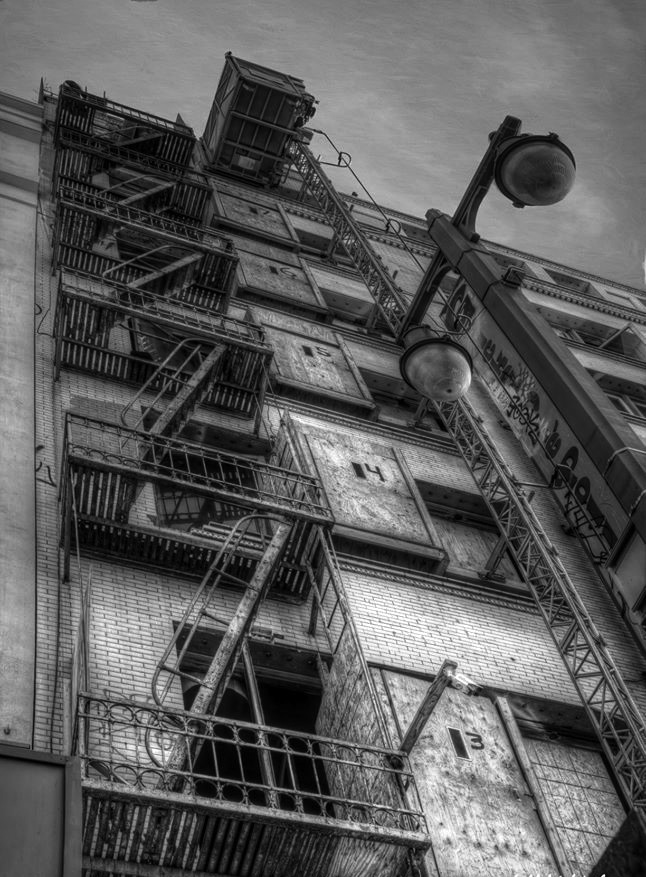 |
|
| (2020)^.^ – Looking up toward a dual lamp teardrop electrolier standing in front of a building under renovation. Note the fire escape and outdoor elevator in background. Photo by Jill Feldman McMahon |
.jpg) |
|
| (2021)* - Close-up view showing a CD-913 dual-lamp electrolier located in front of Grand Central Market (repainted Golden Brown except for the photo cells). Photo by Glen Norman |
* * * * * |
Olympic Special
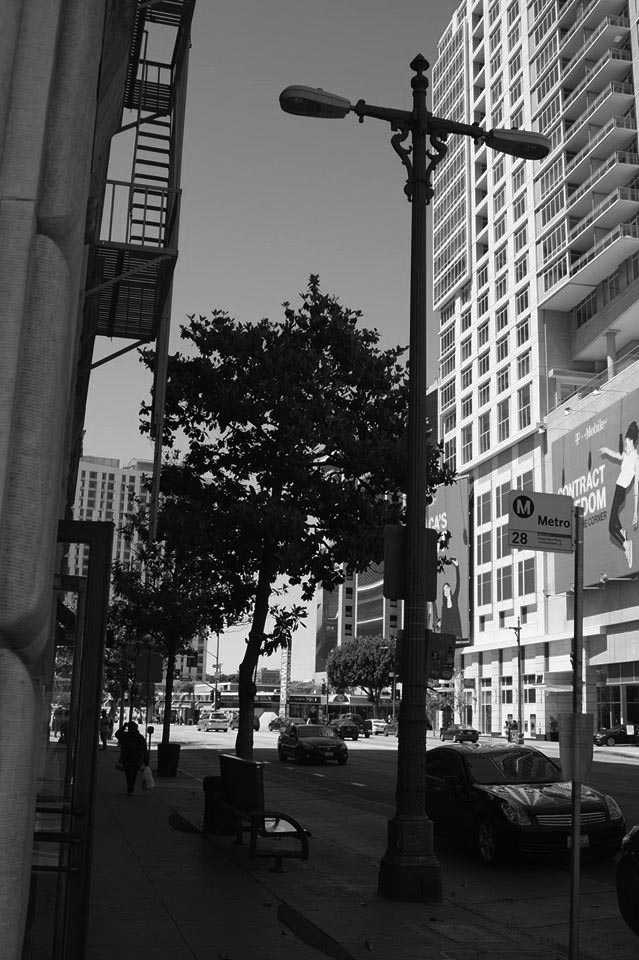 |
|
| (2016)### - View showing a twin Cobra electrolier, sometimes referred to as Olympic Special, located on Olympic Boulevard in downtown Los Angeles. Photo courtesy of Glen Norman |
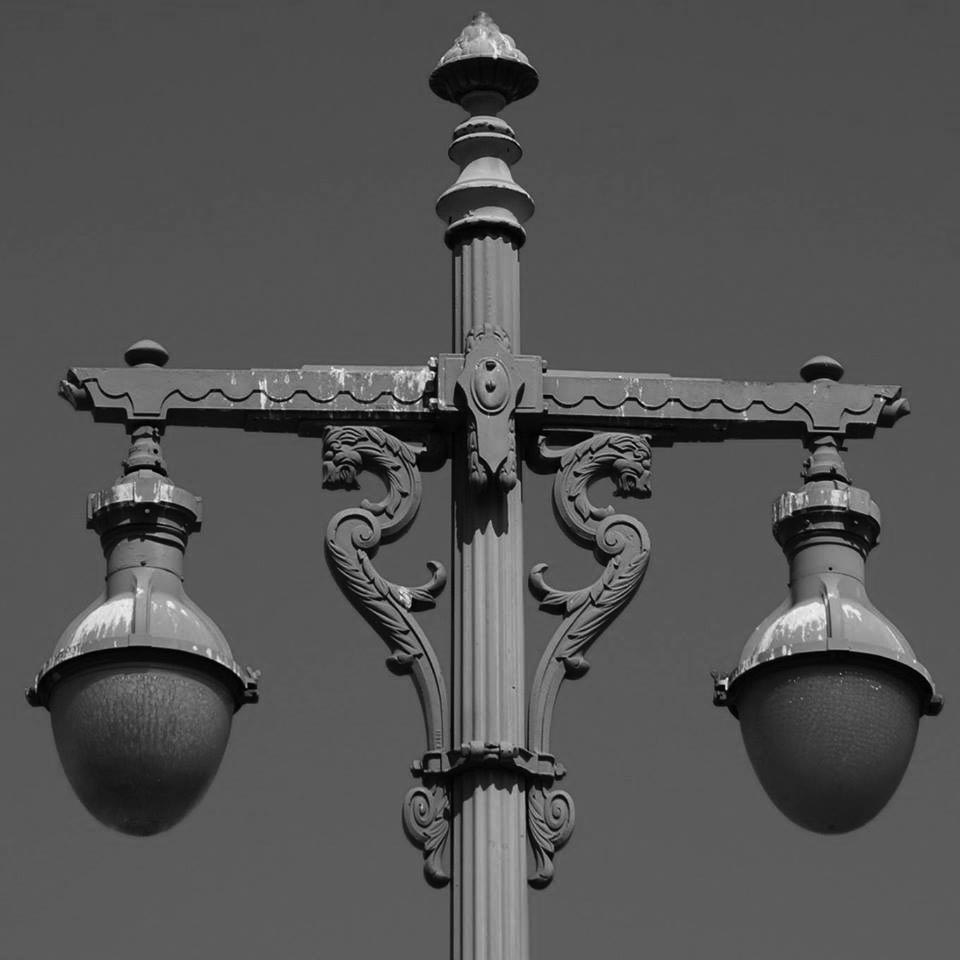 |
|
| (2015)### - View showing the only extant twin Olympic Special with the original GE Form 81-D (Ornate) teardrops. Located at the Vermonica Exhibit, Vermont Avenue and Santa Monica Boulevard in Eastern Hollywood. Photo by Glen Norman |
Historical Notes The Vermonica Exhibit is a display of 25 vintage streetlights of Los Angeles that was erected in 1992 as an artwork sponsored by the Department of Cultural Affairs and voluntary labor contributed significantly by staff of the Field Operations Division of the Bureau of Street Lighting. The artist was Sheila Kline and the artwork was named 'Vermonica' for its location adjacent to the intersection of Vermont Avenue and Santa Monica Boulevard. In 2020 the exhibit was moved further West on Santa Monica Boulevard. |
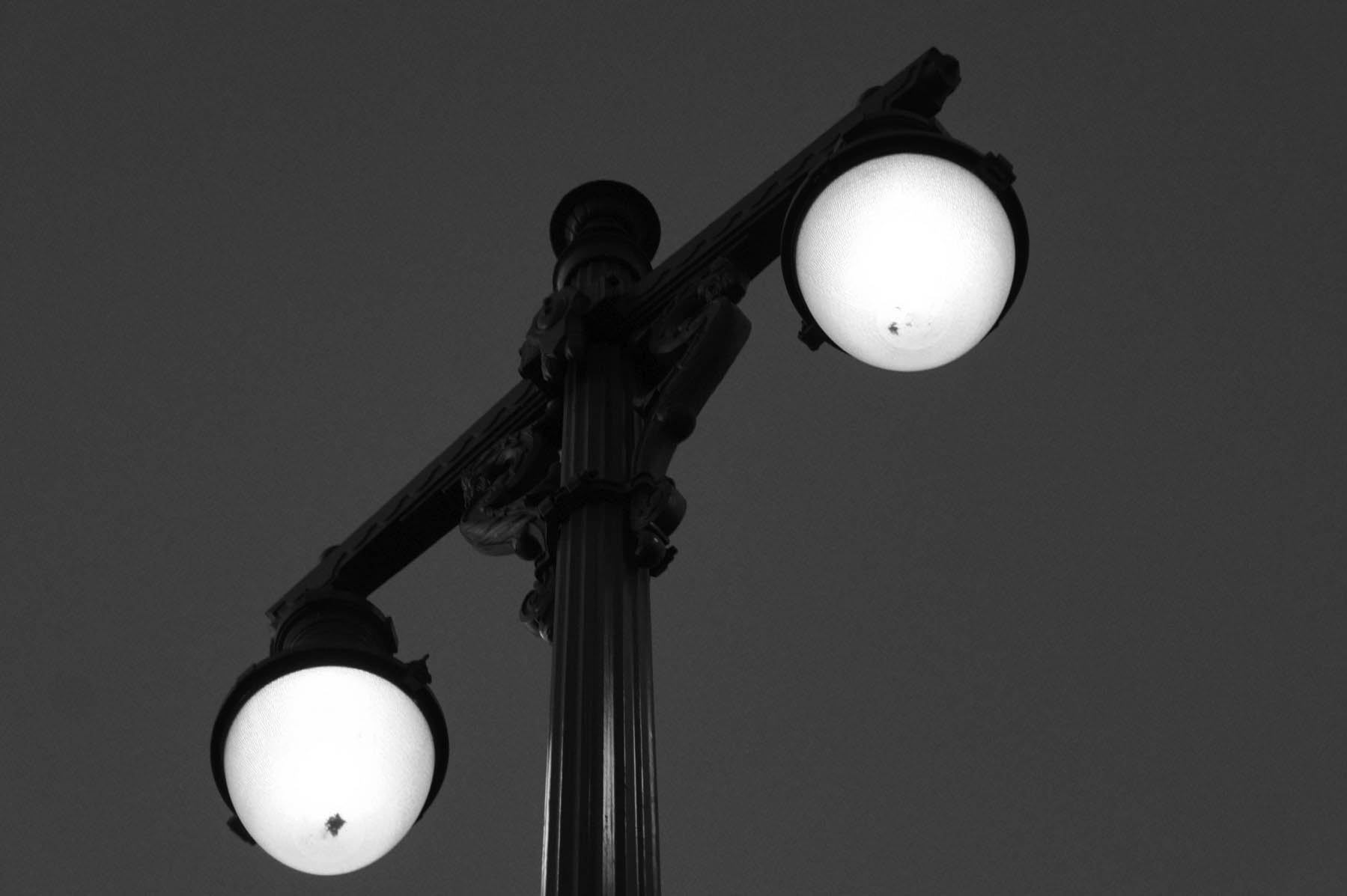 |
|
| (2020)* – Night view of the Olympic Special Twin located at the Vermonica Streetlight Exhibit on Santa Monica Boulevard in East Hollywood. Photo by Glen Norman |
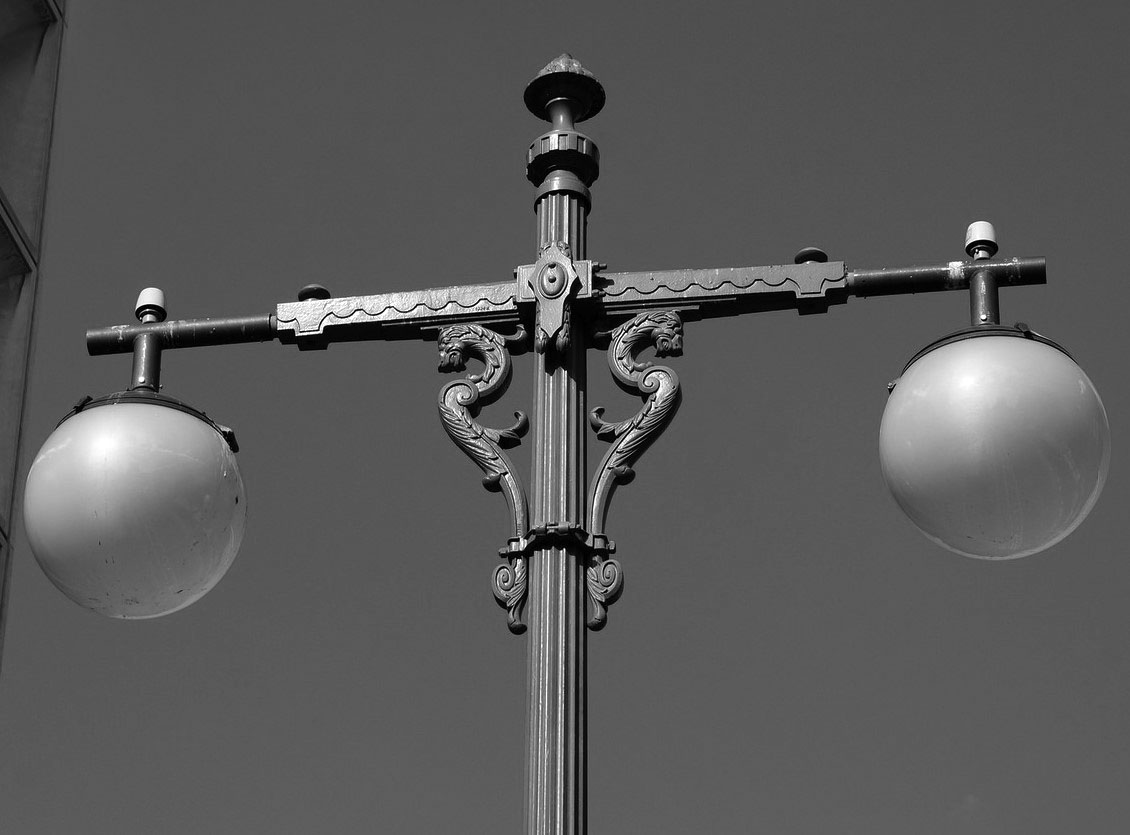 |
|
| (2017)^^* – Close-up view of a dragon-armed, dual-lamp Olympic Special located on the west side of Los Angeles Street, adjacent to City Hall East. The formerly clear globes have recently been replaced with opaque balls, lamped with LED. |
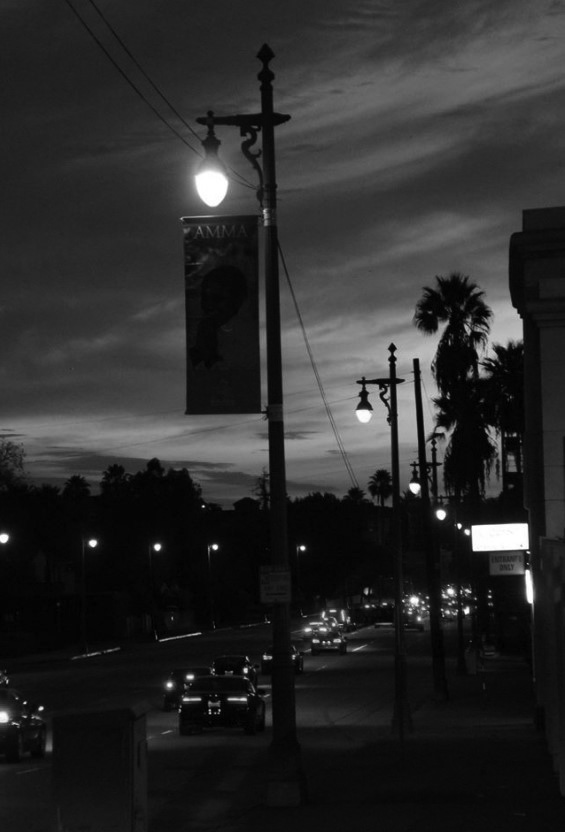 |
|
| (2019)^.^ - The dragon-armed Olympic Specials (UM 40314) watch as rush hour traffic passes in review. Looking West on Olympic Boulevard, just West of Century City. — at Rancho Park, Los Angeles. Photo by Glen Norman |
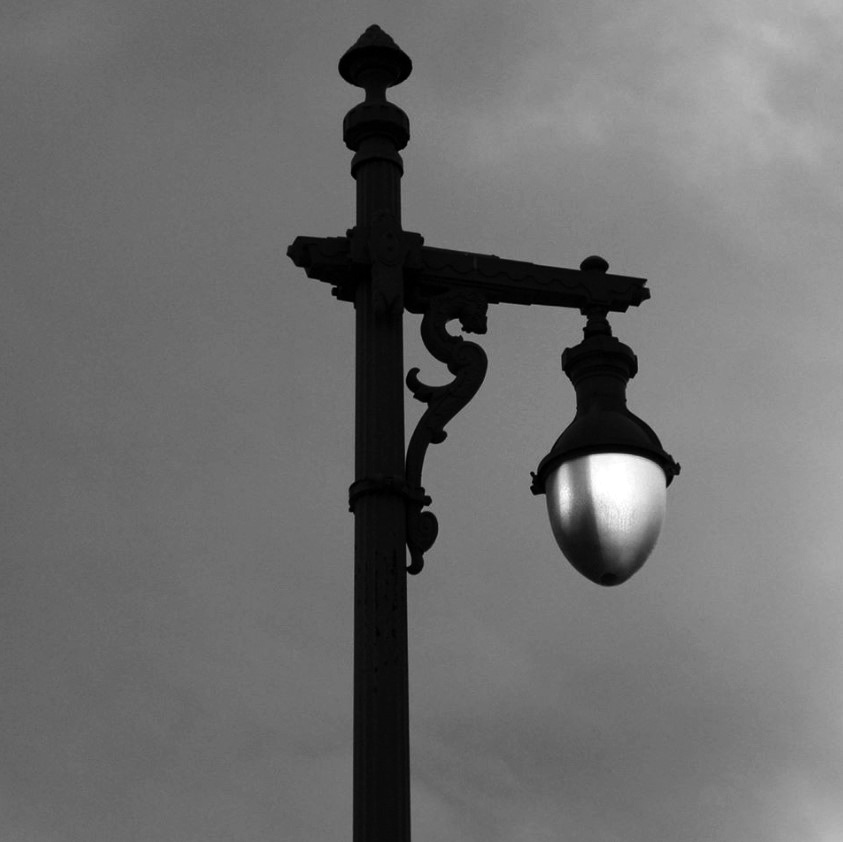 |
|
| (2019)^.^ - Close-up view of a Mercury-lamped single arm Olympic Special just coming on for the evening. South side of Olympic Blvd. West of Century City in Rancho Park, Los Angeles. Photo courtesy of Glen Norman |
* * * * * |
CD 923's
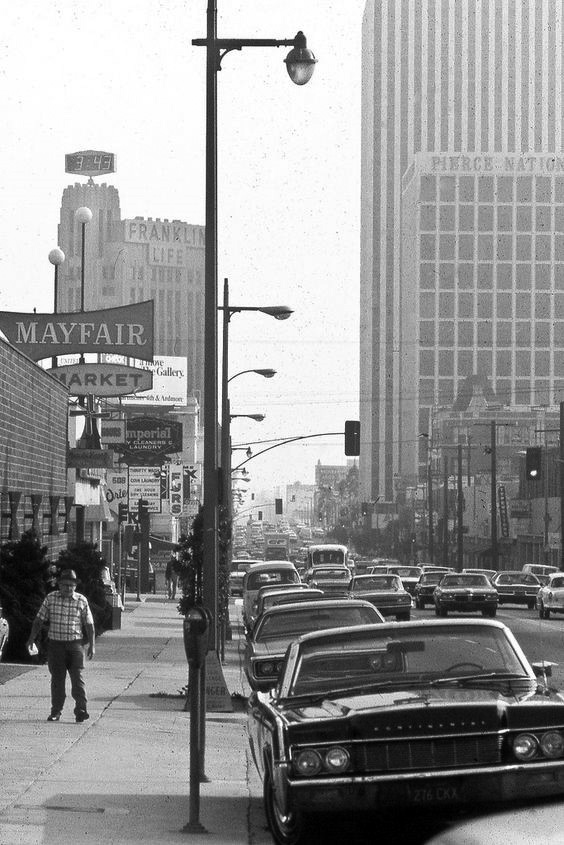 |
|
| (1970s)^.^ – View looking south on Western Avenue toward Wilshire Boulevard where the Pellissier Building (Franklin Life sign) stands on the SE corner. Mostly CD 943 streetlights are seen on the east side of Western. At least three different styles of streetlights can be seen here. Photo courtesy of Jessica Litman |
Historical Notes The CD 923 street light closest to the camera displays the original luminaire--an Incandescent teardrop. The CD 923 behind it has received a Mercury cobra upgrade. The intersection behind it received an upgraded traffic light with a mast-arm suspended over Western Avenue. It was standard operating practice to update a few of the existing street lights closest to the intersection at the same time the new traffic signals went in. The CD 923 street lights were sometimes referred to as the "Llewellyn Slayers." They are responsible for annihilating the entire run of the eponymous Llewellyn "Pico" cluster lights between Main Street and Vermont Avenue. Other Llewellyn clusters along Figueroa Street (downtown) and Main Street (between Downtown and Jefferson Boulevard) also fell to the advancing CD 923 posts. The Llewellyn "Western" twins on Western Avenue were replaced by the CD 923 posts North of Wilshire Boulevard. I'm not sure how far North the CD 923s extended on Western (definitely not as far as Melrose as documented in the 1969 film "Model Shop"), but those CD 923s were removed in the early 1970s along with the surviving Llewellyn "Western" twins. The CD 923 posts did not limit their wrath exclusively to Llewellyn product. The entire run of Marbelite twins on Wilshire Boulevard between Fairfax Avenue and the Beverly Hills city limits was also replaced by the CD 923 in the late 1940s. None of the surviving CD 923s sport the original side-mounted Incandescent teardrops. But, the run on Main Street between Downtown and Jefferson Boulevard received faux-historic Lumec RN 20 teardrops in the early 2000s. - Glen Norman |
* * * * * |
'Pacific' Dual Lamp Streetlight (UM-1747)
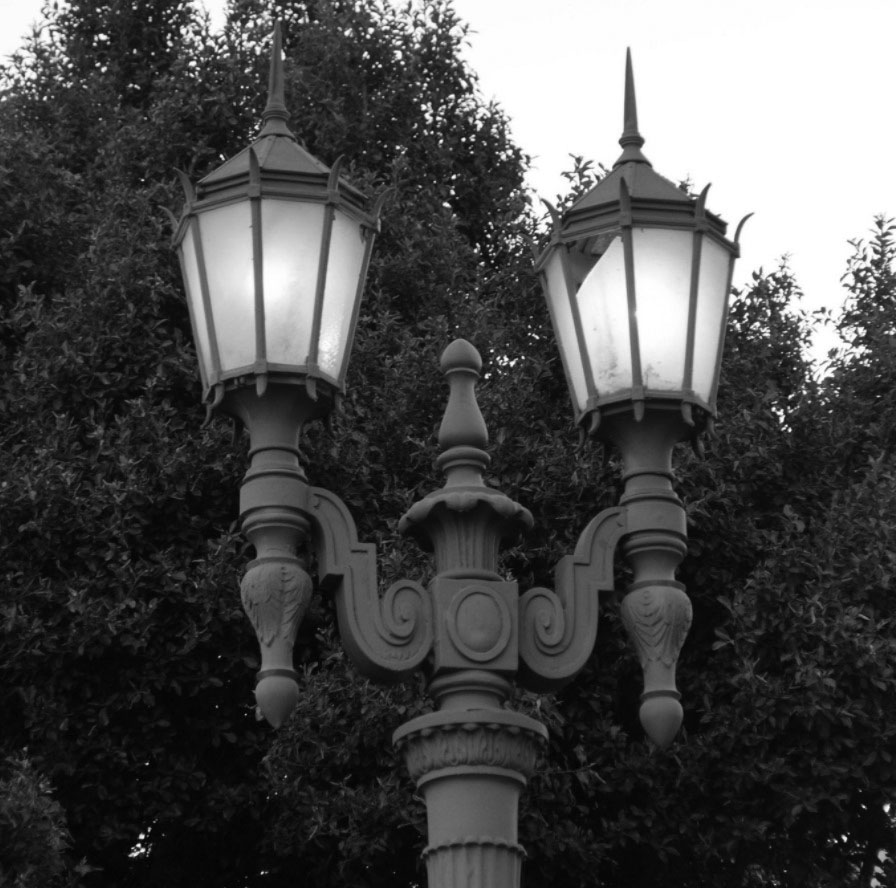 |
|
| (2020)^ - A Union Metal (UM 1747) 'Pacific' streetlight with twin GE Form 18-B Novalux lanterns with broken glass pane, located on the south side of West 7th Street between South New Hampshire and South Vermont avenues. Photo by Glen Norman |
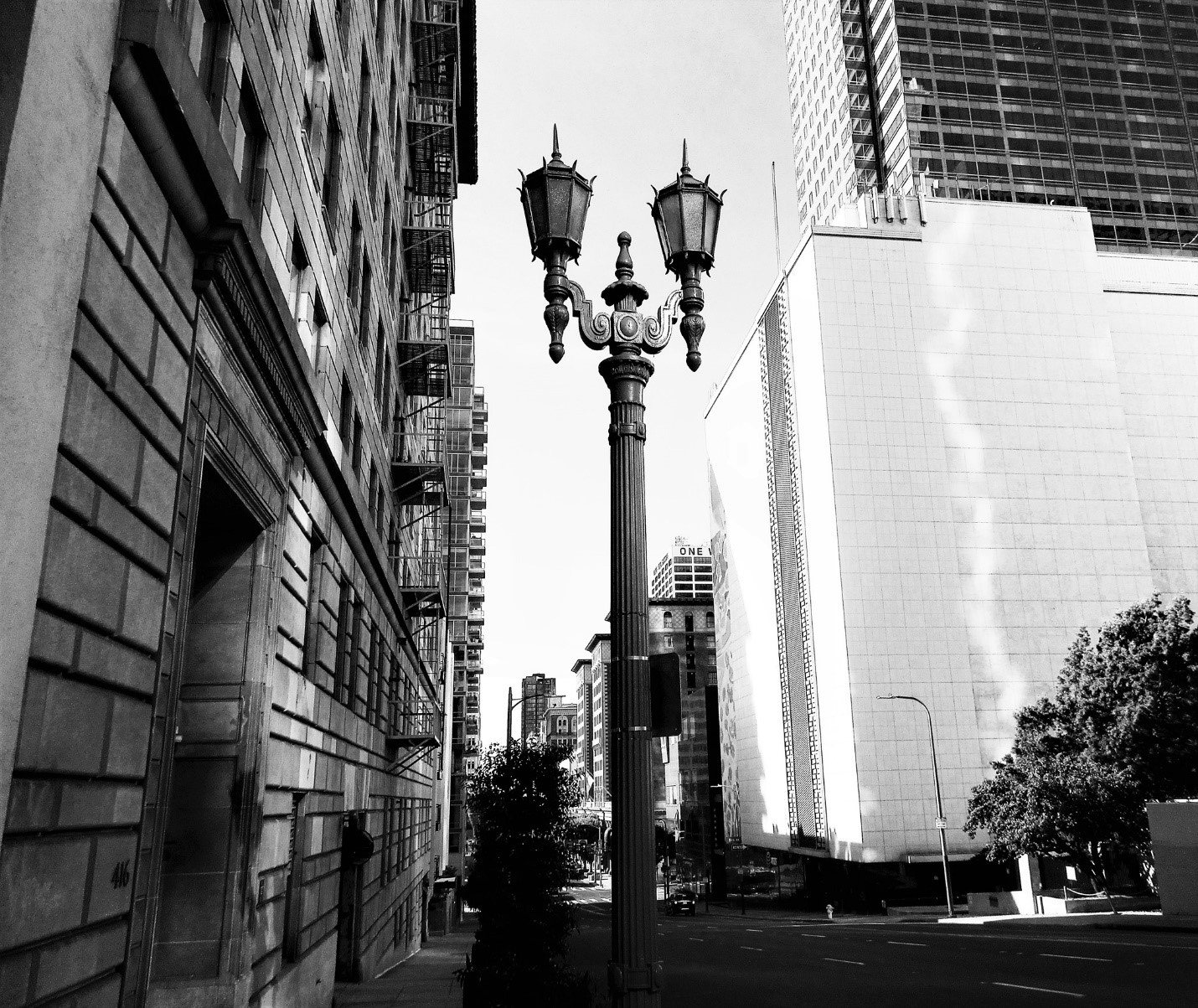 |
|
| (2021)* – One of the last remaining Pacific (UM-1747) Streetlights located on Olive just south of 4th Street with the AT&T Building seen on the right. Photo by Howard Gray |
Historical Notes Click HERE to see more Early Views of Pacific Dual-Lamp UM-1747 Streetlights. |
* * * * * |
California Special (aka Magnolia Double)
.jpg) |
|
| (2019)* - A dual-lamp California Special streetlight stands in front of the El Portal Theatre marquee, 5269 Lankershim Boulevard, North Hollywood. Photo courtesy of Shellie Winkler |
Historical Notes There are eight of these California Special streetlights located around the El Portal Theatre in North Hollywood, four on Lankershim and the other four around the corner on Weddington. These are 21st Century transplants. The California Special was never found on either of those two thoroughfares. |
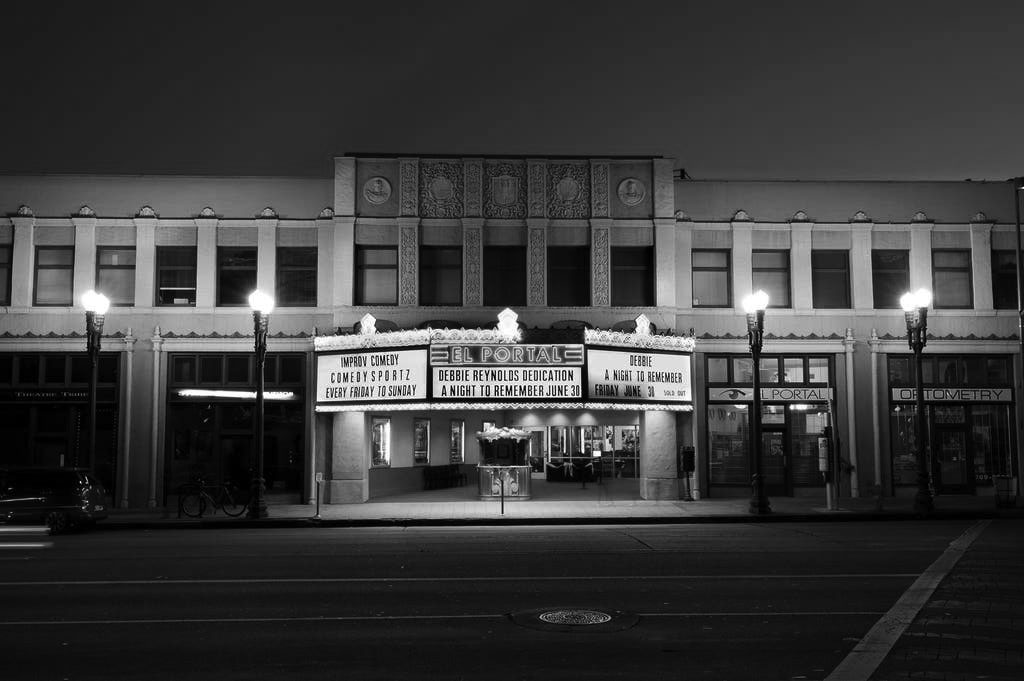 |
|
| (2021)* - Four 'California Special" streetlights stand tall in front of the El Portal Theatre in North Hollywood. Photo courtesy of El Portal Theatre |
Historical Notes The “California Special” was designed by Westinghouse, but produced locally by Llewellyn Iron Works. Chris Burden dubbed these "The Magnolia Double" for his Urban Light sculpture down on Wilshire Blvd. Today, there are still plenty of these to be found on the Magnolia Boulevard between Lankershim and Cahuenga. They were previously found in Leimert Park. Single lamp versions use to line Burbank and Magnolia Blvds. in Burbank, but those are all gone, too. |
* * * * * |
Carroll Ave
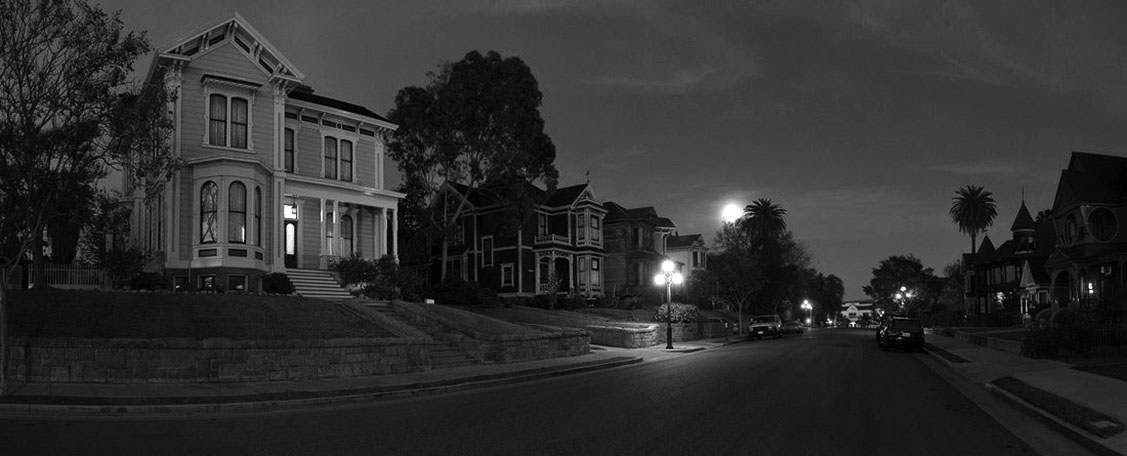 |
|
| (2010s)* – Nighttime view showing the two block section of Carroll Avenue. It has the highest concentration of Victorian Era residences in the City of Los Angeles. Photo courtesy of skyminor |
Historical Notes Carroll Avenue is a two block long street with an international reputation for restored Victorian homes (1880 – 1910). Three, four and five globe authentic fixtures taken from various locations in the City and which date from that era now grace both sides of Carroll Avenue. |
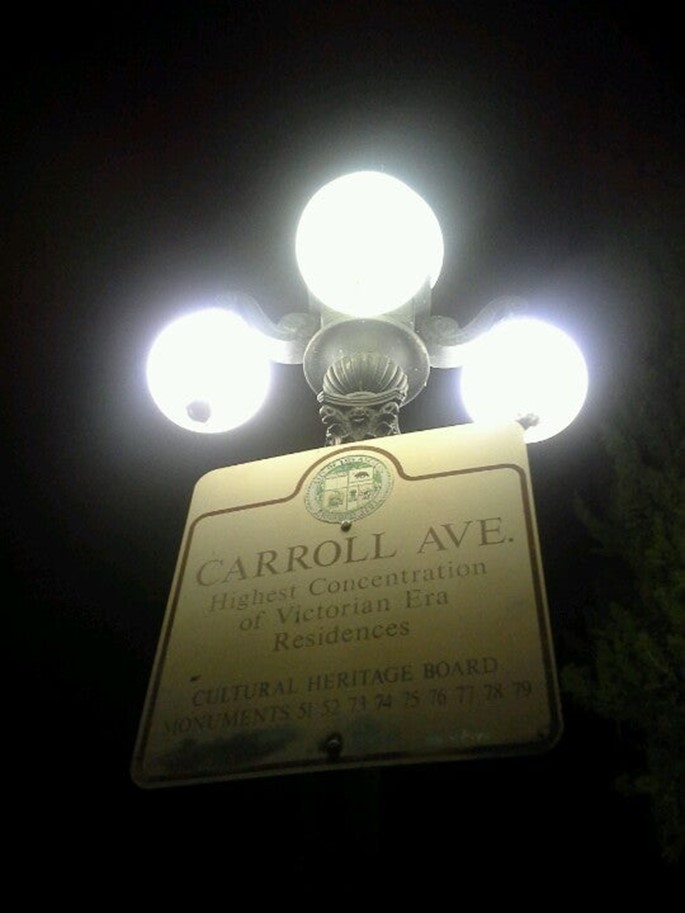 |
|
| (2019)* – Nighttime view showing a five globe streetlight located on the northwest corner of Carroll Avenue and E. Edgeware Rd. Sign reads: Carroll Ave – Highest Concentration of Victorian Era Residences. Photo courtesy of Krystle at Caroll Avenue |
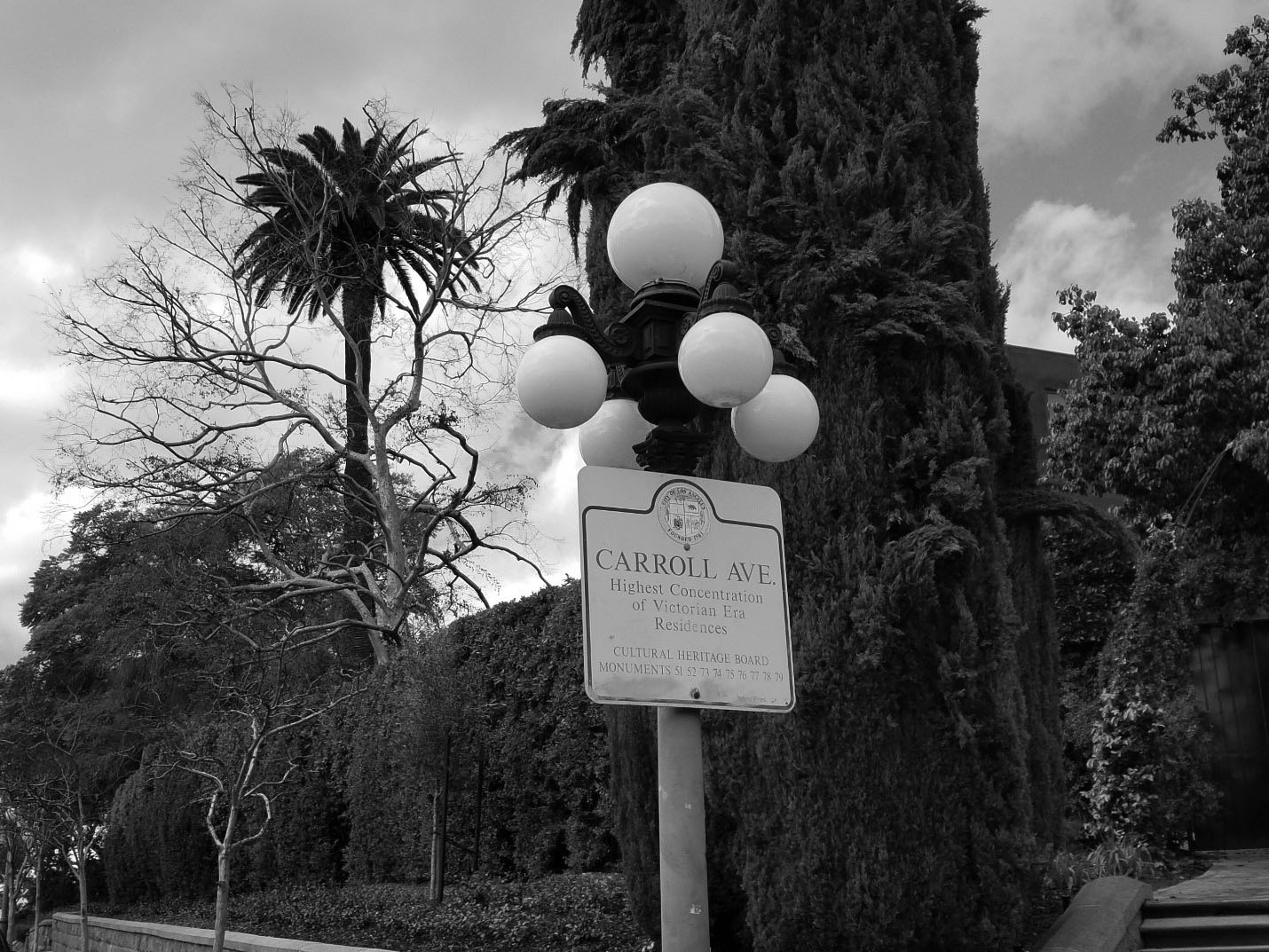 |
|
| (2019)* – Daytime view of the same five globe streetlight located on the northwest corner of Carroll Avenue and E. Edgeware Rd. Sign reads: Carroll Ave – Highest Concentration of Victorian Era Residences. Photo by Jack Feldman |
 |
|
| (2019)* – An ornate 3-globe streetlight stands tall on the north side of Carroll Avenue near Edgeware Road. Photo by Jack Feldman |
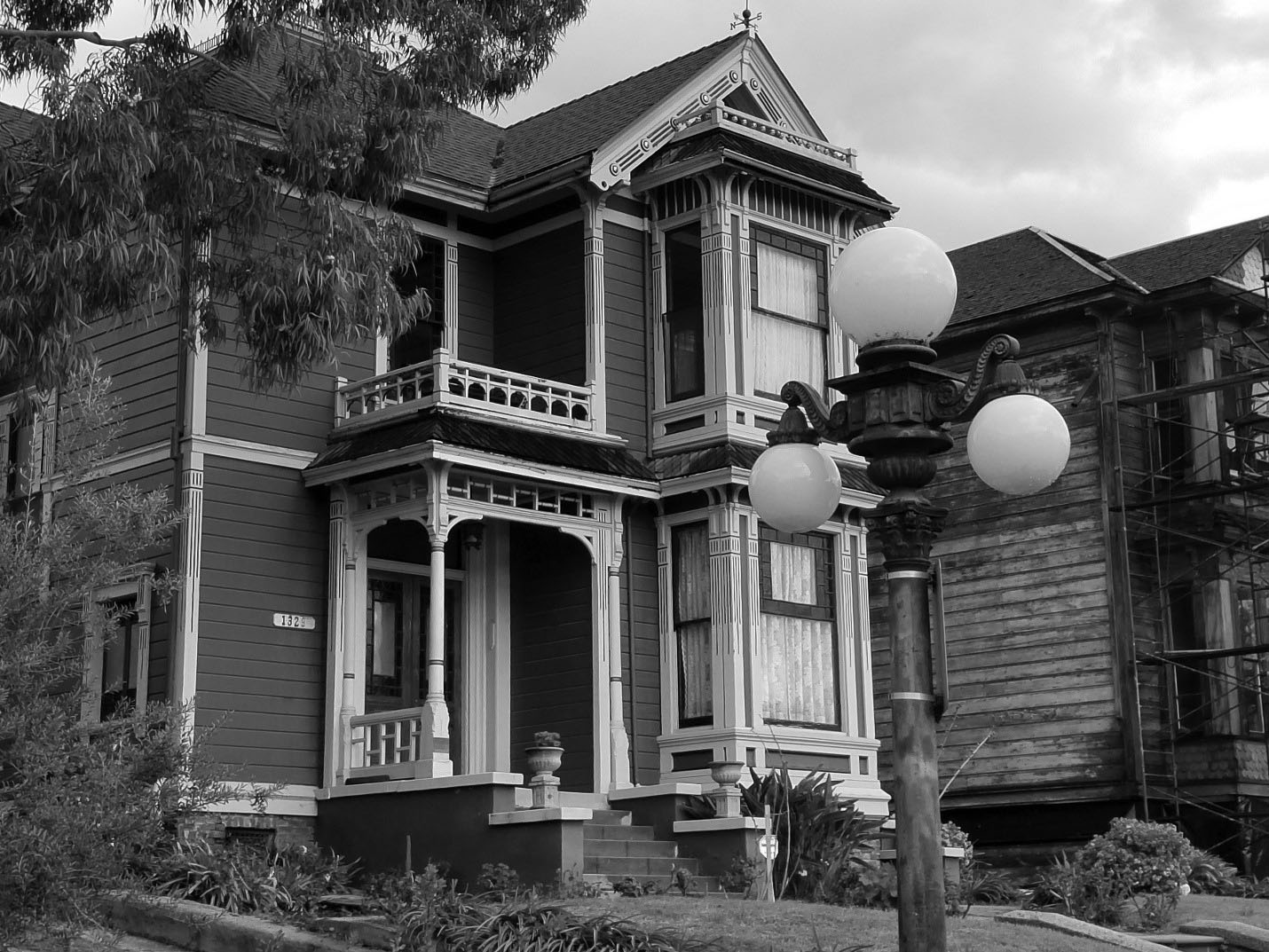 |
|
| (2019)* – Close-up view of the 3-globe ornate streetlight in front of a Victorian home on Carroll Ave. Photo by Jack Feldman |
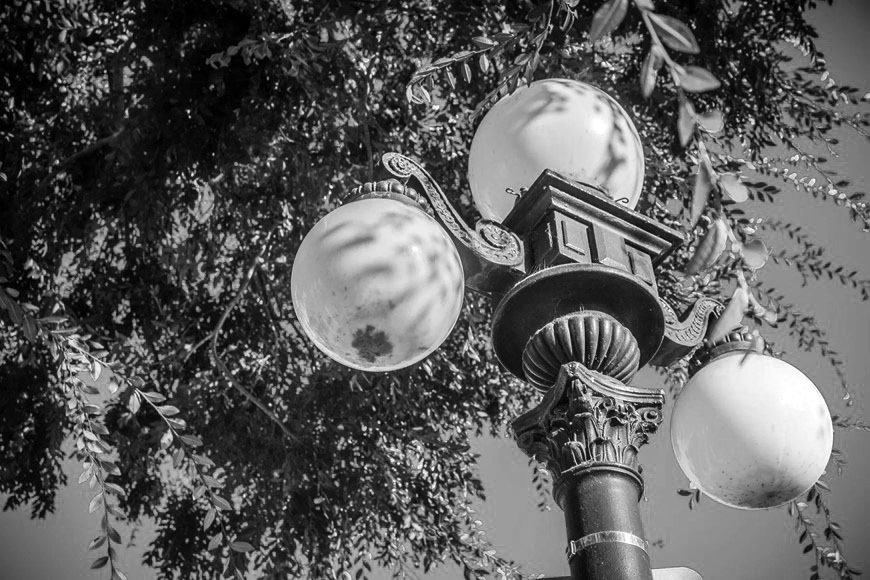 |
|
| (2017)* - Three-lamp ornate streetlight in front of the 1887-built Irey House at 1325 Carroll Avenue. Photo courtesy of Star Foreman / LA Weekly |
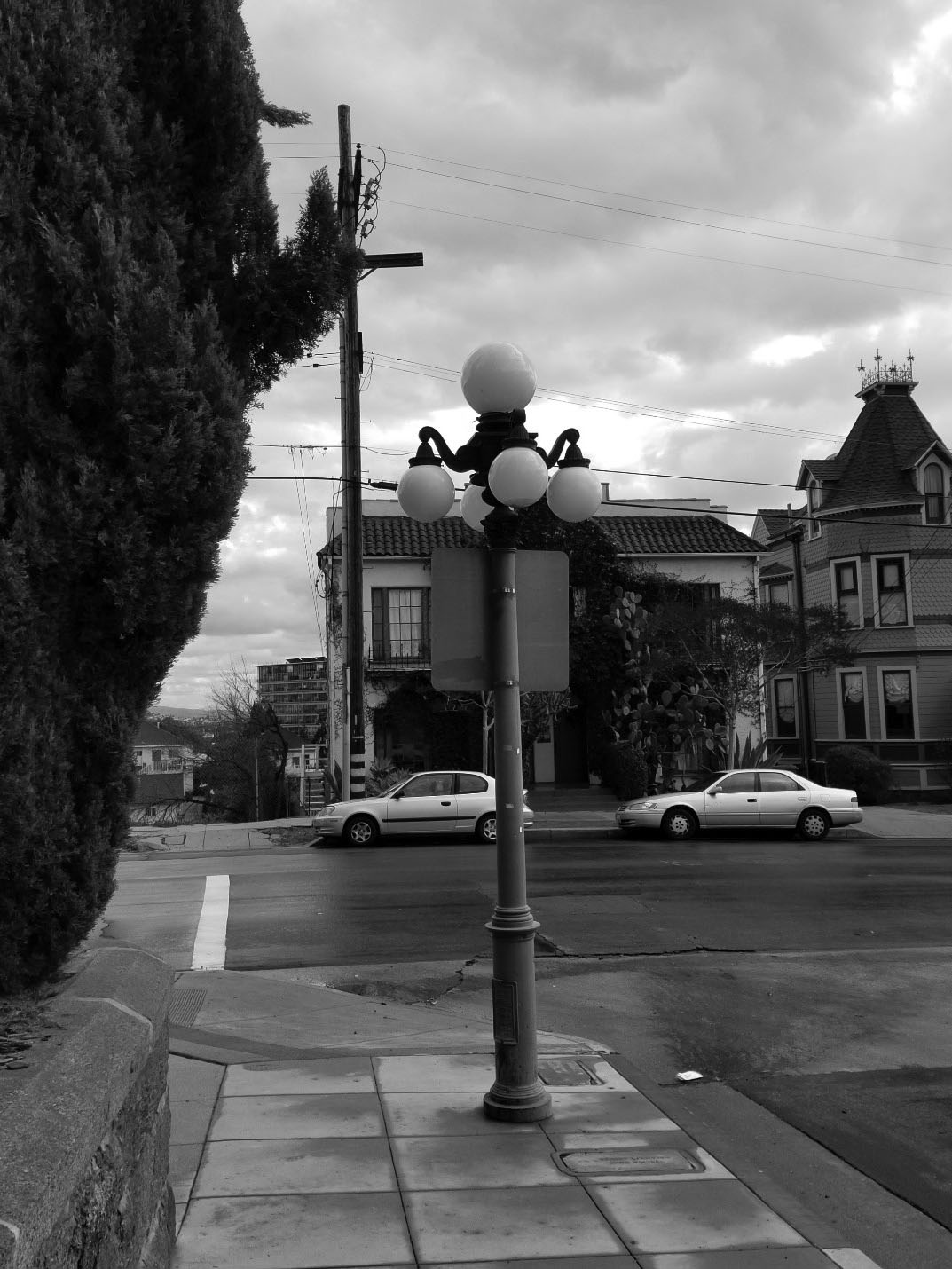 |
|
| (2019)* – View looking east on Carroll Avenue toward E. Edgeware Road showing a renovated 5-globe streetlight on the corner. Photo by Jack Feldman |
Historical Notes The entire 1300 block of Carroll Avenue was listed under the National Register of Historic Places in 1976. |
Pacific Palisades
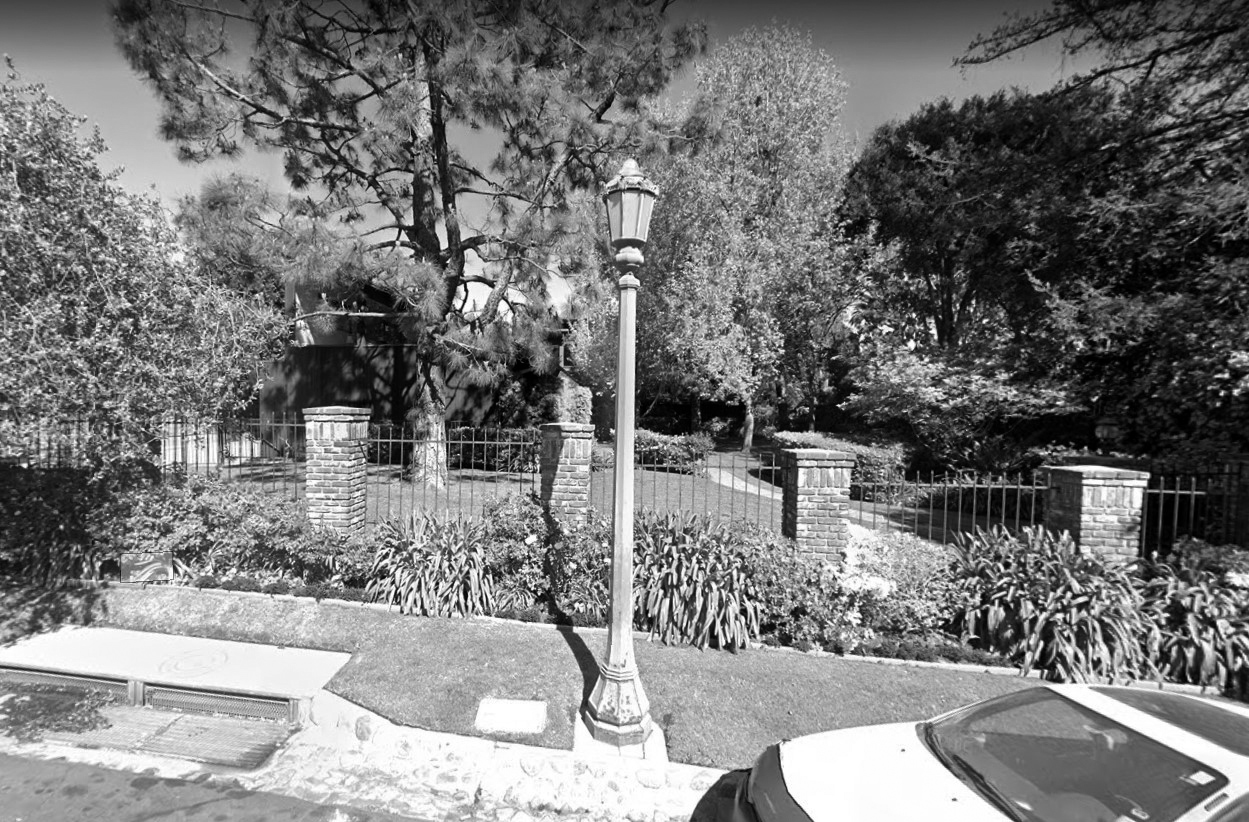 |
|
| (2019)^^ – Google street view showing ornate single-lamp electrolier located on 1500 block of N. San Remo Drive in Pacific Palisades. Similar to the Metropolitan Streetlight Standard. |
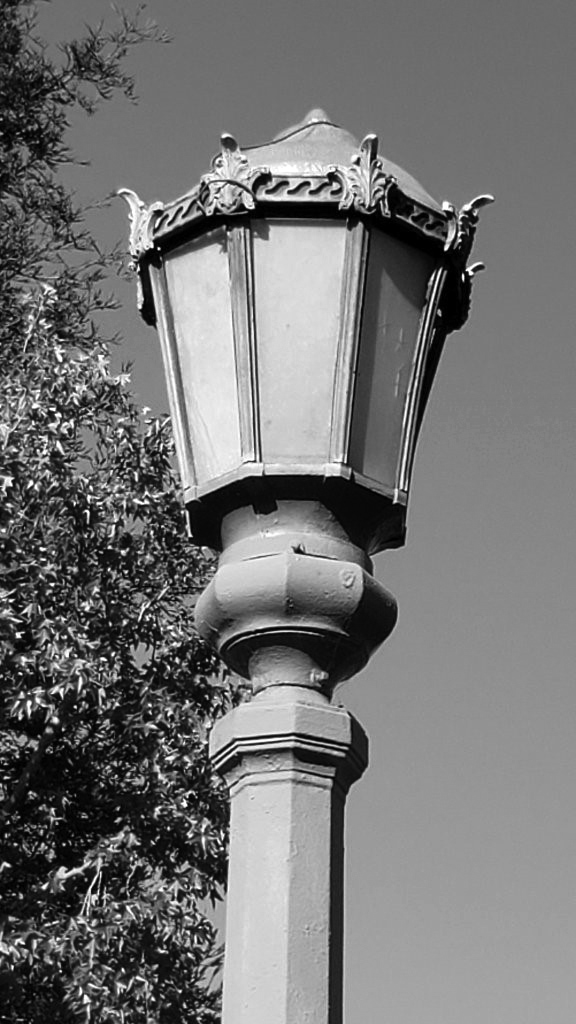 |
|
| (2019) - Close-up detail view showing the single-lamp electrolier seen in the previous photo, San Remo Road, Pacific Palisades. Looks somewhat like a Metropolitan Streetlight Standard but without the spear tip on top. Photo courtesy of Lia Oganesyan |
Melrose Hill Special
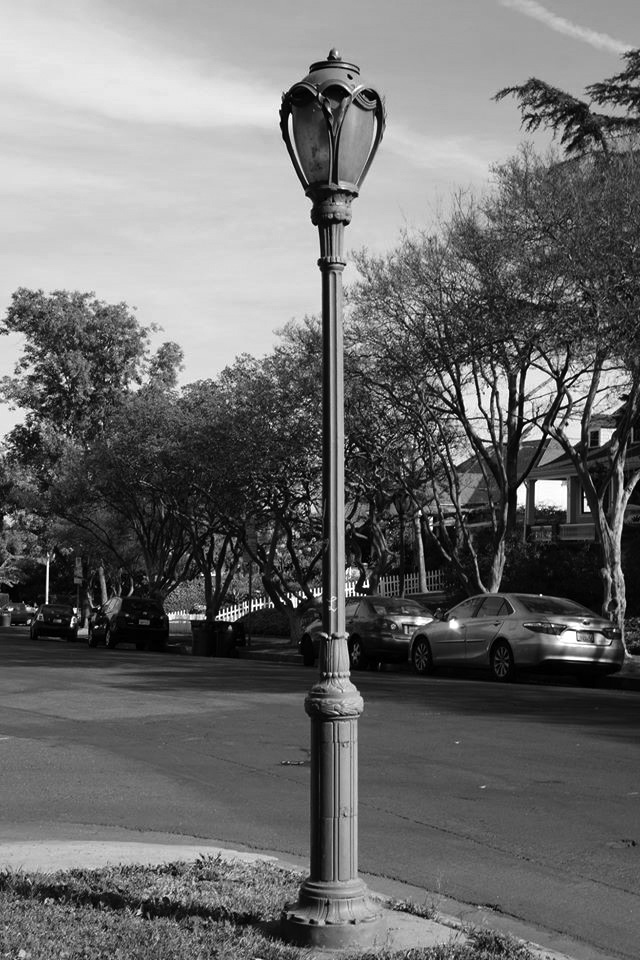 |
|
| (2020)^.^ - View showing a “Melrose Hill Special’ electrolier located in East Hollywood. Photo by Glen Norman |
Historical Notes The "Melrose Hill Specials" can be found along three streets: Marathon Street, Melrose Hill, and an intersecting street also called Melrose Hill. This one is on the corner of Marathon and Melrose Hill. |
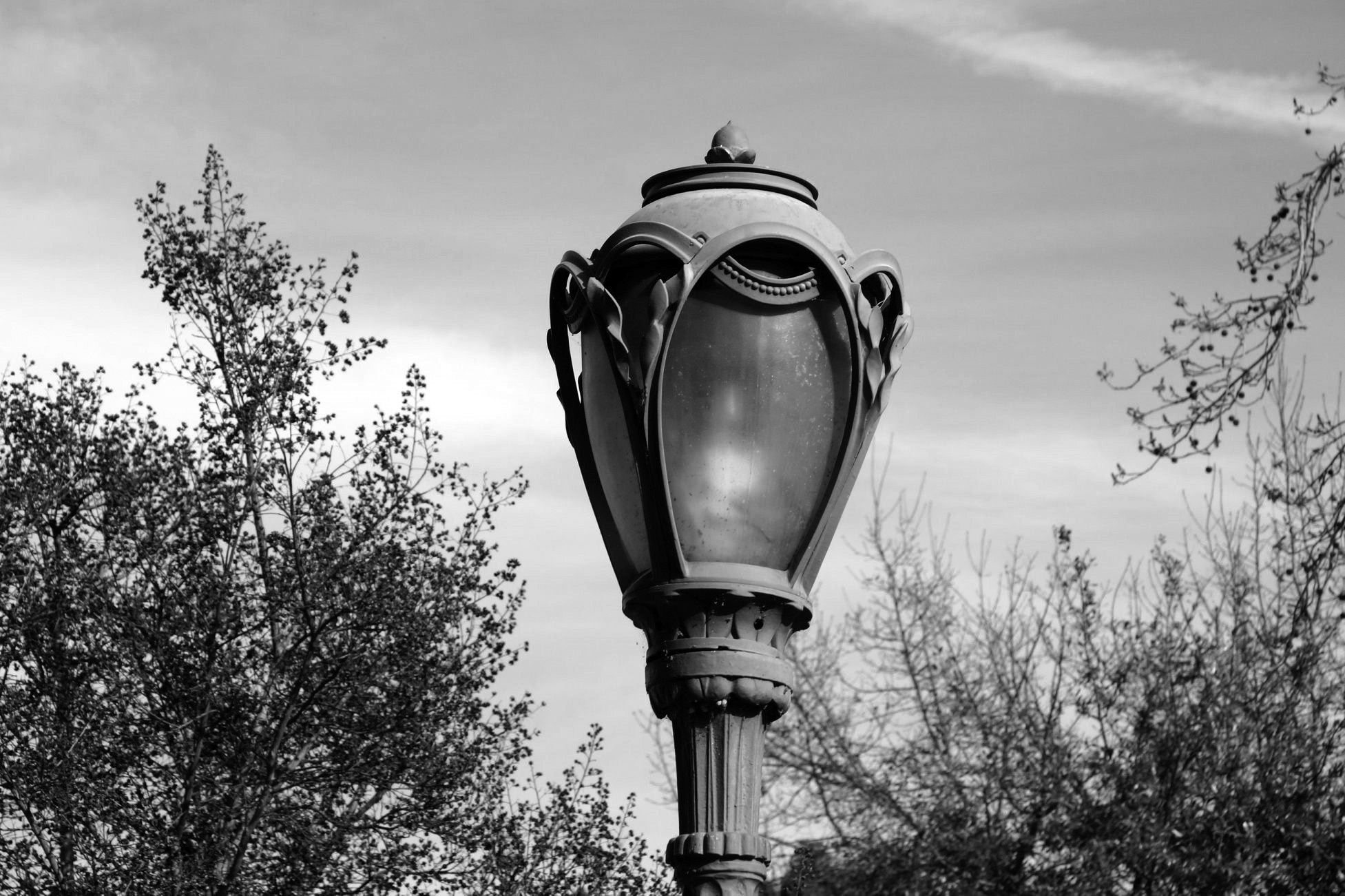 |
|
| (2020)^.^ - Close-up view of a 'Melrose Hill Special'. Note the acorn at the apex of the luminare. Photo by Glen Norman |
Historical Notes Melrose Hill is a small neighborhood located in the Hollywood Studio District of East Hollywood consisting of only a few dozen homes. It is located north of Melrose Ave., South of Santa Monica Blvd., East of Western Ave., and West of the 101. (aka Hollywood Freeway). |
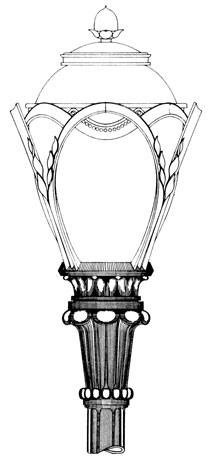 |
|
| (n.d.)* - "Melrose Hill Special" and/or 'Central Park Special' sketch showing design details. |
Historical Notes Designed by architects Gerald Allen and Kent Bloomer in 1983, the above light fixture is found throughout New York's Central Park. It is almost identical to the ‘Melrose Hill Special’ found in East Hollywood. ^ |
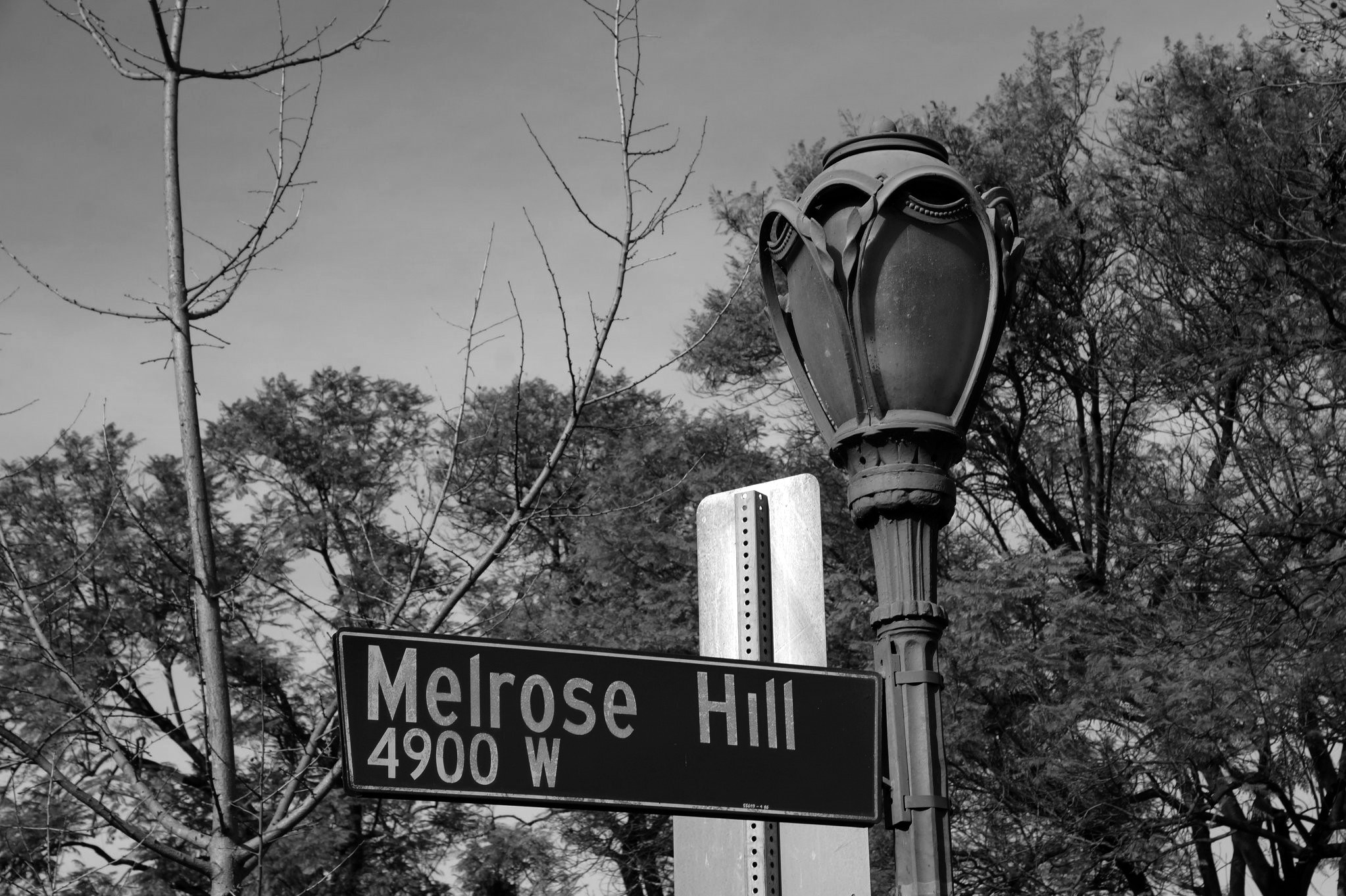 |
|
| (2020)^.^ – An ornate ‘Melrose Hill Special’ electrolier stands on the 4900 block of West Melrose Hill Street in East Hollywood. Photo by Glen Norman |
Historical Notes The cast-aluminum shell of the luminaire is constructed of elliptical curves adorned with abstracted leaves that follow and twist along the curves. The lantern is crowned with an acorn cap. |
More Early Los Angeles Streetlights
.jpg) |
(n.d.)* - View of a 7-bulb electrolier lamp in an early Los Angeles City park.
|
(n.d.)^^ - This pole was installed exclusively in the Holmby Hills area of Los Angeles which is now the location of the homes of many Hollywood movie stars and the Playboy Mansion. |
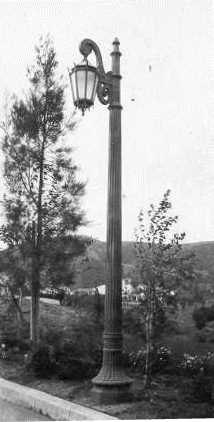 |
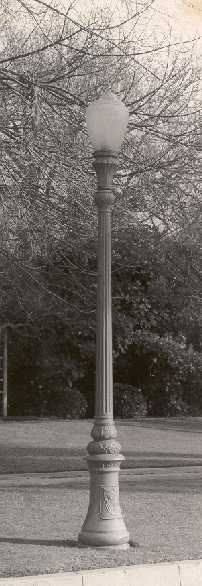 |
(n.d.)^^ - This "Windsor Square Special" originally installed as part of land development in 1914 in the Windsor Square area of Hancock Park was recently refurbished, including the use of incandescent lamps under a special policy adopted by the City Council. |
(n.d.)^^ - No longer in service, this Victoria Park special was affectionately called a 'plumber's nightmare' by maintenance forces. It graced an area of upscale Victorian-style homes from shortly after the turn-of-the-century until nearly 1960. |
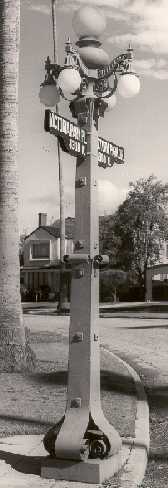 |
Early Ornamental Streetlight Standards
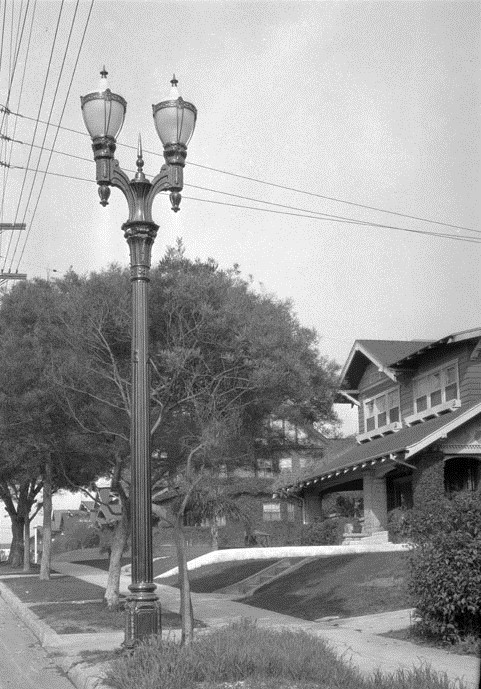 |
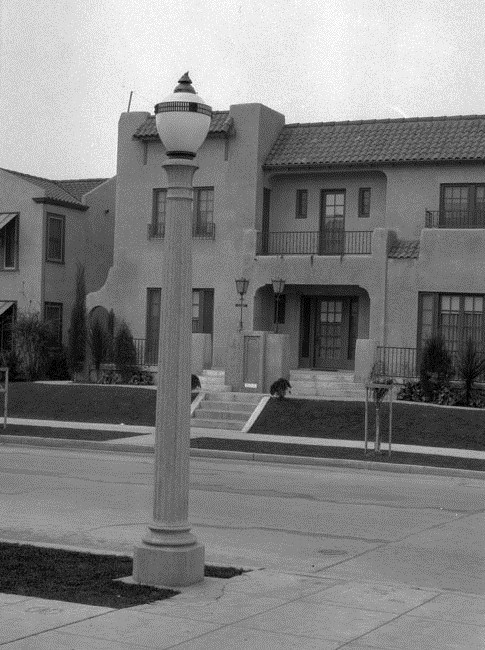 |
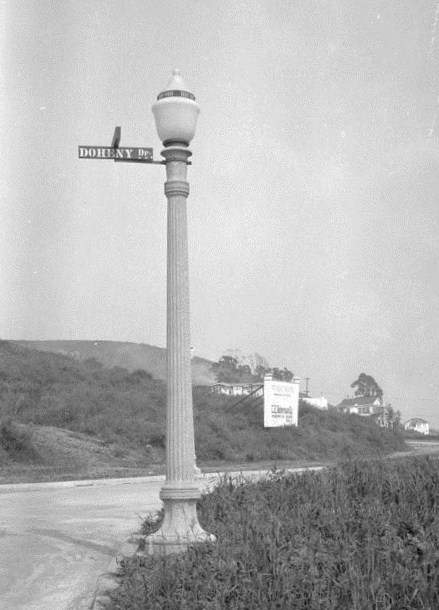 |
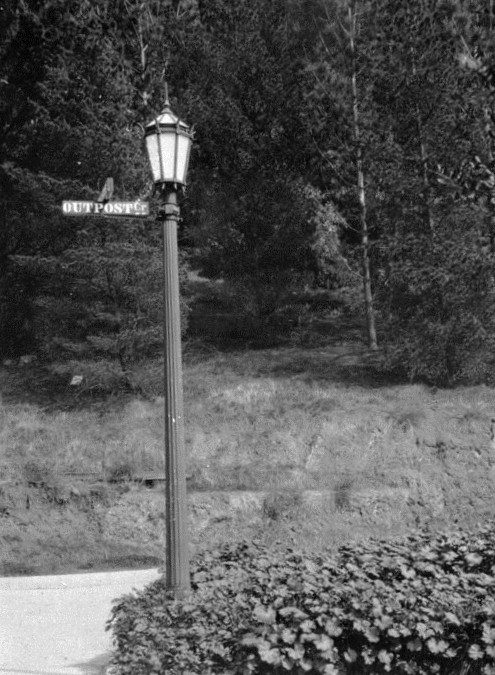 |
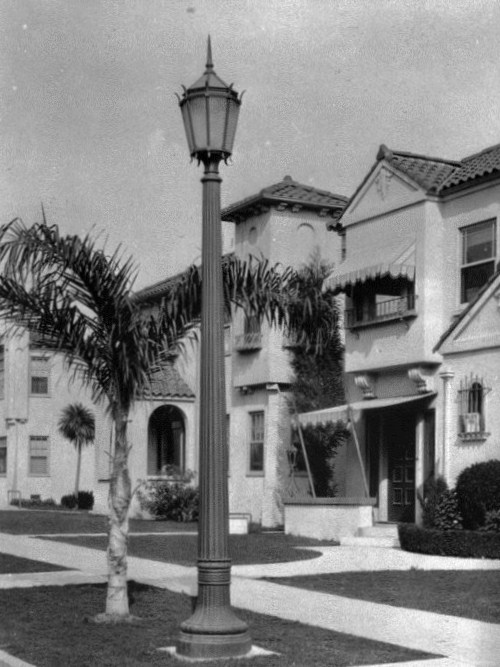 |
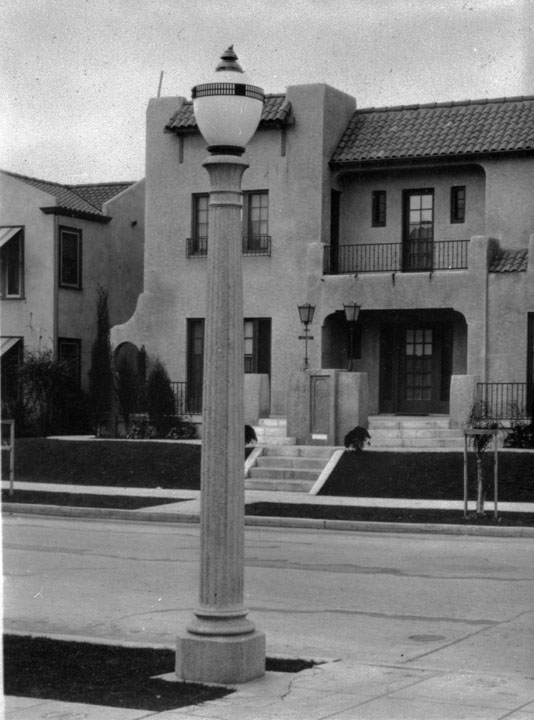 |
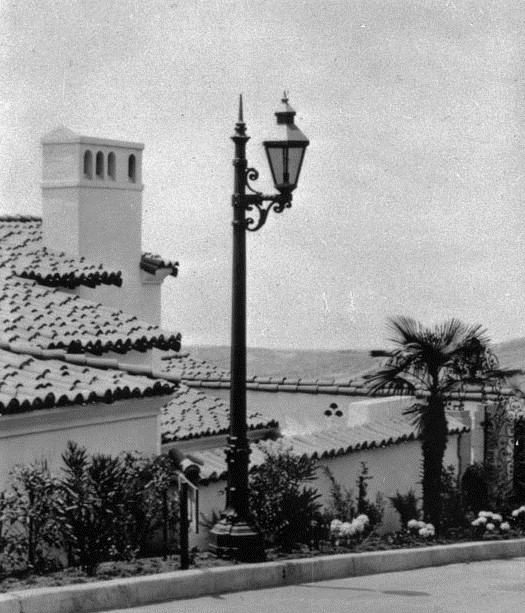 |
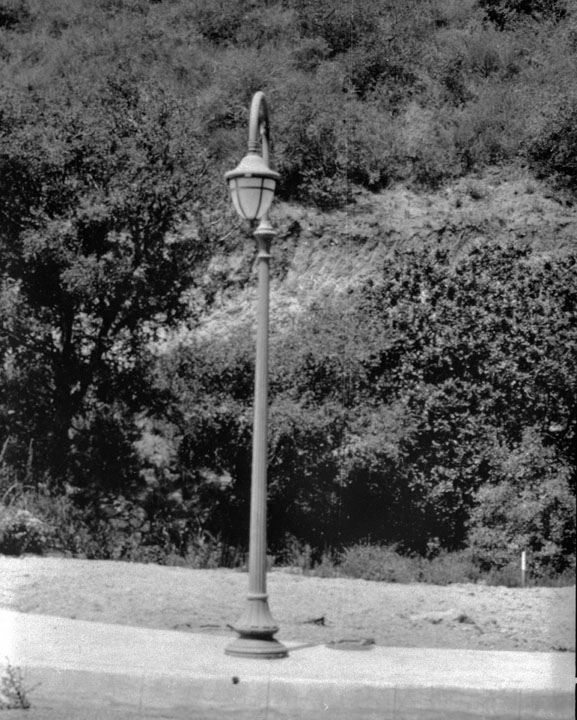 |
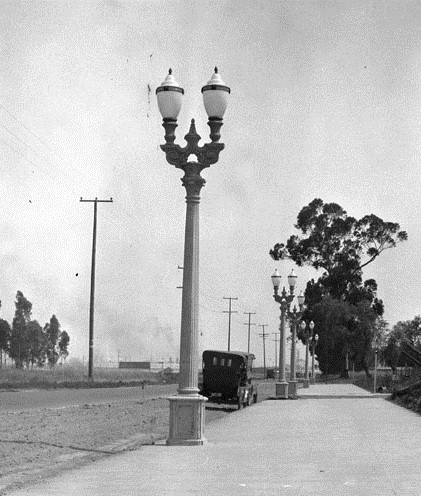 |
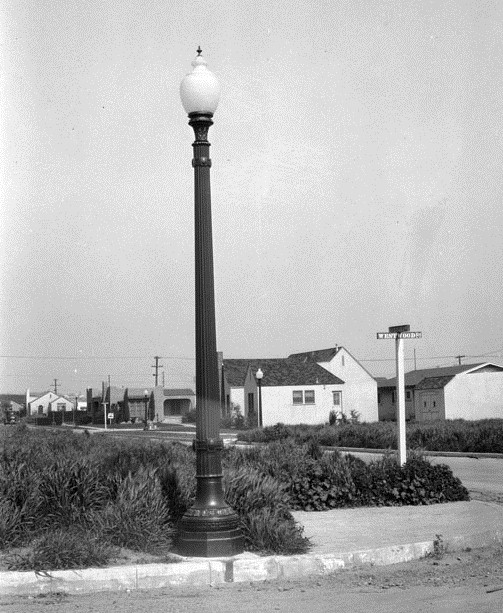 |
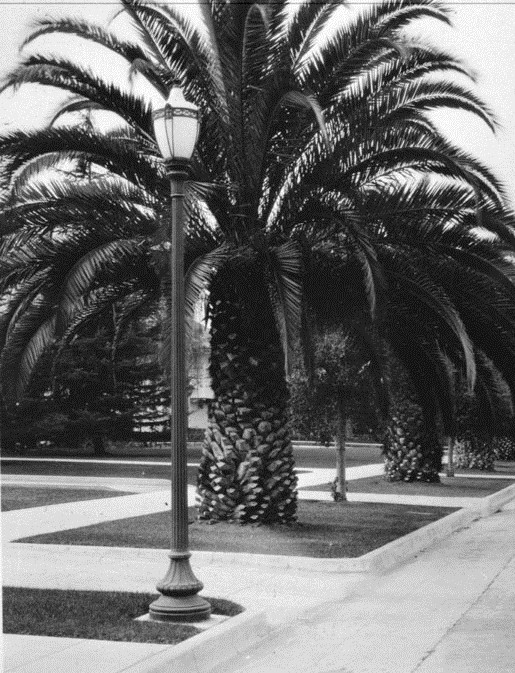 |
 |
Now and Then - We've Come Full Circle!
 |
|
| (1882 vs. 2000)* – A ‘Then and Now’ comparison of Los Angeles' first electric streetlight, installed on the 300 block of North Main Street in early downtown Los Angeles, juxtaposed with a contemporary streetlight at the northeast corner of Valley Circle Boulevard and Avenue San Luis in Woodland Hills. In a way, we've come full circle with these towering lights—though the original stood at 150 feet, today's version reaches only 100 feet, 27 miles away. Photo comparison by Jack Feldman |
Century City Special
The Modern Look - Century City Special (ca. 1960s)^^ - Century City was developed as a major business center in the early 1960's principally sponsored by the Aluminum Corporation of America (ALCOA), hence the use of these aluminum davit poles throughout the streets within Century City.
|
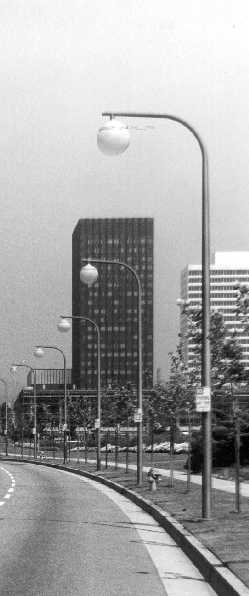 |
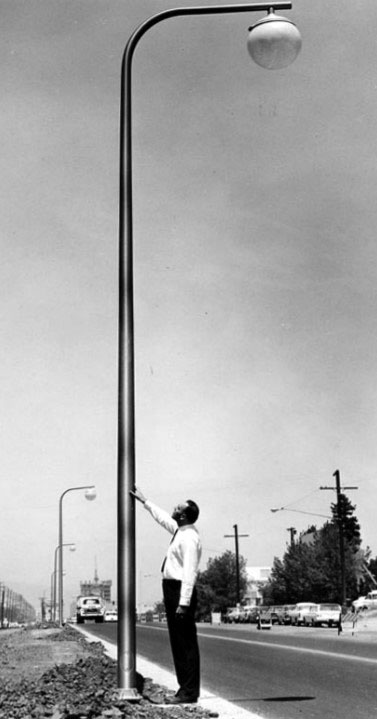 |
(1960)* – View looking west on Santa Monica Boulevard in Century City. A man stands at the base of a newly installed streetlight known as the ‘Century City Special’. |
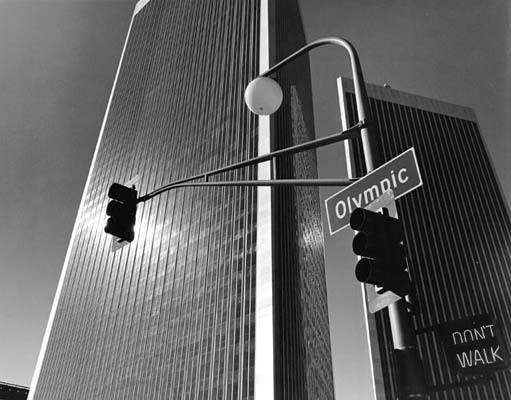 |
|
| (1976)^ - View showing a combination streetlight-traffic signal 'Century City Special' on Olympic Boulevard in Century City. In the background is the triangular shaped Century Plaza Towers, located at 2029 and 2049 Century Park East. |
Downtown Modern-Style
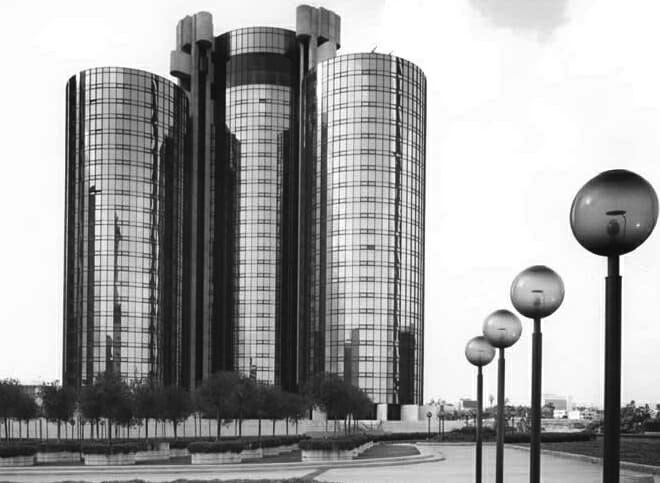 |
|
| (ca. 1980)^x^ - Modern-style streetlights stand in the courtyard in front of the Westin Bonaventure Hotel in downtown Los Angeles. |
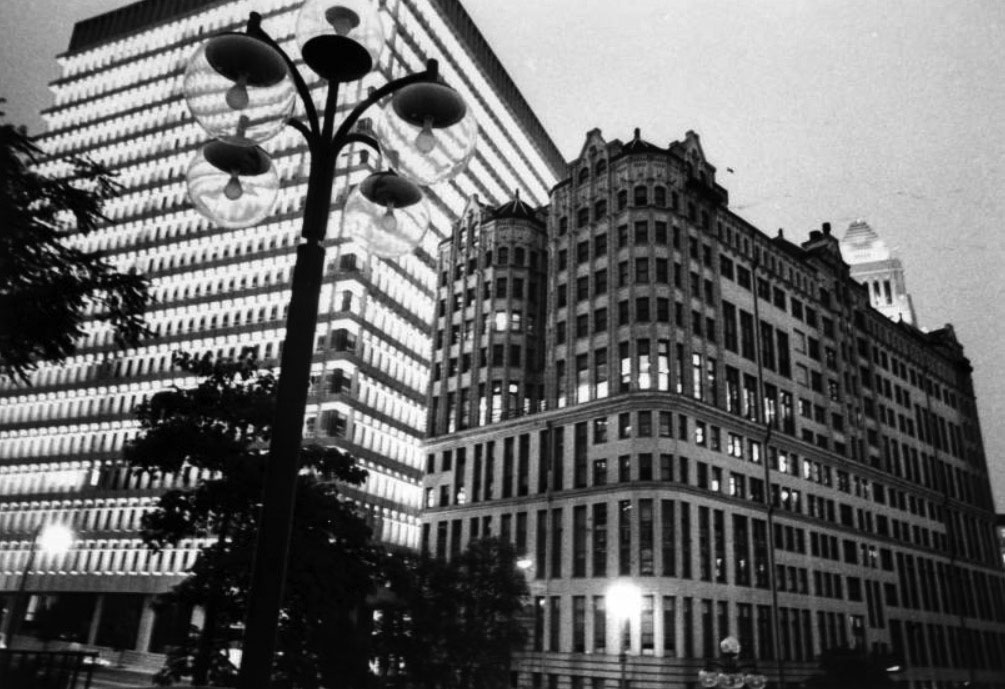 |
|
| (1972)*^ – A 5-lamp decorative streetlight stands in front of th Old Hall of Records building and the newer Criminal Courts building located on Poundcake Hill as seen from across Broadway at the County Mall. |
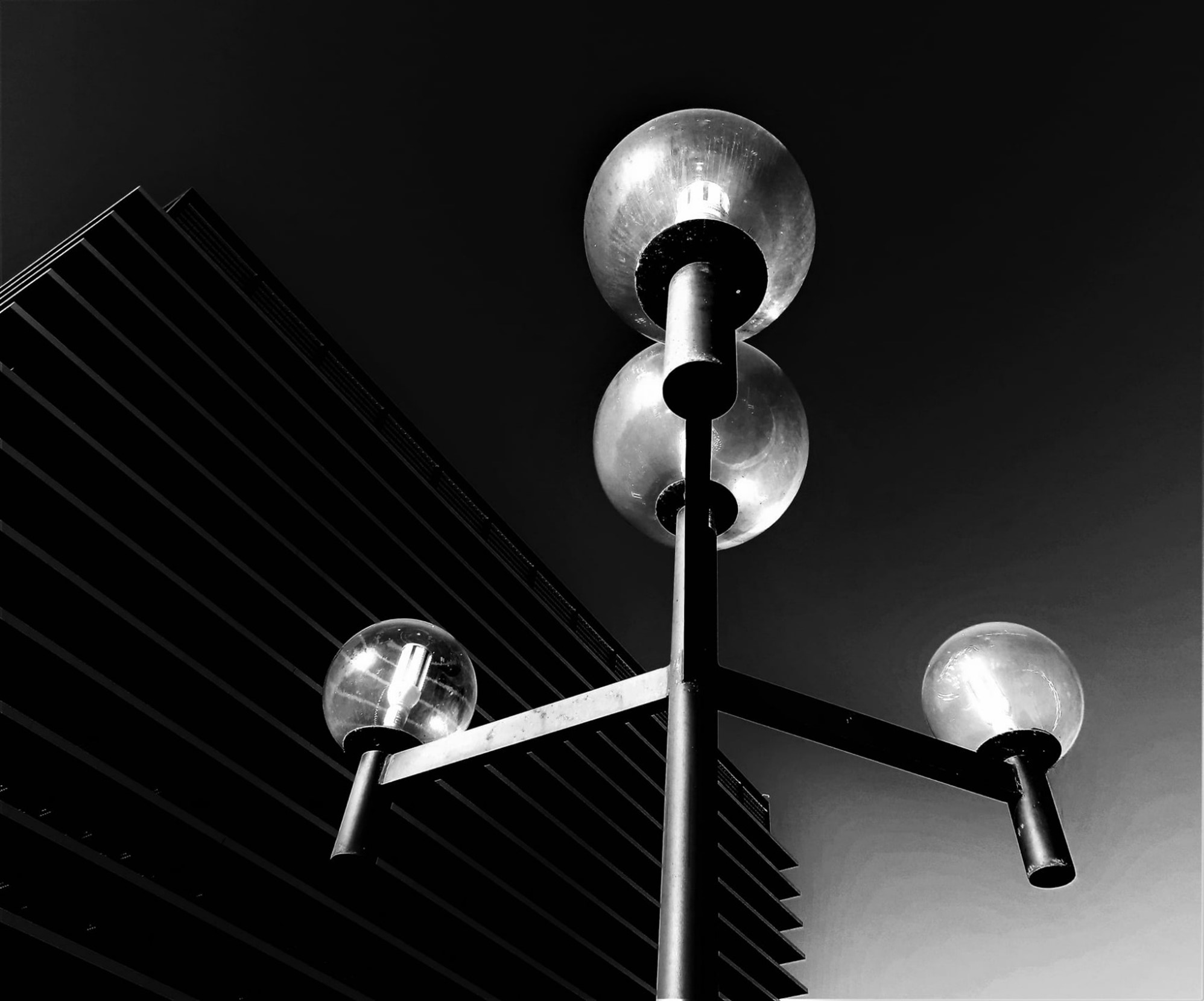 |
|
| (2021)* – 4-bulb decorative LED streetlight with the DWP Building seen in the background. Photo by Howard Gray |
LAX
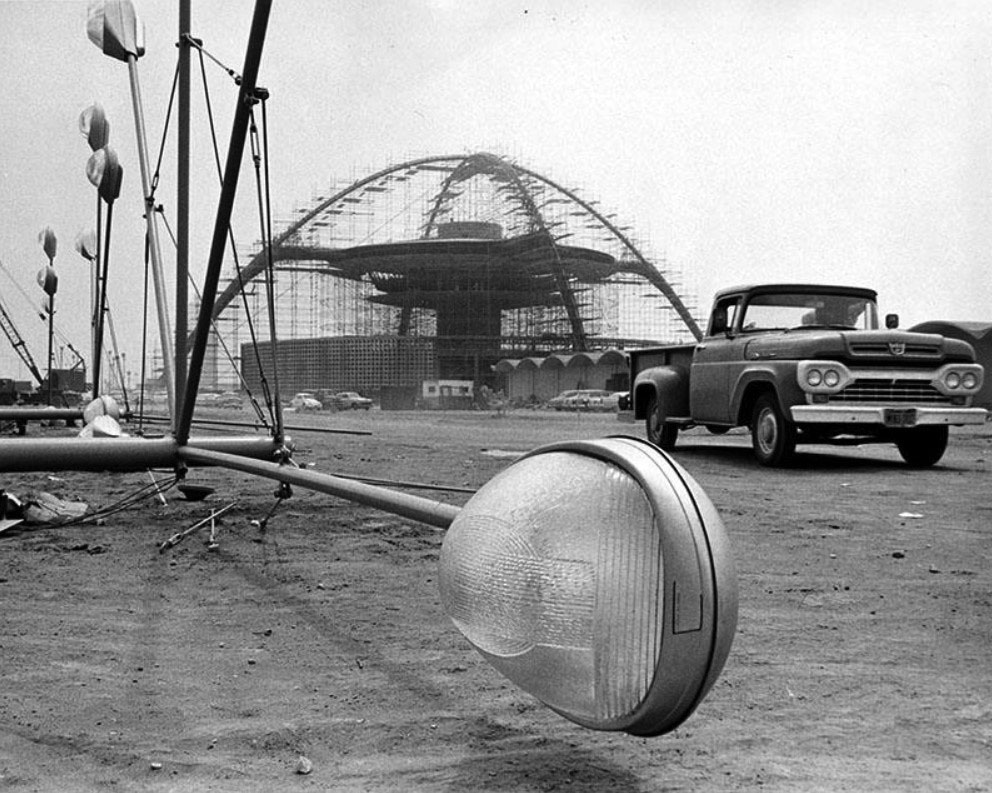 |
|
| (1961)* - New streetlights being assembled in the foreground as construction of LAX's Theme Building proceeds in the distance. Photo by John Woods - LAPL |
Historical Notes Los Angeles International Airport installed eight M-1000 mercury-vapor luminaires mounted atop 57' Pacific Union metal poles, 60 poles spaced 160' apart, six FTC. M-400 mercury vapor used on perimeter roadway and approaches. |
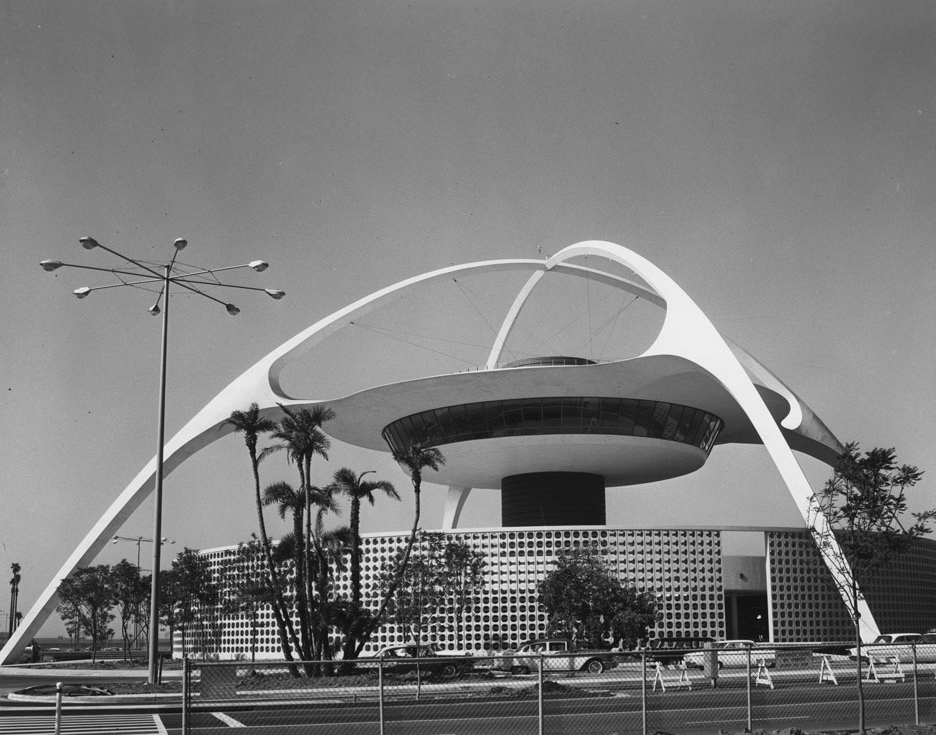 |
|
| (1961)*^ - A tall post with eight street lamp heads on it is situated adjacent to the Theme Building at the Los Angeles International Airport. Another lamp can be seen in the far background. |
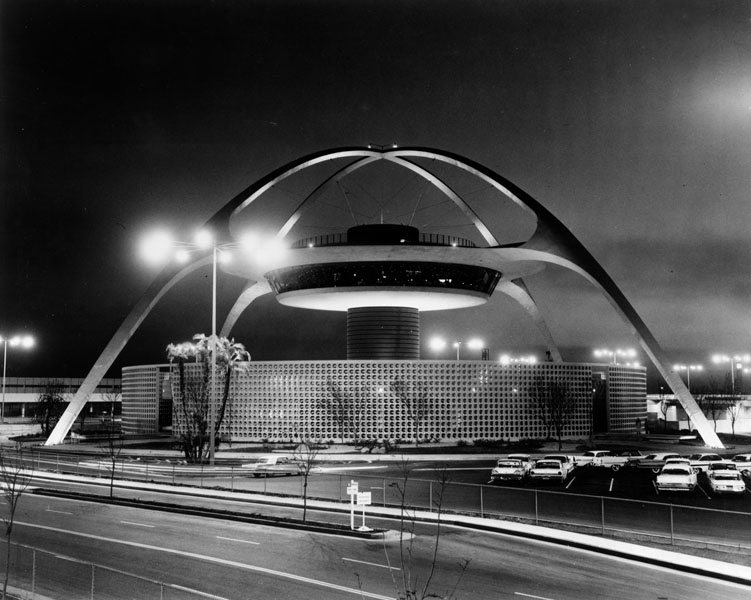 |
|
| (1960s)^ - Theme Building at the Los Angeles International Airport illuminated at night. Multiple lights can be seen around the building and in the parking area. |
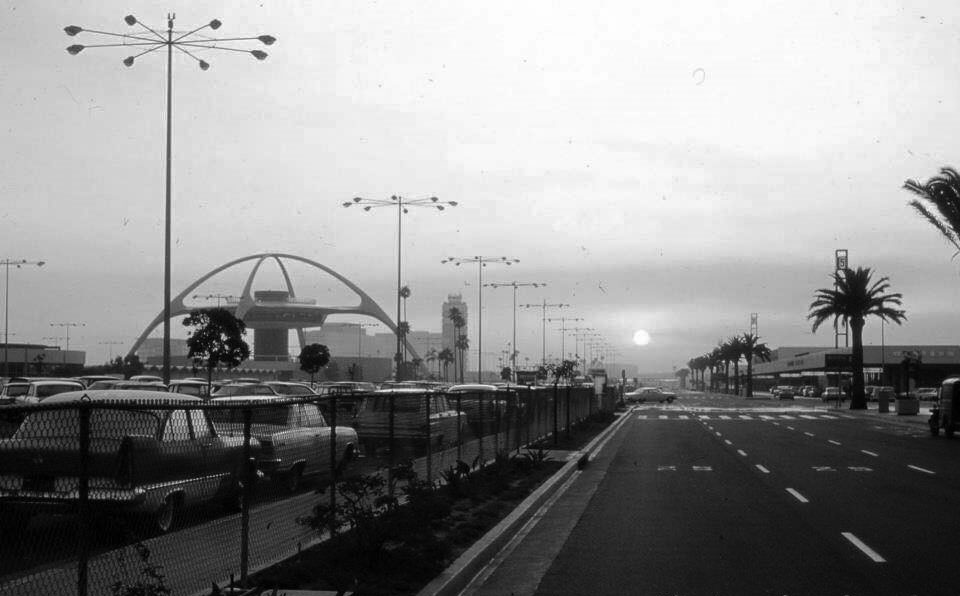 |
|
| (ca. 1964)* - An early morning sunrise at LAX Airport during the Atomic Age. Photo LA Times |
 |
|
| (1961)^v^ – View showing the control tower administration building at LAX. Also seen is a 57’ tall, 8-lamp, mercury-vapor streetlight in the parking lot. |
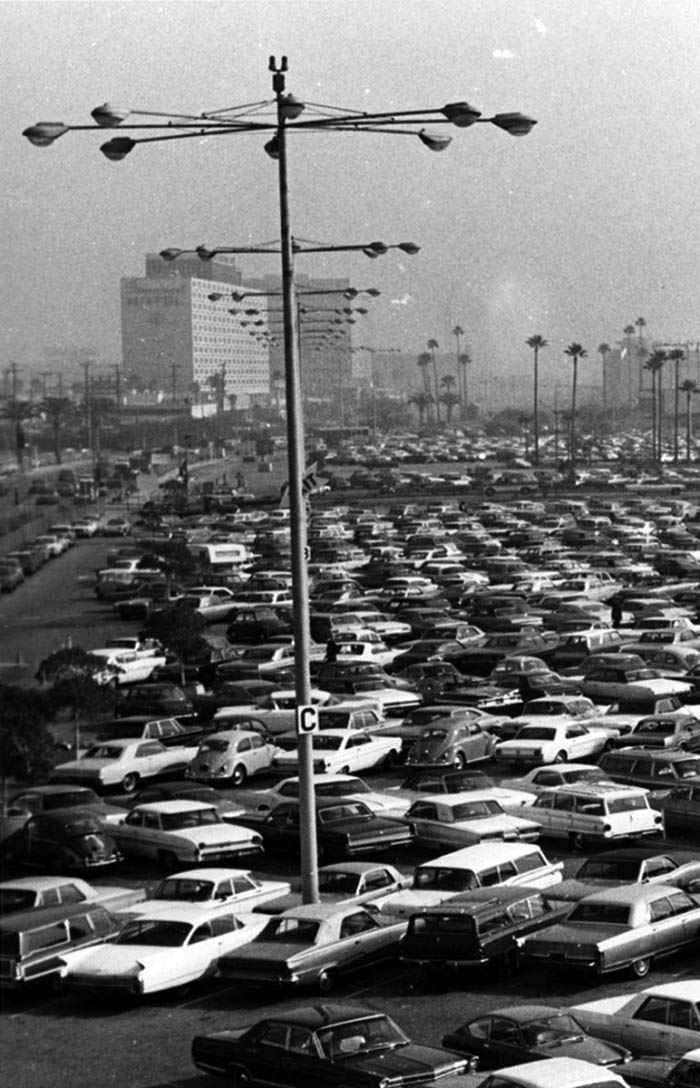 |
|
| (ca. 1974)*^ – A line of tall eight-headed lamps stand in the foreground, above row upon row of automobiles in a series of parking lots outside the airport. |
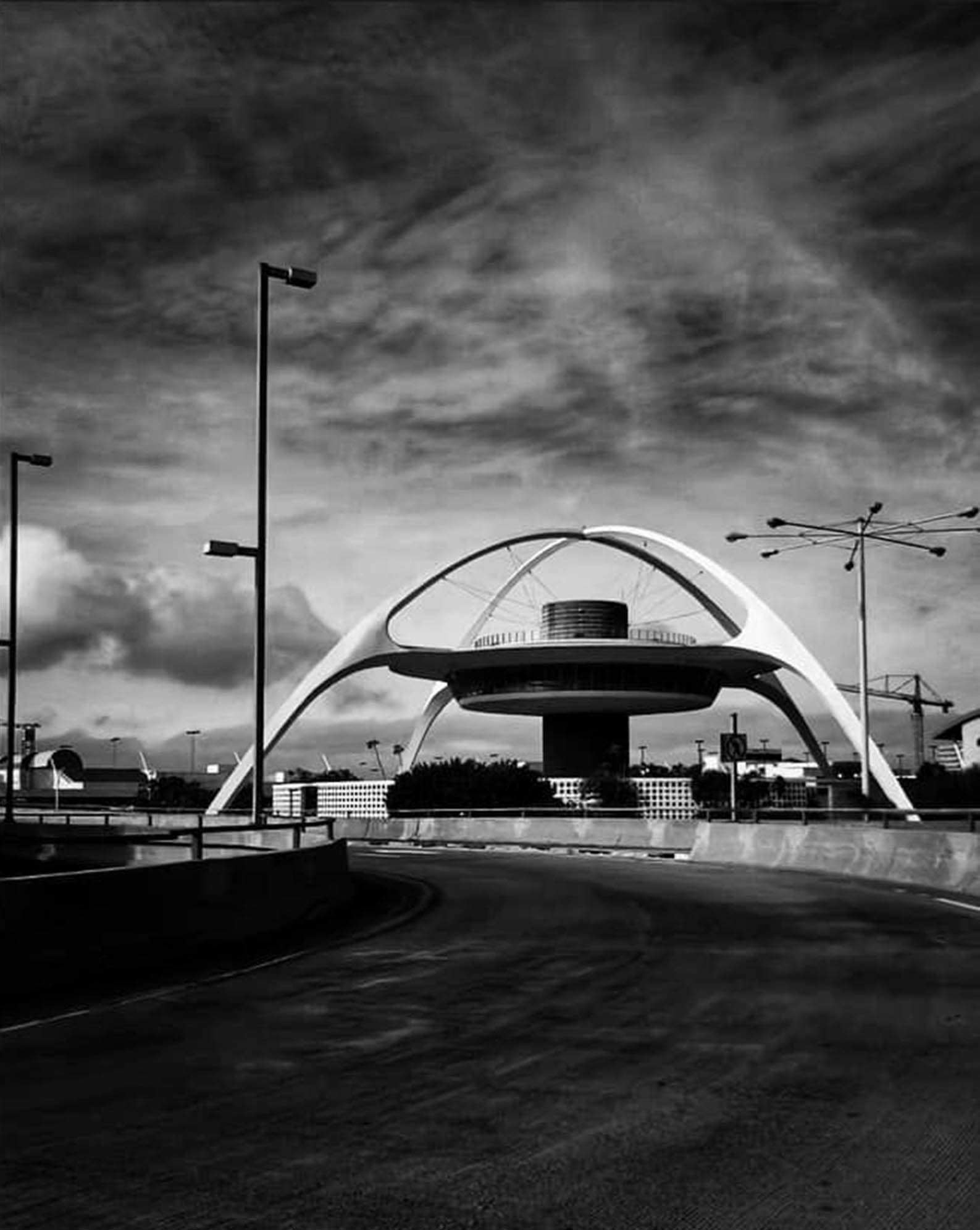 |
|
| (2022)* – Streetlights surrounding the Theme Building. Photo by Carlos G. Lucero |
LAX Eaton Contemporary Streetlights
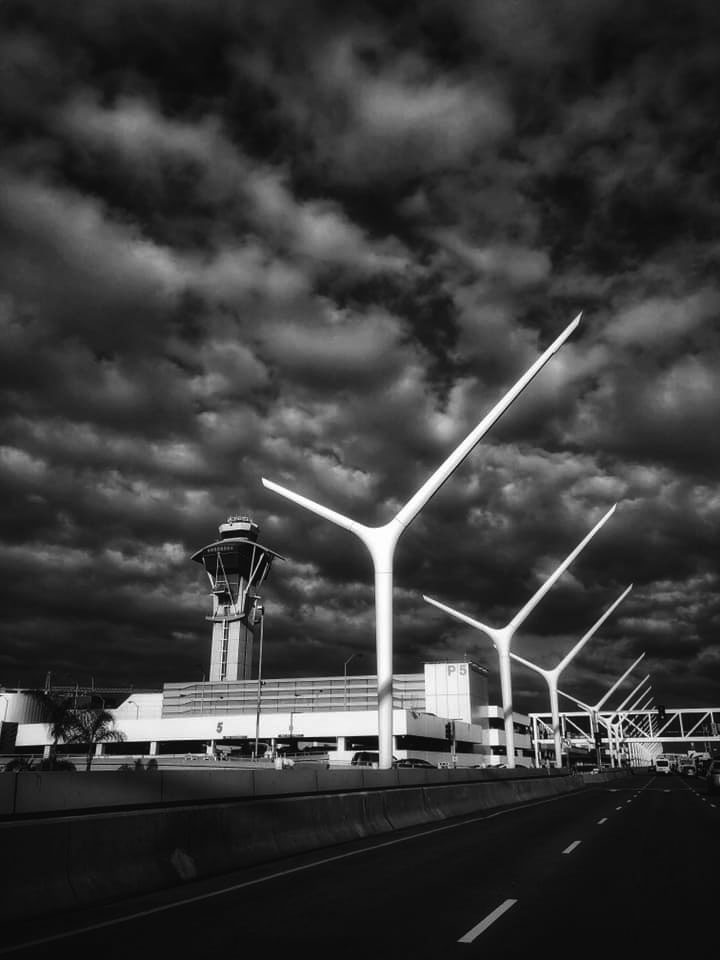 |
|
| (2020)^.^ - Double-arm Y-shaped contemporary streetlights, looking more like airplane propellers, line the roadway at LAX with the Control Tower seen in the background. Photo by Carlos G. Lucero |
Historical Notes Eaton dual-arm contemporary streetlights played a crucial role in revamping the exterior curbside lighting, as part of the first and second phases of the $118-million LAX Curbside Appeal and Roadway Improvement Project. The newly installed street lighting consumes 48 percent less energy than the 33-year-old, high-pressure sodium lights they replaced. |
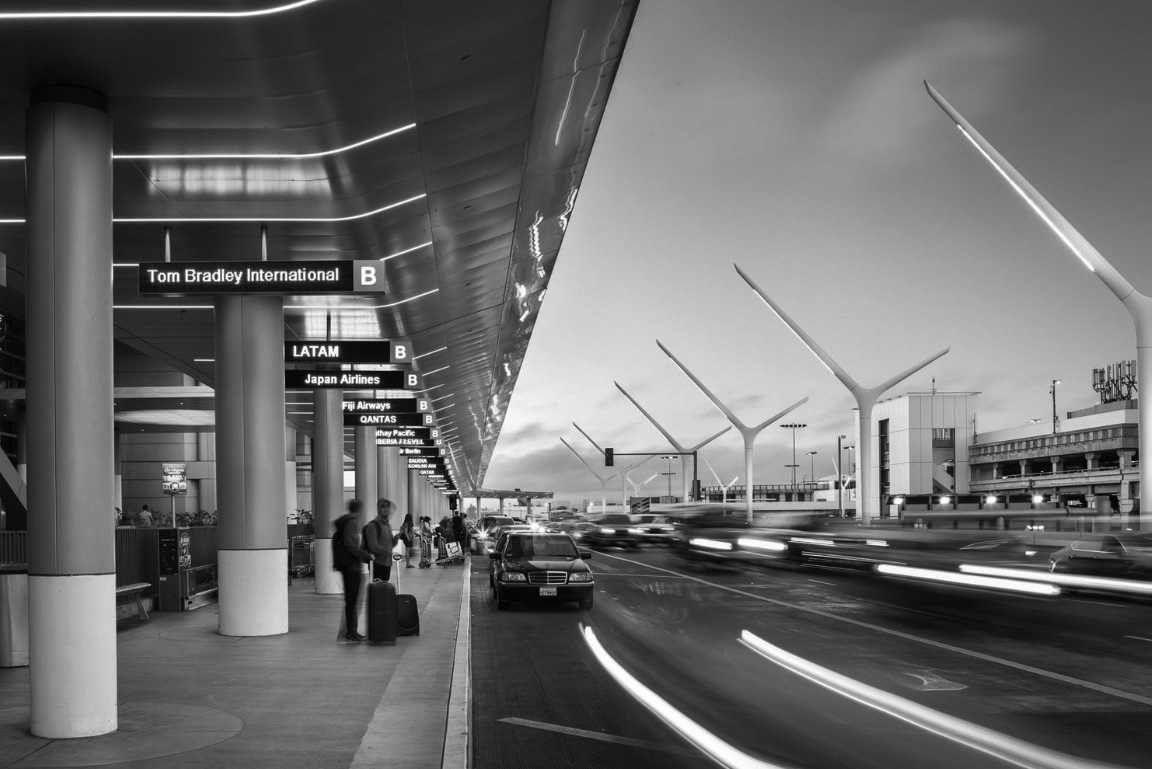 |
|
| (2018)^.^ - View showing highly customized, double-arm Y-shaped, contemporary streetlights in front of the Bradley International Terminal at LAX. Photo courtesy of Mike Kelley |
Historical Notes In 2013, the first 13 of the dual-arm contemporary fixtures were installed for the unveiling of the new $1.9 billion Tom Bradley International Terminal. 78 additional Y-shaped fixtures were subsequently installed throughout the airport. |
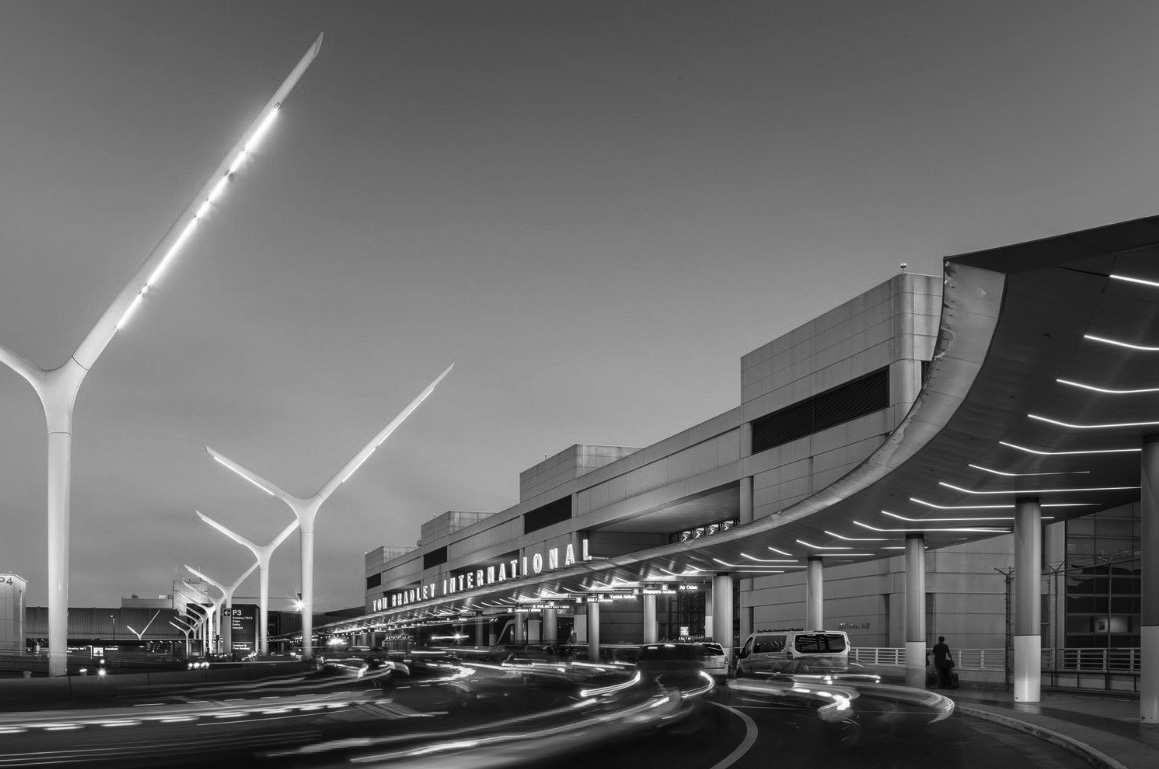 |
|
| (2018)^.^ - A line of Eaton contemporary electroliers light up both the roadway above (Departures) and roadway below (Arrivals) by the Bradley International Terminal at LAX. Photo courtesy of Mike Kelley |
Historical Notes These contemporry Eaton Electroliers were inspired by the ’60s style of the Theme Building and took their sculptural form from airplane propellers. |
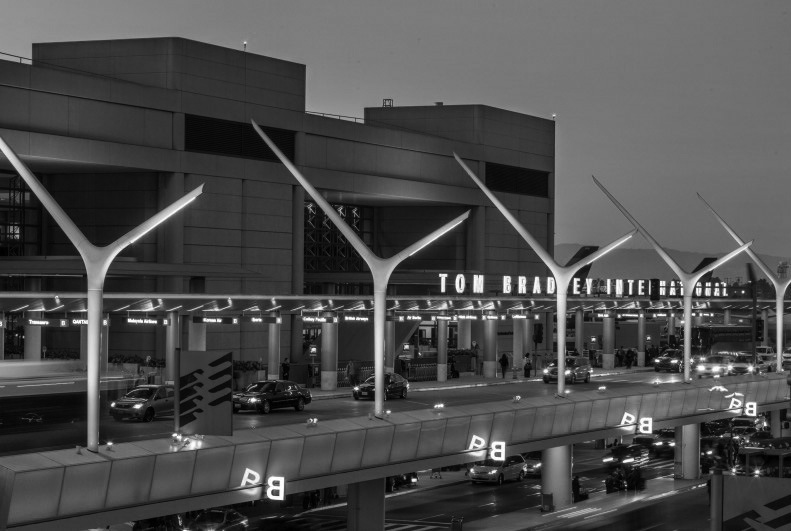 |
|
| (2018)^ – View showing the propeller-like streetlights that illuminate both upper and lower levels at LAX. Photo courtesy of AECOM |
Historical Notes The streetlights’ two arms illuminate different areas and levels of the roadway. The resulting uniform illumination meets the roadway lighting requirements (average 2.5 foot-candles) for both the Lower/Arrivals and Upper/Departures levels at the airport, which serves 70.7 million passengers each year. |
Highland Avenue 'Genie' Specials
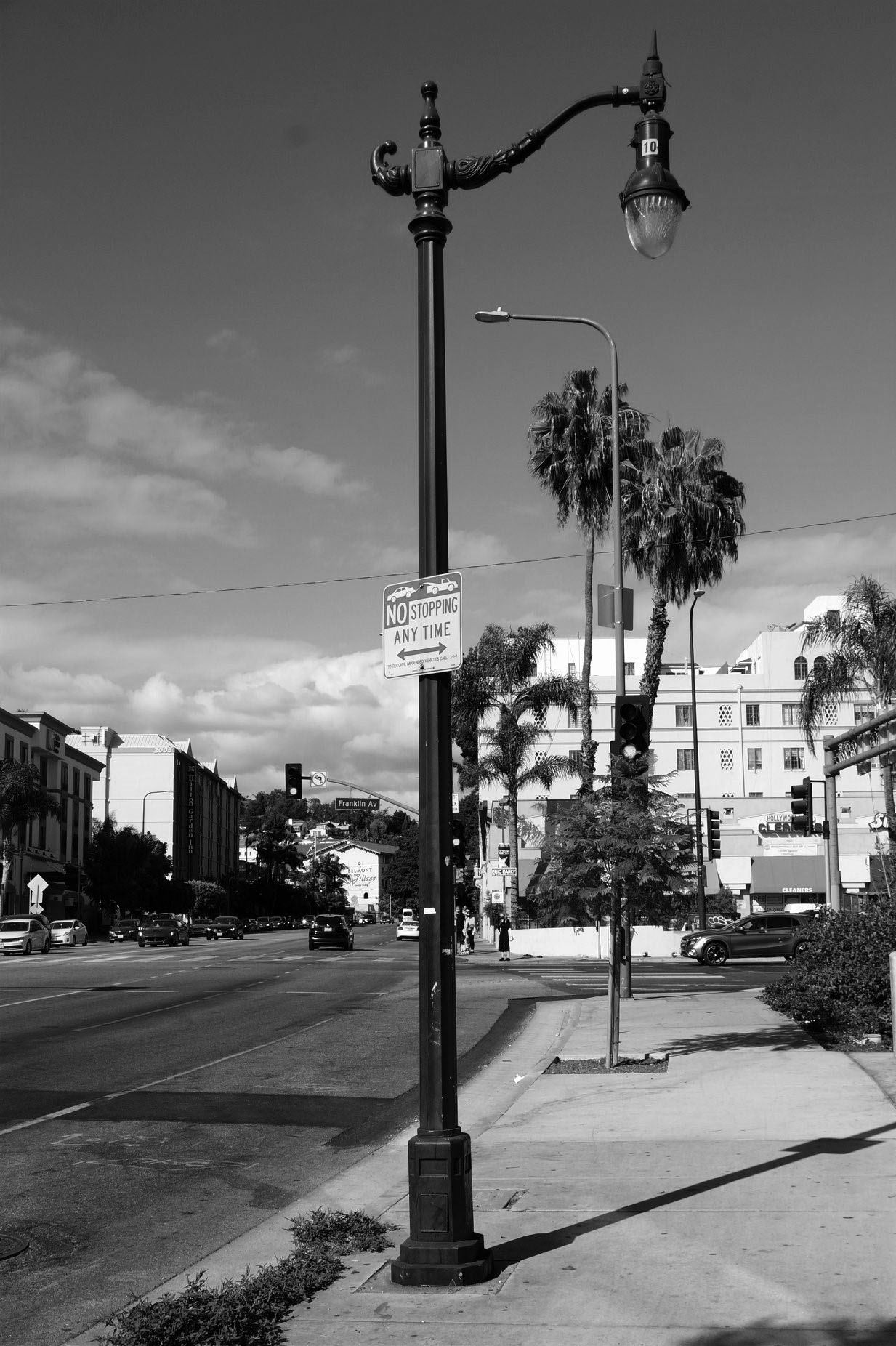 |
|
| (2010s)^.^ – View looking north on Highland at Franklin Ave showing a Genie-type streetlight with a teardrop lantern, known as the Highland Special. Photo by Glen Norman. |
Historical Notes Scroll arms (sometimes called Genie arms for their passing resemblance to Aladdin's Lamp) are pretty common on the pedestrian-scaled lights that have appeared in Los Angeles over the past couple of decades. Usually, those street lights feature skirts surrounding the the globes. The Highland Special Pole does not show this feature. |
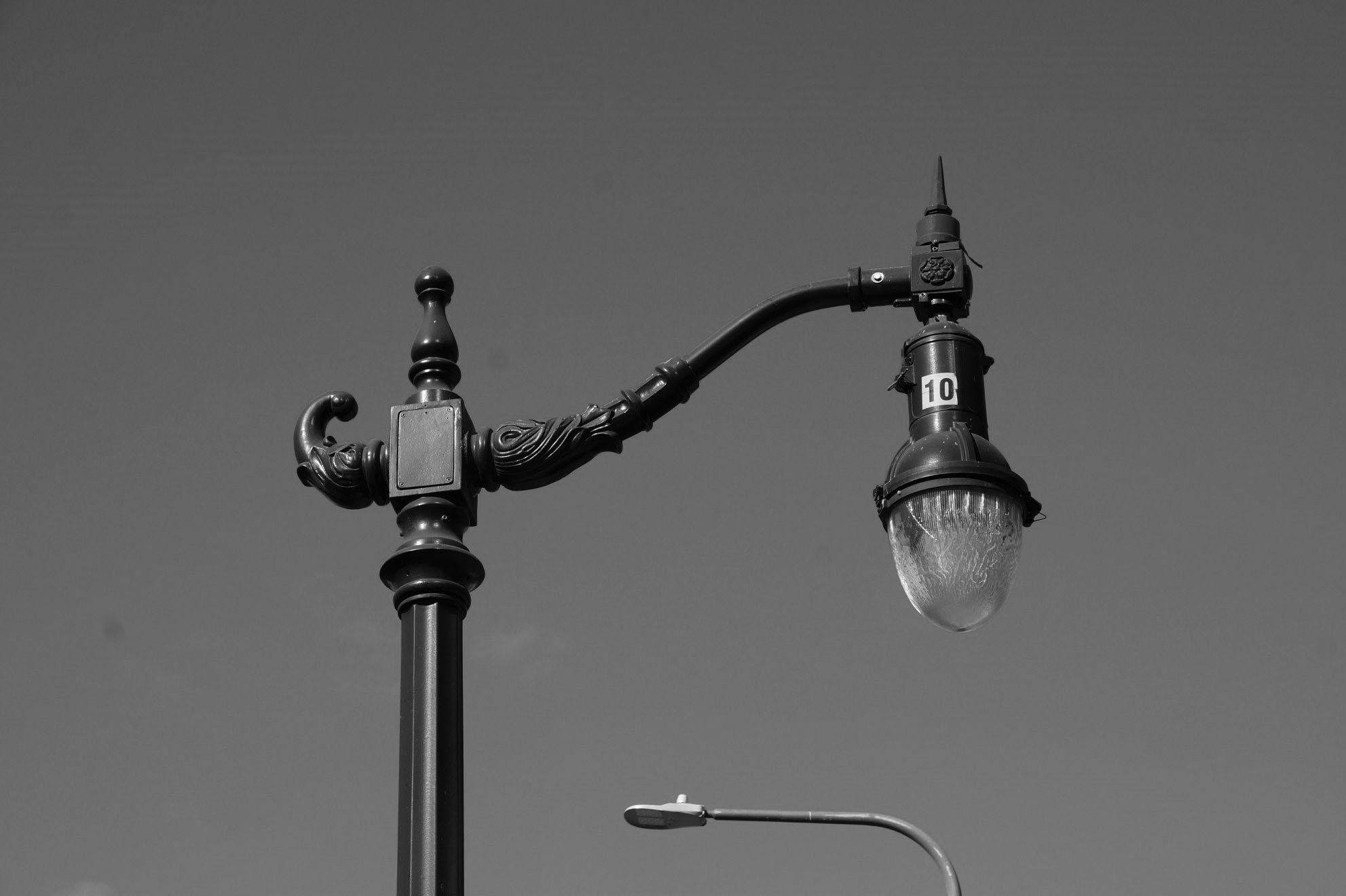 |
|
| (2010s)^.^ – Close-up view showing the Higland Special with its passing resemblance to Alladdin’s Lamp. Photo by Glen Norman |
Historical Notes The Highland Special Pole can be found on its namesake thoroughfare Highland Avenue from Yucca Street to a point North of Franklin Avenue. |
Hollwyood Boulevard 'Genie' Specials
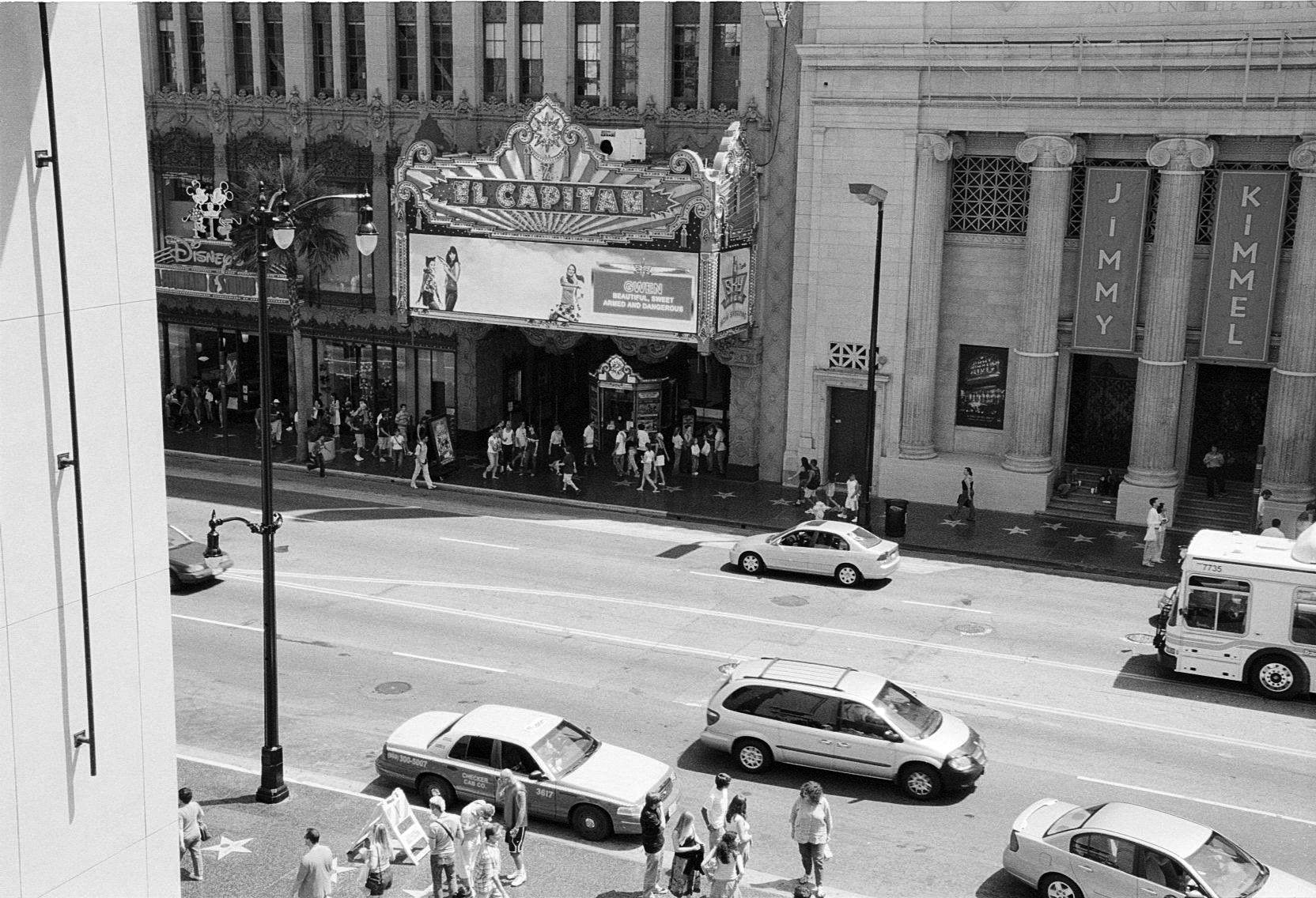 |
|
| (2005)^*^ - View showing a dual-head teardrop Genie-type streetlight on Hollywood Boulevard across the street from the El Capitain. This shot was taken from the balcony of the Hollywood & Highland Center in the middle of the conversion from the circa 1960 "5-Star" heads to the retro-twin teardrops. Photo by Glen Norman |
Historical Notes Scroll arms (sometimes called Genie arms for their passing resemblance to Aladdin's Lamp) are pretty common on the pedestrian-scaled lights that have appeared in Los Angeles over the past couple of decades. Usually, those street lights feature skirts surrounding the the globes. The Highland Special Pole does not show this feature. |
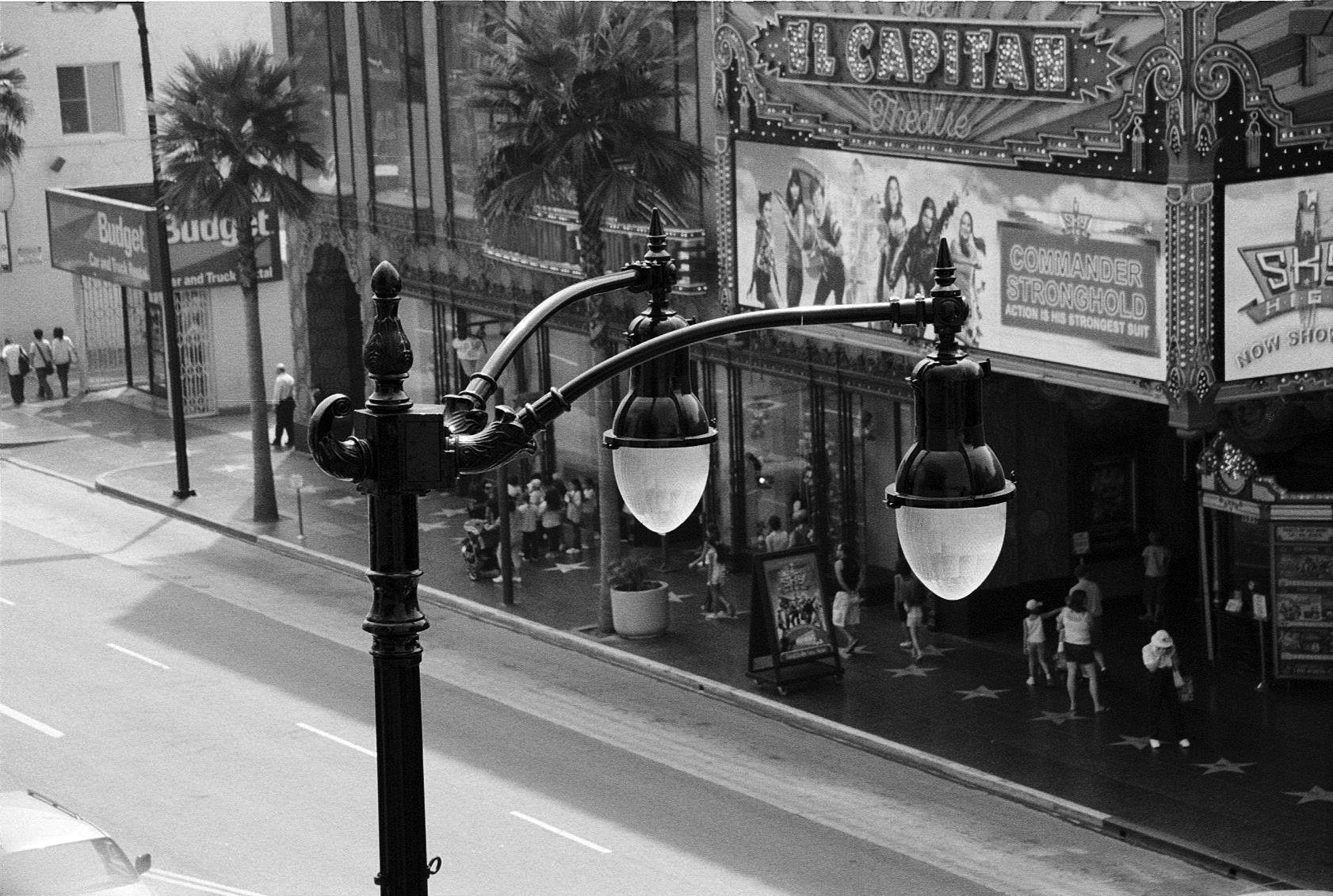 |
|
| (2005)^.^ - Close-up view showing the retro-twin teardrops Genie Lamp-like streetlights on Hollywood Boulevard. Photo by Glen Norman |
Historical Notes The twins were originally lamped with 400 Watt Metal-Halide, but were updated recently to 100 Watt LEDs. |
'Genie Lamp' Streetlights (Boyle Heights)
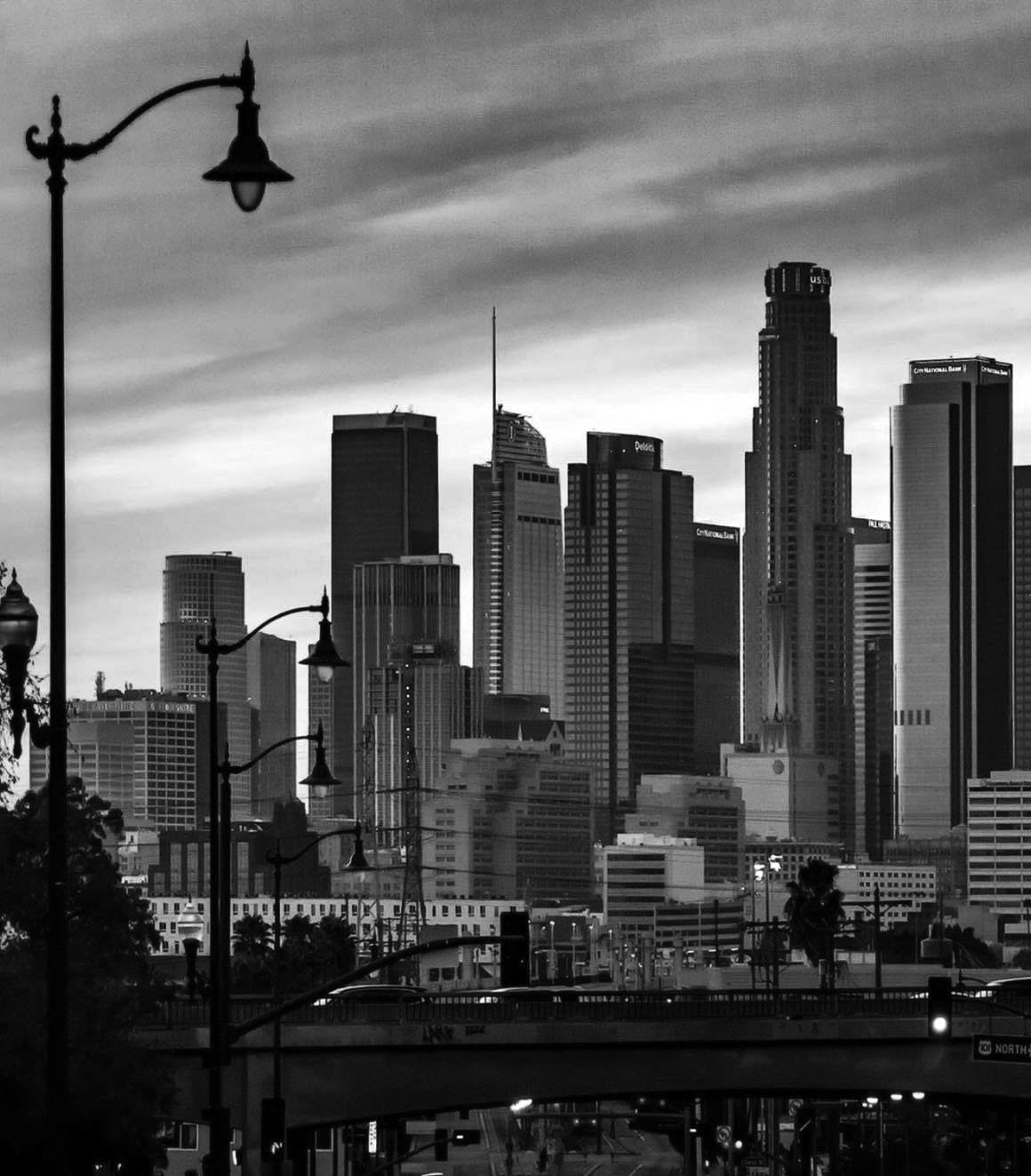 |
|
| (2020)^.^ - View looking west on 1st Street from near Boyle Avenue toward DTLA. Note the beautiful single lamp streetlights hanging from one-arm pendants which are connected to assemblies resembling a ‘genie lamp’. Also seen is the beautiful LADT Skyline. The two tallest buildings in the background are the new Wilshire Grand with its 10-story spire and the 73-story US Bank Tower. Click HERE for a Google Street View. Photo by @dannym87 / I Love Los Angeles |
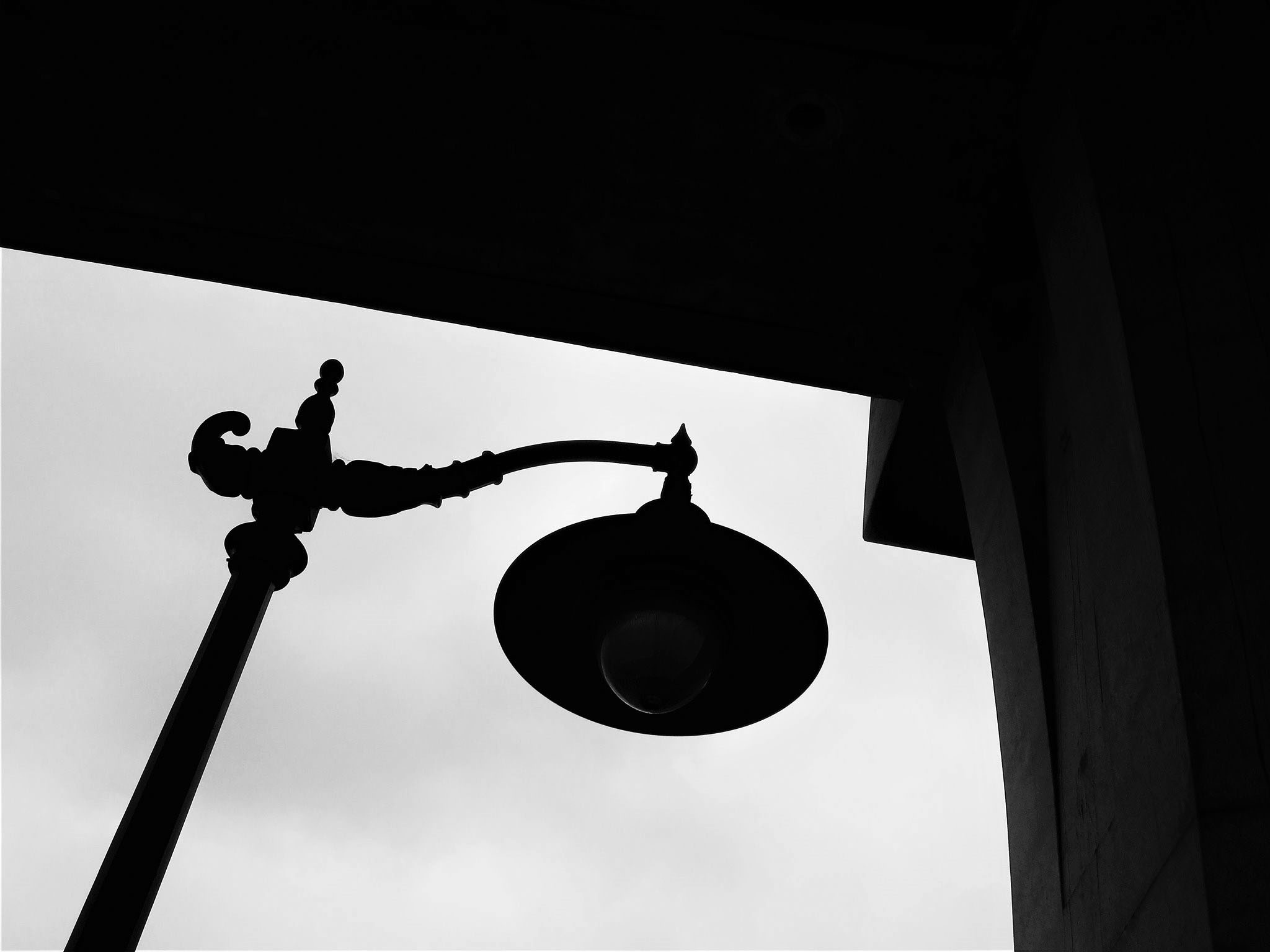 |
|
| (2020)^.^ - Looking up at a ‘Genie Lamp’ Streetlight near the 101 Freeway overpass on 1st Street. Photo by Howard Gray |
'Genie Lamp' Streetlights (DTLA)
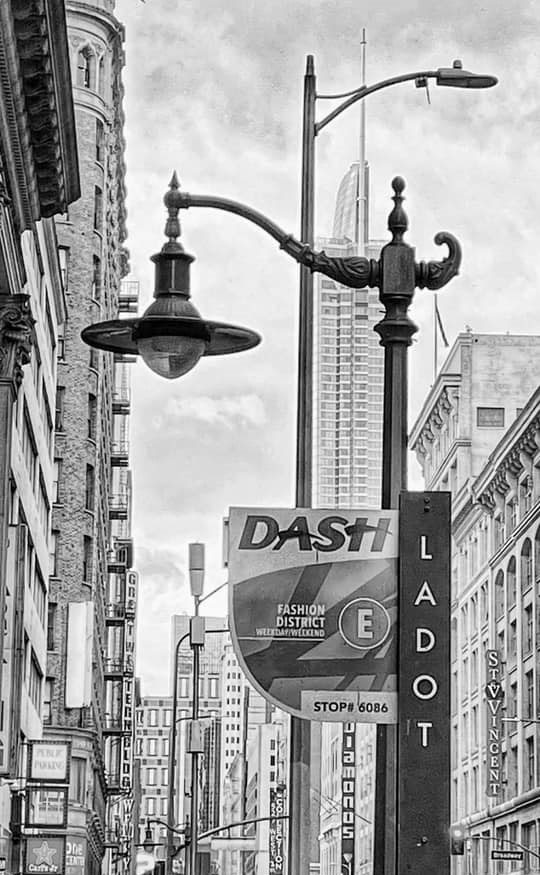 |
|
| (2021)* – View looking west on 7th Street near Broadway showing a ‘Genie Lamp’ Streetlight over a LADOT DASH Bus Stop with the more traditional Cobra Head-style LED light behind it. In the distance can be seen the Wilshire Grand Center high-rise. Photo by Carlos G. Lucero |
* * * * * |
Cobra LED Electroliers
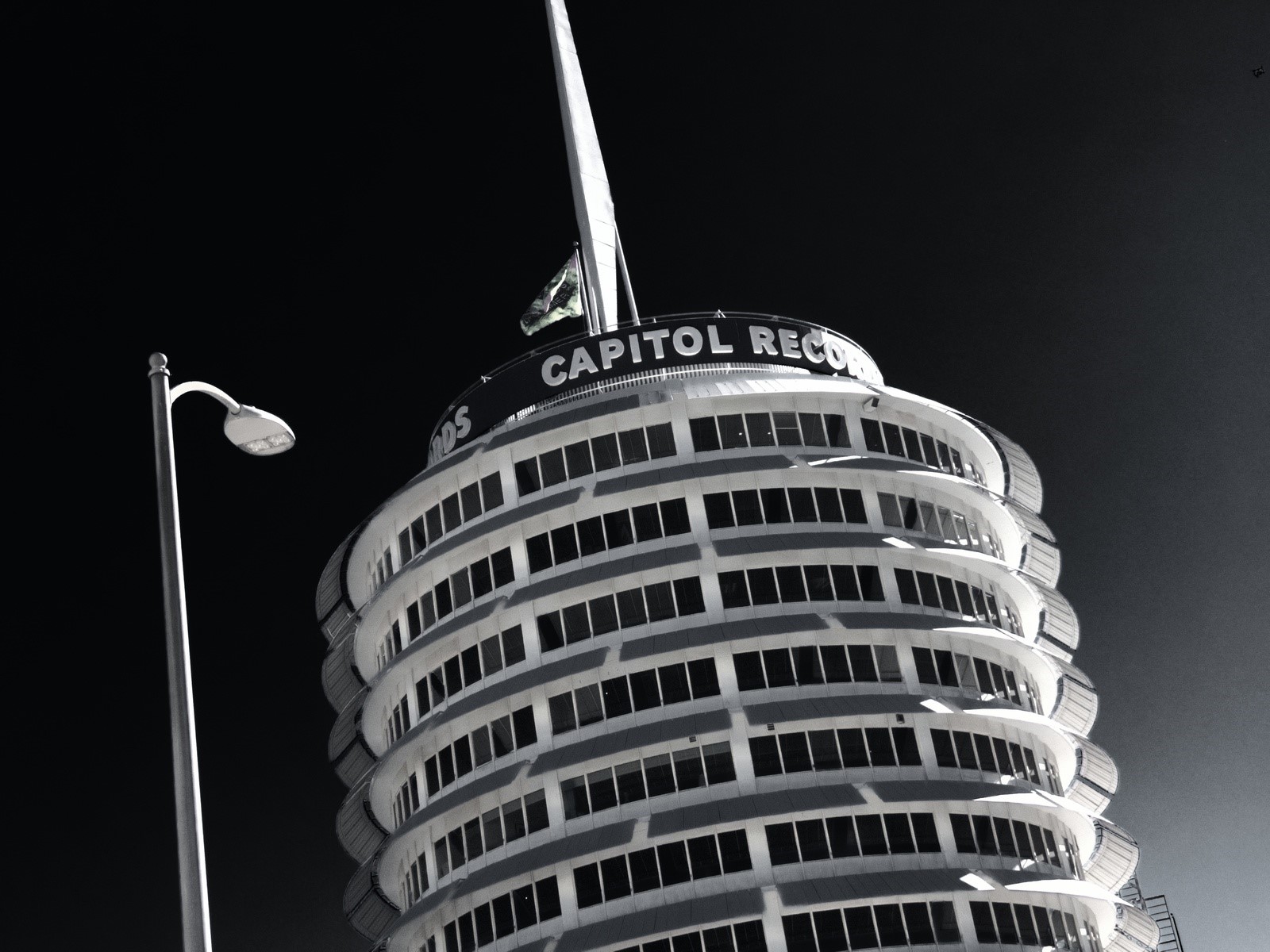 |
|
| (2019)* - A Cobra Head LED streetlight stands in front of the Capitol Records Building in Hollywood. Photo by Ted VanCleave |
Historical Notes Los Angeles has 215,000 street lights, 2nd most on any major city in the United States. Since 2009, LA started converting all of these lights to LEDs. Today, LED lights are capable of producing almost double the ratings compared to when they started. Millions of dollars have been saved by the City through this form of conservation. |
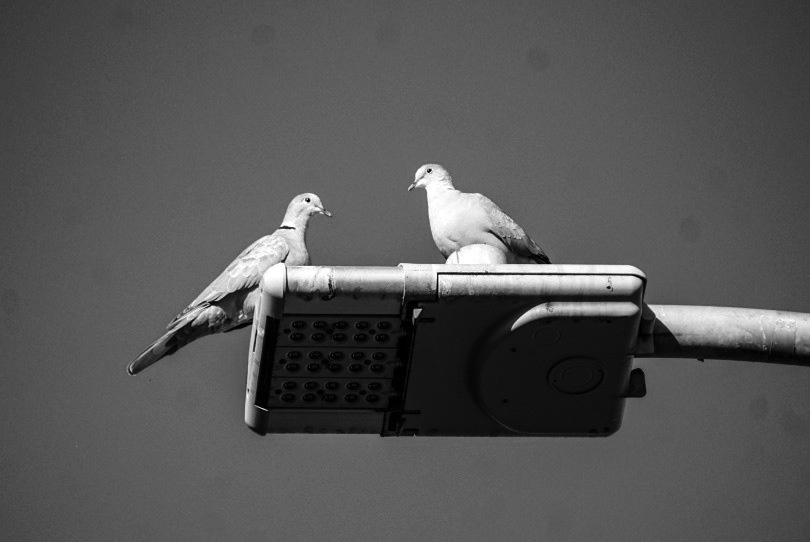 |
|
| (2020)* - Two pigeons rest atop a new Cobra LED Streetlight…the most common streetlight being installed in Los Angeles today. They come in a variety of sizes and shapes. Photo courtesy of Dionesio C Grava |
Historical Notes Today, Cobra Head LED streetlights are commonly used for street lighting applications because they are shaped in such a way that diffuses light to cover a wide patch of ground and, more importantly, they are highly energy efficient. |
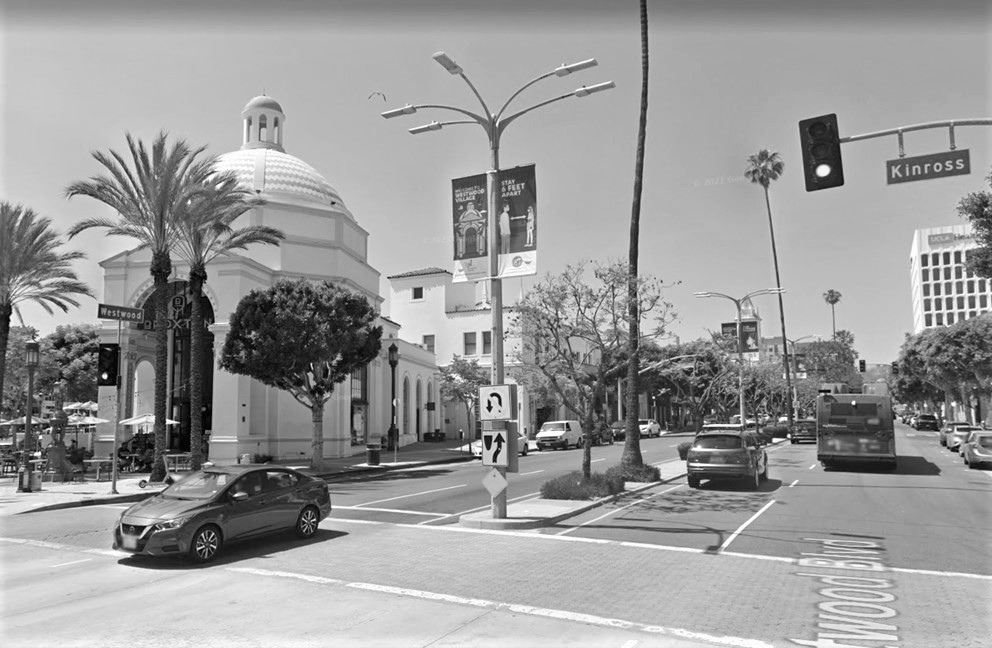 |
|
| (2021)* - Google street view showing a Five-arm Cobra LED Streetlight in front of the iconic Janss Dome Building at the corner of Westwood Boulevard and Kinross Avenue in Westwood Village. |
* * * * * |
Metropolitan LED Electroliers
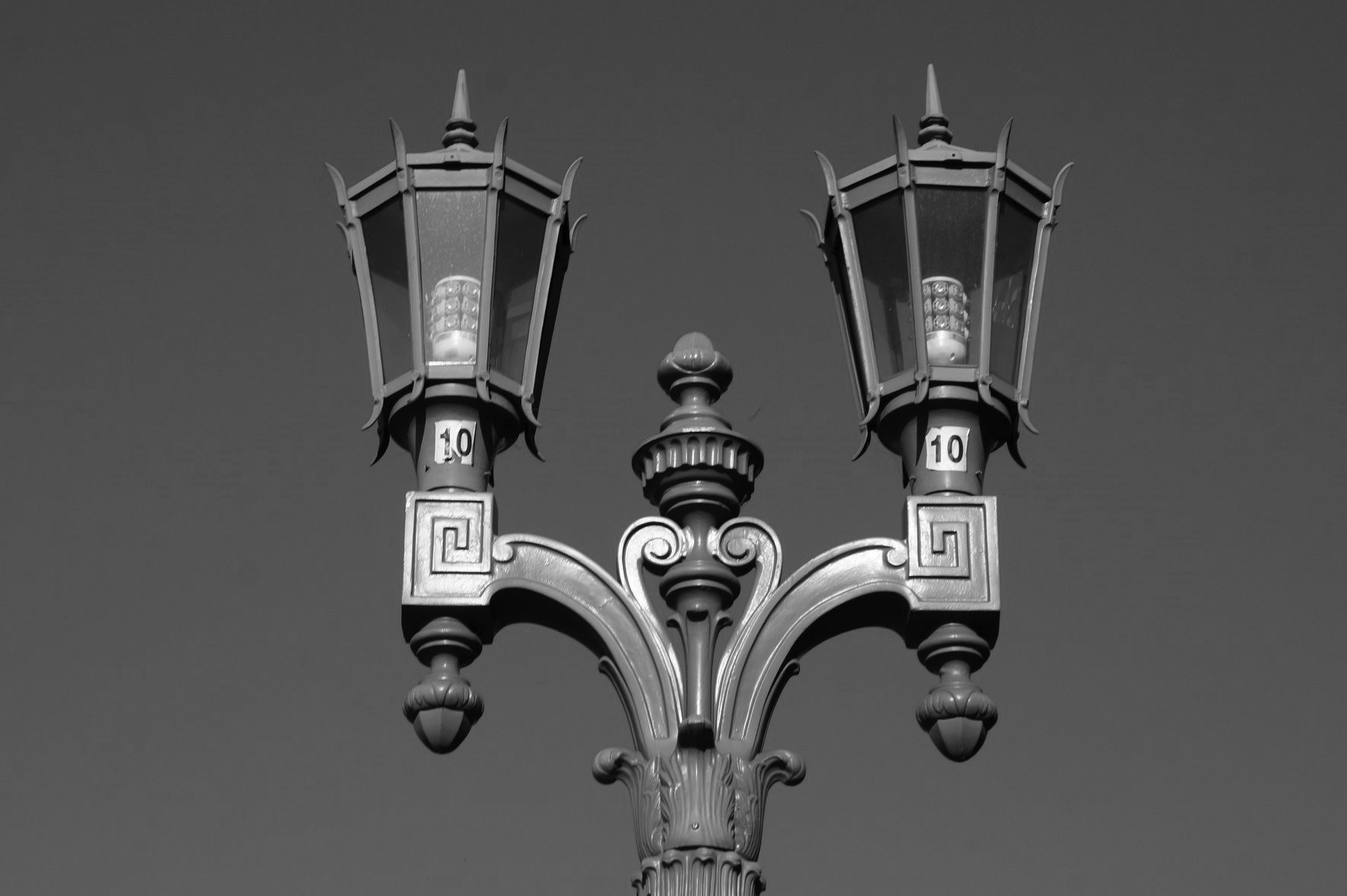 |
|
| (2020)* - View showing traditional Metropolitan Streetlight converted to utilize higher efficient LED lights. Photo by Glen Norman |
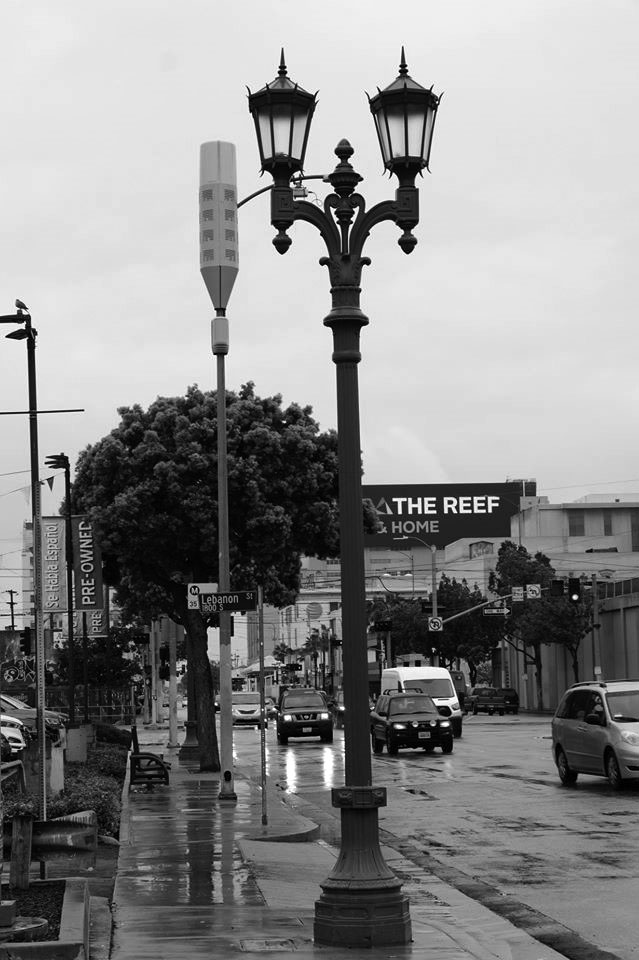 |
|
| (2020)* - View showing a Metropolitan LED electrolier located on Washington Boulevard and Lebanon Street on a rainy day. Note the unusually shaped electrolier behind it. It is actually a combination streetlight-cell tower post commonly referred to as a ‘Smartpole’. Photo by Glen Norman |
* * * * * |
Combination Streetlight - Cell Towers (Smartpoles)
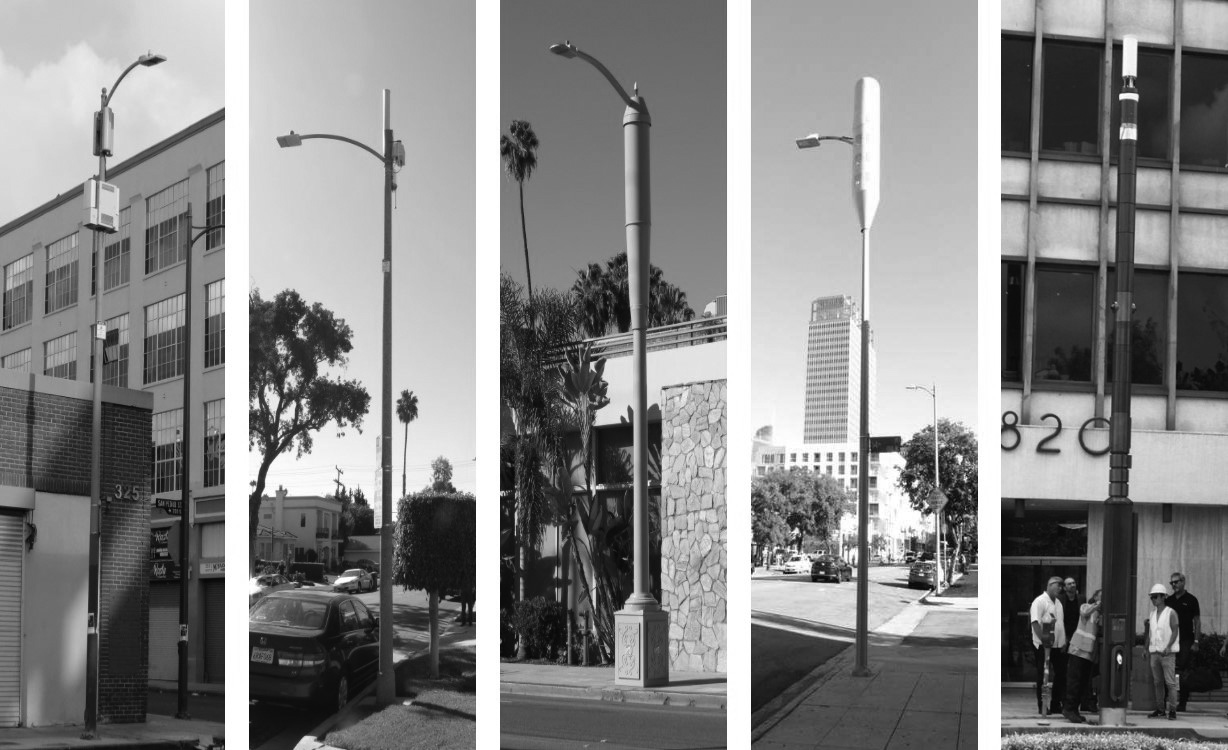 |
|
| (2019)* - Above are several designs and evolution of pole designs ('Smartpoles') which integrate streetlight and telecommunication equipment (cell sites). |
Historical Notes In 2015, the LA City Bureau of Streetlighting kicked off a program that integrates telecommunication companies’ cell sites with newly installed streetlight electroliers. The combination streetlights (called ‘Smartpoles’) have gone through several iterations of designs as can be seen in the above image. Originally installed in the Hollywood area only, they can now be found throughout the City (200-plus as of 2020). |
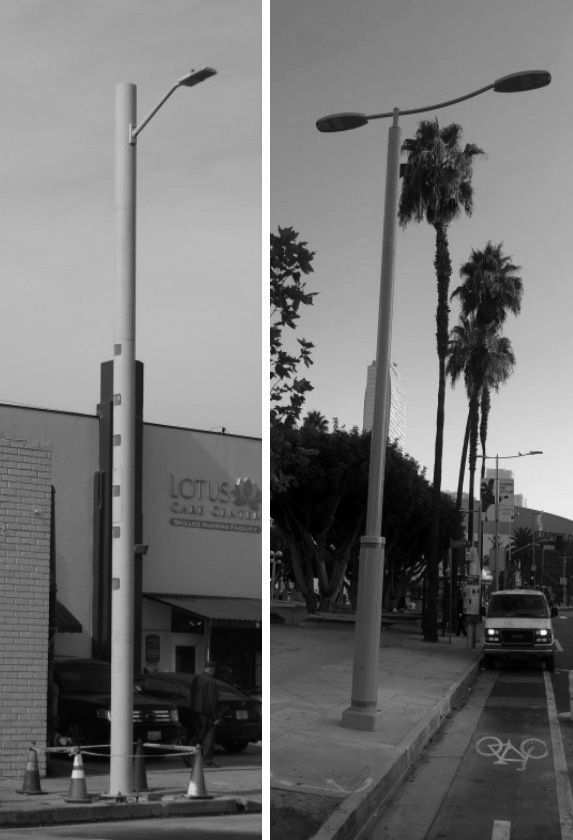 |
|
| (2020)* - Hundreds of these combination streetlight-cell tower 'Smartpoles' have been installed throughout the City. (initially in the Hollywood area). |
* * * * * |
Union Metal (UM-70149)
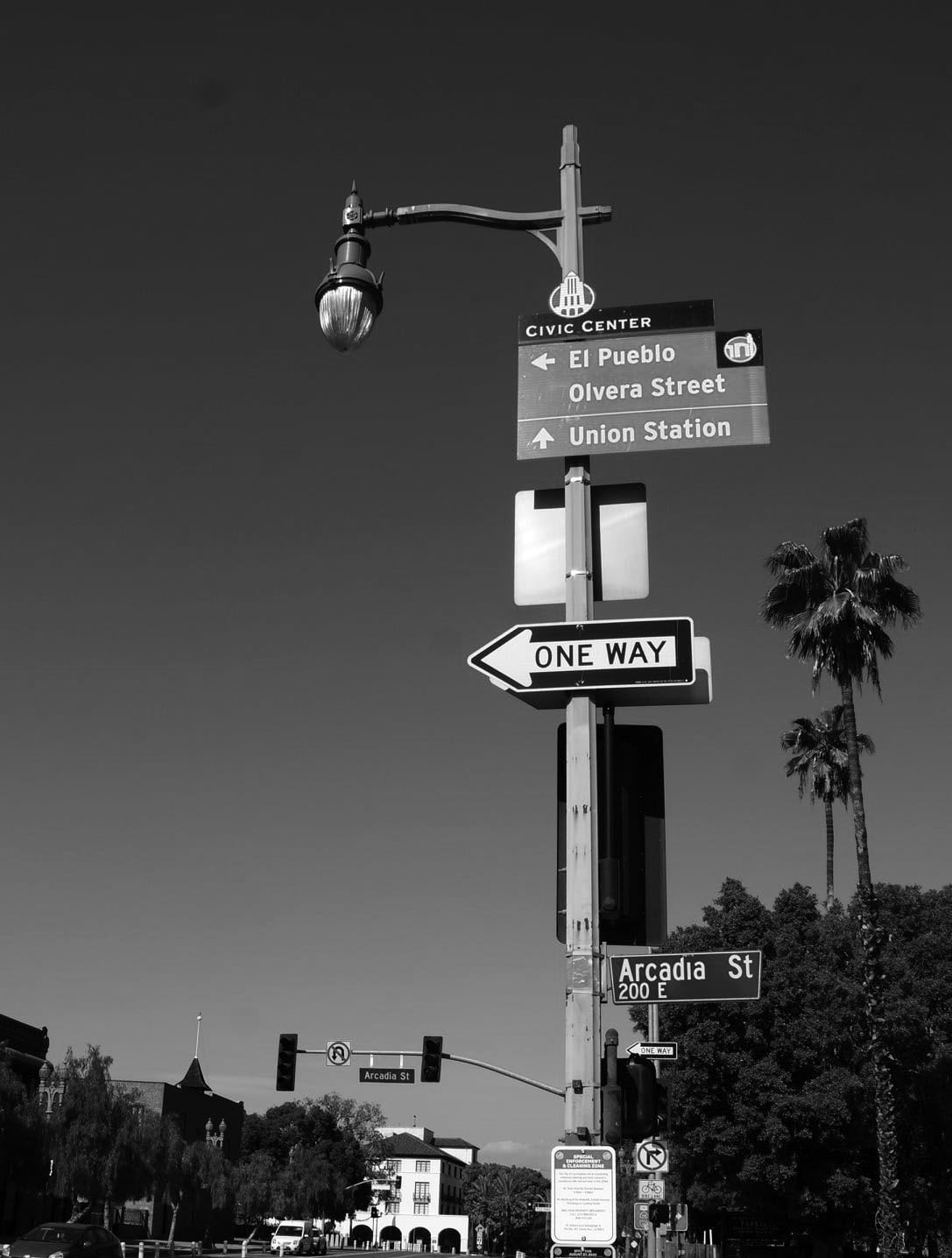 |
|
| (2021)* – View loking North on Los Angeles Street at Arcadia Street showing a Union Metal (UM-70149) streetlight with side-mounted teardrop fixture. The Old Plaza, the birthplace of Los Angeles, is off to the left. Photo by Glen Norman |
Historical Notes The Union Metal (UM-70149) streetlight dates back to the early 1950s. |
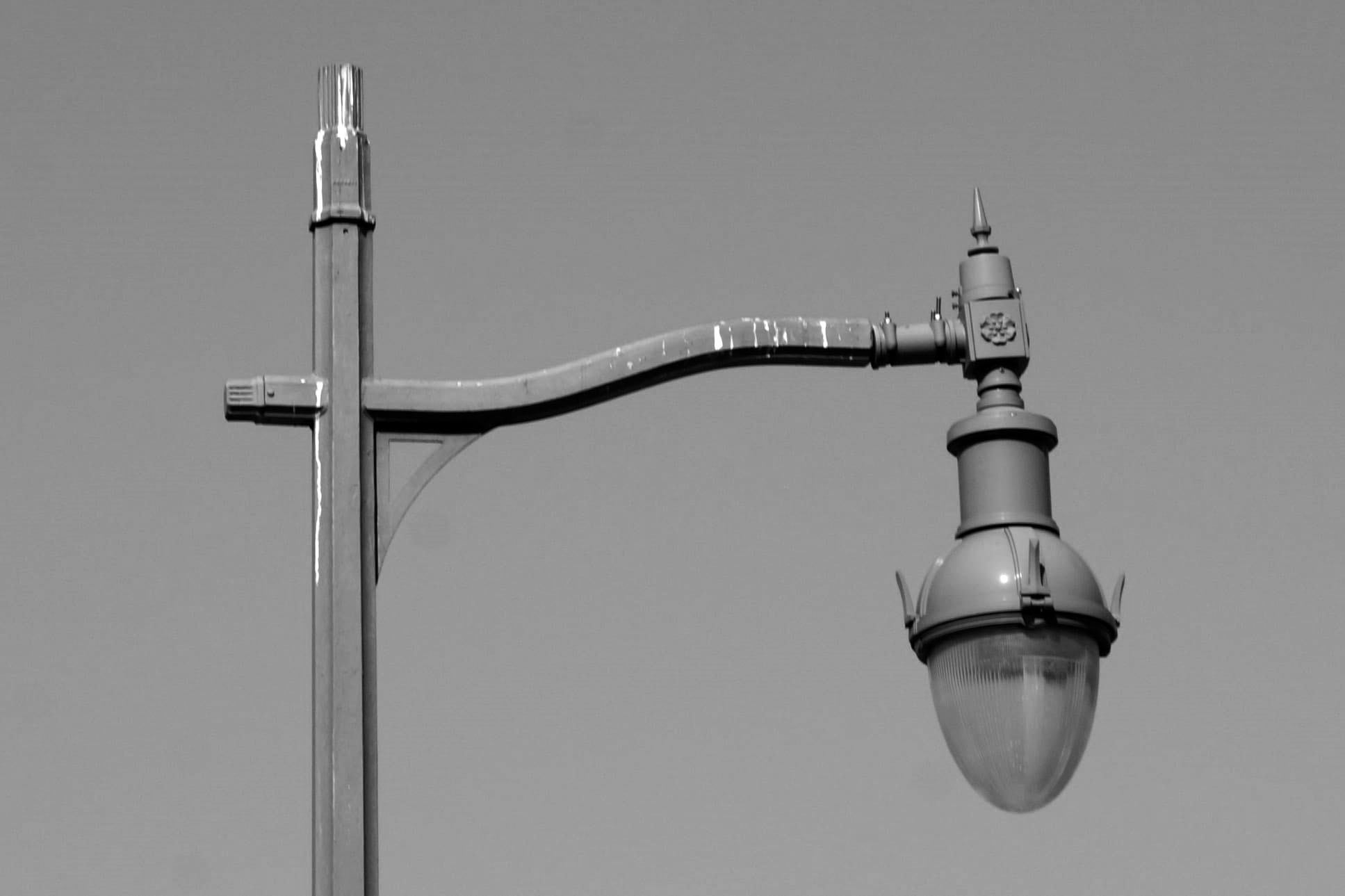 |
|
| (2021)* – Close-up view showing the side-mounted teardrop fixture (Lumec RN 20 luminaire) on the UM-70149 streetlight. Photo by Glen Norman |
Historical Notes The Lumec RN 20 luminaire would have replaced a Mercury or HPS cobra. But, that cobra in turn had replaced what looks to be the original side-mounted teardrop fixture. Note the typical "L.A." finial; we also see it on the CD 929 and CD 923 street lights among others. |
* * * * * |
Sternberg “Richmond” Streetlight
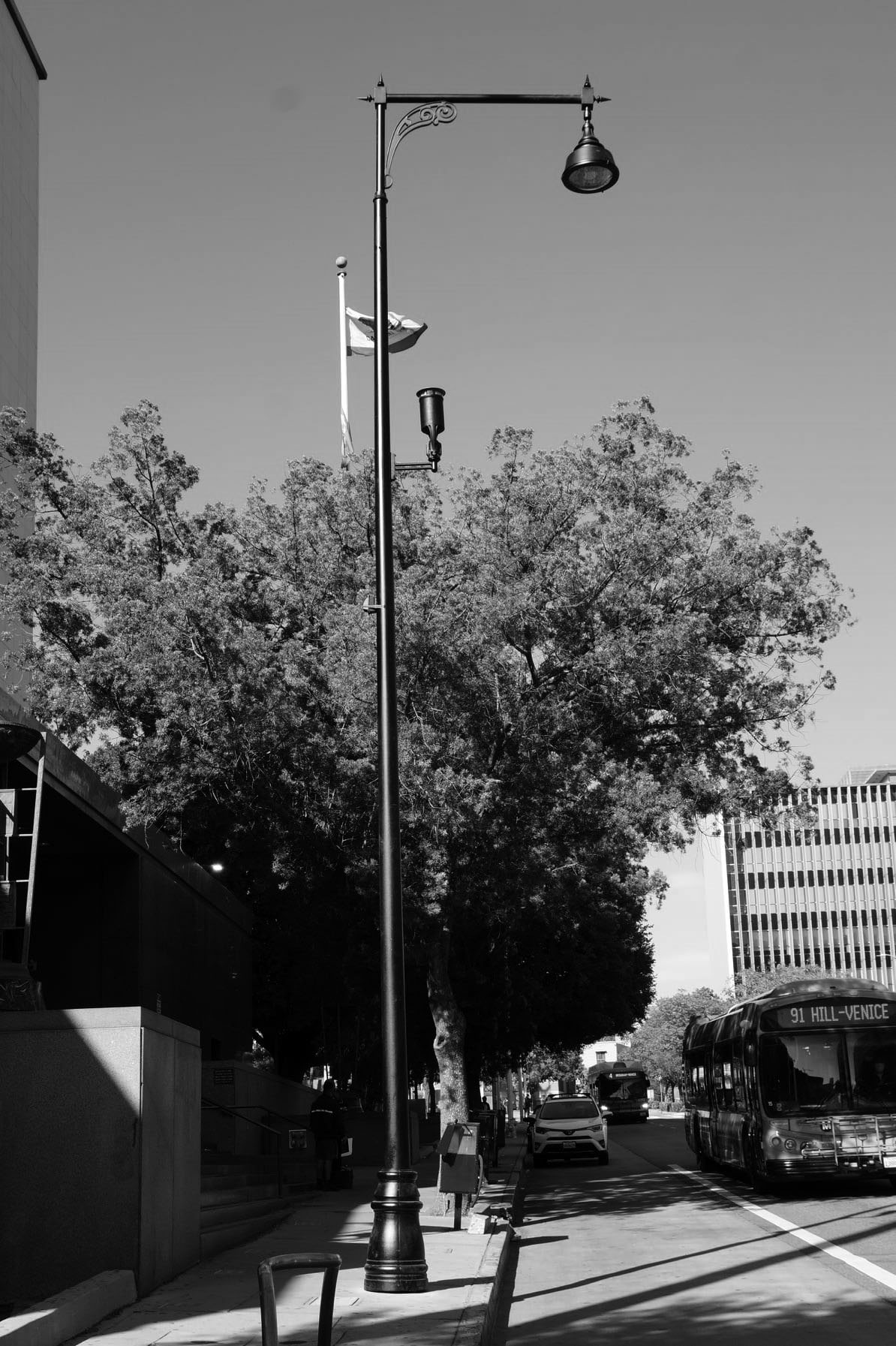 |
|
| (2021)* - View looking North on Hill Street, just North of West 1st Street showing a Sternberg “Richmond” streetlight next to the L.A. County Courthouse. Photo by Glen Norman |
Historical Notes "So why is this here? This was the only one around. It's definitely NOT the winner nor any of the entries in the recent "L.A. Lights the Way" competition. It also does not appear on any of the LABSL maps. Maybe erected for a movie or TV shoot, given the Courthouse background? And what's with that little upward pointing thing about 3/4 of the way up the pole? It's too high to benefit the sidewalk and is pointed in the wrong direction." –Glen Norman |
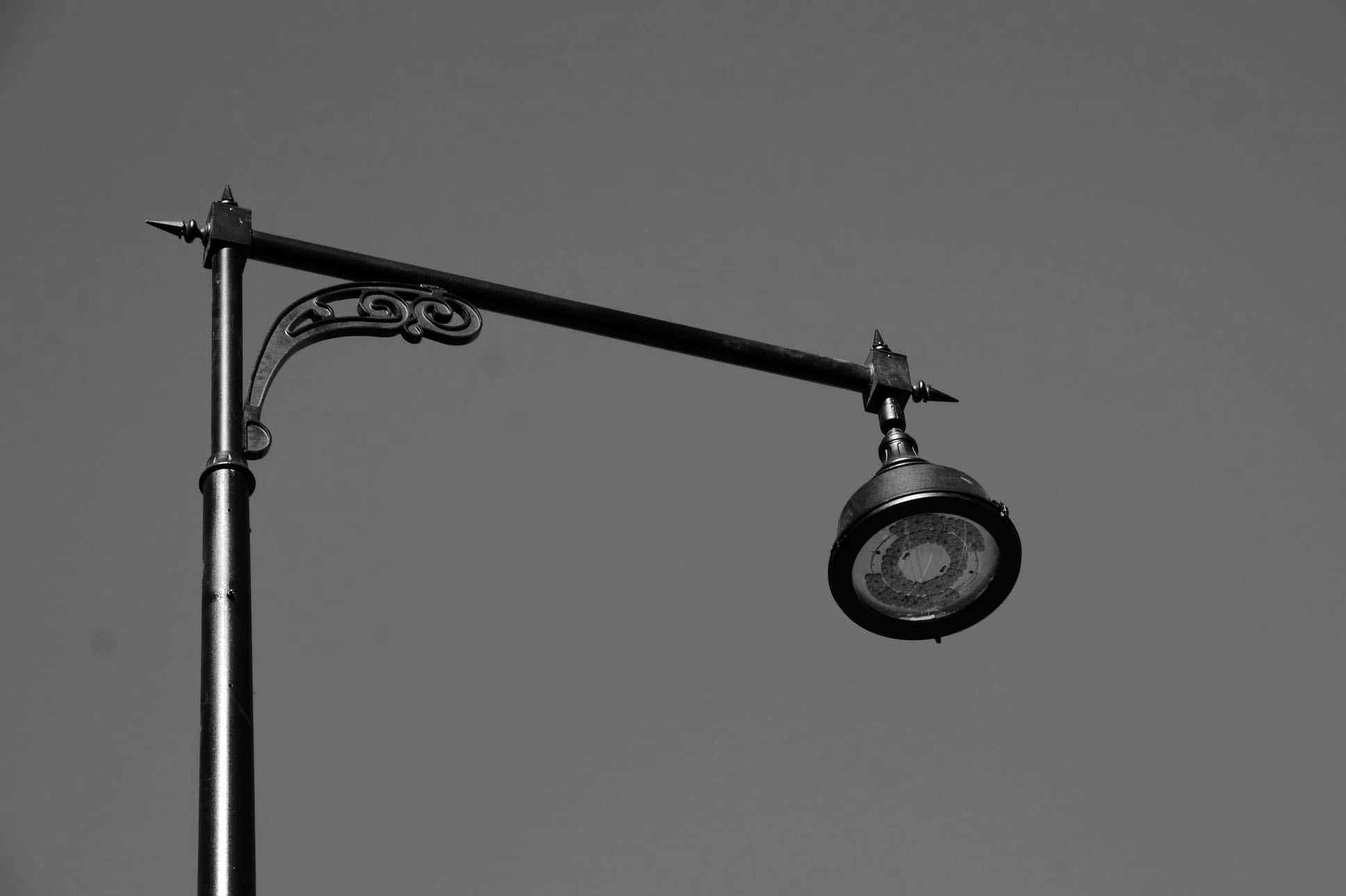 |
|
| (2021)* - Close-up view of the Sternberg “Richmond” streetlight with teardrop LED fixture resembling a shower head. Photo by Glen Norman |
* * * * * |
First Street-Beverly Boulevard Viaduct (aka Beverly Bridge)
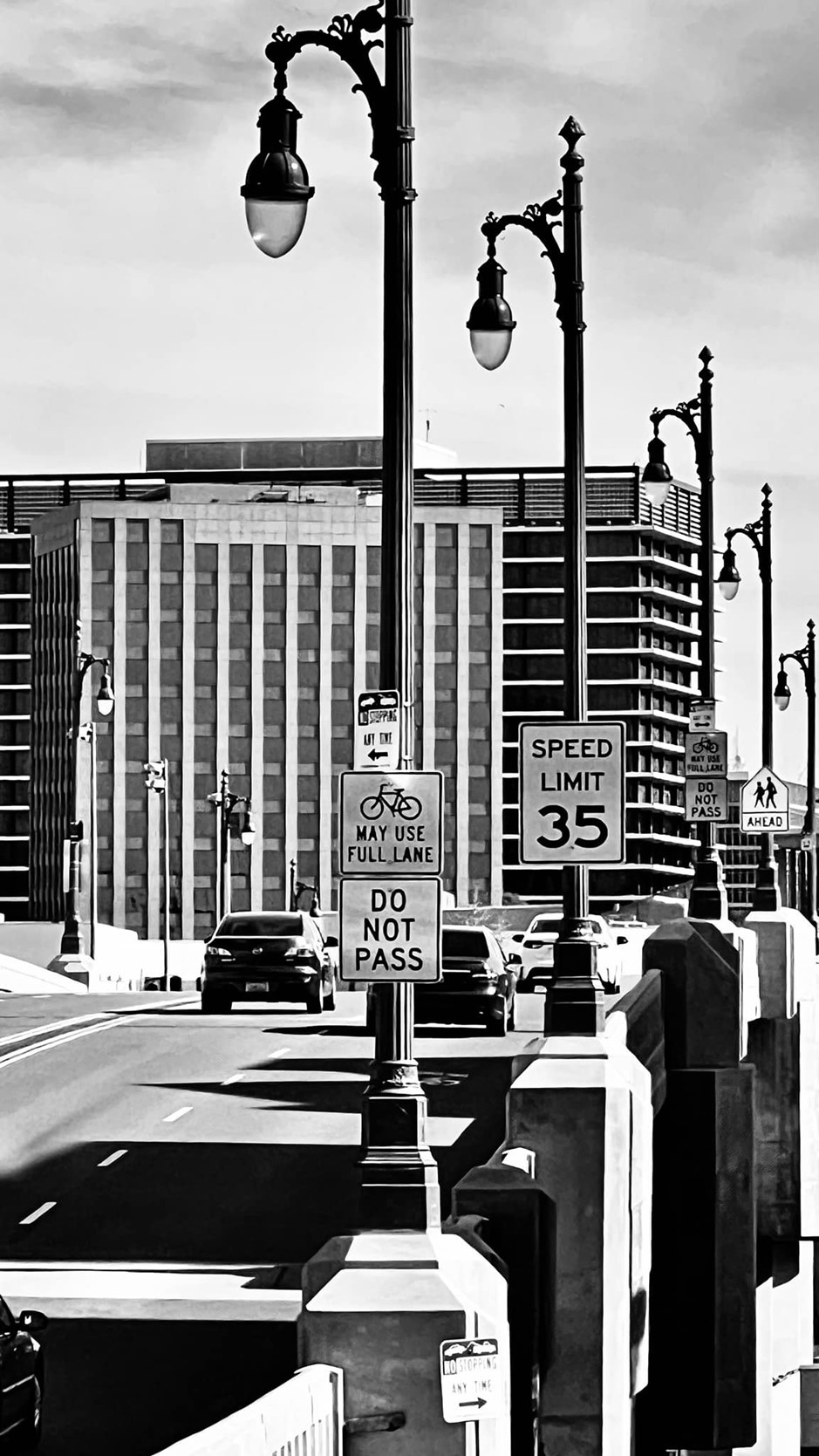 |
|
| (2023)* - View looking east toward the LADWP John Ferraro Building from the First Street-Beverly Boulevard Viaduct showing newly installed ornamental teardrop electroliers, fluted standards with pendant luminaires, lining both sides of the bridge. Photo by Carlos G. Lucero. |
Historical Notes The First Street–Beverly Boulevard Viaduct, completed in 1942, is a reinforced-concrete bridge spanning Glendale Boulevard and linking First Street with Beverly Boulevard. At its opening, the viaduct featured ornamental fluted light poles with pendant luminaires, part of a citywide program to beautify Los Angeles bridges. Over time, these were removed and replaced by plain utilitarian fixtures. In 2023, the city restored the viaduct’s historic character by installing new teardrop electroliers, recreating the 1940s look while using modern LED technology. |
 |
|
| (2025)* – View looking south from Glendale Boulevard toward the First Street-Beverly Boulevard Viaduct showing an ornamental teardrop electrolier, a fluted standard with curved arm and pendant luminaire, in the foreground with the U.S. Bank Tower in the background. Photo by Carlos G. Lucero. |
Historical Notes The ornamental teardrop electrolier seen in the foreground is part of the city’s Historic Streetlight Preservation Program. These reproductions were designed to match the viaduct’s original 1942 lighting standards while accommodating modern electrical systems. The First Street–Beverly Boulevard Viaduct is now one of the few Los Angeles bridges where drivers and pedestrians can still experience the kind of ornamental bridge lighting that once defined much of the city’s infrastructure. Click HERE to see more on the First Street-Beverly Boulevard Viaduct. |
* * * * * |
Broadway Rose
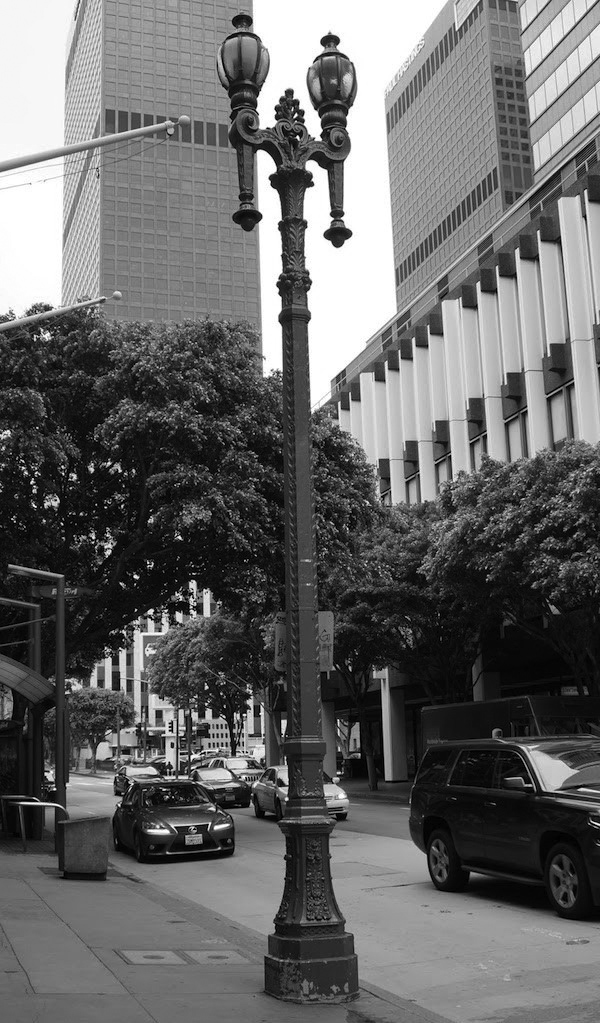 |
|
| (2017)* - The Broadway Rose in the wild, Downtown L.A. Photo: Glen Norman |
Historical Notes Marked by three ornate ribbons of roses climbing up their safts, the eponymous Broadway Roses, designed by a General Electric engineer and originally installed in 1919, used to extend from Aliso Street to Pico Boulevard. Given that Broadway was the first L.A. street to have ornamental lights, hailed in the papers as “the radiant way,” this lamp’s lavish design should come as no surprise. (In fact, the Roses originally shared Broadway with an even grander, more filigreed type of post—the Spanish Renaissance-inspired Broadway Special, designed by the same engineer.) The response was overwhelming: “This is one of the most elaborate jobs of ornamental electroliers ever made on the coast,” the Los Angeles Times observed, “and is a 100 percent home product.” Unfortunately, the excitement didn’t last. During the 1950s, the shafts and luminaires of the Broadway Roses were replaced with more functional, higher intensity, yet decidedly more somber CD-913 overheads, leaving only the original bases intact. Today there are only a handful of complete models remaining in Los Angeles, which can be found running down Sixth Street between Olvie and Flower Streets. The Broadway Specials, incidentally, have vanished altogether. |
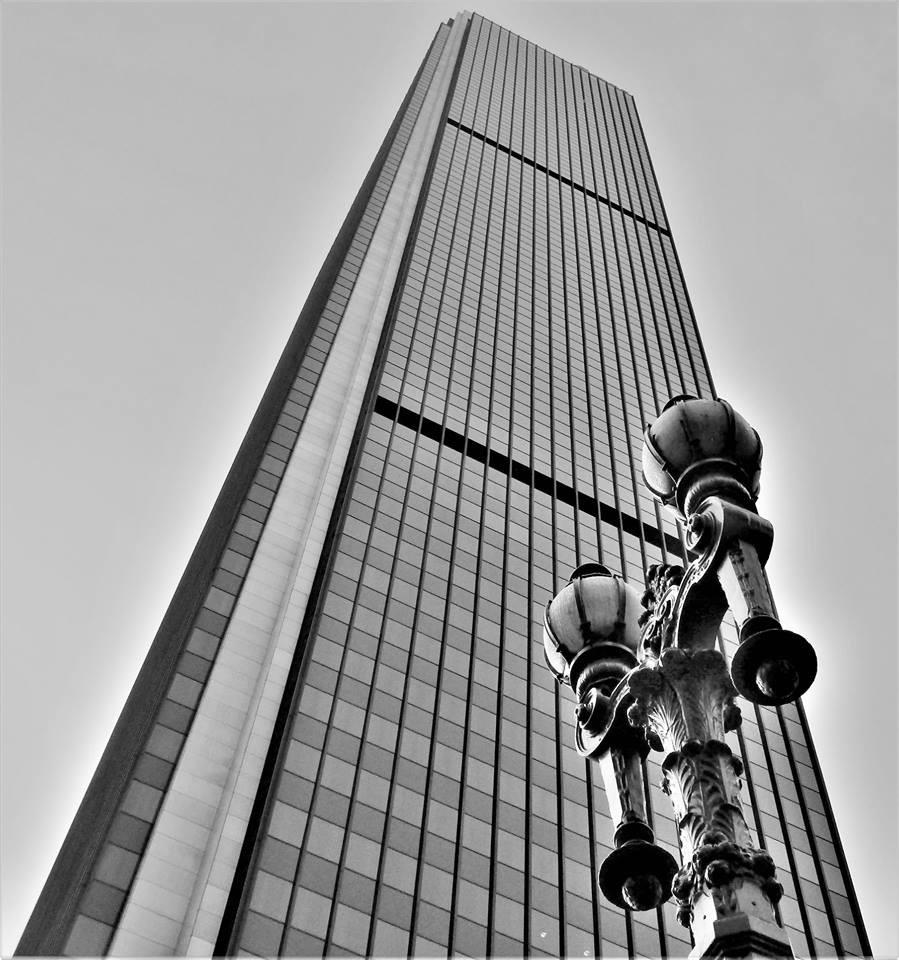 |
|
| (2018)* – View looking up at the ornate dual lamp Broadway Rose with the 1973-built, 860-foot tall Aon Building behind it. |
* * * * * |
UM-1906 (Contemporary Views)
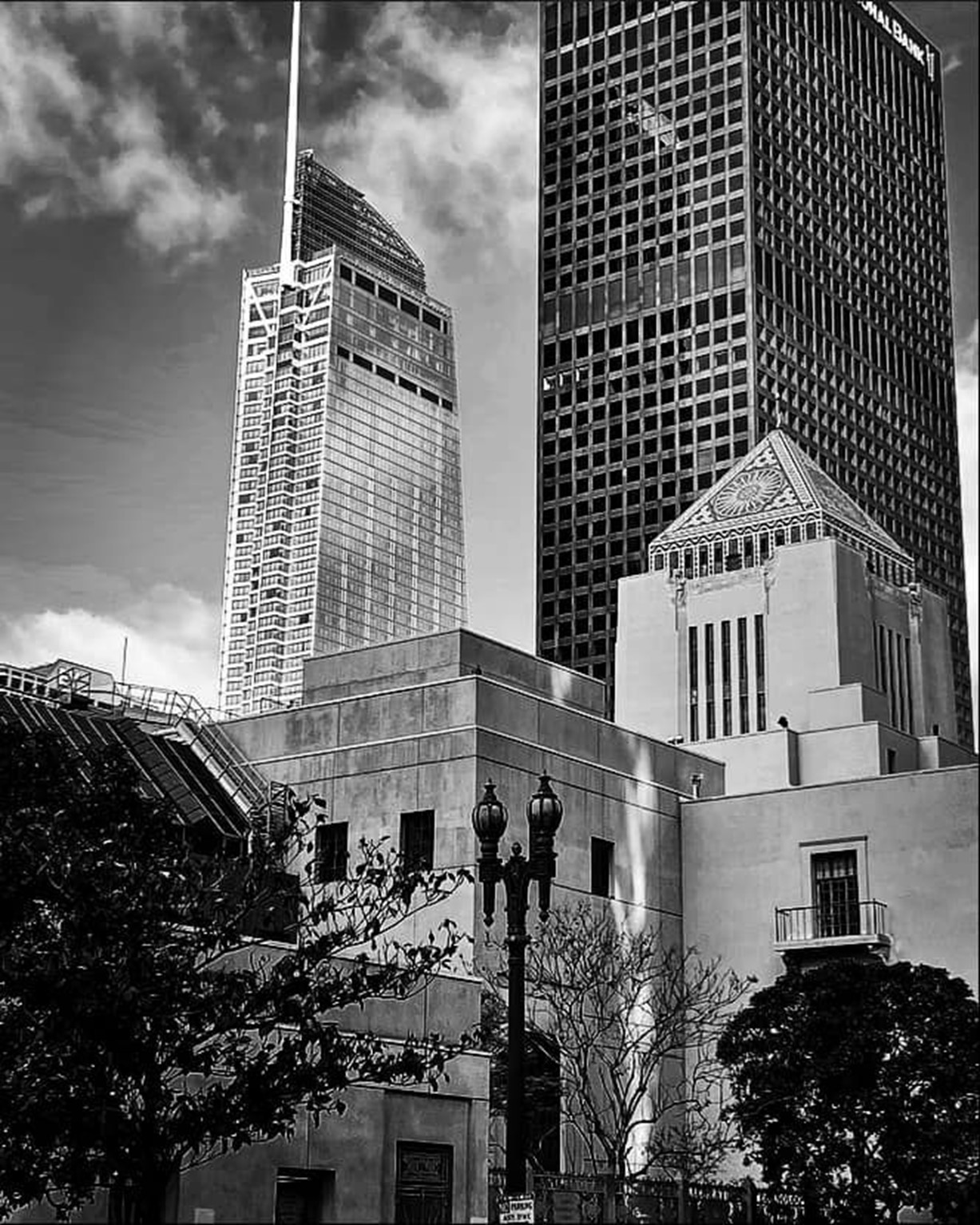 |
|
| (2022)* – An ornate dual-lamp UM (Union Metal) 1906 electrolier stands in front of the Los Angeles Central Library with the Wilshire Grand Center and City National Bank buildings seen in the background. View is looking SW from 5th Street. Photo by Carlos G. Lucero |
Historical Notes These dual-lamp electroliers (UM-1906's) were originally installed in the mid 1920’s. They were manufactured by the Union Metal Company of Canton, Ohio. The Bureau of Street Lighting still uses these UM-1906's in select areas of Downtown Los Angeles. |
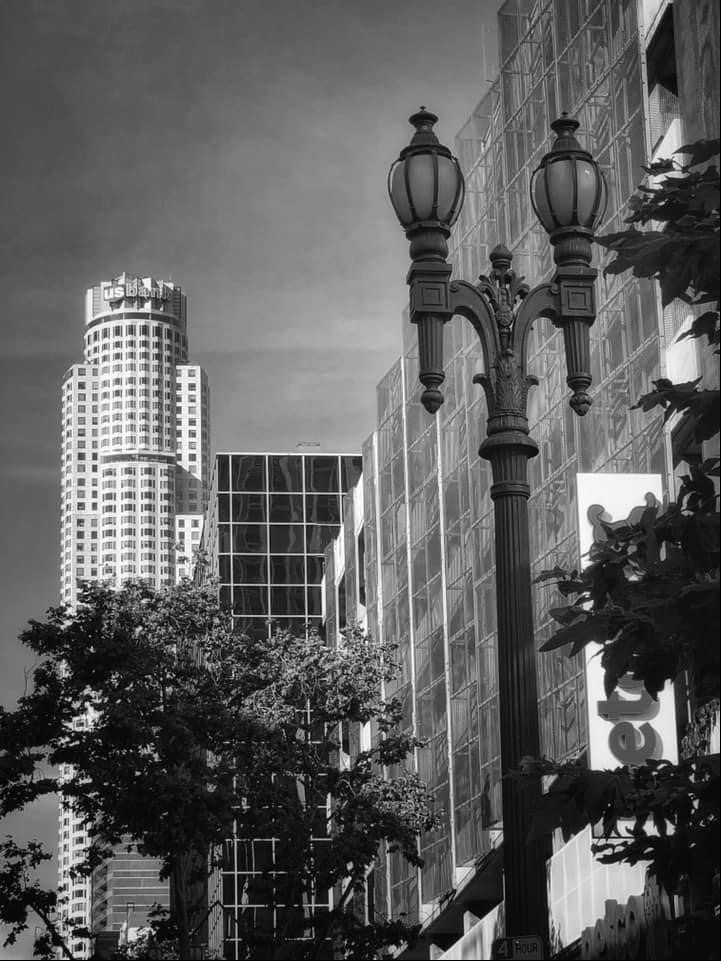 |
|
| (2020)* – View looking down Hope Street at the U.S. Bank Building with a beautiful dual-lamp UM (Union Metal) 1906 electrolier seen in the foreground. Photo by Carlos G. Lucero |
Historical Notes Although similar in many ways, the dual-lamp UM-1906 should not be confused with the Broadway Rose and Broadway Special. Click HERE to see the differences. |
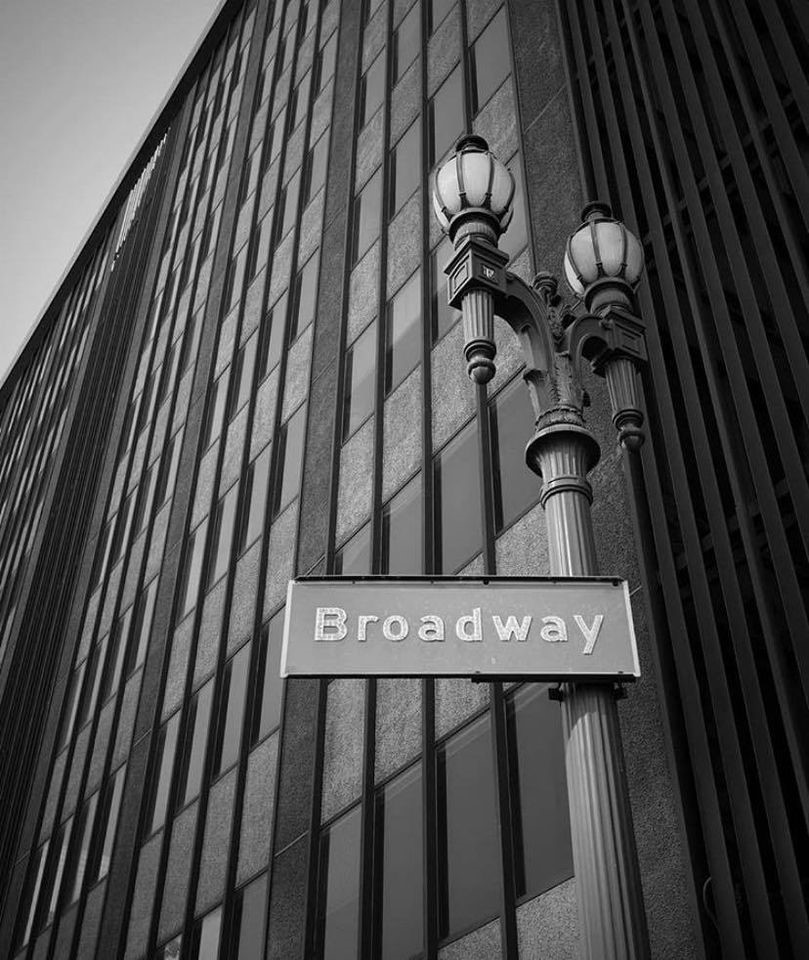 |
|
| (2020)* - Dual-lamp UM-1906 electrolier located on Broadway in Downtown L.A. Photo courtesy of Historic Core |
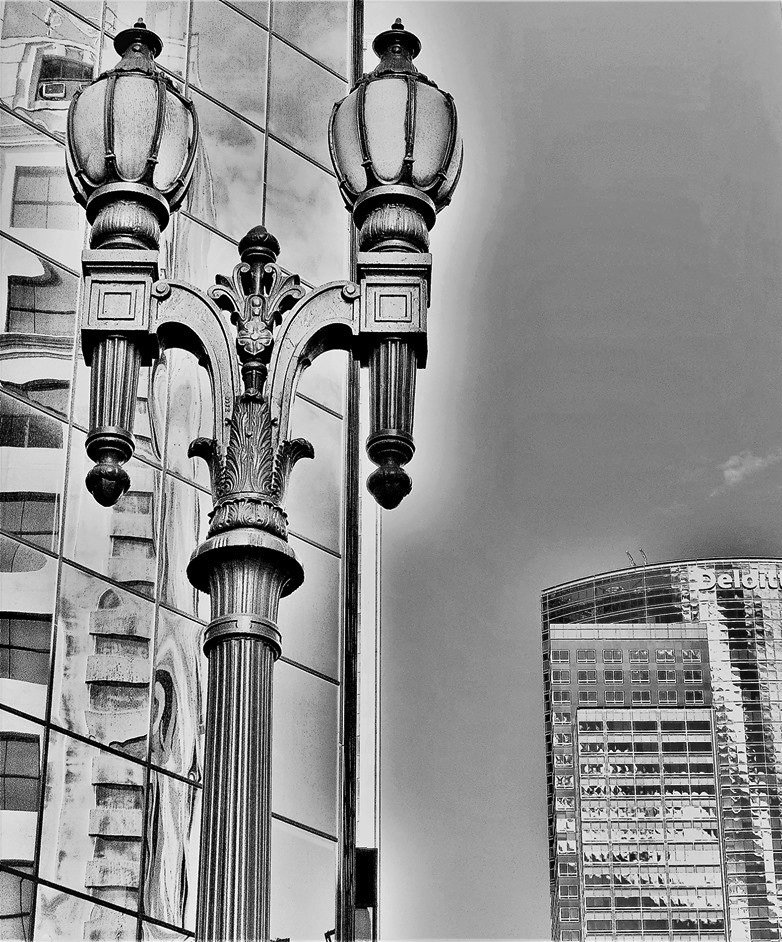 |
|
| (2019)* – Dual-lamp UM-1906 electrolier at 7th and Grand in Downtown L.A. Photo by Howard Gray |
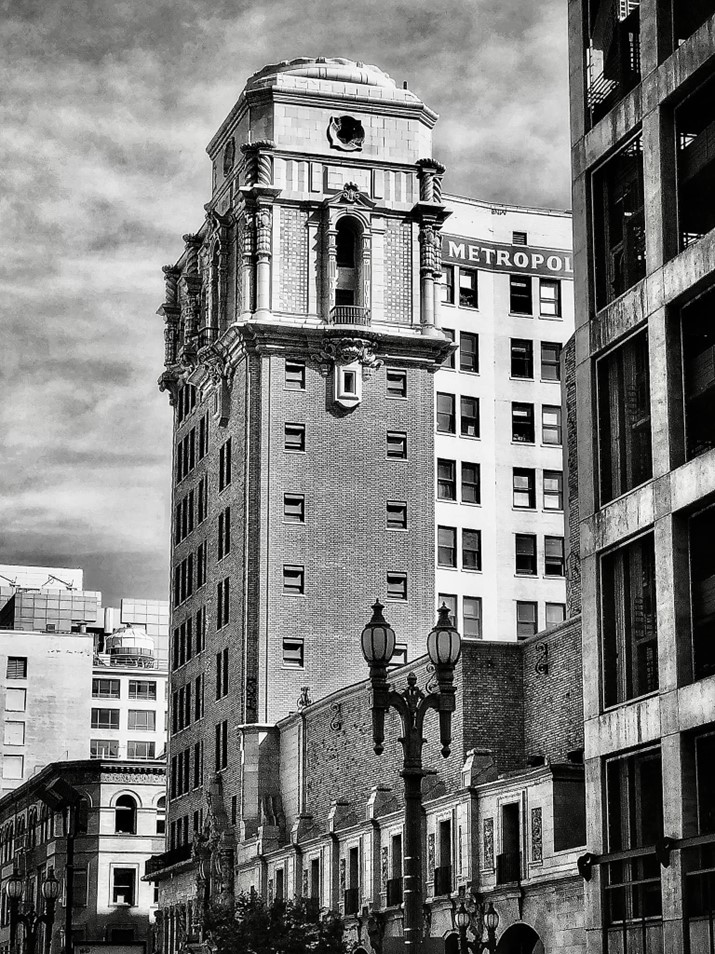 |
|
| (2022)* - A dual-lamp UM-1906 stands on 3rd Street in front of the Million Dollar Theater (aka Grauman's Theatre, aka Edison Building and later MWD Building), Located on the SW corner of Broadway and 3rd Street. Photo by Carlos G. Lucero |
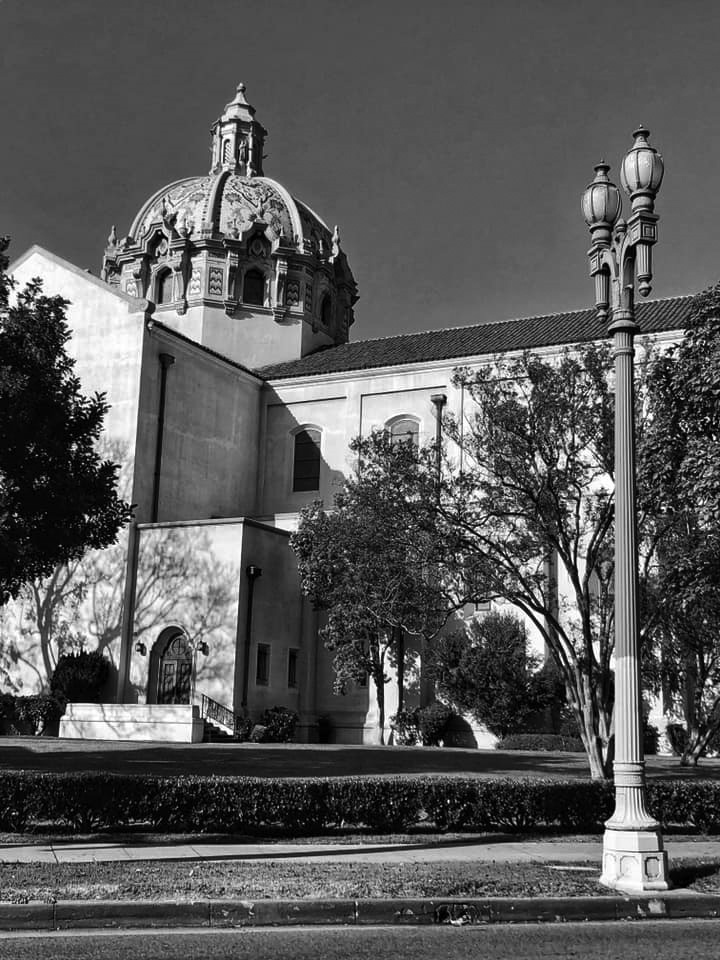 |
|
| (2020)* - A UM-1906 standing tall near the intersection of Figueroa and Adams in front of the St. Vincent Catholic Church. Photo by Carlos G. Lucero |
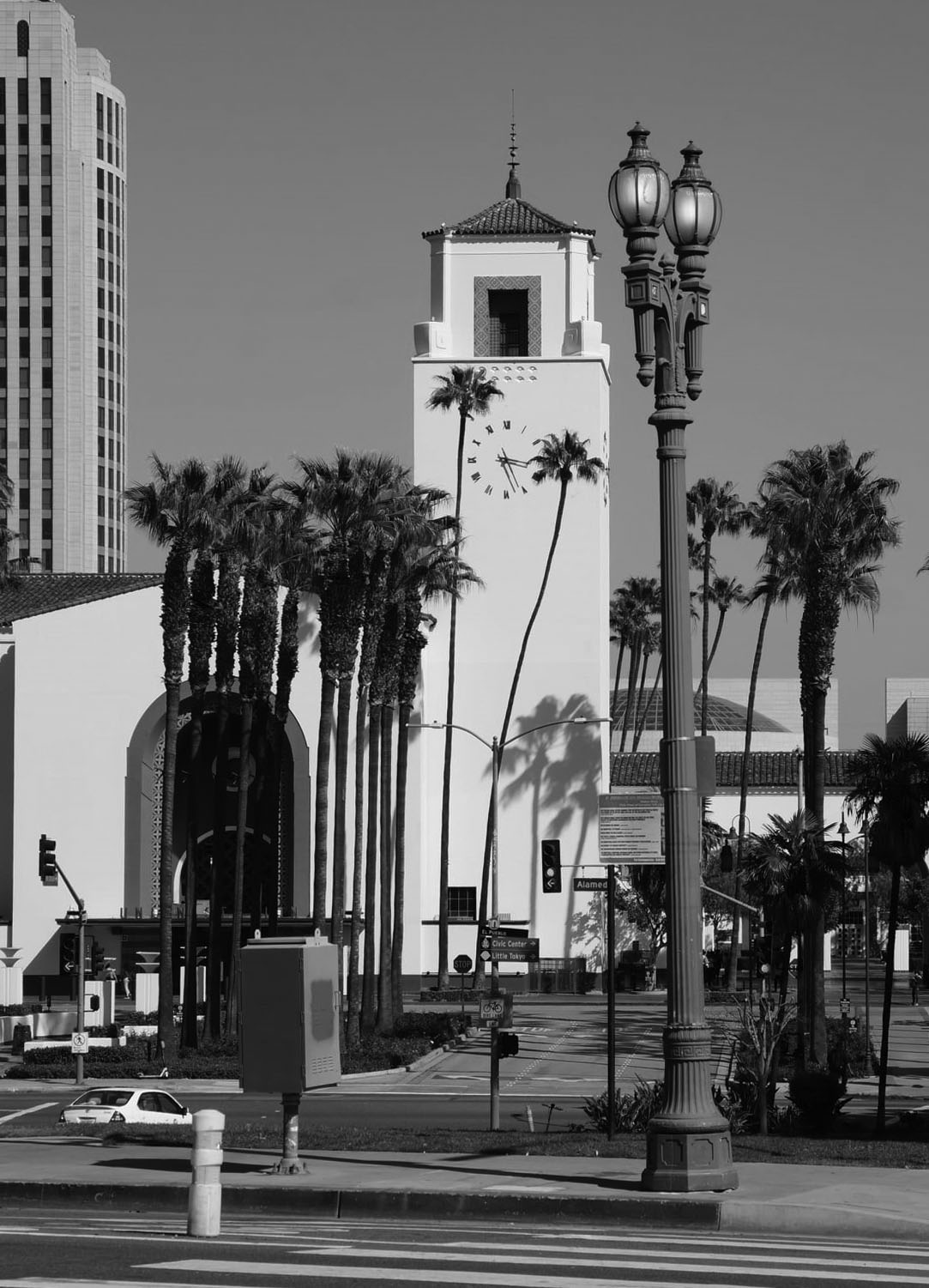 |
|
| (2021)* – Palm Trees, the Art Deco/Spanish Revival Union Station, and a UM-1906 streetlight. Photo by Glen Norman |
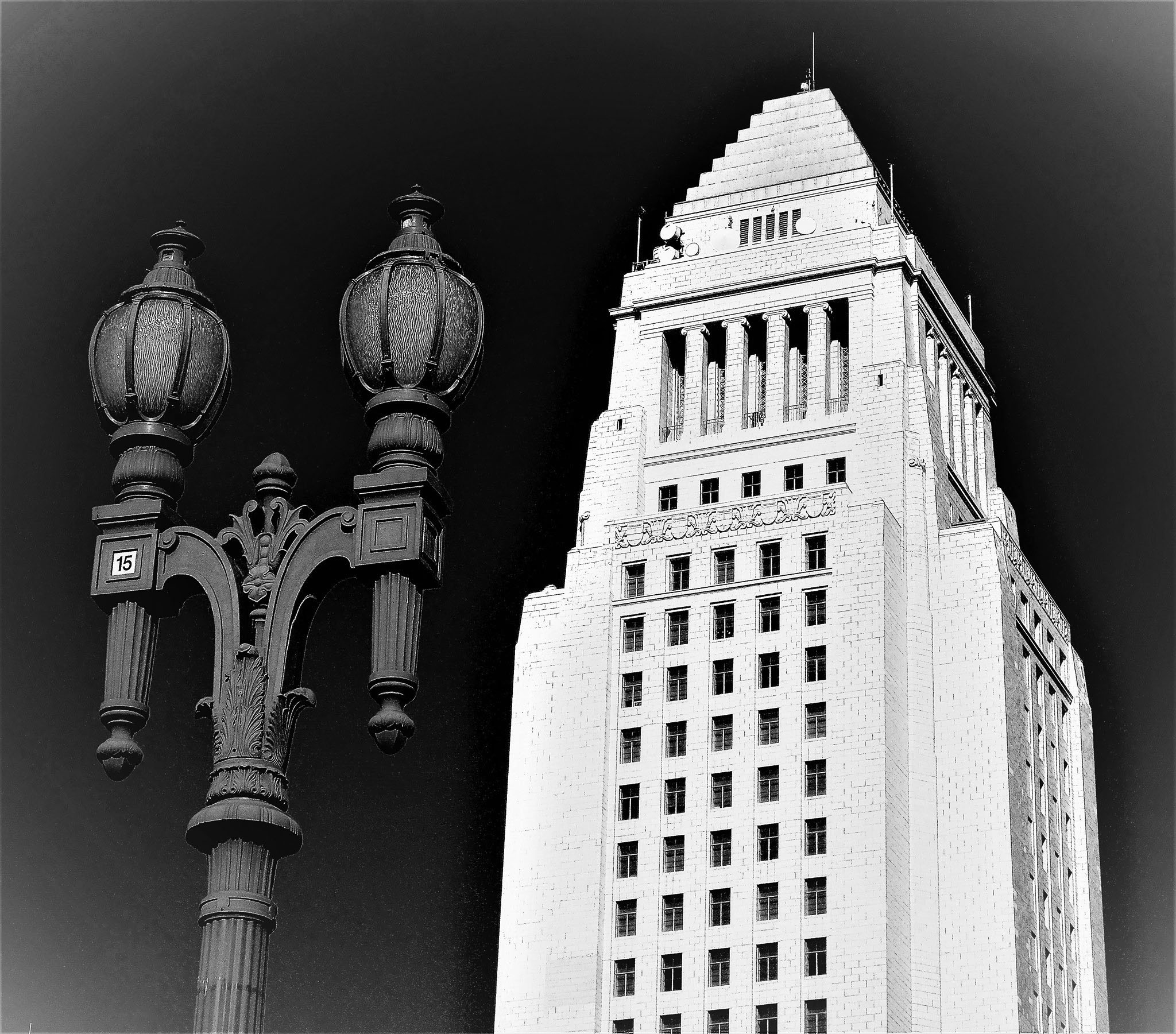 |
|
| (2020)* – Looking up at a dual-lamp UM-1906 streetlight on Main Street with City Hall in the background. Photo by Howard Gray |
Historical Notes Although there are a limited number of these Union Metal Electroliers still standing today (mostly refurbished), hundreds were originally installed in the mid 1920's. They replaced the popular five-globe Llewellyn streetlights mainly in Downtown Los Angeles. Click HERE to see more. |
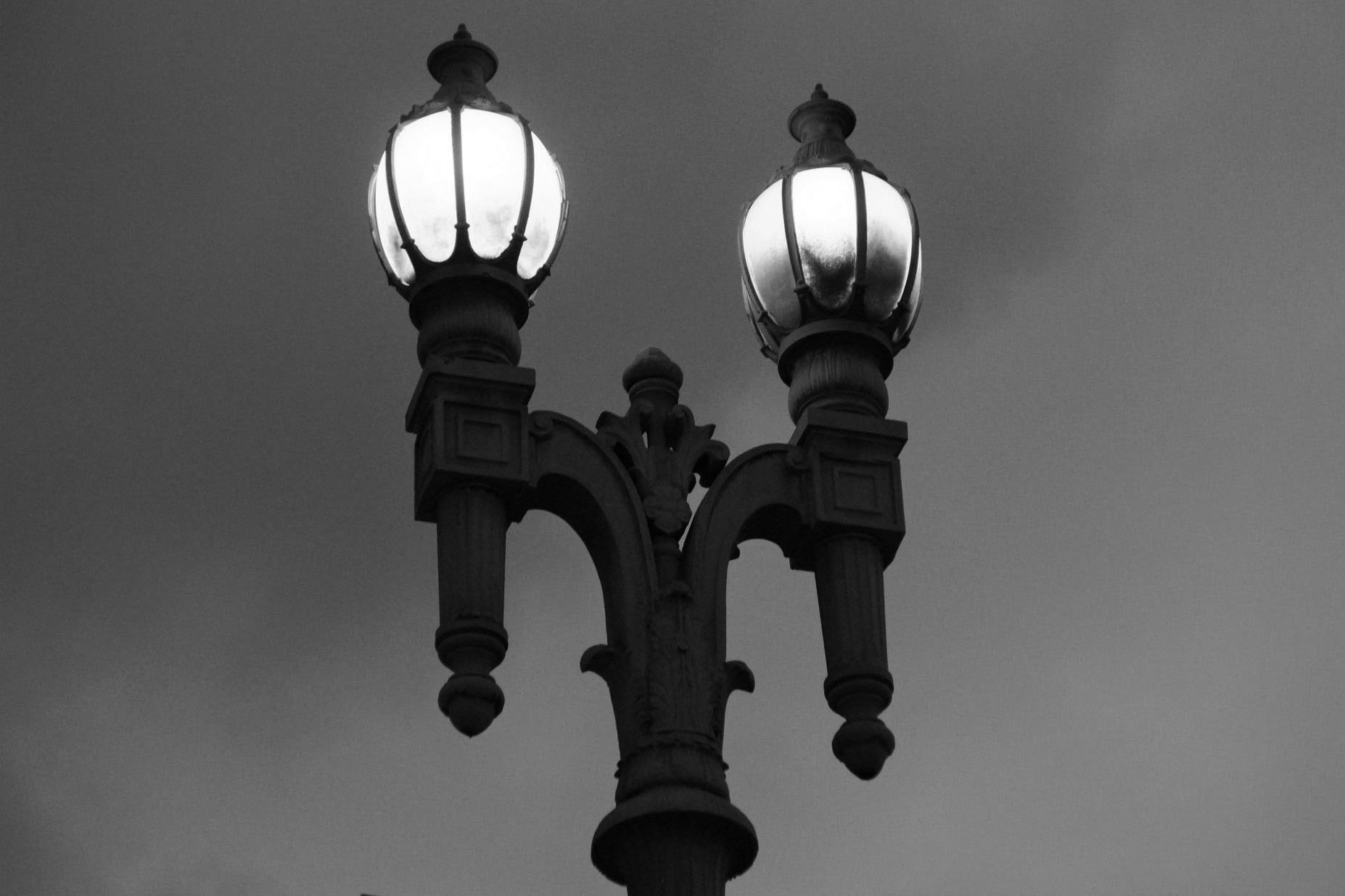 |
|
| (2021)* – Close-up view of a UM-1906 streetlight at dusk, located at the T-intersection of West 7th Street and Columbia Avenue. Photo by Glen Norman |
* * * * * |
Wilshire Special (DTLA - Contemporary Views)
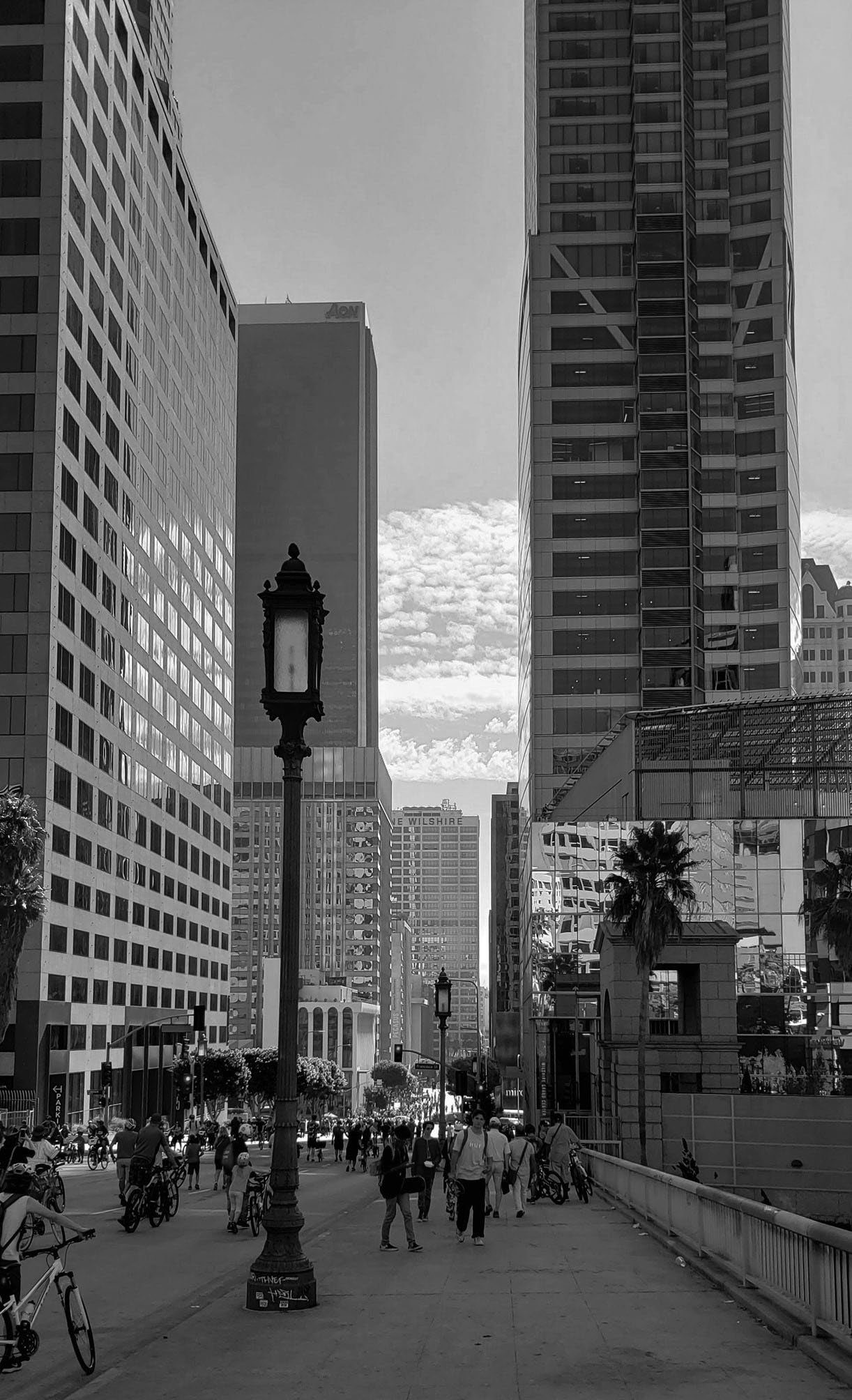 |
|
| (2019)* – CicLAvia event on Wilshire Boulevard as it crosses the Harbor Freeway with Wilshire Specials lining both sides of the street. The tall tower to the right is part of the Wilshire Grand Center. Photo by Gene Cabrera |
Historical Notes The first CicLAvia event, on October 10, 2010 opened a stretch of streets from East Hollywood through downtown Los Angeles into Boyle Heights. Over 100,000 people turned out, exceeding organizers’ expectations. The event itself was inspired by Ciclovia, a similar, annual open streets event taking place in Bogota, Colombia since 1974. Over 30 subsequent CicLAvia events have taken place in communities across Los Angeles County, usually covering a 5-10 mile stretch of city streets. Some of the locations used are Pasadena, South Los Angeles, Culver City, Thai Town and West Hollywood. In 2013, CicLAvia—To the Sea ran 15 miles from downtown Los Angeles to Venice Beach. |
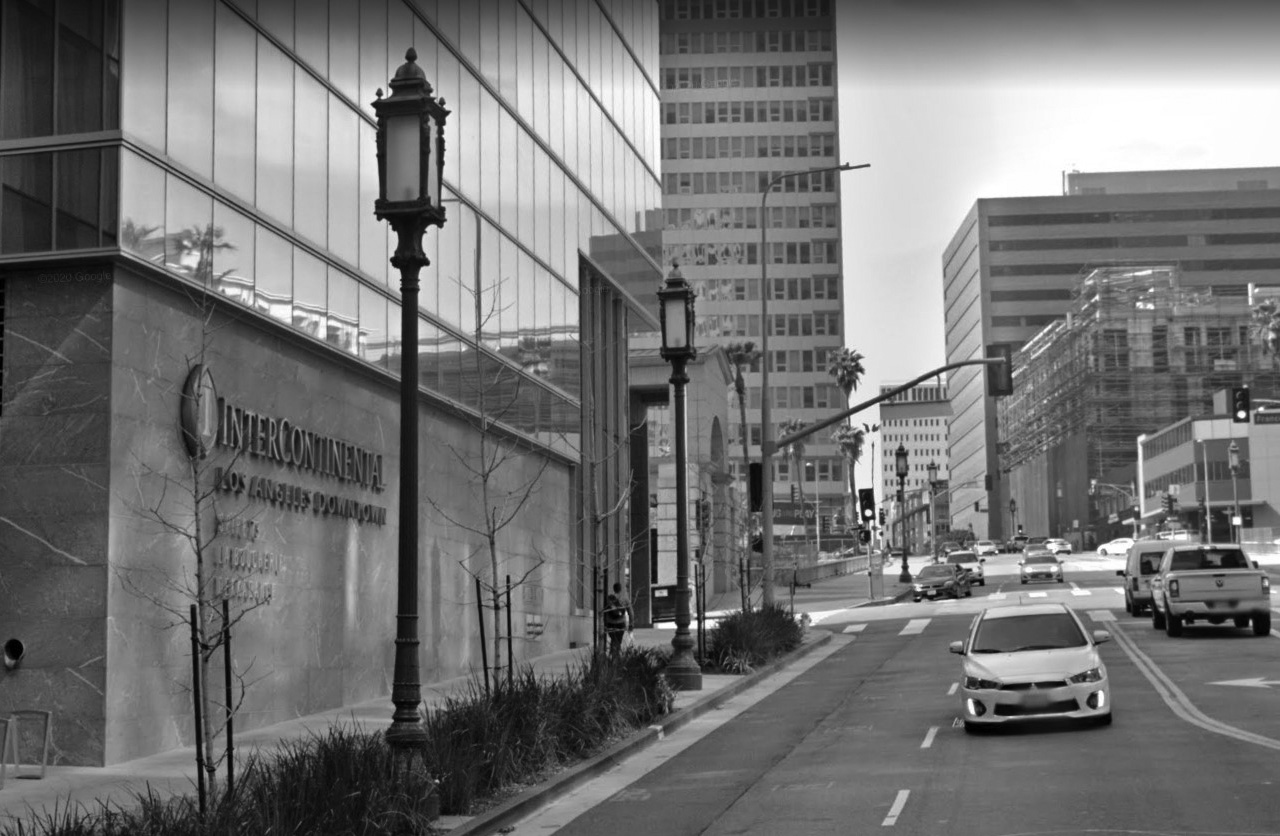 |
|
| (2019)* – Google street view looking west on Wilshire Blvd toward Francisco Street showing Wilshire Specials in front of the Inter-Continental Hotel, part of the Wilshire Grand Center. |
Historical Notes The Wilshire Special streetlights were originally installed in 1928 along Wilshire Boulevard from Park View to Fairfax Ave. In the 1930s these ornate electroliers were also installed on the remaining sections of Wilshire all the way to downtown. Click HERE to see more on the history of the Wilshire Special. |
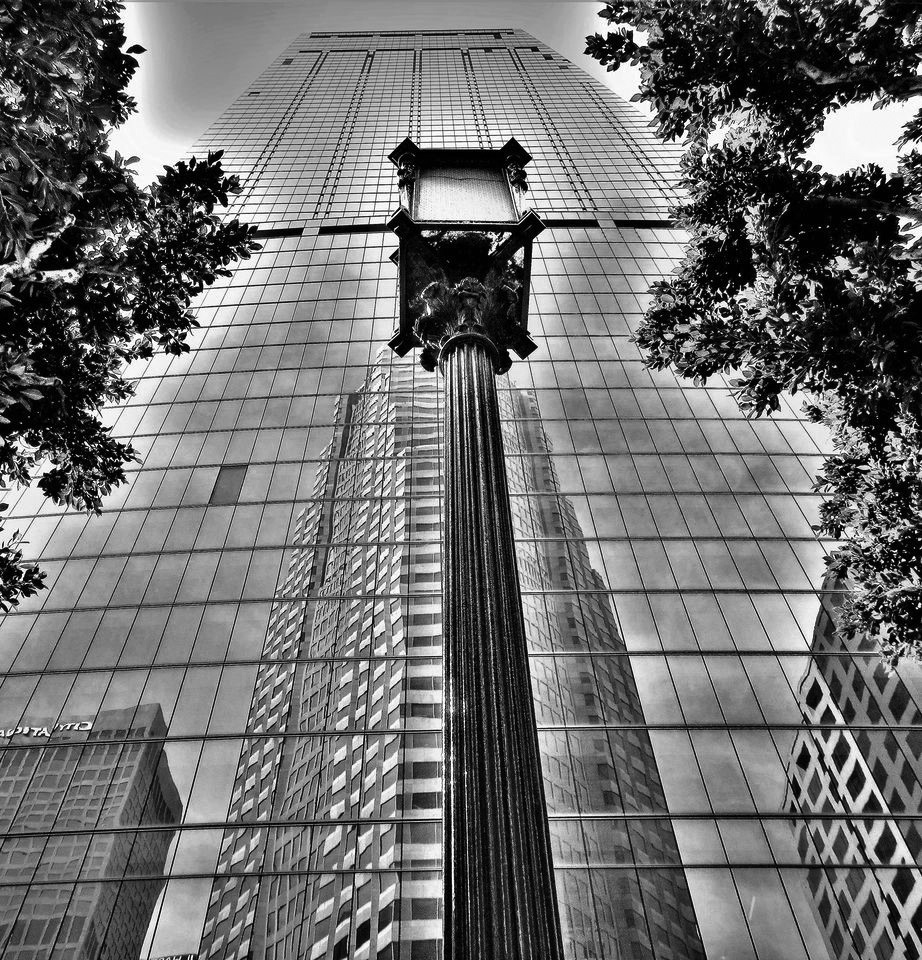 |
|
| (2020)* – Looking up to the top of a Wilshire Special and the 1,100 feet tall Wilshire Grand Center. Photo by Howard Gray |
.jpg) |
|
| (2022)* – Detail close-up view of a Wilshire Special in DTLA all lit up. Click HERE to see more on the history of the Wilshire Special. |
* * * * * |
The Llewellyn "Washington"
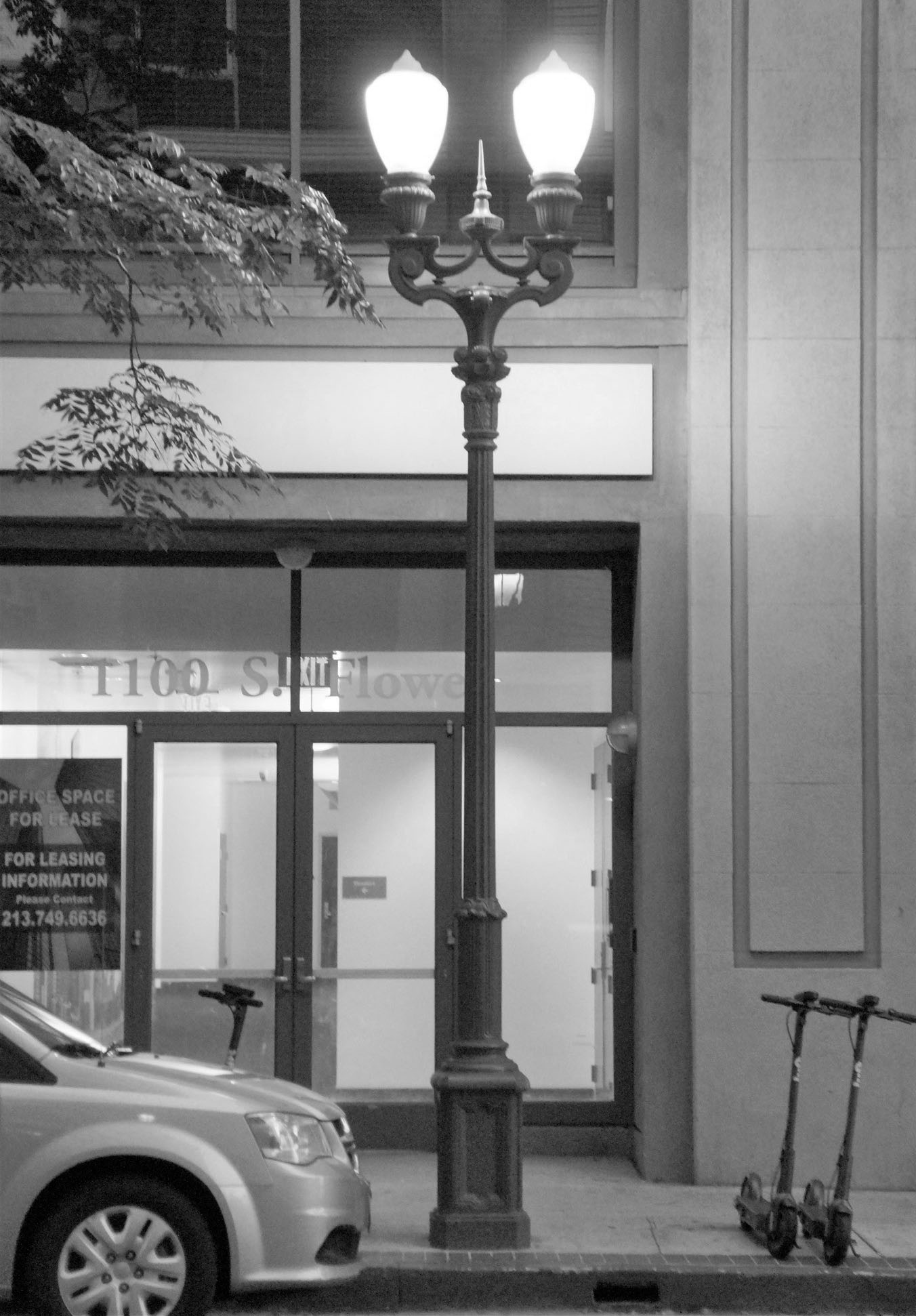 |
|
| (2019)* - View showing the Llewelly “Washington” dual-lamp streetlight. It’s a look-alike cousin of the Llewellyn “Western” which is extinct. Photo by Glen Norman |
Historical Notes The Llewellyn "Washingtons" are no longer found on Washington Boulevard, but a small run of them can be found on West 11th Street between Broadway and Hope Street. |
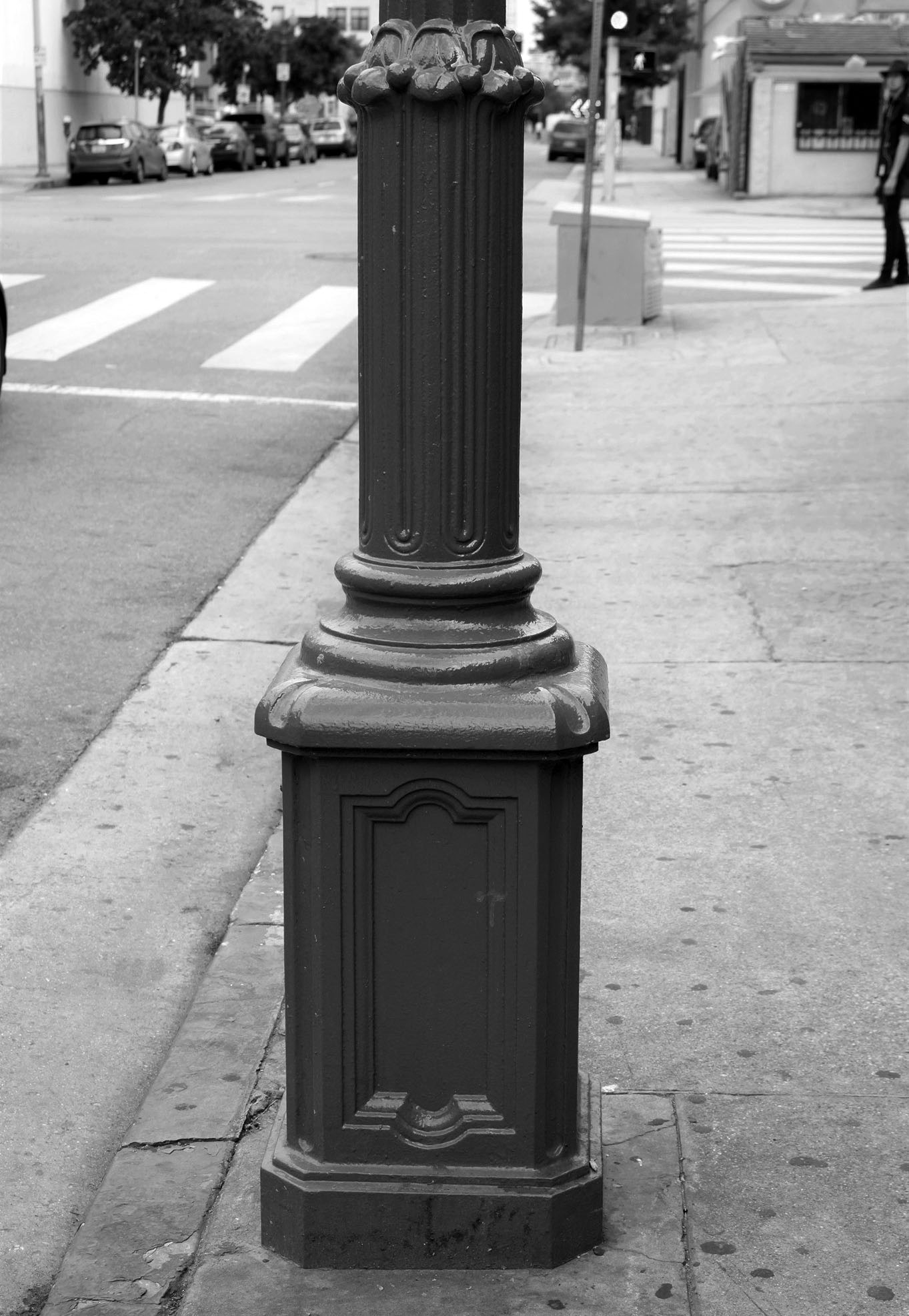 |
|
| (2016)* - Close-up look at the base of a Llewellyn "Washington” streetlight. Photo by Glen Norman |
 |
|
| (2017)* - Close-up view of a Llewellyn "Washington" located in South Park, DTLA. Photo by Glen Norman |
* * * * * |
Los Angeles Plaza
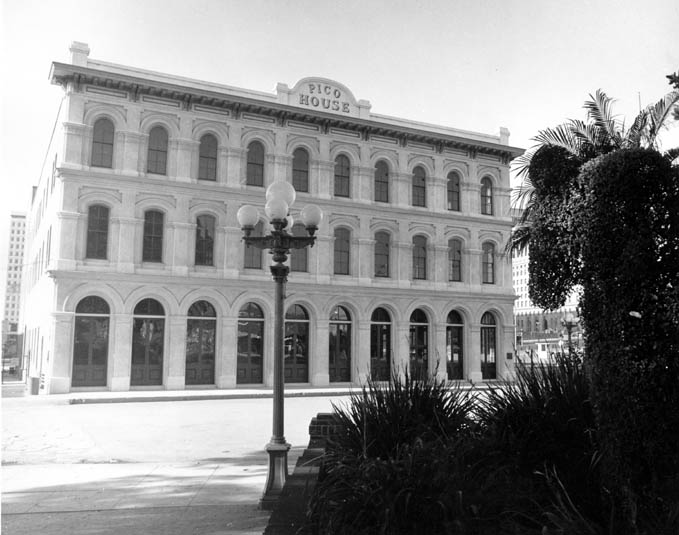 |
|
| (1970s)* - 5-bulb ornate streetlight in located in the historic Los Angeles Plaza across the street from the Pico House. |
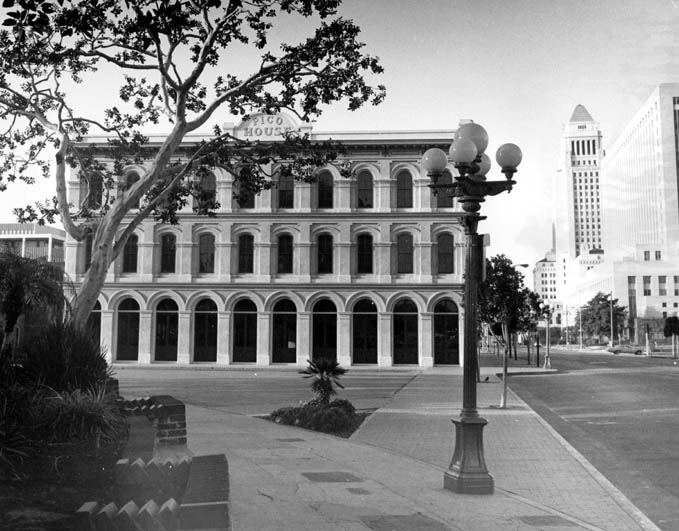 |
|
| (1977)^ - View of the Pico House from the L.A. Plaza with City Hall in the background. Ornate 5-lamp streetlight sits in the foreground. Click HERE to see more in Early Views of the L.A. Plaza. |
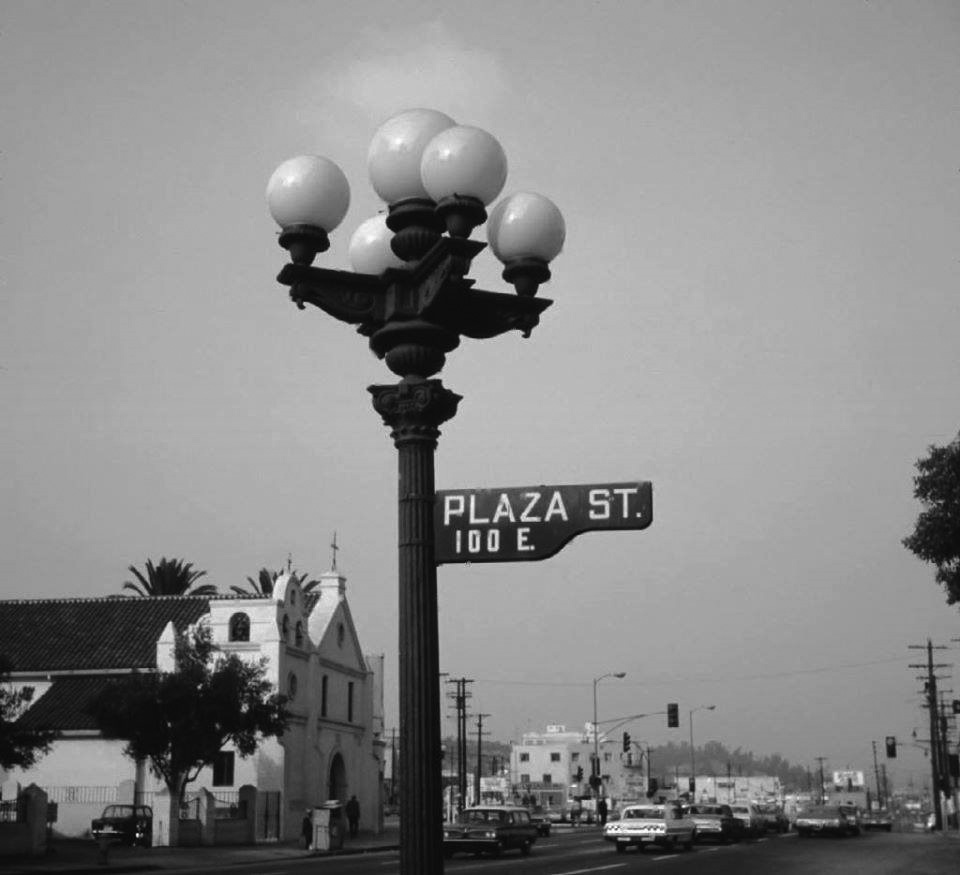 |
|
| (1969)* - View looking northwest showing an ornate 5-globe Llewellyn Electrolier standing on the edge of the LA Plaza with the Old Plaza Church seen in the background. Photo by Glen Norman |
Historical Notes The most common of the incandescent multiple globe electroliers of the early 1900s were those manufactured by the Llewellyn Iron Works of Los Angeles. The firm became so identified with this style of street light that any multiple globe electrolier became commonly known as a Llewellyn. The Llewellyn Iron Works, founded in 1889‐1890, was one of the largest metal working facilities in Los Angeles. It manufactured structural steel – including that for the Bradbury Building (1893). |
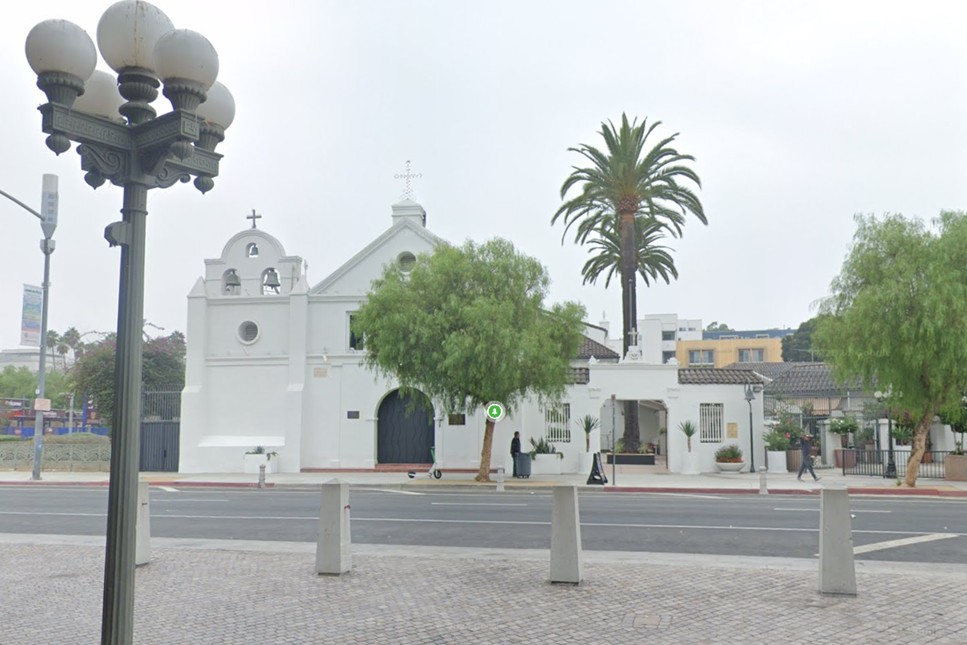 |
|
| (2024)* – Contemporary view of the Plaza Church as seen from the Los Angeles Plaza, looking across Main Street with a 5-globe refurbished streetlight in the foreground. |
From Gas to Electric Lights
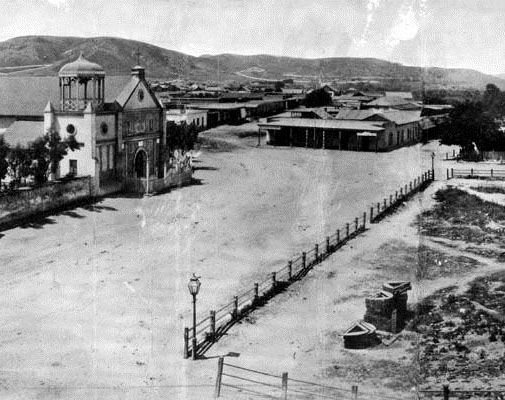 |
 |
|
| (1869) vs. (1969) - View looking NW showing the Old Plaza Church as seen from the Pico House. |
Historical Notes Click HERE to see more in Early Views of the L.A. Plaza. |
* * * * * |
5-Globe Llewellyn (Contemporary Views)
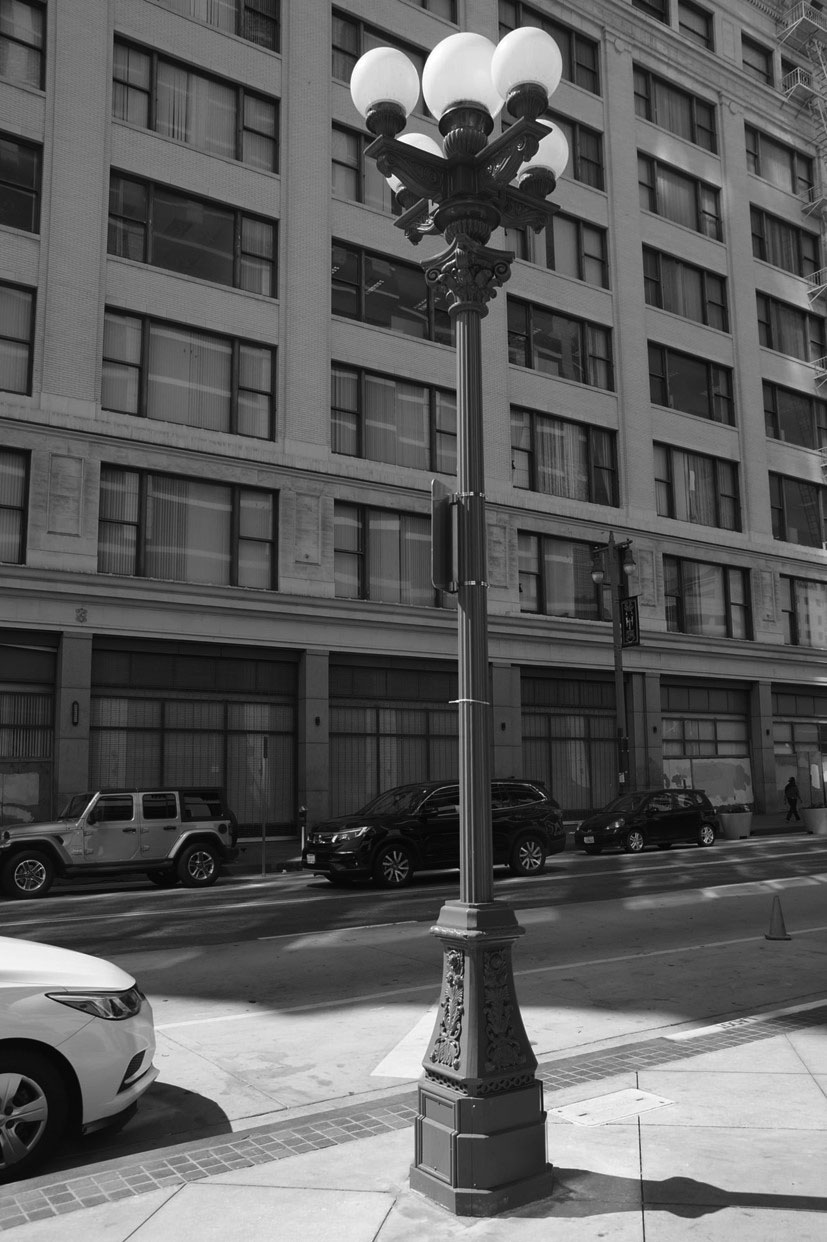 |
|
| (2021)* – View showing a 5-Globe Llewellyn on Broadway standing across the street from the original Broadway Department Store Building (built in 1913) on the SW corner of 4th and Broadway. Photo by Glen Norman |
Historical Notes The Llewellyns that populated Broadway from 1905 to 1919 had 7 globes. In fact, no other Llewellyn cluster light design in Los Angeles had more than 5 globes in deference to the Broadway originals. |
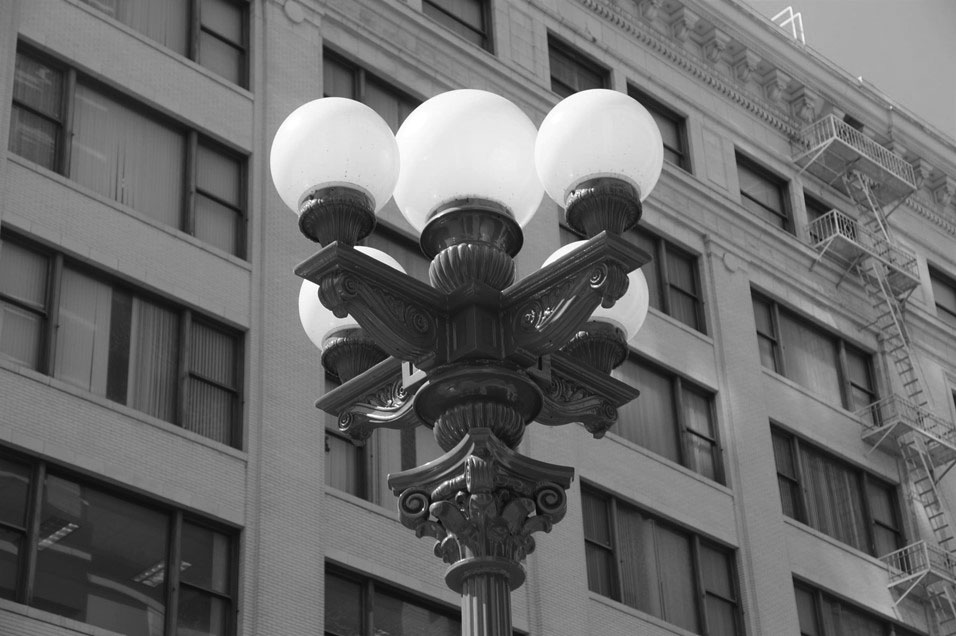 |
|
| (2021)* – Close-up view of the 5-Globe Llewellyn streetlight seen in previous photo. Photo by Glen Norman |
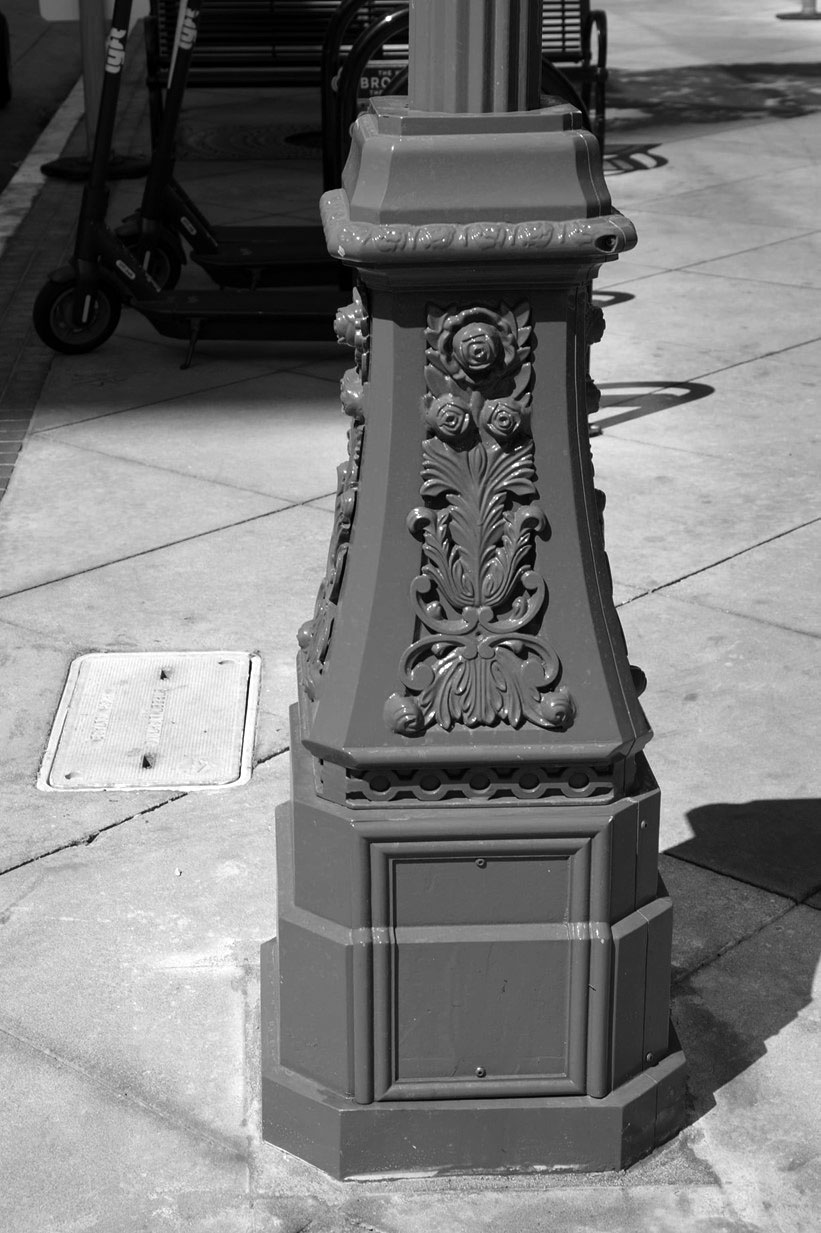 |
|
| (2021)*– Close-up view showing base of the 5-Globe Llewellyn streetlight on Broadway near 4th Street. Photo by Glen Norman |
Historical Notes This is a Rose base, modeled on and scaled down from the original 1919 bases that still populate Broadway. Keystone Iron and Steel Works produced the originals. |
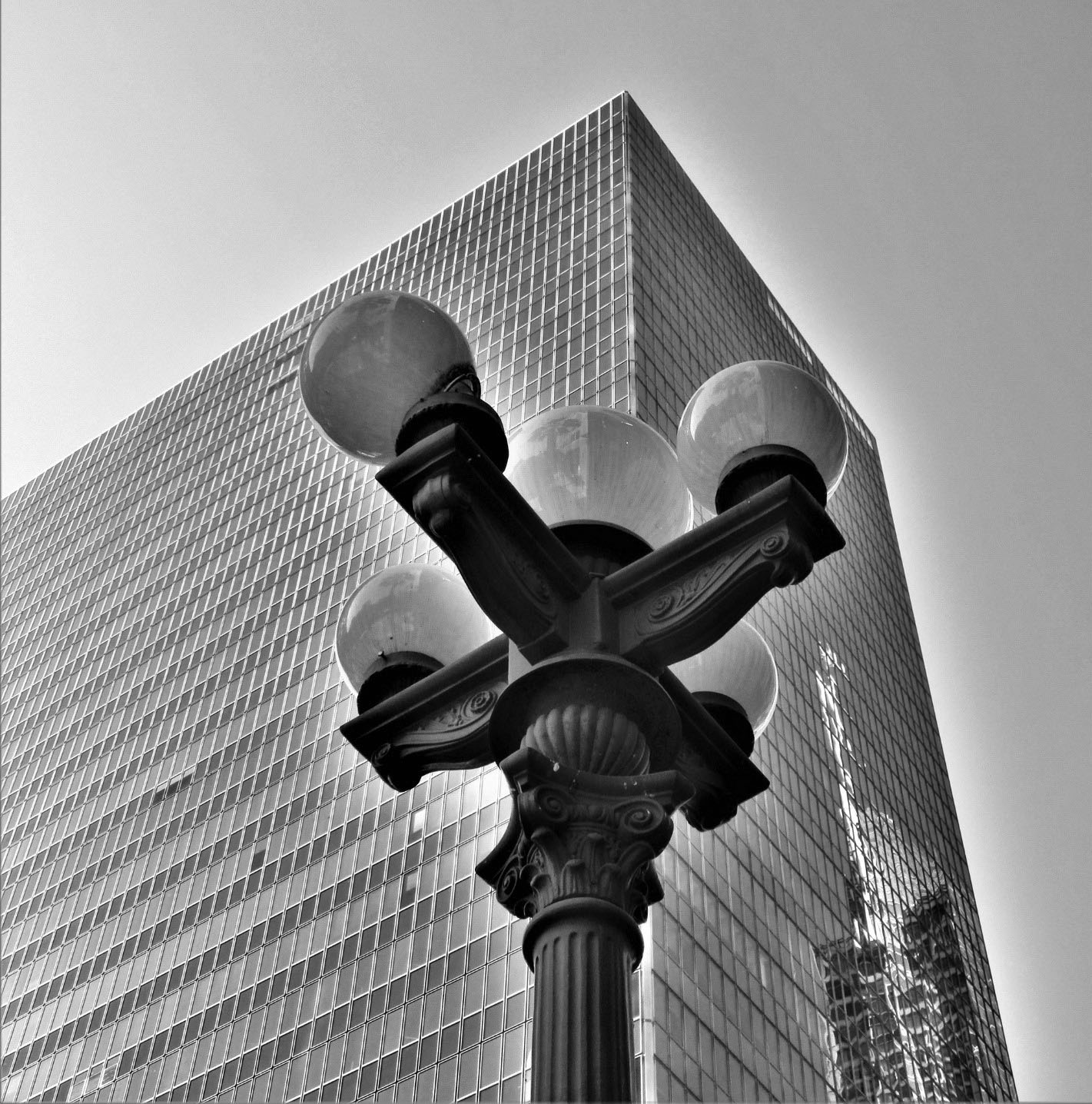 |
|
| (2020)^.^ - Looking up to the top of a refurbished 5-globe Llewellyn Electrolier in need of repair with the MCI Building in the background. The reflection of the Wilshire Grand Tower can be seen at right. Photo by Howard Gray |
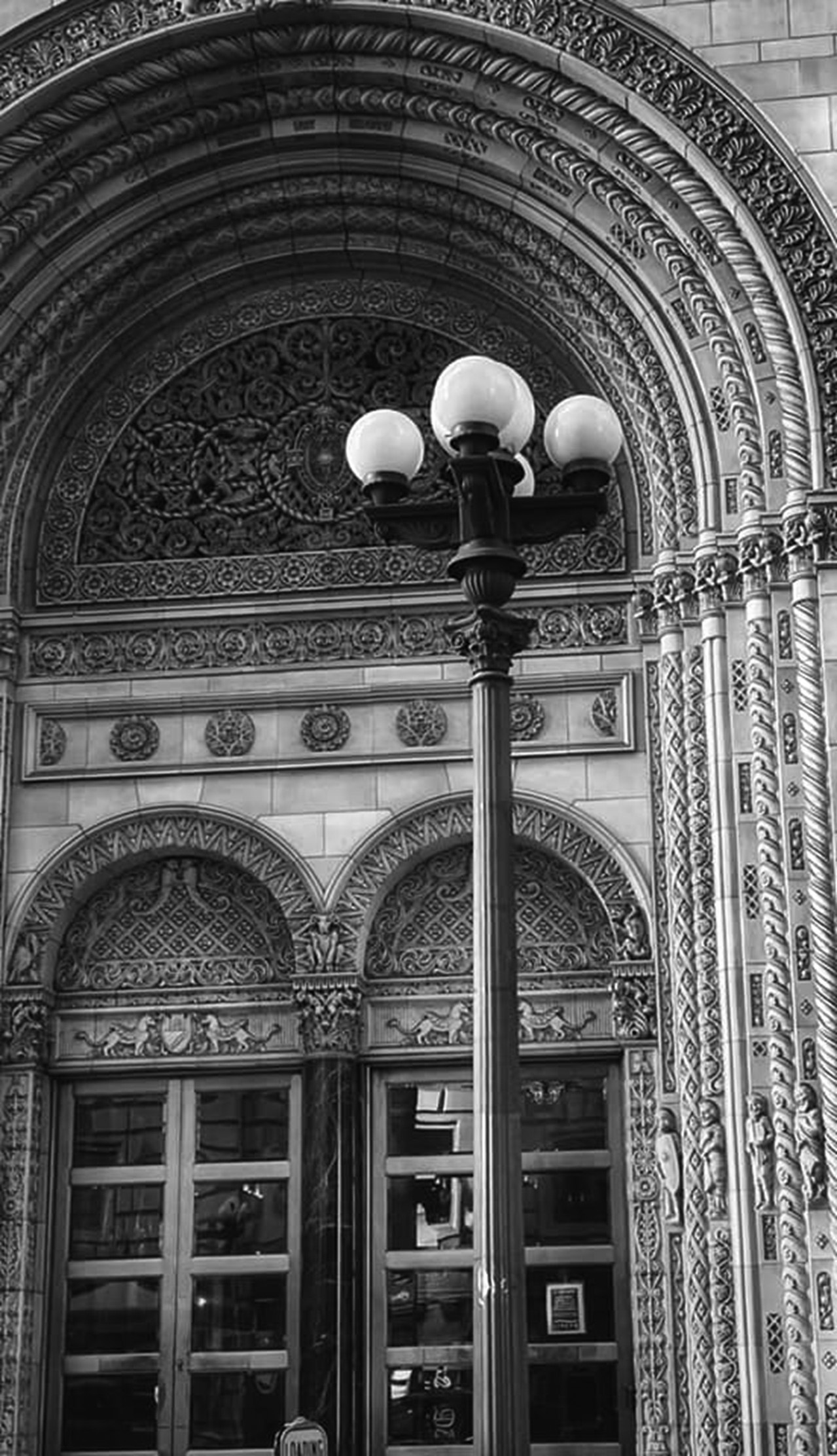 |
|
| (2021)* - Close-up contemporary view showing an ornate 5-lamp streetlight standing in front of an even more ornate Fine Arts Building, 811 W. 7th Street. Photo by Carlos G. Lucero |
* * * * * |
Union Station
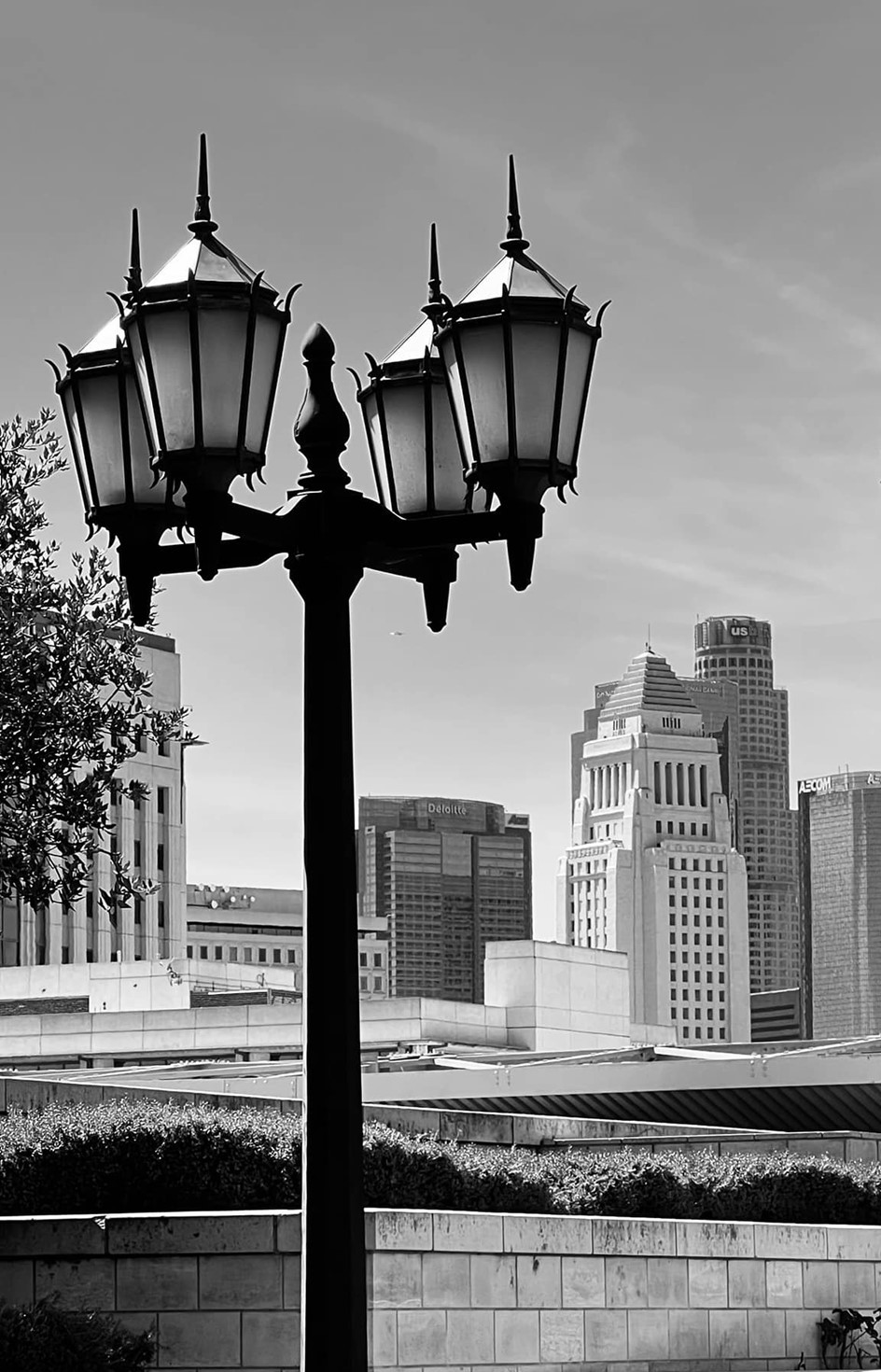 |
|
| (2023)* - View looking south from Union Station towards downtown LA showing a 4-lamp ornate streetlight. Photo by Carlos G. Lucero |
* * * * * |
Vermonica Streetlight Exhibit (Original Location)
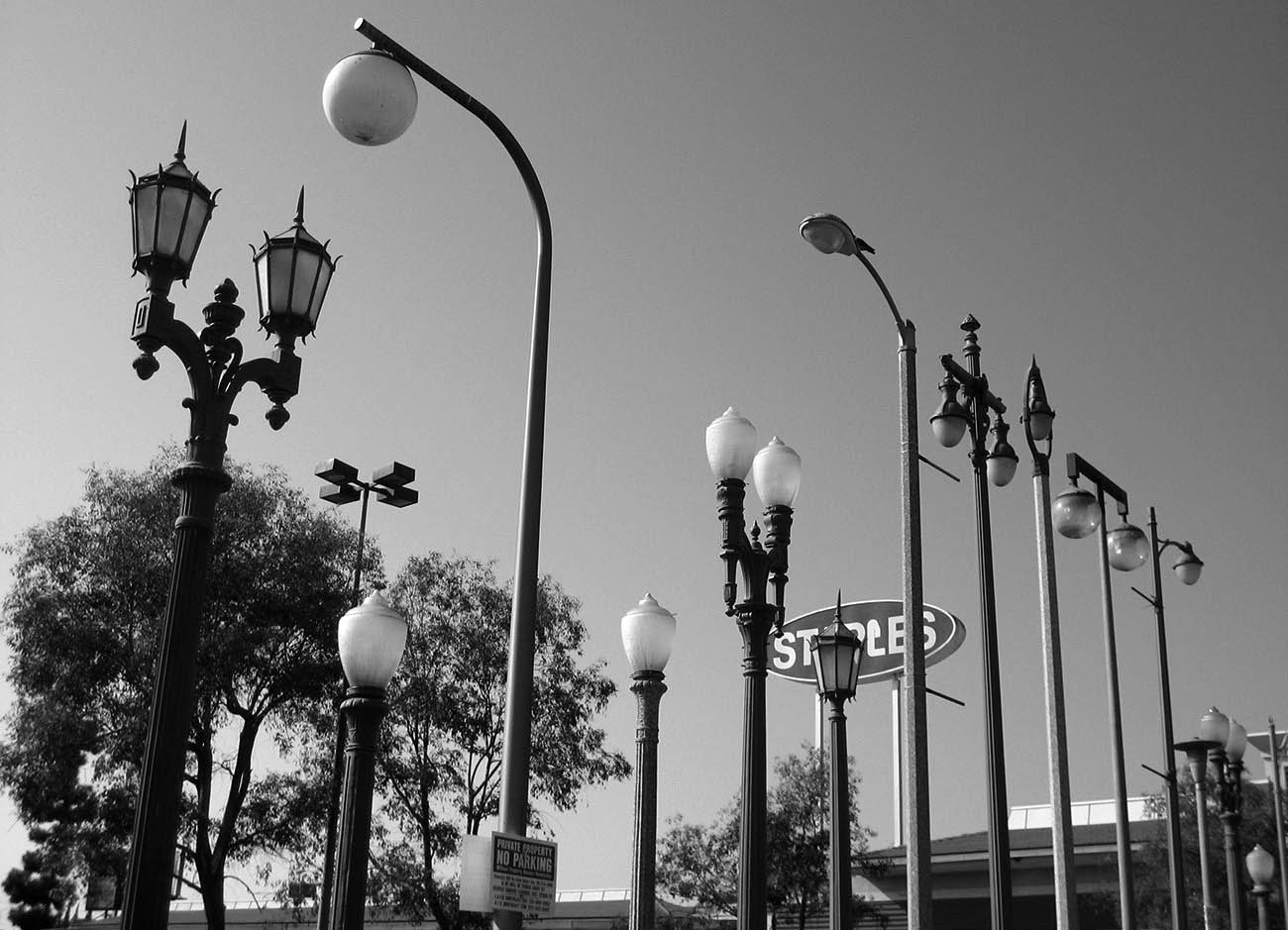 |
|
| (ca. 2010s)* - The Vermonica Streetlight Exhibit at its first location in the parking lot of a strip mall at the intersection of Santa Monica Boulevard and Vermont Avenue in East Hollywood. Photo courtesy of Sheila Klein / Vermonica |
Historical Notes In 1993, artist Sheila Klein created a sculptural installation out of 25 vintage light poles in the median of a run-of-the-mill strip mall at the intersection of Santa Monica Boulevard and Vermont Avenue in East Hollywood. The piece, titled “Vermonica,” was crafted as a gesture of healing: an illuminating monument to mark a site that had gone up in flames during the 1992 Los Angeles riots. Controversy, naturally, ensued. Part of the problem stemmed from the fact that “Vermonica” occupied a legal gray area: The bureau had supplied the light poles and Klein had made the work with a small grant from the Department of Cultural Affairs, but the sculpture stood on private property and had never been formally acquired by the city of L.A. Fast-forward 24 years to November 2017, when the sculpture was mysteriously removed by the Bureau of Street Lighting without notice. It then materialized in a reconfigured state before the bureau’s headquarters a block to the east. The strip mall owner had asked for the piece to be removed to accommodate some construction. But engineers for the bureau had failed to notify Klein or the Department of Cultural Affairs. |
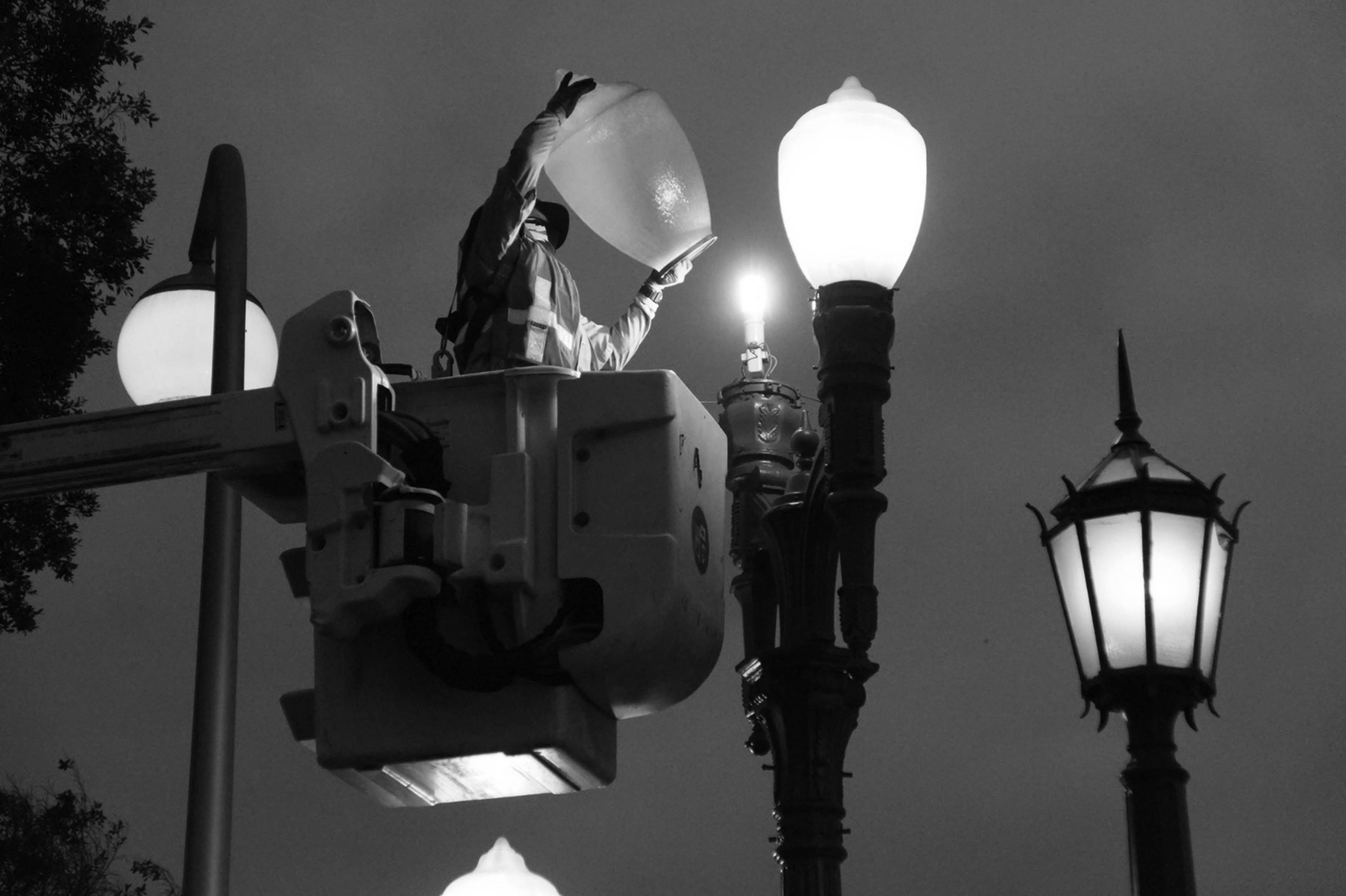 |
|
| (2020)* - LA Bureau of Streetlight worker replacing globe after changing the bulb. The twin streetlight is a Westinghouse-Llewellyn "California Special" a.k.a. "The Magnolia Double." Photo by Glen Norman |
Historical Notes The above photo was taken on 10-23-20 at the LABSL Field Operations Division on Santa Monica Blvd. Within a week of this shot, the poles were moved to the reconstituted "Vermonica" to the West. |
* * * * * |
Vermonica Streetlight Exhibit (Current Location)
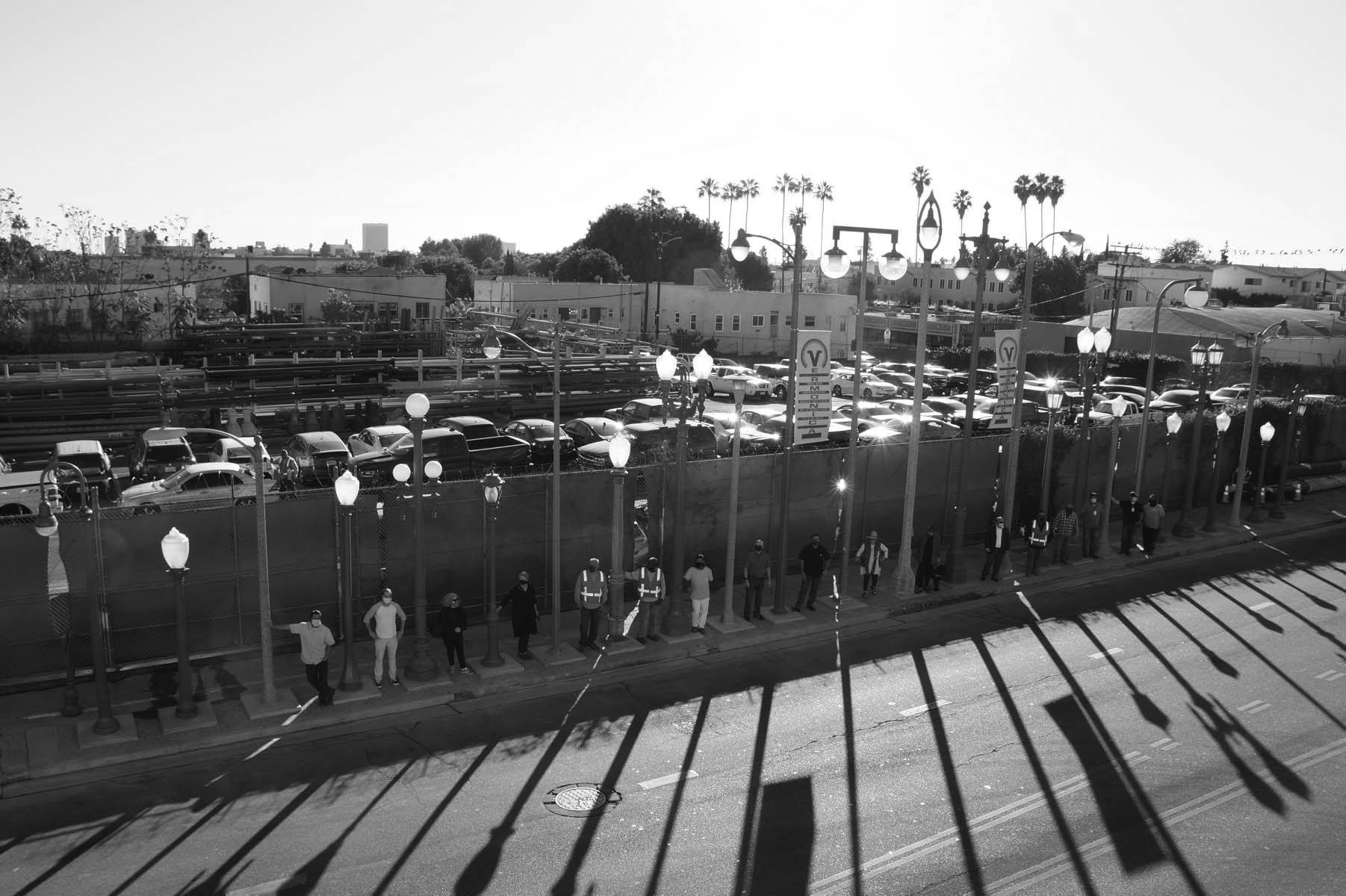 |
|
| (2020)* – Official opening ceremony of the “New” Veronica streetlight art exhibit located on Santa Monica Boulevard at Lyman Place. Sheila Klein is standing between the Little Tokyo light and the Lankershim Harp. Also present are representatives from LABSL, LA Department of Cultural Affairs, and other dignitaries. Photo by Glen Norman |
Historical Notes Vermonica is a public art installation initiated by artist Sheila Klein in May 1993, uninstalled in November 2017 and reinstalled in a new location in December 2020. Vermonica is now located on Santa Monica Boulevard at Lyman Place, opposite the Cahuenga Branch Library. The sculpture is named for the intersection of Santa Monica Boulevard and Vermont Avenue in East Hollywood. Some of the artwork's 25 lamp poles date to 1925, the year Los Angeles's Bureau of Street Lighting opened. Placed in front of a Rite-Aid, the lights glow to illuminate the mini-mall parking lot where it was located at specific times during the night. Sheila Klein cooperated with Los Angeles businesses, bureaus, departments and neighborhoods to erect what she describes as a "formal composition" and a "drive-in museum" of street lighting. Vermonica was envisioned initially as a temporary installation with borrowed poles from the nearby streetlight yard on Santa Monica Boulevard. The sculpture was so popular that it remained in place. Vermonica precedes Chris Burden's Urban Light by 15 years. |
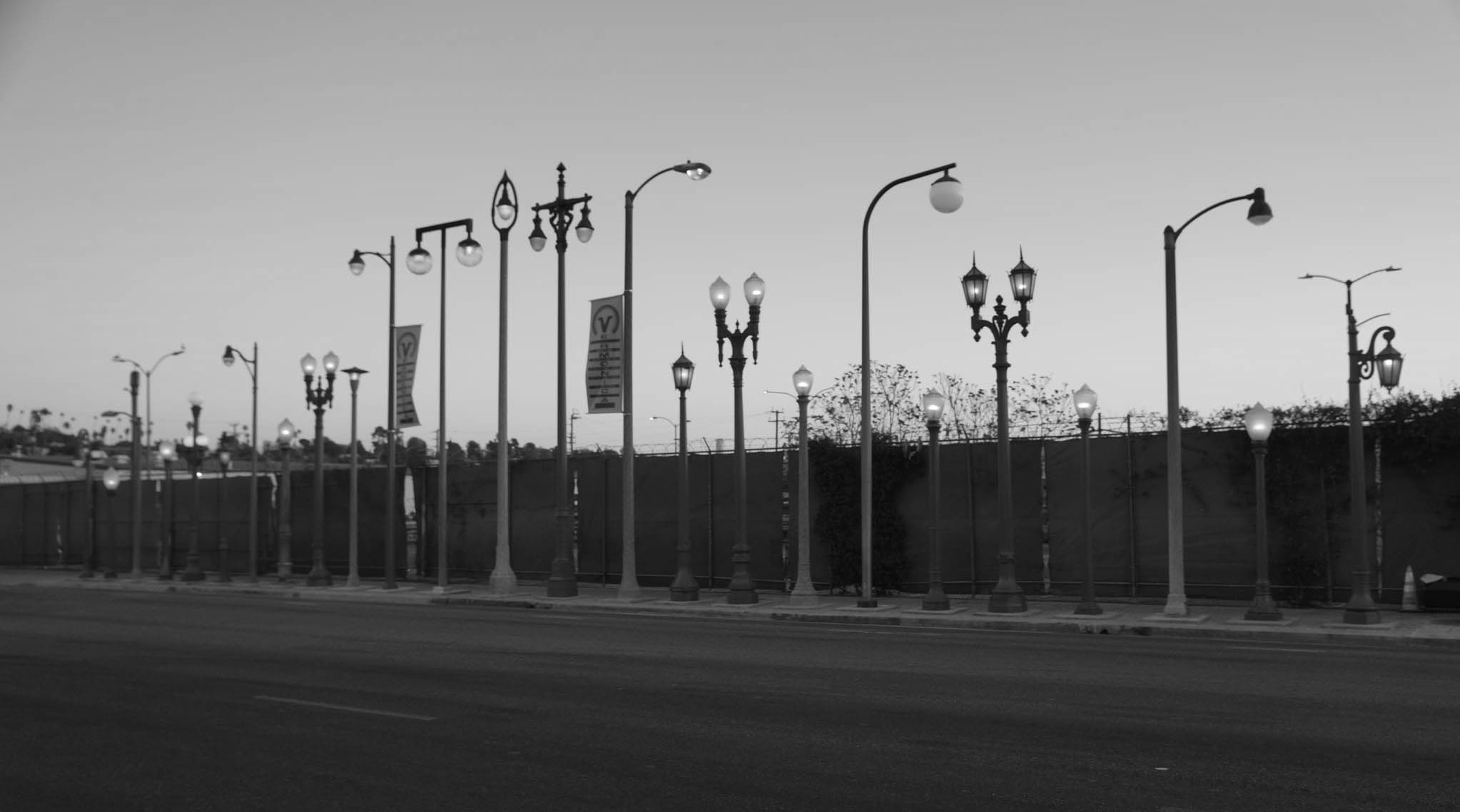 |
|
| (2020)* – Dusk view showing the Vermonica exhibit on Santa Monica Boulevard which includes 25 historic lamp poles some of which date back to 1925. Photo by Glen Norman |
Historical Notes On November 21, 2017, artist Sheila Klein was informed by a member of the public that her artwork had been removed without her knowledge. The elements of the work had been moved to the front lawn of the Bureau of Street Lighting, and reinstalled in a curved line. In a statement, Sheila Klein announced that the reinstalled work is not Vermonica. An assistant director with the Bureau of Street Lighting said the move is not permanent and was necessitated by construction work in the parking lot where the sculpture was originally located. "Our sense of urgency was to protect and preserve the streetlights so that they wouldn't be damaged or removed by someone other than us," Assistant Director Megan Hackney told The Los Angeles Times. On June 6, 2019, artist Sheila Klein launched a petition seeking restoration of Vermonica in light of newly discovered emails from Bureau of Street Lighting staff that show that BSL intentionally dismantled Vermonica to create a new city staff designed work they called "Vermonica". On January 1, 2020, artist Sheila Klein announced on Instagram that an agreement had been reached with the City of Los Angeles for her to restore Vermonica. The newly reinstalled sculpture was completed and re-lit by the artist on December 1, 2020. |
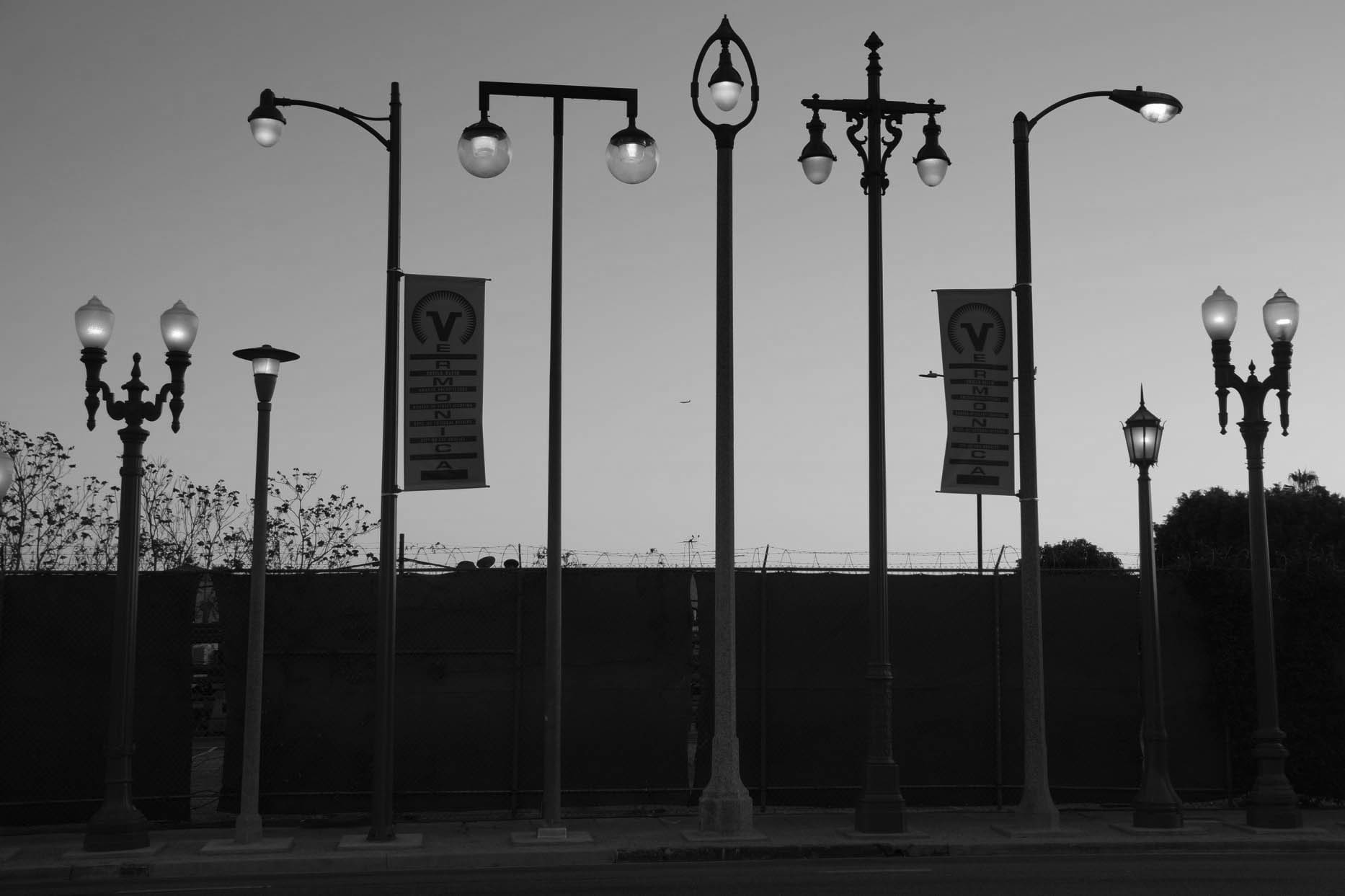 |
|
| (2020)* - Vermonica Exhibit at dusk showing “The Big 5” - Double post-top, single post-top, single overhead, and double overhead. Then reversed to the right of the Lankershim Harp. Photo by Glen Norman |
Historical Notes VERMONICA is named for the intersection where it was originally located, Vermont Avenue and Santa Monica Boulevard. Currently located at 4582 Santa Monica Boulevard at Lyman Place, it is an Urban Candelabra. The installation, which is 120' long and 30' tall, is made of a selection of 25 streetlights from the City of Los Angeles. Some of the streetlights are current, others are rare examples of obsolete poles from the city's past. These 25 poles represent the diversity of the over 400 types currently in use in Los Angeles. The range of materials, styles and historical periods displayed in Vermonica hopes to encourage people to notice the variety and sculptural nature of the street lights they see every day, and to appreciate the efforts of the Bureau of Street Lighting. Vermonica was conceived and executed by artist Sheila Klein. She incorporates the intimate domestic scale of candlesticks into an Urban Candelabra for the household of the street. Vermonica seeks to uncover romantic truths about the city. By accenting one overlooked layer of our environment, Klein encourages further consideration of all our urban layers. |
* * * * * |
Urban Light - Los Angeles County Museum of Art (LACMA)
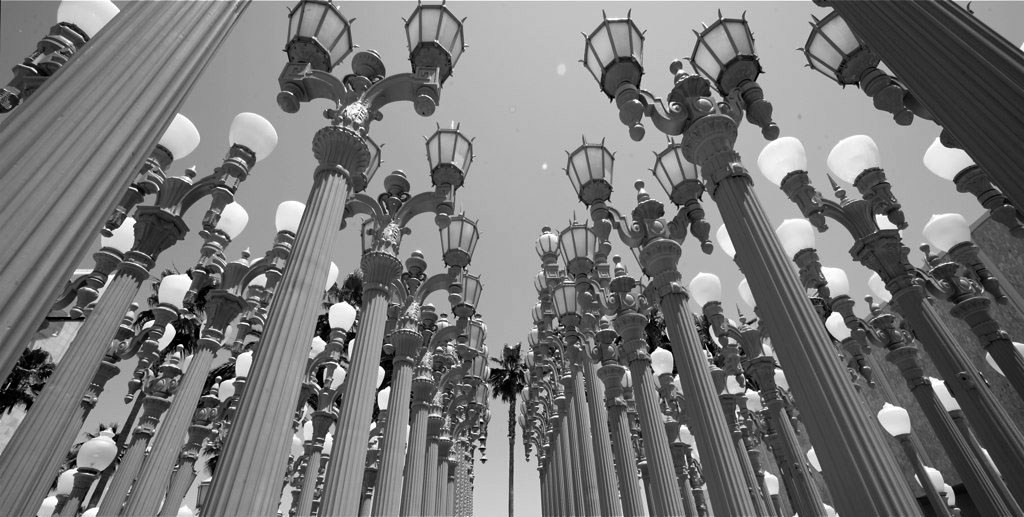 |
|
| (2011)* - Urban Light by Chris Burden located in front of LACMA, 5095 Wilshire Boulevard. Photo courtesy of 'tripod2011' / flickr |
Historical Notes Chris Burden's "Urban Light" installed on the sidewalk in front of LACMA has been one of LA's favorite and most photographed landmarks since its unveiling in February 2008. The piece incorporates 202 antique street lights from cities and neighborhoods in and around Los Angeles. Urban Light is composed of 202 street lamps arranged in a near grid. The lamps mostly came from the streets of Southern California, including Hollywood, Glendale, and Anaheim, with some from Portland, Oregon. There are 16 different streetlight models represented, many of which were commissioned for particular neighborhoods and streets. |
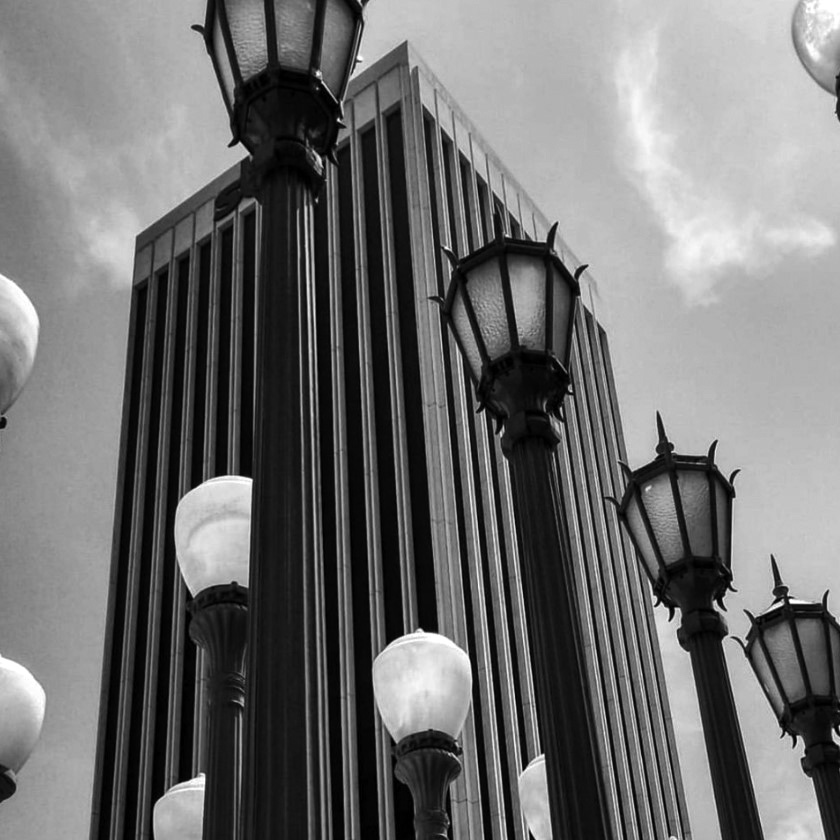 |
|
| (2019)* - Close-up view looking up through the ‘Urban Light’ sculputre toward the 5900 Wilshire, 32-story SBE Building. Photo courtesy of Aurora Ruvalcaba |
Historical Notes The sculpture's glass globes are of three general shapes: round, acorn, and cone. The 309 LED bulbs are solar powered and switch on from dusk until dawn, governed by an astronomical timer. |
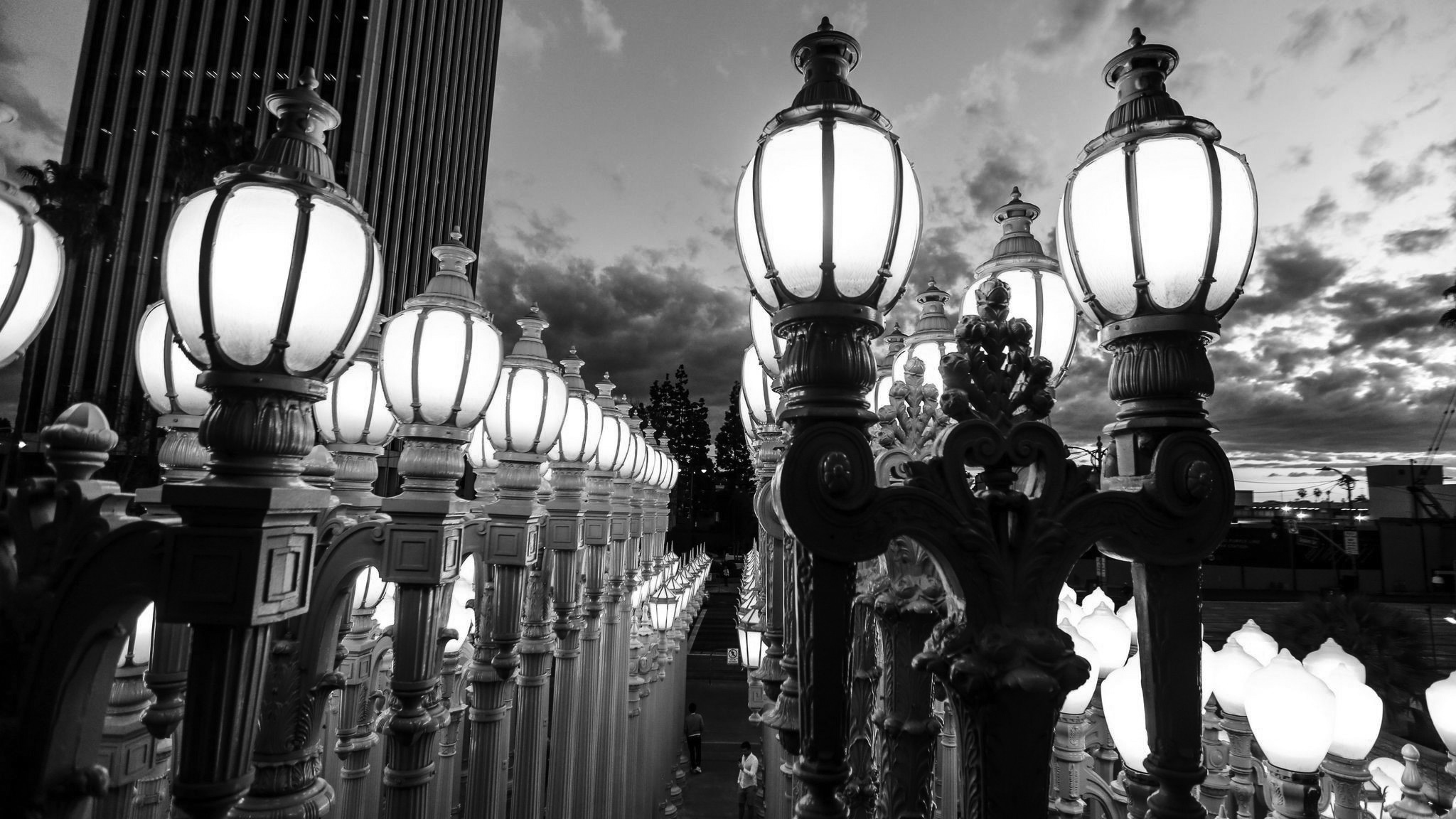 |
|
| (2018)* - The Broadway Roses is the artist's favorite work, standing 26 feet tall and the tallest of the "Urban Light." Maria Alejandra Cardona / Los Angeles Times |
Historical Notes The Broadway Rose, the largest and most ornate of the models, is represented by six lamps. The style was found in downtown Los Angeles; a few can still be seen on Sixth Avenue between Olive and Flower Streets. |
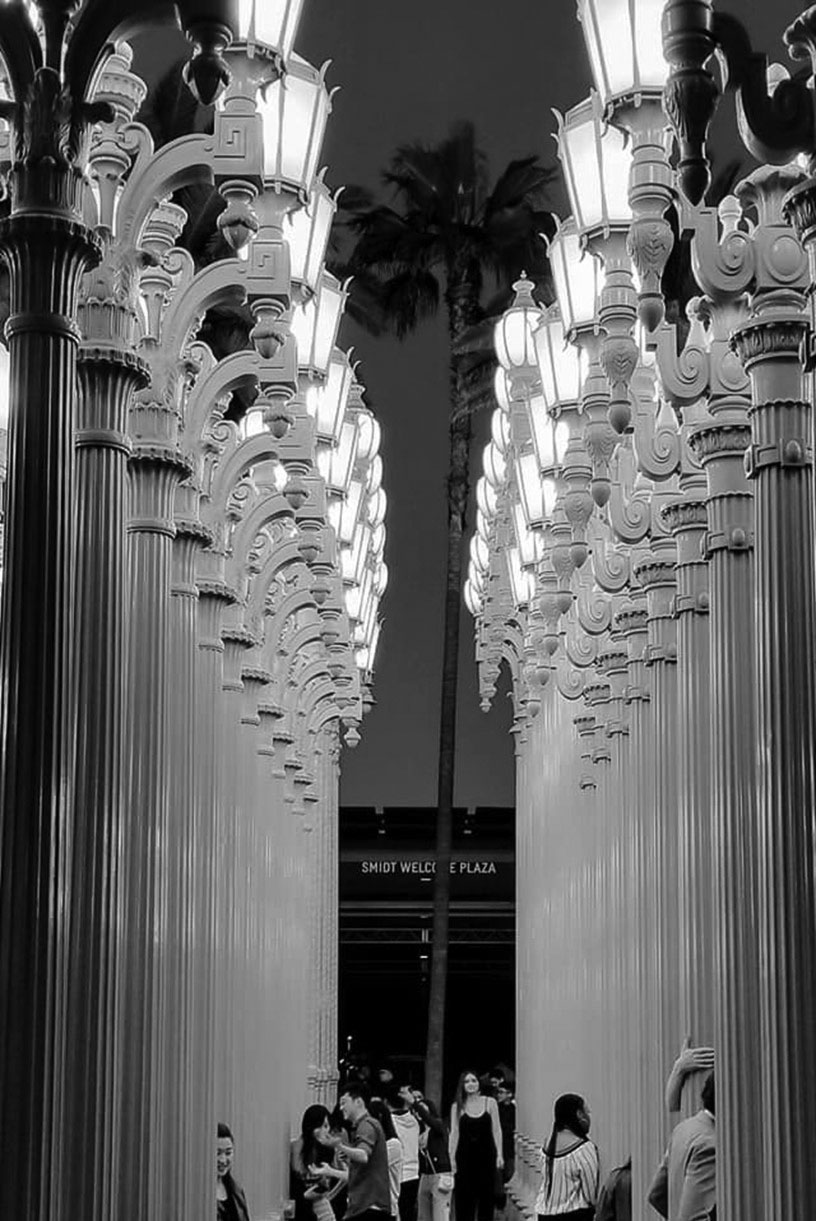 |
|
| (2021)* - Urban Light – A joy to walk through. Photo courtesy of Paul Wright |
Historical Notes Los Angeles Times critic Christopher Hawthorne described Urban Light as "a kind of pop temple, deftly straddling the lines between art and architecture and between seriousness and irony. It's also a joy to walk through, but there's no getting around the fact that it turns what might have been an actual public square along Wilshire—a space defined from day to day by the people using it—into an outdoor room for one sizable and very insistent piece of art." |
* * * * * |
Please Support Our CauseWater and Power Associates, Inc. is a non-profit, public service organization dedicated to preserving historical records and photos. Your generosity allows us to continue to disseminate knowledge of the rich and diverse multicultural history of the greater Los Angeles area; to serve as a resource of historical information; and to assist in the preservation of the city's historic records.
|
More Historical Early Views
Newest Additions
Early LA Buildings and City Views
History of Water and Electricity in Los Angeles
* * * * * |
References and Credits
* DWP - LA Public Library Image Archive
^ LA Public Library Image Archive
^^Bureau of Street Lighting Image Archive
#*Library of Congress: 4th and Lorena Street Bridge Light
#^San Fernando Valley History Digital Library - CSUN Oviatt
#+Facebook.com: Classic Hollywood/Los Angeles/SFV
***Huntington Digital Library Archive
*^^Nuestra Señora la Reina de los Ángeles - losangelespast.com
^^*Noirish Los Angeles - forum.skyscraperpage.com; Windsor-Wilshire
^^^California State Library Image Archive
^**Vintage Los Angeles: Trocadero Nightclub ; Hollywood and Vine
*^*Photo Ramblings - Garth Buckles
^*^Mail Online - Daily Mail Reporter
^#^LA Times: Amestory Building
*#*Flicker: smgerdes - 4th Street Bridge Lights
*#^LAPL-El Pueblo de Los Angeles Historical Monument Photo Archive
^#*Facebook.com - Los Angeles Theatres: Warner Bros. Downtown
**#San Fernando Valley Relics - Facebook.com: Van Nuys Blvd., Ca. 1940
^^#Flickr.com: Michael Ryerson
*^#Facebook.com - Bizarre Los Angeles
^*#California State Library Image Archive
*##Facebook.com: Garden of Allah Novels – Martin Turnbull
^##Boyle Heights History Blog: Introduction of Electric Light to Boyle Heights
+##MartinTurnbull.com: Fairfax and Wilshire
#*^Facebook.com - San Pedro's Original Website, San Pedro.com
#^*Facebook.com: West San Fernando Valley Then And Now
#^^Facebook.com - Bizarre Los Angeles
^x^Facebook.com: So. Calif. Historic Arrchitecture
^* Wikipedia: Los Angeles Country Art Museum; Hollywood Playhouse (Avalon Hollywood); MacArthur Park
< Back
Menu
- Home
- Mission
- Museum
- Major Efforts
- Recent Newsletters
- Historical Op Ed Pieces
- Board Officers and Directors
- Mulholland/McCarthy Service Awards
- Positions on Owens Valley and the City of Los Angeles Issues
- Legislative Positions on
Water Issues
- Legislative Positions on
Energy Issues
- Membership
- Contact Us
- Search Index